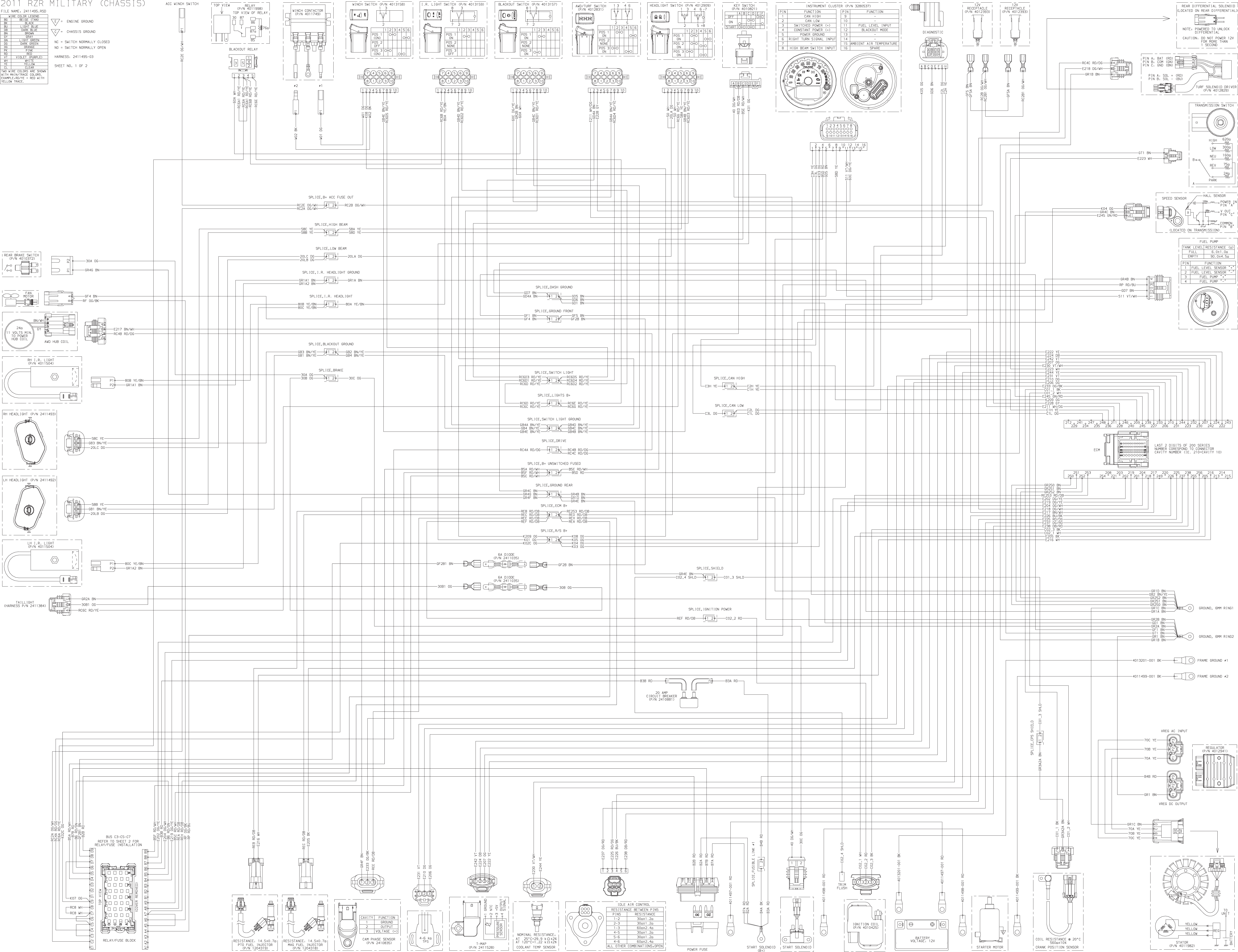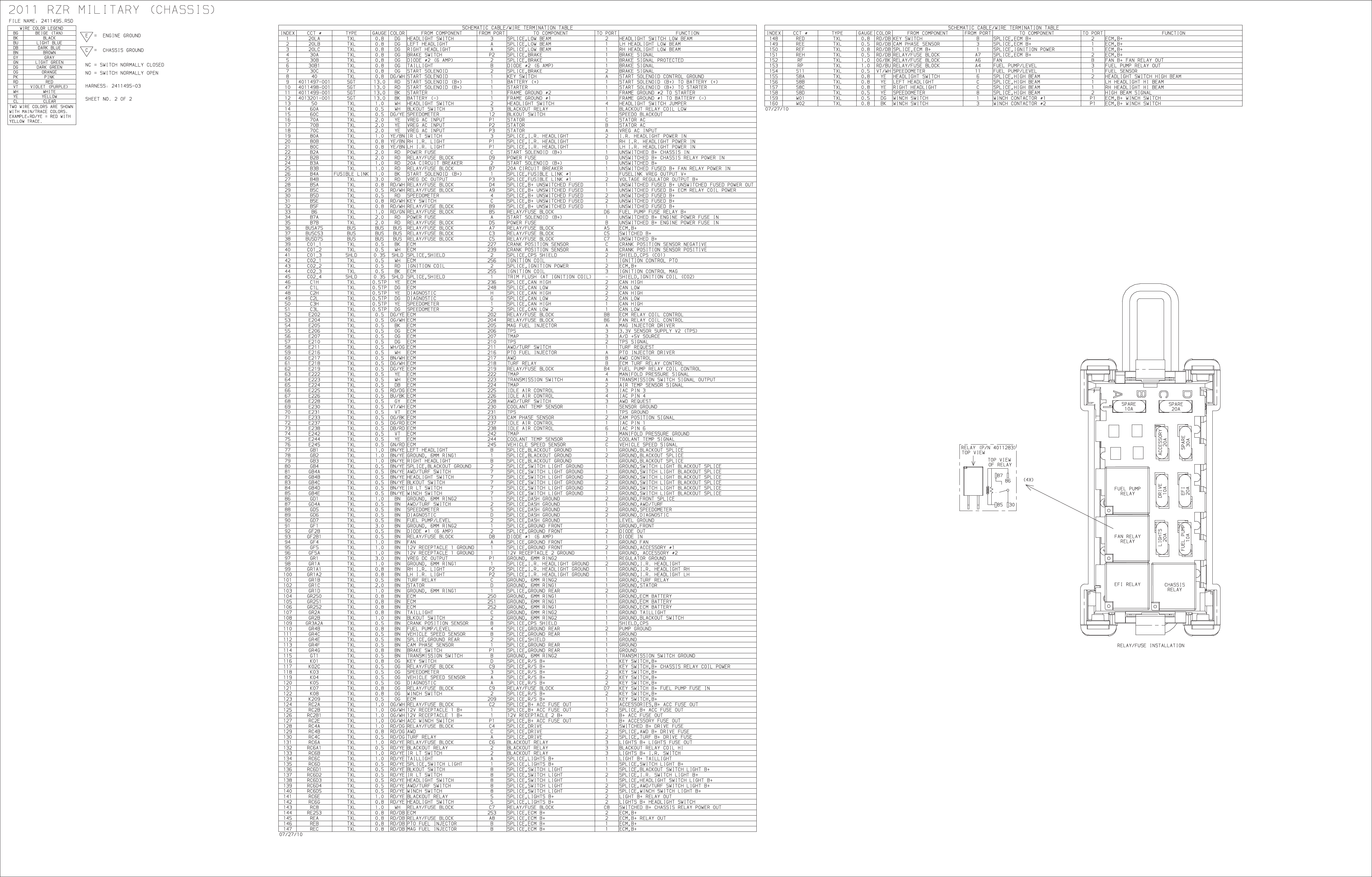9922720_RZR_800 2011 Polaris Ranger RZR SW Service Manual
User Manual: 2011 Polaris Ranger RZR SW Service Manual
Open the PDF directly: View PDF ![]() .
.
Page Count: 346 [warning: Documents this large are best viewed by clicking the View PDF Link!]
- 2011 RANGER RZR SW
- GENERAL INFORMATION
- MAINTENANCE
- ENGINE
- ENGINE SPECIFICATIONS
- ENGINE COOLING SYSTEM
- GENERAL ENGINE SERVICE
- ENGINE DISASSEMBLY AND INSPECTION
- Cylinder Head Assembly Exploded View
- Rocker Arms
- Push Rods
- Cylinder Head Removal
- Cylinder Head Inspection
- Cylinder Head Warp
- Valve Seal / Spring Service (On Engine)
- Cylinder Head Disassembly
- Valve Inspection
- Combustion Chamber
- Valve Seat Reconditioning
- Cylinder Head Reassembly
- Valve Sealing Test
- Cylinder Removal
- Valve Lifter Removal / Inspection
- Piston Removal
- Cylinder Inspection
- Cylinder Hone Selection and Honing Procedure
- Honing To Deglaze
- Cleaning the Cylinder After Honing
- Piston-to-Cylinder Clearance
- Piston / Rod Inspection
- Piston Ring Installed Gap
- Starter Drive Bendix Removal / Inspection
- Flywheel / Stator Removal / Inspection
- Engine Crankcase Disassembly / Inspection
- Camshaft Inspection
- ENGINE REASSEMBLY
- ENGINE INSTALLATION
- TROUBLESHOOTING
- ELECTRONIC FUEL INJECTION
- GENERAL INFORMATION
- FUEL TANK
- ELECTRONIC FUEL INJECTION
- ELECTRONIC CONTROL UNIT (ECU)
- TEMP / MANIFOLD ABSOLUTE PRESSURE SENSOR (T-MAP)
- CRANKSHAFT POSITION SENSOR (CPS)
- FUEL INJECTORS
- FUEL PUMP
- IDLE AIR CONTROL (IAC)
- THROTTLE POSITION SENSOR (TPS)
- CAMSHAFT PHASE SENSOR
- ENGINE COOLANT TEMPERATURE SENSOR (ECT)
- IGNITION COIL
- EFI DIAGNOSTICS
- DIGITAL WRENCH™ OPERATION
- Digital Wrench™ Diagnostic Software Overview
- Special Tools (also refer to page 4.2)
- Diagnostic Software Version
- ECU Replacement
- Guided Diagnostic Available
- Digital Wrench™ Communication Errors
- Digital Wrench™ - Diagnostic Connector
- Digital Wrench™ Serial Number Location
- Digital Wrench™ Version and Update ID
- Digital Wrench™ Updates
- Digital Wrench™ Feature Map
- Engine Controller Reprogramming (Reflash)
- BODY / STEERING / SUSPENSION
- CLUTCHING
- SPECIAL TOOLS AND SUPPLIES
- TORQUE SPECIFICATIONS
- PVT SYSTEM OVERVIEW
- PVT SYSTEM SERVICE
- DRIVE BELT
- DRIVE CLUTCH SERVICE
- Spring Specifications
- Shift Weights
- Non-Braking Exploded View (All Models)
- Clutch Disassembly
- Spider Removal
- Roller, Pin, and Thrust Washer Inspection
- Button To Tower Clearance Inspection
- Shift Weight Inspection
- Bearing Inspection
- Clutch Inspection
- Moveable Sheave Bushing Inspection
- Bushing Service
- Clutch Assembly
- DRIVEN CLUTCH SERVICE
- TROUBLESHOOTING
- FINAL DRIVE
- TRANSMISSION
- BRAKES
- GENERAL SPECIFICATIONS
- TORQUE SPECIFICATIONS
- SPECIAL TOOLS
- BRAKE SYSTEM SERVICE NOTES
- BRAKE NOISE TROUBLESHOOTING
- HYDRAULIC BRAKE SYSTEM OPERATION
- BRAKE SYSTEM EXPLODED VIEW
- MASTER CYLINDER
- BRAKE PEDAL LEVER
- BRAKE BLEEDING / FLUID CHANGE
- FRONT BRAKE PADS
- FRONT CALIPER SERVICE
- FRONT BRAKE DISC
- REAR BRAKE PADS
- REAR CALIPER SERVICE
- REAR BRAKE DISC
- TROUBLESHOOTING
- ELECTRICAL
- GENERAL INFORMATION
- SWITCHES / CONTROLS
- VEHICLE SPEED SENSOR
- REAR DIFFERENTIAL SOLENOID
- INSTRUMENT CLUSTER
- ALL WHEEL DRIVE COIL
- HEAD LIGHTS
- TAIL / BRAKE LIGHTS
- COOLING SYSTEM SCHEMATIC
- EFI DIAGNOSTICS
- FUEL SENDER
- FUSE BOX: FUSES / RELAYS / CIRCUIT BREAKER
- CHARGING SYSTEM
- BATTERY SERVICE
- STARTING SYSTEM
- STARTING SYSTEM TESTING FLOW CHART
- INDEX

2011 RANGER RZR SW
FOREWORD
The information printed within this publication includes the latest product information at time of print. The most recent
version of this Service Manual is available in electronic format at www.polarisdealers.com.
This Service Manual is designed primarily for use by certified Polaris Master Service Dealer technicians in a properly
equipped shop and should be kept available for reference. All references to left and right side of the vehicle are from
the operator's perspective when seated in a normal riding position.
Some procedures outlined in this manual require a sound knowledge of mechanical theory, tool use, and shop
procedures in order to perform the work safely and correctly. Technicians should read the text and be familiar with the
service procedures before starting any repair. Certain procedures require the use of special tools. Use only the proper
tools as specified. If you have any doubt as to your ability to perform any of the procedures outlined in this Service
Manual, contact an authorized dealer for service.
We value your input and appreciate any assistance you can provide in helping make these publications more useful.
Please provide any feedback you may have regarding this manual. Authorized dealers can submit feedback using 'Ask
Polaris'. Click on 'Ask Polaris', and then click on 'Publications Question'.
Consumers, please provide your feedback in writing to: Polaris Industries Inc. ATTN: Service Publications Department,
2100 Hwy 55, Medina, MN 55340.
Publication Printed July 2010 (PN 9922720-CD)
© Copyright 2010 Polaris Sales Inc. All information contained within this publication is based on the latest product information at the time of publication. Due to constant
improvements in the design and quality of production components, some minor discrepancies may result between the actual vehicle and the information presented in this
publication. Depictions and/or procedures in this publication are intended for reference use only. No liability can be accepted for omissions or inaccuracies. Any
reprinting or reuse of the depictions and/or procedures contained within, whether whole or in part, is expressly prohibited. Printed in U.S.A.

UNDERSTANDING MANUAL SAFETY LABELS AND DIRECTIONS
Throughout this manual, important information is brought to your attention by the following symbols:
SAFETY ALERT WARNING indicates a potential hazard that may result in severe injury or death to the operator, bystander or
person(s) inspecting or servicing the vehicle.
SAFETY ALERT CAUTION indicates a potential hazard that may result in minor personal injury or damage to the vehicle.
CAUTION indicates special precautions that must be taken to avoid vehicle damage or property damage.
NOTE:
NOTE provides key information by clarifying instructions.
IMPORTANT:
IMPORTANT provides key reminders during disassembly, assembly and inspection of components.
TRADEMARKS
POLARIS ACKNOWLEDGES THE FOLLOWING PRODUCTS MENTIONED IN THIS MANUAL:
Loctite, Registered Trademark of the Loctite Corporation
Nyogel, Trademark of Wm. F. Nye Co.
Fluke, Registered Trademark of John Fluke Mfg. Co.
Mity-Vac, Registered Trademark of Neward Enterprises, Inc.
Torx, Registered Trademark of Textron
Hilliard, Trademark of the Hilliard Corporation
Warn, Trademark of Warn Industries
FOX, Registered Trademark of FOX RACING SHOX
RydeFX, Registered Trademark of ArvinMeritor
Some Polaris factory publications can be downloaded from www.polarisindustries.com, purchased from www.purepolaris.com or
by contacting the nearest Polaris dealer.
WARNING
CAUTION
CAUTION

1
GENERAL INFORMATION
2
MAINTENANCE
3
ENGINE
4
ELECTRONIC FUEL INJECTION
5
BODY / STEERING / SUSPENSION
6
CLUTCHING
7
FINAL DRIVE
8
TRANSMISSION
BRAKES 9
ELECTRICAL 10

GENERAL INFORMATION
1.1
CHAPTER 1
GENERAL INFORMATION 1
MODEL INFORMATION . . . . . . . . . . . . . . . . . . . . . . . . . . . . . . . . . . . . . . . . . . . . . . . . . . 1.2
MODEL IDENTIFICATION . . . . . . . . . . . . . . . . . . . . . . . . . . . . . . . . . . . . . . . . . . . . . . . . 1.2
ENGINE DESIGNATION NUMBER . . . . . . . . . . . . . . . . . . . . . . . . . . . . . . . . . . . . . . . . . 1.2
VIN IDENTIFICATION . . . . . . . . . . . . . . . . . . . . . . . . . . . . . . . . . . . . . . . . . . . . . . . . . . . 1.2
VEHICLE AND ENGINE SERIAL NUMBER LOCATION . . . . . . . . . . . . . . . . . . . . . . . . . 1.2
VEHICLE INFORMATION . . . . . . . . . . . . . . . . . . . . . . . . . . . . . . . . . . . . . . . . . . . . . . . . . 1.3
PUBLICATION NUMBERS. . . . . . . . . . . . . . . . . . . . . . . . . . . . . . . . . . . . . . . . . . . . . . . . 1.3
SPECIAL TOOLS . . . . . . . . . . . . . . . . . . . . . . . . . . . . . . . . . . . . . . . . . . . . . . . . . . . . . . . 1.3
GENERAL SPECIFICATIONS. . . . . . . . . . . . . . . . . . . . . . . . . . . . . . . . . . . . . . . . . . . . . . 1.4
MODEL: 2011 RANGER RZR SW . . . . . . . . . . . . . . . . . . . . . . . . . . . . . . . . . . . . . . . . . . 1.4
MODEL: 2011 RANGER RZR SW . . . . . . . . . . . . . . . . . . . . . . . . . . . . . . . . . . . . . . . . . . 1.5
MISC. SPECIFICATIONS AND CHARTS . . . . . . . . . . . . . . . . . . . . . . . . . . . . . . . . . . . . . 1.6
CONVERSION TABLE . . . . . . . . . . . . . . . . . . . . . . . . . . . . . . . . . . . . . . . . . . . . . . . . . . . 1.6
STANDARD TORQUE SPECIFICATIONS. . . . . . . . . . . . . . . . . . . . . . . . . . . . . . . . . . . . 1.7
SAE TAP / DRILL SIZES . . . . . . . . . . . . . . . . . . . . . . . . . . . . . . . . . . . . . . . . . . . . . . . . . 1.8
METRIC TAP / DRILL SIZES . . . . . . . . . . . . . . . . . . . . . . . . . . . . . . . . . . . . . . . . . . . . . . 1.8
DECIMAL EQUIVALENTS . . . . . . . . . . . . . . . . . . . . . . . . . . . . . . . . . . . . . . . . . . . . . . . . 1.8
GLOSSARY OF TERMS. . . . . . . . . . . . . . . . . . . . . . . . . . . . . . . . . . . . . . . . . . . . . . . . . . 1.9

1.2
GENERAL INFORMATION
MODEL INFORMATION
Model Identification
The machine model number must be used with any correspondence regarding warranty or service.
Engine Designation Number
1204276 RZR800HO-11...................................................................Twin Cylinder, Liquid Cooled, OHV 4 Stroke, Electric Start
VIN Identification
Vehicle and Engine Serial Number Location
Whenever corresponding about a Polaris ORV, refer to the vehicle identification number (VIN) and the engine serial number.
The VIN can be found stamped on a portion of the front left frame rail, close to the left front wheel (see Figure 1-1).
The engine model and serial number can be found on a decal applied to the cylinder on the side of the engine (see Figure 1-2).
}
Machine Model Number Identification
}
}
Model Year
Designation Basic Chassis
Designation Engine Designation
Emissions &
Model Option
M 1 1 V E 7 6 A A
}
4 X A V E 7 6 A * B P 0 0 0 0 0 0
}
1 2 3 4 5 6 7 8 9 10 11 12 13 14 15 16 17
World
Mfg. ID
Engine
Vehicle Description Vehicle Identifier
Check Digit
Model
Year
Body Style
Plant No.
Individual Serial No.
* This could be either
a number or a letter
Powertrain
Emissions
VIN
Figure 1-1
Engine Serial
Figure 1-2
Number

1.3
GENERAL INFORMATION
1
VEHICLE INFORMATION
Publication Numbers
NOTE: When ordering service parts be sure to use the correct parts manual.
NOTE: Polaris factory publications can be found at www.polarisindustries.com or purchased from
www.purepolaris.com.
SPECIAL TOOLS
Special tools may be required while servicing this vehicle. Some of the tools listed or depicted are mandatory, while other tools maybe
substituted with a similar tool, if available. Polaris recommends the use of Polaris Special Tools when servicing any Polaris product.
Dealers may order special tools through Polaris’ official tool supplier, SPX Corporation, by phone at 1-800-328-6657 or on-line at
http://polaris.spx.com/.
Model Model No. Owner’s Manual Parts Manual
2011 RANGER RZR SW M11VE76AA 9923122 9923264

1.4
GENERAL INFORMATION
GENERAL SPECIFICATIONS
MODEL: 2011 RANGER RZR SW
MODEL NUMBER: M11VE76AA
ENGINE NUMBER: 1204276
Category Dimension / Capacity
Length 112 in. / 284.5 cm
Width 59 in. / 150 cm
Height 72.5 in. / 184 cm
Wheel Base 77 in. / 196 cm
Ground Clearance 13 in. / 33 cm
Dry Weight 1112 lbs. / 504 kg
Gross Vehicle Weight 2148 lbs. / 974 kg
Front Storage Capacity 25 lbs. / 11.3 kg
Cargo Box Capacity 500 lbs. / 227 kg
Maximum Weight
Capacity (Payload)
1000 lbs. / 454 kg
(Includes rider(s), cargo, accessories
and trailer tongue weight)
Hitch Towing Capacity 1500 lbs. / 680 kg
Hitch Tongue Capacity 150 lbs. / 68 kg

1.5
GENERAL INFORMATION
1
MODEL: 2011 RANGER RZR SW
MODEL NUMBER: M11VE76AA
ENGINE NUMBER: 1204276
CLUTCH CHART
Engine
Platform H.O. Domestic Twin Cylinder,
Liquid Cooled, 4-Stroke
Engine Number 1204276
Engine Displacement 760cc H.O.
Number of Cylinders 2
Bore & Stroke (mm) 80 x 76.5 mm
Compression Ratio 11:1
Compression Pressure 165 - 185 psi
Engine Idle Speed 1250 ± 200 RPM
Engine Max Operating RPM 6600 ± 200 RPM
Lubrication Pressurized Wet Sump
Oil Requirements PS-4 Plus Synthetic
Oil Capacity 2 qts. / 1.9 liters
Coolant Capacity 4.8 qts. / 4.5 liters
Overheat Warning Instrument Cluster Indicator
Exhaust System Dual Headpipe / Single Silencer
Fuel System
Fuel System Type Bosch M17 EFI
Fuel Delivery Electronic Fuel Pump (in tank)
Fuel Pressure 45 ± 2 psi (310 ± 14 kPa)
Fuel Filters See Chapter 4
Fuel Capacity / Requirement 7.25 gal. (27.4 liters)
87 Octane (minimum)
Electrical
Alternator Max Output 500 Watts @ 3000 RPM
Headlights 2 - Halogen: Low 55 W / High 60 W
Tail / Brake 2 - 6 Watts / 2 - 27 Watts
Starting System Electric Start
Ignition System Bosch M17 (ECU Controlled)
Ignition Timing (Variable) 3° - 10° BTDC @ 1200 RPM
Spark plug / Gap RC7YC3 / .035 in. (0.9 mm)
Battery Yuasa YTX20HL /
18 Amp Hr. / 310 CCA / 12 Volt
Instrument Type Multifunction Instrument Cluster
DC Outlet (2) Standard 12 Volt
Relays Chassis / EFI / Fan
Fuel Pump / TURF / Blackout
Circuit Breaker Fan Motor: 20 Amp
Fuses
Lights: 20 Amp
Fuel Pump: 10 Amp
Drive: 10 Amp
EFI: 20 Amp
Accessory: 20 Amp
Drivetrain
Transmission Type Polaris Automatic PVT
Drive Gear Ratio - Front Output
Reverse
Low
High
8.3398:1
7.1474:1
2.8226:1
Drive Gear Ratio - Rear Output
Reverse
Low
High
27.0003:1
23.1398:1
9.1381:1
Shift Type In Line Shift - H / L / N / R / P
Front Gearcase
Fluid Type / Capacity
Polaris Demand Drive Plus
6.75 oz. (200 ml)
Transmission: Main Gearcase
Fluid Type / Capacity
Polaris AGL Plus
24 oz. (710 ml)
Transmission: Transfer Case
Fluid Type / Capacity
Polaris AGL Plus
14 oz. (414 ml)
Rear Gearcase
Fluid Type / Capacity
Polaris Premium ADF
22 oz. (650 ml)
Belt 3211133
Steering / Suspension
Front Suspension / Shock Independent Dual A-arm
FOX™ 2.0 Piggyback
Front Travel 12 in. / 30.5 cm
Rear Suspension / Shock Rolled IRS w/Anti-Sway Bar
FOX™ 2.0 Piggyback
Rear Travel 12 in. / 30.5 cm
Shock Preload Adjustment
Front / Rear
Threaded Spanner Wrench
Adjustment
Toe Out 1/8 - 1/4 in. (3 - 6.4 mm)
Wheels / Brakes
Front Wheel Size
Front Tire Type / Size
12 x 6 / Steel
Maxxis Bighorn / 26 x 9 R12
Rear Wheel Size
Rear Tire Type / Size
12 x 6 / Steel
Maxxis Bighorn / 26 x 9 R12
Tire Air Pressure - Front / Rear 18 psi (124 kPa)
Brake - Front / Rear Foot Actuated - 4 Wheel
Hydraulic Disc
Brake Fluid DOT 4
Altitude Shift
Weight Drive
Spring Driven
Spring
Meters
(Feet)
0-1500
(0-5000) 23-62
(5632337)
Black
(7043594)
Blk / Almond
(7043167)
1500-3700
(5000 - 12000) 23-58
(5632218)
Black
(7043594)
Blk / Almond
(7043167)

1.6
GENERAL INFORMATION
MISC. SPECIFICATIONS AND CHARTS
Conversion Table
°C to °F: 9/5(°C + 32) = °F °F to °C: 5/9(°F - 32) = °C

1.7
GENERAL INFORMATION
1
Standard Torque Specifications
The following torque specifications are to be used only as a general guideline. There are exceptions in the steering, suspension, and
engine areas. Always consult the exploded views or each manual section for torque values of fasteners before using standard torque.

1.8
GENERAL INFORMATION
SAE Tap / Drill Sizes
Metric Tap / Drill Sizes
Decimal Equivalents

1.9
GENERAL INFORMATION
1
Glossary of Terms
ABDC: After bottom dead center.
ACV: Alternating current voltage.
Alternator: Electrical generator producing voltage alternating current.
ATDC: After top dead center.
BBDC: Before bottom dead center.
BDC: Bottom dead center.
BTDC: Before top dead center.
CC: Cubic centimeters.
Center Distance: Distance between center of crankshaft and center of driven clutch shaft.
Chain Pitch: Distance between chain link pins (No. 35 = 3/8" or 1 cm). Polaris measures chain length in number of pitches.
CI: Cubic inches.
Clutch Buttons: Plastic bushings which aid rotation of the movable sheave in the drive and driven clutch.
Clutch Offset: Drive and driven clutches are offset so that drive belt will stay nearly straight as it moves along the clutch face.
Clutch Weights: Three levers in the drive clutch which relative to their weight, profile and engine RPM cause the drive clutch to
close and grip the drive belt.
Crankshaft Run-Out: Run-out or "bend" of crankshaft measured with a dial indicator while crankshaft is supported between centers
on V blocks or resting in crankcase. Measure at various points especially at PTO.
DCV: Direct current voltage
CVT: Centrifugal Variable Transmission (Drive Clutch System)
DCV: Direct current voltage.
Dial Bore Gauge: A cylinder measuring instrument which uses a dial indicator. Good for showing taper and out-of-round in the
cylinder bore.
Electrical Open: Open circuit. An electrical circuit which isn't complete.
Electrical Short: Short circuit. An electrical circuit which is completed before the current reaches the intended load. (i.e. a bare wire
touching the chassis).
End Seals: Rubber seals at each end of the crankshaft.
Engagement RPM: Engine RPM at which the drive clutch engages to make contact with the drive belt.
ft.: Foot/feet.
Foot Pound: Ft. lb. A force of one pound at the end of a lever one foot in length, applied in a rotational direction.
g: Gram. Unit of weight in the metric system.
gal.: Gallon.
ID: Inside diameter.
in.: Inch/inches.
Inch Pound: In. lb. 12 in. lbs. = 1 ft. lb.
kg/cm²: Kilograms per square centimeter.
kg-m: Kilogram meters.
Kilogram/meter: A force of one kilogram at the end of a lever one meter in length, applied in a rotational direction.
l or ltr: Liter.
lbs/in²: Pounds per square inch.
Left or Right Side: Always referred to based on normal operating position of the driver.
m: Meter/meters.
Mag: Magneto.
Magnetic Induction: As a conductor (coil) is moved through a magnetic field, a voltage will be generated in the windings.
Mechanical energy is converted to electrical energy in the stator.
mi.: Mile/miles.
mm: Millimeter. Unit of length in the metric system. 1 mm = approximately .040".
Nm: Newton meters.
OD: Outside diameter.
Ohm: The unit of electrical resistance opposing current flow.
oz.: Ounce/ounces.
Piston Clearance: Total distance between piston and cylinder wall.
psi.: Pounds per square inch.
PTO: Power take off.
PVT: Polaris Variable Transmission (Drive Clutch system)
qt.: Quart/quarts.
Regulator: Voltage regulator. Regulates battery charging system output at approx. 14.5 DCV as engine RPM increases.
Reservoir Tank: The fill tank in the liquid cooling system.
Resistance: In the mechanical sense, friction or load. In the electrical sense, ohms, resulting in energy conversion to heat.
RPM: Revolutions per minute.
Seized Piston: Galling of the sides of a piston. Usually there is a transfer of aluminum from the piston onto the cylinder wall.
Possible causes: 1) improper lubrication; 2) excessive temperatures; 3) insufficient piston clearance; 4) stuck piston rings.
Stator Plate: The plate mounted under the flywheel supporting the battery charging coils.
TDC: Top dead center. Piston's most outward travel from crankshaft.
Volt: The unit of measure for electrical pressure of electromotive force. Measured by a voltmeter in parallel with the circuit.
Watt: Unit of electrical power. Watts = amperes x volts.
WOT: Wide open throttle.

NOTES
GENERAL INFORMATION
1.10

MAINTENANCE
2.1
CHAPTER 2
MAINTENANCE 2
PERIODIC MAINTENANCE CHART. . . . . . . . . . . . . . . . . . . . . . . . . . . . . . . . . . . . . . . . . 2.3
BREAK-IN PERIOD . . . . . . . . . . . . . . . . . . . . . . . . . . . . . . . . . . . . . . . . . . . . . . . . . . . . . 2.3
MAINTENANCE CHART KEY . . . . . . . . . . . . . . . . . . . . . . . . . . . . . . . . . . . . . . . . . . . . . 2.3
PRE-RIDE - 25 HOUR MAINTENANCE INTERVAL . . . . . . . . . . . . . . . . . . . . . . . . . . . . 2.4
50 - 300 HOUR MAINTENANCE INTERVAL . . . . . . . . . . . . . . . . . . . . . . . . . . . . . . . . . . 2.5
MAINTENANCE QUICK REFERENCE . . . . . . . . . . . . . . . . . . . . . . . . . . . . . . . . . . . . . . 2.6
MAINTENANCE QUICK REFERENCE, CONTINUED..... . . . . . . . . . . . . . . . . . . . . . . . . 2.7
GREASE LUBRICATION POINTS . . . . . . . . . . . . . . . . . . . . . . . . . . . . . . . . . . . . . . . . . . 2.8
LUBRICANTS / SERVICE PRODUCTS . . . . . . . . . . . . . . . . . . . . . . . . . . . . . . . . . . . . . . 2.9
GENERAL VEHICLE INSPECTION AND MAINTENANCE. . . . . . . . . . . . . . . . . . . . . . . 2.10
PRE-RIDE / DAILY INSPECTION . . . . . . . . . . . . . . . . . . . . . . . . . . . . . . . . . . . . . . . . . 2.10
FRAME, NUTS, BOLTS, AND FASTENERS . . . . . . . . . . . . . . . . . . . . . . . . . . . . . . . . . 2.10
SHIFT CABLE INSPECTION / ADJUSTMENT. . . . . . . . . . . . . . . . . . . . . . . . . . . . . . . . 2.10
FUEL SYSTEM AND AIR INTAKE . . . . . . . . . . . . . . . . . . . . . . . . . . . . . . . . . . . . . . . . . 2.11
FUEL SYSTEM. . . . . . . . . . . . . . . . . . . . . . . . . . . . . . . . . . . . . . . . . . . . . . . . . . . . . . . . 2.11
FUEL LINE . . . . . . . . . . . . . . . . . . . . . . . . . . . . . . . . . . . . . . . . . . . . . . . . . . . . . . . . . . . 2.11
FUEL PUMP / FUEL FILTERS . . . . . . . . . . . . . . . . . . . . . . . . . . . . . . . . . . . . . . . . . . . . 2.11
VENT LINES. . . . . . . . . . . . . . . . . . . . . . . . . . . . . . . . . . . . . . . . . . . . . . . . . . . . . . . . . . 2.11
THROTTLE PEDAL INSPECTION . . . . . . . . . . . . . . . . . . . . . . . . . . . . . . . . . . . . . . . . . 2.12
THROTTLE FREEPLAY ADJUSTMENT . . . . . . . . . . . . . . . . . . . . . . . . . . . . . . . . . . . . 2.12
AIR FILTER SERVICE . . . . . . . . . . . . . . . . . . . . . . . . . . . . . . . . . . . . . . . . . . . . . . . . . . 2.13
ENGINE . . . . . . . . . . . . . . . . . . . . . . . . . . . . . . . . . . . . . . . . . . . . . . . . . . . . . . . . . . . . . . 2.15
ENGINE OIL LEVEL . . . . . . . . . . . . . . . . . . . . . . . . . . . . . . . . . . . . . . . . . . . . . . . . . . . . 2.15
ENGINE OIL AND FILTER SERVICE. . . . . . . . . . . . . . . . . . . . . . . . . . . . . . . . . . . . . . . 2.15
ENGINE BREATHER HOSE INSPECTION . . . . . . . . . . . . . . . . . . . . . . . . . . . . . . . . . . 2.17
ENGINE AND TRANSMISSION MOUNTS. . . . . . . . . . . . . . . . . . . . . . . . . . . . . . . . . . . 2.17
COMPRESSION AND LEAKDOWN TEST. . . . . . . . . . . . . . . . . . . . . . . . . . . . . . . . . . . 2.17
EXHAUST - SPARK ARRESTOR. . . . . . . . . . . . . . . . . . . . . . . . . . . . . . . . . . . . . . . . . . 2.17
TRANSMISSION AND GEARCASES . . . . . . . . . . . . . . . . . . . . . . . . . . . . . . . . . . . . . . . 2.18
TRANSMISSION / GEARCASE SPECIFICATION CHART . . . . . . . . . . . . . . . . . . . . . . 2.18
TRANSMISSION LUBRICATION . . . . . . . . . . . . . . . . . . . . . . . . . . . . . . . . . . . . . . . . . . 2.18
FRONT GEARCASE LUBRICATION . . . . . . . . . . . . . . . . . . . . . . . . . . . . . . . . . . . . . . . 2.20
REAR GEARCASE LUBRICATION . . . . . . . . . . . . . . . . . . . . . . . . . . . . . . . . . . . . . . . . 2.21
COOLING SYSTEM. . . . . . . . . . . . . . . . . . . . . . . . . . . . . . . . . . . . . . . . . . . . . . . . . . . . . 2.22
COOLING SYSTEM OVERVIEW . . . . . . . . . . . . . . . . . . . . . . . . . . . . . . . . . . . . . . . . . . 2.22
COOLANT LEVEL INSPECTION . . . . . . . . . . . . . . . . . . . . . . . . . . . . . . . . . . . . . . . . . . 2.22
COOLANT STRENGTH / TYPE . . . . . . . . . . . . . . . . . . . . . . . . . . . . . . . . . . . . . . . . . . . 2.22
COOLING SYSTEM PRESSURE TEST. . . . . . . . . . . . . . . . . . . . . . . . . . . . . . . . . . . . . 2.23
COOLING SYSTEM HOSES . . . . . . . . . . . . . . . . . . . . . . . . . . . . . . . . . . . . . . . . . . . . . 2.23
RADIATOR . . . . . . . . . . . . . . . . . . . . . . . . . . . . . . . . . . . . . . . . . . . . . . . . . . . . . . . . . . . 2.23
COOLANT DRAIN / RADIATOR REMOVAL . . . . . . . . . . . . . . . . . . . . . . . . . . . . . . . . . 2.23
FINAL DRIVE / WHEEL AND TIRE . . . . . . . . . . . . . . . . . . . . . . . . . . . . . . . . . . . . . . . . . 2.24
WHEEL AND HUB TORQUE TABLE . . . . . . . . . . . . . . . . . . . . . . . . . . . . . . . . . . . . . . . 2.24
WHEEL REMOVAL. . . . . . . . . . . . . . . . . . . . . . . . . . . . . . . . . . . . . . . . . . . . . . . . . . . . . 2.24
WHEEL INSTALLATION. . . . . . . . . . . . . . . . . . . . . . . . . . . . . . . . . . . . . . . . . . . . . . . . . 2.24
TIRE INSPECTION. . . . . . . . . . . . . . . . . . . . . . . . . . . . . . . . . . . . . . . . . . . . . . . . . . . . . 2.25
TIRE PRESSURE. . . . . . . . . . . . . . . . . . . . . . . . . . . . . . . . . . . . . . . . . . . . . . . . . . . . . . 2.25
DRIVE SHAFT BOOT INSPECTION . . . . . . . . . . . . . . . . . . . . . . . . . . . . . . . . . . . . . . . 2.25

2.2
MAINTENANCE
ELECTRICAL AND IGNITION SYSTEM . . . . . . . . . . . . . . . . . . . . . . . . . . . . . . . . . . . . . 2.26
BATTERY MAINTENANCE . . . . . . . . . . . . . . . . . . . . . . . . . . . . . . . . . . . . . . . . . . . . . . 2.26
BATTERY REMOVAL. . . . . . . . . . . . . . . . . . . . . . . . . . . . . . . . . . . . . . . . . . . . . . . . . . . 2.26
BATTERY INSTALLATION. . . . . . . . . . . . . . . . . . . . . . . . . . . . . . . . . . . . . . . . . . . . . . . 2.26
BATTERY OFF SEASON STORAGE . . . . . . . . . . . . . . . . . . . . . . . . . . . . . . . . . . . . . . 2.27
BATTERY CHARGING (MAINTENANCE FREE). . . . . . . . . . . . . . . . . . . . . . . . . . . . . . 2.27
SPARK PLUG SERVICE . . . . . . . . . . . . . . . . . . . . . . . . . . . . . . . . . . . . . . . . . . . . . . . . 2.27
ENGINE TO FRAME GROUND . . . . . . . . . . . . . . . . . . . . . . . . . . . . . . . . . . . . . . . . . . . 2.27
STEERING . . . . . . . . . . . . . . . . . . . . . . . . . . . . . . . . . . . . . . . . . . . . . . . . . . . . . . . . . . . 2.28
STEERING INSPECTION . . . . . . . . . . . . . . . . . . . . . . . . . . . . . . . . . . . . . . . . . . . . . . . 2.28
STEERING WHEEL FREEPLAY . . . . . . . . . . . . . . . . . . . . . . . . . . . . . . . . . . . . . . . . . . 2.28
TIE ROD END / WHEEL HUB INSPECTION . . . . . . . . . . . . . . . . . . . . . . . . . . . . . . . . . 2.28
WHEEL TOE ALIGNMENT INSPECTION . . . . . . . . . . . . . . . . . . . . . . . . . . . . . . . . . . . 2.29
WHEEL TOE ADJUSTMENT . . . . . . . . . . . . . . . . . . . . . . . . . . . . . . . . . . . . . . . . . . . . . 2.29
SUSPENSION (FOX™). . . . . . . . . . . . . . . . . . . . . . . . . . . . . . . . . . . . . . . . . . . . . . . . . . 2.30
SPRING PRELOAD ADJUSTMENT. . . . . . . . . . . . . . . . . . . . . . . . . . . . . . . . . . . . . . . . 2.30
SHOCK COMPRESSION ADJUSTMENT . . . . . . . . . . . . . . . . . . . . . . . . . . . . . . . . . . . 2.31
BRAKE SYSTEM. . . . . . . . . . . . . . . . . . . . . . . . . . . . . . . . . . . . . . . . . . . . . . . . . . . . . . . 2.32
BRAKE FLUID INSPECTION . . . . . . . . . . . . . . . . . . . . . . . . . . . . . . . . . . . . . . . . . . . . . 2.32
BRAKE PAD / DISC INSPECTION. . . . . . . . . . . . . . . . . . . . . . . . . . . . . . . . . . . . . . . . . 2.32
BRAKE HOSE AND FITTING INSPECTION . . . . . . . . . . . . . . . . . . . . . . . . . . . . . . . . . 2.32
MAINTENANCE LOG . . . . . . . . . . . . . . . . . . . . . . . . . . . . . . . . . . . . . . . . . . . . . . . . . . . 2.33

2.3
MAINTENANCE
2
PERIODIC MAINTENANCE CHART
Periodic Maintenance Overview
Inspection, adjustment and lubrication of important components are explained in the periodic maintenance chart.
Inspect, clean, lubricate, adjust and replace parts as necessary. When inspection reveals the need for replacement parts, use
genuine Pure Polaris parts available from your Polaris dealer.
NOTE: Service and adjustments are critical. If you’re not familiar with safe service and adjustment
procedures, have a qualified dealer perform these operations.
Maintenance intervals in the following chart are based upon average riding conditions and an average vehicle speed of approximately
10 miles per hour. Vehicles subjected to severe use must be inspected and serviced more frequently.
Severe Use Definition
• Frequent immersion in mud, water or sand
• Racing or race-style high RPM use
• Prolonged low speed, heavy load operation
• Extended idle
• Short trip cold weather operation
Pay special attention to the oil level. A rise in oil level during cold weather can indicate contaminants collecting in the oil sump or
crankcase. Change oil immediately if the oil level begins to rise. Monitor the oil level, and if it continues to rise, discontinue use
and determine the cause or see your dealer.
Break-In Period
The break-in period consists of the first 25 hours of operation, or the time it takes to use 14 gallons (53 liters) of fuel. Careful treatment
of a new engine and drive components will result in more efficient performance and longer life for these components.
• Drive vehicle slowly at first while varying the throttle position. Do not operate at sustained idle.
• Pull only light loads.
• Perform regular checks on fluid levels and other areas outlined on the daily pre-ride inspection checklist.
• Change both the engine oil and filter after 25 hours or one month.
• See “Owner’s Manual” for additional break-in information.
Maintenance Chart Key
The following symbols denote potential items to be aware of during maintenance:
= CAUTION: Due to the nature of these adjustments, it is recommended this service be performed by an
authorized Polaris dealer.
= SEVERE USE ITEM: See information provided above.
E = Emission Control System Service (California).
NOTE: Inspection may reveal the need for replacement parts. Always use genuine Polaris parts.
WARNING
Improperly performing the procedures marked could result in component failure and lead to serious injury or death.
Have an authorized Polaris dealer perform these services.

2.4
MAINTENANCE
Pre-Ride - 25 Hour Maintenance Interval
Perform these procedures more often for vehicles subjected to severe use.
E Emission Control System Service (California)
Have an authorized Polaris dealer perform these services.
Item
Maintenance Interval
(whichever comes first) Remarks
Hours Calendar Miles
(KM)
Steering - Pre-Ride -
Make adjustments as needed.
See Pre-Ride Checklist on Page 2.10.
Front Suspension - Pre-Ride -
Rear Suspension - Pre-Ride -
Tires - Pre-Ride -
Brake Fluid Level - Pre-Ride -
Brake Pedal Travel - Pre-Ride -
Brake Systems - Pre-Ride -
Wheels / Fasteners - Pre-Ride -
Frame Fasteners - Pre-Ride -
EEngine Oil Level - Pre-Ride -
EAir Filter - Pre-Ride - Inspect; replace as needed
Coolant Level - Daily - Check level daily, change coolant every 2
years
Head Lamp / Tail Lamp - Daily - Check operation; apply dielectric grease if
replacing
EAir Filter - Weekly - Inspect; replace as needed
Brake Pad Wear 10 H Monthly 100 (160) Inspect periodically
Battery 25 H Monthly 250 (400) Check terminals; clean; test
Front Gearcase Oil
(Demand Drive Plus) 25 H Monthly 250 (400) Inspect level; change yearly
Rear Gearcase Oil
(ATV Angle Drive Fluid) 25 H Monthly 250 (400) Inspect level; change yearly
Transmission - Main
(AGL Gearcase Lubricant) 25 H Monthly 250 (400) Inspect level; change yearly
Transmission - Transfer
(AGL Gearcase Lubricant) 25 H Monthly 250 (400) Inspect level; change yearly
EEngine Breather Filter
(if equipped) 25 H Monthly 250 (400) Inspect; replace if necessary
EEngine Oil Change
(Break-In Period) 25 H 1 M 250 (400) Perform a break-in oil change at one month

2.5
MAINTENANCE
2
50 - 300 Hour Maintenance Interval
Perform these procedures more often for vehicles subjected to severe use.
E Emission Control System Service (California)
Have an authorized Polaris dealer perform these services.
Item
Maintenance Interval
(whichever comes first) Remarks
Hours Calendar Miles
(KM)
EThrottle Cable / Throttle
Pedal 50 H 6 M 300 (500) Inspect; adjust; lubricate; replace if
necessary
EThrottle Body Air Intake
Ducts / Flange 50 H 6 M 300 (500) Inspect ducts for proper sealing / air leaks
General Lubrication 50 H 3 M 500 (800) Lubricate all fittings, pivots, cables, etc.
Shift Linkage 50 H 6 M 500 (800) Inspect, lubricate, adjust
Steering 50 H 6 M 500 (800) Lubricate
Front Suspension 50 H 6 M 500 (800) Lubricate
Rear Suspension 50 H 6 M 500 (800) Lubricate
Cooling System 50 H 6 M 500 (800) Inspect coolant strength seasonally;
pressure test system yearly
EFuel System 100 H 12 M 600 (1000) Check for leaks at fill cap, fuel line / rail, and
fuel pump. Replace lines every two years.
ESpark Plug 100 H 12 M 600 (1000) Inspect; replace as needed
EEngine Oil & Filter Change 100 H 6 M 1000 (1600)
Perform a break-in oil change at 25 hours
or one month / always replace oil filter
when changing engine oil
Drive Belt 100 H 12 M 1000 (1600) Inspect; replace as needed
Radiator 100 H 12 M 1000 (1600) Inspect; clean external surfaces
Cooling Hoses 100 H 12 M 1000 (1600) Inspect for leaks
Engine Assembly Mounts 100 H 12 M 1000 (1600) Inspect, torque to specification
Exhaust Muffler / Pipe 100 H 12 M 1000 (1600) Inspect
Wiring 100 H 12 M 1000 (1600)
Inspect for wear, routing, security; apply
dielectric grease to connectors subjected
to water, mud, etc.
Clutches (Drive and Driven) 100 H 12 M 1000 (1600) Inspect; clean; replace worn parts
Front Wheel Bearings 100 H 12 M 1000 (1600) Inspect; replace as needed
Shocks 100 H - - Visually inspect shock seals
Brake Fluid 200 H 24 M 2000 (3200) Change every two years (DOT 4)
Spark Arrestor 300 H 36 M 3000 (4800) Clean out
Shocks 500 H 12 M - Change shock oil and seals
Toe Adjustment - Inspect periodically; adjust when parts are
replaced
Headlight Aim - Adjust as needed

2.6
MAINTENANCE
Maintenance Quick Reference
* More often under severe use, such as operated in water or under severe loads.
III. # Item Lube Rec. Method Frequency*
1Engine Oil
Polaris PS-4 Plus
Performance Synthetic
4-Cycle Engine Oil
Add oil to proper level on
dipstick
Change after 1st month or first
25 hours of operation, 100 hours
thereafter; Change more often
(25 hours) in severe duty
conditions or short trip cold
weather operation
2 Engine Coolant Polaris 60/40 Coolant Maintain coolant level in
coolant reservoir bottle.
Check level daily, change
coolant every 2 years
3 Brake Fluid Polaris DOT 4 Brake Fluid
Maintain fluid level between
“MAX and “MIN” lines on the
master cylinder reservoir
Check level during pre-ride
inspection; change fluid every
two years

2.7
MAINTENANCE
2
Maintenance Quick Reference, Continued.....
* More often under severe use, such as operated in water or under severe loads.
III. # Item Lube Rec. Method Frequency*
4 Front Gearcase Polaris Demand Drive Plus Add lubricant until it is visible
at the fill hole threads
Check level every 25 hours;
change fluid yearly
5 Rear Gearcase Polaris ATV Angle Drive
Fluid (ADF)
Add lubricant until it is visible
at the fill hole threads
Check level every 25 hours;
change fluid yearly
6 Transmission Polaris AGL Plus
Gearcase Lubricant
Add lubricant until it is visible
at the fill hole threads
Check level every 25 hours;
change lubricant yearly

2.8
MAINTENANCE
Grease Lubrication Points
There are grease fittings at each A-arms pivot point, each front or rear stabilizer bushing, and on the front propshaft yoke. Apply
grease until all traces of water have been purged out at each of these areas.
Item Recommended Lube Method Frequency
Front Propshaft Yoke
Polaris Premium U-Joint Grease Grease fittings every 500
miles (800 km).
Grease before long periods
of storage, and after
thoroughly washing or
submerging the vehicle.
A-arm Pivot Bushings
Stabilizer Bar Bushings

2.9
MAINTENANCE
2
LUBRICANTS / SERVICE PRODUCTS
Polaris Lubricants, Maintenance and Service
Products
NOTE: Each item can be purchased separately at
your local Polaris dealer.
NOTE: The number count indicated by each part
number in the table above indicates the number of
units that are shipped with each order.
Part No. Description
Engine Lubricant
2870791 Fogging Oil (12 oz. Aerosol)
2876244 PS-4 Plus Synthetic 4-Cycle Engine Oil
(Quart)
2876245 PS-4 Plus Synthetic 4-Cycle Engine Oil
(Gallon)
Gearcase / Transmission Lubricants
2878068 AGL Plus Gearcase Lubricant
(1 Qt.) (12 Count)
2878069 AGL Plus Gearcase Lubricant
(1 Gal.) (4 Count)
2878070 AGL Plus Gearcase Lubricant
(2.5 Gal.) (2 Count)
2876160 ATV Angle Drive Fluid
(8 oz.) (12 Count)
2872276 ATV Angle Drive Fluid
(2.5 Gal) (2 Count)
2877922 Demand Drive Plus
(Quart)
2877923 Demand Drive Plus
(2.5 Gallon)
2870465 Oil Pump for 1 Gallon Jug
Grease / Specialized Lubricants
2871312 Grease Gun Kit
2871322 Premium All Season Grease
(3 oz. cartridge) (24 Count)
2871423 Premium All Season Grease
(14 oz. cartridge) (10 Count)
2871460 Starter Drive Grease (12 Count)
2871515 Premium U-Joint Lube (3 oz.) (24 Count)
2871551 Premium U-Joint Lube (14 oz.) (10 Count)
2871329 Dielectric Grease (Nyogel™)
Coolant
2871323 60/40 Coolant (Gallon) (6 Count)
2871534 60/40 Coolant (Quart) (12 Count)
Part No. Description
Additives / Sealants / Thread Locking Agents / Misc.
2871950 Loctite™ Threadlock 242
(6 ml.) (12 count)
2871326 Premium Carbon Clean
(12 oz.) (12 count)
2870652 Fuel Stabilizer (16 oz.) (12 count)
2872189 DOT 4 Brake Fluid (12 count)
2871557 Crankcase Sealant, 3-Bond 1215 (5 oz.)

2.10
MAINTENANCE
GENERAL VEHICLE INSPECTION
AND MAINTENANCE
Pre-Ride / Daily Inspection
Perform the following pre-ride inspection daily, and when
servicing the vehicle at each scheduled maintenance.
• Tires - check condition and pressures
• Fuel tank - fill to proper level
• All brakes - check operation and adjustment
• Throttle - check for free operation and closing
• Headlights/Taillights/Brakelights - also check operation
of all indicator lights and switches
• Ignition switch - check for proper function
• Wheels - check for tightness of wheel nuts and axle
nuts; check to be sure axle nuts are secured by cotter
pins
• Air cleaner element - check for dirt; clean or replace
• Steering - check for free operation noting any unusual
looseness in any area
• Loose parts - visually inspect vehicle for any damaged
or loose nuts, bolts or fasteners
• Engine coolant - check for proper level at the recovery
bottle
• Check all front and rear suspension components for
wear or damage.
Frame, Nuts, Bolts, and Fasteners
Periodically inspect the torque of all fasteners in accordance
with the maintenance schedule. Check that all cotter pins are in
place. Refer to specific fastener torques listed in each chapter.
Shift Cable Inspection / Adjustment
Shift cable adjustment may be necessary if symptoms include:
• No AWD or gear position display on instrument cluster
• Ratcheting noise on deceleration
• Inability to engage into a gear
• Excessive gear clash (noise)
• Gear selector moving out of desired range
1. Locate the shift cable in the rear LH wheel well area.
2. Inspect shift cable, clevis pin, pivot bushings, and dust
boot. Replace if worn or damaged.
3. If adjustment is required, loosen the lower jam nut and pull
the cable out of the mount to move the upper jam nut.
4. Adjust the shift cable so there is the same amount of cable
travel when shifting slightly past the detents of HIGH (H)
gear and PARK (P).
5. Thread the upper or lower jam nut as required to obtain
proper cable adjustment.
NOTE: This procedure may require a few attempts to
obtain the proper adjustment.
6. Once the proper adjustment is obtained, place the shift
cable and upper jam nut into the mount. Tighten the lower
jam nut against the mount.
7. Start engine and shift through all gears to ensure the shift
cable is properly adjusted. If transmission still ratchets after
cable adjustment, the transmission will require service.
Shift Cable
Mount
Dust Boot
Clevis Pin
Shift Cable
Lower
Jam Nut
Upper
Jam Nut

2.11
MAINTENANCE
2
FUEL SYSTEM AND AIR INTAKE
Fuel System
Fuel Line
1. Check the quick-connect fuel line for signs of wear,
deterioration, damage or leakage. Replace if necessary.
2. Be sure fuel line is routed and retained properly.
IMPORTANT: Make sure line is not kinked or pinched.
3. Replace fuel line every two years.
Fuel Pump / Fuel Filters
The RZR 800 EFI engine uses a serviceable, high-volume, high-
pressure, fuel pump that includes a preliminary filter and an
internal fine filter located before the pump regulator.
NOTE: Neither filter is servicable individually. Must
replace the fuel pump as an assembly.
NOTE: Refer to Chapter 4 for fuel pump replacement
and all other information related to the EFI System.
Vent Lines
1. Check fuel tank, front gearcase, rear gearcase and
transmission vent lines for signs of wear, deterioration,
damage or leakage. Replace every two years.
2. Be sure vent lines are routed properly and secured with
cable ties.
IMPORTANT: Ensure lines are not kinked or pinched.
WARNING
Gasoline is extremely flammable and explosive
under certain conditions.
Always stop the engine and refuel outdoors or in
a well ventilated area.
Do not smoke or allow open flames or sparks in
or near the area where refueling is performed or
where gasoline is stored.
Do not overfill the tank. Do not fill the tank neck.
If you get gasoline in your eyes or if you swallow
gasoline, seek medical attention immediately.
If you spill gasoline on your skin or clothing,
immediately wash it off with soap and water
and change clothing.
Never start the engine or let it run in an enclosed
area. Engine exhaust fumes are poisonous and
can result in loss of consciousness or
death in a short time.
Never drain the fuel when the engine is hot.
Severe burns may result.
Injector Rail
Connector
Fuel Pump
Connector
Fuel Line
Fuel Pump Asm

2.12
MAINTENANCE
Throttle Pedal Inspection
If the throttle pedal has excessive play due to cable stretch or
cable misadjustment, it will cause a delay in throttle speed. Also,
the throttle may not open fully. If the throttle pedal has no play,
the throttle may be hard to control, and the idle speed may be
erratic.
Check the throttle pedal play periodically in accordance with the
Periodic Maintenance Chart and adjust the play if necessary.
Throttle Freeplay Adjustment
Inspection
1. Place the transmission in the P (Park) position.
2. Start the engine, and warm it up thoroughly.
3. Measure the distance the throttle pedal moves before the
engine begins to pick up speed. Freeplay should be 1/16” -
1/8” (1.5 - 3 mm).
Adjustment
1. Remove both seats and rear service panel.
2. Remove the cargo box as an assembly (see Chapter 5).
3. Remove the (2) push rivets retaining the air intake box and
remove the box from the frame.
4. Loosen the hose clamp retaining the PVT intake duct and
remove the duct from the vehicle to access the throttle cable
freeplay adjustment.
5. Slide back the cable adjuster boot.
6. Using a 14 mm open-end wrench, loosen the adjustment
jam nut. Using a 12 mm open-end wrench, move the cable
adjuster until 1/16” to 1/8” (1.5 - 3 mm) of freeplay is
achieved at the throttle pedal.
Throttle Pedal
Intake Duct
Boot Jam Nut
Adjuster

2.13
MAINTENANCE
2
NOTE: While adjusting, lightly move the throttle
pedal in and out.
7. Re-tighten the jam nut after final adjustment is made.
8. Apply a small amount of grease to the inside of the boot and
slide it over the cable adjuster to its original position.
9. Reinstall the PVT intake duct and tighten the hose clamp.
10. Reinstall the air intake box and (2) push rivets.
11. Reinstall the cargo box, all fasteners and reconnect the
taillight harness.
12. Reinstall the rear service panel and seats.
Air Filter Service
It is recommended that the air filter be inspected as part of
pre-ride inspection. Always apply grease to the seal under the air
box cap and on the sealing edges of the air filter when servicing.
In extremely dusty conditions, air filter replacement will be
required more often.
The filter should be inspected using the following procedure:
Removal
1. The air box is located just above the left rear wheel in the
wheel well area.
2. Unlatch the (3) clips and remove the air box cap. Inspect
the seal. It should adhere tightly to the cover and seal all
the way around.
3. Remove the air filter assembly.
4. Inspect the air filter element and replace if necessary. Do
not attempt to clean the air filter with anything other that
low pressure compressed air.
NOTE: If the filter has been soaked with fuel or oil it
must be replaced.
NOTE: Service more frequently if vehicle is operated
in wet conditions or at high throttle operation for
extended periods.
Installation
1. Clean the air box thoroughly.
2. Place the filter ring over the end of the filter.
NOTE: Apply a small amount of general purpose
grease to the sealing edges of the filter and the air
box cap seal before installing.
3. Install the filter into the air box and be sure it fits tightly.
4. Install air box cap and secure with clips.
Air Box Cap
Cap
Seal
Air Filter
Apply Grease

2.14
MAINTENANCE
Air Box / Air Filter Exploded View
Cap
Seal
Clip (3)
Boot
Air Box Can
Air Intake Duct
Breather
Seal
Fitting
Breather
Intake Box
Air Filter
Clamps
Front
Foam Seal
Filter
Hose
Foil
Filter Ring
Primary
Foam Seal
Intake Seal

2.15
MAINTENANCE
2
ENGINE
Engine Oil Level
The twin cylinder engine is a wet-sump engine, meaning the oil
is contained in the bottom of the crankcase. To check the oil
level follow the procedure listed below:
1. Position vehicle on a level surface.
2. Place the transmission in Park (P).
3. Be sure the machine has sat for awhile before removing the
dipstick.
IMPORTANT: Do not run the machine and then check
the dipstick.
4. Remove both seats and the rear service panel to access the
dipstick.
5. Stop engine and lift the lever lock. Remove dipstick and
wipe dry with a clean cloth.
6. Reinstall the dipstick completely, but do not lock it.
NOTE: Make certain the dipstick is inserted all the
way into the filler tube to keep the angle and depth of
dipstick consistent.
7. Remove dipstick and check to see that the oil level is in the
SAFE range. Add oil as indicated by the level on the
dipstick. Do not overfill (see NOTE below!).
NOTE: Due to the dipstick entry angle into the
crankcase, the oil level will read higher on the
bottom side of the dipstick. Proper level indication is
determined on the upper surface of the dipstick as it
is being removed, regardless of the level marks
being on top or on bottom (see the next illustration).
NOTE: A rising oil level between checks in cool
weather driving can indicate contaminants such as
gas or moisture collecting in the crankcase. If the oil
level is over the full mark, change the oil
immediately.
8. Reinstall the dipstick and lock the lever.
Engine Oil and Filter Service
Always change engine oil and filter at the intervals outlined in
the Periodic Maintenance Chart. Always change the oil filter
whenever changing the engine oil.
1. Position vehicle on a level surface.
2. Place the transmission in PARK (P).
3. Start the engine. Allow it to idle for two to three minutes
until warm. Stop the engine.
Dipstick
Lever Lock
Maintain Oil Level In SAFE Range
DO NOT Overfill the Engine
WARNING
Personal injury can occur when handling used
oil. Hot oil can cause burns or skin damage.
Recommended Engine Oil:
PS-4 Plus Synthetic 4-Cycle Engine Oil
(PN 2876244) (Quart)
Ambient Temperature Range
-40° F to 120° F
Dipstick
Always read top side of dipstick to
properly check oil level in crankcase

2.16
MAINTENANCE
4. Clean area around oil drain plug at bottom of engine.
5. Place a drain pan beneath engine crankcase and remove the
drain plug.
6. Allow oil to drain completely.
7. Replace the sealing washer on drain plug.
NOTE: The sealing surface on the drain plug should
be clean and free of burrs, nicks or scratches.
8. Reinstall drain plug and torque to 16 ft. lbs. (22 Nm).
9. Place shop towels beneath oil filter. Using Oil Filter
Wrench (PU-50105) and a 3/8” extension, turn the oil filter
counter-clockwise to remove it.
10. Using a clean dry cloth, clean filter sealing surface on the
crankcase.
11. Lubricate O-ring on new filter with a film of fresh engine
oil. Check to make sure the O-ring is in good condition.
12. Install new filter and turn by hand until filter gasket contacts
the sealing surface, then turn an additional 1/2 turn.
13. Remove the engine oil dipstick (see “Engine Oil Level”).
14. Fill the sump with 2 qts. (1.9 l) of PS-4 Plus Synthetic
Engine Oil (2876244).
15. Verify the transmission is still positioned in PARK (P).
16. Start the engine and let it idle for one to two minutes.
17. Stop the engine and inspect for leaks.
18. Re-check the oil level on the dipstick and add oil as
necessary to bring the level to the upper mark on the
dipstick.
19. Dispose of used oil and oil filter properly.
CAUTION
Oil may be hot. Do not allow hot oil to come into
contact with skin, as serious burns may result.
Drain Plug
NOTE: Drain plug is accessed
through the skid plate.
Oil Filter
Crankcase Drain Plug Torque:
16 ft. lbs. (22 Nm)
Oil Filter Torque:
Turn by hand until filter gasket contacts
sealing surface, then turn an
additional 1/2 turn
Oil Filter Wrench:
PU-50105: 2.5” (64 mm)

2.17
MAINTENANCE
2
Engine Breather Hose Inspection
The engine is equipped with a breather hose. Inspect the
breather hose for possible kinks or wear. The hose is form fit-
ted for a proper fit. Follow the breather hose from the side of
the airbox to the engine valve cover.
NOTE: Make sure line is not kinked or pinched.
Engine and Transmission Mounts
Periodically inspect engine and transmission mounts for cracks
or damage.
Refer to Chapter 3 “Engine Assembly and Installation” for
mounting fastener torque values.
Compression and Leakdown Test
NOTE: This engine does NOT have decompression
components. Compression readings will vary in
proportion to cranking speed during the test.
A smooth idle generally indicates good compression. Low
engine compression is rarely a factor in running condition
problems above idle speed.
A cylinder leakdown test is the best indication of engine
condition. Follow manufacturer's instructions to perform a
cylinder leakage test (never use high pressure leakage testers, as
crankshaft seals may dislodge and leak).
Exhaust - Spark Arrestor
Periodically clean spark arrestor to remove accumulated carbon.
1. Remove the retaining screw, washer and spark arrestor
from the end of the silencer.
2. Use a non-synthetic brush to clean the arrestor screen. A
synthetic brush may melt if components are warm.
3. Inspect the screen for wear and damage. Replace if needed.
4. Reinstall the arrestor and torque the screw to 40 in. lbs.
(4.5 Nm).
Cylinder Compression:
165-185 PSI
Cylinder Leakdown
Service Limit: 15%
(Inspect for cause if test exceeds 15%)
Breather
Hose
WARNING
Do not clean spark arrestor immediately after the
engine has been run, as the exhaust system
becomes very hot. Serious burns could result from
contact with the exhaust components. Allow
components to cool sufficiently before proceeding.
Wear eye protection and gloves.
Never run the engine in an enclosed area. Exhaust
contains poisonous carbon monoxide gas that can
cause loss of consciousness or death in a very
short time.
Silencer
Retaining
Arrestor
Screen
Washer
Screw

2.18
MAINTENANCE
TRANSMISSION AND GEARCASES
Transmission / Gearcase Specification Chart
Transmission Lubrication
The transmission lubricant levels should be checked and
changed in accordance with the maintenance schedule.
• Be sure vehicle is positioned on a level surface when
checking or changing fluid.
• Check vent hose to be sure it is routed properly and
unobstructed.
Transfer Case - Lubricant Level Check:
1. Position vehicle on a level surface.
2. Remove the fill plug.
3. Remove the level check plug.
4. Add the recommended fluid through the fill plug hole until
it begins to flow out the level check plug hole.
5. Reinstall the level check plug and torque to 30-45 in. lbs.
(3-5 Nm).
6. Reinstall the fill plug and torque to 40-50 ft. lbs.
(54-68 Nm).
GEARCASE LUBRICANT CAPACITY FILL PLUG TORQUE DRAIN / LEVEL CHECK
PLUG TORQUE
Transmission
(Main Gearcase) AGL Plus
Gearcase Lubricant 24 oz. (710 ml) 40-50 ft. lbs. (54-68 Nm) 30-45 in. lbs. (3-5 Nm)
Transmission
(Transfer Case) AGL Plus
Gearcase Lubricant 14 oz. (414 ml) 40-50 ft. lbs. (54-68 Nm) 30-45 in. lbs. (3-5 Nm)
Front Gearcase Demand Drive Plus 6.75 oz. (200 ml) 8-10 ft. lbs. (11-14 Nm) 8-10 ft. lbs. (11-14 Nm)
Rear Gearcase
Differential ATV Angle Drive Fluid 22 oz. (650 ml) 40-50 ft. lbs. (54-68 Nm) 30-45 in. lbs. (3-5 Nm)
Transmission Specifications
Specified Lubricant:
AGL Plus Gearcase Lubricant
(PN 2878068)
Approximate Capacity at Change:
Main Gearcase - 24 oz. (710 ml)
Transfer Case - 14 oz. (414 ml)
Drain / Level Plug Torque:
30-45 in. lbs. (3-5 Nm)
Fill Plug Torque:
40-50 ft. lbs. (54-68 Nm)

2.19
MAINTENANCE
2
Main Gearcase - Lubricant Level Check:
The fill plug is located on the side of the gearcase just below the
shift lever bell crank. Maintain the fluid level even with the
bottom of the fill plug hole.
1. Position vehicle on a level surface.
2. Remove the fill / level plug and check the fluid level.
3. If fluid level is not at fill plug hole, add the recommended
fluid as needed.
4. Reinstall the fill / level plug and torque to 40-50 ft. lbs.
(54-68 Nm).
Transmission Lubricant Change:
The lubricant change procedure is relatively the same for the
main gearcase and the transfer case. To minimize confusion,
perform the lubricant change on only one gearcase at a time.
Access the drain plugs through the drain holes in the skid plate.
Transfer Case Lubricant Change:
1. Remove the fill plug and the level check plug (refer to
“Transfer Case - Lubricant Level Check”).
2. Place a drain pan under the transfer case drain plug.
3. Remove the drain plug and allow to drain completely.
4. Clean and Reinstall the drain plug with a new O-ring.
Torque to 30-45 in. lbs. (3-5 Nm).
5. Add the recommended fluid through the fill plug hole until
it begins to flow out the level plug hole. Do not overfill.
6. Reinstall the level check plug and torque to 30-45 in. lbs.
(3-5 Nm).
7. Reinstall the fill plug and torque to 40-50 ft. lbs.
(54-68 Nm).
Main Gearcase Lubricant Change:
8. Remove the fill / level plug (refer to “Main Gearcase -
Lubricant Level Check”).
9. Place a drain pan under the main gearcase drain plug.
10. Remove the drain plug and allow to drain completely.
11. Clean and reinstall the drain plug with a new O-ring.
Torque to 30-45 in. lbs. (3-5 Nm).
12. Add the recommended fluid through the fill plug hole.
Maintain the fluid level at the bottom of the fill plug hole
when filling the Main Gearcase. Do not overfill.
13. Reinstall the fill / level plug and torque to 40-50 ft. lbs.
(54-68 Nm).
14. Check for leaks. Discard the used lubricant properly.

2.20
MAINTENANCE
Front Gearcase Lubrication
The front gearcase lubricant level should be checked and
changed in accordance with the maintenance schedule.
• Be sure vehicle is positioned on a level surface when
checking or changing fluid.
• Check vent hose to be sure it is routed properly and
unobstructed.
Lubricant Level Check:
The fill plug is located on the bottom right side of the front
gearcase. Maintain the lubricant level even with the bottom
threads of the fill plug hole.
1. Position vehicle on a level surface.
2. Remove the fill plug and check the fluid level.
3. Add the recommended fluid as needed.
4. Reinstall the fill plug and torque to 8-10 ft. lbs. (11-14 Nm).
Lubricant Change:
The drain plug is located on the bottom of the gearcase.
1. Remove the fill plug.
2. Place a drain pan under the drain plug.
3. Remove the drain plug and allow fluid to drain completely.
4. Clean the drain plug. Inspect the O-ring and replace if
damaged.
5. Reinstall the drain plug; torque to 8-10 ft. lbs. (11-14 Nm).
6. Add the recommended fluid. Maintain the lubricant level
even with the bottom threads of the fill plug hole.
7. Reinstall the fill plug; torque to 8-10 ft. lbs. (11-14 Nm).
8. Check for leaks. Discard the used lubricant properly.
Front Gearcase Specifications
Specified Lubricant:
Polaris Demand Drive Plus
(PN 2877922)
Capacity: 6.75 oz. (200 ml)
Fill Plug: 8-10 ft. lbs. (11-14 Nm)
Drain Plug: 8-10 ft. lbs. (11-14 Nm)

2.21
MAINTENANCE
2
Rear Gearcase Lubrication
The rear gearcase lubricant level should be checked and
changed in accordance with the maintenance schedule.
• Be sure vehicle is positioned on a level surface when
checking or changing fluid.
• Check vent hose to be sure it is routed properly and
unobstructed.
Lubricant Level Check:
The fill plug is located on the right side of the rear gearcase.
Maintain the fluid level even with the bottom of the threads of
the fill plug hole.
1. Position the vehicle on a level surface.
2. Remove the fill plug and check the fluid level. The lubricant
level should be even with the bottom of the threads of the
fill plug hole.
3. Add the recommended lubricant as needed.
4. Reinstall the fill plug and torque to 40-50 ft. lbs.
(54-68 Nm).
Lubricant Change:
The drain plug is located on the bottom right side of the rear
gearcase.
1. Remove the fill plug.
2. Place a drain pan under the drain plug.
3. Remove the drain plug and allow the lubricant to drain
completely.
4. Clean the drain plug.
5. Reinstall the drain plug with new O-ring and torque to
30-45 in. lbs. (3-5 Nm).
6. Add the recommended lubricant. Maintain the fluid level
even with the bottom threads of the fill plug hole.
7. Reinstall the fill plug and torque to 40-50 ft. lbs.
(54-68 Nm).
8. Check for leaks. Discard used lubricant properly.
Rear Gearcase Specifications
Specified Lubricant:
ATV Angle Drive Fluid (PN 2876160)
Capacity: 22 oz. (650 ml)
Fill Plug Torque: 40-50 ft. lbs. (54-68 Nm)
Drain Plug Torque: 30-45 in. lbs. (3-5 Nm)

2.22
MAINTENANCE
COOLING SYSTEM
Cooling System Overview
The engine coolant level is controlled, or maintained, by the
recovery system. The recovery system components are the
recovery bottle, radiator filler neck, radiator pressure cap and
connecting hose.
As coolant operating temperature increases, the expanding
(heated) excess coolant is forced out of the radiator past the
pressure cap and into the recovery bottle. As engine coolant
temperature decreases the contracting (cooled) coolant is drawn
back up from the tank past the pressure cap and into the radiator.
NOTE: Some coolant level drop on new machines is
normal as the system is purging itself of trapped air.
Observe coolant levels often during the break-in
period.
NOTE: Overheating of engine could occur if air is
not fully purged from system.
Polaris Premium 60/40 is already premixed and ready to use. Do
not dilute with water.
Coolant Level Inspection
The pressure cap and recovery bottle are located under the front
hood of the vehicle. The coolant level must be maintained
between the minimum and maximum levels indicated on the
recovery bottle.
With the engine at operating temperature, the coolant level
should be between the upper and lower marks on the coolant
recovery bottle. If not, perform the following procedure:
1. Position the vehicle on a level surface.
2. Remove the hood from the front cab.
3. View the coolant level in the recovery bottle.
4. If the coolant level is below the MIN line, inspect the
coolant level in the radiator.
NOTE: If overheating is evident, allow system to
cool completely and check coolant level in the
radiator and inspect for signs of trapped air in
system.
5. Remove the pressure cap. Using a funnel, add coolant to the
top of the filler neck.
6. Reinstall the pressure cap.
NOTE: Use of a non-standard pressure cap will not
allow the recovery system to function properly.
7. Remove recovery bottle cap and add coolant using a funnel.
8. Fill recovery bottle to MAX level with Polaris 60/40
premix Anti Freeze/Coolant or 50/50 or 60/40 mixture of
antifreeze and distilled water as required for freeze
protection in your area.
9. Reinstall the recovery bottle cap.
10. If coolant was required, start engine and check for leaks.
Make sure radiator fins are clean to prevent overheating.
Coolant Strength / Type
Test the strength of the coolant using an antifreeze hydrometer.
• A 50/50 or 60/40 mixture of antifreeze and distilled
water will provide the optimum cooling, corrosion
protection, and antifreeze protection.
• Do not use tap water, straight antifreeze, or straight
water in the system. Tap water contains minerals and
impurities which build up in the system.
• Straight water or antifreeze may cause the system to
freeze, corrode, or overheat.
Recovery Bottle
Pressure Cap
WARNING
Never remove the pressure cap when the
engine is warm or hot. Escaping steam can
cause severe burns. The engine must be cool
before removing the pressure cap.
Polaris 60/40 Anti-Freeze / Coolant
(PN 2871323)
Antifreeze Hydrometer

2.23
MAINTENANCE
2
Cooling System Pressure Test
Refer to Chapter 3 for cooling system pressure test procedure.
Cooling System Hoses
1. Inspect all hoses for cracks, deterioration, abrasion or
leaks. Replace if necessary.
2. Check tightness of all hose clamps.
Radiator
1. Check radiator (A) air passages for restrictions or damage.
2. Carefully straighten any bent radiator fins.
3. Remove any obstructions with compressed air or low
pressure water.
Coolant Drain / Radiator Removal
Coolant Drain
1. Remove the hood from the front cab.
2. Slowly remove the pressure cap to relieve any cooling
system pressure.
3. Place a suitable drain pan underneath the radiator fitting on
the front RH side of the vehicle.
4. Drain the coolant from the radiator by removing the lower
coolant hose from the radiator as shown. Properly dispose
of the coolant.
5. Allow coolant to completely drain.
CAUTION
Do not over-tighten hose clamps at radiator,
or radiator fitting may distort, causing a
restriction to coolant flow.
Radiator hose clamp torque is 36 in. lbs. (4 Nm).
A
Flush radiator fins
in this direction
CAUTION
Washing the vehicle with a high-pressure
washer could damage the radiator fins and
impair the radiators effectiveness. Use of a high-
pressure washer is not recommended.
WARNING
Never drain the coolant when the engine and
radiator are warm or hot. Hot coolant can cause
severe burns. Allow engine and radiator to cool.
Drain Here

2.24
MAINTENANCE
Radiator Removal
1. Remove the front bumper (see Chapter 5).
2. Remove the upper engine outlet hose and recovery hose
from the top of the radiator.
3. Remove the (2) upper radiator retaining bolts and the (4)
bolts retaining the lower radiator mount bracket. Remove
the bracket from the frame.
4. Disconnect the fan motor and remove the radiator from the
vehicle. Take care not to damage the cooling fins.
5. Reverse procedure for installation.
FINAL DRIVE / WHEEL AND TIRE
Wheel and Hub Torque Table
NOTE: Do not lubricate the stud or the lug nut.
Wheel Removal
1. Position the vehicle on a level surface.
2. Place the transmission in PARK (P) and stop the engine.
3. Loosen the wheel nuts slightly. If wheel hub removal is
required, remove the cotter pin and loosen the hub nut
slightly.
4. Elevate the appropriate side of the vehicle by placing a
suitable stand under the frame.
5. Remove the wheel nuts and remove the wheel.
6. If hub removal is required, remove the hub nut and washers.
Wheel Installation
1. Verify the transmission is still in PARK (P).
2. Install the wheel hub, washers, and hub nut, if previously
removed.
3. Place the wheel in the correct position on the wheel hub.
Be sure the valve stem is toward the outside and rotation
arrows on the tire point toward forward rotation.
4. Attach the wheel nuts and finger tighten them.
5. Carefully lower the vehicle to the ground.
Recovery
Engine
T-Fitting
Radiator
Fan Motor Asm.
Screws
Grommets
Inserts
Hose
Outlet Hose
Engine
Inlet Hose
Item Nut Type Specification
Aluminum Wheels
(Cast) Lug Nut
#1 30 ft. lbs. + 90° (1/4 turn)
Steel Wheels
(Black / Camo) Flange Nut
#2 35 ft. lbs. (47 Nm)
Hub Retaining Nuts - 80 ft. lbs. (108 Nm)
Steel Wheel
35 ft. lbs. (47 Nm)
#1 #2
Aluminum Wheel
30 ft. lbs. + 90° (1/4 turn)

2.25
MAINTENANCE
2
6. Torque the wheel nuts and/or hub nut to the proper torque
specification listed in the torque table at the beginning of
this section.
7. If hub nut was removed, install a new cotter pin after the
hub nut has been tightened.
Tire Inspection
• Improper tire inflation may affect vehicle
maneuverability.
• When replacing a tire always use original equipment
size and type.
• The use of non-standard size or type tires may affect
vehicle handling.
Tire Tread Depth
Replace tires when tread depth is worn to 1/8" (3 mm) or less.
Tire Pressure
Drive Shaft Boot Inspection
Inspect the drive shaft boots for damage, tears, wear or leaking
grease. If the boots exhibit any of these symptoms, they should
be replaced. Refer to Chapter 7 for drive shaft boot replacement.
CAUTION
If wheels are improperly installed it could affect
vehicle handling and tire wear. On vehicles with
tapered rear wheel nuts, make sure tapered end
of nut goes into taper on wheel.
WARNING
Operating with worn tires will increase the
possibility of the vehicle skidding easily with
possible loss of control.
Worn tires can cause an accident.
Always replace tires when the tread depth
measures 1/8", (.3 cm) or less.
Wheel Nuts (4)
Hub Nut
Use a new
cotter pin
Valve stem
facing outward
CAUTION
Maintain proper tire pressure.
Refer to the warning tire pressure decal
applied to the vehicle.
Tire Pressure Inspection (Cold)
Front Rear
18 psi (124 kPa) 18 psi (124 kPa)
Tread
Depth 1/8" (3 mm)
Front Boots
Rear Boots

2.26
MAINTENANCE
ELECTRICAL AND IGNITION SYSTEM
Battery Maintenance
Keep battery terminals and connections free of corrosion. If
cleaning is necessary, remove the corrosion with a stiff wire
brush. Wash with a solution of one tablespoon baking soda and
one cup water. Rinse well with tap water and dry off with clean
shop towels. Coat the terminals with dielectric grease or
petroleum jelly.
NOTE: Batteries must be fully charged before use or
battery life will be reduced by 10-30% of full
potential. Charge battery according to “Charging
Procedure” provided in Chapter 10. Do not use the
vehicle’s stator/alternator to charge a new battery.
Battery Removal
1. Remove the driver’s seat to access the battery.
2. Disconnect the black (negative) battery cable.
3. Disconnect the red (positive) battery cable.
4. Remove the hold-down strap and lift the battery out of the
vehicle.
Battery Installation
IMPORTANT: Using a new battery that has not been
fully charged can damage the battery and result in a
shorter life. It can also hinder vehicle performance.
Follow the battery charging procedure in Chapter 10
“Electrical” before installing the battery.
1. Ensure the battery is fully charged.
2. Place the battery in the battery holder and secure with hold-
down strap.
3. Coat the terminals with dielectric grease or petroleum jelly.
4. Connect and tighten the red (positive) cable first.
5. Connect and tighten the black (negative) cable last.
6. Verify that cables are properly routed and reinstall the
driver’s seat.
WARNING
CALIFORNIA PROPOSITION 65 WARNING:
Batteries, battery posts, terminals and related
accessories contain lead and lead compounds,
and other chemicals known to the State of
California to cause cancer and birth defects or
other reproductive harm.
WASH HANDS AFTER HANDLING.
WARNING
Battery electrolyte is poisonous. It contains
sulfuric acid. Serious burns can result from
contact with skin, eyes or clothing. Antidote:
External: Flush with water.
Internal: Drink large quantities of water or milk.
Follow with milk of magnesia, beaten egg, or
vegetable oil. Call physician immediately.
Eyes: Flush with water for 15 minutes and get
prompt medical attention.
Batteries produce explosive gases.
Keep sparks, flame, cigarettes, etc. away.
Ventilate when charging or using in an enclosed
space. Always shield eyes when
working near batteries.
KEEP OUT OF REACH OF CHILDREN.
CAUTION
To reduce the chance of sparks: Whenever
removing the battery, disconnect the black
(negative) cable first. When reinstalling the
battery, install the black (negative) cable last.
(-) Negative
(+) Positive

2.27
MAINTENANCE
2
Battery Off Season Storage
Refer to Chapter 10 “Electrical” for off season storage
procedures.
Battery Charging (Maintenance Free)
Refer to Chapter 10 “Electrical” for charging procedure.
Spark Plug Service
1. Remove the seats, rear service panel and cargo box
assembly to access the spark plugs (see Chapter 5).
2. Remove both spark plug caps and clean plug area so no dirt
or debris can fall into engine when plugs are removed.
3. Remove spark plugs.
4. Inspect electrodes for wear and carbon buildup. Look for a
sharp outer edge with no rounding or erosion of the
electrodes.
5. Clean with electrical contact cleaner or a glass bead spark
plug cleaner only. CAUTION: A wire brush or coated
abrasive should not be used.
6. Measure gap with a wire gauge. Adjust gap if necessary by
carefully bending the side electrode.
7. If necessary, replace spark plug with proper type.
CAUTION: Severe engine damage may occur if the
incorrect spark plug is used.
8. Apply anti-seize compound to the spark plug threads.
9. Install spark plugs and torque to specification.
10. Install the plug caps to the appropriate cylinder by
referencing the MAG and PTO spark plug cap decals.
Engine To Frame Ground
Inspect ground cable connections. Be sure they are clean and
tight. The engine ground cable runs from the starter motor to the
chassis ground terminal.
WARNING
A hot exhaust system and engine can cause
serious burns. Allow engine to cool or wear
protective gloves when removing the spark plugs.
Note for
reassembly
Inspect electrode for
wear and buildup
Recommended Spark Plug:
Champion RC7YC3
Spark Plug Torque:
18 ft. lbs. (24 Nm)
Gap - .035" (0.90 mm)
Spark Plug Gap
Engine
Ground Strap
Ground Terminal

2.28
MAINTENANCE
STEERING
Steering Inspection
The steering components should be checked periodically for
loose fasteners, worn tie rod ends, ball joints, and damage. Also
check to make sure all cotter pins are in place. If cotter pins are
removed, they must not be re–used. Always use new cotter pins.
Replace any worn or damaged steering components. Steering
should move freely through the entire range of travel without
binding. Check routing of all cables, hoses, and wiring to be sure
the steering mechanism is not restricted or limited.
NOTE: Whenever steering components are
replaced, check front end alignment.
Steering Wheel Freeplay
Check the steering wheel for specified freeplay and operation.
1. Position the vehicle on level ground.
2. Lightly turn the steering wheel left and right.
3. There should be 0.8”-1.0” (20-25 mm) of freeplay.
4. If there is excessive freeplay or the steering feels rough,
inspect the following components.
• Tie Rod Ends
• Steering Shaft U-Joints
• Steering Gearbox
Tie Rod End / Wheel Hub Inspection
• To check for play in the tie rod end, grasp the steering
tie rod, pull in all directions feeling for movement.
• Replace any worn steering components. Steering should
move freely through entire range of travel without
binding.
• Elevate front end of machine so front wheels are off the
ground. Check for any looseness in front hub/wheel
assembly by grasping the tire firmly at top and bottom
first, and then at front and rear. Try to move the wheel
and hub by pushing inward and pulling outward.
• If abnormal movement is detected, inspect the hub and
wheel assembly to determine the cause (loose wheel
nuts or loose front hub nut).
• Refer to Chapter 7 “Final Drive” for front hub service
procedures.
WARNING
Due to the critical nature of the procedures
outlined in this chapter, Polaris recommends
steering component repair and adjustment be
performed by an authorized Polaris
MSD certified technician.
Use only genuine Polaris replacement parts.
Tie Rod
U-Joints
Gearbox
Tie Rod
Check for Loose Wheel or Hub

2.29
MAINTENANCE
2
Wheel Toe Alignment Inspection
1. Place machine on a smooth level surface and set steering
wheel in a straight ahead position. Secure the steering
wheel in this position.
2. Place a chalk mark on the center line of the front tires
approximately 10” (25.4 cm) from the floor or as close to
the hub/axle center line as possible.
NOTE: It is important the height of both marks be
equally positioned to get an accurate measurement.
3. Measure the distance between the marks and record the
measurement. Call this measurement “A”.
4. Rotate the tires 180 by moving the vehicle forward.
Position chalk marks facing rearward, even with the hub/
axle center line.
5. Again measure the distance between the marks and record.
Call this measurement “B”. Subtract measurement “B”
from measurement “A”. The difference between
measurements “A” and “B” is the vehicle toe alignment.
The recommended vehicle toe tolerance is 1/8”, to 1/4”, (.3
to .6 cm) toe out. This means the measurement at the front
of the tire (A) is 1/8”, to 1/4”, (.3 to .6 cm) wider than the
measurement at the rear (B).
Wheel Toe Adjustment
If toe alignment is incorrect, measure the distance between
vehicle center and each wheel. This will tell you which tie rod
needs adjusting.
NOTE: Be sure steering wheel is straight ahead
before determining which tie rod needs adjustment.
To adjust toe alignment:
• Hold tie rod end to keep it from rotating.
• Loosen jam nuts at both end of the tie rod.
• Shorten or lengthen the tie rod until alignment is as
required to achieve the proper toe setting as specified in
“Wheel Toe Alignment”.
= In. / mm.
Wheel Toe-Out:
(A) - (B) = 1/8 - 1/4" (.3 to .6 cm)
CAUTION
During tie rod adjustment, it is very important that
the following precautions be taken when
tightening tie rod end jam nuts.
If the rod end is positioned incorrectly it will not
pivot, and may break.

2.30
MAINTENANCE
•IMPORTANT: When tightening the tie rod end jam
nuts, the rod ends must be held parallel to prevent rod
end damage and premature wear. Damage may not be
immediately apparent if done incorrectly.
• After alignment is complete, torque jam nuts to
specification.
SUSPENSION (FOX™)
Spring Preload Adjustment
The front and rear shocks have a preload adjustment.
Suspension spring preload may be adjusted to suit different
riding conditions or vehicle payloads.
1. Raise and safely support the front or rear of the vehicle off
the ground to allow the suspension to fully extend.
2. Loosen the upper jam nut adjustment ring. Turn the lower
adjustment ring (1) clockwise to increase preload or
counter-clockwise to decrease preload.
= T
Tie Rod Jam Nut Torque:
12-14 ft. lbs. (16-19 Nm)
WARNING
Uneven adjustment may cause poor handling of the
vehicle, which could result in an accident and
serious injury or death. Always adjust both the left
and right spring preloads equally.
Increase
Preload
Decrease
Preload
1
Factory Preload Setting
4.2 in. (10.7 cm)
2.0 Piggyback
Front Shock

2.31
MAINTENANCE
2
3. Once you have obtained the correct preload, hold the lower
adjustment ring while tightening the upper adjustment ring
to lock them in place.
Shock Compression Adjustment
The compression damping adjustment is located on top of the
shock ‘Piggyback’ reservoir of each shock.
Use a flat blade screwdriver to make damping adjustments.
NOTE: When the adjuster screw is turned clockwise
until it stops, the damping is in the fully closed
position.
Turn the clicker clockwise to increase compression damping.
Turn the clicker counter-clockwise to decrease compression
damping.
NOTE: The factory setting is 10 clicks from closed.
Refer to the “Compression Adjustment Table”
below.
Shock Spanner Wrench
(PN 2870803)
2.0 Piggyback
Increase
Preload
Decrease
Preload
1
Factory Preload Setting
4.8 in. (12.2 cm)
Rear Shock
Compression Adjustment Table
Setting Compression Damping
Softest 18 clicks from closed
Factory 10 clicks from closed
Firmest 2 clicks from closed
Clicker
Adjuster
Increase
Damping
Decrease
Damping

2.32
MAINTENANCE
BRAKE SYSTEM
Brake Fluid Inspection
Always check the brake pedal travel and inspect the brake fluid
reservoir level before each operation. If the fluid level is low,
add DOT 4 brake fluid only.
Brake fluid should be changed every two years. The fluid should
also be changed anytime the fluid becomes contaminated, the
fluid level is below the minimum level, or if the type and brand
of the fluid in the reservoir is unknown.
The brake fluid master cylinder reservoir can be accessed
through the left front wheel well.
1. Position the vehicle on a level surface.
2. Place the transmission in PARK (P).
3. View the brake fluid level in the reservoir. The level should
be between the MAX and MIN level lines.
4. If the fluid level is lower than the MIN level line, add brake
fluid until it reaches the MAX level line.
5. Install the reservoir cap and apply the brake pedal
forcefully for a few seconds and check for fluid leakage
around the master cylinder fittings and the brake caliper
fittings.
Brake Pad / Disc Inspection
1. Check the brake pads for wear, damage, or looseness.
2. Inspect the brake pad wear surface for excessive wear.
3. Pads should be changed when the friction material is worn
to .040” (1 mm).
4. Check surface condition of the brake discs.
5. Measure the thickness of the front and rear brake discs.
6. The disc(s) should be replaced if thickness is less than .170”
(4.32 mm).
Brake Hose and Fitting Inspection
Check brake system hoses and fittings for cracks, deterioration,
abrasion, and leaks. Tighten any loose fittings and replace any
worn or damaged parts.
Master Cylinder
Maximum
Minimum
Measure Pad Material
Service Limit:
.040" (1 mm)
Thickness
Measure Brake Disc Thickness
Service Limit:
.170" (4.32 mm)
Front
Disc
Rear
Disc

2.33
MAINTENANCE
2
MAINTENANCE LOG
Service Date Hours / Miles (km) Service Performed / Comments Dealer / Technician

NOTES
MAINTENANCE
2.34

3.1
CHAPTER 3
ENGINE
3
ENGINE
ENGINE SPECIFICATIONS . . . . . . . . . . . . . . . . . . . . . . . . . . . . . . . . . . . . . . . . . . . . . . . 3.2
CRANKCASE EXPLODED VIEWS . . . . . . . . . . . . . . . . . . . . . . . . . . . . . . . . . . . . . . . . . 3.2
ENGINE FASTENER TORQUE PATTERNS . . . . . . . . . . . . . . . . . . . . . . . . . . . . . . . . . . 3.7
TORQUE SPECIFICATIONS . . . . . . . . . . . . . . . . . . . . . . . . . . . . . . . . . . . . . . . . . . . . . . 3.8
800 EFI ENGINE SERVICE SPECIFICATIONS. . . . . . . . . . . . . . . . . . . . . . . . . . . . . . . . 3.9
SPECIAL TOOLS . . . . . . . . . . . . . . . . . . . . . . . . . . . . . . . . . . . . . . . . . . . . . . . . . . . . . . 3.11
ENGINE COOLING SYSTEM . . . . . . . . . . . . . . . . . . . . . . . . . . . . . . . . . . . . . . . . . . . . . 3.12
COOLING SYSTEM SPECIFICATIONS / COOLING SYSTEM PRESSURE TEST . . . 3.12
COOLING SYSTEM EXPLODED VIEW. . . . . . . . . . . . . . . . . . . . . . . . . . . . . . . . . . . . . 3.13
COOLING SYSTEM BLEEDING PROCEDURE . . . . . . . . . . . . . . . . . . . . . . . . . . . . . . 3.14
GENERAL ENGINE SERVICE . . . . . . . . . . . . . . . . . . . . . . . . . . . . . . . . . . . . . . . . . . . . 3.15
ENGINE LUBRICATION SPECIFICATIONS . . . . . . . . . . . . . . . . . . . . . . . . . . . . . . . . . 3.15
ACCESSIBLE ENGINE COMPONENTS . . . . . . . . . . . . . . . . . . . . . . . . . . . . . . . . . . . . 3.15
OIL PRESSURE TEST . . . . . . . . . . . . . . . . . . . . . . . . . . . . . . . . . . . . . . . . . . . . . . . . . . 3.15
OIL FLOW CHART . . . . . . . . . . . . . . . . . . . . . . . . . . . . . . . . . . . . . . . . . . . . . . . . . . . . . 3.16
ENGINE REMOVAL . . . . . . . . . . . . . . . . . . . . . . . . . . . . . . . . . . . . . . . . . . . . . . . . . . . . 3.17
ENGINE / TRANSMISSION SEPARATION . . . . . . . . . . . . . . . . . . . . . . . . . . . . . . . . . . 3.24
ENGINE DISASSEMBLY AND INSPECTION . . . . . . . . . . . . . . . . . . . . . . . . . . . . . . . . . 3.25
CYLINDER HEAD ASSEMBLY EXPLODED VIEW . . . . . . . . . . . . . . . . . . . . . . . . . . . . 3.25
ROCKER ARMS / PUSH RODS. . . . . . . . . . . . . . . . . . . . . . . . . . . . . . . . . . . . . . . . . . . 3.26
CYLINDER HEAD REMOVAL . . . . . . . . . . . . . . . . . . . . . . . . . . . . . . . . . . . . . . . . . . . . 3.26
CYLINDER HEAD INSPECTION / CYLINDER HEAD WARP . . . . . . . . . . . . . . . . . . . . 3.27
VALVE SEAL / SPRING SERVICE (ON ENGINE). . . . . . . . . . . . . . . . . . . . . . . . . . . . . 3.27
CYLINDER HEAD DISASSEMBLY . . . . . . . . . . . . . . . . . . . . . . . . . . . . . . . . . . . . . . . . 3.28
VALVE INSPECTION . . . . . . . . . . . . . . . . . . . . . . . . . . . . . . . . . . . . . . . . . . . . . . . . . . . 3.29
COMBUSTION CHAMBER. . . . . . . . . . . . . . . . . . . . . . . . . . . . . . . . . . . . . . . . . . . . . . . 3.30
VALVE SEAT RECONDITIONING . . . . . . . . . . . . . . . . . . . . . . . . . . . . . . . . . . . . . . . . . 3.30
CYLINDER HEAD REASSEMBLY . . . . . . . . . . . . . . . . . . . . . . . . . . . . . . . . . . . . . . . . . 3.32
VALVE SEALING TEST . . . . . . . . . . . . . . . . . . . . . . . . . . . . . . . . . . . . . . . . . . . . . . . . . 3.33
CYLINDER REMOVAL / VALVE LIFTER REMOVAL / INSPECTION . . . . . . . . . . . . . . 3.33
PISTON REMOVAL . . . . . . . . . . . . . . . . . . . . . . . . . . . . . . . . . . . . . . . . . . . . . . . . . . . . 3.34
CYLINDER INSPECTION. . . . . . . . . . . . . . . . . . . . . . . . . . . . . . . . . . . . . . . . . . . . . . . . 3.35
CYLINDER HONE SELECTION AND HONING PROCEDURE . . . . . . . . . . . . . . . . . . . 3.36
PISTON-TO-CYLINDER CLEARANCE . . . . . . . . . . . . . . . . . . . . . . . . . . . . . . . . . . . . . 3.37
PISTON / ROD INSPECTION. . . . . . . . . . . . . . . . . . . . . . . . . . . . . . . . . . . . . . . . . . . . . 3.37
PISTON RING INSTALLED GAP . . . . . . . . . . . . . . . . . . . . . . . . . . . . . . . . . . . . . . . . . . 3.38
STARTER DRIVE BENDIX REMOVAL / INSPECTION . . . . . . . . . . . . . . . . . . . . . . . . . 3.38
FLYWHEEL / STATOR REMOVAL / INSPECTION . . . . . . . . . . . . . . . . . . . . . . . . . . . . 3.39
ENGINE CRANKCASE DISASSEMBLY / INSPECTION . . . . . . . . . . . . . . . . . . . . . . . . 3.39
CAMSHAFT INSPECTION . . . . . . . . . . . . . . . . . . . . . . . . . . . . . . . . . . . . . . . . . . . . . . . 3.47
ENGINE REASSEMBLY . . . . . . . . . . . . . . . . . . . . . . . . . . . . . . . . . . . . . . . . . . . . . . . . . 3.48
CRANKCASE REASSEMBLY . . . . . . . . . . . . . . . . . . . . . . . . . . . . . . . . . . . . . . . . . . . . 3.48
FLYWHEEL / STATOR INSTALLATION . . . . . . . . . . . . . . . . . . . . . . . . . . . . . . . . . . . . 3.57
CYLINDER HEAD REASSEMBLY . . . . . . . . . . . . . . . . . . . . . . . . . . . . . . . . . . . . . . . . . 3.57
OIL PUMP PRIMING . . . . . . . . . . . . . . . . . . . . . . . . . . . . . . . . . . . . . . . . . . . . . . . . . . . 3.59
ENGINE INSTALLATION. . . . . . . . . . . . . . . . . . . . . . . . . . . . . . . . . . . . . . . . . . . . . . . . . 3.60
ENGINE ASSEMBLY AND INSTALLATION. . . . . . . . . . . . . . . . . . . . . . . . . . . . . . . . . . 3.60
ENGINE BREAK-IN PERIOD . . . . . . . . . . . . . . . . . . . . . . . . . . . . . . . . . . . . . . . . . . . . . 3.61
TROUBLESHOOTING. . . . . . . . . . . . . . . . . . . . . . . . . . . . . . . . . . . . . . . . . . . . . . . . . . . 3.62
ENGINE . . . . . . . . . . . . . . . . . . . . . . . . . . . . . . . . . . . . . . . . . . . . . . . . . . . . . . . . . . . . .3.62
COOLING SYSTEM . . . . . . . . . . . . . . . . . . . . . . . . . . . . . . . . . . . . . . . . . . . . . . . . . . . . 3.63

3.2
ENGINE
ENGINE SPECIFICATIONS
Crankcase Exploded Views

3.3
ENGINE
3
Oil Pump / Water Pump / Engine Cover Exploded View

3.4
ENGINE
Stator Cover / Starter / Water Pump Oil Filter / Pressure Relief / Exploded View

3.5
ENGINE
3
Cylinder / Cylinder Head / Piston Exploded View±

3.6
ENGINE
Engine EFI Sensors / Valve Cover / General Component Exploded View
NOTE: See Chapter 4 for more
information on the EFI System.

3.7
ENGINE
3
Engine Fastener Torque Patterns
22 2 ft. lbs. (30 3 Nm)
Crankcase Bolt Tighten Sequence
Cylinder Head Bolt Tighten Sequence

3.8
ENGINE
Torque Specifications
NOTE: * See exploded views for notes or torque sequences.
Fastener Size in. lbs. (Nm) ft. lbs. (Nm)
Camshaft Phase Sensor Bolt 6mm 50 ± 5
Camshaft Gear 8 mm 22 ± 2 (30 ± 3)
Camshaft Thrust Plate 6 mm 115 ± 12 (13 ± 1.35) 9.5 ± 1 (13 ± 1.35)
Throttle Body Adaptor Bolts 8 mm 216 ± 24 (24.5-± 2.7) 18 ± 2 (24.5 ± 2.7)
Counterbalance Gear 8 mm 22 ± 2 (30 ± 3)
Crankcase Bolts 8 mm * 22 ± 2 (30 ± 3)
Crankcase Breather 5 mm 20 ± 5 (2.5 ± 0.55) -
Cylinder Head Bolts 11 mm * 35 ± 4 (47.5 ± 5.5)
Exhaust Manifold 8 mm 216 ± 24 (24.5 ± 2.70) 18 ± 2 (24.5 ± 2.7)
Flywheel 14 mm 65 ± 7 (88 ± 9.50)
Hose Barb Fitting 3/8 NPT 120
Injector Rail 8 mm 216 ± 24 (24.5 ± 2.70) 18 ± 2 (24.5 ± 2.7)
Magneto Cover 6 mm * 96 ± 3 (10.85 ± 0.35) -
Oil Baffle Weldment 5 mm 60 ± 6 (6.8 ± 0.68) -
Oil Drain Bolt (Crankcase) 12 mm 192 ± 24 (21.7 ± 2.7) 16 ± (21.7)
Oil Fill Tube Bolt 5 mm 50 ± 5 (5.64 ± 0.56) -
Oil Filter Pipe Fitting 20 mm 35 ± 4 (47.5 ± 5.4)
Oil Pick Up 5 mm 60 ± 6 (6.8 ± 0.68) -
Oil Pressure Relief Plug 10 mm 22 ± 2 (30 ± 3) -
Oil Pump Housing Screw 6 mm * 84 ± 8 (9.50 ± 0.90) -
Rocker Arm 8 mm * 22 ± 2 (30 ± 3)
Rocker Cover 6 mm * 84 ± 8 (9.5 ± 0.9) -
Spark Plug 14 mm 216 ± 24 (24.5 ± 2.7) 18 ± 2 (24.5 ± 2.7)
Starter Motor 6 mm * 84 ± 8 (9.5 ± 0.9) -
Stator Assembly 6 mm 96 ± 3 (10.85 ± 0.35) -
Stator Housing 6 mm * 96 ± 3 (10.85 ± 0.35) -
T-MAP Sensor Bolt 6 mm 20 ± 5 (2.5 ± 0.55)
Temperature Switch 3/8 NPT 17 ± 2 (23 ± 3)
Thermostat Housing 6 mm 84 ± 8 (9.5 ± 0.9) -
Timing Plug 3/4-16 7 - 9 (10 - 12)
Trigger Coil/Stator Wire Holddown 5 mm * 96 ± 3 (10.85 ± 0.35) -
Water Pump Housing Cover 6 mm * 96 ± 3 (10.85 ± 0.35) -
Water Pump Impeller Nut 8 mm 108 ± 3 (12 ± 0.35) -

3.9
ENGINE
3
800 EFI Engine Service Specifications
Cylinder Head - Engine Specifications
Main Component: Cylinder Head RZR800HO-11 (PN 1204276)
Camshaft
Cam Lobe Height - Intake 1.357” (34.477 mm)
Cam Lobe Height - Exhaust 1.342” (34.096 mm)
Camshaft Journal Outer Diameter - Mag 1.654" 0.00039" (42 0.010 mm)
Camshaft Journal Outer Diameter - Center 1.634" 0.00039" (41.50 0.010 mm)
Camshaft Journal Outer Diameter - PTO 1.614" 0.00039" (41 0.010 mm)
Camshaft Journal Bore Inner Diameter - Mag 1.656" 0.00039" (42.07 0.010 mm)
Camshaft Journal Bore Inner Diameter - Center 1.637" 0.00039" (41.58 0.010 mm)
Camshaft Journal Bore Inner Diameter - PTO 1.617" 0.00039" (41.07 0.010 mm)
Camshaft Oil Clearance 0.00276" 0.00079" (0.07 0.02 mm)
Camshaft End Play 0.0167" 0.0098" (0.425 0.25 mm)
Counter Balance Counter Balance End Play 0.005" (0.127 mm)
Cylinder Head Cylinder Head - Surface warp limit 0.00394" (0.1 mm)
Cylinder Head - Standard height 3.478" (88.35 mm)
Valve Seat
Valve Seat - Contacting Width - Intake 0.0472" 0.00787" - 0.0039" (1.20 0.20 - 0.10 mm)
Valve Seat - Contacting Width - Exhaust 0.0591" 0.00787" - 0.0039" (1.50 0.20 - 0.10 mm)
Valve Seat Angle 45.5 0.255
Valve Guide Valve Guide Inner diameter 0.2367" 0.00029" (6.012 0.007 mm)
Valve Guide Protrusion Above Head 0.807" 0.0039" (20.50 0.01 mm)
Valve
Valve Stem Diameter - Intake 0.2356" 0.00039" (5.985 0.01 mm)
Valve Stem Diameter - Exhaust 0.2351" 0.00039" (5.972 0.01 mm)
Valve Stem Oil Clearance - Intake 0.00228" 0.00098" (0.058 0.025 mm)
Valve Stem Oil Clearance - Exhaust 0.00275" 0.00098" (0.0870 0.025 mm)
Valve Stem Overall Length - Intake 4.51" 0.01476" (114.5550 0.375 mm)
Valve Stem Overall Length - Exhaust 4.5453" .01496" (115.45 0.38 mm)
Valve Spring
Valve Spring Overall Length - Free Length 1.735" (46.069 mm)
Valve Spring Overall Length - Installed Height Intake - 1.4638" (37.18 mm)
Exhaust - 1.4736" (37.43 mm)

3.10
ENGINE
Cylinder / Piston - Engine Specifications
Main Components: Cylinder / Piston / Connecting Rod RZR800HO-11 (PN 1204276)
Cylinder
Cylinder - Surface warp limit
(mating with cylinder head) 0.004" (0.10 mm)
Cylinder Bore - Standard 3.1495" (80 mm)
Cylinder Taper Limit 0.00031" (0.008 mm)
Cylinder Out of Round Limit 0.00030" (0.0075 mm)
Cylinder to Piston Clearance .0015" .00059" (.040 .015 mm)
Lifter Lifter Outer Diameter Standard 0.84245" 0.00025" (21.39 8 0.00635 mm)
Lifter Block Bore 0.8438" 0.00062" (21.4322 0.0157 mm)
Piston
Piston - Standard 3.14803" .00028" (79.960 .007 mm)
Piston Standard Inner Diameter of
Piston Pin Bore 0.70902" .00012" (18.009 0.003 mm)
Piston Pin
Piston Pin Outer Diameter 0.70866" - 0.70846" (18 - 17.995 mm)
Piston Pin - Standard Clearance - Piston Pin to
Pin Bore 0.00047" 0.00024" (0.012 0.006 mm)
Piston Pin - Degree of Fit Piston pin must be push fit (by hand) at 68° F (20° C)
Piston / Connecting Rod / Crankshaft - Engine Specifications
Main Components: Piston / Connecting Rod RZR800HO-11 (PN 1204276)
Piston Ring
Installed
Gap
Top Ring - Standard 0.0059 - 0.0138" (0.15 - 0.35 mm)
Top Ring - Limit > 15% Leakdown
Second Ring - Standard 0.0098 - 0.0197" (0.25 - 0.50 mm)
Second Ring - Limit > 15% Leakdown
Oil Ring - Standard 0.0197 0.0098" (0.50 0.25 mm)
Oil Ring - Limit > 15% Leakdown
Ring to
Groove
Clearance
Top Ring - Standard 0.0024" 0.0008" (0.060 0.020 mm)
Top Ring - Limit > 15% Leakdown
Second Ring - Standard 0.0028" 0.0008" (0.070 0.020 mm)
Second Ring - Limit > 15% Leakdown
Connecting Rod
Connecting Rod Small End I.D. 0.7096" 0.70846" (18 17.995 mm)
Connecting Rod Small End
Radial Clearance 0.00098" 0.00039" (0.025 0.010 mm)
Connecting Rod Big End
Side Clearance 0.01181" 0.00591" (0.30 0.15 mm)
Connecting Rod Big End
Radial Clearance 0.0015" 0.0006" (0.038 0.015 mm)
Crankshaft Crankshaft Runout Limit 0.00236" (0.060 mm)

3.11
ENGINE
3
Special Tools
Part Number Tool Description
PU-50105 OIL FILTER WRENCH
PU-45257 VALVE SPRING COMPRESSOR
PU-45652 VALVE PRESSURE HOSE
2871043 FLYWHEEL PULLER
2870390 PISTON SUPPORT BLOCK
PU-45497-1 CAM GEAR SPRING INSTALLATION KIT
PU-45497-2 CAM GEAR TOOTH ALIGNMENT TOOL
PU-45498 CAM SPANNER WRENCH
PU-45838 GEAR HOLDER
PA-44995 WATER PUMP MECHANICAL SEAL INSTALLER
PU-45543 UNIVERSAL DRIVER HANDLE
PA-45483 MAIN SEAL INSTALLER
PU-45658 CRANKSHAFT MAIN SEAL SAVER
PA-45401 WATER PUMP SEAL SAVER
2870975 MITY VAC™PRESSURE TEST TOOL
PU-45778 OIL SYSTEM PRIMING TOOL
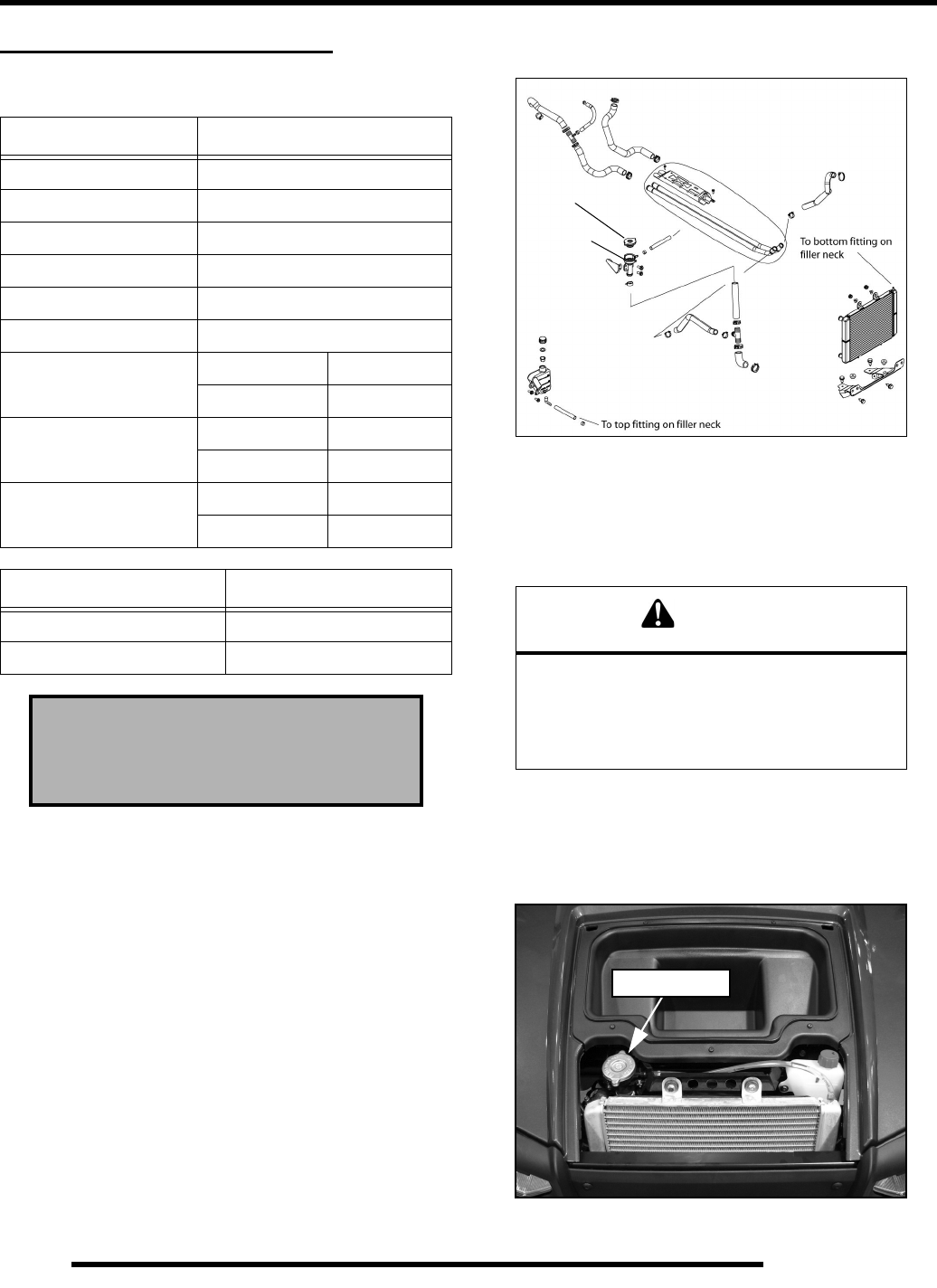
3.12
ENGINE
ENGINE COOLING SYSTEM
Cooling System Specifications
Recommended Coolant
Use only high quality antifreeze/coolant mixed with distilled
water in a 50/50 or 60/40 ratio, depending on freeze protection
required in your area.
CAUTION: Using tap water in the cooling system will lead to
a buildup of deposits which may restrict coolant flow and reduce
heat dissipation, resulting in possible engine damage. Polaris
Premium 60/40 Antifreeze/Coolant is recommended for use in
all cooling systems and comes pre-mixed, ready to use.
Cooling System Pressure Test
1. Remove the hood from the front cab.
2. Remove pressure cap and pressure test the cooling system
using a commercially available pressure tester.
3. The system must maintain 10 psi for five minutes or longer.
If pressure loss is evident within five minutes, check the
radiator, hoses, clamps and water pump seals for leakage.
Pressure Cap Test
1. Remove pressure cap and test cap using a commercially
available pressure cap tester.
2. The pressure cap relief pressure is 13 psi. Replace cap if it
does not meet this specification.
Condition Coolant Temperature F (C)
Room Temperature 68 F (20 C)
Thermostat Closed 175° F (79° C)
Thermostat Open 180° F (82° C)
Fan Off 194 F (90 C)
Thermostat Full Open Lift 202° F (94° C)
Fan On 205 F (96 C)
Engine Temperature
Overheat Indicator
Moving Vehicle: 235
F (113
C)
Idle Vehicle: 241 F (116 C)
Engine Protection
Ignition Misfire
Moving Vehicle: 239
F (115
C)
Idle Vehicle: 244 F (118 C)
Engine Protection
Shutdown
Moving Vehicle: 257
F (125
C)
Idle Vehicle: 262 F (128 C)
Item Specification
Cooling System Capacity 4.8 qts. (4.5 l)
Pressure Cap Relief 13 PSI
Polaris Premium Antifreeze
2871534 - Quart
2871323 - Gallon
WARNING
Never remove pressure cap when engine is
warm or hot. The cooling system is under
pressure and serious burns may result.
Allow the engine and cooling system to cool
before servicing.
Remove
Cap
Te s t H er e
Pressure Cap

3.13
ENGINE
3
Cooling System Exploded View
Recovery Bottle
Engine Inlet Hose
Engine Outlet Hose
Radiator
Radiator
Shroud
Radiator
Pressure Cap
Fan Motor
(Water Pump Cover)
(Thermostat Housing)
Outlet Hose
Inlet Hose
Filler Neck
To Top Fitting on Filler Neck
To Lower Fitting on Filler Neck
Bypass Hose (To Cylinder Head)
Coolant Flow Diagram
Radiator
Recovery Bottle
Engine
Water Pump
Engine
Thermostat Housing
Filler Neck
Engine Cylinder Head
Bypass

3.14
ENGINE
Cooling System Bleeding Procedure
NOTE: If the coolant level is LOW in the radiator, or
if there are leaks in the system, the coolant system
will not draw coolant from the reservoir tank.
NOTE: Use this procedure when a unit overheats
and no apparent leaks in the cooling system are
found.
1. Drive the vehicle onto a slight incline and use properly
weight rated ramps. If an incline is not available, slightly
elevate the front of the vehicle.
2. Place the vehicle in Park and block the rear wheels.
3. Remove pressure cap and top off coolant.
4. Remove recovery bottle cap and fill bottle to the full line.
5. Leave the cap off of the radiator to allow any possible air
to escape.
6. Start the engine and let it idle for 5-10 minutes or until the
thermostat opens and allows coolant to flow through the
system.
7. Slightly loosen the bleed screw (C) on the cylinder head to
let air escape. If no air is present, a steady stream of coolant
will stream out. If air is present, the screw will bubble and
sputter as the air escapes.
8. Tighten the bleed screw to 70 ± 10 in. lbs. (8 ± 1.13 Nm)
on the thermostat housing and properly install the pressure
cap.
9. Squeeze the coolant lines by hand to help purge the system
of air.
NOTE: If there is air in the system you will see air
bubbles forming through the radiator filler neck.
WARNING
Always wear safety glasses and proper shop
clothing when performing the procedures in this
manual. Failing to do so may lead to possible
injury or death.
CAUTION
Use caution when performing these procedures.
Coolant may be hot and may cause
severe injury or burns.
CAUTION
Be sure the engine has cooled and no pressure
is built up in the cooling system before removing
the pressure cap. The coolant may be hot and
could cause severe injury or burns.
Pressure Cap
Recovery Bottle
Pressure Cap
Top LH Side
of Cylinder Head
C
Spark Plug

3.15
ENGINE
3
10. Add Polaris Premium Antifreeze to the radiator filler neck
if the level goes down. If no bubbles are seen at the filler
neck, the system should be purged of air
11. Stop the engine and let cool, top off the radiator filler neck
with coolant. If you hear or see a “glug” at the filler neck,
or there is a dropping of the coolant level, indicating that
coolant has been pulled into the system; Fill the recovery
bottle only after you have completely filled the cooling
system at the radiator filler neck.
12. Repeat this procedure, if overheating still occurs.
GENERAL ENGINE SERVICE
Engine Lubrication Specifications
Accessible Engine Components
The following components can be serviced or removed with the
engine installed:
• Starter Motor / Drive
• Cylinder Head
• Cylinder
• Piston / Rings
• Rocker Arms
• Water Pump
The following components require engine removal for service:
• Flywheel
• Alternator (Stator)
• Counterbalance Shaft or Bearings
• Gear Train Components
• Camshaft
• Oil Pump / Oil Pump Drive Gear
• Connecting Rod
• Crankshaft
• Crankshaft Main Bearings
• Crankcase
Oil Pressure Test
1. Remove blind plug/sender from left side of crankcase.
2. Insert a 1/8 NPT oil pressure gauge adaptor into the
crankcase and attach the gauge.
3. Start engine and allow it to reach operating temperature,
monitoring gauge indicator.
WARNING
Be sure to install the pressure cap before
shutting off the engine.
Coolant may spit out of the radiator.
=
Capacity: Approximately 2 U.S. Quarts (1.9 L)
Oil Type: Polaris PS-4 PLUS Synthetic
Filter Wrench: PU-50105 - 2.5” (64 mm)
- Oil Pressure Specification -
27-35 psi @ 6000 RPM, Polaris PS-4 PLUS
Synthetic, Engine at operating temperature.
Oil Pressure at Idle: 6 psi
Oil Pressure at 6000 RPM (Engine Hot):
Minimum: 27 psi
Standard: 31 psi
Maximum: 35 psi

3.16
ENGINE
Oil Flow Chart
This chart describes the flow of oil through the 800 EFI engine. Beginning in the crankcase sump, the oil is drawn through an oil
galley to the feed side of the oil pump. The oil is then pumped through the oil filter. If the oil filter is obstructed, a bypass valve
contained in the filter allows oil to bypass the filter element. At this point, the oil is supplied to the main oil galley through a crankcase
passage. Oil is then diverted three ways from the main oil galley, with the first path entering the camshaft bores, onto the rear balance
shaft journal and then draining back into the crankcase sump. The second oil path from the main oil galley feeds the lifter bores and
then drains back to the crankcase sump. The third oil path flows through a crankcase galley to the MAG side crankshaft journal and
also to the front balance shaft journal and onto the crankcase sump.

3.17
ENGINE
3
Engine Removal
Because of its design configuration and fastener torque
requirements, Polaris recommends removing the engine,
transmission and rear gearcase as one assembly. Use the
following procedure when engine removal is required.
IMPORTANT: Some engine repair procedures can be
performed without removing the engine assembly
from the vehicle. Refer to “Accessible Engine
Components” on Page 3.15 for further information.
NOTE: The use of an overhead or portable engine
hoist is the only recommended method for removing
and installing the engine / transmission / rear
gearcase assembly.
NOTE: Have an assistant help guide the engine in
and out of the vehicle while using an engine hoist to
prevent personal injury or damage to vehicle
components.
1. If vehicle was recently operated, allow it to cool down
before attempting to perform any work.
2. Clean work area.
3. Thoroughly clean the engine and chassis.
4. Drain appropriate lubricant(s):
• If servicing the engine, drain engine oil.
• If servicing the transmission, drain the lubricant from
the main gearcase and transfer case.
• If servicing the rear gearcase, drain the gearcase
lubricant.
5. Remove the driver’s seat (see Chapter 5).
6. Disconnect (-) negative battery cable.
7. Remove the passenger seat(s) and remove the rear service
panel (see Chapter 5).
8. Remove the (2) screws from the rear of the center console.
9. Remove the rear seat base assembly from the vehicle by
removing the (2) fasteners from the rear seat base.
10. Remove the rear bumper, rear cargo box and box supports
from the vehicle (see Chapter 5).
11. Remove the (2) push rivets and remove the intake box from
the vehicle.
12. Elevate the rear of the vehicle off the ground using a
suitable ATV lift and remove both rear wheels.
13. Remove all exhaust components from vehicle and engine.
WARNING
Always wear safety glasses and proper shop
clothing when performing the procedures in this
manual. Failing to do so may lead to possible
injury or death.
Remove
Push Rivets

3.18
ENGINE
14. Loosen the hose clamp attaching the outlet duct to the PVT
cover. Leave the duct attached to the upper frame support.
15. Remove the (8) screws that retain the PVT cover and
remove cover.
16. Remove the high tension leads from the spark plugs and
disconnect the ignition coil harness.
NOTE: Be sure to mark / note which ignition coil
wire goes to which cylinder and ignition coil post.
The engine will misfire if the spark plug wires are
installed incorrectly. The spark plug wires are
marked PTO and MAG and should be installed to the
corresponding cylinder spark plug and coil post.
17. Remove the vent lines from the upper bolt-in frame brace
and plug vent lines to prevent fluid leakage during removal.
18. Remove the (6) fasteners retaining the upper bolt-in frame
brace and remove it from the vehicle with the ignition coil
and PVT duct attached.
19. Remove the rear stabilizer bar from the linkage on both
sides of the vehicle.
20. Remove the (4) fasteners retaining the stabilizer bar and
bracket and remove the assembly from the vehicle.
21. Remove the engine breather hose from the valve cover.
Outlet Duct
PVT Cover
Harness
Connection
Ignition
Coil
Frame Support
PVT Duct

3.19
ENGINE
3
22. Loosen the hose clamp between the throttle body and intake
adaptor.
23. Disconnect the T-MAP, IAC and TPS sensor connectors
from throttle body.
24. Remove the remaining bolt attaching the airbox to the
frame (see photo).
25. Remove the airbox and throttle body from the vehicle as an
assembly. Take care in not allowing the throttle cable to
bend excessively or kink. Carefully place the assembly on
the floor next to the vehicle. Insert a shop towel into the
engine intake adaptor to prevent dirt from entering the
engine.
NOTE: Ensure throttle cable is not being
excessively bent or kinked while removed from the
vehicle.
26. Mark the fuel injector harnesses to identify MAG and PTO
harness connections to aid during reassembly. Disconnect
the fuel injector harnesses.
NOTE: The fuel injector harness connector and
locking spring is bonded to the fuel injectors with an
epoxy mix. DO NOT attempt to disconnect the
connector from the fuel injectors. Damage will occur
to the injector and/or harness if attempting to
separate at that location. Separate the fuel injector
from the vehicle by disconnecting at the end of the
harness as shown.
IMPORTANT: Be sure to mark / note the color of the
fuel injector connectors. For proper engine function,
the fuel injectors must be connected correctly. Make
note of PTO and MAG side injectors before
disconnecting them. PTO = GRAY , MAG = BLACK
Loosen
Clamp
Disconnect Here
DO NOT
Disconnect Here
Fuel
Injector
Harness

3.20
ENGINE
27. Disconnect the fuel line from the fuel injector rail by
slightly squeezing the lock tabs and gently pushing the
connector lock out. To separate the lines, pull the fuel line
from the tank strait down.
28. Disconnect the shift cable from the transmission bell crank.
29. Mark the upper jam nut and loosen the lower jam nut. Pull
the shift cable out of the mount.
NOTE: If the upper jam nut is moved, shift cable
adjustment will be required during engine
installation (see Chapter 2 “Shift Cable Inspection /
Adjustment”).
30. Disconnect the transmission gear indicator switch harness.
31. Disconnect the CPS harness.
32. Disconnect the stator / alternator harness.
Squeeze locking tabs together
Push lock outward
Remove
Clip
Lower
Jam Nut
Mark Upper
Jam Nut
Gear Switch
Connector
CPS
Connector
Stator
Connector

3.21
ENGINE
3
33. Disconnect the transmission speed sensor harness.
34. Disconnect the cam phase sensor connector.
35. Remove the castle nuts from both rear wheel hubs.
36. Remove the through-bolt that attaches the upper A-arm to
the rear hub on both sides of the vehicle.
37. Pivot the A-arms upward and rear hub carriers downward
and remove the drive shafts from the hub carriers.
38. Grasp the rear drive shafts and pull sharply outward on the
shafts to disengage them from the rear gearcase.
NOTE: Clean area around drive shaft orifices on
both sides of rear gearcase and cover orifices using
duct tape. This will prevent the lubricant from
leaking out during removal.
Speed Sensor
Connector
Cam Phase
Connector
Castle Nut
Hub Carrier
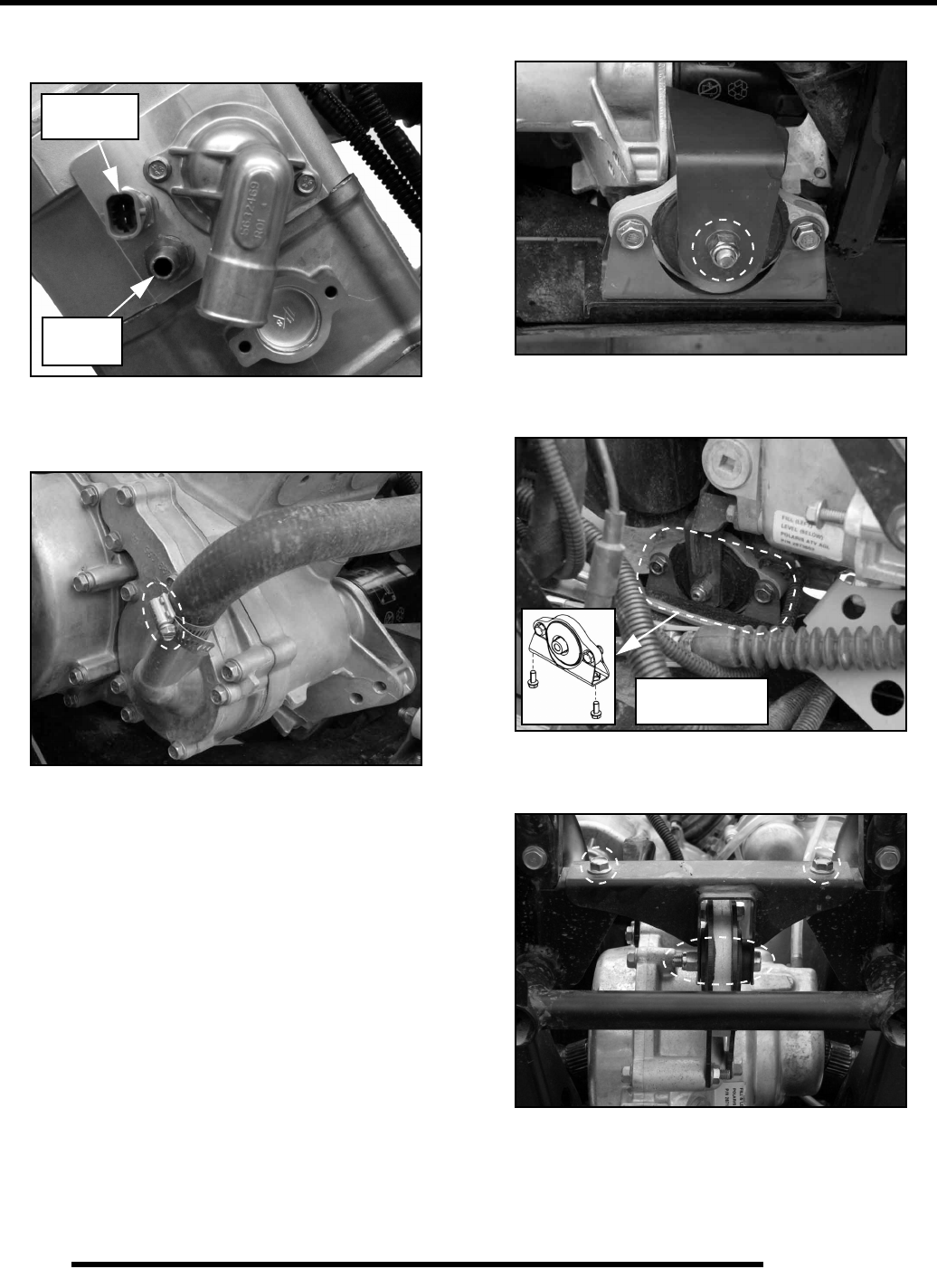
3.22
ENGINE
39. Disconnect the engine coolant temperature (ECT) sensor
harness and the bypass coolant hose.
40. Loosen the hose clamp and remove the lower coolant hose
from the water pump cover inlet and drain coolant into a
suitable container.
41. Remove the filler neck pressure cap to relieve the cooling
system vacuum.
NOTE: Use a portable wet-vac or syphon to prevent
any coolant from spilling.
42. Remove the upper coolant hose from the thermostat
housing outlet to relieve any coolant vacuum created in the
engine. Allow engine coolant to completely drain. Properly
dispose of the engine coolant / antifreeze.
43. Remove the (+) positive battery cable from the starter
motor terminal and (-) negative battery cable from the
starter motor engine mount.
44. Remove the outer PVT cover.
45. Remove RH engine mount fastener.
46. Remove the (2) lower bolts that retain the LH transmission
mount to the frame.
47. Remove the (2) rear gearcase mount bracket fasteners and
mount bolt and remove bracket from vehicle.
NOTE: The use of an overhead or portable engine
hoist is the only recommended method for removing
and installing the engine / transmission / rear
gearcase assembly.
ECT
Connector
Coolant
Bypass
Remove
(2) Lower Bolts

3.23
ENGINE
3
48. Using an engine hoist, hook a chain between the engine /
transmission mounting plate and the transmission / rear
gearcase mounting plate.
NOTE: Have an assistant help guide the engine in
and out of the vehicle while using an engine hoist to
prevent personal injury or damage to vehicle
components.
49. Lift the front portion of the assembly out first to allow the
engine valve cover to clear the vehicle frame.
50. Remove propshaft from the transmission output shaft.
51. Then move assembly towards the front of the vehicle while
lifting it out to allow the rear gearcase to clear the rear
portion of the frame.
52. Then lift assembly high enough to clear vehicle frame and
completely remove it from the vehicle to a work bench.
Transmission/Gearcase
Mount Plate
Engine/Transmission
Mount Plate
Allow valve cover
to clear frame

3.24
ENGINE
Engine / Transmission Separation
Once the engine / transmission / rear gearcase assembly has
been removed from the vehicle, the engine and transmission will
need to be separated to allow engine servicing. Use the
following procedure to separate the engine from the assembly.
1. Remove the drive belt, drive clutch and driven clutch (see
Chapter 6).
2. Remove the (6) fasteners retaining the inner clutch cover
to the engine and transmission.
3. Remove only the (4) outer fasteners retaining the engine to
the transmission bracket.
4. Tilt the assembly up and remove the remaining (2) nuts that
retain the transmission to the engine.
5. Carefully separate the engine and perform the required
service (see “Engine Disassembly and Inspection”).

3.25
ENGINE
3
ENGINE DISASSEMBLY AND INSPECTION
Cylinder Head Assembly Exploded View
Push Rods
Hydraulic Lifters
Valves
Cylinder Head
Coolant Bleeder
Springs
Spring Retainers
Rocker Arms
Retainer Locks (keepers)
Valve Spring Seats (2)
Valve Seals (2)
Head Bolts

3.26
ENGINE
Rocker Arms
1. Remove the valve cover.
2. Mark or tag rocker arms in order of disassembly to keep
them in order for reassembly.
3. Inspect the wear pad at the valve end of the rocker arm for
indications of scuffing or abnormal wear. If the pad is
grooved, replace the rocker arm.
NOTE: Do not attempt to true this surface by
grinding.
4. Check the rocker arm pad and fulcrum seat for excessive
wear, cracks, nicks or burrs.
Push Rods
1. Clean push rods (A) in a suitable solvent. Blow dry push
rods with compressed air.
2. Use compressed air to confirm the oil passage is clear in the
center of the push rod.
3. Check the ends of the push rods (A) for nicks, grooves,
roughness or excessive wear.
4. The push rods (A) can be visually checked for straightness
while they are installed in the engine by rotating them with
the valve closed. Push rods can also be checked with a dial
indicator or rolled across a flat surface to check for
straightness.
5. If the push rod (A) is visibly bent, it should be replaced.
Cylinder Head Removal
NOTE: The cargo box assembly and the upper frame
bolt-in brace must be removed to allow enough
clearance to remove all the cylinder head bolts.
Refer to Chapter 5 for removal procedures.
1. Loosen the six cylinder head bolts evenly 1/8 turn each in
a criss-cross pattern until loose.
2. Remove bolts (A) and tap cylinder head (B) lightly with a
soft face hammer until loose. CAUTION: Tap only in
reinforced areas or on thick parts of cylinder head casting
to avoid damaging the head or cylinder.
3. Remove cylinder head (B) and head gasket (C) from the
cylinder (D).
WARNING
Always wear safety glasses when working with
compressed air to prevent personal injury.
A
A
C
D
B
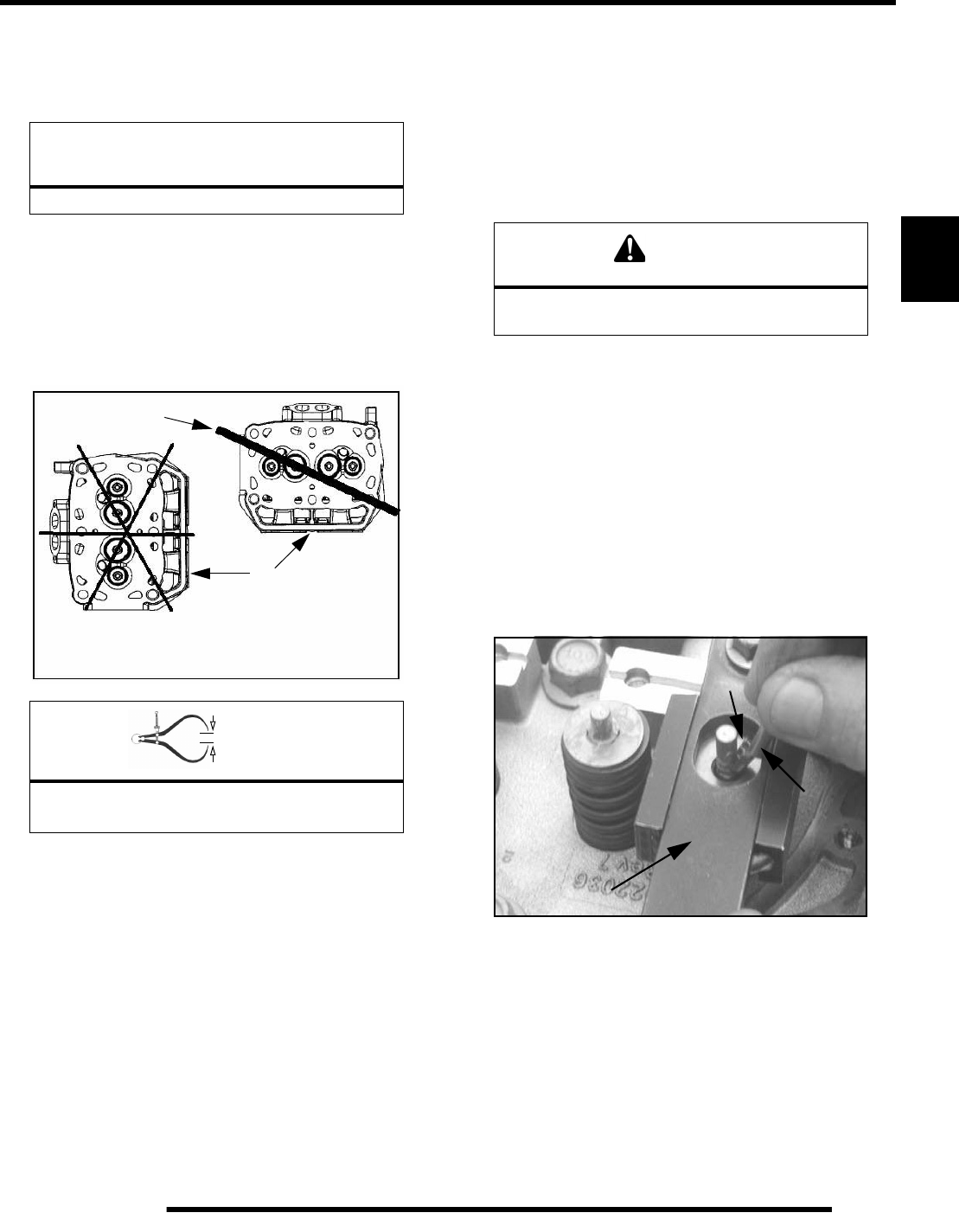
3.27
ENGINE
3
Cylinder Head Inspection
Thoroughly clean cylinder head surface to remove all traces of
gasket material and carbon.
Cylinder Head Warp
1. Lay a straight edge (A) across the surface of the cylinder
head (B) at several different points and measure warp by
inserting a feeler gauge between the straight edge and the
cylinder head surface. If warp exceeds the service limit,
replace the cylinder head.
Valve Seal / Spring Service (On Engine)
NOTE: The following procedure is only for servicing
the top end of the valve train when replacing valve
springs or replacing valve seals.
In some cases the valve train can be serviced while the cylinder
head is still on the engine. Keep all parts in order with respect
to their location in the cylinder head.
1. Having already removed the valve cover, rocker arms and
pushrods, align the cylinder to be worked on at top dead
center (TDC). Install the Valve Pressure Hose (PU-45652)
into the spark plug hole. Hook the hose to an air
compressor and supply 50 to 100 psi to the hose. This will
seat the valves during valve spring removal. Do not
remove air from the hose at anytime until reassembly is
completed.
2. Using the Valve Spring Compressor (PU-45257),
compress the valve spring and remove the valve keepers.
NOTE: A small parts magnet (A) can aid in the
removal of the retainers (B).
NOTE: To prevent damage to the valve seals, do not
compress the valve spring more than is needed to
remove the valve keepers.
3. Remove spring retainer and spring.
4. The valve seals are now serviceable.
CAUTION
Use care not to damage sealing surface.
= In. / mm.
Cylinder Head Warp Limit:
.004" (.1016 mm) max
A
B
Measure at different
points on the surface.
WARNING
Wear eye protection or a face shield during
cylinder head disassembly and reassembly.
A
B
PU-45257

3.28
ENGINE
Cylinder Head Disassembly
1. Carefully remove the cylinder components.
2. Place the hydraulic lifters (C), pushrods (D), and rocker
arms (E) in a safe, clean area.
3. Measure free length of spring with a Vernier caliper.
Compare to specifications. Replace spring if measurement
is out of specification.
4. Remove valve guide seals.
IMPORTANT: It is recommended to replace seals
whenever the cylinder head is disassembled.
Hardened, cracked or worn valve seals will cause
excessive oil consumption and carbon buildup.
5. Mark the valves with a white pen. Remove the valves from
the cylinder head. This will ensure that the valves are
properly placed during engine reassembly.
= In. / mm.
Valve Spring Free Length:
Std: 1.735" (44.069 mm)
D
C
E
Valve Spring
Free Length
Mark the Valves

3.29
ENGINE
3
Valve Inspection
1. Remove all carbon from valves with a soft wire wheel or
brush.
2. Check valve face for runout, pitting, and burnt spots. To
check for bent valve stems, mount valve in a drill or use “V”
blocks and a dial indicator.
3. Check end of valve stem for flaring, pitting, wear or damage
(A). Inspect split keeper groove for wear or flaring of the
keeper seat area (B).
NOTE: The valves can be re-faced or end ground, if
necessary. They must be replaced if extensively
worn, burnt, bent, or damaged.
4. Measure diameter of valve stem with a micrometer in three
places, then rotate 90 degrees and measure again (six
measurements total). Compare to specifications.
5. Measure valve guide (C) inside diameter at the top middle
and end of the guide using a small hole gauge and a
micrometer. Measure in two directions.
6. Subtract valve stem measurement from the valve guide
measurement to obtain stem to guide clearance.
NOTE: The valve guides cannot be replaced. Be
sure to measure each guide and valve combination
individually.
A
B
Measure valve stem in several places.
Rotate the valve 90 degrees and measure
for wear.
= In. / mm.
Valve Stem Diameter:
Intake: 0.2356" 0.00039"
(5.985 0.01 mm)
Exhaust: 0.2351" 0.00039"
(5.972 0.01 mm)
= In. / mm.
Valve Guide I.D.:
0.23672" 0.000295"
(6.0617 0.0075 mm)
C

3.30
ENGINE
Combustion Chamber
1. Clean all accumulated carbon deposits from combustion
chamber and valve seat area with carbon cleaner and a soft
plastic scraper.
IMPORTANT: Do not use a wire brush, metal scraper,
or abrasive cleaners to clean the bottom of the
cylinder head. Extensive damage to the cylinder head
may result. Wear safety glasses during cleaning.
Valve Seat Reconditioning
NOTE: Polaris recommends that the work be done
by a local machine shop that specializes in this area.
NOTE: The cylinder head valve guides cannot be
replaced.
Valve Seat Inspection
Inspect valve seat in cylinder head for pitting, burnt spots,
roughness, and uneven surface. If any of the above conditions
exist, the valve seat must be reconditioned. If the valve seat is
cracked the cylinder head must be replaced.
Follow the manufacturers instructions provided with the valve
seat cutters in the commercially available cylinder head
reconditioning kit. Abrasive stone seat reconditioning
equipment can also be used. Keep all valves in order with their
respective seat.
NOTE: Valve seat width and point of contact on the
valve face is very important for proper sealing. The
valve must contact the valve seat over the entire
circumference of the seat, and the seat must be the
proper width all the way around. If the seat is
uneven, compression leakage will result. If the seat
is too wide, seat pressure is reduced, causing
carbon accumulation and possible compression
loss. If the seat is too narrow, heat transfer from
valve to seat is reduced. The valve may overheat and
warp, resulting in burnt valves.
1. Install pilot into valve guide.
2. Apply cutting oil to valve seat and cutter.
3. Place 46 cutter on the pilot and make a light cut.
WARNING
Wear eye protection or a face shield during
cylinder head disassembly and reassembly.
Combustion Area
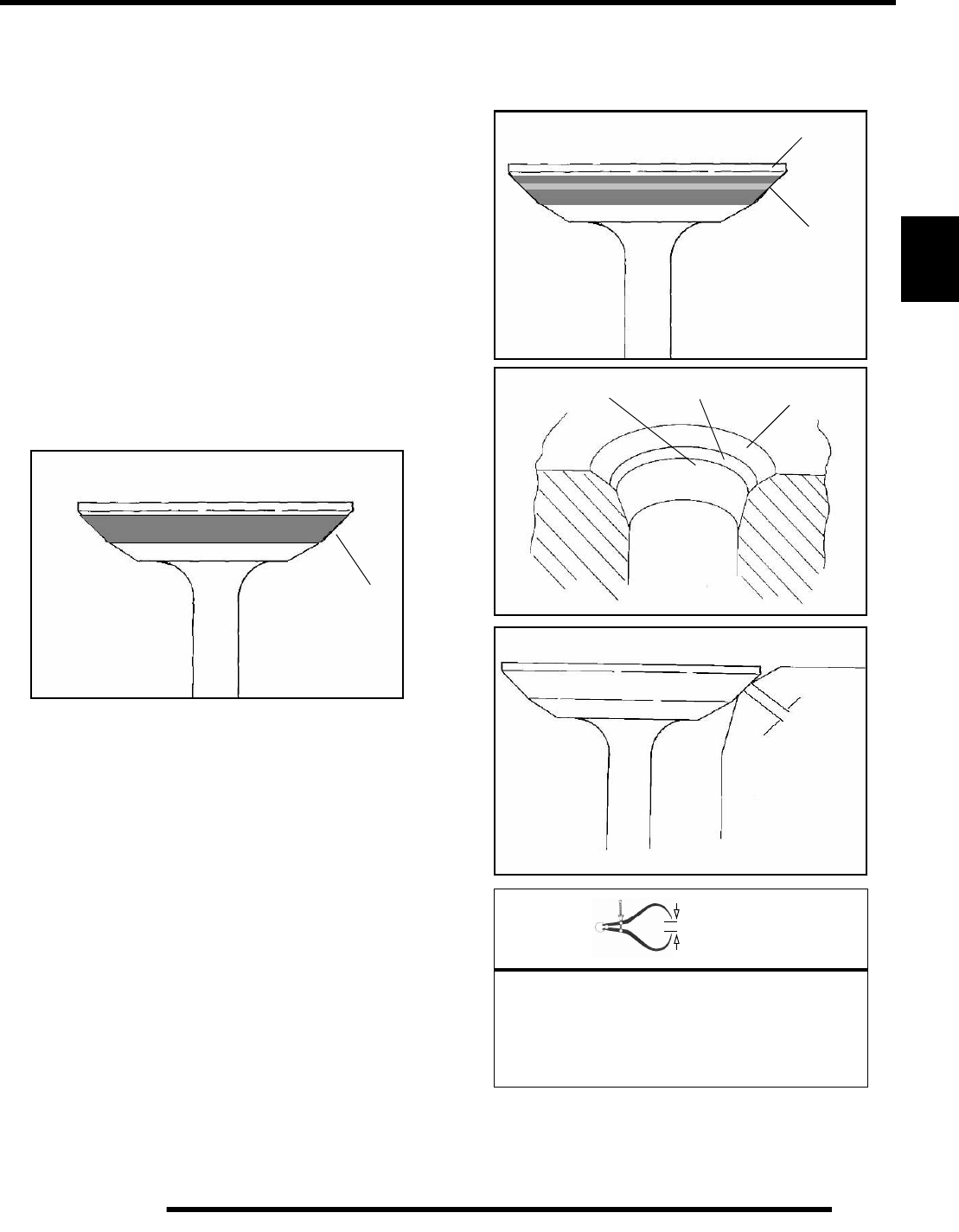
3.31
ENGINE
3
4. Inspect the cut area of the seat:
* If the contact area is less than 75% of the circumference of the
seat, rotate the pilot 180 and make another light cut.
* If the cutter now contacts the uncut portion of the seat, check
the pilot. Look for burrs, nicks, or runout. If the pilot is bent it
must be replaced.
* If the contact area of the cutter is in the same place, the valve
guide is distorted from improper installation
* If the contact area of the initial cut is greater than 75%,
continue to cut the seat until all pits are removed and a new seat
surface is evident. NOTE: Remove only the amount of material
necessary to repair the seat surface.
5. To check the contact area of the seat on the valve face, apply
a thin coating of Prussian Blue paste to the valve seat. If
using an interference angle (46) apply black permanent
marker to the entire valve face (A).
6. Insert valve into guide and tap valve lightly into place a few
times.
7. Remove valve and check where the Prussian Blue
indicates seat contact on the valve face. The valve seat
should contact the middle of the valve face or slightly
above, and must be the proper width.
* If the indicated seat contact is at the top edge of the valve face
and contacts the margin area (B) it is too high on the valve face.
Use the 30 cutter to lower the valve seat.
* If too low, use the 60 cutter to raise the seat. When contact
area is centered on the valve face, measure seat width.
* If the seat is too wide or uneven, use both top and bottom
cutters to narrow the seat.
* If the seat is too narrow, widen using the 45 cutter and re-
check contact point on the valve face and seat width after each
cut.
NOTE: When using an interference angle, the seat
contact point on the valve will be very narrow, and is
a normal condition. Look for an even and continuous
contact point all the way around the valve face (A).
8. Clean all filings from the area with hot soapy water. Rinse
and dry with compressed air.
A
= In. / mm.
Valve Seat Width:
Intake Std: .028" (.7 mm)
Limit: .055" (1.4 mm)
Exhaust Std: .039” (1.0 mm)
Limit: .071" (1.8 mm)
B
A
Proper Seat Contact
on Valve Face
Bottom 60Seat 45Top 30
Seat
Width

3.32
ENGINE
9. Lubricate the valve guides with clean engine oil, and apply
oil or water based lapping compound to the face of the
valve.
NOTE: Lapping is not required with an interference
angle valve job.
10. Insert the valve into its respective guide and lap using a
lapping tool or a section of fuel line connected to the valve
stem.
11. Rotate the valve rapidly back and forth until the cut sounds
smooth. Lift the valve slightly off of the seat, rotate 1/4 turn,
and repeat the lapping process. Do this four to five times
until the valve is fully seated, and repeat process for the
other valve(s).
12. Thoroughly clean cylinder head and valves.
Cylinder Head Reassembly
NOTE: Assemble the valves one at a time to
maintain proper order.
1. Apply engine oil to valve guides and seats.
2. Coat valve stem with molybdenum disulfide grease or
PS-4 PLUS Synthetic engine oil.
3. Install valve carefully with a rotating motion to avoid
damaging valve seal.
4. Valve seals should be installed after the valves are in the
head to avoid valve seal damage. Install new valve seals on
valve guides.
5. Dip valve spring and retainer in clean engine oil and install.
6. Place retainer on spring and install Valve Spring
Compressor (PU-45257). Install split keepers with the gap
even on both sides.
NOTE: A small magnet can be used to aid in the
installation of the keepers.
7. Repeat procedure for remaining valves. When all valves are
installed, tap lightly with soft faced hammer on the end of
the valves to seat the split keepers.
NOTE: To prevent damage to the valve seals, do not
compress the valve spring more than necessary to
install the keepers.
PU-45257

3.33
ENGINE
3
Valve Sealing Test
1. Clean and dry the combustion chamber area (A).
2. Pour a small amount of clean solvent onto the intake port
and check for leakage around each intake valve. The valve
seats should hold fluid with no seepage.
3. Repeat for exhaust valves by pouring fluid into exhaust
port.
Cylinder Removal
1. Follow engine disassembly procedures to remove rocker
cover and cylinder head.
2. Tap cylinder (A) lightly with a rubber mallet in the
reinforced areas only until loose.
3. Rock cylinder forward and backward while lifting it from
the crankcase, supporting pistons and connecting rods.
Support pistons with Piston Support Block (PN 2870390).
Valve Lifter Removal / Inspection
1. Remove the valve lifters by reaching into the crankcase
and pushing the lifter up through the lifter bore by hand.
2. Thoroughly clean the lifters in cleaning solvent and wipe
them with a clean, lint-free cloth.
3. Mark the lifters with a white pen if using the lifters for
reassembly. This will ensure that the lifters are properly
placed during engine reassembly.
4. Check the lifters for wear or scores.
5. Check the bottom end of lifter to make sure that it has a
slight convex.
6. If the bottom surface has worn flat, it may be used with the
original camshaft only.
NOTE: Lifters that are scored, worn, or if the bottom
is not smooth should be replaced with new lifters
and cam as an assembly. If replacing the lifters, the
camshaft should also be replaced.
A
A
Mark Hydraulic Lifter
Inspect Hydraulic Lifter

3.34
ENGINE
Piston Removal
1. Remove the circlip. Mark the piston with a white pen to
ensure proper orientation (if reused) during assembly.
NOTE: If the pistons are to be reused, reassemble
the pistons in the same cylinder and direction from
which they were removed.
NOTE: New pistons are non-directional and can be
placed in either cylinder.
2. Remove piston circlip and push piston pin out of piston. If
necessary, heat the crown of the piston slightly with a
propane torch. CAUTION: Do not apply heat to the piston
rings. The ring may lose radial tension.
3. Remove top compression ring:
*Using a piston ring pliers: Carefully expand ring and lift it off
the piston. CAUTION: Do not expand the ring more than the
amount necessary to remove it from the piston, or the ring may
break.
*By hand: Placing both thumbs as shown, spread the ring open
and push up on the opposite side. Do not scratch the ring lands.
4. Repeat procedure for second ring.
5. Remove the oil control ring.
The oil control ring is a three piece design consisting of a top
and bottom steel rail and a center expander section. The top rail
has a locating tab on the end which fits into a notch (B) in the
upper oil ring land of the piston.
To Remove:
A) Remove the top rail first followed by the bottom rail.
B) Remove the expander.
Compression
Rings
Oil Ring
B
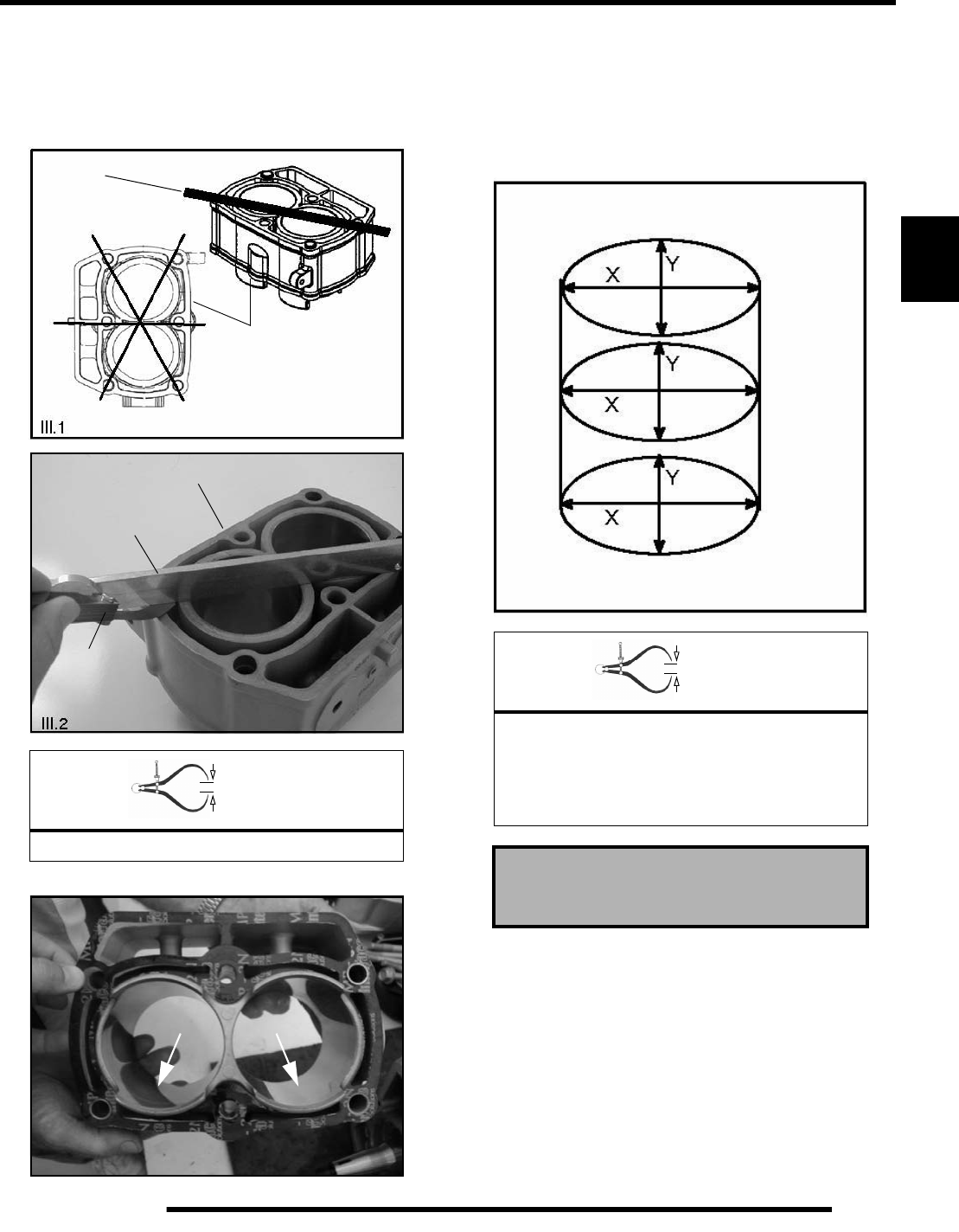
3.35
ENGINE
3
Cylinder Inspection
1. Remove gasket material from cylinder sealing surfaces.
2. Inspect the top of the cylinder (B) for warp using a straight
edge (A) and feeler gauge (C). Refer to Ill. 1 and Ill. 2.
3. Inspect cylinder for wear, scratches, or damage.
4. Inspect cylinder for taper and out of round with a
telescoping gauge or a dial bore gauge. Measure in two
different directions, front to back and side to side, on three
different levels (1/2, down from top, in the middle, and 1/
2, up from bottom). Record measurements. If cylinder is
tapered or out of round beyond .002", the cylinder must be
replaced.
= In. / mm.
Cylinder Warp: .004" (0.1 mm) Max.
Measure at different
points on surface.
A
B
A
B
C
= In. / mm.
Cylinder Taper Limit:
.002" (.050 mm) Max.
Cylinder Out of Round:
Limit: .002" (.050 mm) Max.
Standard Bore Size
(Both Cylinders): 3.1496" (80 mm)
1/2” Down From Top of Cylinder
1/2” Up From Bottom
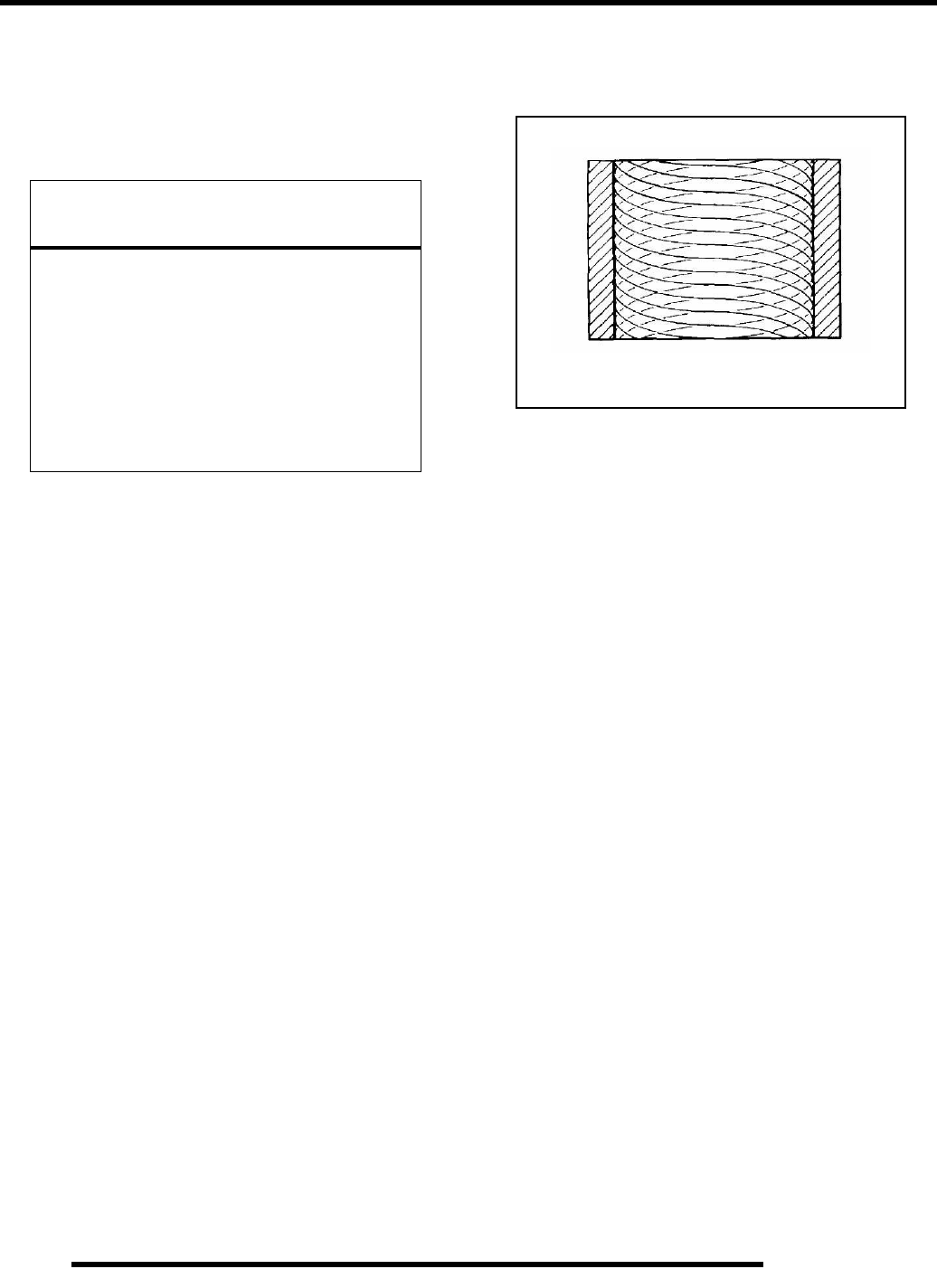
3.36
ENGINE
Cylinder Hone Selection and Honing
Procedure
Cylinders may be wet or dry honed depending upon the hone
manufacturer’s recommendations. Wet honing removes more
material faster and leaves a more distinct pattern in the bore.
Honing To Deglaze
A finished cylinder should have a cross-hatch pattern to ensure
piston ring seating and to aid in the retention of the fuel/oil
mixture during initial break in. Hone cylinder according to hone
manufacturer's instructions, or these guidelines:
• Honing should be done with a diamond hone. Cylinder
could be damaged if the hone is not hard enough to
scratch the nicasil lining.
• Use a motor speed of approximately 300-500 RPM, run
the hone in and out of the cylinder rapidly until cutting
tension decreases. Remember to keep the hone drive
shaft centered (or cylinder centered on arbor) and to
bring the stones approximately 1/2” (1.3 cm) above and
below the bore at the end of each stroke.
• Release the hone at regular intervals and inspect the
bore to determine if it has been sufficiently de-glazed,
and to check for correct cross-hatch.
NOTE: Do not allow cylinder to heat up during honing.
• After honing has been completed, inspect cylinder for
thinning or peeling.
If cylinder wear or damage is excessive, it will be necessary to
replace the cylinder. The cylinders are lined with a nicasil
coating and are not repairable. Hone only enough to de-glaze the
outer layer of the cylinder bore.
IMPORTANT: Clean the cylinder after honing
If cylinder wear or damage is excessive, it will be necessary to
replace the cylinder. The cylinders are lined with a nicasil
coating and are not repairable. Hone only enough to de-glaze the
outer layer of the cylinder bore.
Cleaning the Cylinder After Honing
It is very important that the cylinder be thoroughly cleaned after
honing to remove all grit material. Wash the cylinder in a
solvent, then in hot, soapy water. Pay close attention to areas
where the cylinder sleeve meets the aluminum casting (transfer
port area). Use electrical contact cleaner if necessary to clean
these areas. Rinse thoroughly, dry with compressed air, and oil
the bore immediately with Polaris Lubricant.
CAUTION
A hone which will straighten as well as remove
material from the cylinder is very important.
Using a common spring loaded glaze breaker
for honing is not advised for nicasil cylinders.
Polaris recommends using a rigid hone or arbor
honing machine. Cylinders may be wet or dry
honed depending upon the hone manufacturer's
recommendations.
Wet honing removes more material faster and
leaves a more distinct pattern in the bore.
Example of Cross Hatch Pattern
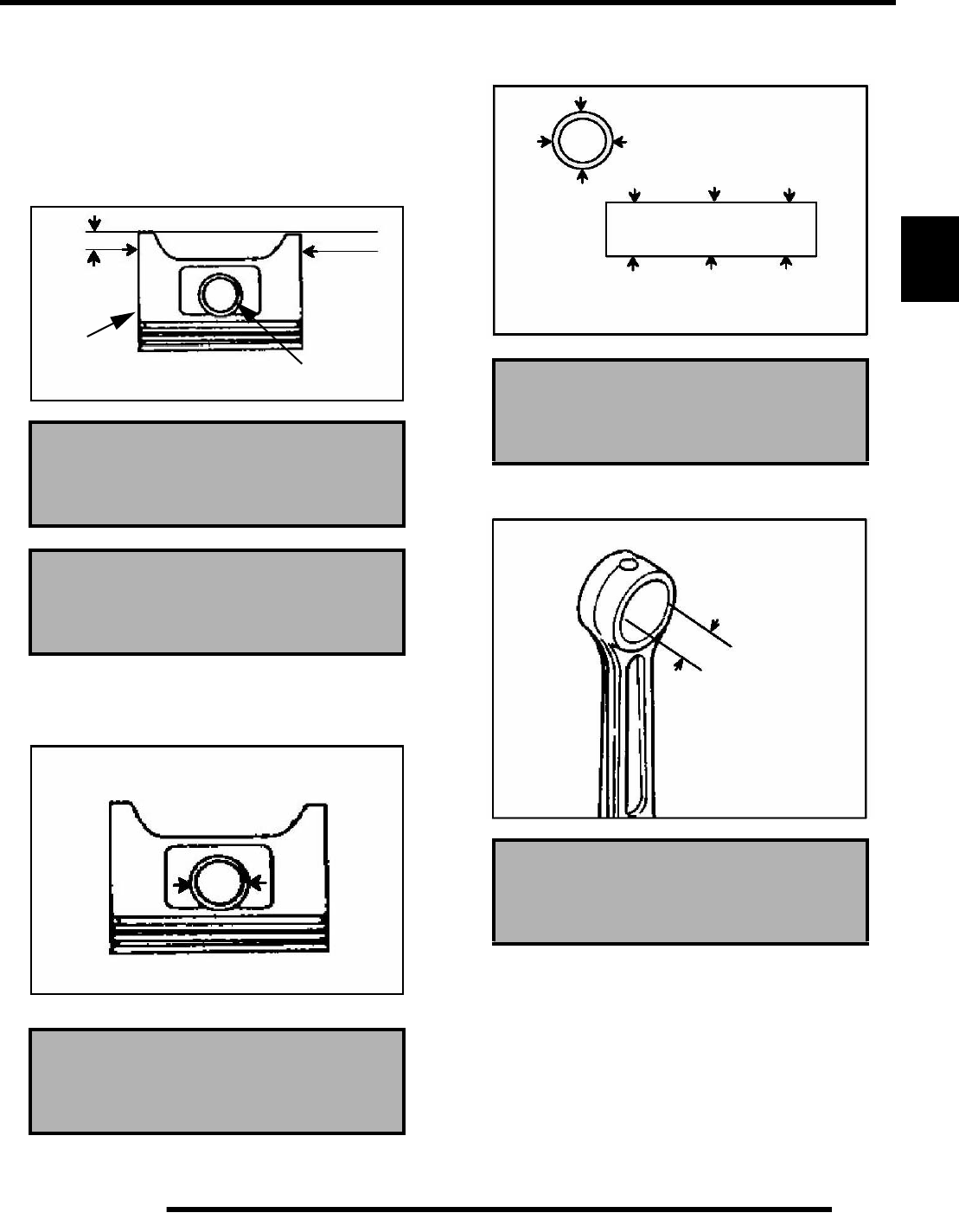
3.37
ENGINE
3
Piston-to-Cylinder Clearance
Measure piston outside diameter at a point 5 mm up from the
bottom of the piston at a right angle to the direction of the piston
pin.
Subtract this measurement from the maximum cylinder bore
measurement obtained during the “Cylinder Inspection”
procedure.
Piston / Rod Inspection
1. Measure piston pin bore.
2. Measure piston pin O.D. Replace piston and/or piston pin
if out of specification.
3. Measure connecting rod small end ID.
Piston to Cylinder Clearance:
See “800 EFI Engine Service
Specifications” on page 3.9
Piston O.D.:
See “800 EFI Engine Service
Specifications” on page 3.9
Piston Pin Bore:
See “800 EFI Engine Service
Specifications” on page 3.9
5 mm
Piston
Piston Pin
Piston Pin O.D.:
See “800 EFI Engine Service
Specifications” on page 3.9
Connecting Rod Small End I.D.:
See “800 EFI Engine Service
Specifications” on page 3.9
Piston Pin Measurement Locations

3.38
ENGINE
4. Measure piston ring to groove clearance by placing the ring
in the ring land and measuring with a thickness gauge.
Replace piston and rings if ring-to-groove clearance
exceeds service limits.
Piston Ring Installed Gap
1. Place each piston ring (A) inside cylinder (B) using a
piston to push ring squarely into place as shown.
NOTE: Ring should be installed with the mark facing
upward.
2. Measure installed gap with a feeler gauge (C) at both the
top and bottom of the cylinder.
IMPORTANT: A difference in end gap indicates
cylinder taper. The cylinder should be measured for
excessive taper and out of round.
3. If the bottom installed gap measurement exceeds the
service limit, replace the rings. If ring gap is smaller than
the specified limit, file ring ends until gap is within
specified range.
NOTE: Always check piston ring installed gap after
re-boring a cylinder or when installing new rings. A
re-bored cylinder should always be scrubbed
thoroughly with hot soapy water, rinsed, and dried
completely. Wipe cylinder bore with oil immediately
to remove residue and prevent rust.
Starter Drive Bendix Removal / Inspection
1. Remove stator housing bolts and remove housing.
2. Remove the flywheel nut and washer. Install Flywheel
Puller (PN 2871043) and remove flywheel.
NOTE: Do not thread the puller bolts into the
flywheel more than 1/4, or stator coils may be
damaged.
3. Remove starter bendix assembly (A). Note the thrust
washers located on both sides of the bendix.
4. Inspect the thrust washer for wear or damage and replace
if necessary.
5. After the bendix is removed, remove the two bolts retaining
the starter. Tap on the starter assembly (B) with a soft faced
mallet to loosen the starter from the crankcase.
See “800 EFI Engine Service
Specifications” on page 3.9
Piston Ring Installed Gap:
See “800 EFI Engine Service
Specifications” on page 3.9
Piston
Ring
Feeler Gauge
A
B
C
25-50 mm
A
B

3.39
ENGINE
3
6. Inspect gear teeth on starter drive (A). Replace starter drive
if gear teeth are cracked, worn, or broken.
7. Inspect the bendix bushing (C) in the mag cover for wear.
Replace as needed.
Flywheel / Stator Removal / Inspection
1. Remove stator housing bolts and remove housing.
2. Remove flywheel nut and washer.
3. Install Flywheel Puller (PN 2871043) and remove flywheel
(A).
4. Use caution when removing the wire holddown (B) and the
stator assembly (D). Do not tap or bump the gear /stator
housing cover or the stator. This could cause the seal
around the gear/stator housing cover and the crankcase to
break, causing a leak.
5. Remove the bendix (E) if necessary.
Engine Crankcase Disassembly / Inspection
1. Remove the stator cover (A) and water pump cover (B).
CAUTION
Do not thread the puller bolts into the flywheel
more than 1/4, or stator coils may be damaged.
C
Remove Stator
Cover
A
2871043
E
BD
A
B
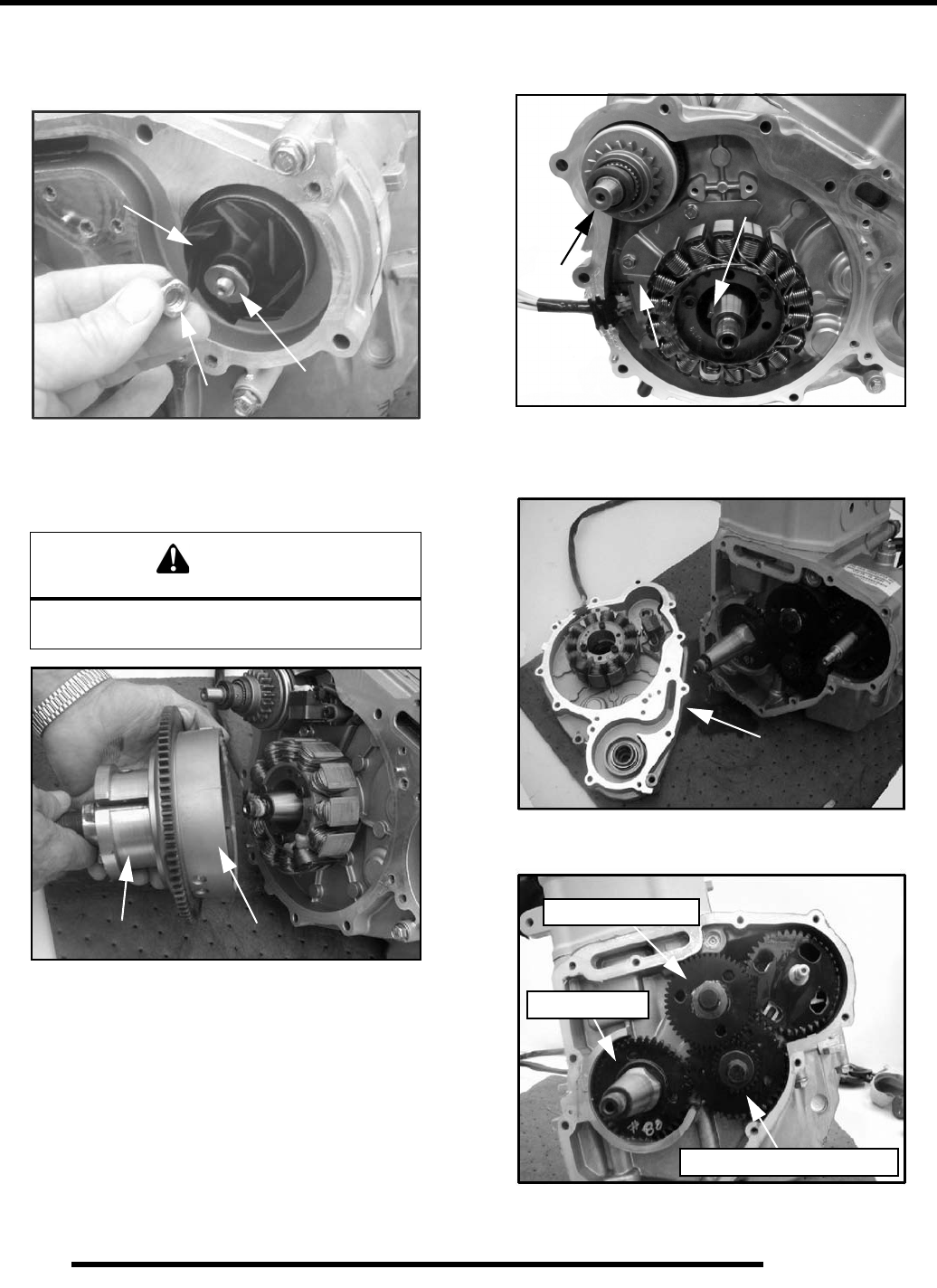
3.40
ENGINE
2. Remove the nut (C), washer (D) and water pump impeller
(E). Remove part of the water pump seal behind the
impeller.
3. Remove flywheel nut and washer.
4. Install Flywheel Puller (PN 2871043) and remove flywheel
(F).
5. Remove the starter bendix (G), wire holddown plate (H),
and the woodruff key (I) from the crankshaft. The stator
does not have to be removed at this point.
6. Remove the gear/stator housing bolts and remove the gear/
stator housing cover (J) and gasket from the crankcase. Be
sure to catch the excess oil from the crankcase.
7. Note the position of the gears in the photo.
CAUTION
Do not thread the puller bolts into the flywheel
more than 1/4, or stator coils may be damaged.
D
E
C
F
2871043
G
H
I
J
Counterbalance Gear
Camshaft Gear
Crank Gear

3.41
ENGINE
3
8. Use a white pen to accent the timing marks on the following
gears: camshaft gear (K), crankshaft gear (M), or
counterbalance gear (N) This will ensure proper gear
alignment and timing during reassembly of the gears.
NOTE: If replacing one of the gears, it is
recommended that all of the gears be replaced. A
gear kit is available.
9. Use the Cam Gear Tooth Alignment Tool (PU-45497-2) to
align and hold the cam split gear assembly. With the split
gear aligned, remove the bolt and cam gear assembly.
NOTE: Install the Cam Gear Tooth Alignment Tool
(PU-45497-2) into the assembly hole counter
clockwise from the timing mark (see page 3.42).
10. Inspect the cam gear teeth and check to make sure there is
spring tension offsetting the teeth between the two gears.
If there is no tension, check the springs inside of the cam
gear assembly.
11. The cam gear assembly contains three loaded springs. To
open the cam gear assembly:
• Place the cam gear on a flat surface with the timing
mark side facing up.
• While holding both gears together, lightly work a small
flathead screwdriver between the two gears.
• Remove the top gear. The springs should stay in place.
12. Remove all three springs using one of the tapered pins from
the Tapered Pins (PU-45497-1).
13. With a white marking pen, accent the timing mark on the
gear that contains the springs.
MN
K
Timing Marks
Water Pump Gear
3 Loaded Springs
CAUTION
Wear safety glasses at all times. Use caution
when working with the top gear.
The springs could cause injury or become lost
should they pop out.
PU-45497-1
Accent Timing Marks
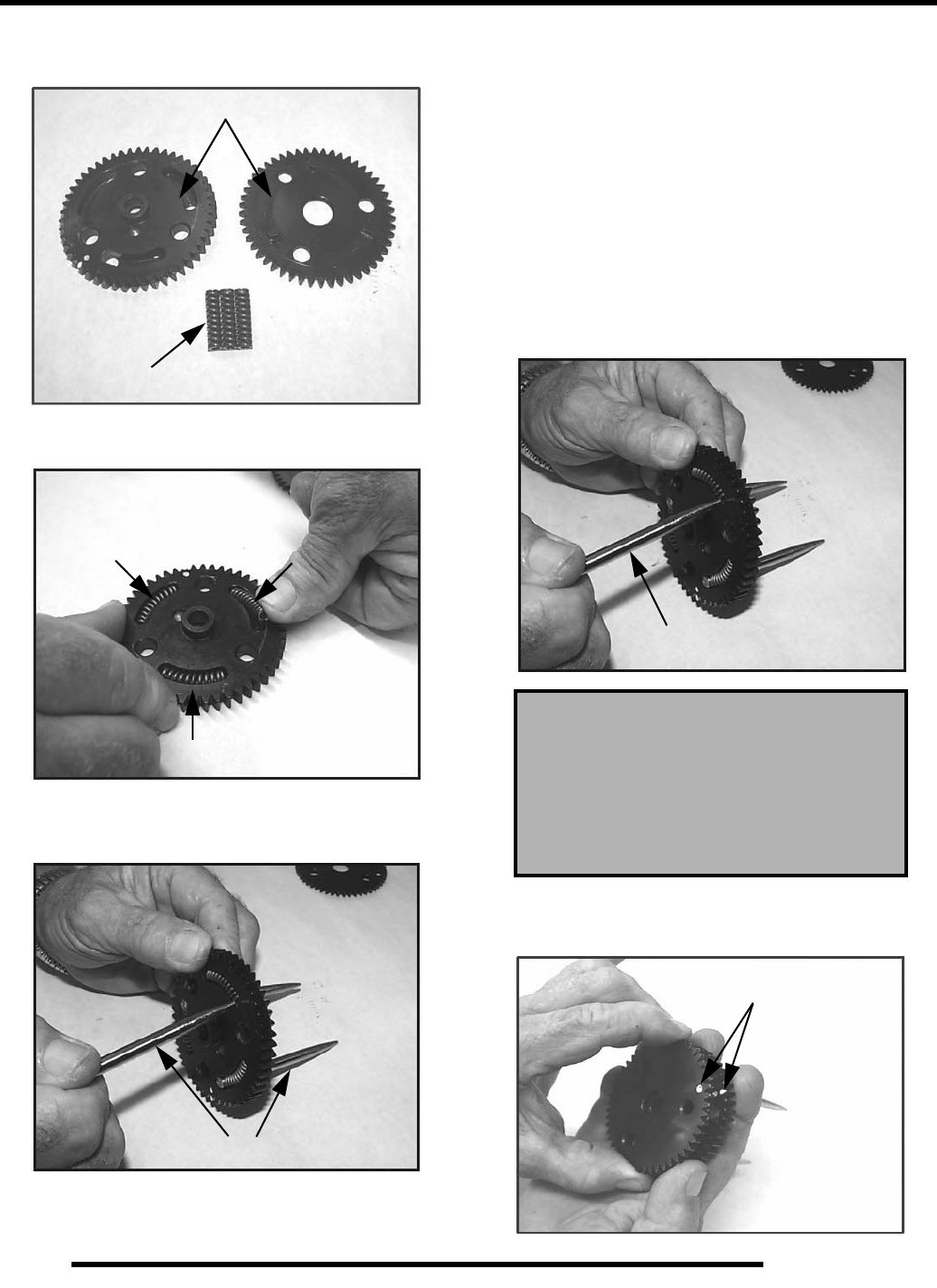
3.42
ENGINE
14. Inspect the gear teeth and the three tabs on the gears for
wear.
15. Install the new springs into the grooves of the cam gear.
16. Insert the pointed dowels from the Tapered Pins (PU-
45497-1) into the cam gear.
To Assemble:
• Hold the spring with one finger.
• Start the pointed end of the tapered pin into the cam
gear hole. Slowly push the dowel through the hole until
the end of the dowel is almost flush with the spring.
• Perform this procedure with all three tapered pins.
• Do not push the pins too far through or the springs will
pop out.
NOTE: Do not remove the tapered pins at this time.
17. Note in photograph that the Tapered Pins (PU-45497-1) are
below flush with end of the springs. This helps to align the
three gear tabs during the next step.
18. Line up the two gears using the timing marks and the three
gear tabs that were referenced earlier. Push the gears back
together, using both hands and hold securely.
Inspect Teeth & Tabs
Replace 3 Springs
Install Springs
PU-45497-1
Cam Gear Spring Installation Tool Kit:
(PU-45497)
Tapered Pins:
(PU-45497-1)
Cam Gear Tooth Align Tool:
(PU-45497-2)
PU-45497-1
Align Timing Marks
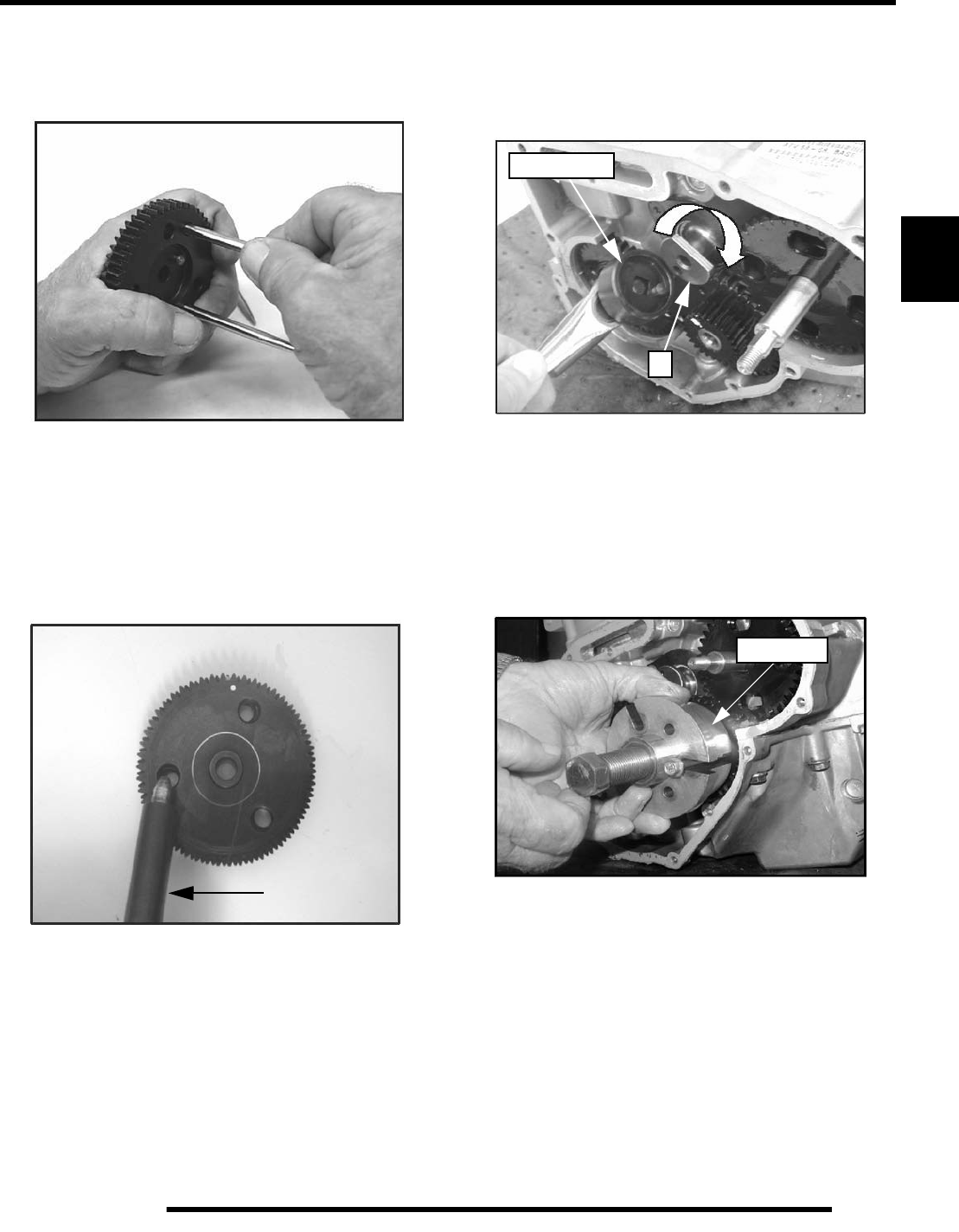
3.43
ENGINE
3
19. Once the gears are pressed together, firmly hold the gears
together with one hand. Carefully remove the Tapered Pins
(PU-45497-1) by pulling them out one at a time with the
other hand.
20. After the tapered pins are removed, be sure the cam gear
assembly is held together tightly. Place the cam gear
assembly on a flat surface. Use the Cam Gear Tooth
Alignment Tool (PU-45497-2) to align the teeth of the cam
gears, as shown in the picture.
NOTE: Install the Cam Gear Alignment Tool (PU-
45497-2) into one assembly hole counter clockwise
from the timing mark.
NOTE: For ease of installing the Cam Gear
Alignment Tool (PU-45497-2), use a twisting motion
when pushing down on the tool.
21. To remove the balance shaft gear, the flat side of the
camshaft (P) must face the balance shaft gear. To rotate the
camshaft, use the Cam Spanner Wrench (PU-45498) to
rotate the camshaft so the flat side of the camshaft faces the
balance shaft gear.
NOTE: This Cam Spanner Wrench (PU-45498) is
only needed to rotate the camshaft when the entire
valve train is assembled. If the rocker arms are
removed, the cam-shaft can be turned by hand.
22. Remove the bolt and nut from the balance shaft gear. Try
to remove the balance shaft gear. If the gear does not come
off manually, use the Flywheel Puller (PN 2871043) to
remove the balance shaft gear.
PU-45497-2
PU-45498
P
2871043

3.44
ENGINE
23. Inspect the crankshaft gear (Q) for broken or worn teeth. If
the crankshaft gear does not need to be replaced, it does not
need to be removed. If the crankshaft gear is damaged,
remove the crankshaft gear with the Flywheel Puller
(PN 2871043).
24. Install the two puller bolts (R). Tighten the puller bolts up
so that the bolts are at equal length.
25. Install the Flywheel Puller (PN 2871043) and remove the
crankshaft gear, if needed.
26. Rotate the water/oil pump gear (S), so that all four bolts are
visible though the gear. Remove the four bolts with a hex
wrench. Pull out the pump.
27. Inspect the oil pump rotors for wear. Mark the rotors with
a white pen to ensure upon reassembly that the correct sides
of the rotors are installed and mesh with the same edges as
previously installed.
NOTE: If replacing the old rotors, new replacement
rotors will fit into the original oil/water pump
housing.
28. Use a feeler gauge to measure the clearance between the
two rotors. Measure the gap between the two rotor tips as
shown below. The clearance should not exceed 0.006"
(0.15 mm).
Q
R
2871043
S
Mark Rotors
Max Tip Clearance
0.006” (0.15 mm)
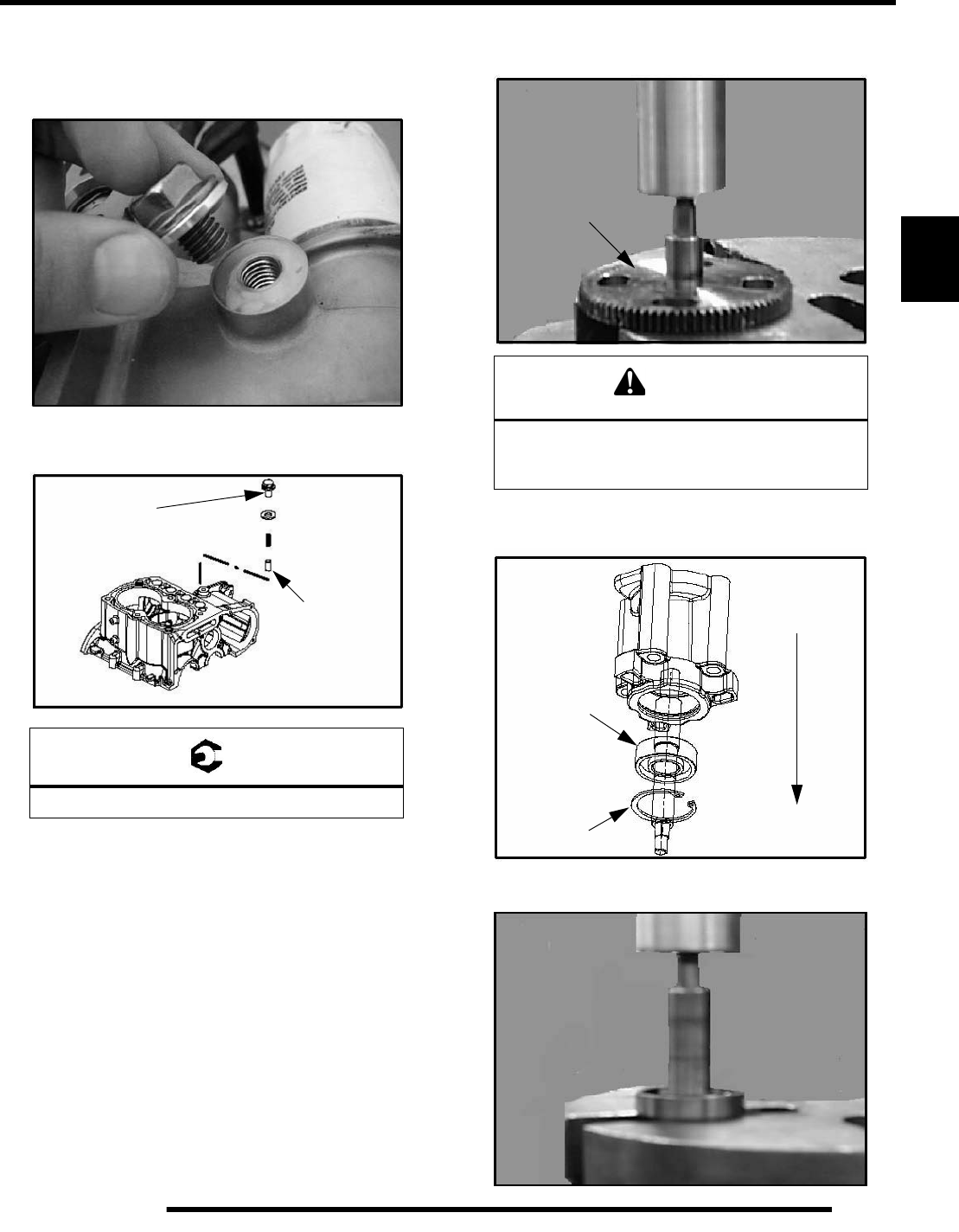
3.45
ENGINE
3
29. Remove the oil pressure relief. The oil pressure relief
consists of a bolt, washer, spring, and valve (dowel).
Inspect the valve (dowel) for signs of possible obstructions.
Use compressed air to blow out any debris.
30. Reinstall the valve (dowel chamfered end first). Install the
spring, washer, and bolt. Torque to specification .
NOTE: Be sure to place the tapered end of the valve
(dowel) in first. If the valve is installed incorrectly, oil
pressure and oil priming problems will occur.
31. Carefully press the gear off the assembly while supporting
the housing assembly.
32. Remove the snap ring from the assembly. Place the housing
in a support and press out the bearing/shaft assembly.
33. Place the shaft in a press to remove the bearing.
= T
22 2 ft. lbs. (30 3 Nm)
22 ± 2 ft. lbs.
(30 ± 3 Nm).
Chamfer
End First
CAUTION
Wear appropriate safety gear during this
procedure. Protective gloves, clothing and eye
wear are required.
Press Off Gear
Press out shaft
and bearing
assembly.
Bearing
Retaining Ring
Press Off Bearing

3.46
ENGINE
34. Press shaft into the new bearing..
35. Press the bearing/shaft assembly using the bearing's outer
race. Do not use the shaft to press the assembly into the
housing, as bearing damage may result. Install retaining
ring.
36. Press gear onto shaft while supporting the housing.
37. Remove thrust plate (U).
38. Remove PTO end engine mount. Remove crankcase bolts.
Tap on the reinforced areas on the cases using soft hammer.
Carefully separate the two crankcase halves.
NOTE: Only remove the oil baffle if the baffle is
damaged. When removing the oil baffle bolts, use a
heat gun to heat the bolts and loosen the Loctite.
This will prevent any possible damage to the bolts or
to the crankcase casting.
Press On Bearing
Press Bearing / Shaft
Assembly using
outer race only
U
Separate
Crankcase Halves
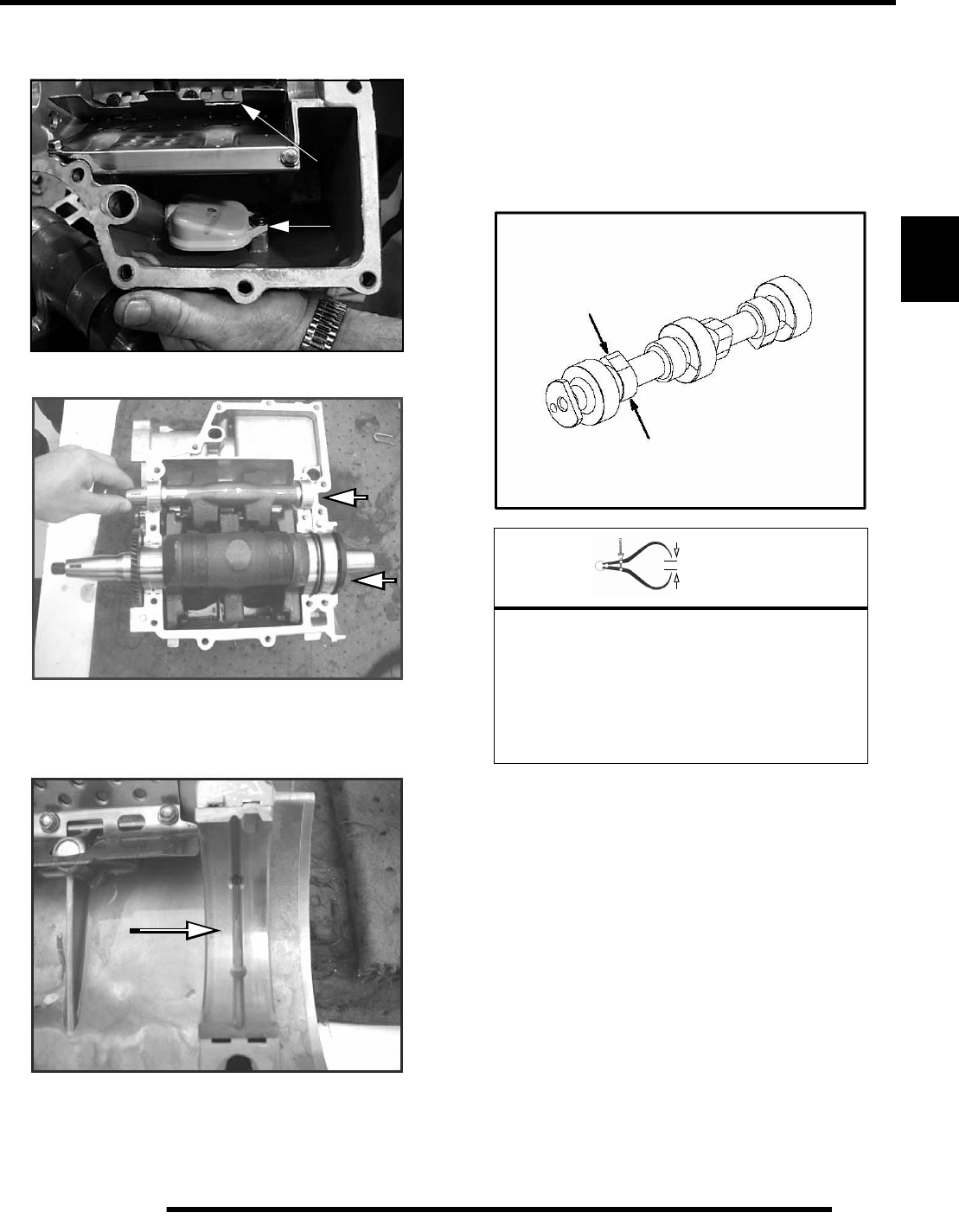
3.47
ENGINE
3
39. Remove and clean oil pick up (V) and oil baffle weldment
(W).
40. Remove balance shaft and crankshaft.
41. Remove and inspect crankshaft main journal bearings for
abnormal wear. It is recommended to replace the
bearings anytime the engine is disassembled.
Camshaft Inspection
1. Thoroughly clean the cam shaft.
2. Visually inspect each cam lobe for wear, chafing or
damage.
3. Measure height of each cam lobe using a micrometer.
Compare to specification.
W
V
= In. / mm.
Cam Lobe Height
Intake (Std):
1.357” (34.477 mm)
Exhaust (Std.):
1.342” (34.096 mm)
Cam Lobe Height
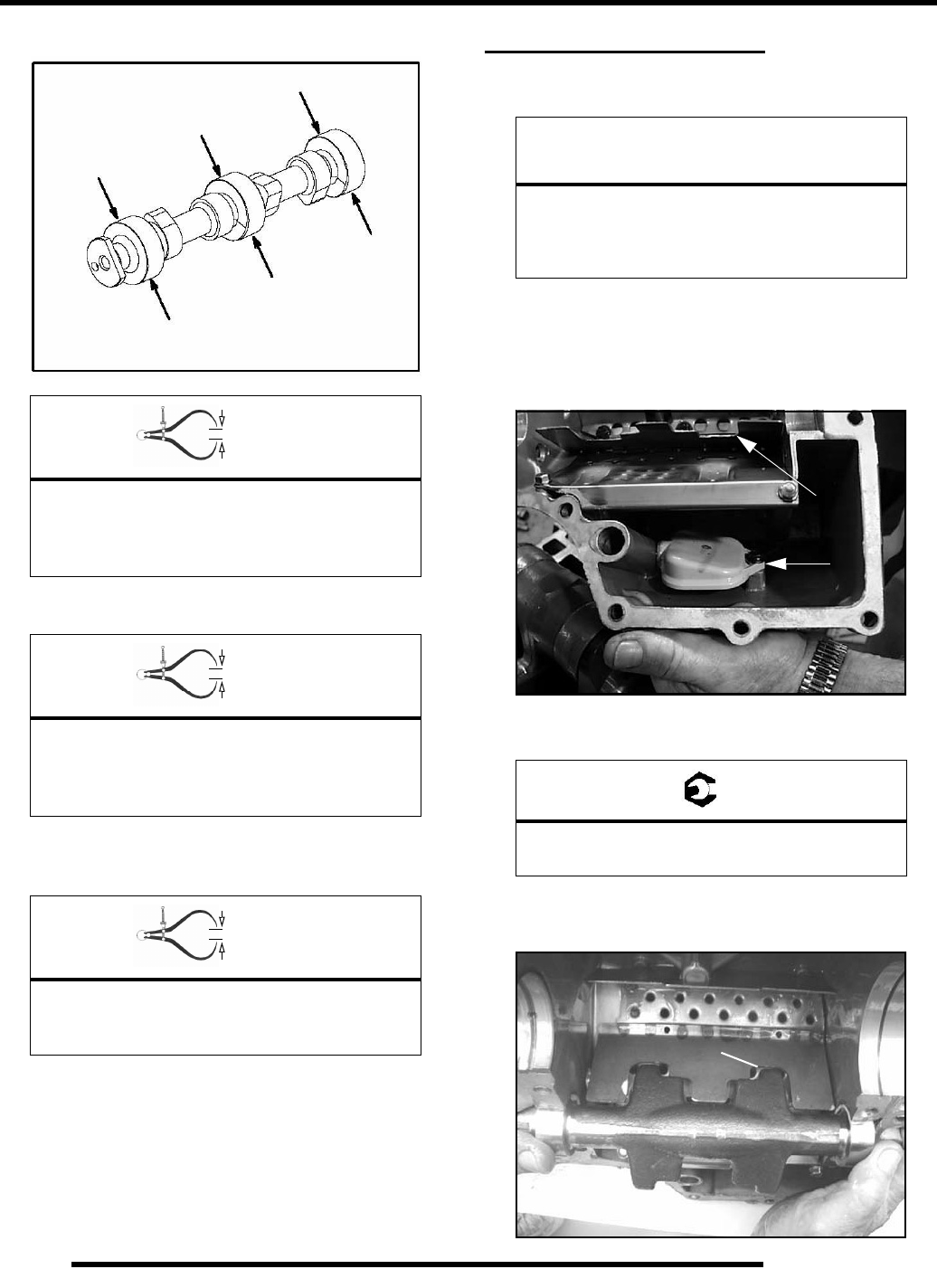
3.48
ENGINE
4. Measure camshaft journal outside diameters (O.D.).
5. Measure ID of camshaft journal bores.
6. Calculate oil clearance by subtracting journal O.D.s from
journal bore I.D.s. Compare to specification.
NOTE: Replace camshaft if damaged or if any part is
worn past the service limit.
NOTE: Replace the engine crankcase assembly if
camshaft journal bores are damaged or worn
excessively.
ENGINE REASSEMBLY
Crankcase Reassembly
NOTE: Before assembly, clean the bolts and bolt
holes with Primer N (PN 2874275) to remove any
debris. This will ensure proper sealing when
installing bolts.
1. Install oil pick up (A), if removed. Torque to specification.
2. Install oil baffle weldment (B). Torque bolts to
specification.
3. Install the balance shaft. Inspect balance shaft clearance (C)
in both gearcase halves. Rotate balance shaft to ensure there
is clearance between it and the oil baffle weldment.
= In. / mm.
Camshaft Journal O.D.
A. (MAG) 1.654" ± .00039" (42 ± .010 mm)
B. (CTR) 1.634" ± .00039" (41.50 ± .010 mm)
C. (PTO) 1.614" ± .00039" (41 ± .010 mm)
= In. / mm.
Camshaft Journal Bore I.D.
MAG: 1.656" ± 0.00039" (42.07± 0.010 mm)
CTR: 1.637" ± 0.00039" (41.58 ± 0.010 mm)
PTO: 1.617" ± 0.00039" (41.07 ± 0.010 mm)
= In. / mm.
Calculated Camshaft Oil Clearance:
Std: 0.0027" (.070 mm)
Limit: .0039" (.10 mm)
A
B
C
CAUTION
After any reassembly or rebuild, the engine
must be primed using the Oil Priming Adapter
(PU-45778) and a 3/4-full oil filter before initial
start-up (see “Oil Pump Priming”).
= T
Oil Baffle Weldment & Oil Pick Up Bolt Torque:
60 ± 6 in. lbs. (6.8 ± 0.68 Nm)
B
A
C
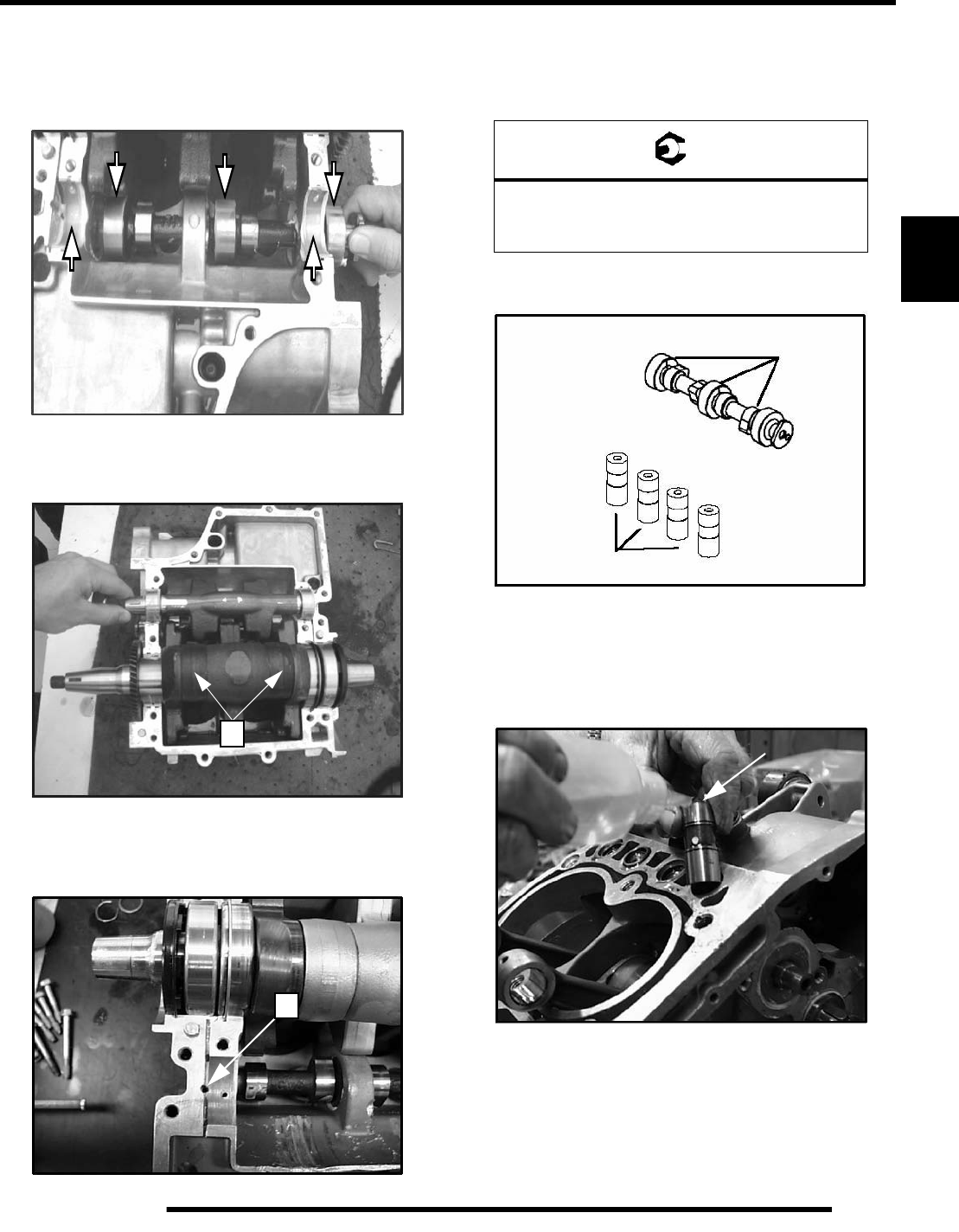
3.49
ENGINE
3
NOTE: Always install new balance shaft bearings.
4. Apply assembly lube to cam journals and balance shaft
bearing surfaces of the MAG case halve. Install camshaft
and balance shaft.
5. Install crankshaft assembly and apply engine oil to crank
pins and rods (D). Apply assembly lube to the main journals
and bearings.
6. Apply Crankcase Sealant (PN 2871557) to the top gearcase
halve.
NOTE: Do not apply sealant to cam relief hole (E).
7. Assemble the crankcase halves. Apply LocTite™ 242 (PN
2871949) to the threads and pipe sealant to the bolt flanges.
Torque bolts to specification following torque pattern at
beginning of this chapter.
8. Lubricate cam lobes and valve lifters with Moly Lube
Grease.
9. Lubricate lifters with engine oil and install in the original
order as removed in disassembly. Apply Lubricant or Moly
Lube to the ends of the lifters.
NOTE: Always replace the camshaft and lifters as a
set.
D
E
= T
Crankcase Bolt Torque:
22 2 ft. lbs. (30 3 Nm)
Torque in sequence
Apply Moly Lube Cam Lobes
Lifters

3.50
ENGINE
10. Lubricate connecting rods with PS-4 PLUS synthetic
engine oil.
11. Install new cylinder gasket on crankcase. Align gasket on
the dowel pins for proper gasket alignment.
12. Orientate the piston rings on the piston before installation
into the cylinders. Set the gaps of the rings every 120° (see
illustration below).
13. Install piston assemblies into cylinder aligning the piston
pin holes, to ensure proper alignment of the pistons to the
connecting rods upon assembly. Partially install the piston
pins into the pistons.
NOTE: To help align the pistons, slide a rod that is
close to the same diameter as the wrist pin holes to
properly align them in the cylinder.
14. Position cylinder and piston assemblies onto the connecting
rods and push the piston pins through the piston and
connecting rods.
15. Install the piston pin circlips. The circlip ends should be
installed at the 12 O'clock position.
Piston Ring
Orientation
1
2
3
1. Top Ring 2. Second Ring
3. Oil Ring
Push in Piston Pins
Piston Pin Cirlcip in
12 O’clock position
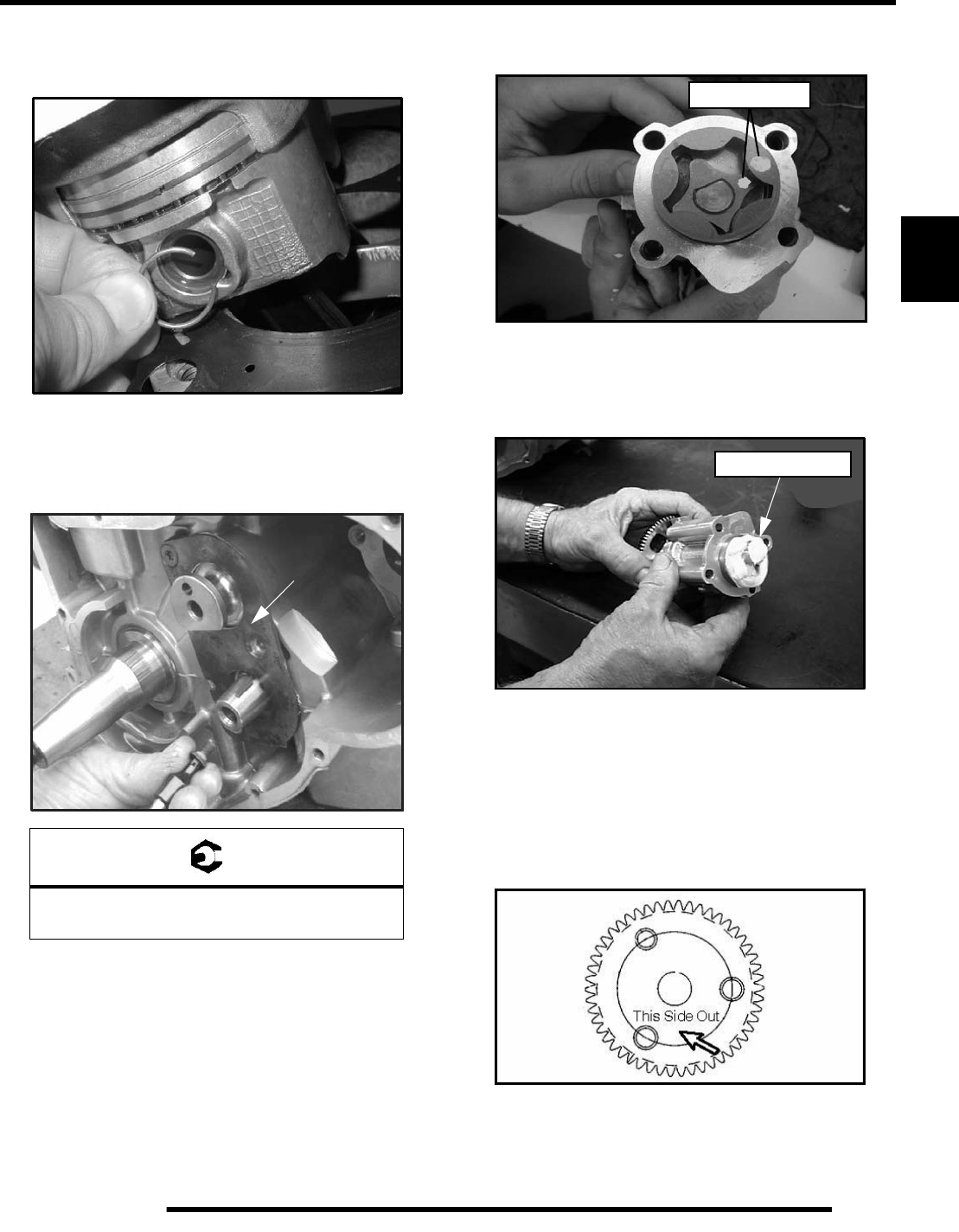
3.51
ENGINE
3
NOTE: While installing in piston circlips, cover all
engine passages. The clip could fall into the engine
during installation.
16. Install camshaft thrust plate (G) with new bolts. Torque
bolts to specification.
NOTE: New bolts have patch lock on the threads
and do not require Loctite™.
17. Assemble rotors as marked when disassembled. Use a
cleaner to remove the marks previously made on the rotors.
18. Apply assembly lube or oil to the rotors on the oil pump
shaft.
NOTE: The application of lubrication aids in priming
the oil pump during initial engine start up.
19. Align the bolt holes and install oil pump assembly into
crankcase. Rotate the rotors in the housing during
installation, as this checks for binding if new rotors are
used.
NOTE: For assembly of the gears, the cam gear and
the crankshaft gear are stamped with “This Side
Out". This indicates the side of the gear that faces
outward or away from the case.
NOTE: Before assembly, clean the bolts and bolt
holes with Primer N (PN 2874275) to remove any
debris. This will ensure proper sealing when
installing bolts and new Loctite™.
= T
Thrust Plate Screw Torque:
115 ± 12 in. lbs. (13 ± 1.35 Nm)
G
Line Up Marks
Lubricate Rotors
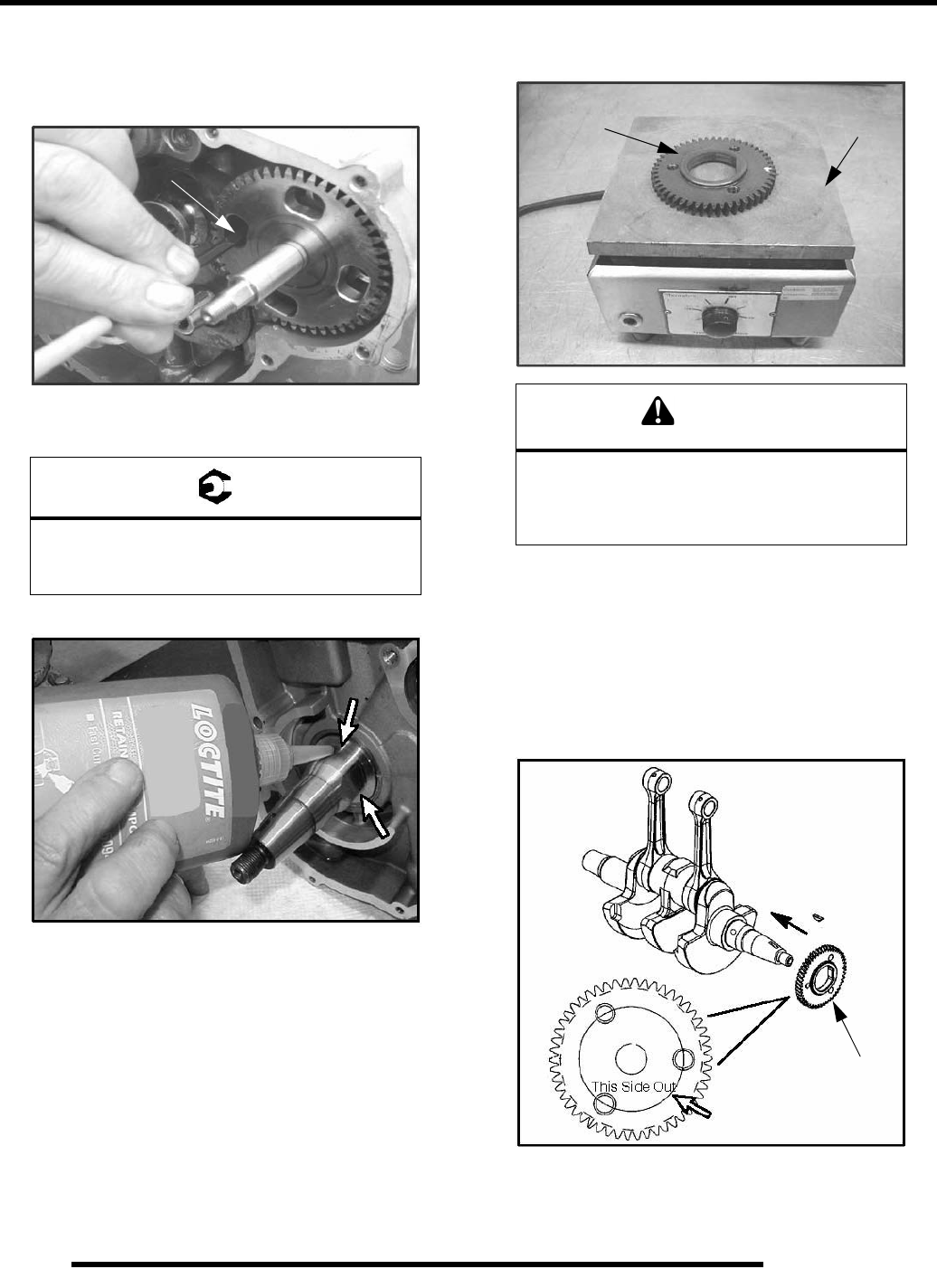
3.52
ENGINE
20. Install oil pump housing bolts (H). The new bolts contain
patch lock, so Loctite is not needed on the new bolts.
Torque bolts to specification and follow the torque
sequence at beginning of the chapter.
NOTE: Occasionally spin the oil pump when
installing bolts to check for binding of the rotors.
21. Apply Loctite 242 (PN 2871949) to the crankshaft.
22. Before installing the crankshaft gear (I), heat the crankshaft
gear to 250 F (121C) on a hot plate (J).
23. Use extreme caution when removing the crankshaft gear
from the hot plate. Use a pair of pliers and leather gloves
when handling the crankshaft gear.
24. Install the crankshaft gear (I) onto the crankshaft.
NOTE: For assembly of the gears, the cam gear and
the crankshaft gear are stamped with “This Side
Out". This indicates the side of the gear that faces
outward or away from the case.
= T
Oil Pump Bolt Torque:
84 8 in. lbs. (9.50 0.90 Nm)
* Torque in Sequence
H
CAUTION
The crankshaft gear is extremely hot! Severe
burns or injury can occur if the gear is not
handled with extreme care and caution. Follow
the procedure below to help ensure safety.
IJ
I
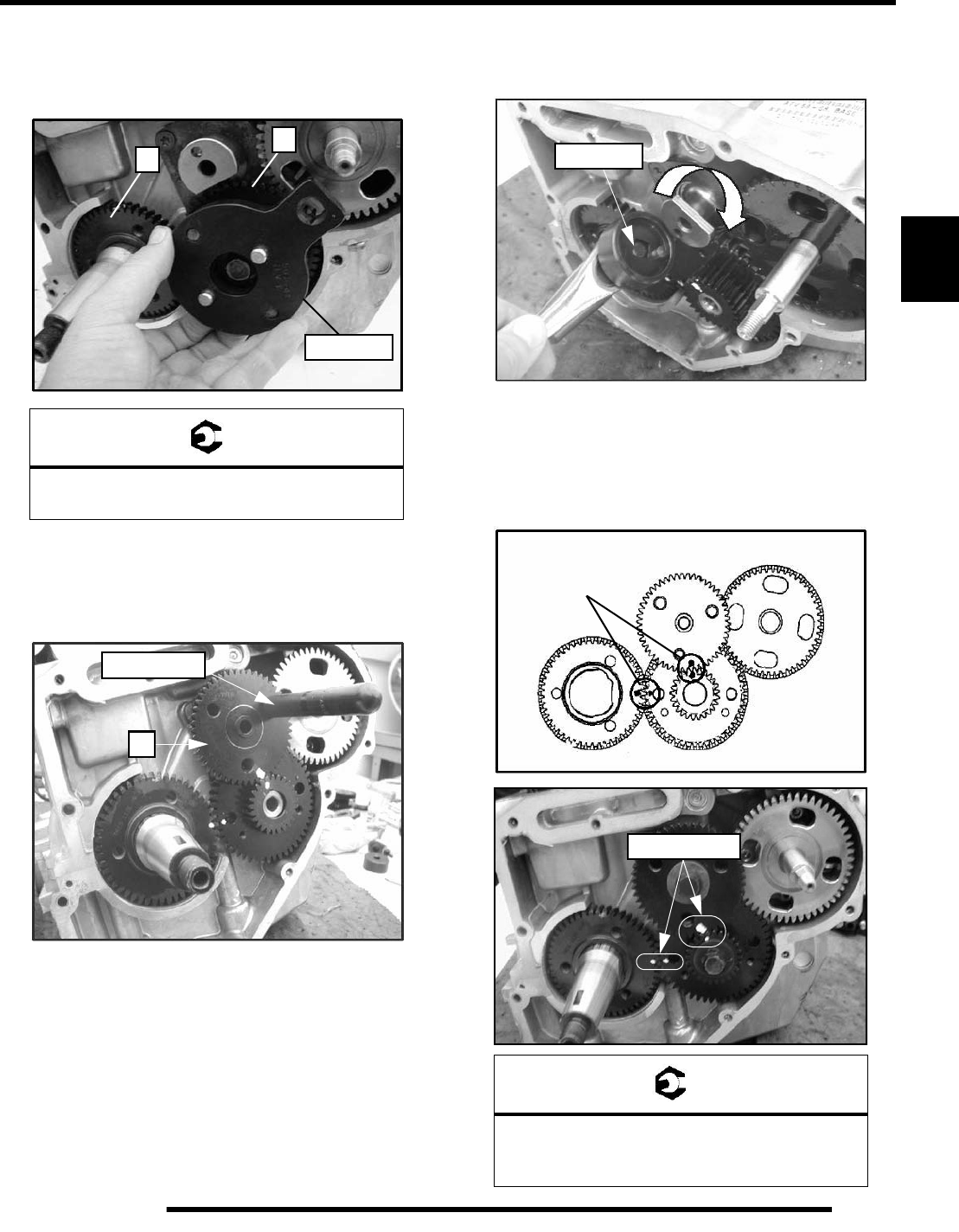
3.53
ENGINE
3
25. Install counter balance shaft gear (J) with new key, aligning
timing marks with crankshaft gear (I). Install washer and
bolt. Use the Gear Holder (PU-45838). Torque to
specification.
26. Use the Cam Gear Alignment Tool (PU-45497-2) to align
the teeth of the cam gear (M). Install the cam gear (M) (with
the Cam Gear Alignment Tool still in place) onto the
camshaft. The timing marks on the camshaft gear should
align with the keyway on the balance shaft gear.
NOTE: If the timing mark on the camshaft gear does
not align properly, remove the camshaft gear and
tool. Use the Cam Spanner Wrench (PU-45498) to
rotate the cam to the proper position.
NOTE: Cam Spanner Wrench (PU-45498) is only
needed to rotate the camshaft when the entire valve
train is assembled.
27. Reinstall the camshaft gear; so the timing marks are
properly aligned. Install the washer and bolt. Torque to
specification.
NOTE: Be sure all of the timing marks are properly
aligned.
= T
Balance Shaft Gear Bolt Torque:
22 2 ft. lbs. (30 3 Nm)
PU-45838
J
I
PU-45497-2
M
= T
Counterbalance Gear and Camshaft
Gear Bolt Torque:
22 2 ft. lbs. (30 3 Nm)
PU-45498
Timing Marks
Timing Marks
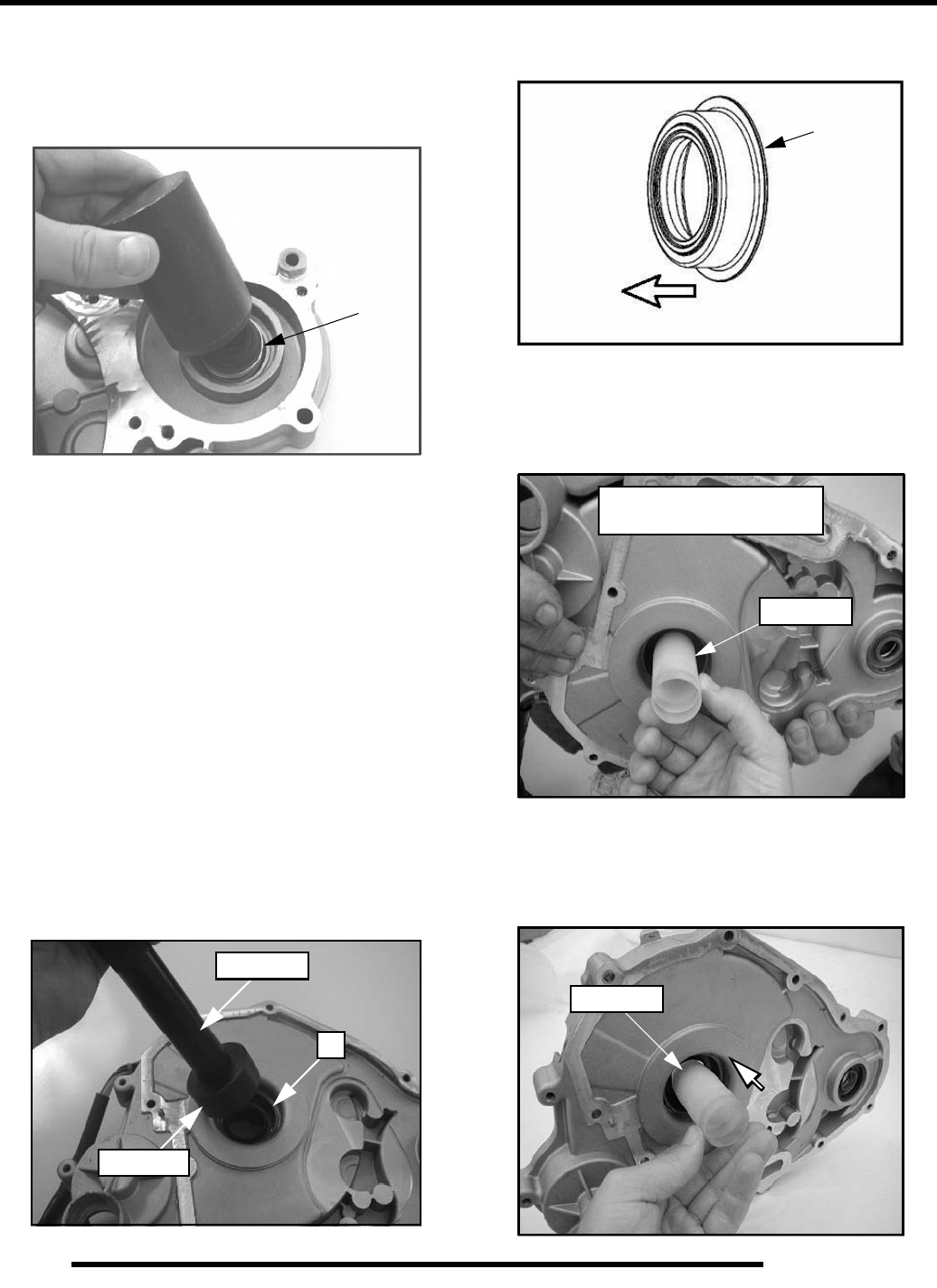
3.54
ENGINE
28. Before installing the gear / stator housing, replace the seals
in the cover. Install a new water pump seal (N) into the gear
/ stator housing. Use the Water Pump Mechanical Seal
Installer (PA-44995) to properly install the seal to the
correct depth in the cover.
IMPORTANT: Due to seal design and construction,
seals MUST be installed DRY (no lubricant) during
assembly. Use of lubricants (oil, soapy water, etc.) will
not allow the seal to wear-in and seal properly. Do not
touch seal surface or allow seal surface to come in
contact with contaminates during installation.
Thoroughly clean parts, tools and hands before
installation.
NOTE: To remove the water pump seal, the gear/
stator housing must be removed. The water pump
seal cannot be removed or installed with the gear/
stator housing attached to the engine. Shaft damage
will occur.
NOTE: Install the water pump seal (N) with the seal
lip facing out (towards the crankcase). Use of a
hydraulic press is recommended for this procedure.
29. Install a new crankshaft seal (P) into the gear/stator housing
cover. Use the Universal Driver Handle (PU-45543) and
the Main Seal Installer (PA-45483) to seat the crankshaft
seal into place.
NOTE: Install the crankshaft seal (P) with the seal lip
facing out (towards the crankcase).
30. Once the crankshaft seal is installed into the gear / stator
housing cover, set the direction of the paper lip by sliding
the Main Crankshaft Seal Saver (PA-45658) into the
crankshaft seal from the rubber lipped side to the paper lip
side (Back to Front). Remove the tool.
31. Carefully install the tapered end of the Crankshaft Seal
Protection Tool (PA-45658) through the paper side of the
crankshaft seal (Back to Front). Leave the seal protector
installed in the crankshaft seal. Check the crankshaft seal
lips to verify they have not been rolled or damaged.
PA-44995
N
PA-44995
PA-45483
PU-45543
P
P
Seal lip goes towards the crankcase.
PU-45658
Important: Set the direction
of the paper lip seal
PU-45658

3.55
ENGINE
3
32. Before installing the gear/stator housing cover, install the
Water Pump Seal Saver (PA-45401) onto the water pump
shaft.
33. Install a NEW gasket to the gear/stator housing cover and
crankcase. With the tools installed, carefully place the gear/
stator housing cover over the protection tools.
34. Apply Crankcase Sealant (PN 2871557) to the outside
edges of the crankcase halves (see arrows), where the
crankcases mate (see the following photos). This helps to
prevent coolant leakage.
35. Install the gear/stator housing gasket onto the crankcase.
36. Secure the gear / stator housing cover to the crankcase with
the cover bolts. Torque bolts in proper sequence to
specification. Remove seal protectors from the shaft ends
once the cover is secure.
PA-45401
= T
Gear/Stator Housing Bolt Torque:
96 3 in. lbs. (10.85 0.35 Nm)
*Torque in proper sequence
Gear / Stator
Housing Gasket
PA-45658
PA-45401
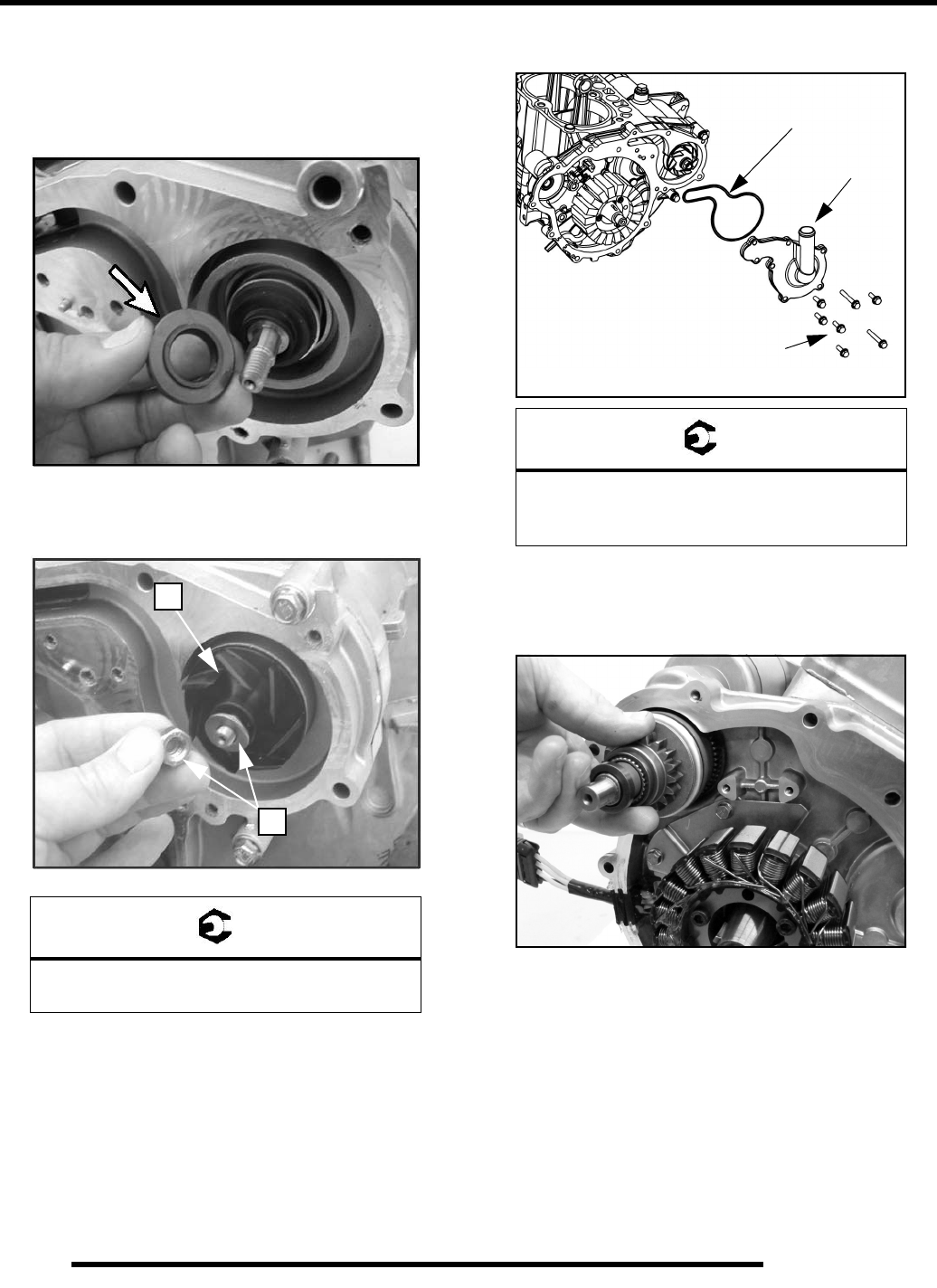
3.56
ENGINE
NOTE: Before assembly, clean the bolts and bolt
holes with Primer N (PN 2874275) to remove any
debris. This will ensure proper sealing when
installing bolts.
37. Install shaft seal with ceramic surface facing inward.
38. Install water pump impeller (P). Secure the impeller with
the washer and a new nut (Q). Torque the nut to
specification.
39. Install water pump cover (R) with new O-ring seal. Torque
bolts to specification in proper sequence (see Page 3.4).
40. Sparingly apply Starter Drive Grease (PN 2871423) to the
starter drive. Install the starter bendix.
NOTE: There are thrust washers on both sides of
starter drive.
= T
Water Pump Impeller Nut Torque:
108 6 in. lbs. (6.8 0.68 Nm)
P
Q
= T
Water Pump Housing Bolt Torque:
96 3 in. lbs. (10.85 0.35 Nm)
*Torque in proper sequence
Install the O-ring dry
R
96 ± 3 in. lbs.
(10.85 ± 1.35 Nm)
No lubricants
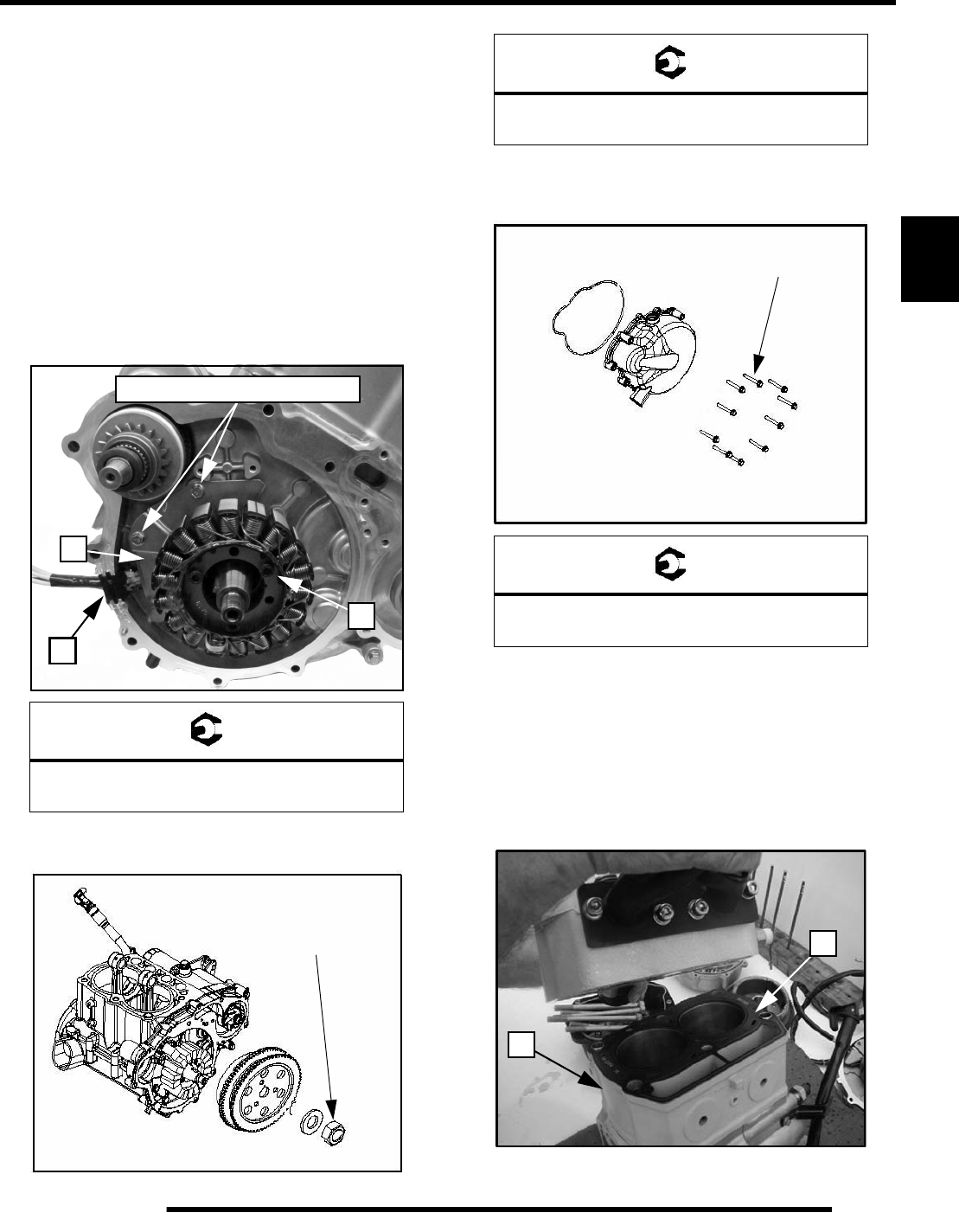
3.57
ENGINE
3
Flywheel / Stator Installation
NOTE: Before assembly, clean the bolts and bolt
holes with Primer N (PN 2874275) to remove any
debris. This will ensure proper sealing when
installing bolts.
1. Install stator assembly (S) and bolts. Torque bolts to
specification.
2. Install the wire hold down bracket (T). Install two new wire
hold down bolts. New bolts contain patch-lock. Torque
bolts to specification, following the proper bolt torque
sequence. Coat the stator wire grommet (U) with Nyogel
Grease (PN 2871329).
NOTE: Verify stator wires are routed properly under
the wire hold down bracket.
3. Install the flywheel, washer, nut, and key. Torque flywheel
nut to specification.
4. Install stator housing with new O-ring. Torque the bolts to
specification and follow proper bolt torque sequence at the
beginning of this chapter.
Cylinder Head Reassembly
NOTE: Before reassembly, clean the bolts and bolt
holes with Primer N (PN 2874275) to remove any
debris. This will ensure proper sealing when
installing bolts.
1. Install the head gasket (A) on the cylinder (B).
= T
Stator Assembly Bolt Torque:
96 3 in. lbs. (10.85 0.35 Nm)
U
T
S
Replace 2 bolts with new bolts
65 ± 7 ft. lbs.
(88 ± 9.50 Nm)
= T
Flywheel Nut Torque
65 ± 7 ft. lbs. (88 ± 9.50 Nm)
= T
Stator Housing Bolt Torque:
96 3 in. lbs. (10.85 0.35 Nm)
96 ± 3 in. lbs.
(10.85 ± 0.35 Nm)
B
A
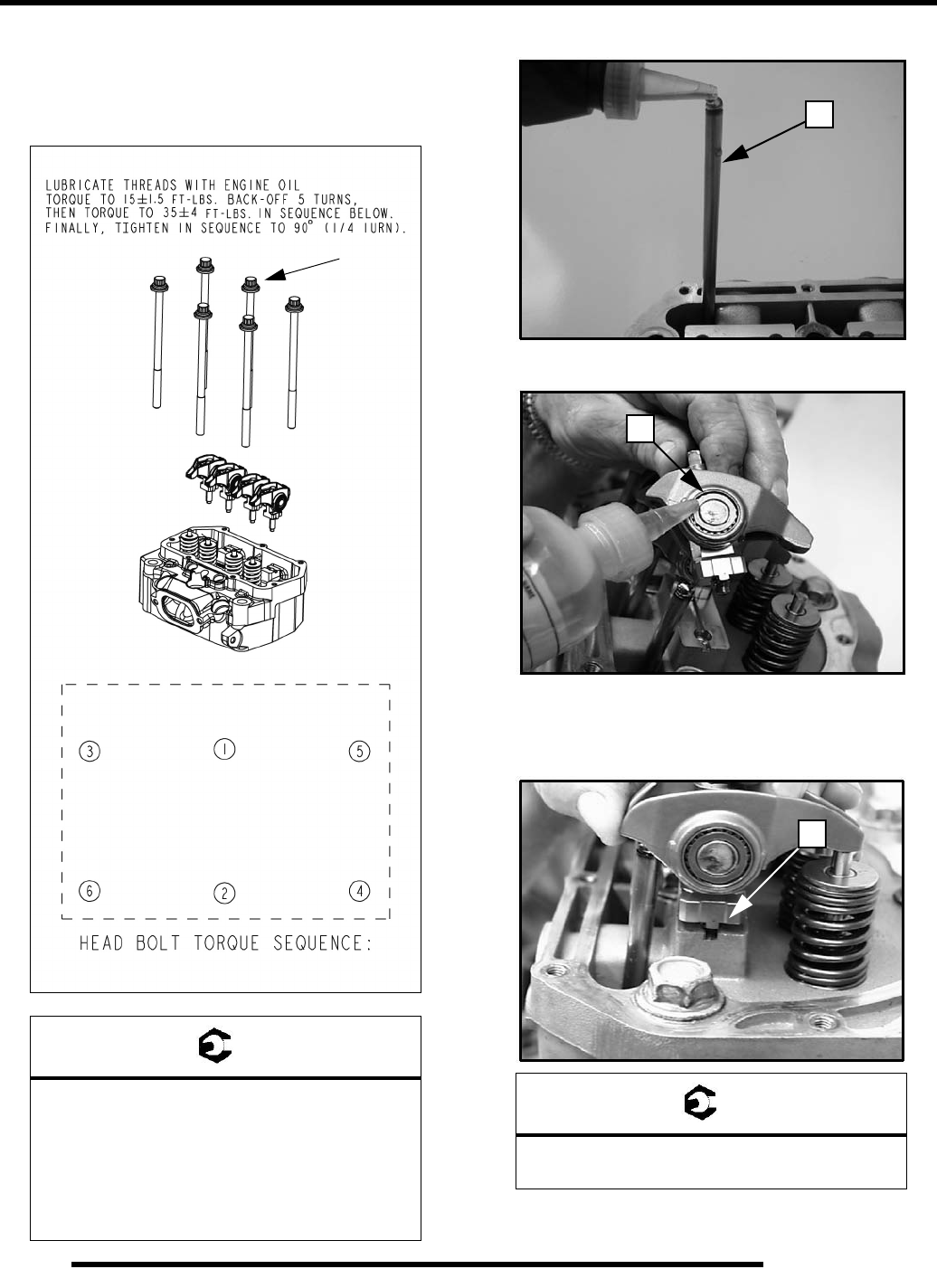
3.58
ENGINE
2. Install cylinder head on cylinder.
3. Lubricate threads and top of washers underside of bolt head
with engine oil. Install head bolts (C) and torque to
specification in sequence.
4. Lubricate push rods (D) and install into lifters.
5. Lubricate rockers (E) with engine oil.
6. Verify pushrods are engaged in lifters.
7. Install rockers. Be sure that tab of fulcrum (F) is seated in
head stand-off. Torque bolts to specification.
= T
Cylinder Head Bolt Torque:
1) Torque to 15 1.5 ft. lbs. in sequence
2) Back off all head bolts 5 turns in sequence
3) Torque to 35 4 ft. lbs. in sequence
4) Tighten all head bolts in sequence another
90 or (1/4 turn).
C
= T
Rocker Arm Bolt Torque:
22 2 ft. lbs. (30 3 Nm)
D
E
F
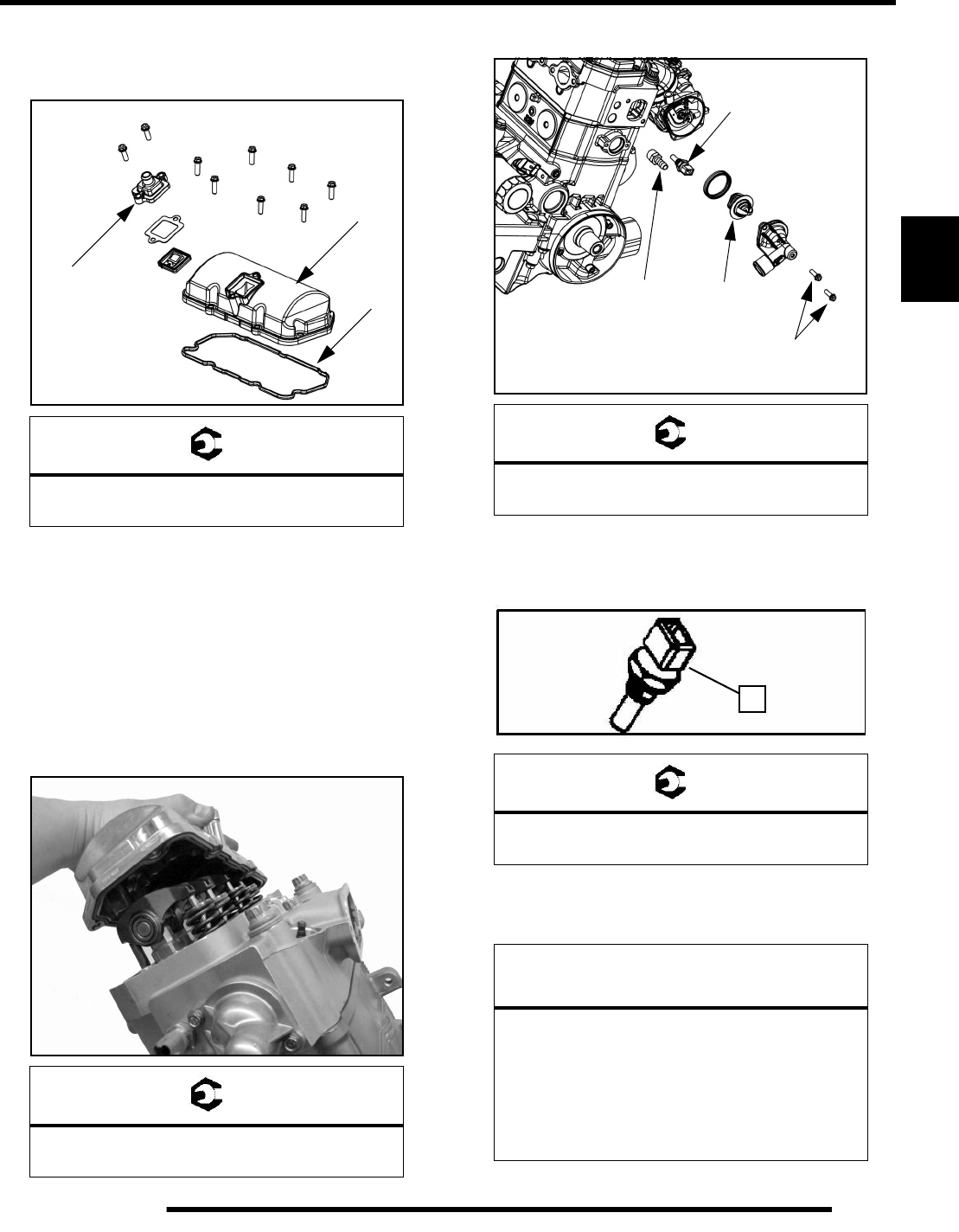
3.59
ENGINE
3
8. Install breather reed (G) into rocker cover (H). Lightly
apply black RTV sealant to the outer edges of the breather
reed. The reed has a tab and will assemble one-way only.
Torque the breather bolts to specification.
NOTE: When applying RTV, do not get any RTV
inside the reed assembly.
9. Place a new seal (I) into the bottom of the cover. Be sure
the seal is seated into the cover properly.
IMPORTANT: Before assembly, clean the bolts and
bolt holes with Primer N (PN 2874275) to remove any
debris. This will ensure proper sealing when installing
bolts.
10. Install rocker cover. Torque bolts in sequence to
specification.
11. Install thermostat (J), new O-ring, and thermostat housing.
Torque to specification.
12. Install 3/8” coolant hose fitting (L) and torque to
specification.
13. Install temperature sender (K) and torque to specification.
Oil Pump Priming
= T
Breather Bolt Toque:
20 ± 5 in. lbs. (2.5± 0.55 Nm)
= T
Rocker Cover Bolt Torque:
84 8 in. lbs. (9.5 0.9 Nm)
G
H
I
20 ± 5 in. lbs.
(2.5 ± .55 Nm)
= T
Thermostat Housing Bolt Torque:
84 8 in. lbs. (9.5 0.9 Nm)
= T
Temperature Sender Torque:
17 ± 2 ft. lbs. (23 ± 3 Nm)
CAUTION
After any reassembly or rebuild, the engine
must be primed using the Oil Priming Adapter
(PU-45778) and a 3/4-full oil filter before initial
start-up. Follow the steps in this section to
properly prime the engine and aid proper engine
break in. Failure to perform this procedure may
cause internal engine damage on initial start-up.
L
17 ± 2 ft. lbs.
(23 ± 3 Nm)
84 ± 8 in. lbs.
(9.5 ± 0.9 Nm)
K
120 in. lbs.
J
(13.5 Nm)
K
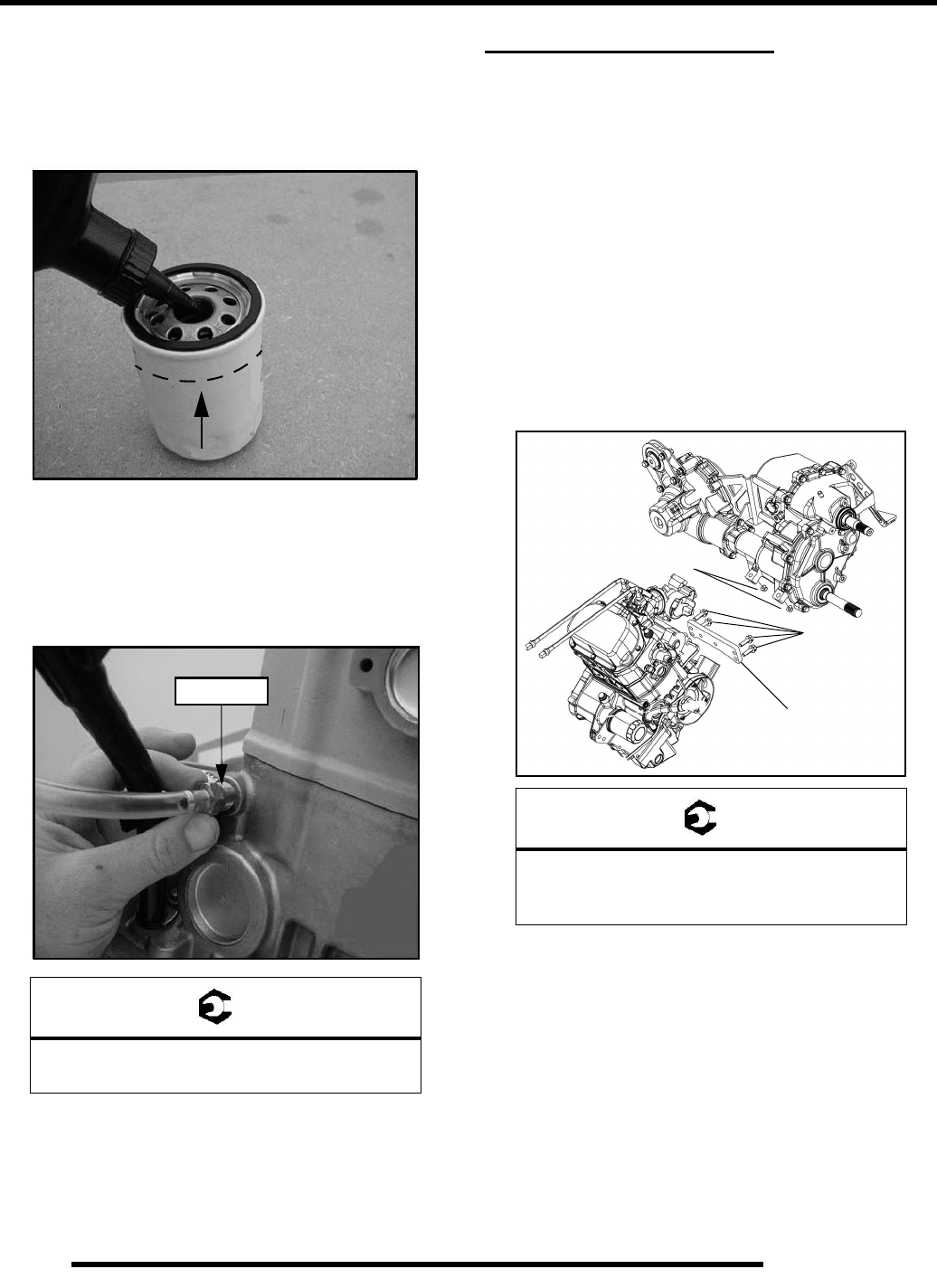
3.60
ENGINE
1. After the engine is completely assembled and ready for
installation, the engine must be properly primed with
Polaris PS-4 PLUS Synthetic Engine Oil (PN 2876244).
Fill the oil filter three-quarters full with Polaris PS-4 PLUS
Synthetic Engine Oil (PN 2876244). Let the oil soak into
the filter for 8-10 minutes. Install the filter onto the engine.
2. Remove primer plug from the engine. Install Oil System
Priming Adapter (PU-45778) into the oil plug hole. Push
3-5 oz. (approx.) of Polaris PS-4 PLUS engine oil into the
adapter or until resistance is felt. Remove the adapter.
Apply sealant to the plug threads. Install the plug and torque
to specification.
ENGINE INSTALLATION
Engine Assembly and Installation
Use the following procedure to reinstall the engine assembly.
Assemble the engine to the transmission on a work bench prior
to installation.
1. Support the transmission / rear gearcase assembly while
setting the engine in place.
2. Lightly tighten all fasteners evenly to eliminate any gaps
that may be present in the mounting areas.
3. Torque fasteners to specification using a two part sequence.
• Torque fasteners to half of the specified torque value.
• Then torque fasteners to the full specified torque value.
4. Install the inner clutch cover, drive clutch, and driven
clutch. Torque to specification (see Chapter 6).
• Clean clutch sheaves thoroughly and inspect inlet and
outlet ducts for proper routing and sealing.
5. To install engine assembly, reverse the “Engine Removal”
procedure detailed earlier in this Chapter.
• Properly route all electrical harnesses for engine
assembly installation. Check for any possible rubbing
points of electrical wires.
• Carefully set the engine assembly into the vehicle while
installing the propshaft.
= T
Primer Plug Torque
18 ± 2 ft. lbs. (24.4 ± 2.71 Nm)
Fill 3/4 full
with PS-4 PLUS
PU-45778
= T
Engine / Transmission Mounting Fasteners
(2) Lower 3/8” Nuts: 40 ft. lbs. (54 Nm)
(4) Outer M8 Bolts: 28 ft. lbs. (38 Nm)
40 ft. lbs.
(54 Nm)
28 ft. lbs.
(38 Nm)
Plate is shown detached
from transmission for clarity

3.61
ENGINE
3
• Install engine / transmission / rear gearcase mounting
hardware and torque to specification.
NOTE: If isolator mounts were removed or replaced,
use the following illustration to ensure proper
orientation during installation.
• Install rear seat base assembly and torque the mounting
bolts to 40 ft. lbs. (54 Nm).
• Replace exhaust gaskets. Seal connections with high
temp silicone sealant. Check to be sure all exhaust
springs are in good condition.
• Inspect transmission operation and adjust linkage if
necessary (see Chapter 2 “Shift Linkage Adjustment”).
• Checks fluid levels: engine oil, transmission lubricant,
and rear gearcase lubricant.
• Bleed cooling system as described in this Chapter under
“Cooling System Bleeding Procedure.”
Engine Break-In Period
The break-in period consists of the first 25 hours of operation,
or the time it takes to use 14 gallons (53 liters) of fuel. Careful
treatment of a new engine and drive components will result in
more efficient performance and longer life for these
components.
1. Fill fuel tank with unleaded fuel which has a minimum
pump octane number of 87 = (R+ M)/2.
2. Check oil level indicated on dipstick. Add oil if necessary
(Refer to Chapter 2, “Engine Oil Level” ).
3. Drive slowly at first to gradually bring engine up to
operating temperature.
4. Vary throttle positions. Do not operate at sustained idle or
sustained high speed.
5. Perform regular checks on fluid levels, controls and all
important bolt torques.
6. Pull only light loads during initial break-in.
7. Change oil and oil filter after break-in period at 25 hours.
17 ft. lbs.
(23 Nm)
17 ft. lbs.
(23 Nm)
30 ft. lbs.
(41 Nm)
The protrusion of the mount
must face inward towards
the engine.
The protrusion of the mount
must face the RH side of
the vehicle.
Front Isolator Mounts
Rear Isolator Mounts
Mount Protrusion
CAUTION
Use only Polaris PS-4 PLUS
Synthetic Engine Oil.
Never substitute or mix oil brands.
Serious engine damage and voiding of
w a r r a n t y c a n r e s u l t .
Do not operate at full throttle or high speeds for
extended periods during the first three hours of
use. Excessive heat can build up and cause
damage to close fitted engine parts.
=
Capacity: Approximately 2 U.S. Quarts (1.9 L)
Oil Type: Polaris PS-4 PLUS Synthetic
Filter Wrench: PU-50105 - 2.5” (64 mm)
- Oil Pressure Specification -
27-35 psi @ 6000 RPM, Polaris PS-4 PLUS
Synthetic, Engine at operating temperature.

3.62
ENGINE
TROUBLESHOOTING
Engine
Spark Plug Fouling
• Spark plug cap loose or faulty
• Incorrect spark plug heat range or gap
• PVT system calibrated incorrectly/ components worn or
mis-adjusted
• Fuel quality poor (old) or octane too high
• Low compression
• Restricted exhaust
• Weak ignition (loose coil ground, faulty coil, or stator)
• Restricted air filter (main or pre-cleaner) or breather
system
• Improperly assembled air intake system
• Restricted engine breather system
• Oil contaminated with fuel
Engine Turns Over But Fails To Start
•No fuel
• Dirt in fuel line or filter
• Fuel will not pass through fuel valve
• Fuel pump inoperative/restricted
• Tank vent plugged or pinched
• Engine flooded
• Low compression (high cylinder leakage)
• No spark (Spark plug fouled) ignition component
failure
Engine Does Not Turn Over
• Dead battery
• Starter motor does not turn
• Engine seized, rusted, or mechanical failure
Engine Runs But Will Not Idle
• Restricted fuel supply
• Low compression
• Crankcase breather restricted
Engine Idles But Will Not Accelerate
• Spark plug fouled/weak spark
• Broken throttle cable
• Obstruction in air intake
• Air box removed (reinstall all intake components)
• Incorrect ignition timing
• Restricted exhaust system
• Cam worn excessively
Engine Has Low Power
• Spark plug fouled
• Cylinder, piston, ring, or valve wear or damage (check
compression)
• PVT not operating properly
• Restricted exhaust muffler
• Cam worn excessively
Piston Failure - Scoring
• Lack of lubrication
• Dirt entering engine through cracks in air filter or ducts
• Engine oil dirty or contaminated
Excessive Smoke and Carbon Buildup
• Excessive piston-to-cylinder clearance
• Wet sumping
• Worn rings, piston, or cylinder
• Worn valve guides or seals
• Restricted breather
• Air filter dirty or contaminated
Piston Failure - Scoring
• Lack of lubrication
• Dirt entering engine through cracks in air filter or ducts
• Engine oil dirty or contaminated

3.63
ENGINE
3
Excessive Smoke and Carbon Buildup
• Excessive piston-to-cylinder clearance
• Wet sumping due to over-full crankcase
• Worn rings, piston, or cylinder
• Worn valve guides or seals
• Restricted breather
• Air filter dirty or contaminated
Low Compression
• Cylinder head gasket leak
• No valve clearance ( cam wear )
• Cylinder or piston worn
• Piston rings worn, leaking, broken, or sticking
• Bent valve or stuck valve
• Valve spring broken or weak
• Valve not seating properly (bent or carbon accumulated
on sealing surface)
• Rocker arm sticking
Backfiring
• Fouled spark plug or incorrect plug or plug gap
• Exhaust system air leaks
• Exhaust system air leaks
• Valve sticking
• Ignition system faulty:
Spark plug cap cracked / broken
Ignition coil faulty
Ignition or kill switch circuit faulty
Poor connections in ignition system
Ignition timing incorrect
Sheared flywheel key
Cooling System
Overheating
• Low coolant level
• Air in cooling system
• Wrong type/mix of coolant
• Faulty pressure cap or system leaks
• Restricted system (mud or debris in radiator fins
causing restriction to air flow, passages blocked in
radiator, lines, pump, or water jacket, accident damage)
• Lean mixture (vents, fuel pump or fuel valve)
• Fuel pump output weak
• Electrical malfunction
• Water pump failure/ Loose impeller
• Thermistor failure
• Cooling fan inoperative or turning too slowly (perform
current draw test)
• Low oil level
• Spark plug incorrect heat range
• Faulty hot light circuit
• Thermostat stuck closed or not opening completely
• Radiator is missing its internal diverter plate not
allowing coolant to flow through entire radiator
Temperature Too Low
• Thermostat stuck open
Leak at Water Pump Weep Hole
• Faulty water pump mechanical seal (coolant leak)
• Faulty pump shaft oil seal (oil leak)
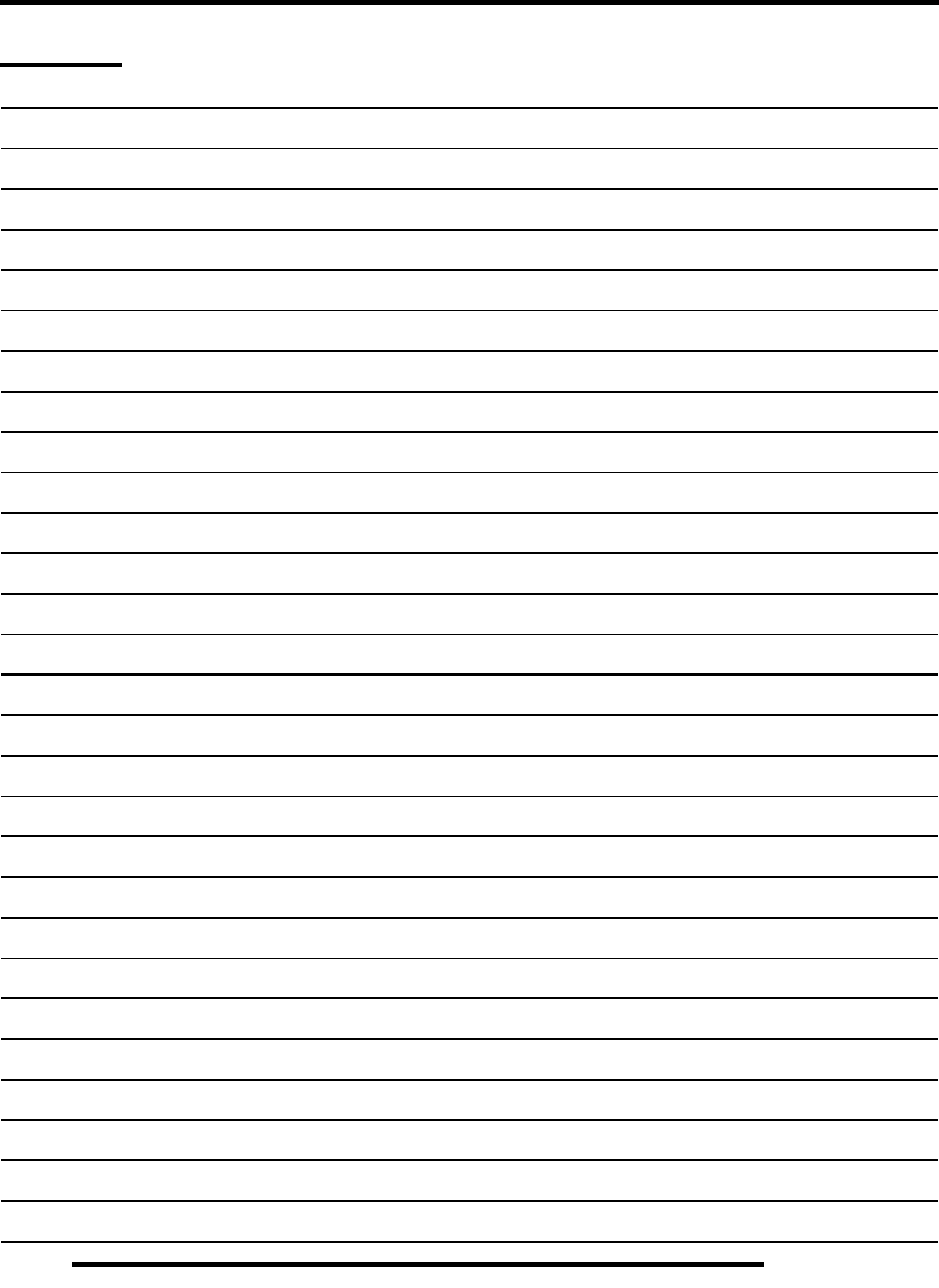
NOTES
ENGINE
3.64

ELECTRONIC FUEL INJECTION
4.1
CHAPTER 4
ELECTRONIC FUEL INJECTION
4
GENERAL INFORMATION . . . . . . . . . . . . . . . . . . . . . . . . . . . . . . . . . . . . . . . . . . . . . . . . 4.2
SPECIAL TOOLS . . . . . . . . . . . . . . . . . . . . . . . . . . . . . . . . . . . . . . . . . . . . . . . . . . . . . . . 4.2
SERVICE NOTES. . . . . . . . . . . . . . . . . . . . . . . . . . . . . . . . . . . . . . . . . . . . . . . . . . . . . . . 4.4
EFI SYSTEM EXPLODED VIEW . . . . . . . . . . . . . . . . . . . . . . . . . . . . . . . . . . . . . . . . . . . 4.5
EFI SYSTEM COMPONENT LOCATIONS . . . . . . . . . . . . . . . . . . . . . . . . . . . . . . . . . . . 4.6
FUEL TANK . . . . . . . . . . . . . . . . . . . . . . . . . . . . . . . . . . . . . . . . . . . . . . . . . . . . . . . . . . . . 4.9
FUEL LINES - QUICK CONNECT . . . . . . . . . . . . . . . . . . . . . . . . . . . . . . . . . . . . . . . . . 4.10
ELECTRONIC FUEL INJECTION . . . . . . . . . . . . . . . . . . . . . . . . . . . . . . . . . . . . . . . . . . 4.10
PRINCIPAL COMPONENTS / EFI OPERATION OVERVIEW . . . . . . . . . . . . . . . . . . . . 4.10
INITIAL PRIMING / STARTING PROCEDURE . . . . . . . . . . . . . . . . . . . . . . . . . . . . . . . 4.11
ELECTRONIC CONTROL UNIT (ECU). . . . . . . . . . . . . . . . . . . . . . . . . . . . . . . . . . . . . . 4.11
ECU SERVICE / REPLACEMENT . . . . . . . . . . . . . . . . . . . . . . . . . . . . . . . . . . . . . . . . . 4.12
TEMP / MANIFOLD ABSOLUTE PRESSURE SENSOR (T-MAP) . . . . . . . . . . . . . . . . . 4.12
T-MAP SENSOR TEST / REPLACEMENT . . . . . . . . . . . . . . . . . . . . . . . . . . . . . . . . . . 4.12
CRANKSHAFT POSITION SENSOR (CPS) . . . . . . . . . . . . . . . . . . . . . . . . . . . . . . . . . . 4.13
CPS TEST . . . . . . . . . . . . . . . . . . . . . . . . . . . . . . . . . . . . . . . . . . . . . . . . . . . . . . . . . . . 4.13
CPS REPLACEMENT. . . . . . . . . . . . . . . . . . . . . . . . . . . . . . . . . . . . . . . . . . . . . . . . . . . 4.14
FUEL INJECTORS . . . . . . . . . . . . . . . . . . . . . . . . . . . . . . . . . . . . . . . . . . . . . . . . . . . . . 4.17
FUEL INJECTOR SERVICE / TEST. . . . . . . . . . . . . . . . . . . . . . . . . . . . . . . . . . . . . . . . 4.18
FUEL INJECTOR REPLACEMENT . . . . . . . . . . . . . . . . . . . . . . . . . . . . . . . . . . . . . . . . 4.19
FUEL PUMP . . . . . . . . . . . . . . . . . . . . . . . . . . . . . . . . . . . . . . . . . . . . . . . . . . . . . . . . . . 4.20
FUEL SENDER TEST. . . . . . . . . . . . . . . . . . . . . . . . . . . . . . . . . . . . . . . . . . . . . . . . . . . 4.20
FUEL PUMP TEST . . . . . . . . . . . . . . . . . . . . . . . . . . . . . . . . . . . . . . . . . . . . . . . . . . . . . 4.21
FUEL PUMP REPLACEMENT . . . . . . . . . . . . . . . . . . . . . . . . . . . . . . . . . . . . . . . . . . . . 4.22
FUEL TANK REMOVAL . . . . . . . . . . . . . . . . . . . . . . . . . . . . . . . . . . . . . . . . . . . . . . . . . 4.25
FUEL TANK INSTALLATION . . . . . . . . . . . . . . . . . . . . . . . . . . . . . . . . . . . . . . . . . . . . . 4.27
IDLE AIR CONTROL (IAC) . . . . . . . . . . . . . . . . . . . . . . . . . . . . . . . . . . . . . . . . . . . . . . . 4.27
IAC TEST . . . . . . . . . . . . . . . . . . . . . . . . . . . . . . . . . . . . . . . . . . . . . . . . . . . . . . . . . . . .4.27
IAC REPLACEMENT . . . . . . . . . . . . . . . . . . . . . . . . . . . . . . . . . . . . . . . . . . . . . . . . . . . 4.28
THROTTLE POSITION SENSOR (TPS) . . . . . . . . . . . . . . . . . . . . . . . . . . . . . . . . . . . . . 4.28
TPS RESISTANCE TESTS . . . . . . . . . . . . . . . . . . . . . . . . . . . . . . . . . . . . . . . . . . . . . . 4.29
TPS TESTER / REGULATOR . . . . . . . . . . . . . . . . . . . . . . . . . . . . . . . . . . . . . . . . . . . . 4.29
TPS REPLACEMENT. . . . . . . . . . . . . . . . . . . . . . . . . . . . . . . . . . . . . . . . . . . . . . . . . . . 4.30
CAMSHAFT PHASE SENSOR . . . . . . . . . . . . . . . . . . . . . . . . . . . . . . . . . . . . . . . . . . . . 4.32
CAM PHASE SENSOR TEST / REPLACEMENT . . . . . . . . . . . . . . . . . . . . . . . . . . . . . 4.32
ENGINE COOLANT TEMPERATURE SENSOR (ECT) . . . . . . . . . . . . . . . . . . . . . . . . . 4.33
ECT SENSOR TEST / REPLACEMENT . . . . . . . . . . . . . . . . . . . . . . . . . . . . . . . . . . . . 4.33
IGNITION COIL . . . . . . . . . . . . . . . . . . . . . . . . . . . . . . . . . . . . . . . . . . . . . . . . . . . . . . . . 4.34
IGNITION COIL / HT LEAD REPLACEMENT / TESTS . . . . . . . . . . . . . . . . . . . . . . . . . 4.34
EFI DIAGNOSTICS . . . . . . . . . . . . . . . . . . . . . . . . . . . . . . . . . . . . . . . . . . . . . . . . . . . . . 4.35
INSTRUMENT CLUSTER TROUBLE CODE DISPLAY . . . . . . . . . . . . . . . . . . . . . . . . . 4.35
EFI TROUBLESHOOTING . . . . . . . . . . . . . . . . . . . . . . . . . . . . . . . . . . . . . . . . . . . . . . . 4.38
DIGITAL WRENCH™ OPERATION . . . . . . . . . . . . . . . . . . . . . . . . . . . . . . . . . . . . . . . . 4.39
SPECIAL TOOLS / DIAGNOSTIC SOFTWARE VERSION . . . . . . . . . . . . . . . . . . . . . . 4.39
ECU REPLACEMENT / GUIDED DIAGNOSTIC AVAILABLE . . . . . . . . . . . . . . . . . . . . 4.39
DIGITAL WRENCH™ COMMUNICATION ERRORS. . . . . . . . . . . . . . . . . . . . . . . . . . . 4.39
DIGITAL WRENCH™ - DIAGNOSTIC CONNECTOR . . . . . . . . . . . . . . . . . . . . . . . . . . 4.40
DIGITAL WRENCH™ SERIAL NUMBER LOCATION / VERSION AND UPDATE ID . . 4.40
DIGITAL WRENCH™ UPDATES . . . . . . . . . . . . . . . . . . . . . . . . . . . . . . . . . . . . . . . . . . 4.41
DIGITAL WRENCH™ FEATURE MAP. . . . . . . . . . . . . . . . . . . . . . . . . . . . . . . . . . . . . . 4.42
ENGINE CONTROLLER REPROGRAMMING (REFLASH). . . . . . . . . . . . . . . . . . . . . . 4.43
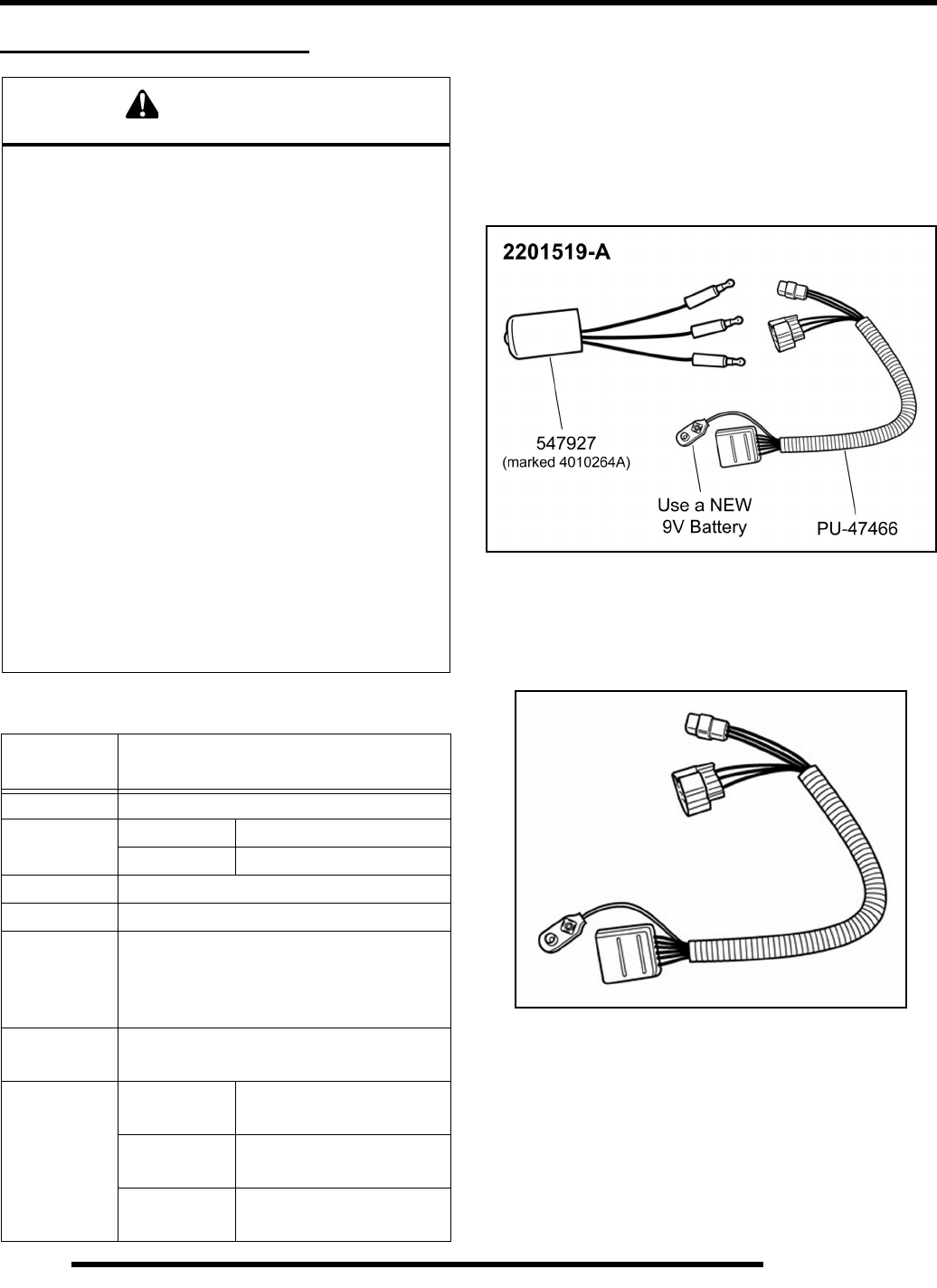
4.2
ELECTRONIC FUEL INJECTION
GENERAL INFORMATION
Special Tools
Throttle Position Sensor (TPS) Tester - 2201519-A
This tester allows the use of a digital multi-meter to test TPS
function as well as perform the TPS adjustment procedure.
NOTE: This TPS Tester replaces the existing tester
(PU-47082), which included the 4010264 regulator. If
your dealership has PU-47082 and 4010264, you DO
NOT need to order 2201519-A as a replacement.
TPS Tester Wire Harness - PU-47466
This TPS wire harness is part of 2201519-A and incorporates
two TPS connectors to allow for multi-use applications.
NOTE: Voltage Regulator (547927) is required if
using TPS Tester Wire Harness (PU-47466). You may
already have this regulator (marked 4010264) as part
of another TPS Tester Kit. If you do not have this
regulator, you must order one from SPX at 1-800-
328-6657.
WARNING
* Gasoline is extremely flammable and explosive
under certain conditions.
* EFI components are under high pressure.
Verify system pressure has been
relieved before disassembly.
* Never drain the fuel system when the engine is hot.
Severe burns may result.
* Do not overfill the tank. The tank is at full capacity
when the fuel reaches the bottom of the filler neck.
Leave room for expansion of fuel.
* Never start the engine or let it run in an enclosed area.
Gasoline powered engine exhaust fumes are
poisonous and can cause loss of consciousness
and death in a short time.
* Do not smoke or allow open flames or sparks in or near
the area where refueling is performed or where
g a so li ne is st or ed .
* If you get gasoline in your eyes or if you should
swallow gasoline, seek medical attention immediately.
* If you spill gasoline on your skin or clothing,
immediately wash with soap and water
and change clothing.
* Always stop the engine and refuel outdoors
or in a well ventilated area.
PART
NUMBER TOOL DESCRIPTION
2201519-A Throttle Position Sensor (TPS) Tester
PU-47466 TPS Tester Wire Harness
547927 TPS Tester Regulator
PU-43506-A Fuel Pressure Gauge Kit
PV-48656 Fuel Pressure Gauge Adaptor
PU-47063-A
Digital Wrench™ Diagnostic Software
(Includes most recent version of software
w/serial number, standard interface cable
and SmartLink Module Kit)
PU-47471 Digital Wrench™ SmartLink Module Kit
(PU-47470, PU-47469, PU-47468)
PU-47470 Digital Wrench™
PC Interface Cable
PU-47469 Digital Wrench™
Vehicle Interface Cable
PU-47468 Digital Wrench™
SmartLink Module
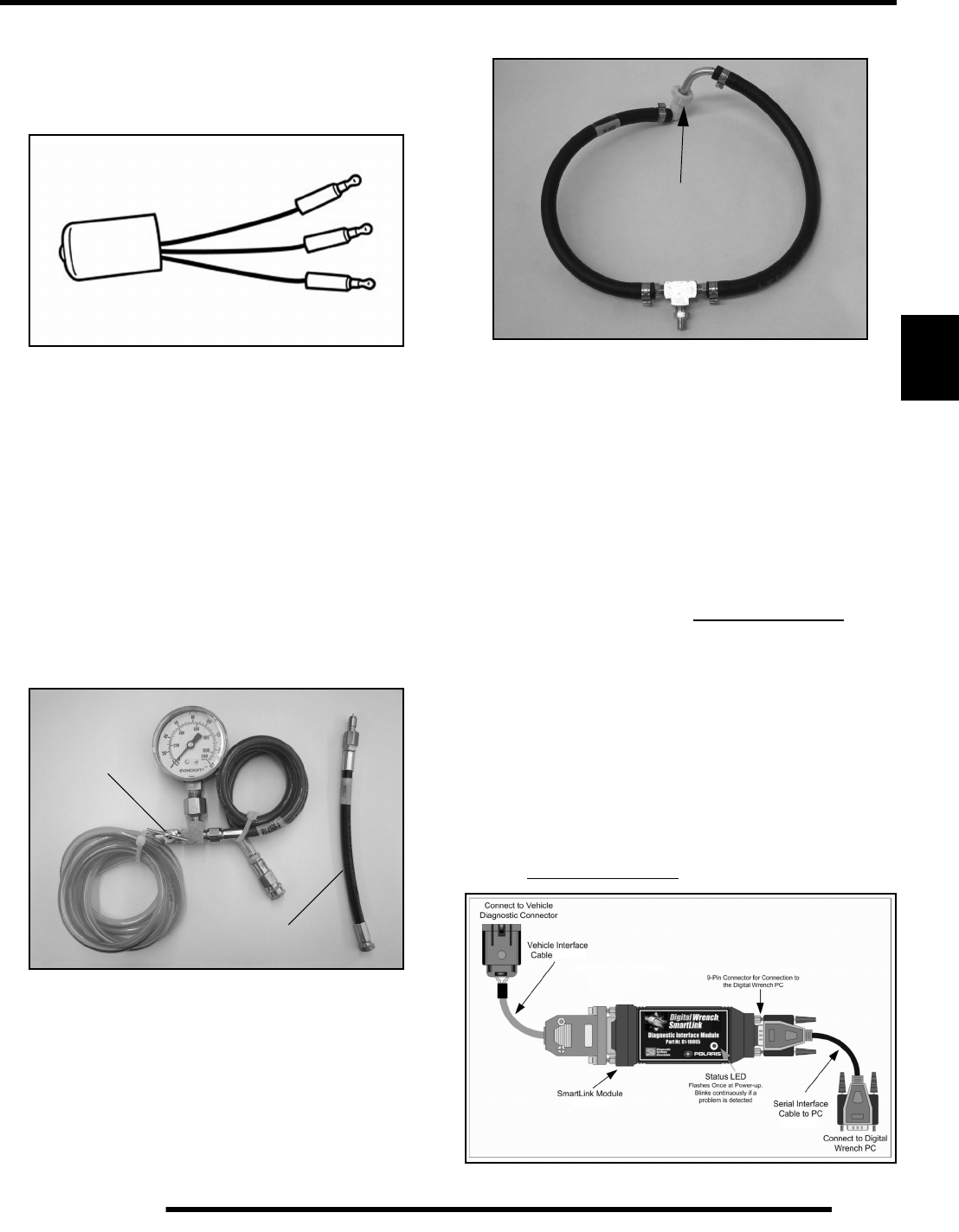
4.3
ELECTRONIC FUEL INJECTION
4
TPS Tester Regulator - 547927
This tester regulator is part of 2201519-A. It regulates the 9 volt
battery voltage to a 5 volt reference input, required when using
the TPS Tester Wire Harness (PU-47466).
NOTE: You may already have this regulator (marked
4010264) as part of another TPS Tester Kit. If you do
not have this regulator, you must order one from
SPX at 1-800-328-6657.
Fuel Pressure Gauge Kit - PU-43506-A
IMPORTANT: The EFI fuel system remains under high
pressure, even when the engine is not running. Before
attempting to service any part of the fuel system,
pressure must be relieved (if applicable). The Fuel
Pressure Gauge Kit has an integrated pressure relief
valve that can be used to bleed off pressure once you
have completed the fuel pressure test.
Fuel Pressure Gauge Adaptor - PV-48656
Digital Wrench™ Diagnostic Software - PU-47063-A
This dealer-only software installs on laptop computers equipped
with a CD drive and serial port connection, and is designed to
replace multiple shop tools often used to test EFI components.
It also includes step-by-step diagnostic procedures to aid
technician repair and troubleshooting.
IMPORTANT: If the PC you are using is not equipped
with a 9-pin serial port, a USB to serial port adaptor
will be necessary. A USB to serial port adaptor can be
purchased through DSA at: www.diagsys.com
Digital Wrench™ SmartLink Module Kit - PU-47471
This module kit contains the necessary cables and hardware to
communicate between the vehicle ECU and the Digital
Wrench™ diagnostic software. Polaris dealers can also order
the following kit components separately: SmartLink Module
PU-47468, Vehicle Interface Cable PU-47469 and PC
Interface Cable PU-47470. This module kit is used on all 8 pin
connector-based Polaris EFI systems. This kit is available to
Polaris dealers through our tool supplier SPX at (1-800-328-
6657) or http://polaris.spx.com
Relief Valve
Adaptor shown is
included with kit.
Adaptor works with
PU-43506-A
Disconnect here and connect
in-line w/fuel pump outlet
PU-47468
PU-47469
PU-47470
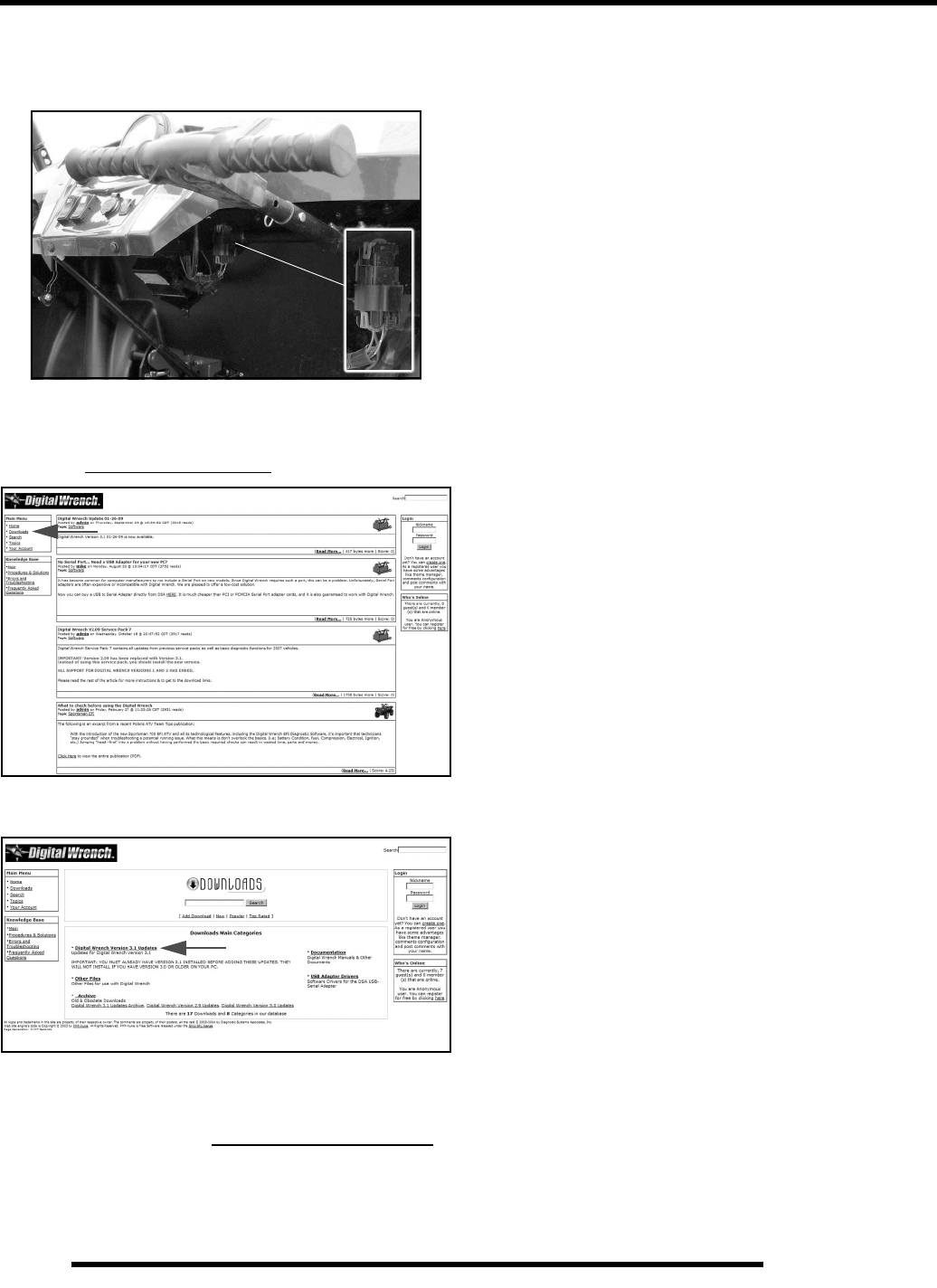
4.4
ELECTRONIC FUEL INJECTION
Digital Wrench™ - Diagnostic Connector
Located under the dash and accessible from the passenger side.
Digital Wrench™ - Download Website
Located at: www.polaris.diagsys.com
Download Digital Wrench™ Updates:
IMPORTANT: For the most recent information on
Digital Wrench™ software and update downloads
please visit the website: www.polaris.diagsys.com
Service Notes
• For more convenient and accurate testing of EFI
components, it is recommended dealers utilize the
Digital Wrench™ Diagnostic Software (dealer only), or
testing may be done manually using the procedures
provided.
•80% of all EFI problems are caused by wiring
harness connections.
• For the purpose of troubleshooting difficult running
issues, a known-good ECU from another RANGER
RZR 800 EFI of the same model and year may be used
without damaging system or engine components.
• Never attempt to service any fuel system component
while engine is running or ignition switch is "on."
• Cleanliness is essential and must be maintained at all
times when servicing or working on the EFI system.
Dirt, even in small quantities, can cause significant
problems.
• Do not use compressed air if the system is open. Cover
any parts removed and wrap any open joints with
plastic if they will remain open for any length of time.
New parts should be removed from their protective
packaging just prior to installation.
• Clean any connector before opening to prevent dirt
from entering the system.
• Although every precaution has been taken to prevent
water intrusion failure, avoid direct water or spray
contact with system components.
• Do not disconnect or reconnect the wiring harness
connector to the control unit or any individual
components with the ignition "on." This can send a
damaging voltage spike through the ECU.
• Do not allow the battery cables to touch opposing
terminals. When connecting battery cables attach the
positive (red) cable to positive (+) battery terminal first,
followed by negative (black) cable to negative (-)
battery terminal.
• Never start the engine when the cables are loose or
poorly connected to the battery terminals.
• Never disconnect battery while engine is running.
• Never use a battery boost-pack to start the engine.
• Do not charge battery with key switch "on."
• Always disconnect negative (-) battery cable lead
before charging battery.
•Always unplug ECU from the wire harness before
performing any welding on the unit.
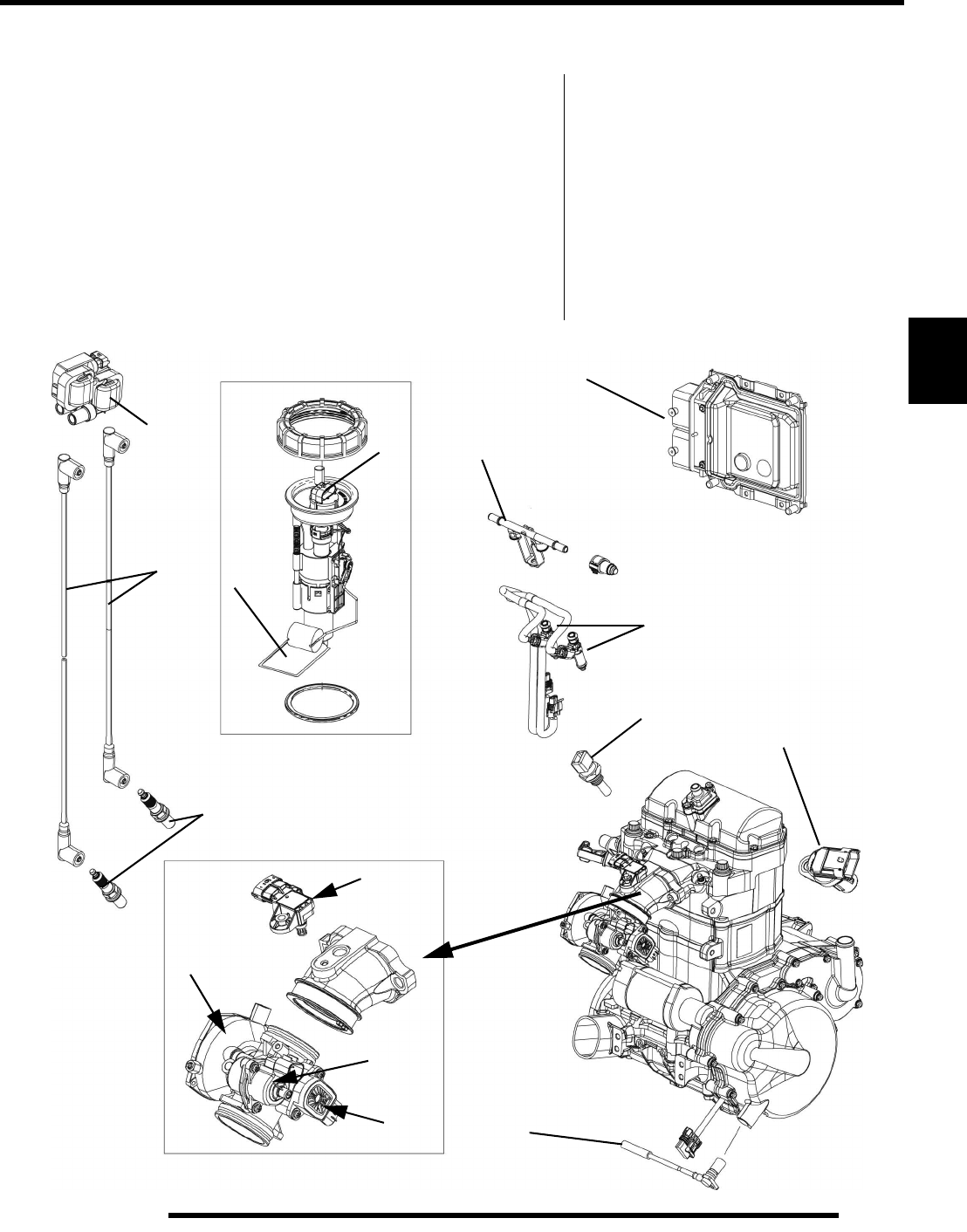
4.5
ELECTRONIC FUEL INJECTION
4
EFI System Exploded View
1. Electronic Control Unit (ECU)
2. Temperature / Manifold Absolute Pressure Sensor (T-MAP)
3. Crankshaft Position Sensor (CPS)
4. Fuel Injectors
5. Fuel Filter
6. Fuel Pump / Regulator / Fuel Level Sender (located in fuel tank)
7. Fuel Rail
8. Engine Coolant Sensor (ECT)
9. Throttle Position Sensor (TPS)
10. Throttle Body
11. Ignition Coil
12. Spark Plugs
1
2
3
4
5
67
8
9
10
11
12
13. Spark Plug Wires
14. IAC Motor (Idle Air Control Motor)
14
15. Camshaft Phase Sensor
15
12
13
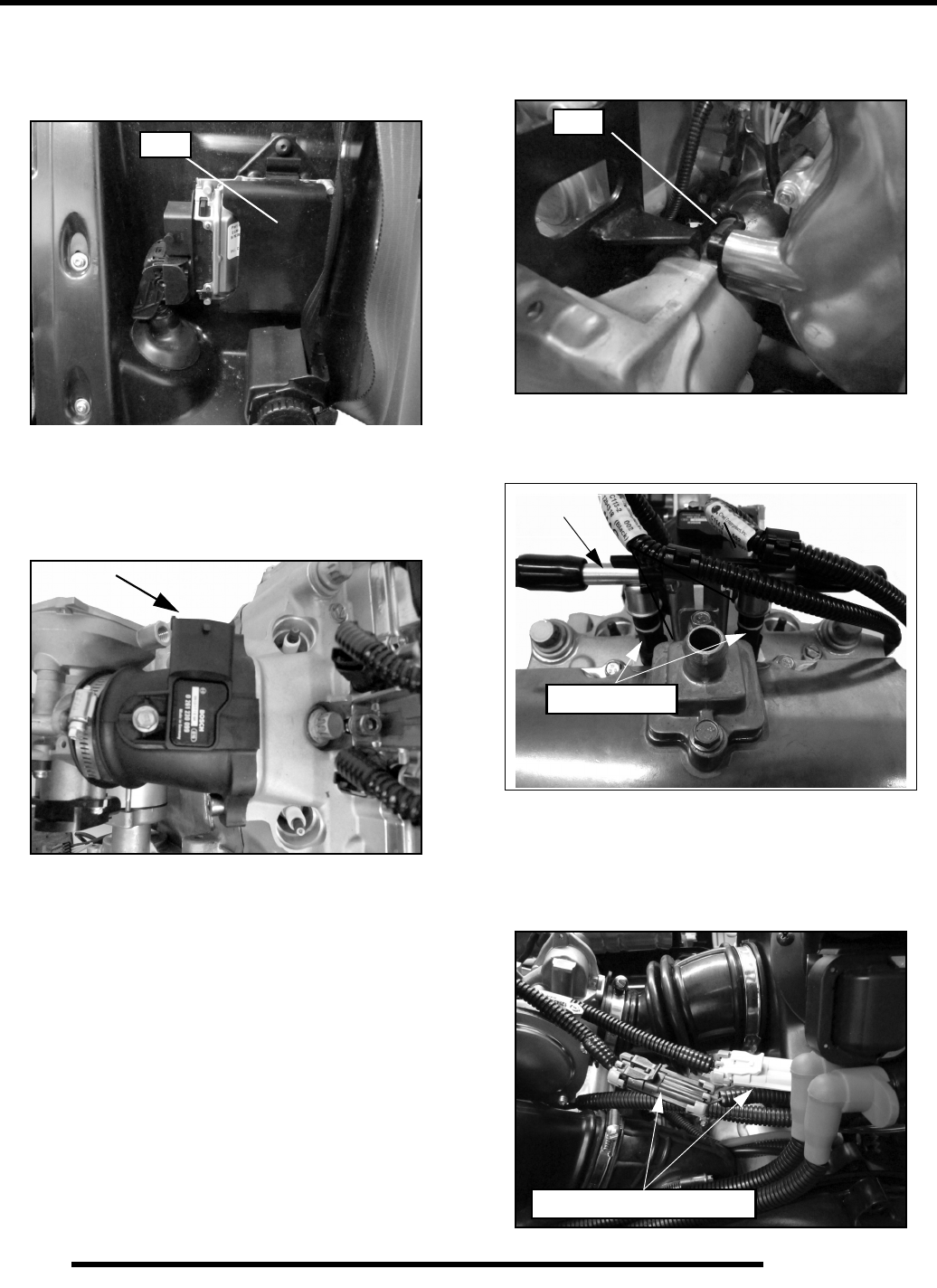
4.6
ELECTRONIC FUEL INJECTION
EFI System Component Locations
1. Electronic Control Unit (ECU)
- Located behind the driver’s seat.
2. Temperature and Manifold Absolute Pressure Sensor
(T-MAP)
- Located in the rubber intake boot between the throttle
body and the cylinder head.
3. Crankshaft Position Sensor (CPS)
- Located in the magneto cover between the engine and
transmission, just in front of the rear gear case.
4. Fuel Injectors / Fuel Rail
- Attached to the fuel rail located in the intake track of the
cylinder head.
NOTE: Be sure to connect like colored fuel injector
connectors for proper engine function. Make note of
PTO and MAG side injectors before disconnecting
them.
ECU
CPS
Fuel Rail
Fuel
Rail
Fuel Injectors
Note Color of Connectors
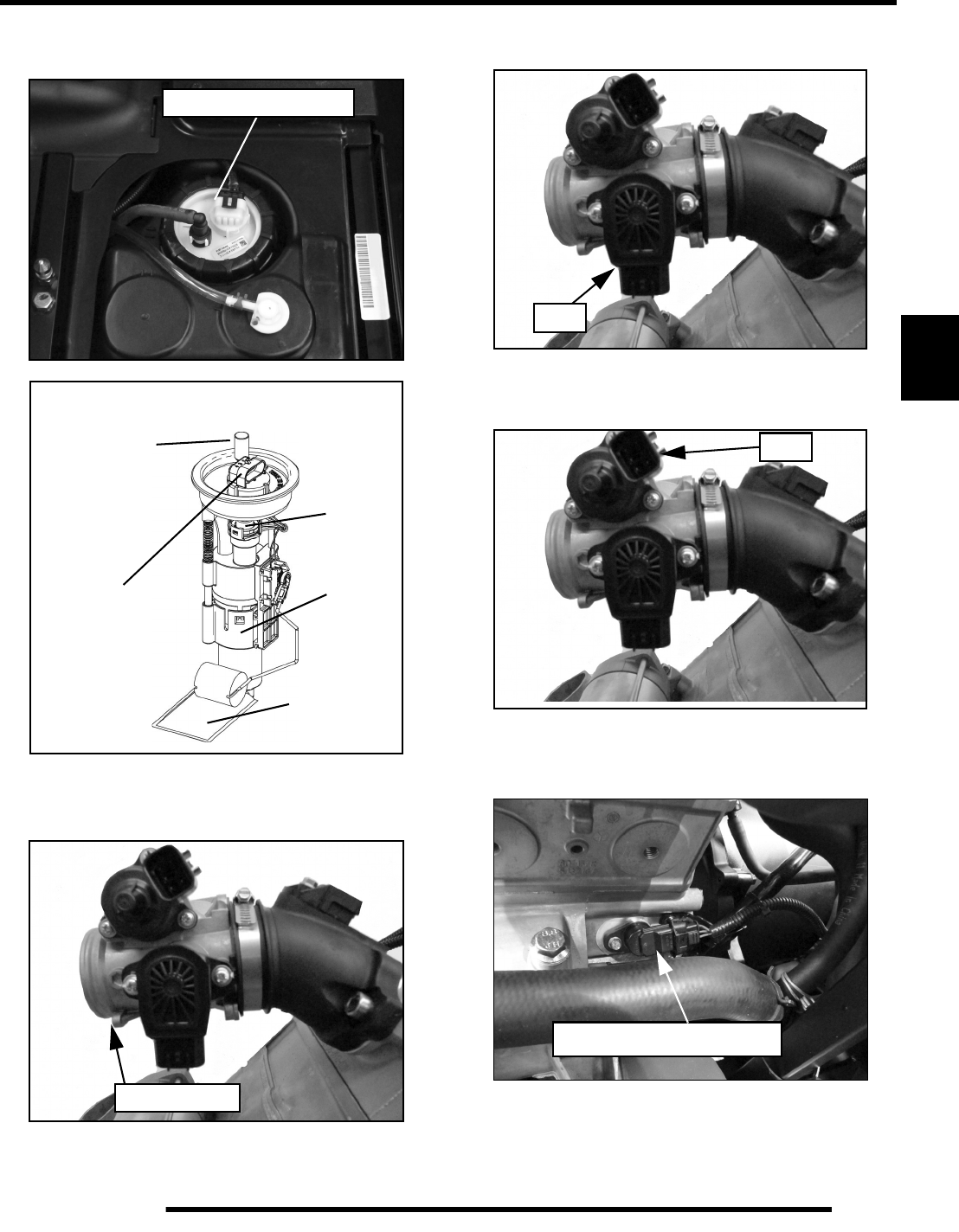
4.7
ELECTRONIC FUEL INJECTION
4
5. Fuel Pump / Regulator / Fuel Gauge Sender Assembly
- Located under the passenger seat.
6. Throttle Body
- Located between the rubber air box boot and the rubber
cylinder head adaptor.
7. Throttle Position Sensor (TPS)
- Located on the right-hand side of the throttle body.
8. Idle Air Control Motor (IAC)
- Located on the right-hand / top side of the throttle body
above the TPS sensor.
9. Camshaft Phase Sensor
- Located in the engine block near the oil filter. The sensor
can be accessed in the right rear wheel well.
Fuel Pump Assembly
Located in Fuel Tank
Fuel Pump
Regulator
Pump / Sending Unit
Preliminary Filter
Fuel Line
Connection
Connection
Throttle Body
TPS
IAC
ECT
Camshaft Phase Sensor
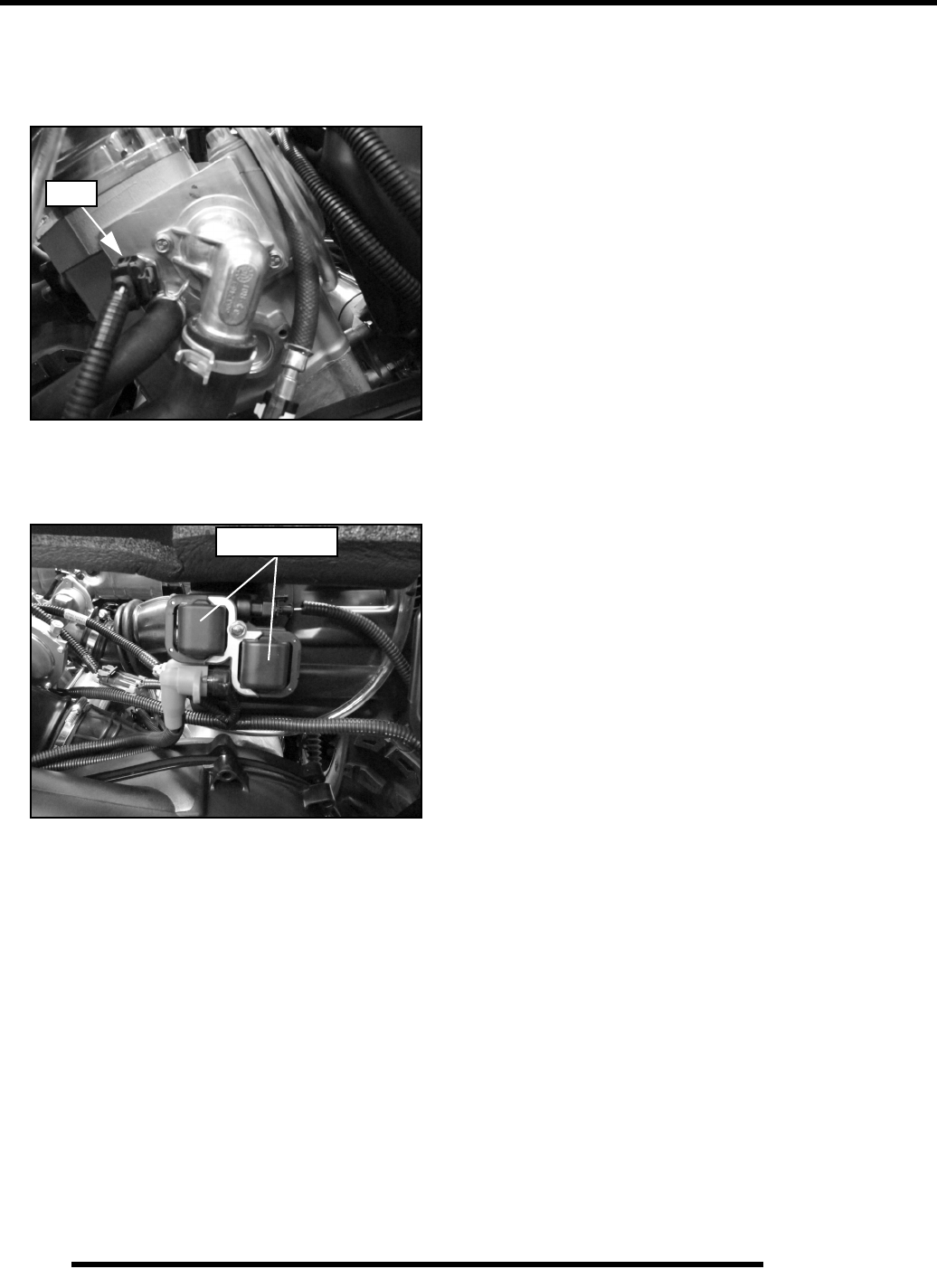
4.8
ELECTRONIC FUEL INJECTION
10. Engine Coolant Temperature Sensor (ECT)
- Located in the cylinder head next to the thermostat
housing. The sensor can be accessed with the driver and
passenger seats and rear service panel removed.
11. Ignition Coil
- Located behind the driver’s seat and rear service panel just
above the PVT cover.
ECT
Ignition Coil
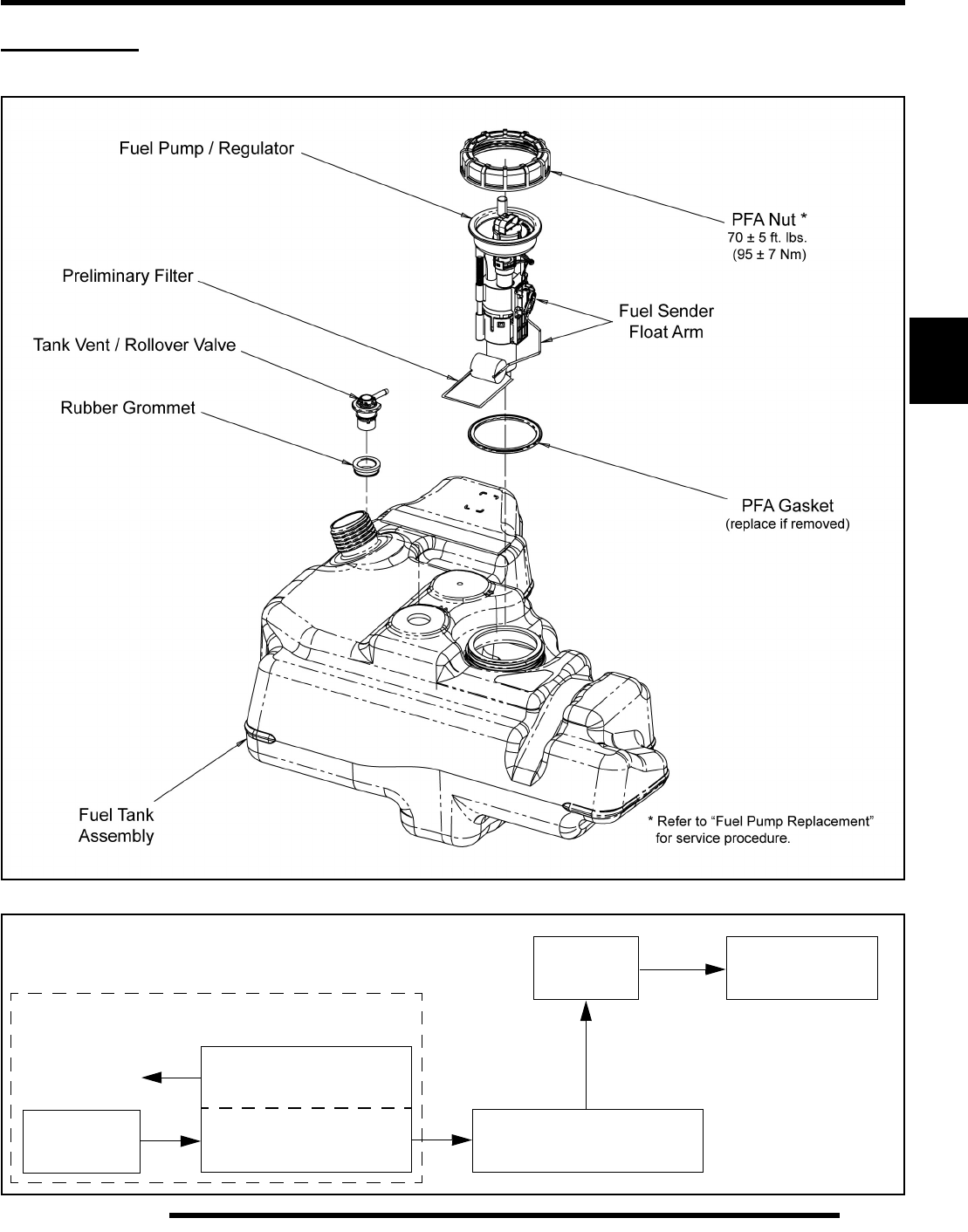
4.9
ELECTRONIC FUEL INJECTION
4
FUEL TANK
Exploded View
Fuel Flow
Fuel Filters Fuel Pump Assembly Quick Connect Fuel Line
Fuel Rail Fuel Injectors
Pressure Regulator
Fuel Tank
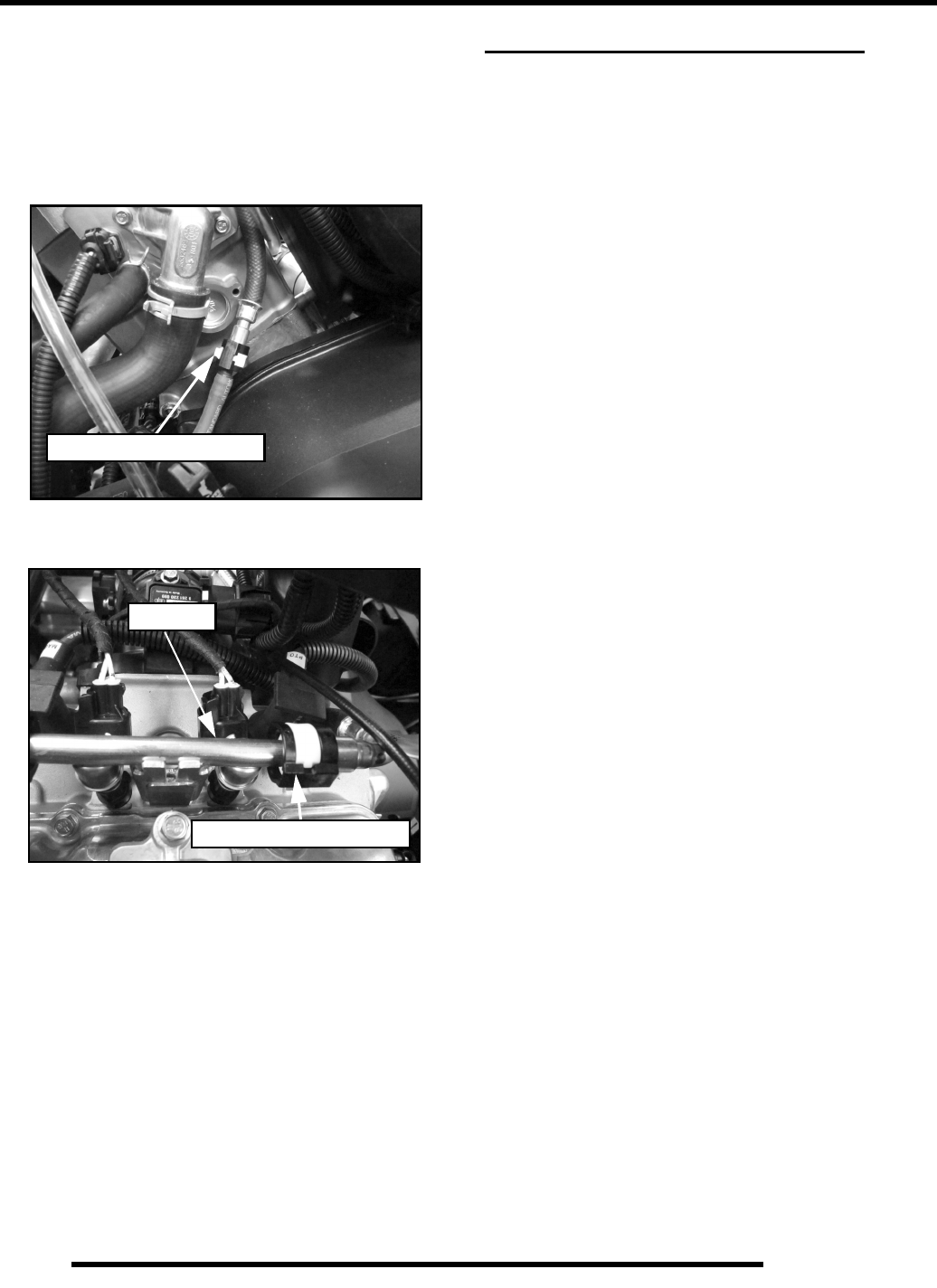
4.10
ELECTRONIC FUEL INJECTION
Fuel Lines - Quick Connect
RANGER EFI models use quick connect fuel lines. Refer to the
steps below for fuel line removal.
1. Place a shop towel around the fuel line to catch any
dripping fuel. Squeeze the connector tabs together and
push the locking slide back.
2. Pull on the fuel line for removal.
3. To install the line, verify the connector and fuel tank nipple
are clean and free of debris.
4. Snap the fuel line back over the nipple and slide the locking
mechanism back into place. Verify the connector tabs snap
back into place.
ELECTRONIC FUEL INJECTION
Principal Components
The Electronic Fuel Injection (EFI) system is a complete engine
fuel and ignition management design. This system includes the
following principal components:
•Fuel Pump
• Fuel Rail
•Fuel Line
• Fuel Filter(s)
• Fuel Injectors
• Pressure Regulator
• Throttle Body / lntake Manifold
• Engine Control Unit (ECU)
• Ignition Coils
• Engine Coolant Temperature Sensor (ECT)
• Throttle Position Sensor (TPS)
• Crankshaft Position Sensor (CPS)
• Temperature and Manifold Absolute Pressure Sensor
(T-MAP)
• Camshaft Phase Sensor
• Idle Air Control Motor (IAC)
• Wire Harness Assembly
• Check Engine Light
EFI Operation Overview
The EFI system is designed to provide peak engine performance
with optimum fuel efficiency and lowest possible emissions.
The ignition and injection functions are electronically
controlled, monitored and continually corrected during
operation to maintain peak performance.
The central component of the system is the Bosch Electronic
Control Unit (ECU) which manages system operation,
determining the best combination of fuel mixture and ignition
timing for the current operating conditions.
An in-tank electric fuel pump is used to move fuel from the tank
through the fuel line, to the fuel rail. The in-tank fuel pressure
regulator maintains a system operating pressure and returns any
excess fuel back into the tank. At the engine, fuel is fed through
the fuel rail and into the injectors, which inject into the intake
ports. The ECU controls the amount of fuel by varying the
length of time that the injectors are "on." This range can vary
depending on fuel requirements. The controlled injection of the
fuel occurs every other crankshaft revolution, or once for each
4-stroke cycle. The total amount of fuel needed for one firing of
a cylinder is injected during each cycle. When the intake valve
opens, the fuel/air mixture is drawn into the combustion
chamber, ignited and burned.
Squeeze Connector Tabs
Squeeze Connector Tabs
Fuel Rail

4.11
ELECTRONIC FUEL INJECTION
4
The ECU controls the amount of fuel being injected and the
ignition timing by monitoring the primary sensor signals for
intake air temperature, manifold absolute pressure (load),
engine temperature, speed (RPM), camshaft position and
throttle position. These primary signals are compared to the
programming in the ECU computer chip, and the ECU adjusts
the fuel delivery and ignition timing to match the values.
During operation, the ECU has the ability to re-adjust
temporarily; providing compensation for changes in overall
engine condition and operating environment, so it will be able
to maintain the ideal air/fuel ratio.
During certain operating periods such as cold starts, warm up,
acceleration, etc., a richer air / fuel ratio is automatically
calculated by the ECU.
Initial Priming / Starting Procedure
NOTE: The injection system must be purged of all
air prior to the initial start up, and / or any time the
system has been disassembled.
If the EFI system is completely empty of fuel or has been
disassembled and repaired:
1. Cycle the key switch from “OFF” to “ON” 6 times, waiting
for approximately 3 seconds at each “ON” cycle to allow
the fuel pump to cycle and shut down.
2. Once step 1 is completed, turn the key switch to “START”
until the engine starts or 5 seconds has passed.
3. If the engine failed to start, repeat step 1 for 2 more cycles
and attempt to start the engine.
If the engine fails to start, a problem may still exist, and should
be diagnosed.
NOTE: Accurate testing of EFI components is
recommended utilizing the Digital Wrench™
Diagnostic Software (dealer only).
ELECTRONIC CONTROL UNIT (ECU)
Operation Overview
The ECU is the brain or central processing computer of the
entire EFI fuel/ignition management system. During operation,
sensors continuously gather data which is relayed through the
wiring harness to input circuits within the ECU. Signals to the
ECU include: ignition (on/off), crankshaft position and speed
(RPM), camshaft position (MAG/PTO), throttle position,
engine coolant temperature, intake air temperature, intake
manifold absolute pressure and battery voltage. The ECU
compares the input signals to the programmed maps in its
memory and determines the appropriate fuel and spark
requirements for the immediate operating conditions. The ECU
then sends output signals to set the injector duration and ignition
timing.
During operation, the ECU continually performs a diagnostic
check of itself, each of the sensors, and system performance. If
a fault is detected, the ECU turns on the “Check Engine” light
in the speedometer and stores the fault code in its fault memory.
Depending on the significance or severity of the fault, normal
operation may continue, or "Fail-Safe" operation (slowed speed,
richer running) may be initiated. A technician can determine the
cause of the “Check Engine” light by referencing the
“Instrument Cluster Trouble Code Display” and “Diagnostic
Trouble Code Table” or by using Digital Wrench™. The ECU
requires a minimum of 7.0 volts to operate. The memory in the
ECU is operational the moment the battery cables are
connected.
To prevent engine over-speed and possible failure, an RPM
limiting feature is programmed into the ECU. If the maximum
RPM limit (6750 RPM) is exceeded, the ECU suppresses the
injection signals, cutting off the fuel flow and retards the
ignition timing. This process repeats it self in rapid succession,
limiting operation to the preset maximum.
ECU
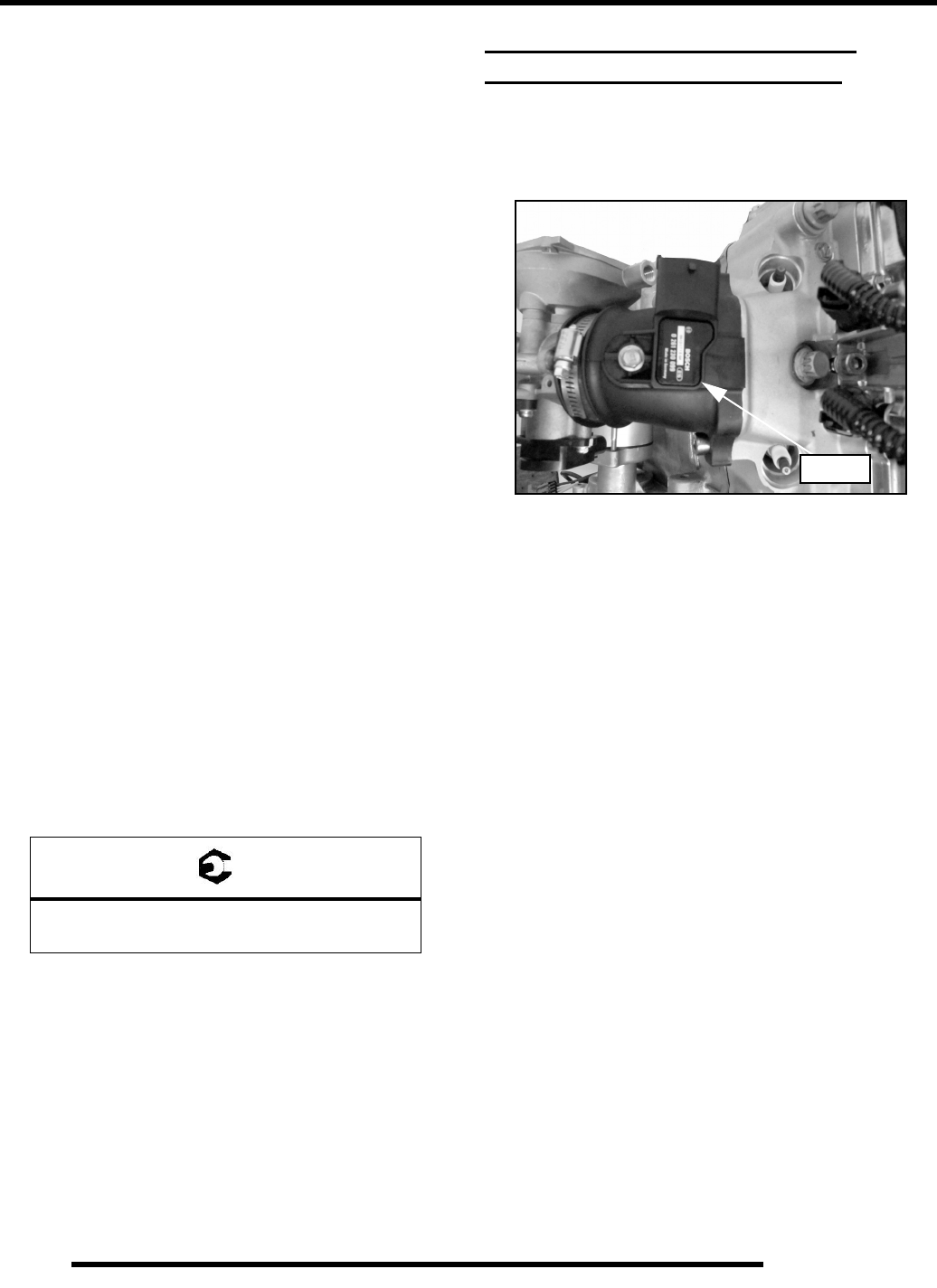
4.12
ELECTRONIC FUEL INJECTION
RANGER RZR 800 EFI RPM Limit:
Max RPM Limit - Injector suppression and timing retarded
• All Gears: 6750 RPM
ECU Service
Never attempt to disassemble the ECU. It is sealed to prevent
damage to internal components. Warranty is void if the case is
opened or tampered with in any way.
All operating and control functions within the ECU are pre-set.
No internal servicing or readjustment may be performed. If a
problem is encountered, and you determine the ECU to be
faulty, contact the Polaris Service Department for specific
handling instructions. Do not replace the ECU without factory
authorization.
The relationship between the ECU and the throttle position
sensor (TPS) is very critical to proper system operation. If the
TPS is faulty, or the mounting position of the TPS to the throttle
body is altered, the TPS must be adjusted.
For the purpose of troubleshooting, a known-good ECU from
another Polaris RANGER RZR EFI of the same model may be
used without system or engine component damage.
ECU Replacement
1. Remove the (2) retaining screws holding the ECU.
2. With the ignition turned off, disconnect the wire harness
from the ECU.
3. To install, reverse the procedure and tighten screws to
specification.
TEMP / MANIFOLD ABSOLUTE
PRESSURE SENSOR (T-MAP)
Operation Overview
Mounted on the throttle body intake manifold, the T-MAP
sensor performs two functions in one unit.
Air passing through the intake is measured by the T-MAP and
relayed to the ECU. These signals, comprised of separate air
temperature and manifold absolute pressure readings, are
processed by the ECU and compared to its programming for
determining the fuel and ignition requirements during
operation. The T-MAP sensor provides the ECU with engine
load data.
T-MAP Sensor Test
The T-MAP sensor is a non-serviceable item. If it is faulty, it
must be replaced.
IMPORTANT: This sensor should only be tested using
the Digital Wrench™ Diagnostic Software (dealer
only).
T-MAP Sensor Replacement
1. Remove the seats and rear service panel. (see chapter 5).
2. Remove the rear cargo box (see chapter 5).
3. Remove the cable tie from the sensor connector.
4. Disconnect vehicle harness from T-MAP sensor.
5. Remove the retaining bolt and remove the sensor from the
intake boot.
6. Use a light coating of soapy water on the grommet to aid
installation of the new sensor.
= T
ECU Retaining Screws
10 in. lbs. (1.1 Nm)
T-MAP
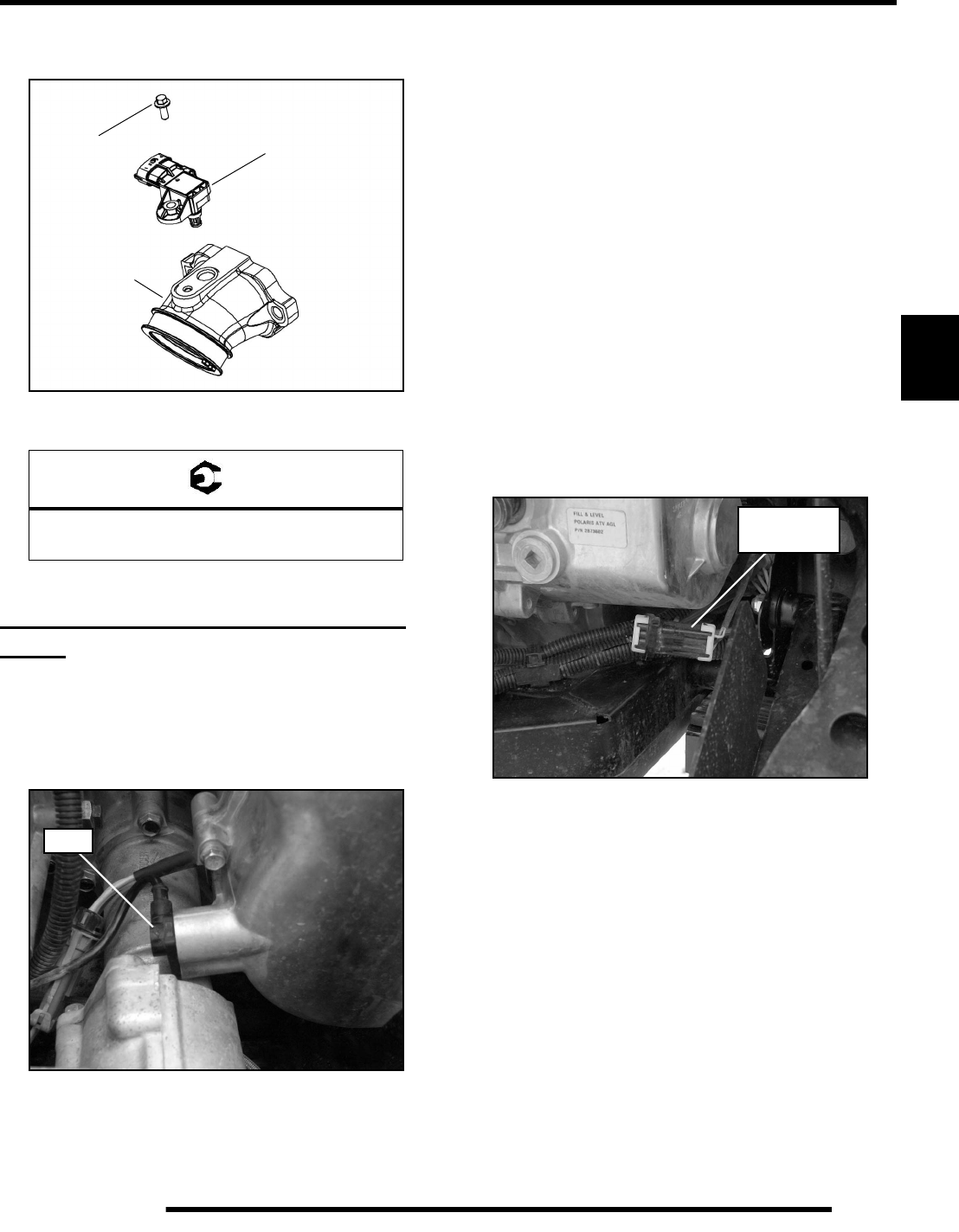
4.13
ELECTRONIC FUEL INJECTION
4
7. Install the sensor by inserting it with a twisting motion to
properly seat the grommet.
8. Install the retaining bolt and torque to specification.
CRANKSHAFT POSITION SENSOR
(CPS)
Operation Overview
The crankshaft position sensor is essential to engine operation,
constantly monitoring the rotational speed (RPM) and position
of the crankshaft.
A ferromagnetic 60-tooth ring gear with two consecutive teeth
missing is mounted on the flywheel. The inductive speed sensor
is mounted 1.0 0.26 mm (0.059 0.010 in.) away from the ring
gear. During rotation, an AC pulse is created within the sensor
for each passing tooth. The ECU calculates engine speed from
the time interval between the consecutive pulses.
The two-tooth gap creates an “interrupt” input signal,
corresponding to specific crankshaft position. This signal serves
as a reference for the control of ignition timing by the ECU.
Synchronization of the CPS and crankshaft position takes place
during the first two revolutions each time the engine is started.
This sensor must be properly connected at all times. If the sensor
fails or becomes disconnected for any reason, the engine will
stop running.
CPS Test
The CPS is a sealed, non-serviceable assembly. If fault code
diagnosis indicates a problem within this sensor, test as follows:
1. Disconnect CPS (3-wire) harness connector on the left-
hand side of the vehicle located below the transmission.
2. Connect an ohmmeter between the pin terminals leading
from the Yellow and White wires. A resistance value of
560 10% at room temperature should be obtained.
= T
T-MAP Retaining Bolt Torque:
25 ± 2.5 in. lbs. (3 ± .3 Nm)
T-MAP
Intake Boot
Bolt
Torque to Specification
CPS
CPS
Connector
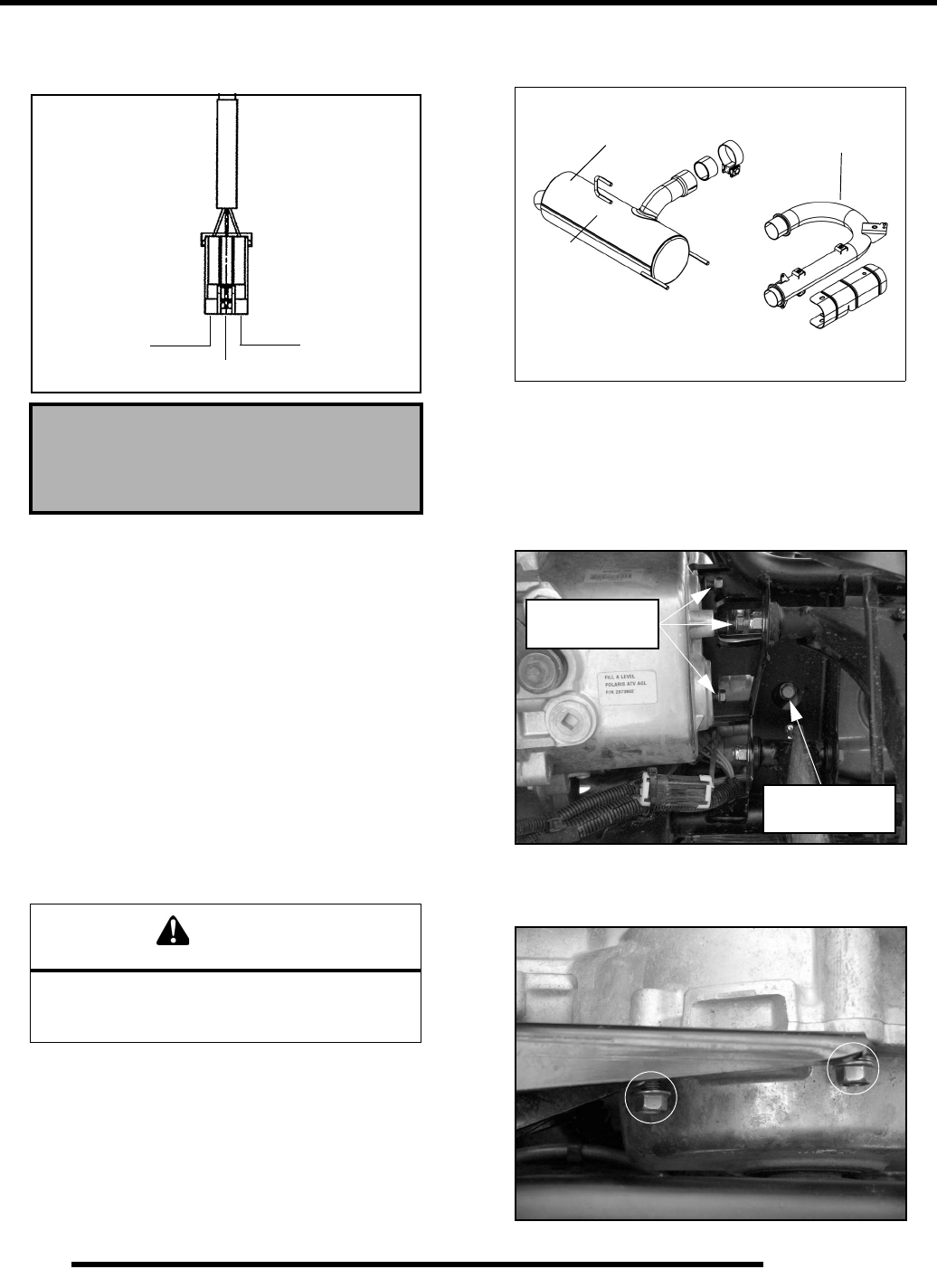
4.14
ELECTRONIC FUEL INJECTION
3. Measure between the pin terminal leading from the Black
wire and ground. A resistance value of 0 - 0.5 ± 10%
should be obtained.
4. If the resistance is correct.
- Test the main harness circuit between the sensor
connector terminals and the corresponding pin terminals at
the ECU (see wiring diagram).
- Check the sensor mounting, air gap, flywheel ring gear for
damage or runout, and flywheel key. Follow the “CPS
Replacement” procedure to inspect CPS and flywheel ring
gear for damage.
5. If the resistance is incorrect, follow the “CPS Replacement”
procedure.
CPS Replacement
Removal
1. Safely support the rear of the vehicle off the ground and
remove the left-hand rear tire.
2. If not done already; disconnect the CPS harness connector
(see illustration under “CPS Test”).
IMPORTANT: In order to remove the CPS, the rear
portion of the exhaust system and the mounting
bracket between the transmission and rear gearcase
will need to be removed.
3. Remove the exhaust pipe between the elbow pipe and the
exhaust silencer. Remove the exhaust silencer.
4. Remove the (3) bolts retaining the front portion of the
mounting bracket to the transmission. Retain the bolts,
washers, and spacers for installation.
5. Remove the bottom bolt that attaches the bracket to the rear
gearcase through the hole in the frame support as shown.
6. Remove the (2) remaining fasteners that attach the bracket
to the side of the rear gearcase.
CPS Resistance Specification:
Yellow to White: 560 10%
Black to Ground: 0 - 0.5 10%
WARNING
Serious injury may result if machine tips or falls.
Be sure the vehicle is secure before beginning
this service procedure.
Yellow
Black
White
CPS Harness
Remove
Remove
Silencer
Rear Gearcase
Mounting Bolt
Transmission
Mounting Bolts

4.15
ELECTRONIC FUEL INJECTION
4
7. Remove the bolt from the bracket at the front of the rear
gearcase.
8. Lift the mounting bracket straight up and out from the
vehicle.
9. Using a 5 mm hex wrench, remove the CPS retaining bolt
and remove the sensor from the magneto housing.
10. Install new sensor using a light coating of oil on the O-ring
to aid installation.
11. Torque the CPS retaining bolt to specification.
Installation
IMPORTANT: When reinstalling the transmission to
rear gearcase mount bracket, it is extremely important
to torque all (7) fasteners to specification. Refer to the
following procedure.
NOTE: Special tool (PA-48873) will be required to
torque the mounting bracket fasteners when the
transmission and rear gearcase are installed in the
vehicle.
1. Clean bolt threads with solvent and allow them to dry.
Coat the circumference of the first 4 threads of the bolts
with Loctite before installing the bolts.
Remove
Bracket
= T
CPS Retaining Bolt Torque:
25 in. lbs. (2.8 Nm)
This tool is specifically designed to access
the critical transmission to rear gearcase
mounting bracket bolts on the RANGER
RZR when the transmission and rear
gearcase are installed in the vehicle. This
tool allows for proper torque to be applied to
½” SAE hex head cap screws with limited
wrench access. When used at a 90° angle
with a torque wrench, no torque multiplier
is necessary.
Special Tool
PA-48873

4.16
ELECTRONIC FUEL INJECTION
2. Reinstall mounting bracket and hand tighten the (7) bolts.
3. Torque ALL mounting bracket bolts to specification.
4. Using special tool (PA-48873), torque the (3) bolts that
retain the front portion of the mounting bracket to the
transmission.
Upper Transmission Bolt
Middle Transmission Bolt
Bottom Transmission Bolt
5. Remove the special tool and attach an extension to the
torque wrench. Torque the bottom bolt that attaches the
bracket to the rear gearcase through the hole in the frame
support.
Bottom Rear Gearcase Bolt
NOTE: Special Tool is not required for this torque.
6. Using special tool (PA-48873), torque the upper (2) bolts
retaining the mounting bracket to the rear gearcase. Place
the torque wrench through the rear exhaust silencer opening
to gain access to the bolts.
= T
Mount Bracket Bolt Torque:
23-27 ft. lbs. (31-37 Nm)
Torque with
an extension

4.17
ELECTRONIC FUEL INJECTION
4
Middle Rear Gearcase Bolt
Upper Rear Gearcase Bolt
7. Torque the remaining bolt that attaches the bracket to the
front side of the rear gearcase.
Front Rear Gearcase Bolt
NOTE: A multi-directional torque wrench is required
in this application because of the limited access to
this bolt. Check with the manufacturer of your torque
wrench to see if it can be used to tighten left-hand
threaded bolts.
FUEL INJECTORS
Operation Overview
NOTE: All EFI units utilize quick connect fuel lines.
The fuel injectors mount into the cylinder head, and the fuel rail
attaches to them at the top end. O-rings on both ends of the
injector prevent external fuel leaks and also insulate it from heat
and vibration.
When the key switch is on, the fuel rail is pressurized, and the
EFI relay provides voltage to the injectors. During engine
operation, the ECU completes the ground circuit, energizing the
injectors. The valve needle in the injector is opened
electromagnetically, and the pressure in the fuel rail forces fuel
down through the inside. The “director plate” at the tip of the
injector contains a series of calibrated openings which directs
the fuel into the intake port in a cone-shaped spray pattern.
The amount of fuel injected is controlled by the ECU and
determined by the length of time the valve needle is held open,
also referred to as the “injection duration” or “pulse width”. It
may vary in length depending on the speed and load
requirements of the engine.
The ECU gathers fuel injection timing information from the
Crankshaft Position Sensor and Camshaft Phase Sensor to allow
for sequential fuel injection.
Fuel
Fuel Rail
Injectors
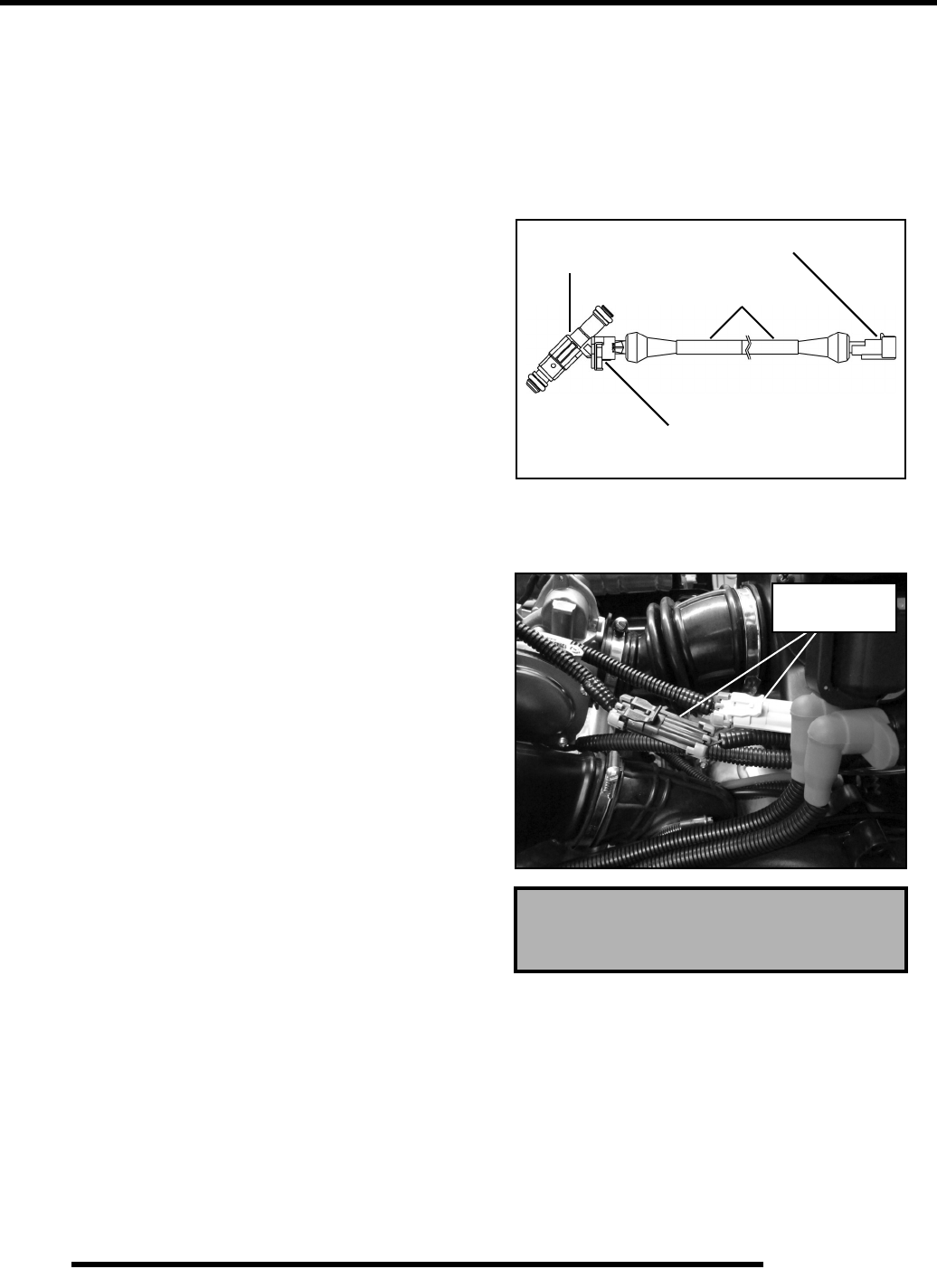
4.18
ELECTRONIC FUEL INJECTION
Fuel Injector Service
Injector problems typically fall into three general categories-
electrical, dirty / clogged, or leakage. An electrical problem
usually causes one or both of the injectors to stop functioning.
Several methods may be used to check if the injectors are
operating.
• With the engine running at idle, feel for operational
vibration, indicating that they are opening and closing.
• When temperatures prohibit touching, listen for a
buzzing or clicking sound with a screwdriver or
mechanic's stethoscope.
• Disconnect the electrical connector from an injector and
listen for a change in idle performance (only running on
one cylinder) or a change in injector noise or vibration.
NOTE: Do not apply voltage directly to the fuel
injector(s). Excessive voltage will burn out the
injector(s). Do not ground the injector(s) with the
ignition on. lnjector(s) will open/turn on if relay is
energized.
If an injector is not operating, it can indicate either a bad injector,
or a wiring/electrical connection problem. Check as follows:
Injector leakage is very unlikely, but in rare instances it can be
internal (past the tip of the valve needle), or external (weeping
around the injector body). The loss of system pressure from the
leakage can cause hot restart problems and longer cranking
times.
Injector problems due to dirt or clogging are unlikely due to the
design of the injectors, the high fuel pressure, the use of filters
and the detergent additives in the gasoline. Symptoms that could
be caused by dirty/clogged injectors include rough idle,
hesitation/stumble during acceleration, or triggering of fault
codes related to fuel delivery. Injector clogging is usually caused
by a buildup of deposits on the director plate, restricting the flow
of fuel, resulting in a poor spray pattern. Some contributing
factors to injector clogging include; dirty air filters, higher than
normal operating temperatures, short operating intervals and
dirty, incorrect, or poor quality fuel. Cleaning of clogged
injectors is not recommended; they should be replaced.
Additives and higher grades of fuel can be used as a preventative
measure if clogging has been a problem.
Fuel Injector Test
NOTE: The harness connector and locking spring is
bonded to the fuel injectors with an epoxy. DO NOT
attempt to disconnect the connector from the fuel
injectors. Damage will occur to the injector and/or
harness if attempting to separate at that location.
Separate the fuel injector from the vehicle harness
as shown in the illustration below.
The fuel injectors are non-serviceable. If diagnosis indicates a
problem with either injector, test the resistance of the fuel
injector(s) by measuring between the two harness pin terminals:
NOTE: Be sure to connect like colored fuel injector
connectors for proper engine function. Make note of
PTO and MAG side injectors before disconnecting
them. PTO = GRAY, MAG = BLACK.
Fuel Injector Resistance Specification:
11.4 - 12.6
Disconnect Here
DO NOT
Disconnect Here
Fuel
Injector
Harness
Disconnect
and test here
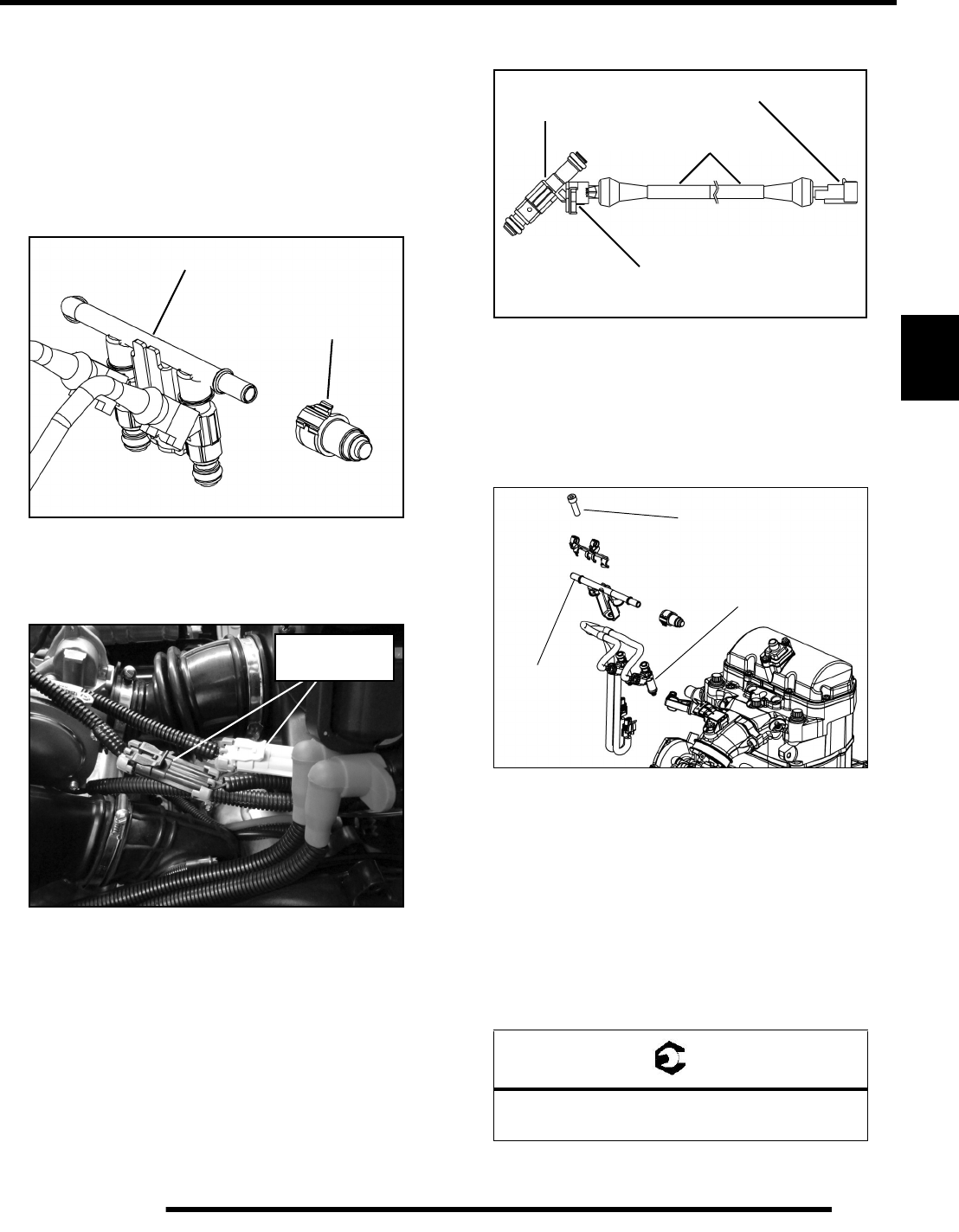
4.19
ELECTRONIC FUEL INJECTION
4
Fuel Injector Replacement
1. Be sure the engine has cooled enough to work on.
2. Remove the seats and rear service panel (see chapter 5).
3. Remove the rear cargo box (see chapter 5).
4. Place a suitable container below the quick connect plug at
the end of the fuel rail. Hold a shop rag over the plug and
remove it to depressurize the fuel system.
5. Disconnect the harness for the fuel injector(s) located next
to the ignition coil. Cut the plastic tie strap and push the
harness for the fuel injector(s) up over the air box to allow
fuel injector removal.
NOTE: The harness connector and locking spring is
bonded to the fuel injectors with an epoxy. DO NOT
attempt to disconnect the Bosch connector from the
fuel injectors. Damage will occur to the injector and/
or harness if attempting to separate at that location.
Separate the fuel injector from the vehicle harness
as shown in the illustration below.
6. Thoroughly clean the area around the fuel injectors
including the throttle body manifold.
7. Using a 6 mm hex wrench, loosen the fuel rail mounting
screw from the cylinder head. Carefully pull the rail away
from the injectors and remove the injector(s) from the
cylinder head along with the harness.
8. Reverse the previous procedures to install the new
injector(s) and reassemble.
IMPORTANT: Be sure to mark / note the color of the
fuel injector connectors. For proper engine function,
the fuel injectors must be connected correctly. Make
note of PTO and MAG side injectors before
disconnecting them. PTO = GRAY, MAG = BLACK.
9. Lubricate O-rings lightly with oil to aid installation. Torque
the fuel rail mounting screw to specification.
Fuel Rail
Quick Connect
Plug
Fuel Injector
Harnesses
= T
Fuel Rail Mounting Screw
216 +/- 24 in. lbs. (24 Nm)
Disconnect Here
DO NOT
Disconnect Here
Fuel
Injector
Harness
Fuel Injectors
Fuel Rail
Mounting
Screw

4.20
ELECTRONIC FUEL INJECTION
FUEL PUMP
Operation Overview
An electric fuel pump assembly is used to transfer fuel to the EFI
system from inside the fuel tank. This assembly includes the fuel
pump, fuel filters, regulator and fuel gauge sender. The pump is
rated for a minimum output of 25 liters per hour at 45 ± 2 psi and
has two non-serviceable fuel filters.
When the key switch is turned to "ON", the ECU activates the
fuel pump, which pressurizes the system for start-up.
The ECU switches off the pump preventing the continued
delivery of fuel in these instances:
• If the key switch is not promptly turned to the "start"
position.
• If the engine fails to start.
• If the engine is stopped with the key switch "on" (as in
the case of an accident).
In these situations, the “check engine” light will go on, but will
turn off after 4 cranking revolutions if system function is OK.
Once the engine is running, the fuel pump remains on.
Fuel Sender Test
If the fuel gauge reading on the instrument cluster is not
working, or if the display reading differs in large comparison to
the fuel in the tank, perform a resistance test on the fuel sender.
Disconnect the fuel pump / sending unit connection and measure
the resistance (see Chapter 10 “Fuel Sender Testing”). If out of
specification, replace the fuel pump assembly.
Fuel Pump Assembly
Located in Fuel Tank
Fuel Pump
Regulator
Pump / Sending Unit
Preliminary Filter
Fuel Line
Connection
Connection
Fuel Sender Resistance Specifications:
Full: 6 ± 1
Empty: 90 ± 4.5
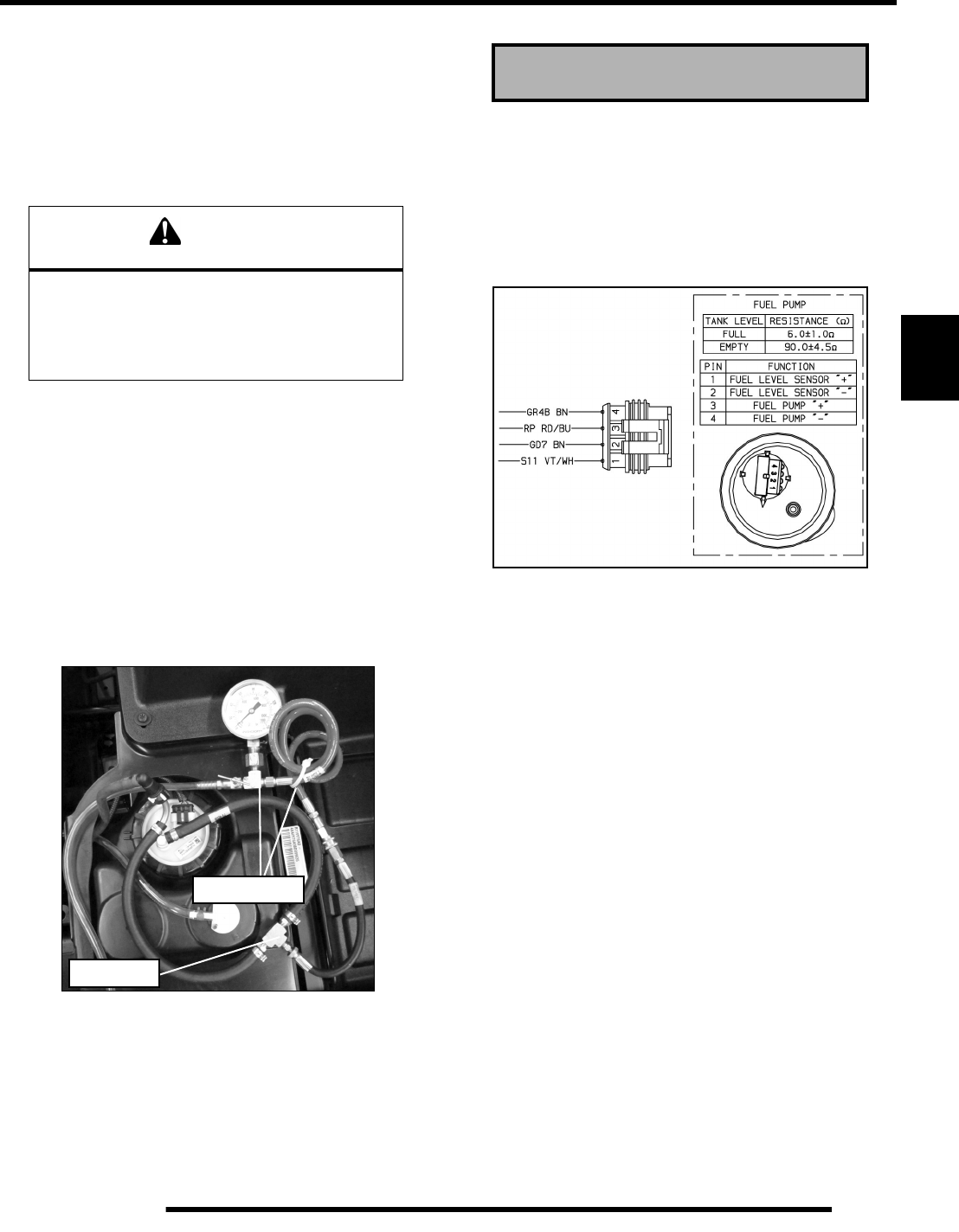
4.21
ELECTRONIC FUEL INJECTION
4
Fuel Pump Test
If a fuel delivery problem is suspected, make certain the fuel
pump filters are not plugged, that the pump is being activated
through the ECU, all electrical connections are properly
secured, the fuses are good, and a minimum of 7.0 volts is being
supplied. If during starting the battery voltage drops below 7.0
volts, the ECU will fail to operate the system.
1. Remove the passenger seat from the vehicle.
2. Cover the fuel line connection at the fuel tank with a shop
towel and disconnect the fuel line from the fuel pump
outlet.
3. Install the Fuel Pressure Gauge Adaptor (PV-48656) in-line
between the fuel pump outlet and fuel line.
4. Connect the hose from the Fuel Pressure Gauge Kit (PU-
43506-A) to the test valve on the Fuel Pressure Gauge
Adaptor (PV-48656). Route the clear hose into a portable
gasoline container or the vehicle’s fuel tank.
5. Turn on the key switch to activate the pump and check the
system pressure on the gauge. If system pressure of 45 psi
2 is observed, the ignition switch, ECU, fuel pump, and
pressure regulator are working properly. Turn the key
switch off and depress the valve button on the tester to
relieve the system pressure.
NOTE: If the fuel pressure is out of specification,
replace the fuel pump assembly.
6. If the pump did not activate (Step 3), disconnect the harness
connector from the fuel pump. Connect a DC voltmeter
across terminals “3” and “4” in the plug on the vehicle
harness side. Turn on the key switch and observe voltage
to ensure a minimum of 7 volts is present.
NOTE: If the voltage was below 7 VDC, test the
battery, ignition switch, relay(s), wiring harness and
ECU.
7. If the reading is between 7 and 14 volts, turn key switch off
and connect an ohmmeter between the terminals “3” and
“4”' in the plug on the pump harness side to check for
continuity within the fuel pump.
NOTE: If there was no continuity between the pump
terminals, replace the fuel pump assembly.
8. If voltage at the plug was within the specified range, and
there was continuity across the pump terminals, reconnect
the plug to the pump, making sure you have clean
connections. Turn on the key switch and listen for the pump
to activate.
NOTE: If the pump starts, repeat steps 1, 2 and 3 to
verify correct pressure.
9. If the pump still does not operate, check for correct ECU
operation by plugging in a known-good ECU of the same
model.
NOTE: If the pump still does not operate, replace the
fuel pump assembly.
WARNING
Fuel is extremely flammable and may cause
severe burns, injury, or death.
Do not use any device that produces a flame or
electrical devices that may spark around
fuel or fuel vapors.
PV-48656
PU-43506-A
Normal Fuel Pressure: 45 ± 2 psi.
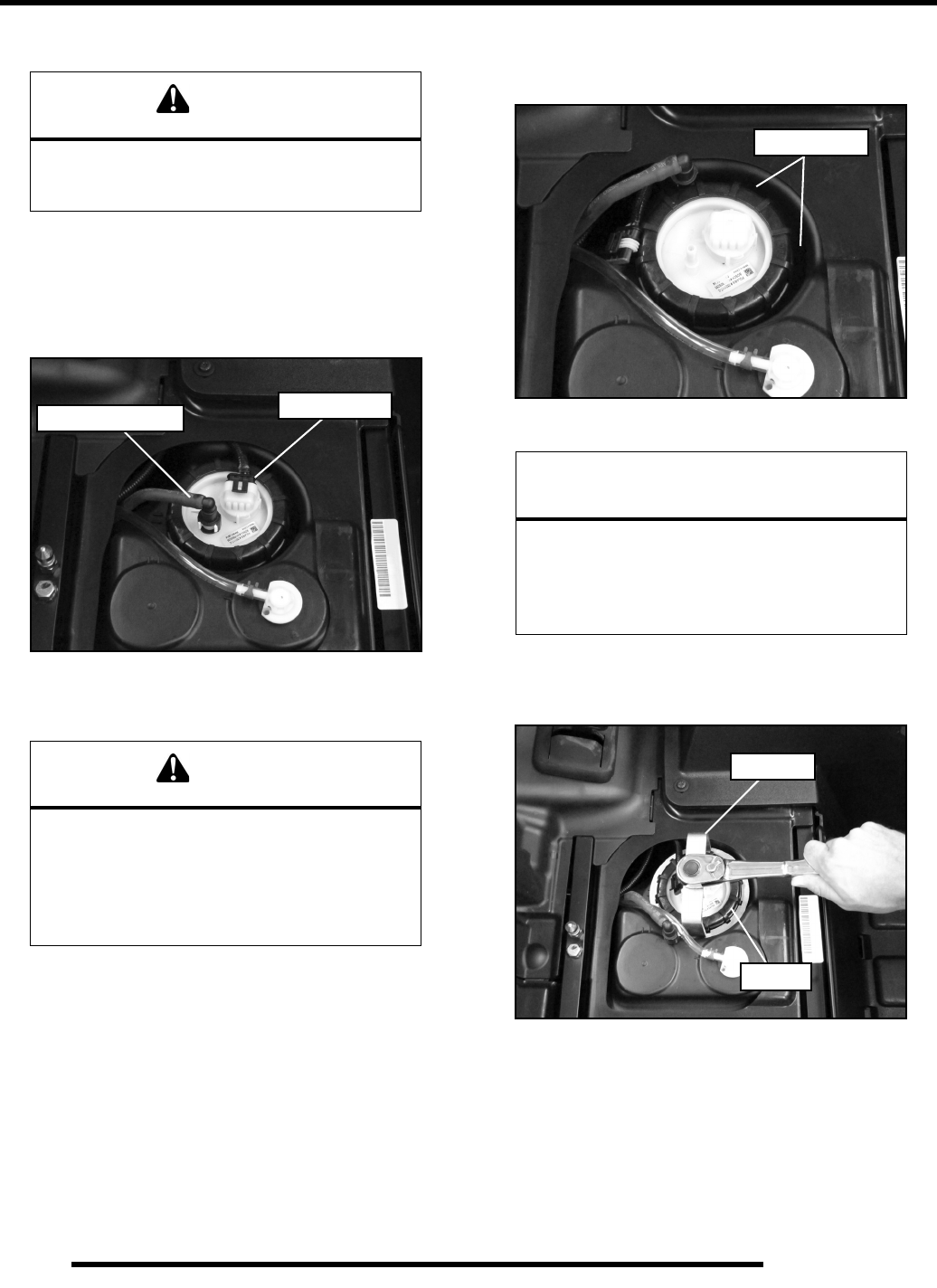
4.22
ELECTRONIC FUEL INJECTION
Fuel Pump Replacement
1. Remove the passenger seat to access the fuel pump.
2. Ensure that static has been discharged from you by
touching a ground source such as the engine or frame.
3. Disconnect the fuel pump electrical harness.
4. While holding a shop towel over the fuel line connector,
disconnect the quick connect fuel line from the fuel pump.
NOTE: A small amount of fuel may come out of the
fuel line or tank. Properly drain fuel into a suitable
container.
5. Be sure the top of the fuel tank is clean. If it requires
cleaning, hand wash the top of the tank to ensure no debris
will enter the fuel system when the fuel pump is removed.
6. Place the Fuel Pump Service Tool (PU-50326) over the fuel
pump PFA nut. Using a 1/2” drive ratchet or breaker bar,
loosen and remove the PFA nut. Discard the PFA nut.
NOTE: Apply downward force on the fuel pump
flange while removing the fuel pump PFA nut.
WARNING
Always wear safety goggles when working with
high pressure or flammable fluids. Failure to do
so could result in serious injury or complications.
CAUTION
It is possible for pressurized fuel to be present
when disconnecting the fuel line.
It is recommended to allow the vehicle to sit for
a period of one hour after shutting off the engine
before servicing the fuel pump. This allows the
exhaust to cool and fuel pressure to drop.
Pump Harness
Fuel Line Connector
CAUTION
Failure to clean area around fuel pump may lead
to debris entering the fuel tank during service.
Excessive debris in fuel tank may cause
premature wear of fuel pump and/or clogging
of internal fuel filters.
Clean this area
PFA Nut
PU-50326
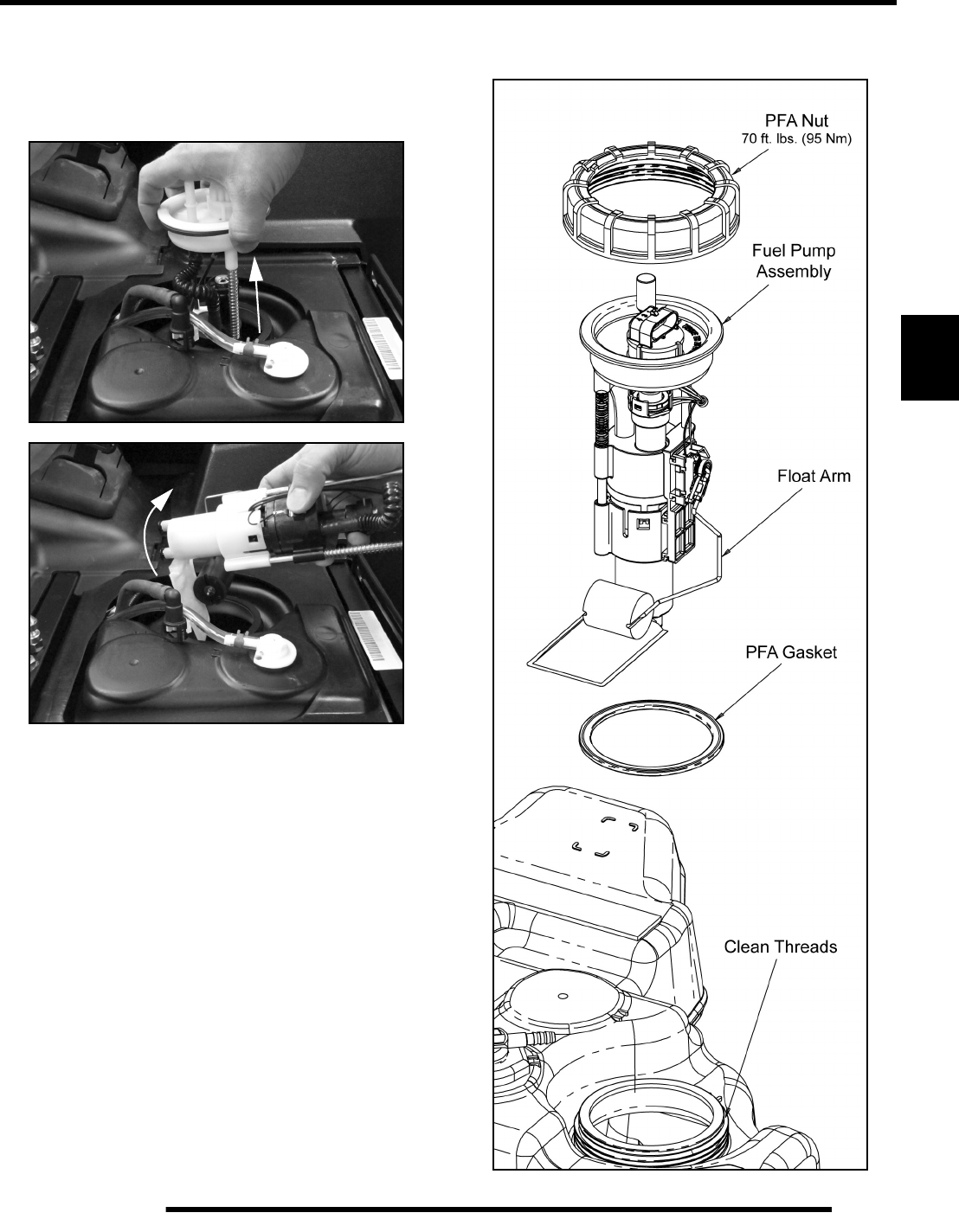
4.23
ELECTRONIC FUEL INJECTION
4
7. Carefully lift the fuel pump out of the fuel tank. As the fuel
pump assembly is being removed, be aware of float arm and
pump pre-filter. Hold the float arm to the pump body as you
lift and tilt the pump to ensure that the float arm is not bent
when removed from the tank.
8. Transfer old fuel pump to a suitable container capable of
safely holding fuel. The fuel pump will retain some fuel.
9. Inspect the inside of the fuel tank for debris (may require
flashlight and mirror). If debris like mud or sand is present,
fuel tank should be flushed and cleaned out prior to
installation of new fuel pump assembly.
IMPORTANT: It is recommended to remove the fuel
tank from the vehicle and rinse it with a small amount
of clean fuel. Do not use water or any other chemicals
to remove debris.
10. Remove new fuel pump assembly, gasket and PFA nut from
packaging. Use care not to bend float arm during un-
packaging. Do not lift or carry fuel pump assembly by the
float arm.
11. Use cleaning wipes provided to clean fuel tank surface and
threads. Remove all debris, grease and oil. Allow surfaces
to dry completely.
12. Install new PFA gasket onto fuel pump assembly using care
not to damage gasket or bend float arm.
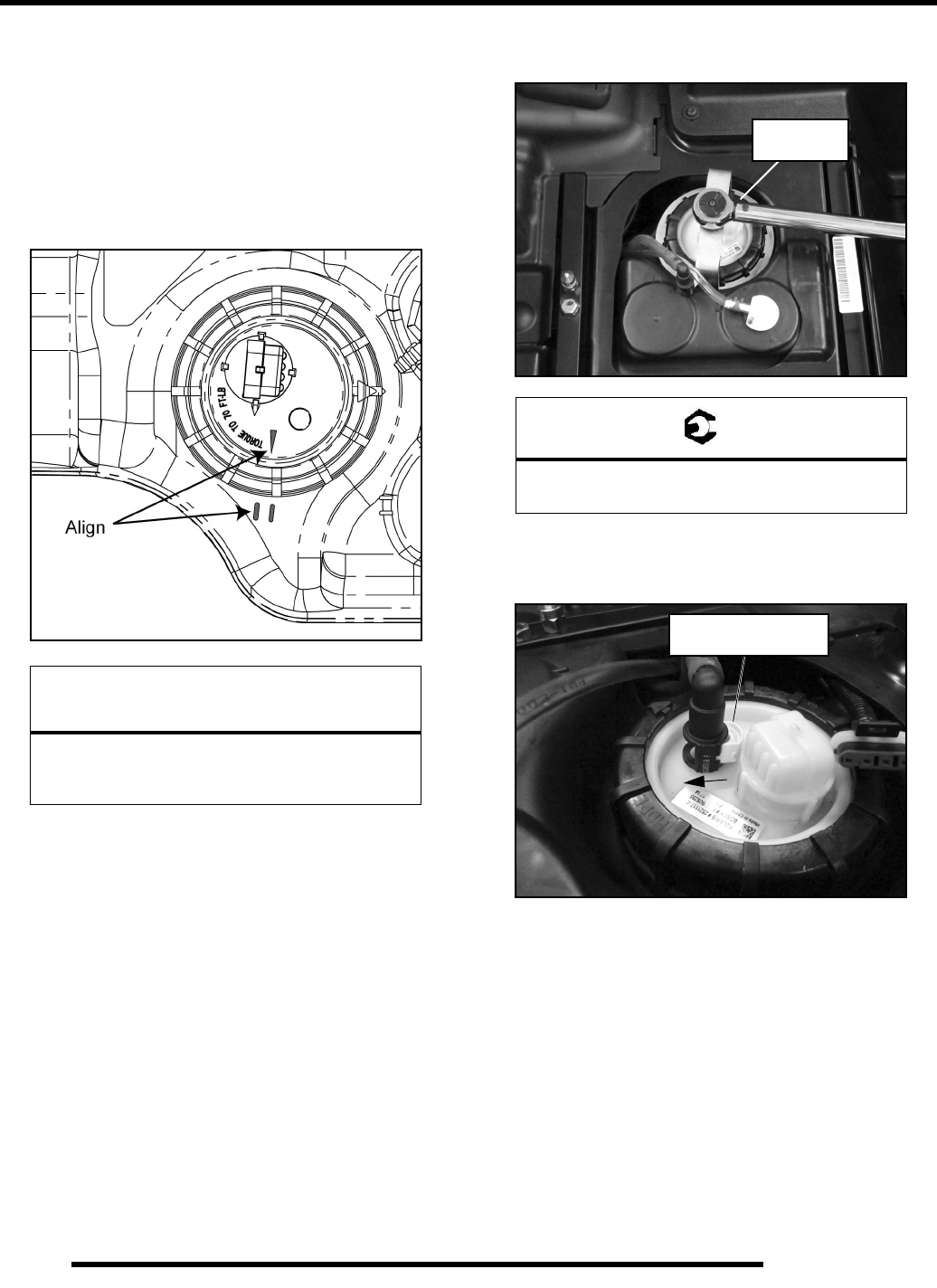
4.24
ELECTRONIC FUEL INJECTION
13. Install fuel pump into fuel tank, hold float arm to the pump
body and tilt assembly to ensure float arm does not get
caught or bent during installation.
14. Gently push down on fuel pump flange ensuring flange is
centered.
15. Roughly align orientation mark on fuel pump between the
orientation marks on fuel tank to ensure float arm does not
get bent or snagged.
16. While maintaining downward pressure, thread new PFA
nut onto fuel tank and hand tighten. Use care when starting
PFA nut, ensuring threads are properly aligned. Verify
orientation marks are still aligned between fuel pump and
fuel tank.
17. Torque PFA nut to specification using the Fuel Pump
Service Tool (PU-50326) and a calibrated torque wrench.
18. Verify alignment of fuel pump and tank orientation marks.
19. Connect the fuel line to the fuel pump outlet.
IMPORTANT: Be sure to engage the white retainer on
fuel line until it snaps into place. Pull on fuel line
lightly to confirm connection.
20. Connect the fuel pump electrical harness.
21. Install the passenger seat.
22. Test the fuel pump by turning on the key and listening for
the pump to activate. Cycle the key several times to prime
the system.
CAUTION
Failure to align the orientation marks may lead
to interferences with the fuel level float arm
and cause incorrect function.
= T
Fuel Pump PFA Nut:
70 ± 5 ft. lbs. (95 ± 7 Nm)
70 ± 5 ft. lbs.
(95 ± 7 Nm)
Press in white retainer
to engage the tabs
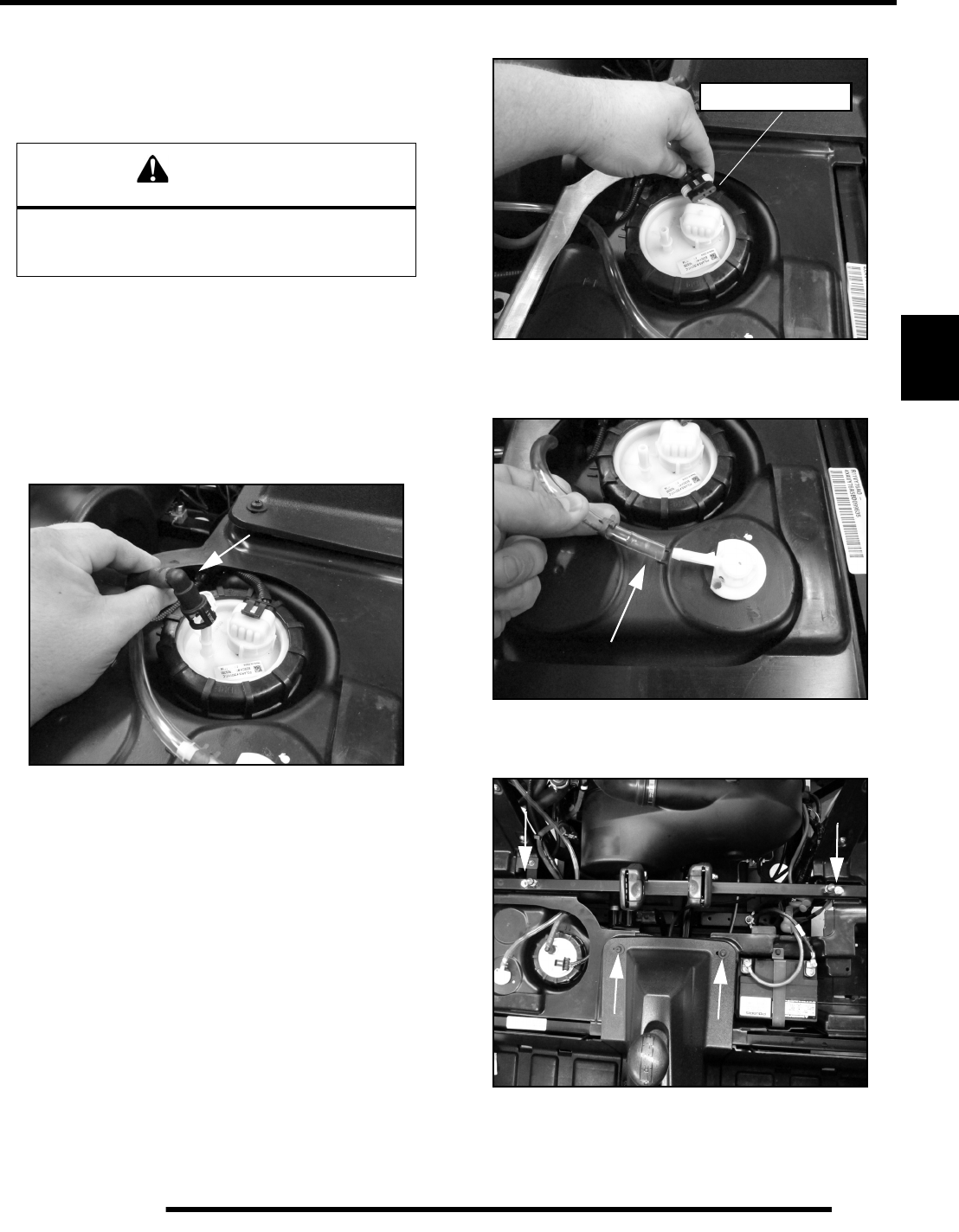
4.25
ELECTRONIC FUEL INJECTION
4
Fuel Tank Removal
IMPORTANT: Syphon as much fuel from the tank as
possible before attempting to remove it from the
vehicle.
1. Remove the driver and passenger seats along with the rear
service panel.
2. Disconnect the negative battery cable from the battery
located under the driver’s seat.
3. While holding a shop towel over the fuel line connector,
disconnect the quick connect fuel line from the fuel pump.
Move fuel line out of the way for tank removal.
NOTE: A small amount of fuel may come out of the
fuel line or tank. Properly drain fuel into a suitable
container.
4. Disconnect the fuel pump electrical harness.
5. Remove the fuel tank vent hose clamp with a suitable pliers.
Remove the vent line from the fuel tank vent fitting.
6. Remove the rear seat base assembly from the vehicle by
removing the (2) fasteners from the rear seat base.
7. Remove the shift knob and the center console from the
vehicle.
WARNING
Always wear safety goggles when working with
high pressure or flammable fluids. Failure to do so
could result in serious injury or complications.
Disconnect Here

4.26
ELECTRONIC FUEL INJECTION
8. Remove the push rivets and screws retaining the RH rocker
panel and remove panel from the vehicle (see Chapter 5).
9. Remove the lower bolt retaining the seat belt mechanism
near the rear RH portion of the fuel tank. Once removed,
place the mechanism in the rear cargo box to keep it out of
the way.
10. Remove the (3) Torx fasteners from the rear RH fender well
and remove the fender well from the vehicle (see chapter 5).
11. Remove the (3) shift lever support bracket bolts by and
place bracket out of the way of the fuel tank, but do not
remove or cut the plastic wire harness retainer.
12. Remove the (2) tank bracket fasteners that retain the fuel
tank in the chassis. Swing the tank fastener straps clear of
the fuel tank for removal.
Remove
RH Rocker Panel
12
3
Set Bracket by
Shift Lever
Do Not Cut
Plastic Strap
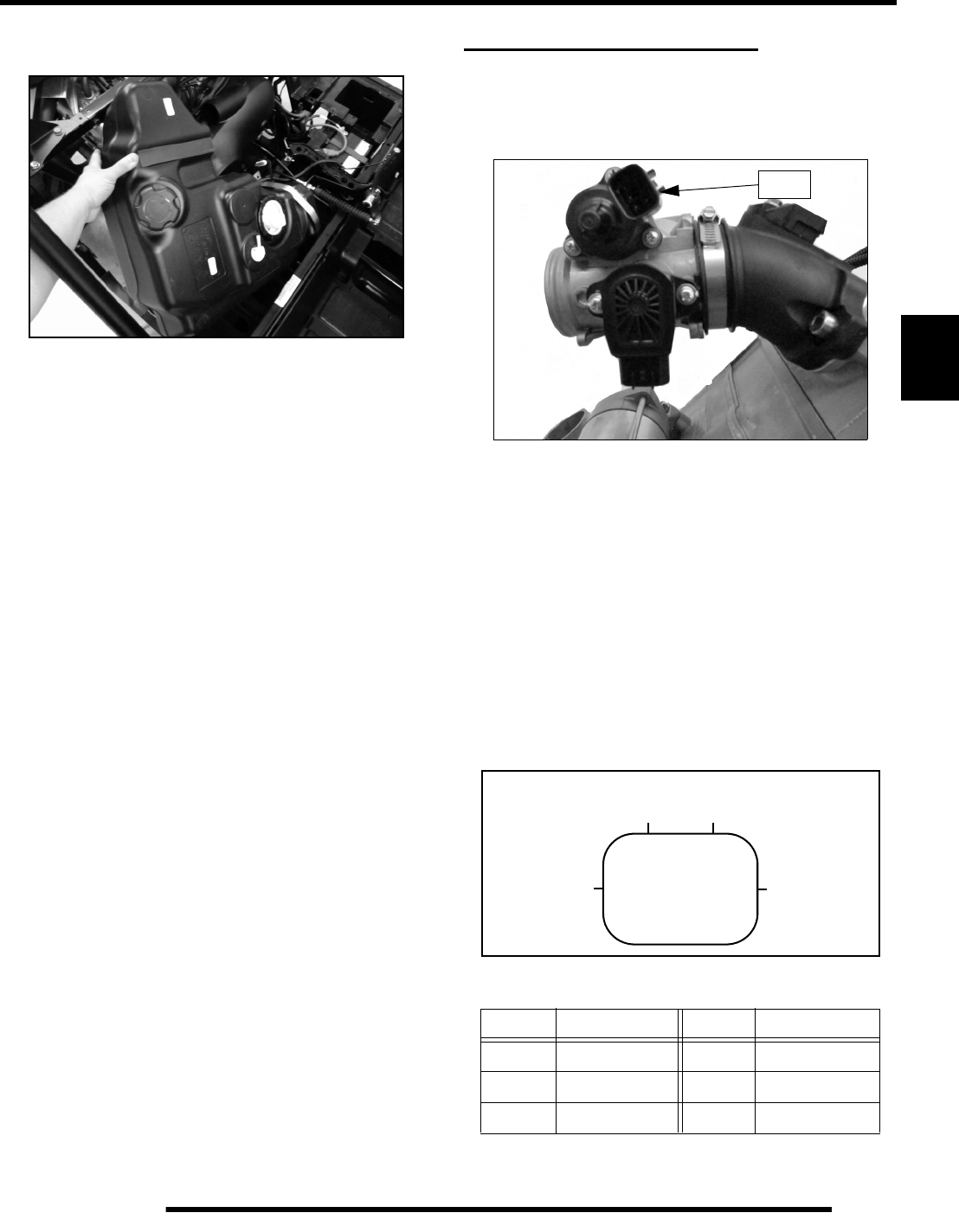
4.27
ELECTRONIC FUEL INJECTION
4
13. Lift the rear of the fuel tank up first and carefully pull it up
and out from the vehicle.
Fuel Tank Installation
1. Carefully reinstall the fuel tank assembly.
2. Reinstall the (2) fuel tank brackets and fasteners.
3. Reinstall the (3) shift lever support bracket fasteners.
4. Reinstall the rear RH fender well and secure with fasteners.
5. Reinstall the seat belt mechanism and secure the lower bolt
6. Reinstall the RH rocker panel and all previously removed
fasteners.
7. Reinstall the rear seat base assembly and secure with the (2)
fasteners
8. Reinstall the center console and shift knob.
9. Install the fuel line and vent hose and clamp; verify they are
secure.
10. Reconnect the fuel pump electrical harness.
11. Reconnect the negative battery cable. Test the fuel pump
by turning the ignition key on and listening for the pump
to activate. Check for leaks.
12. Finally, install the rear service panel along with the driver
and passenger seats.
IDLE AIR CONTROL (IAC)
Operation Overview
The Idle Air Control (IAC) is used to stabilize the idle quality of
the engine at cold start-up and after warm-up operations.
Mounted on the throttle body, the IAC contains 1 stepper motor
which receives varying voltage signal pulses from the ECU.
These pulses determine the IAC plunger setting, thereby
controlling the amount of air bypassing the closed throttle body
for idle control. If the IAC is disconnected or inoperative, it will
remain at it’s last operated position.
IAC Test
The IAC is a non-serviceable item. If it is faulty, it must be
replaced. It can be ‘bench tested’ using the following method:
Set your meter to read Ohms. Check the resistance values at each
of the following pin locations of the IAC. If any of the readings
are out of specification, replace the IAC.
IAC Resistance Readings
Pins Resistance Pins Resistance
1 - 2 30 ± 1.2 4 - 5 30 ± 1.2
2 - 3 30 ± 1.2 5 - 6 30 ± 1.2
1 - 3 60 ± 2.4 4 - 6 60 ± 2.4
IAC
123
456
IAC Valve Connector
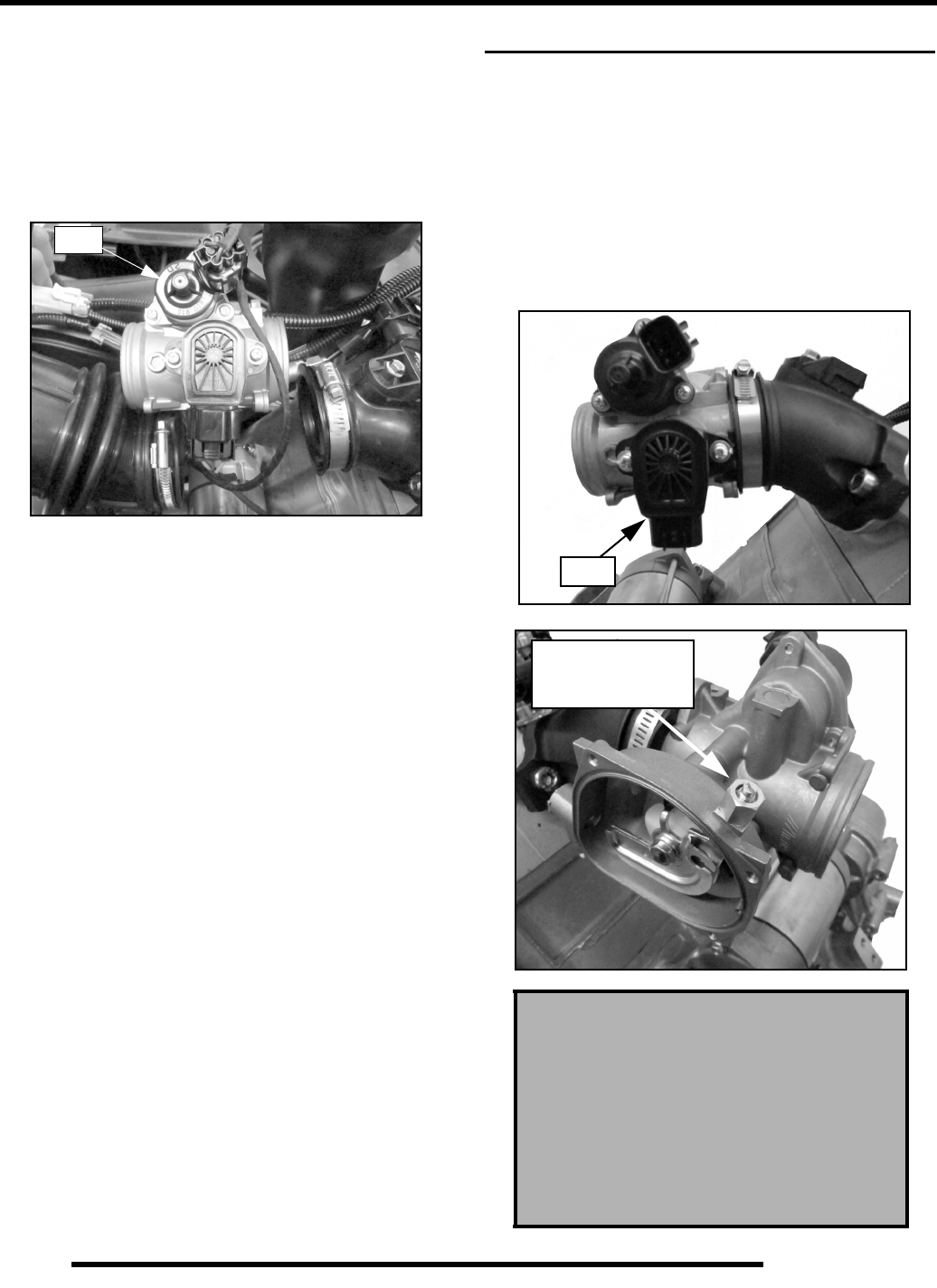
4.28
ELECTRONIC FUEL INJECTION
IAC Replacement
1. Remove the seats, rear main service panel and the rear
cargo box. (See chapter 5)
2. Loosen the hose clamps retaining the throttle body.
3. Remove the throttle body from the intake track and plug
intake boots with a clean shop towel.
4. Disconnect vehicle harness from IAC.
5. Remove the (3) Phillips-head mounting screws and remove
the IAC from the throttle body.
6. Install the new IAC and torque the mounting screws to 17.7
in. lbs. (2 ± 0.5 Nm).
7. Reconnect vehicle harness to IAC.
8. Reinstall the throttle body and securely tighten the hose
clamps.
9. Reinstall the rear cargo box, rear main service panel and
seats. (See chapter 5)
THROTTLE POSITION SENSOR (TPS)
Operation Overview
The throttle position sensor (TPS) is used to indicate throttle
plate angle to the ECU. Mounted on the throttle body and
operated directly off the end of the throttle shaft, the TPS works
like a rheostat, varying the voltage signal to the ECU in direct
correlation to the angle of the throttle plate. This signal is
processed by the ECU and compared to the internal pre-
programmed “maps” to determine the required fuel and ignition
settings for the amount of engine load.
IAC
The correct position of the throttle body stop
screw is established and set at the factory.
DO NOT loosen the throttle body stop screw
or alter its position in any manner. The stop
screw controls the air flow calibration of the
throttle body. If the stop screw is
repositioned or adjusted, the throttle body
assembly must be replaced.
TPS
Stop Screw
(Factory calibrated)
DO NOT ADJUST

4.29
ELECTRONIC FUEL INJECTION
4
TPS Resistance Tests
The TPS is a non-serviceable item. If it is faulty, it must be
replaced. It can be tested using the following method:
With the test leads connected and the meter set to the ohms scale,
observe the reading at the following pin locations of the TPS:
TPS Tester / Regulator
The TPS reading can be checked by using the Throttle Position
Sensor (TPS) Tester (2201519-A).
IMPORTANT: TPS Tester 2201519-A replaces the
existing TPS tester (PU-47082), which included the
4010264 regulator. If your dealership has PU-47082
and 4010264 you DO NOT need to order 2201519-A as
a replacement.
Set-up the TPS Tester Wire Harness (PU-47466) and TPS Tester
Regulator (547927) according to the instructions that
accompanied the tester. Make sure the 9 Volt battery is new.
TPS Resistance Readings
Pins Throttle Position Resistance
-GND -----
-Closed 4k - 5k(reference)
-Open 1.1k - 1.5k(reference)
------ 4k6k
123
TPS Connector

4.30
ELECTRONIC FUEL INJECTION
Verify TPS Tester Reference Voltage
A 5 volt reference voltage from the TPS Tester harness is
required for the TPS test to be accurate. Refer to the instructions
provided with the TPS Tester (2201519-A) or follow the bullet
point steps below to check reference voltage.
Reference Voltage Test:
• Insert black voltmeter probe into the test port as shown.
• Insert red voltmeter probe into the test port as shown
and verify the voltage reads 4.99-5.01 Vdc. If the
reading is low, replace the 9 volt battery.
IMPORTANT: Always use a fresh 9 Volt battery.
TPS Replacement
NOTE: The correct position of the TPS angle on the
throttle body is established and set at the factory. If
the TPS is replaced, repositioned or loosened it
must be recalibrated. Refer to the “TPS Adjustment”
procedure.
1. Remove the seats, rear main service panel and the rear
cargo box. (See chapter 5)
2. Loosen the hose clamps retaining the throttle body.
3. Remove the throttle body from the intake track and plug the
intake boots with a clean shop tow.
4. Disconnect the vehicle harness from the TPS.
5. Remove the (2) Phillips-head mounting screws and replace
the TPS.
IMPORTANT: If replacing the TPS or throttle body,
you must set the TPS voltage to specification using
the TPS Tester or Digital Wrench™ Sensor Data
Display.
NOTE: To allow better access to the TPS harness
connection, remove the exhaust pipe and exhaust
silencer.
6. If Digital Wrench™ in unavailable, assemble the TPS
Tester according to the instructions. Refer to “TPS Tester
/ Regulator” for proper set-up and testing. Verify the 9 volt
tester battery is new.
7. Plug the TPS Tester harness into the new TPS.
TPS Reference Voltage
5 Vdc Input
TPS

4.31
ELECTRONIC FUEL INJECTION
4
8. Set your voltmeter to read DC Volts. Insert the red and
black voltmeter probes into the test ports as shown.
9. Loosen the TPS mounting screws.
10. Rotate the TPS until your voltmeter reads within the
specification (see Figure 4-28).
11. Retighten the TPS mounting screws and torque to
specification.
12. Verify voltage reading did not change. If voltage reading
is now out of specification, repeat steps 2 - 4.
13. Reconnect vehicle harness to the TPS.
14. Reinstall the throttle body and securely tighten the hose
clamps.
15. Reinstall cargo box, rear main service cover and seats (see
Chapter 5).
TPS Output Reading
.650 - .750 Vdc
= T
TPS Mounting Screws:
17.7 in. lbs. (2 Nm)
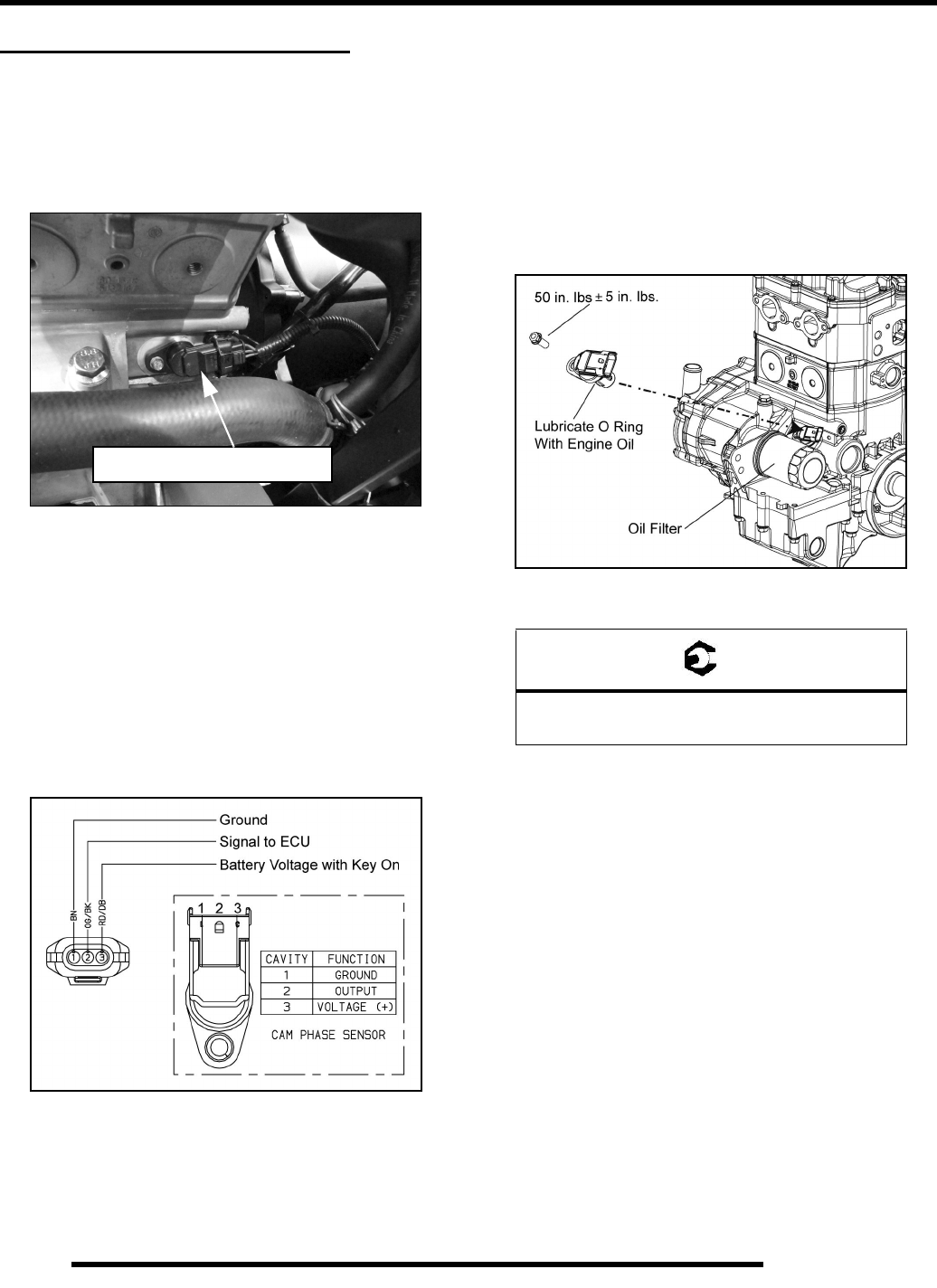
4.32
ELECTRONIC FUEL INJECTION
CAMSHAFT PHASE SENSOR
Operation Overview
Mounted on the engine crankcase, the Cam Phase Sensor
provides camshaft position information to the ECU to be used
along with the crankshaft position data to allow for sequential
fuel injection.
The Cam Phase Sensor provides camshaft position information
to the ECU to be used along with the crankshaft position data to
allow for sequential spark and ignition timing.
Cam Phase Sensor Test
The Cam Phase Sensor is a non-serviceable item. If it is faulty,
it must be replaced.
With the ignition key switch on, the sensor should have battery
voltage present on the Red / Dark Blue wire and ground present
on the Brown wire.
NOTE: Use Digital Wrench™ Diagnostic Software
(dealer only) if you suspect this sensor is faulty.
Cam Phase Sensor Replacement
1. Disconnect vehicle harness from the sensor.
2. Remove the retaining bolt and remove the sensor from the
engine.
3. Use a light coating of engine oil to lubricate the O-ring upon
installation of the new sensor.
4. Install the sensor by inserting it with a twisting motion to
allow it to properly seat.
5. Install the retaining bolt and torque to specification.
ECT
Camshaft Phase Sensor
= T
Cam Phase Sensor Retaining Bolt Torque:
50 ± 5 in. lbs. (5.65 ± .55 Nm)
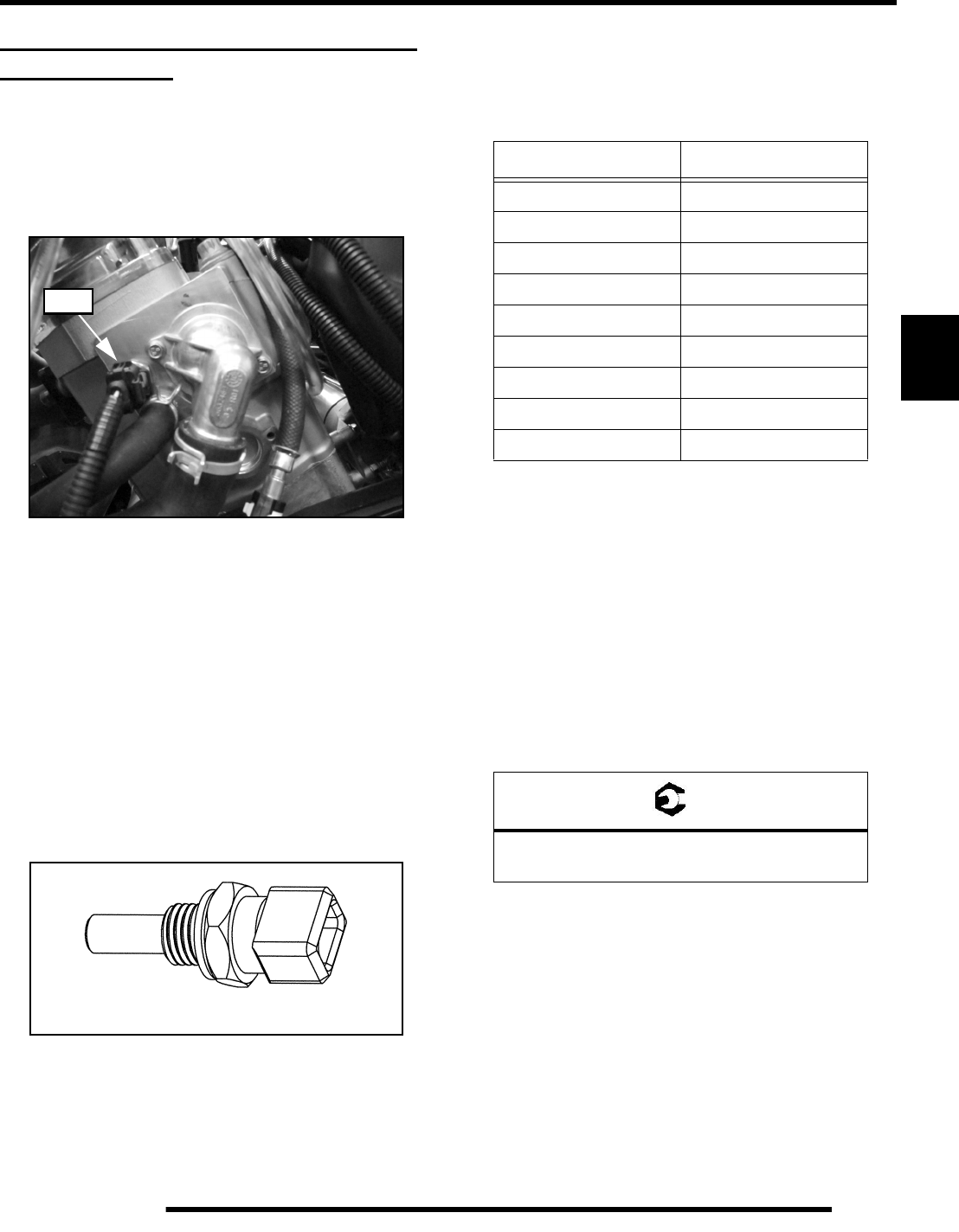
4.33
ELECTRONIC FUEL INJECTION
4
ENGINE COOLANT TEMPERATURE
SENSOR (ECT)
Operation Overview
Mounted on the cylinder head, the engine temperature sensor
measures coolant temperature. The engine temperature sensor is
a Negative Temperature Coefficient (NTC) type sensor, as the
temperature increases the resistance decreases.
Coolant passes through the cylinder and by the sensor probe,
varying a resistance reading which is relayed to the ECU. This
signal is processed by the ECU and compared to its
programming for determining the fuel and ignition
requirements during operation. The ECU also uses this signal to
determine when to activate the fan during operation.
ECT Sensor Test
To quickly rule out other components and wiring related to the
ECT, disconnect the harness from the ECT sensor and start the
engine. After a few seconds, the fan should turn on and the
“Check Engine” indicator should display on the instrument
cluster. This indicates all other components are working
properly.
Refer to Chapter 10 for additional ECT sensor information.
Polaris dealers can test the sensor by using the Digital Wrench™
Diagnostic Software (dealer only).
ECT Sensor Replacement
1. Remove the driver and passenger seats.
2. Remove the rear service panel to access the ECT sensor.
3. Drain coolant to level below sensor.
4. Disconnect sensor from engine harness.
5. Using a wrench, remove and replace the sensor, applying
a light coating of thread sealant to aid installation.
6. Torque the sensor to 17 ft. lbs. (23 Nm).
7. Add the required amount of coolant and properly bleed the
cooling system (see Chapter 3).
ECT
ECT Sensor
ECT Sensor Resistance Readings
Temperature F (C) Resistance
68 F (20 C) 2.5 k ± 6%
86 F (30 C) 1.7 k ± 6%
104 F (40 C) 1.2 k ± 6%
122 F (50 C) 834 ± 6%
140 F (60 C) 596 ± 6%
158 F (70 C) 435 ± 6%
176 F (80 C) 323 ± 6%
194 F (90 C) 243 ± 6%
212 F (100 C) 186 ± 6%
= T
ECT Retaining Bolt Torque:
17 ft. lbs. (23 Nm)

4.34
ELECTRONIC FUEL INJECTION
IGNITION COIL
Operation Overview
The ignition coil is used to provide high voltage to fire the spark
plugs. When the ignition key is on, DC voltage is present in
primary side of the ignition coil windings. During engine
rotation, an AC pulse is created within the crankshaft position
sensor for each passing tooth on the flywheel. The two-tooth gap
creates an “interrupt” input signal, corresponding to specific
crankshaft position. This signal serves as a reference for the
control of ignition timing. The ECU then calculates the time
interval between the consecutive pulses, and determines when
to trigger the voltage spike that induces the voltage from the
primary to the secondary coil windings to fire the spark plugs.
Ignition Coil / HT Lead Replacement
1. Remove the driver and passenger seats.
2. Remove the rear service panel to access the ignition coil.
3. Disconnect the ignition coil harness and remove the high
tension leads from the coil.
4. Remove the fastener retaining the ignition coil and remove
it from the vehicle. If replacing the high tension lead(s),
remove the other end of the lead(s) from the spark plug.
5. Install the new ignition coil and/or high tension lead(s).
NOTE: Be sure to mark / note which ignition coil
wire goes to which cylinder and ignition coil post.
The engine will misfire if the spark plug wires are
installed incorrectly. The spark plug wires are
marked PTO and MAG and should be installed to the
corresponding cylinder spark plug and coil post.
Ignition Coil Tests
The ignition coil can be tested by using an ohm meter. Use the
following illustration and specification table to test the ignition
coil.
Primary Test
Secondary Test
= T
Ignition Coil Retaining Bolt Torque:
75 in. lbs. (8.5 Nm)
Ignition CoilIgnition Coil
Ignition Coil Resistance Readings
Test Pin Connection Resistance
Primary Between 1 & 2
Between 2 & 3 0.4
Secondary Between High Tension
Lead End Caps
(Red end caps on coil end)
6.6 k
Measure Between
Connector Pins
0.4
Measure Between End Caps
6.6k

4.35
ELECTRONIC FUEL INJECTION
4
EFI DIAGNOSTICS
Instrument Cluster Trouble Code Display
NOTE: The diagnostic mode is accessible only
when the check engine MIL has been activated.
Use the following procedure to display diagnostic trouble codes
that were activated during current ignition cycle causing the
MIL to illuminate. Diagnostic trouble codes will remain stored
in the gauge (even if MIL turns off) until the key is turned off.
NOTE: If there is a diagnostic problem with the
power steering system, the power steering MIL will
illuminate and blink in place of the check engine MIL.
1. If the trouble code(s) are not displayed, use the MODE
button to toggle until “CK ENG” displays on the
information display area.
2. Press and hold the MODE button to enter the diagnostics
code menu.
3. A set of three numbers will appear in the information area.
• The first number (located far left) can range from 0 to 9.
This number represents the total number of trouble code
present (example: 2 means there are 3 codes present).
• The second number (located top right) can be 2 to 6
digits in length. This number equates to the suspected
area of fault (SPN).
• The third number (located bottom right) can be 1 to 2
digits in length. This number equates to the fault mode
(FMI).
4. If more than one code exists, press the MODE button to
advance to the next trouble code.
5. To exit the diagnostic mode, press and hold the MODE
button or turn the ignition key OFF once the codes are
recorded.
DIAGNOSTIC TROUBLE CODE TABLE
Component Condition SPN FMI Digital Wrench™
P-Code
Throttle Position Sensor (TPS)
Voltage Too High
51
3 P0123
Voltage Too Low 4 P0122
Vehicle Speed Signal
Data Erratic or Intermittent (or missing)
84
2 P0503
Received Vehicle Speed Has Error 19 C1069
Manifold Absolute Pressure Sensor
(T-MAP)
Voltage Too High
102
3 P0108
Voltage Too Low 4 P0107
Intake Air Temperature (T-MAP)
Voltage Too High
105
3 P0113
Voltage Too Low 4 P0112
Engine Temperature Sensor (ECT)
Voltage Too High
110
3 P0118
Voltage Too Low 4 P0117
Temperature Too High 16 P0217
Engine Overheat Shutdown 0 P1217

4.36
ELECTRONIC FUEL INJECTION
System Power
(Battery Potential / Power Input)
Voltage Too High
168
3
P0563
C1063
Voltage Too Low 4
P0562
C1064
Engine Speed (This is applicable
when the EPS module gets the
engine speed from the ECM)
Received Engine Speed Has Error 190 19 C1066
Gear Sensor Signal Voltage Too Low 523 4 P0916
ECU Memory EEPROM: Read/Write Failure 628 12 C1073
Crankshaft Position Sensor (CPS) Plausibility Fault 636 2 P0335
Camshaft Phase Sensor Circuit Fault 637 8 P0340
Injector 1 (MAG)
Driver Circuit Open / Grounded
651
5 P0261
Driver Circuit Short to B+ 3 P0262
Driver Circuit Grounded 4 P1262
Injector 2 (PTO)
Driver Circuit Open / Grounded
652
5 P0264
Driver Circuit Short to B+ 3 P0265
Driver Circuit Grounded 4 P1265
Rear Differential Output
Driver Circuit Open / Grounded
746
5 P1691
Driver Circuit Short to B+ 3 P1692
Driver Circuit Grounded 4 P1693
Fan Relay Driver Circuit
Driver Circuit Open / Grounded
1071
5 P1481
Driver Circuit Short to B+ 3 P1482
Driver Circuit Grounded 4 P1483
Ignition Coil Primary Driver 1 (MAG) Driver Circuit Short to B+ 1268 3 P1353
Ignition Coil Primary Driver 2 (PTO) Driver Circuit Short to B+ 1269 3 P1354
Fuel Pump Driver Circuit
Driver Circuit Open / Grounded
1347
5 P0230
Driver Circuit Short to B+ 3 P0232
Driver Circuit Grounded 4 P0231
ECU Output Supply Voltage 1
Voltage Too High
3597
3 P16A2
Voltage Too Low 4 P16A1
ECU Output Supply Voltage 2
Voltage Too High
3598
3 P16A9
Voltage Too Low 4 P16A8
All Wheel Drive Control Circuit
(AWD)
Driver Circuit Open / Grounded
520207
5 P1836
Driver Circuit Short to B+ 3 P1835
Driver Circuit Grounded 4 P1834
Steering Over Current Shut Down Current Above Normal or Grounded 520221 6 C1050
Steering Excessive Current Error Current Above Normal or Grounded 520222 6 C1051
Steering Torque Partial Failure Condition Exists 520223 31 C1052
DIAGNOSTIC TROUBLE CODE TABLE
Component Condition SPN FMI Digital Wrench™
P-Code

4.37
ELECTRONIC FUEL INJECTION
4
Steering Torque Full Failure Condition Exists 520224 31 C1053
EPS Inverter Temperature
Greater than 110° C (230° F)
520225
16 C1054
Greater than 120° C (248° F)0 C1055
EPS CAN Communications
Receive Error No RX Message for 2 Seconds 520226 2 U0100
EPS CAN Communications
Transmit Error No TX Message for 2 Seconds 520227 2 U1100
Position Encoder Error Position Encoder Error 520228 11 C1065
EPS Software Error Software Error 520229 12 C1070
IC CAN Communication with EPS EPS Off Line (EPS DM1 not seen) 520230 31 U0131
Idle Air Control Valve (IAC)
M17; IAC Stepper Pin 1
Driver Circuit Open / Grounded
520267
5 P1505
Driver Circuit Short to B+ 3 P1509
Driver Circuit Grounded 4 P1508
Idle Air Control Valve (IAC)
M17; IAC Stepper Pin 3
Driver Circuit Open / Grounded
520268
5 P1515
Driver Circuit Short to B+ 3 P1519
Driver Circuit Grounded 4 P1518
Idle Air Control Valve (IAC)
M17; IAC Stepper Pin 4
Driver Circuit Open / Grounded
520269
5 P1525
Driver Circuit Short to B+ 3 P1529
Driver Circuit Grounded 4 P1528
Idle Air Control Valve (IAC)
M17; IAC Stepper Pin 6
Driver Circuit Open / Grounded
520270
5 P1535
Driver Circuit Short to B+ 3 P1539
Driver Circuit Grounded 4 P1538
DIAGNOSTIC TROUBLE CODE TABLE
Component Condition SPN FMI Digital Wrench™
P-Code

4.38
ELECTRONIC FUEL INJECTION
EFI Troubleshooting
Fuel Starvation / Lean Mixture
Symptoms: Hard start or no start, bog, backfire, popping
through intake / exhaust, hesitation, detonation, low power,
spark plug erosion, engine runs hot, surging, high idle, idle
speed erratic.
• No fuel in tank
• Restricted tank vent, or routed improperly
• Fuel lines or fuel injectors restricted
• Fuel filter plugged
• Fuel pump inoperative
• Air leak in system
• Intake air leak (throttle shaft, intake ducts, airbox or air
cleaner cover)
• Incorrect throttle stop screw adjustment
Rich Mixture
Symptoms: Fouls spark plugs, black, sooty exhaust smoke,
rough idle, poor fuel economy, engine runs rough/ misses, poor
performance, bog, engine loads up, backfire.
• Air intake restricted (inspect intake duct)
• Air filter dirty/plugged
• Poor fuel quality (old fuel)
• Fouled spark plug
• TPS setting incorrect
• Injector failure
Poor Idle
Symptom: Idle Too High (If greater than 1300 RPM when
engine is warm).
• Throttle stop screw set incorrect
• Throttle cable sticking, improperly adjusted, routed
incorrectly
Symptom: Idle Too Low (if less than 900 RPM when engine is
warm).
• Plugged air filter
• Leaking injector (rich condition)
• Belt dragging
• Throttle stop screw tampering
Symptom: Erratic Idle.
• Throttle cable incorrectly adjusted
• Air Leaks, dirty injector
• TPS damaged or adjusted
• Tight valves
• Ignition timing incorrect
• Belt dragging
• Dirty air cleaner
•Engine worn
• Spark Plug fouled
• Throttle stop screw set incorrectly (out of sync with
ECU)

4.39
ELECTRONIC FUEL INJECTION
4
DIGITAL WRENCH™ OPERATION
Digital Wrench™ Diagnostic Software Overview
IMPORTANT: Refer to Section 2, 3 and 4 in the Instruction Manual provided in the Digital Wrench™ Diagnostic
Kit to install the Polaris Digital Wrench™ diagnostic software on your computer.
The Digital Wrench™ diagnostic software allows the technician to perform the following tests and observations:
• View or clear trouble codes
• Analyze real-time engine data
• Reflash ECU calibration files
• Perform guided diagnostic procedures
• Create customer service account records
• Perform output state control tests (on some models)
Special Tools (also refer to page 4.2)
Diagnostic Software Version
Always use the most current version of the Digital Wrench™
software to ensure you have the latest updates or enhancements.
New reprogramming files and guided diagnostic procedures are
added to these updates as they become available. For
information on how to determine if you have the latest update
available, refer to “Digital Wrench™ Version and Update ID”.
ECU Replacement
Although the need for ECU replacement is unlikely, a specific
replacement procedure is required to ensure that all essential
data contained within the original ECU is transferred to the
replacement ECU.
Refer to procedure and carefully follow all instructions provided
in Digital Wrench™.
Guided Diagnostic Available
Guided diagnostics are available within Digital Wrench™ for
all supported Trouble Codes (that is, any fault that will turn on
the ‘Check Engine’ indicator).
In addition, guided diagnostics are also available for many other
electrical sub systems.
Diagnostic procedures are added to subsequent versions of
Digital Wrench™ as they become available. Check your release
version often and upgrade when available to be sure you are
using the most current software available.
Digital Wrench™ Communication Errors
If you experience problems connecting to a vehicle or any
Digital Wrench™ related problem, visit the Digital Wrench™
Knowledge Base for the most current troubleshooting
information, FAQs, downloads and software updates at:
http://polaris.diagsys.com/.
DIGITAL WRENCH™ DIAGNOSTIC SOFTWARE PART NUMBER
Digital Wrench™ Diagnostic Kit PU-47063-A
PU-47063-A (listed above) INCLUDES:
Digital Wrench™ Software: PU-48731
Standard Interface Cable: PU-47151
SmartLink Module Kit: PU-47471
Fuel Pressure Gauge Kit PU-43506-A
Fuel Pressure Gauge Adapter PV-48656
Fluke 73 Digital Multi-Meter or Fluke 77 DMM PV-48656 (Fluke 77: PV-43568)
Laptop or Desktop Computer
USB/Serial Adaptor: Saelig RS-232
Commercially Available (refer to diagnostic software user
manual or HELP section for minimum requirements)
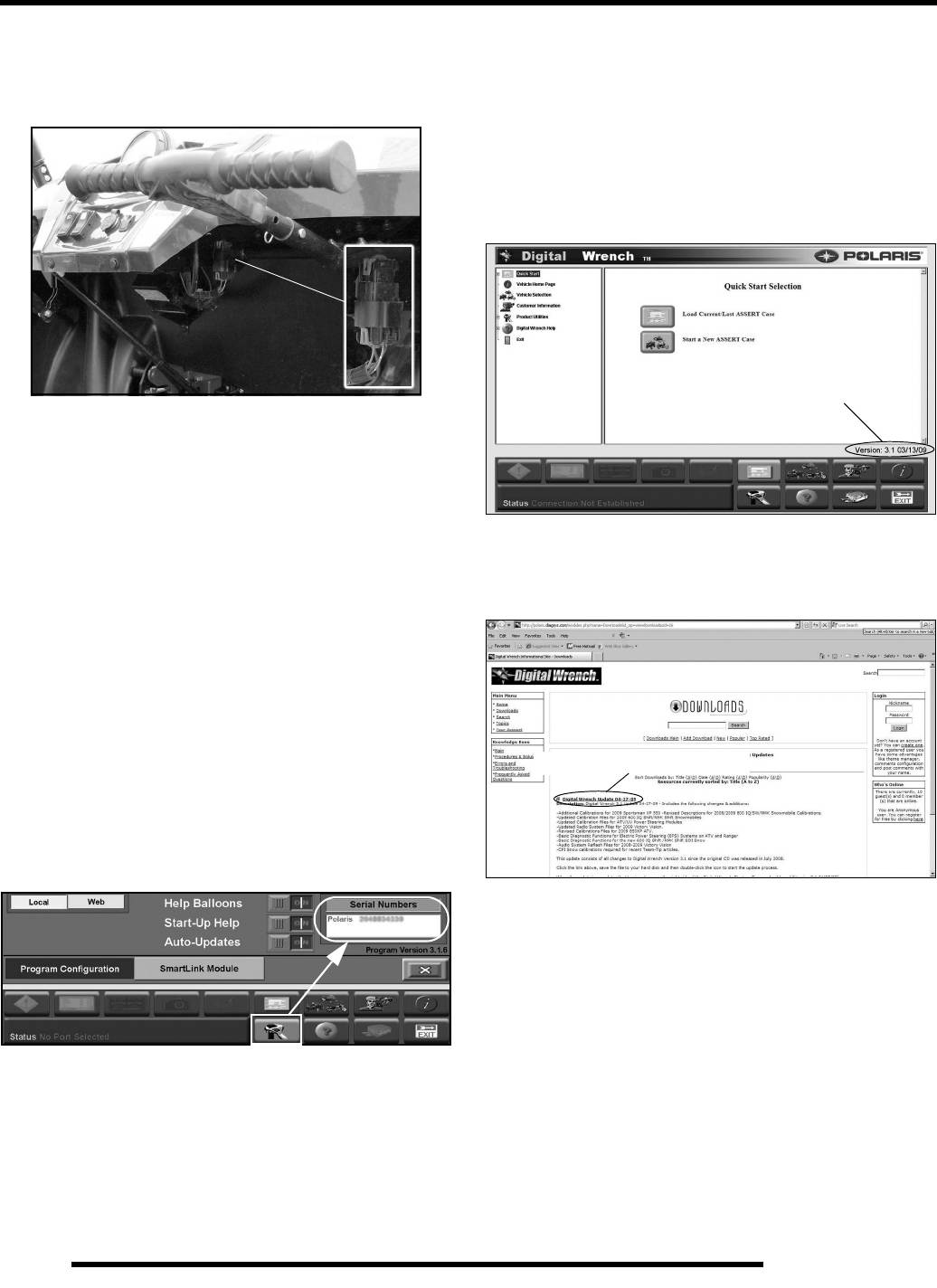
4.40
ELECTRONIC FUEL INJECTION
Digital Wrench™ - Diagnostic Connector
The diagnostic connector is located under the dash and is
accessible from the passenger side.
Follow these steps to connect the diagnostic interface cable to
the vehicle to allow Digital Wrench™ use:
1. Assemble the SmartLink Module and attach the PC
Interface Cable to your laptop (see page 4.3).
2. Remove the protective cap from the Digital Wrench™
connector.
3. Connect the Vehicle Interface Cable to the Digital
Wrench™ diagnostic connector.
4. Turn the ignition key to the ‘ON’ position, select the
appropriate vehicle and wait for the status to display
‘Connected’ in the lower left corner of the screen.
5. Once connected, proceed with using Digital Wrench™.
Digital Wrench™ Serial Number Location
Open the configuration screen by clicking on the wrench icon.
The serial number is located on the right side of the screen.
Digital Wrench™ Version and Update ID
Knowing what Digital Wrench™ version and update is installed
will help determine which updates are required.
NOTE: Versions and updates are subject to change.
1. Open the Digital Wrench™ software. Locate the version
ID shown on the lower right side of the Digital Wrench™
start-up screen.
2. In this case, the version number is 3.1 with a 03/13/09
update. Proceed to http://polaris.diagsys.com to see if a
newer update is available.
3. In this case, a newer update (04-27-09) is available and
should be downloaded before using Digital Wrench™ (see
“Digital Wrench™ Updates”).
IMPORTANT: Always operate with the latest update.
Version: 3.1 03/13/09
Digital Wrench Update 04-27-09

4.41
ELECTRONIC FUEL INJECTION
4
Digital Wrench™ Updates
Updates are released for Digital Wrench™ via the Internet at:
http://polaris.diagsys.com. The Digital Wrench™ website can
also be accessed through the dealer website at:
www.polarisdealers.com.
NOTE: Only authorized Polaris dealers and
distributors can access the dealer website.
1. Log on to www.polarisdealers.com.
2. Locate the “Service and Warranty” drop-down menu.
3. Click on “Digital Wrench Updates”.
4. The Digital Wrench™ portal website should appear in a
new web browser.
5. Click on “Digital Wrench Version 3.1 Updates”.
IMPORTANT: You must already have version 3.1
installed before adding these updates. They will not
install if you have version 3.0 or older on your PC.
6. If the update file date listed is newer than your current
version and update (see “Digital Wrench™ Version and
Update ID”), download the file.
7. Click on the link shown above, save the file to your hard
disk and then double-click the icon to start the update
process.
NOTE: Do not "run" or "open" the file from where
they are. Select "save" and download them to your
PC before running the install.
8. When the update is complete, the version shown on the
right side of the Digital Wrench™ start-up screen should
match the update you just downloaded.
NOTE: Versions and updates are subject to change.
Digital Wrench Update 04-27-09
Version: 3.1 04/27/09
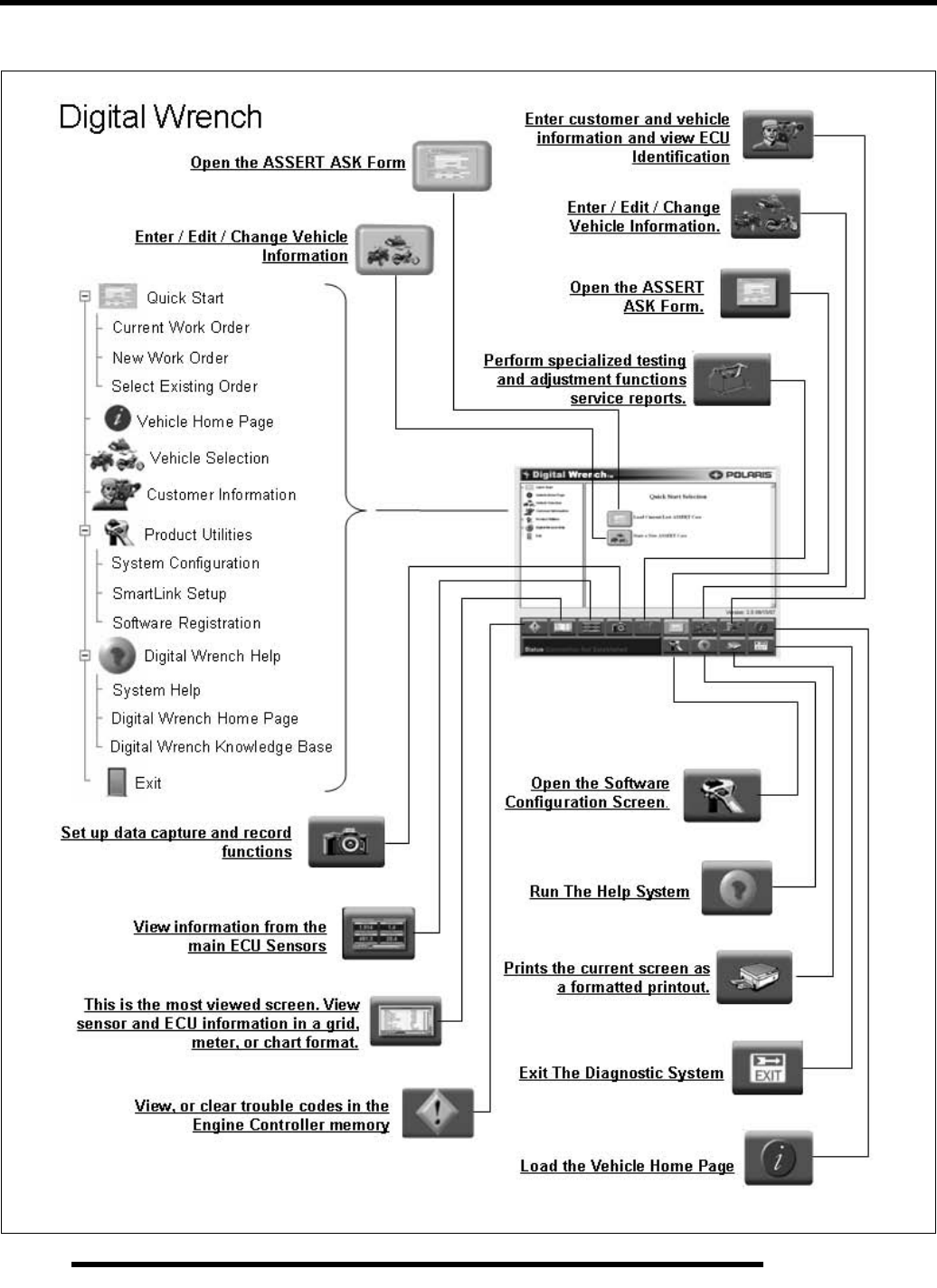
4.42
ELECTRONIC FUEL INJECTION
Digital Wrench™ Feature Map
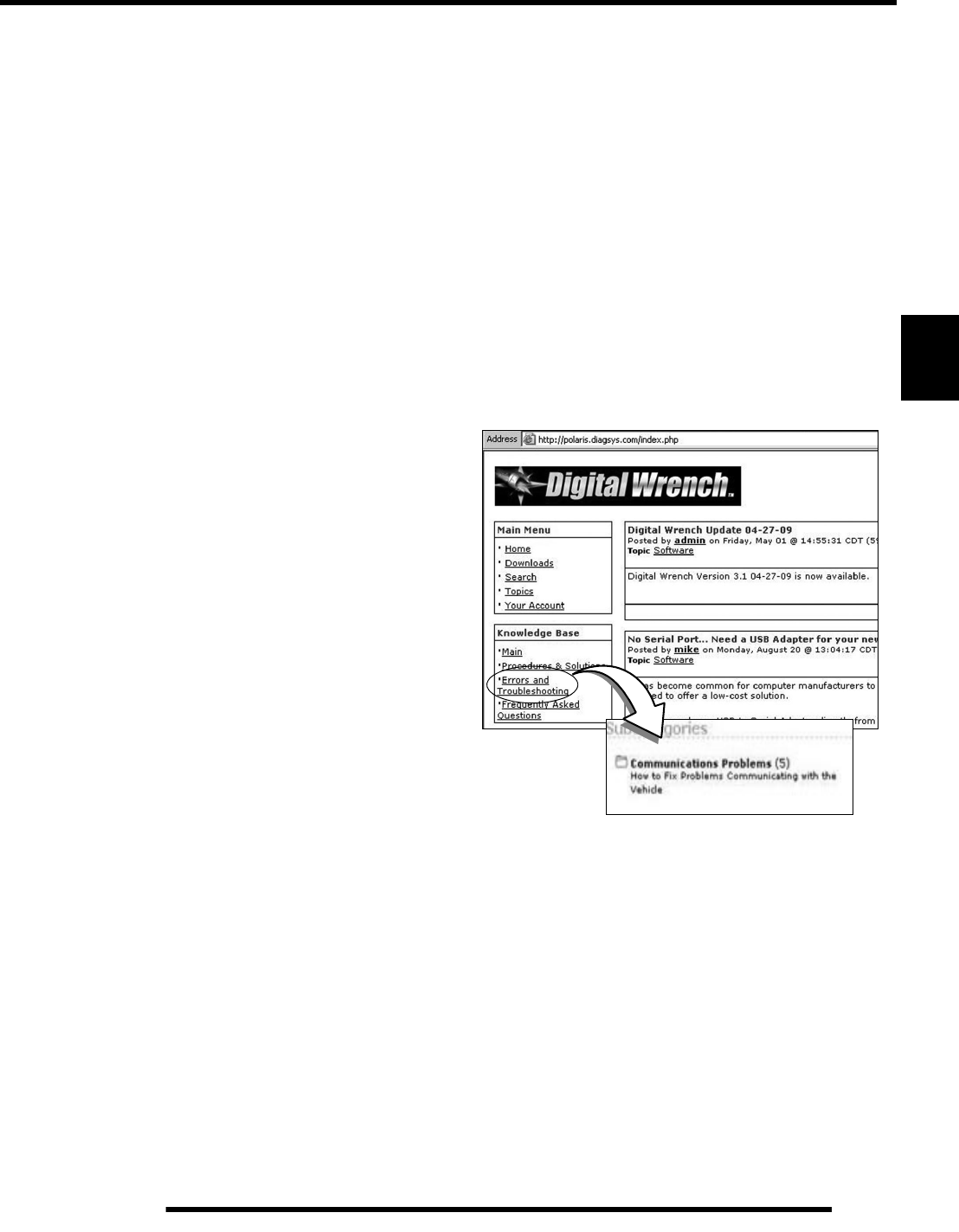
4.43
ELECTRONIC FUEL INJECTION
4
Engine Controller Reprogramming (Reflash)
Process Overview
The reprogramming feature is in the Special Tests menu on the
Digital Wrench™ screen. Start Digital Wrench™ and click on
the Special Tests menu icon (red tool box). A technician should
be familiar with the process and with computer operation in
general before attempting to reprogram an ECU.
The Digital Wrench™ Engine Controller Reprogramming (or
“Reflash”) feature allows reprogramming of the ECU fuel and
ignition map. To successfully reprogram the ECU, an
Authorization Key must be obtained by entering a Request Code
in the box provided on the Reflash Authorization site. The
Request Code is automatically generated by Digital Wrench™
during the reprogramming process. The Reflash Authorization
site is located under the “Service and Warranty” drop down
menu on the dealer website at: www.polarisdealers.com.
IMPORTANT: Failure to follow the reprogramming
instructions completely and correctly can result in an
engine that does not run! Replacement ECUs are
programmed as “no-start” and require a reflash for
them to work.
Reprogramming (Reflash) Tips:
• BATTERY VOLTAGE: The majority of problems with
reprogramming can be attributed to a low battery. Be
sure the battery voltage (no load) is at least 13 volts and
at least 12.5 volts with the key ‘ON’. Connect a battery
charger if necessary to bring voltage level above
minimum. Fully charge the battery before you attempt
to reprogram.
• DEDICATED LAPTOP: Best results are obtained using
a laptop computer that is “dedicated to Digital
Wrench™”. A laptop that is used by a variety of people
and in several applications around the dealership is
more likely to cause a reprogramming problem than one
dedicated to Digital Wrench™ diagnostics only.
• OBTAINING THE LATEST UPDATE:
Reprogramming updates are provided periodically and
contain the most recent calibrations (see “Digital
Wrench™ Updates”).
• CLOSE NON-ESSENTIAL PROGRAMS: Polaris
recommends that you DO NOT install non-essential
programs on a Service Department laptop. Camera
detection software, Virus Scanners, Tool Bars, etc. may
clog up memory if running in the background and make
it harder for the diagnostic software to operate.
• KNOW THE PROCESS: If you are not familiar with
the entire reprogramming process, review the HELP
section of the diagnostic software before you attempt
reprogramming. Click on the ? on the tool bar or press
F11. The information in the on-line help is the most
current and complete information available. This
should be your first step until you are familiar with the
process.
• COMMUNICATION PROBLEMS: If you have had
problems communicating with a vehicle while
performing diagnostic functions, do not attempt
reprogramming until the cause has been identified and
fixed. Check all connections, and be sure battery
voltage is as specified.
Proceed to http://polaris.diagsys.com for specific
information and FAQs on how to troubleshoot
communication problems.
• DON’T DISTURB THE PC: While reprogramming is
in progress, don’t move the mouse and don’t touch the
keyboard. The process only takes a few minutes, and is
best left alone until complete.
Reprogramming (Reflash) Procedure:
If you are not familiar with the reprogramming process, review
the “Reprogramming (Reflash) Tips” before you begin. Follow
the on-screen instructions as you progress through the steps. If
you encounter a problem, always check the On-Line help for
current tips and information.
1. Verify the most current update has been downloaded and
loaded into Digital Wrench™. See “Digital Wrench™
Version and Update ID” on page 4.40.

4.44
ELECTRONIC FUEL INJECTION
2. Connect the SmartLink Module cables to the PC and
vehicle. See “Digital Wrench™ - Diagnostic Connector”
on page 4.40.
3. Open the Digital Wrench™ program.
4. Select the model year, product line and vehicle description
by selecting the “Change Vehicle Type” icon.
5. Select the “Special Tests” icon.
6. Select “Engine Controller Reprogramming”.
7. Select the file you want to load into the ECU then click the
“Continue” icon to proceed to the Integrity Check.
8. Follow the on screen instructions and connect a 9V battery
to the reflash battery connector located off the main
diagnostic connector. Click the “Continue” icon to obtain
a Request Code.

4.45
ELECTRONIC FUEL INJECTION
4
9. Copy (CTRL+C) the Request Code that will be required on
the dealer website in the next step. DO NOT CLOSE
Digital Wrench™ or the Request Code will be invalid.
NOTE: All characters are letters; there are no numbers
in a request code.
NOTE: Request Codes and Authorization Keys must
be entered EXACTLY as they appear on the screen.
10. Go to www.polarisdealers.com and click on “ReFlash
Authorization” from the “Service and Warranty” drop-
down menu.
11. Enter or paste (CTRL+V) the Request Code into the box.
12. Select the same file type from the list that you selected
previously while in Digital Wrench™. Enter the VIN along
with the customer’s name and address. When completed,
click the Authorize button once to proceed.
13. An “Authorization Key” will appear in the upper left corner
of the screen. Copy (CTRL+C) this key exactly as it
appears.
14. Enter or paste (CTRL+C) the Authorization Key in the box
located on the Digital Wrench™ screen. Click the
‘Continue’ button and follow instructions provided on the
screen to complete the reprogramming procedure.
Copy Request Code to
obtain Authorization Key
Authorization Key goes here after
obtained from the dealer website
“Reflash Authorization”
“Service and Warranty”
Enter the
“Request Code”
Enter ALL the information and
click on the “Authorize” button
“Authorization Key”
Enter the
“Authorization Key”
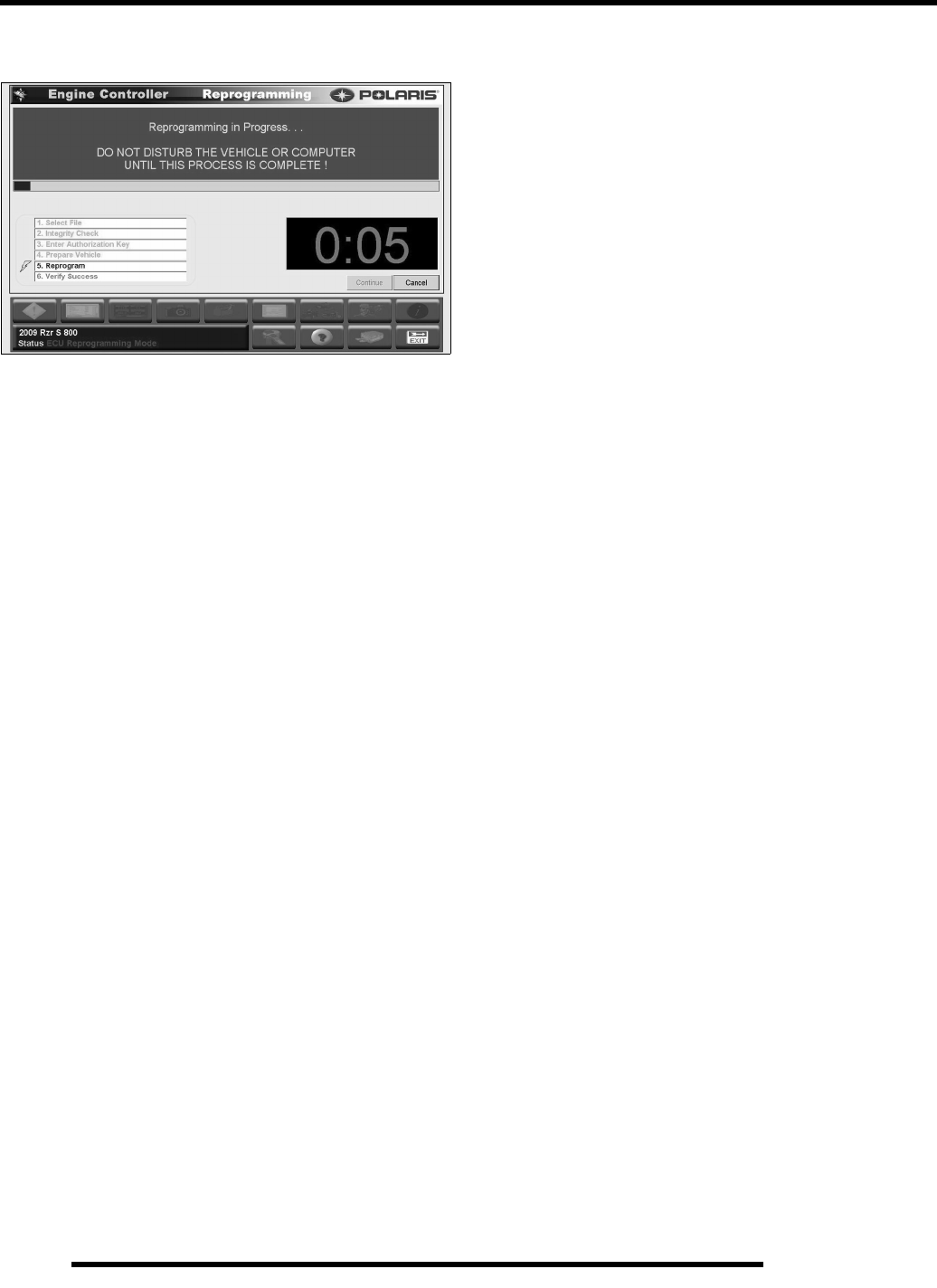
4.46
ELECTRONIC FUEL INJECTION
15. At this point the reflash process will begin. Do not touch
the vehicle or PC during the process.
16. Once the ECU reprogramming procedure is complete, click
the ‘Finish’ button on the screen. Verify the reflash was a
success by starting the vehicle.
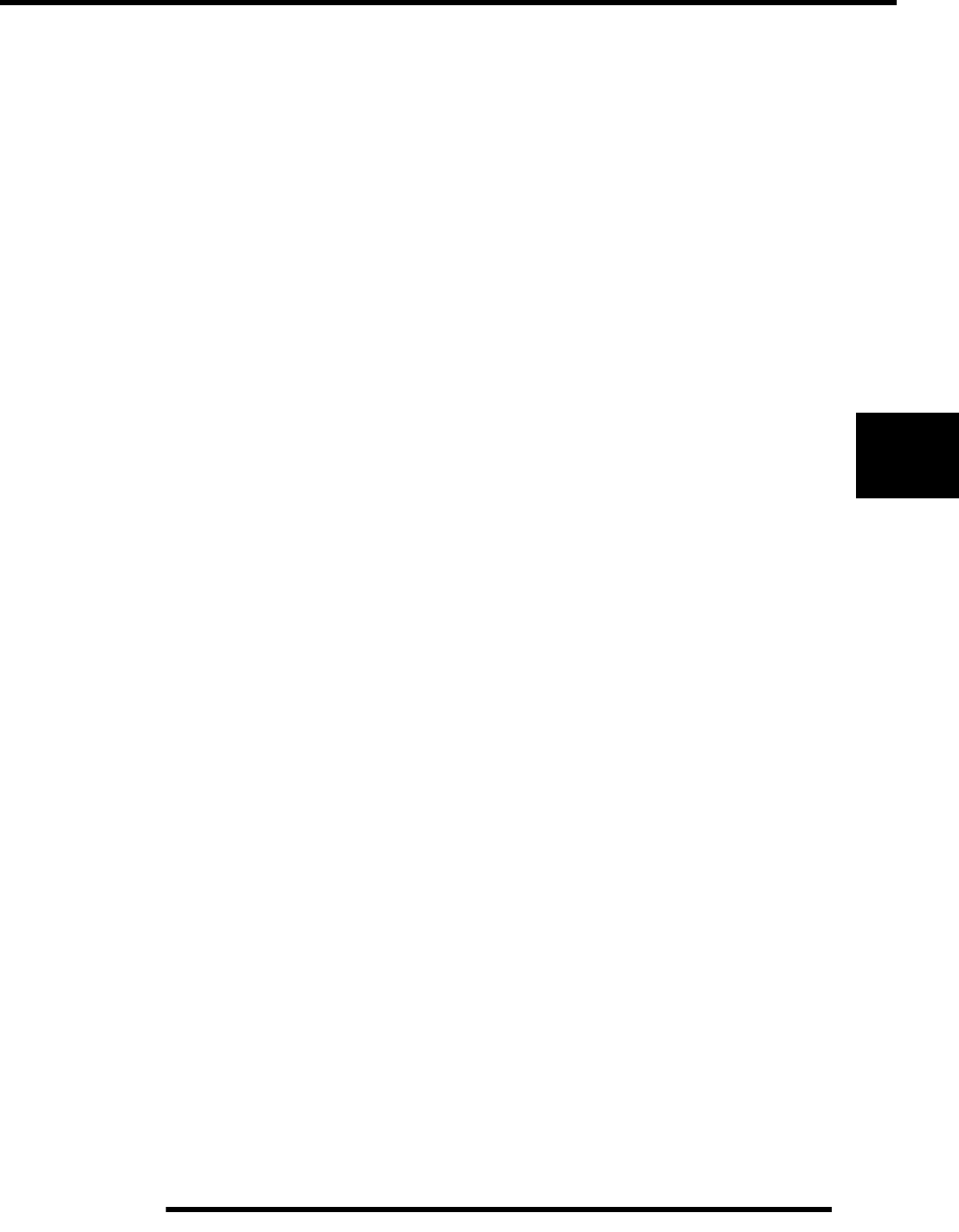
BODY / STEERING / SUSPENSION
5.1
CHAPTER 5
BODY / STEERING / SUSPENSION
5
TORQUE SPECIFICATIONS. . . . . . . . . . . . . . . . . . . . . . . . . . . . . . . . . . . . . . . . . . . . . . . 5.2
SPECIAL TOOLS . . . . . . . . . . . . . . . . . . . . . . . . . . . . . . . . . . . . . . . . . . . . . . . . . . . . . . . 5.2
CAB FRAME . . . . . . . . . . . . . . . . . . . . . . . . . . . . . . . . . . . . . . . . . . . . . . . . . . . . . . . . . . . 5.3
BODY EXPLODED VIEWS . . . . . . . . . . . . . . . . . . . . . . . . . . . . . . . . . . . . . . . . . . . . . . . . 5.4
HOOD / FRONT BODY WORK . . . . . . . . . . . . . . . . . . . . . . . . . . . . . . . . . . . . . . . . . . . . 5.4
FRONT BUMPER . . . . . . . . . . . . . . . . . . . . . . . . . . . . . . . . . . . . . . . . . . . . . . . . . . . . . . . 5.5
REAR BUMPER . . . . . . . . . . . . . . . . . . . . . . . . . . . . . . . . . . . . . . . . . . . . . . . . . . . . . . . . 5.5
SEAT ASSEMBLY . . . . . . . . . . . . . . . . . . . . . . . . . . . . . . . . . . . . . . . . . . . . . . . . . . . . . . 5.6
SEAT BELTS / MOUNTING . . . . . . . . . . . . . . . . . . . . . . . . . . . . . . . . . . . . . . . . . . . . . . . 5.6
FLOOR / ROCKER PANELS . . . . . . . . . . . . . . . . . . . . . . . . . . . . . . . . . . . . . . . . . . . . . . 5.7
REAR CARGO BOX / FENDERS. . . . . . . . . . . . . . . . . . . . . . . . . . . . . . . . . . . . . . . . . . . 5.8
CHASSIS / MAIN FRAME. . . . . . . . . . . . . . . . . . . . . . . . . . . . . . . . . . . . . . . . . . . . . . . . . 5.9
BODY COMPONENT REMOVAL . . . . . . . . . . . . . . . . . . . . . . . . . . . . . . . . . . . . . . . . . . 5.10
SEATS . . . . . . . . . . . . . . . . . . . . . . . . . . . . . . . . . . . . . . . . . . . . . . . . . . . . . . . . . . . . . .5.10
REAR SERVICE PANEL . . . . . . . . . . . . . . . . . . . . . . . . . . . . . . . . . . . . . . . . . . . . . . . . 5.10
FRONT BUMPER . . . . . . . . . . . . . . . . . . . . . . . . . . . . . . . . . . . . . . . . . . . . . . . . . . . . . . 5.10
REAR BUMPER . . . . . . . . . . . . . . . . . . . . . . . . . . . . . . . . . . . . . . . . . . . . . . . . . . . . . . . 5.10
HOOD AND FRONT BODY WORK . . . . . . . . . . . . . . . . . . . . . . . . . . . . . . . . . . . . . . . . 5.11
REAR FENDER, FLAIR AND TIE DOWN REMOVAL . . . . . . . . . . . . . . . . . . . . . . . . . . 5.12
CARGO BOX ASSEMBLY REMOVAL . . . . . . . . . . . . . . . . . . . . . . . . . . . . . . . . . . . . . . 5.12
ROCKER PANELS, CONSOLE AND FLOOR . . . . . . . . . . . . . . . . . . . . . . . . . . . . . . . . 5.13
STEERING ASSEMBLY . . . . . . . . . . . . . . . . . . . . . . . . . . . . . . . . . . . . . . . . . . . . . . . . . 5.14
EXPLODED VIEW . . . . . . . . . . . . . . . . . . . . . . . . . . . . . . . . . . . . . . . . . . . . . . . . . . . . . 5.14
STEERING WHEEL REMOVAL . . . . . . . . . . . . . . . . . . . . . . . . . . . . . . . . . . . . . . . . . . . 5.15
STEERING SHAFT REMOVAL . . . . . . . . . . . . . . . . . . . . . . . . . . . . . . . . . . . . . . . . . . . 5.15
STEERING SHAFT BEARING REPLACEMENT . . . . . . . . . . . . . . . . . . . . . . . . . . . . . . 5.15
FRONT A-ARMS . . . . . . . . . . . . . . . . . . . . . . . . . . . . . . . . . . . . . . . . . . . . . . . . . . . . . . . 5.16
REMOVAL / REPLACEMENT . . . . . . . . . . . . . . . . . . . . . . . . . . . . . . . . . . . . . . . . . . . . 5.16
EXPLODED VIEW . . . . . . . . . . . . . . . . . . . . . . . . . . . . . . . . . . . . . . . . . . . . . . . . . . . . . 5.17
BALL JOINT SERVICE . . . . . . . . . . . . . . . . . . . . . . . . . . . . . . . . . . . . . . . . . . . . . . . . . . 5.18
REMOVAL . . . . . . . . . . . . . . . . . . . . . . . . . . . . . . . . . . . . . . . . . . . . . . . . . . . . . . . . . . . 5.18
INSTALLATION . . . . . . . . . . . . . . . . . . . . . . . . . . . . . . . . . . . . . . . . . . . . . . . . . . . . . . . 5.19
REAR A-ARMS . . . . . . . . . . . . . . . . . . . . . . . . . . . . . . . . . . . . . . . . . . . . . . . . . . . . . . . . 5.19
REMOVAL . . . . . . . . . . . . . . . . . . . . . . . . . . . . . . . . . . . . . . . . . . . . . . . . . . . . . . . . . . . 5.19
INSTALLATION . . . . . . . . . . . . . . . . . . . . . . . . . . . . . . . . . . . . . . . . . . . . . . . . . . . . . . . 5.21
EXPLODED VIEW . . . . . . . . . . . . . . . . . . . . . . . . . . . . . . . . . . . . . . . . . . . . . . . . . . . . . 5.21
REAR STABILIZER BAR. . . . . . . . . . . . . . . . . . . . . . . . . . . . . . . . . . . . . . . . . . . . . . . . . 5.22
REMOVAL / INSTALLATION . . . . . . . . . . . . . . . . . . . . . . . . . . . . . . . . . . . . . . . . . . . . . 5.22
DECAL REPLACEMENT. . . . . . . . . . . . . . . . . . . . . . . . . . . . . . . . . . . . . . . . . . . . . . . . . 5.23
SHOCKS / SPRINGS / FASTENERS . . . . . . . . . . . . . . . . . . . . . . . . . . . . . . . . . . . . . . . 5.24
EXPLODED VIEW . . . . . . . . . . . . . . . . . . . . . . . . . . . . . . . . . . . . . . . . . . . . . . . . . . . . . 5.24
SHOCK REMOVAL / INSTALLATION . . . . . . . . . . . . . . . . . . . . . . . . . . . . . . . . . . . . . . 5.24
SHOCK REPLACEMENT . . . . . . . . . . . . . . . . . . . . . . . . . . . . . . . . . . . . . . . . . . . . . . . . 5.24
FOX™ SHOCK EXPLODED VIEWS. . . . . . . . . . . . . . . . . . . . . . . . . . . . . . . . . . . . . . . . 5.25
FOX™ SHOCK SERVICE . . . . . . . . . . . . . . . . . . . . . . . . . . . . . . . . . . . . . . . . . . . . . . . . 5.26
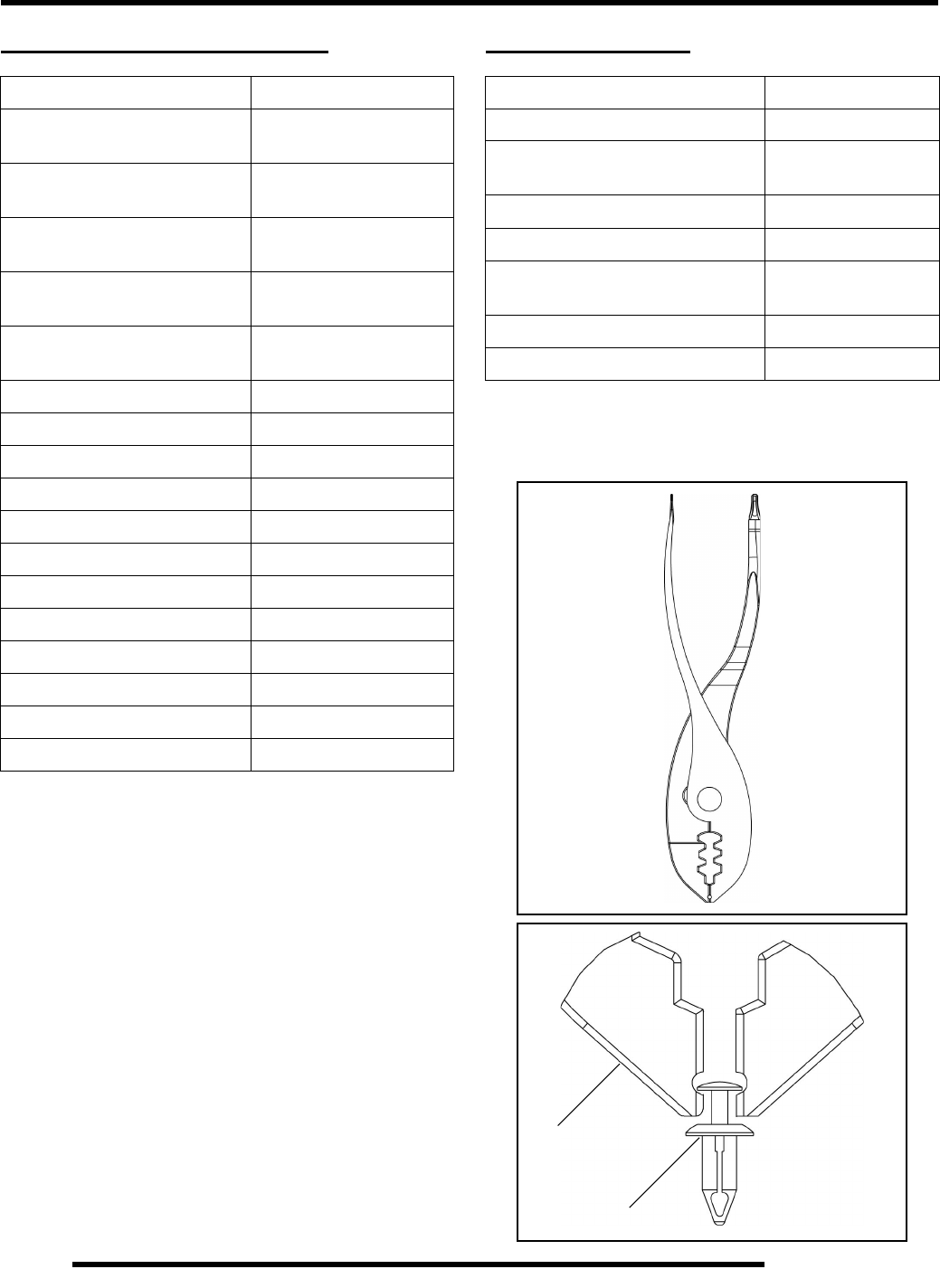
5.2
BODY / STEERING / SUSPENSION
TORQUE SPECIFICATIONS SPECIAL TOOLS
Multi-Function Pliers
Included in the tool kit, the multi-function pliers is designed to
remove the plastic push rivets used to fasten body components.
ITEM TORQUE VALUE
Front LH/RH Upper / Lower
A-Arm Bolt 40 ft. lbs. (54 Nm)
Rear LH/RH Upper / Lower
A-Arm Bolt 40 ft. lbs. (54 Nm)
Lower LH/RH
Rear Bearing Carrier 40 ft. lbs. (54 Nm)
Upper LH/RH
Rear Bearing Carrier 40 ft. lbs. (54 Nm)
Outer Tie Rod to
Bearing Carrier Housing 42.5 ft. lbs. (58 Nm)
Front Ball Joint Pinch Bolts 22.5 ft. lbs. (30.5 Nm)
Shock Mounting Bolts 30 ft. lbs. (41 Nm)
Wheel Hub Castle Nuts 80 ft. lbs. (108 Nm)
Wheel Nuts (Steel Rims) 35 ft. lbs. (47 Nm)
Tie Rod End Jam Nut 13 ft. lbs. (18 Nm)
Seat Belt to Seat Base 40 ft. lbs. (54 Nm)
Tilt Shock Upper Fastener 7 ft. lbs. (10 Nm)
Tilt Shock Lower Fastener 12 ft. lbs. (16 Nm)
Steering Pivot Tube Fasteners 23 ft. lbs. (31 Nm)
Steering Wheel to Shaft 28 ft. lbs. (38 Nm)
Lower Steering Shaft to Box 30 ft. lbs. (41 Nm)
Steering Gear Box 17 ft. lbs. (23 Nm)
TOOL DESCRIPTION PART NUMBER
Gas Shock Recharging Kit 2200421
Shock Shaft Seal Protector
.625" Diameter 2201640
IFP Tool PS-45908
Shock Spanner Wrench 2871095
Shock Spanner Wrench
(Walker Evans and Fox Shocks) 2870803
Shock Spring Compressor Tool 2870623
Multi-Function Pliers 2876389
Pliers
Push Rivet
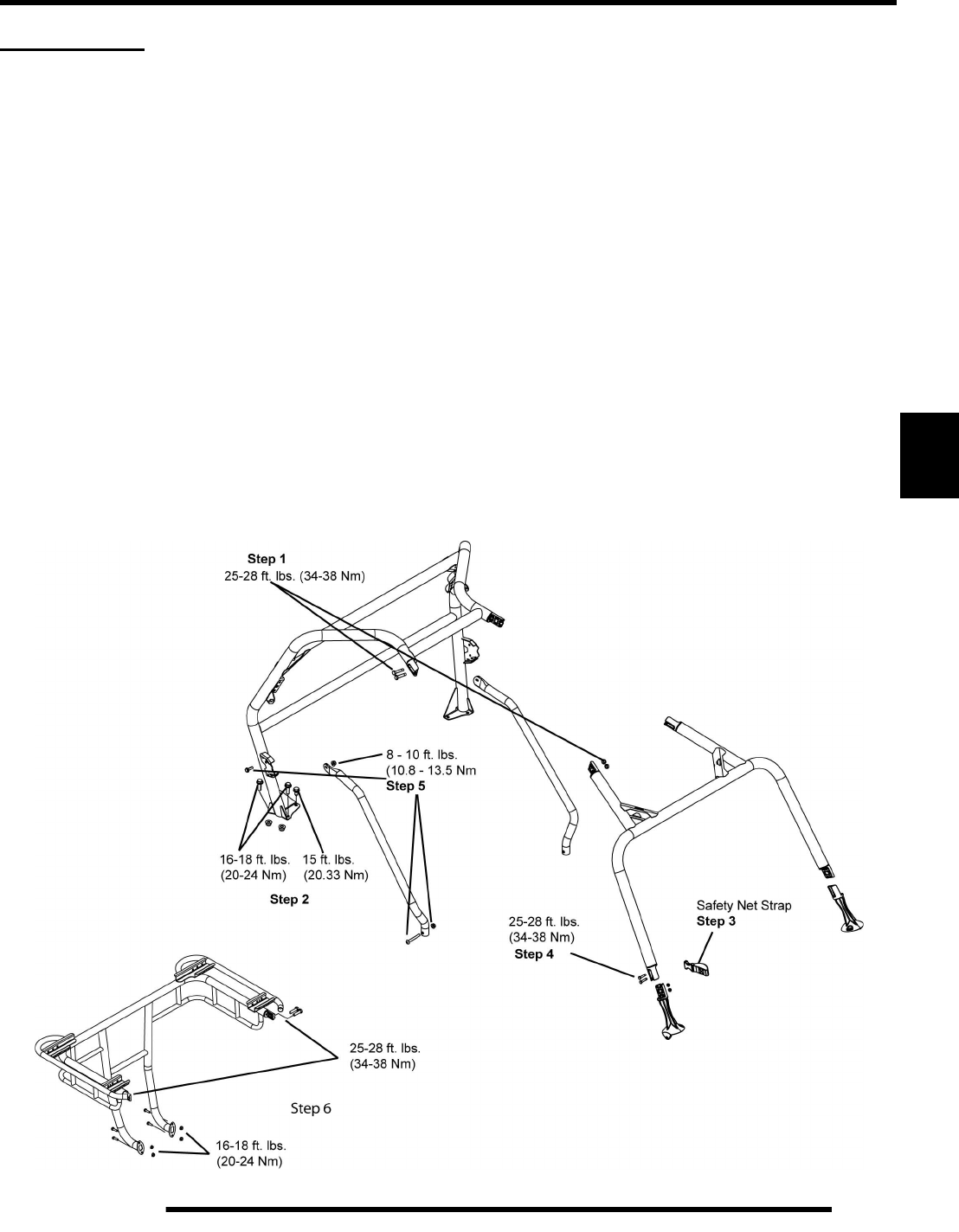
5.3
BODY / STEERING / SUSPENSION
5
CAB FRAME
Assembly / Removal
NOTE: Finger tighten all components until cab frame is completely assembled on vehicle, then tighten to
specifications listed.
1. Assemble the rear cab frame and the front cab frame at the coupler joints and secure with four (3/8-16 x 1 1/4) screws and
(3/8-16 Nyloc) nuts. Tighten screws to 25-28 ft. lbs. (34-38 Nm).
2. Place the assembled cab frame onto the vehicle and align the rear mount holes. Fasten the rear cab frame brackets to vehicle
with four (5/16-18) bolts and (5/16-18) nuts. Tighten bolts to 16-18 ft. lbs. (22-24 Nm). Fasten the two self-tapping screws to
the rear inner portion of the bracket on each side. Tighten screws to 15 ft. lbs. (20 Nm).
3. Place the straps from the safety net over the front coupler posts.
4. Fasten the front of the cab frame to the base brackets and secure with four (3/8-16 x 1 1/4) screws and (3/8-16 Nyloc) nuts.
Tighten screws to 25-28 ft. lbs. (34-38 Nm).
5. Attach side bars to cab frame using M6 screws and nuts on top and M8 screws and nuts on the bottom. Tighten to 8-10 ft. lbs
(10.8-13.5 Nm)
6. Install the rear rack assembly to rear of cab frame and vehicle main frame. Attach the upper mounting location with four (3/
8-16 x 1 1/4) screws and (3/8-16 Nyloc) nuts. Tighten screws to 25-28 ft. lbs. (34-38 Nm). Attach the lower mounting location
with four (5/16-18) bolts and (5/16-18) nuts to the rear of the vehicle main frame. Tighten bolts to 16-18 ft. lbs. (22-24 Nm).
7. To remove the cab frame, reverse the assembly procedure (steps 1-6).
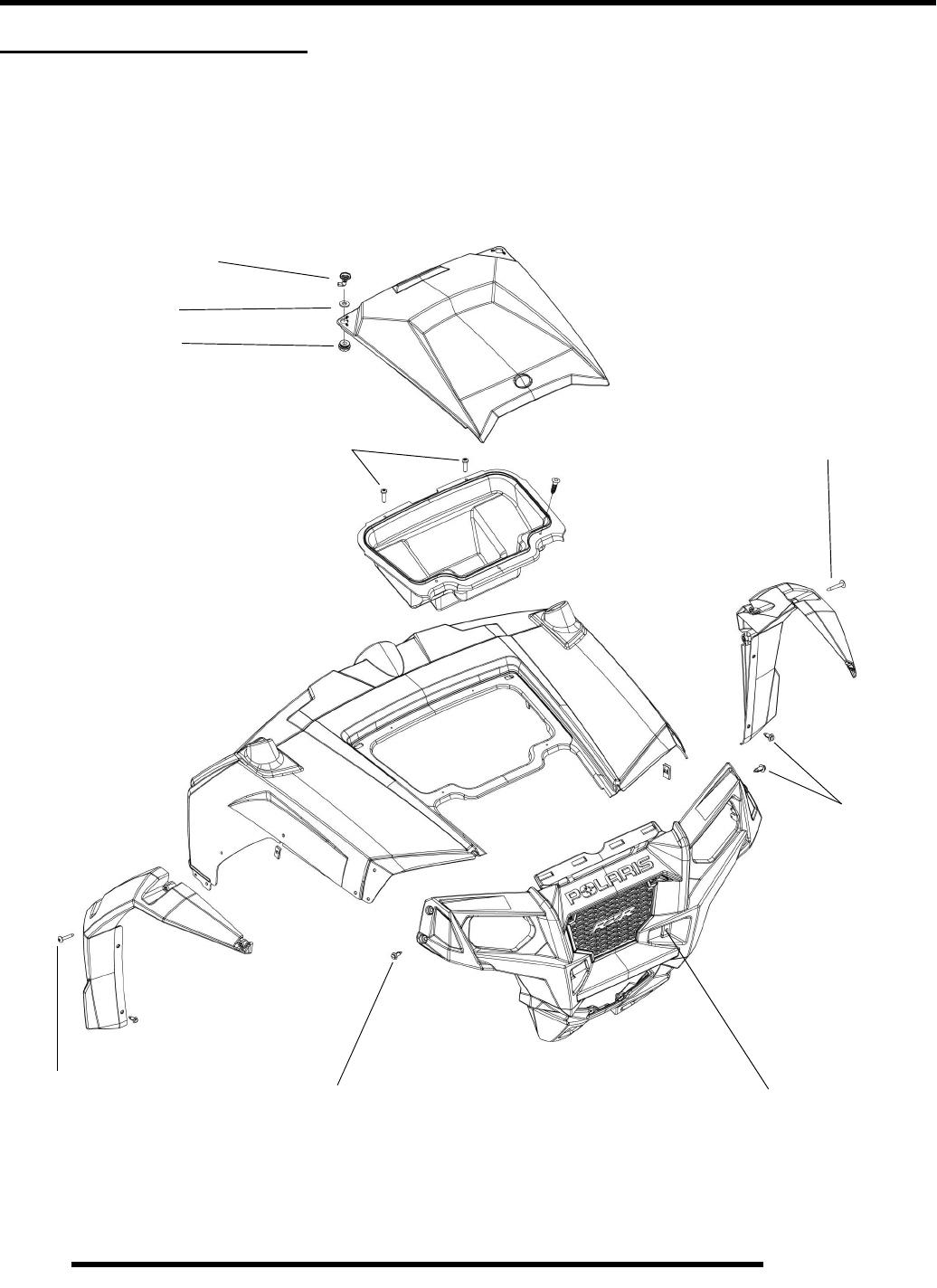
5.4
BODY / STEERING / SUSPENSION
BODY EXPLODED VIEWS
Hood / Front Body Work
Push Rivets T27 Screws
1/4 Turn Latch
Grommet
Washer
Push Rivet
T27 Screws
T27 Screws
T25 Screws

5.5
BODY / STEERING / SUSPENSION
5
Front Bumper
Rear Bumper
Headlight
O-Ring
T25
Screw
T27
Screw
T30
Screws
Bulb
RH Tail Light
Rear Bumper
Speed T25
Screws
T27
Screws
T27
Screw
LH Tail Light
Nuts
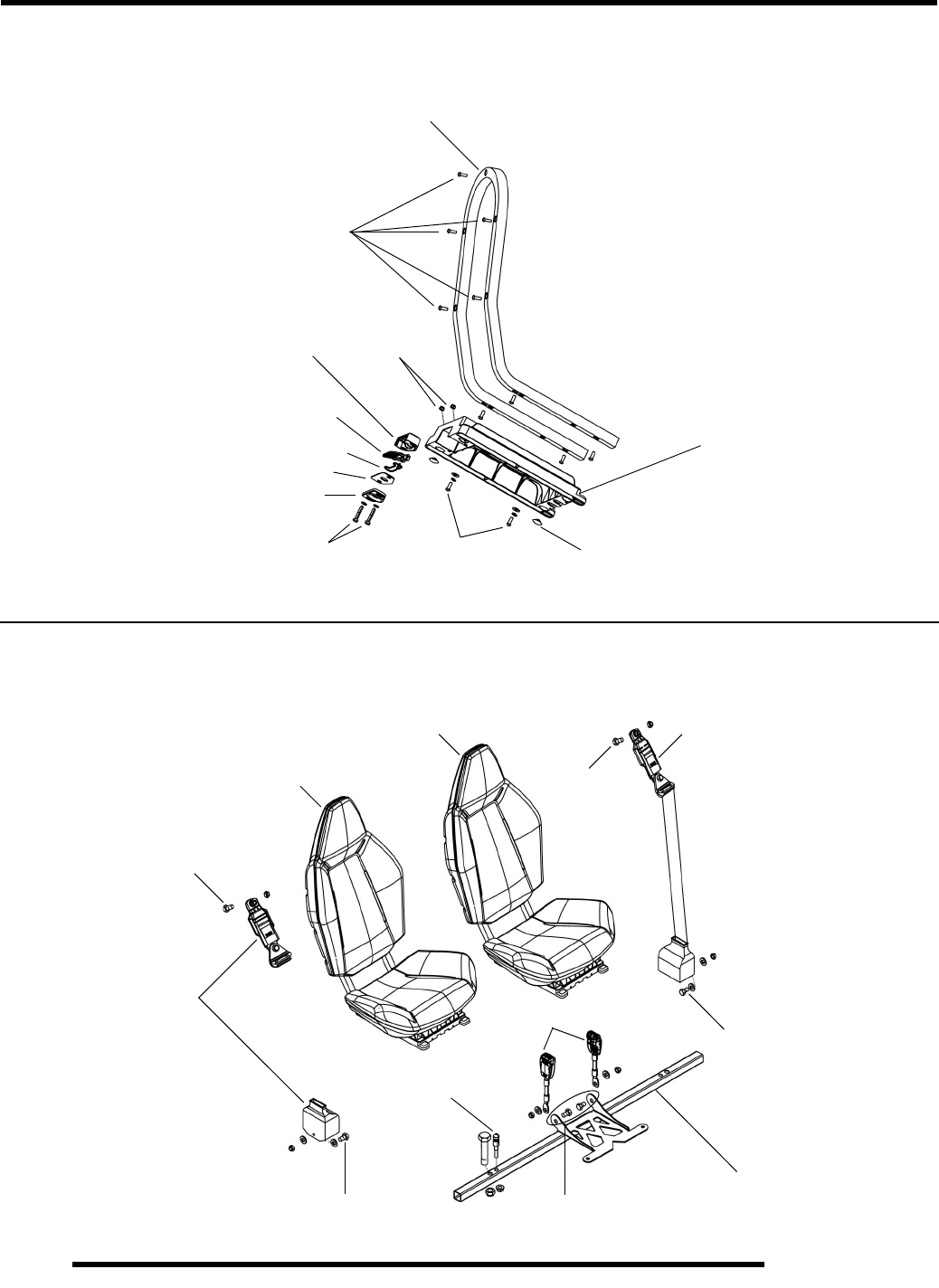
5.6
BODY / STEERING / SUSPENSION
Seat Assembly
Seat Belts / Mounting
Seat Base Asm.
Cap
Plate
Spring
Lever
Latch Body
Grommets
Seat
Hoop Tube
Nuts
41-57 in. lbs.
(4.6-6.4 Nm)
48 in. lbs.
(5.4 Nm)
41-57 in. lbs.
(4.6-6.4 Nm)
Driver 3 Point
Seat Belt
Rear
Seat Base
Latch
Seat
Passenger
Seat
3 Point
Seat Belt 3 Point
Seat Belt
Plunger
40 ft. lbs.
(54 Nm)
40 ft. lbs.
(54 Nm)
40 ft. lbs.
(54 Nm)
40 ft. lbs.
(54 Nm) 40 ft. lbs.
(54 Nm)
NOTE:Seat Style May
Differ Depending on
Model Number
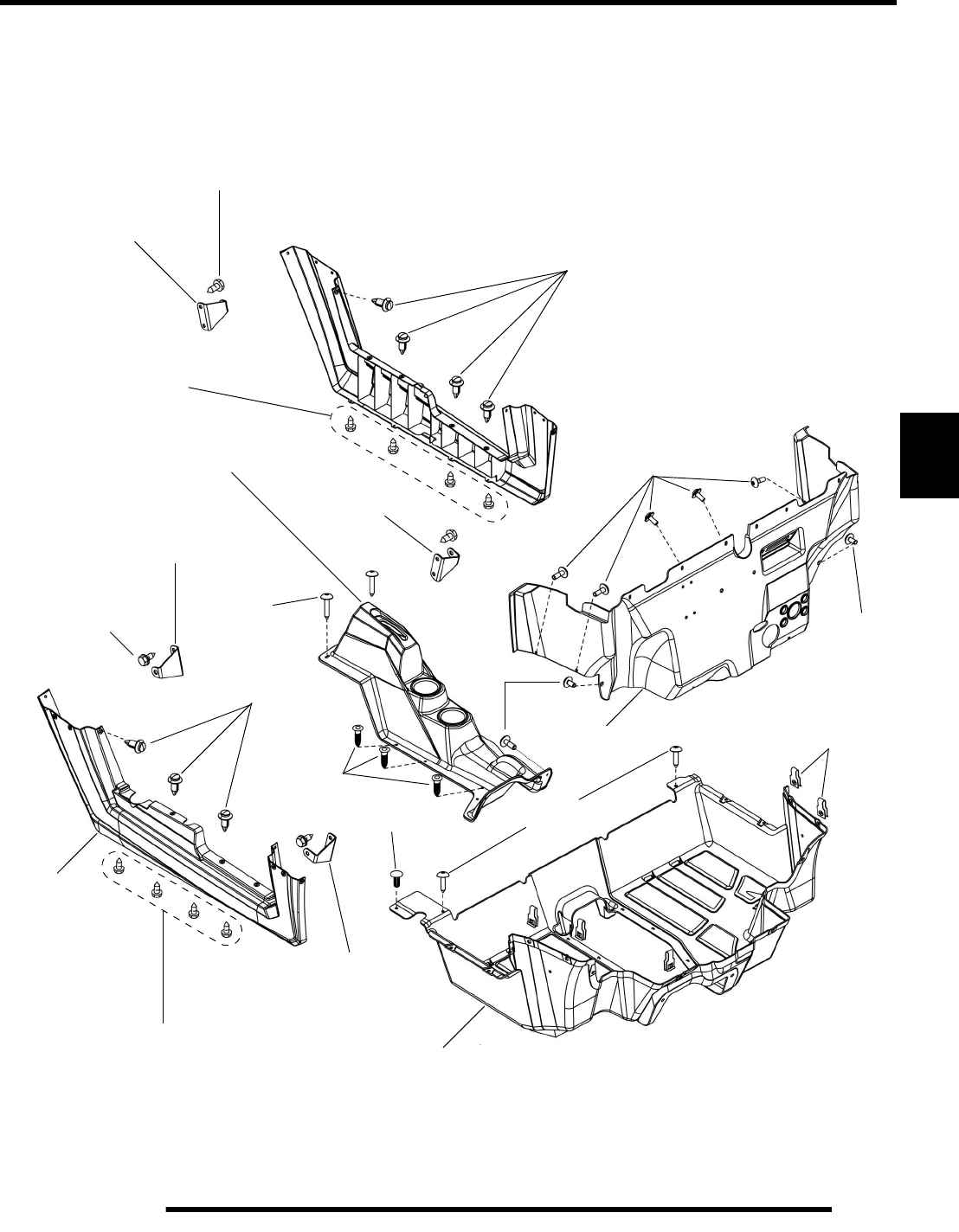
5.7
BODY / STEERING / SUSPENSION
5
Floor / Rocker Panels
RH Rocker
Console Cover
LH Rocker
Lower Floor
Rear
Front
Push Rivets
U-Type
Support Bracket
Rear
Support Bracket
Push Rivets
Support Bracket
Front
Support Bracket
Self-Tapping
Screws
Self-Tapping
Screws
Self-Tapping
Screw
T27
Screws
T27
Screws
Nuts
T27
Screws
Self-Tapping
Screw
Plastic Dart
T27
Screws
Torx
Screws
Upper Floor
T27
Screw
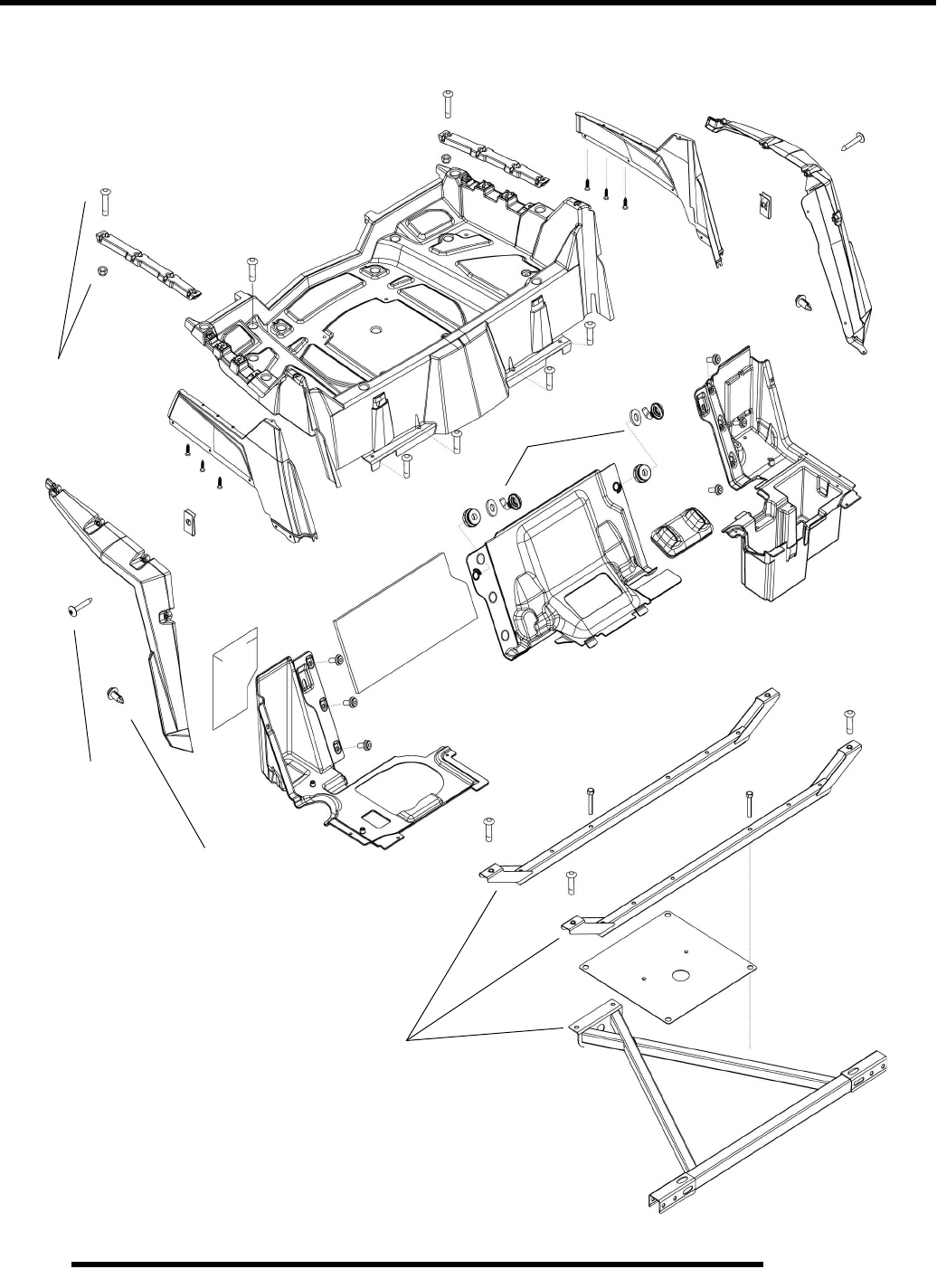
5.8
BODY / STEERING / SUSPENSION
Rear Cargo Box / Fenders
Torx S c r e w s
Nut
Push Rivets
Cargo Box Support
T27
Screw
1/4 turn
Latch
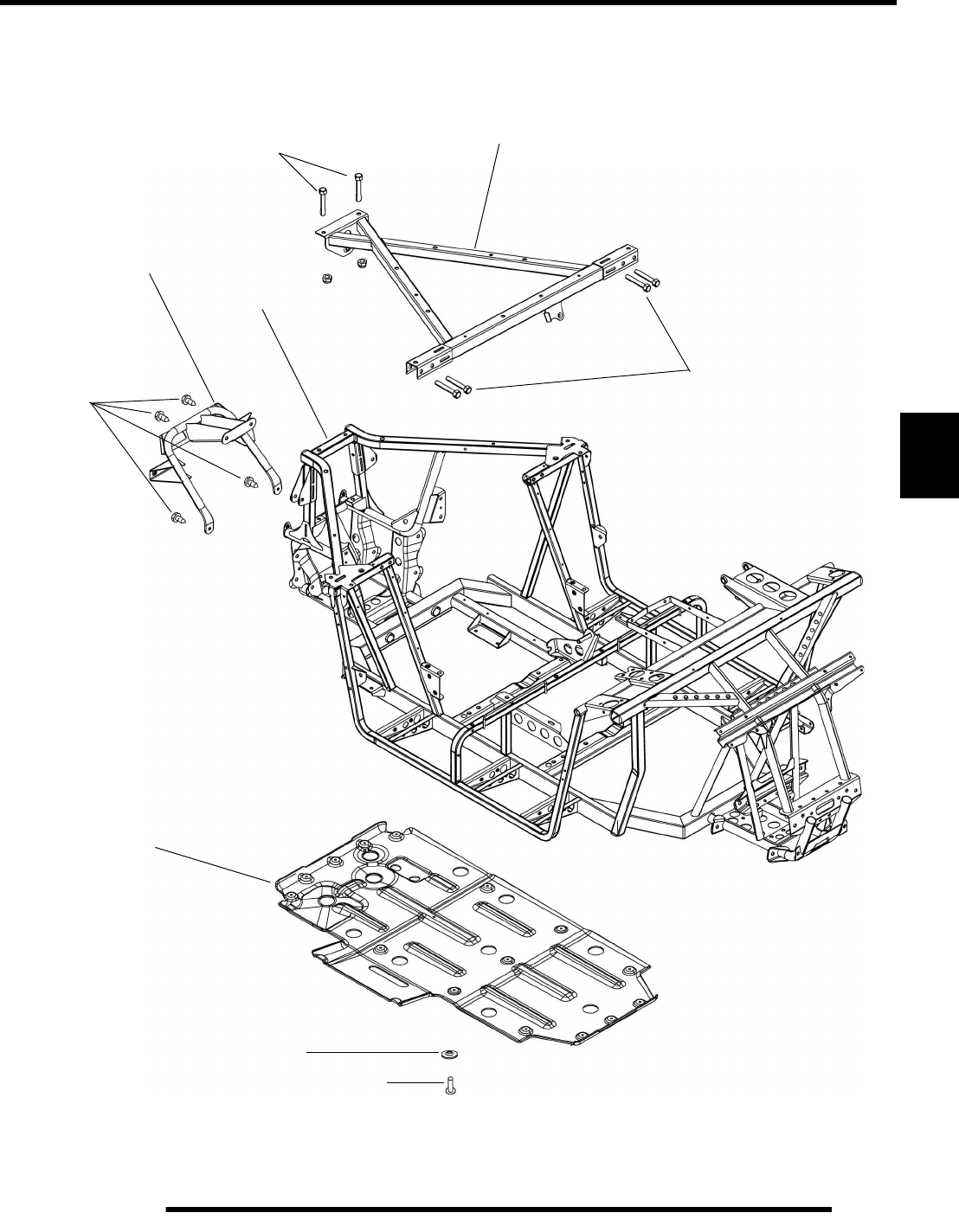
5.9
BODY / STEERING / SUSPENSION
5
Chassis / Main Frame
Main Frame
Bolt-In Brace
Skid Plate
Rear Bumper
Support
15 ft. lbs.
(20 Nm)
15 ft. lbs.
(20 Nm)
17 ft. lbs.
(23 Nm)
6-8 ft. lbs.
(8-11 Nm)
Washer
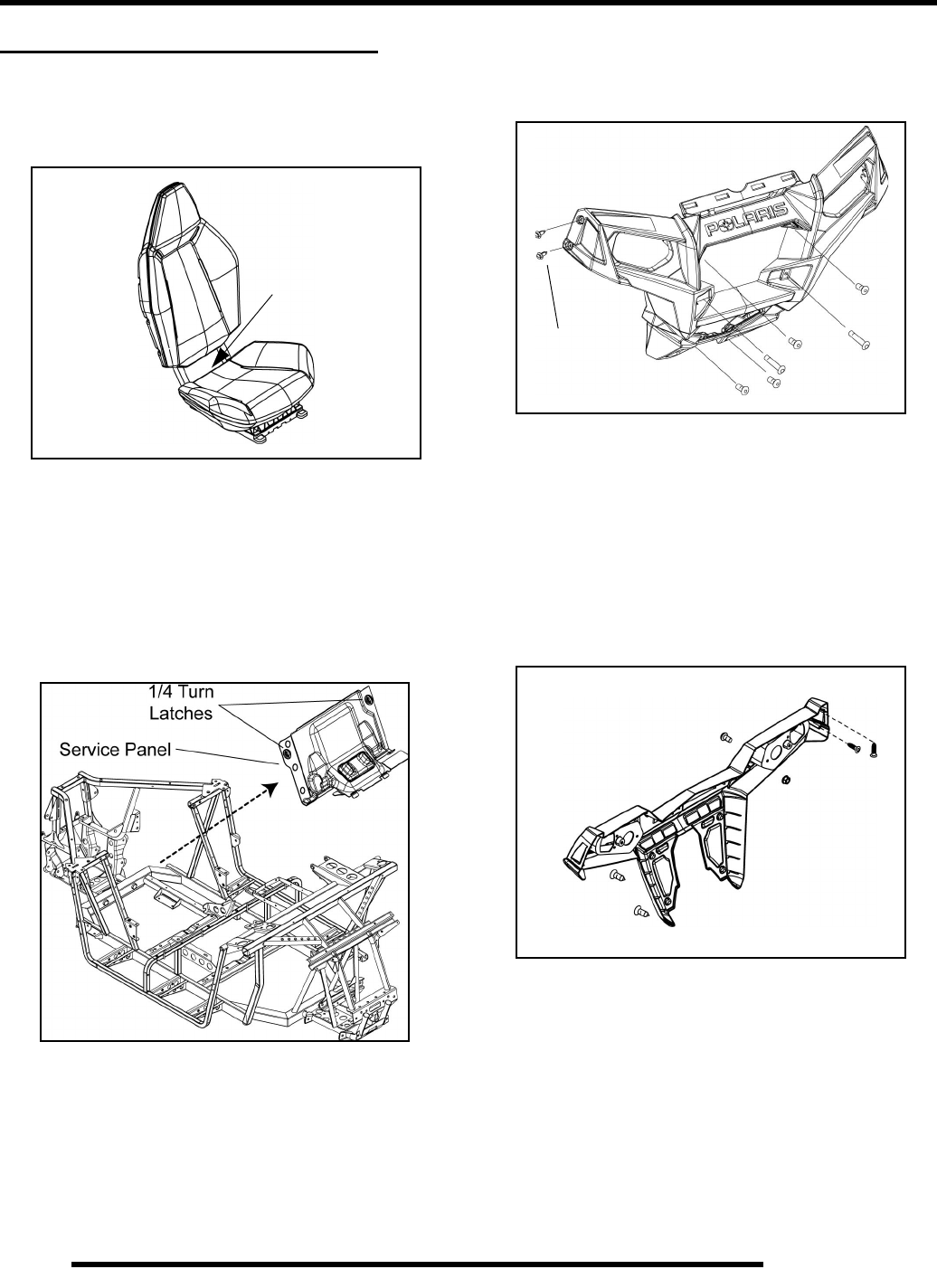
5.10
BODY / STEERING / SUSPENSION
BODY COMPONENT REMOVAL
Seats
1. To remove any of the seats, lift upward on the latch lever
located behind the seat bottom.
2. Lift upward and forward on the seat while lifting up on the
latch lever and remove the seat from the vehicle.
Rear Service Panel
1. Remove driver and passenger seats.
2. Turn both latches 1/4 turn to disengage the panel.
3. Lift the panel upward and towards the front of the vehicle
to remove it.
Front Bumper
1. Remove the (4) push rivets from the sides of the front
bumper.
2. Remove the (6) Torx screws retaining the upper, middle
and lower portion of the bumper.
3. Disconnect the front head lamp connectors and remove the
front bumper from the vehicle.
Rear Bumper
1. Remove the (4) Torx screws retaining the upper portion of
the rear bumper to the cargo box.
2. Remove the (4) Torx screws retaining the lower portion of
the rear bumper to the frame.
3. Remove the (2) fasteners retaining the middle portion of the
rear bumper to the cargo box.
Latch
Lever
NOTE: Seat Style May
Change Depending on
Model Number
Push
Rivets Torx
Screws
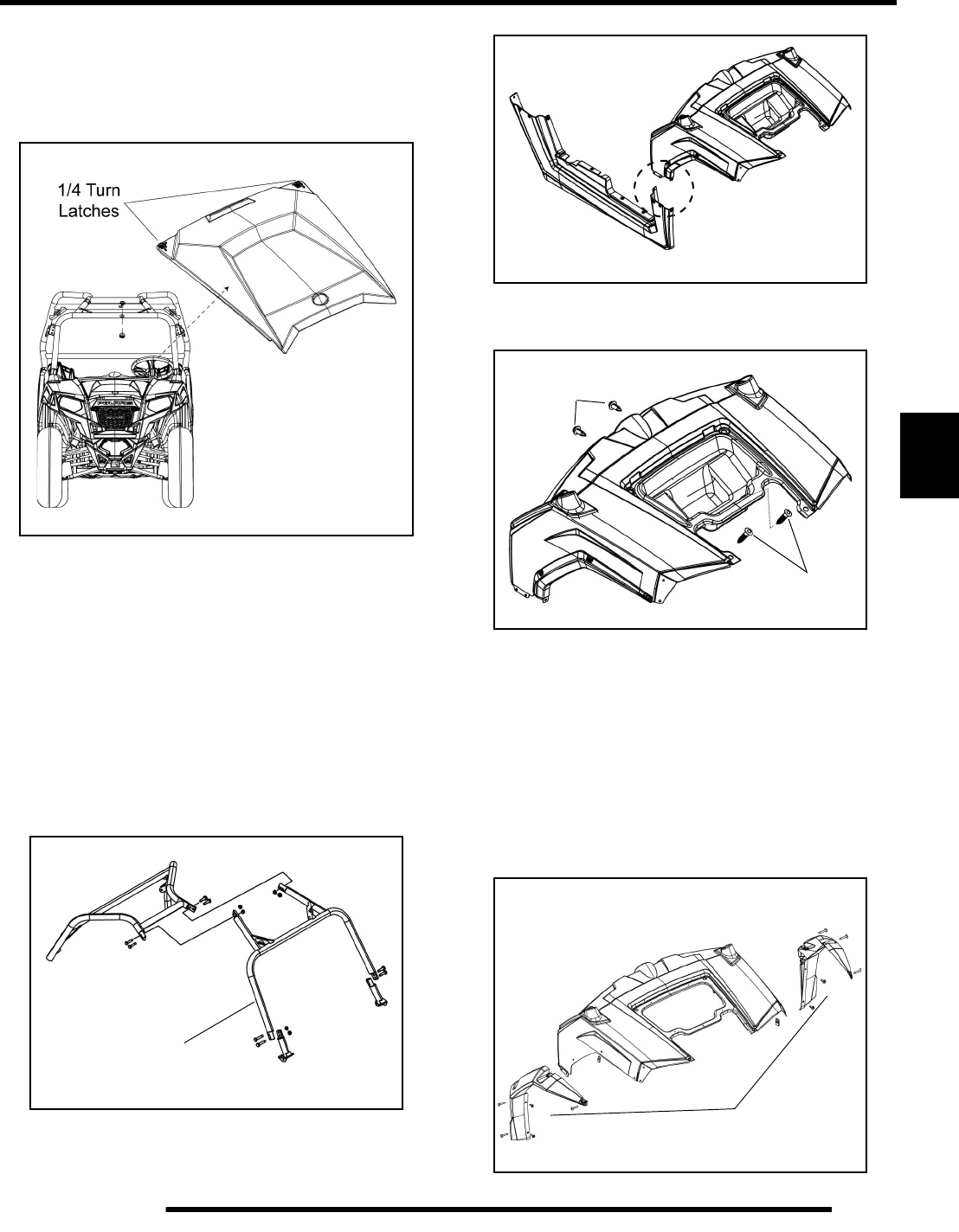
5.11
BODY / STEERING / SUSPENSION
5
Hood and Front Body Work
Hood Removal
1. To remove the hood, turn both latches to disengage the rear
portion of the hood.
2. Tilt the hood back to disengage the front tabs and remove
the hood from the vehicle.
Front Body / Dash Removal
1. Remove the hood as previously described.
2. Remove the front bumper (see “BODY COMPONENT
REMOVAL - Front Bumper”).
3. Remove the front portion of the cab frame assembly to
allow dash removal. Refer to appropriate “CAB FRAME -
Assembly / Removal” procedure for assembly torque
specifications.
4. Remove the push rivets that attach the dash assembly to the
rocker panels on each side.
5. Remove the (2) Torx screws and (2) push rivets that retain
the front and rear portions of the dash assembly.
6. Disconnect all electrical dash components noting their
location and wire routing.
7. Remove the dash assembly from the vehicle.
Front Fender Flair Removal
1. If dash is installed, remove the (2) push rivets that attach
the lower portion of the fender flair to the rocker panels.
2. Remove the (8) T27 Torx screws and remove fender flairs
from the dash assembly.
Remove
Push
Rivets
Torx
Screws
Remove Screws
and Push Pins
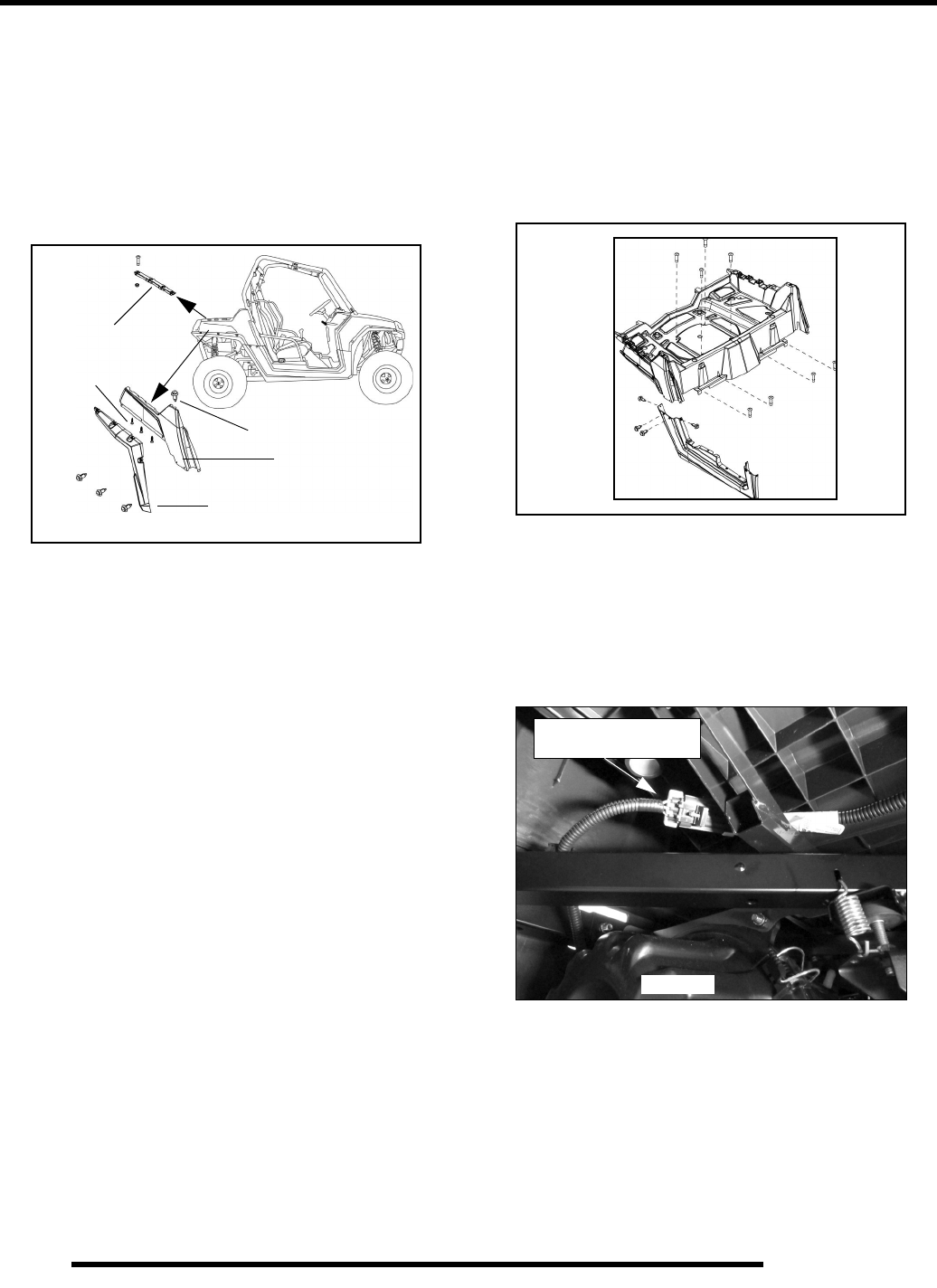
5.12
BODY / STEERING / SUSPENSION
Rear Fender, Flair and Tie Down Removal
1. Remove the rear bumper (see “BODY COMPONENT
REMOVAL - Rear Bumper”).
2. Remove the push rivets that retain the rear portion of the
rocker panels to the rear fenders.
3. Remove the (8) T27 Torx screws and remove the fender
flair.
4. Remove the (3) Torx screws from the bottom side of the
fender and the upper push rivet from the top side. Remove
the fender from the vehicle.
5. Remove the (4) fasteners that retain the tie-down brackets
to the cargo box and remove from vehicle.
Cargo Box Assembly Removal
1. Remove the seats and rear panel or cover (see “Seats” and
“Rear Service Panel”).
2. Remove the (4) Torx screws retaining the lower portion of
the rear bumper to the frame (see “Rear Bumper”).
3. Remove the (4) screws from the middle of the cargo box.
4. Remove the (4) Torx screws that attach the front portion of
the cargo box to the frame.
5. Remove the (6) Torx screws and (2) push rivets that attach
the rocker panels to the cargo box on each side.
6. Disconnect the taillight harness from the chassis harness
and remove the cargo box assembly from the vehicle.
Fender
Fender
Flair
Tie-Down
Push
Rivets
Torx
Screws
Push
Rivet
Disconnect Taillight
Connector
Air Box
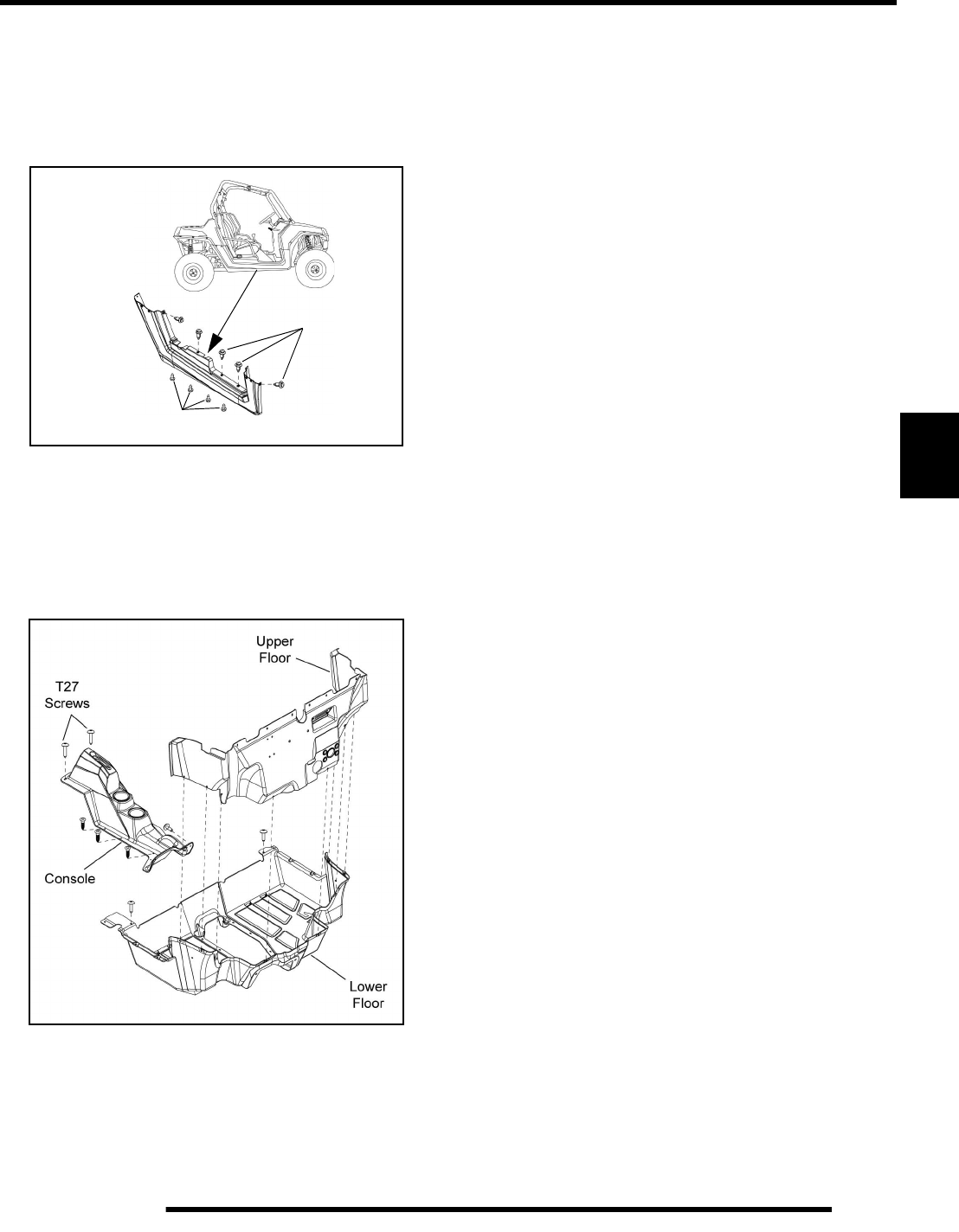
5.13
BODY / STEERING / SUSPENSION
5
Rocker Panels, Console and Floor
Rocker Panel Removal
1. Remove the push rivets and Torx screws retaining the
rocker panel and remove panel from the vehicle.
Console and Lower Floor Removal
1. Remove both seats and rocker panels (see “Rocker Panel
Removal”).
2. Remove the T27 screws retaining the console to the floor.
3. Remove the shift handle knob and remove the console.
4. Remove the Torx screws retaining the upper floor to the
lower floor.
5. Remove the Torx screws retaining the rear portion of the
floor and remove the lower floor from the vehicle.
Push
Rivets
Screws
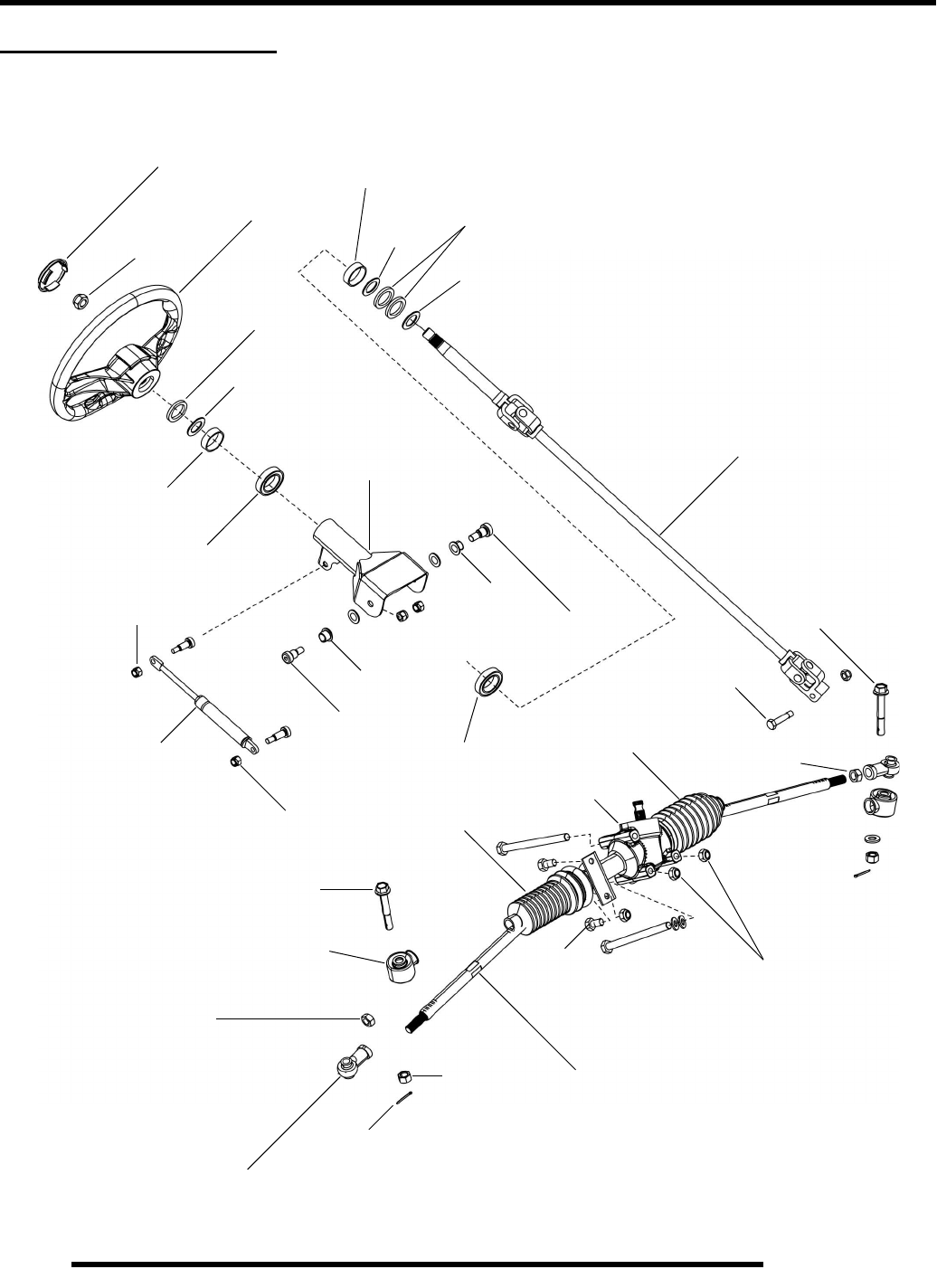
5.14
BODY / STEERING / SUSPENSION
STEERING ASSEMBLY
Exploded View
Boot
Rod End
Tie Rod
RH Boot
LH Boot
Spacer
Bearing
Steering Wheel
Cap
Pivot Tube
Steering Shaft
Cotter Pin
Gear Box
Bearing
Bushing
Oil Locking
Shock Asm. Asm.
17 ft. lbs.
(23 Nm) 17 ft. lbs.
(23 Nm)
12-14 ft. lbs.
(16-19 Nm)
Nut
42.5 ft. lbs.
(58 Nm)
42.5 ft. lbs.
(58 Nm)
12-14 ft. lbs.
(16-19 Nm)
27-33 ft. lbs.
(37-45 Nm)
25-31 ft. lbs.
(34-42 Nm)
23 ft. lbs.
(31 Nm)
23 ft. lbs.
(31 Nm)
7 ft. lbs.
(10 Nm)
12 ft. lbs.
(16 Nm)
Bushing
Thick
Washer
Thin
Washer
Thick
Washers
Thin
Washer
Thin
Washer
Spacer
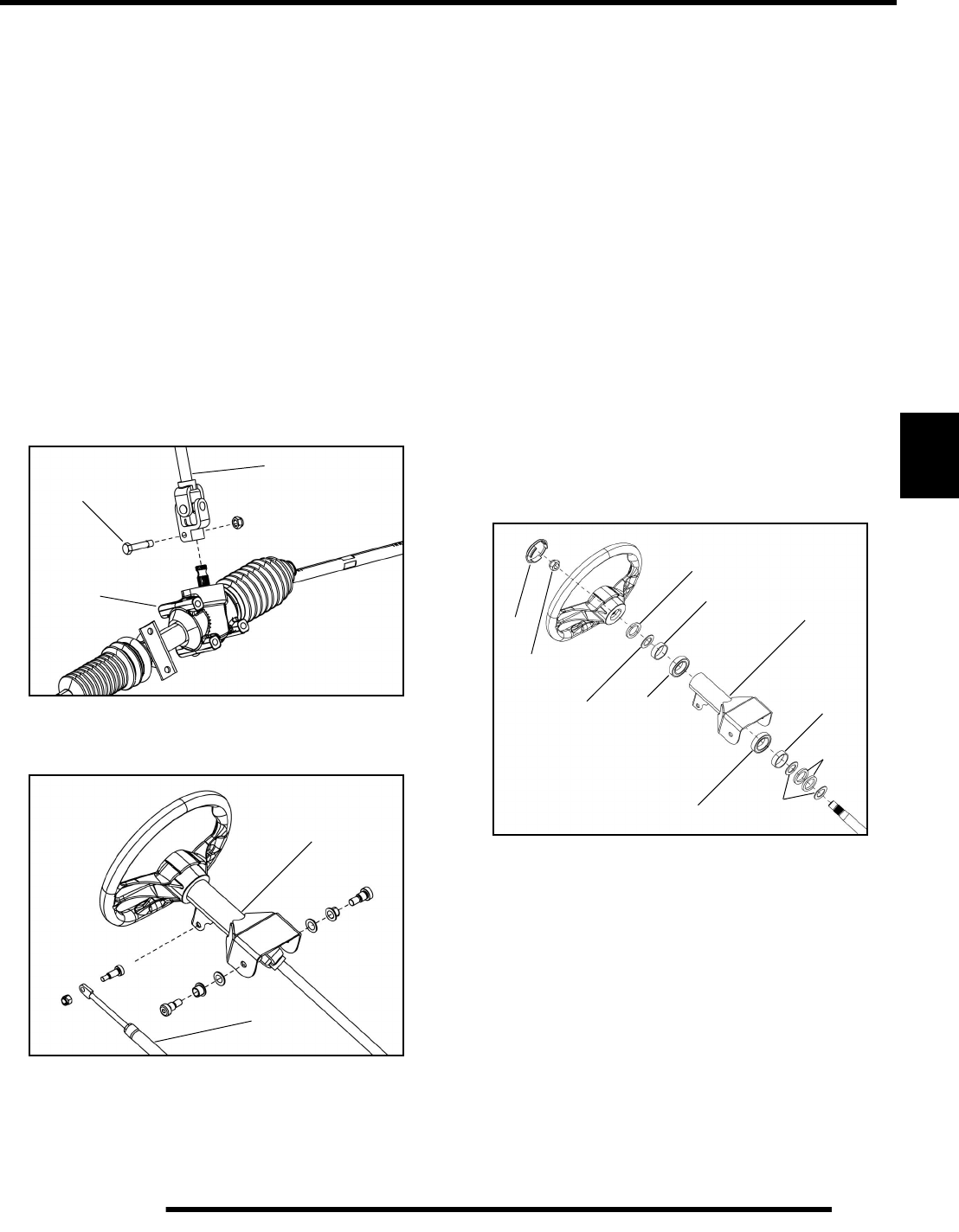
5.15
BODY / STEERING / SUSPENSION
5
Steering Wheel Removal
1. Remove the steering wheel cap.
2. Loosen the nut and back it half way off the steering shaft.
3. With a glove on your hand, place it under the steering
wheel. Lift upward on the inner portion of the steering
wheel while using a hammer to strike the steering shaft nut.
IMPORTANT: If the steering wheel will not pop loose,
proceed to “Steering Shaft Removal”.
4. Once the steering wheel pops loose, completely remove the
nut and lift the steering wheel off the shaft.
Steering Shaft Removal
1. Remove the pinch bolt retaining the lower portion of the
steering shaft to the steering gear box assembly.
2. Remove the fastener retaining the upper portion of the
steering wheel tilt shock to the pivot tube.
3. Remove the (2) fasteners that retain the pivot tube.
4. Remove the steering shaft, pivot tube and steering wheel
from the vehicle as an assembly.
5. Refer to steps 11-13 of the “Steering Shaft Bearing
Replacement” procedure for installation.
Steering Shaft Bearing Replacement
1. Perform the “Steering Shaft Removal” procedure.
2. Remove the steering wheel cap and retaining nut.
3. Press steering shaft out of the steering wheel and pivot tube.
4. Note the order and location of the washers and spacers
between the steering wheel and pivot tube.
5. Drive the bearings out of the pivot tube using a drift punch.
6. Inspect the pivot tube bearing surfaces for signs of
excessive wear or damage.
7. Slide a new lower bearing onto the steering shaft and install
the steering shaft through the pivot tube.
NOTE: Be sure the lower washers and spacers are
still on the steering shaft.
8. Slide a new upper bearing onto the steering shaft and press
it into the pivot tube by hand.
NOTE: Bearings will be seated in the pivot housing
upon tightening the steering wheel nut in step 14.
9. Reinstall the upper washers and spacers in the order in
which they were removed.
10. Install the steering wheel and hand tighten the nut.
Figure 5-16
Pinch Bolt
Gear Box
Asm.
Steering Shaft
Figure 5-17
Pivot Tube
Tilt Shock
Spacer
Thin
Washer
Thick
Washer
Bearing
Cap
Nut
Pivot Tube
Bearing
Spacer
Thin
Washers
Thick
Washers
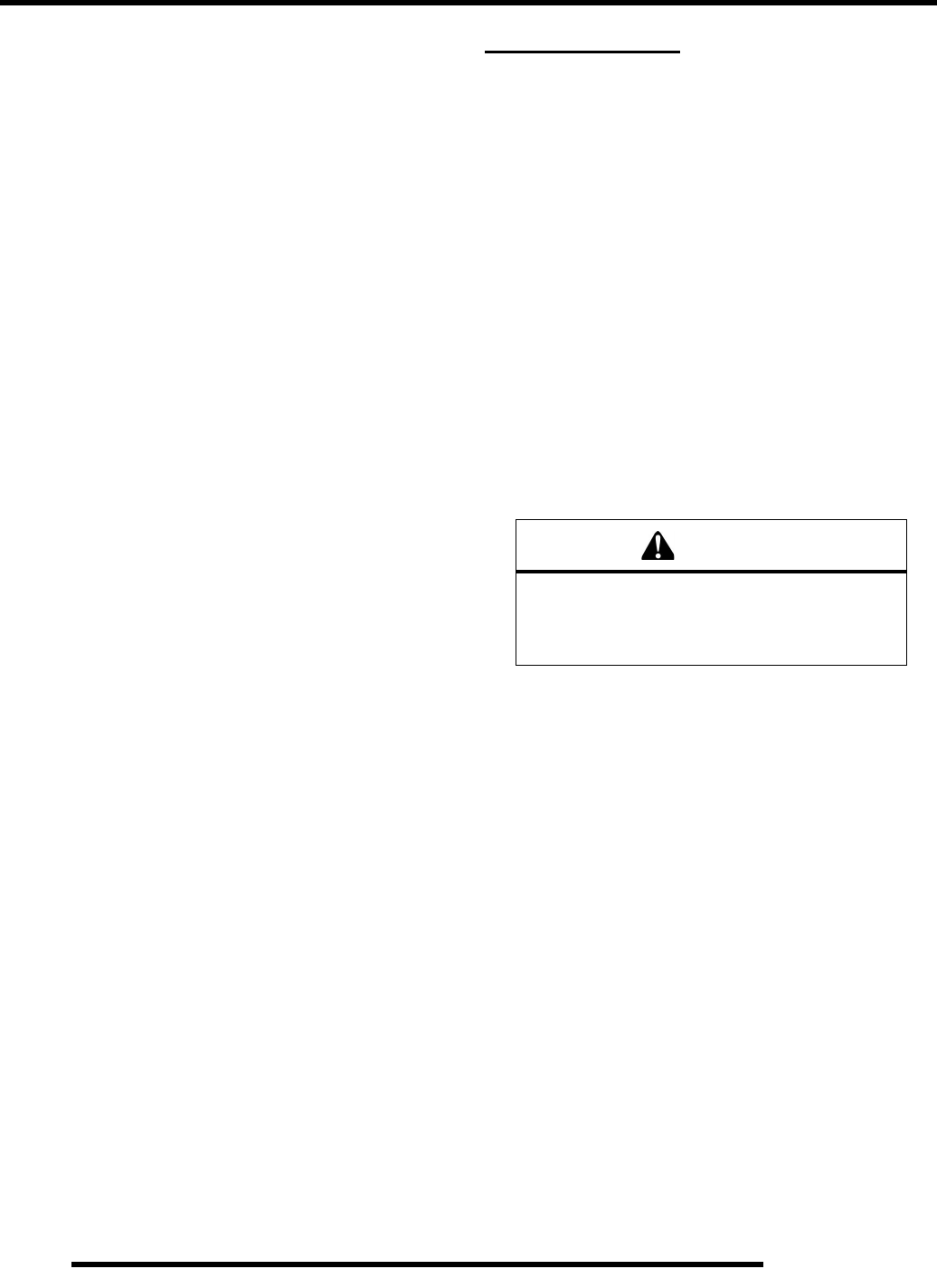
5.16
BODY / STEERING / SUSPENSION
11. Reinstall the steering shaft assembly in the vehicle. Install
the lower portion of the steering shaft onto the steering gear
box assembly (see Figure 5-16). Torque the lower pinch
bolt to 30 ft. lbs. (41 Nm).
12. Install the (2) fasteners that retain the pivot tube (see Figure
5-17). Torque fasteners to 23 ft. lbs. (31 Nm).
13. Install the fastener retaining the upper portion of the
steering wheel tilt shock to the pivot tube (see Figure 5-17).
Torque fastener to 7 ft. lbs. (10 Nm).
14. Be sure the front wheels are facing straight forward.
Remove the steering wheel and align as needed. Torque the
steering wheel nut to 28 ft. lbs. (38 Nm).
15. Install steering wheel cap and field test steering operation.
FRONT A-ARMS
Removal / Replacement
The following procedure details upper and lower A-arm
removal and replacement on one side of the vehicle.
1. Elevate and safely support the front of the vehicle and
remove the front wheel.
2. Remove lower shock fastener (A) from the upper A-arm.
3. Remove upper ball joint pinch bolt (B) from bearing carrier.
4. Using a soft face hammer, tap on bearing carrier to loosen
the upper A-arm ball joint end while lifting upward on the
upper A-arm. Completely remove the ball joint end from
the bearing carrier.
5. Remove the front bumper to allow A-arm bolt removal.
6. Loosen and remove the upper A-arm through-bolt fastener
(C) and remove the upper A-arm from the vehicle.
7. Examine A-arm bushings and pivot tube (see “Exploded
View”). Replace if worn. Discard hardware.
8. If not replacing the A-arm, thoroughly clean the A-arm and
pivot tube.
9. Install new ball joint into A-arm. Refer to “Ball Joint
Replacement” section.
10. Insert new A-arm bushings and pivot tube into new A-arm.
11. Install new upper A-arm assembly onto vehicle frame.
Torque new bolt to specification.
12. Insert upper A-arm ball joint end into the bearing carrier.
Install upper ball joint pinch bolt (B) into the bearing carrier
and torque bolt to specification.
13. Attach shock to A-arm with fastener (A). Torque lower
shock bolt to specification.
14. Remove lower ball joint pinch bolt (E) from bearing carrier.
15. Using a soft face hammer, tap on bearing carrier to loosen
the lower A-arm ball joint end while pushing downward on
the lower A-arm. Completely remove the ball joint end
from the bearing carrier.
16. Loosen and remove the lower A-arm through-bolt fastener
(F) and remove the lower A-arm from the vehicle.
17. Examine A-arm bushings and pivot tube (see “Exploded
View”). Replace if worn. Discard hardware.
WARNING
The locking agent on the existing bolts was
destroyed during removal. DO NOT reuse old
hardware. Serious injury or death could result if
fasteners come loose during operation.
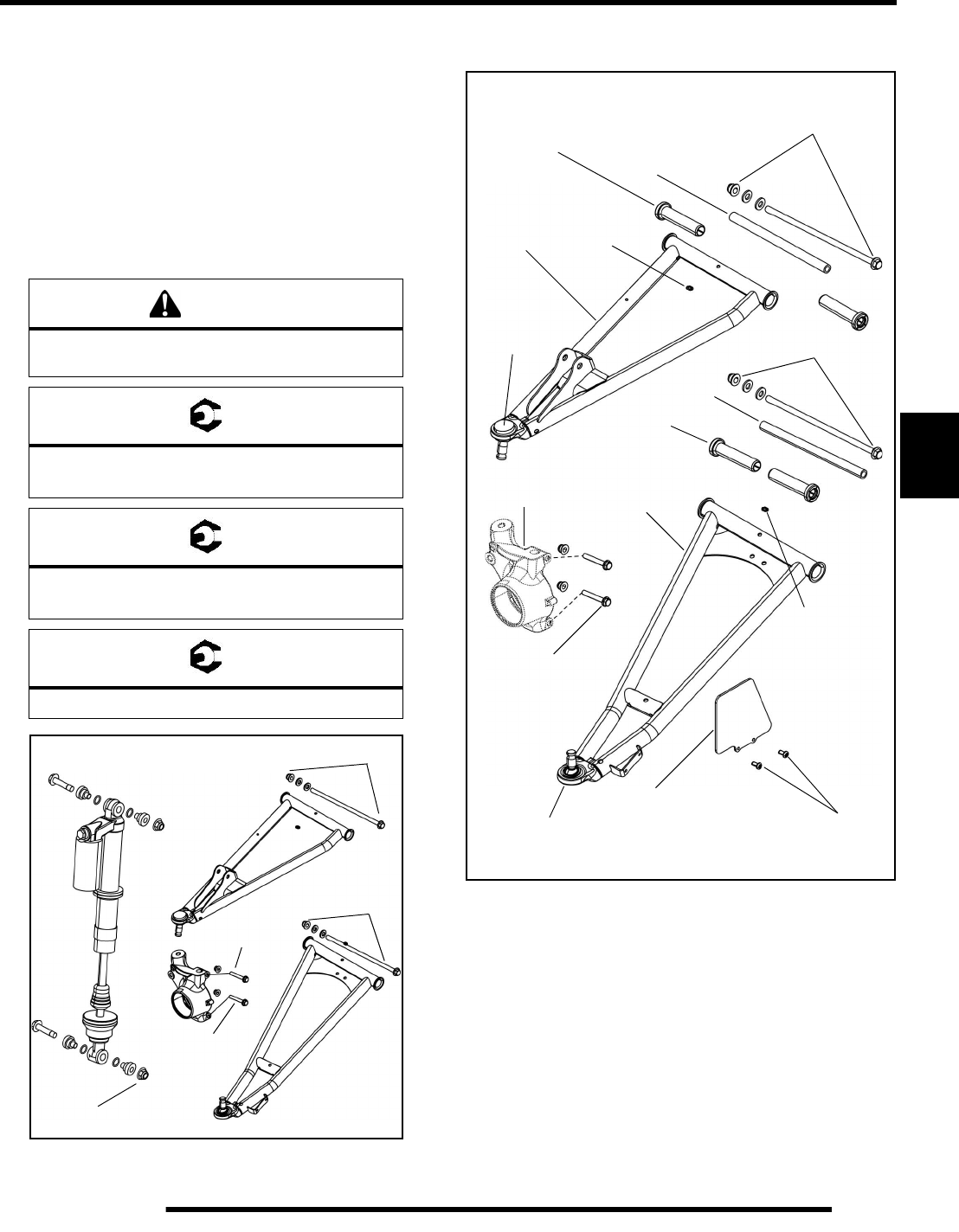
5.17
BODY / STEERING / SUSPENSION
5
18. If not replacing the A-arm, thoroughly clean the A-arm and
pivot tube.
19. Install new ball joint into A-arm. Refer to “Ball Joint
Replacement” section.
20. Insert new A-arm bushings and pivot tube into new A-arm.
21. Install new lower A-arm assembly onto vehicle frame.
Torque new bolt to specification.
22. Insert lower A-arm ball joint end into the bearing carrier.
Install lower ball joint pinch bolt (E) into the bearing carrier
and torque bolt to specification.
Exploded View
WARNING
Upon A-arm installation completion, test vehicle
at low speeds before putting into service.
= T
Front Upper / Lower A-arm Bolts:
40 ft. lbs. (54 Nm)
= T
Front Ball Joint Pinch Bolts:
22.5 ft. lbs. (30.5 Nm)
= T
Shock Mounting Bolts: 30 ft. lbs. (41 Nm)
A
B
C
E
F
Upper
A-arm
Lower
A-arm
Grease
Screws
Ball Joint
Pinch
Bearing
CV Shield
Bushings
Grease
Ball Joint
Carrier
Bolts
Zerk
Pivot
Zerk
Tube
Pivot
Tube
Bushings
Upper Fastener
Lower Fastener

5.18
BODY / STEERING / SUSPENSION
BALL JOINT SERVICE
Removal
IMPORTANT: Do not reuse a ball joint if it has been
removed for any reason. If removed, it must be
replaced. Use this removal procedure only when
replacing the ball joint.
1. The A-arm must be removed to perform this procedure
(see “FRONT A-ARMS - Removal / Replacement”).
2. Remove the retaining ring from the ball joint.
3. A driver must be used for the removal of the ball joint. Use
the dimensions below to fabricate or locate the correct size
driver to use in the following process.
4. Use a press and correct size driver to remove the ball joint
from the A-arm.
NOTE: The driver must fit the ball joint housing in
the A-arm. This will allow the ball joint to be properly
pressed out of the A-arm without damaging the A-
arm.
Ball Joint
Upper A-arm
Retaining Ring
1.75 in.
1.375 in.
(3.49 cm)
3 in.
(7.62 cm)
Driver Dimensions
- Outside diameter of driver cannot be any
larger than 1.75 in. (4.45 cm).
- Inside diameter cannot be any smaller than
1.375 in. (3.49 cm).
- Driver must be at least 3 in. (7.62 cm) tall.
(4.45 cm)
Correct
Driver Placement
The driver must fit the
inside diameter of the
A-arm end.
Upper A-Arm Shown
Press out of the A-arm
in this direction
Place driver HERE
to support A-arm
Upper A-Arm Shown

5.19
BODY / STEERING / SUSPENSION
5
Installation
1. Place the A-arm in the correct position for ball joint
installation. Face the A-arm end flat on top of the driver.
Carefully drive the ball joint into place until the ball joint
is properly seated.
2. After the new ball joint is installed into the A-arm, install
a NEW retaining ring.
3. Reinstall the A-arm (see “FRONT A-ARMS - Removal /
Replacement”).
4. Repeat the ball joint service procedure for any additional
A-arm ball joint replacements.
REAR A-ARMS
Removal
The following procedure details upper and lower A-arm
removal and replacement on one side of the vehicle. Repeat the
following steps to remove the A-arm(s) from the opposite side.
NOTE: Use the exploded view in this section as a
reference during the procedure (see page 5.41).
1. Elevate and safely support the rear of the vehicle off the
ground.
2. Remove the wheel nuts, and rear wheel.
Upper A-arm Removal
1. Remove the fastener (A) attaching the upper A-arm to the
bearing carrier.
2. Remove the fastener (B) attaching the upper A-arm to the
frame and remove the upper A-arm from the vehicle.
3. Examine A-arm and bearing carrier bushings and pivot
tubes (see “Exploded View” on page 5.41). Replace if
worn. Discard hardware.
Press into the A-arm
in this direction
Place driver HERE
to support A-arm
Upper A-Arm Shown
Ball Joint
Upper A-arm
NEW
Retaining Ring
A
B
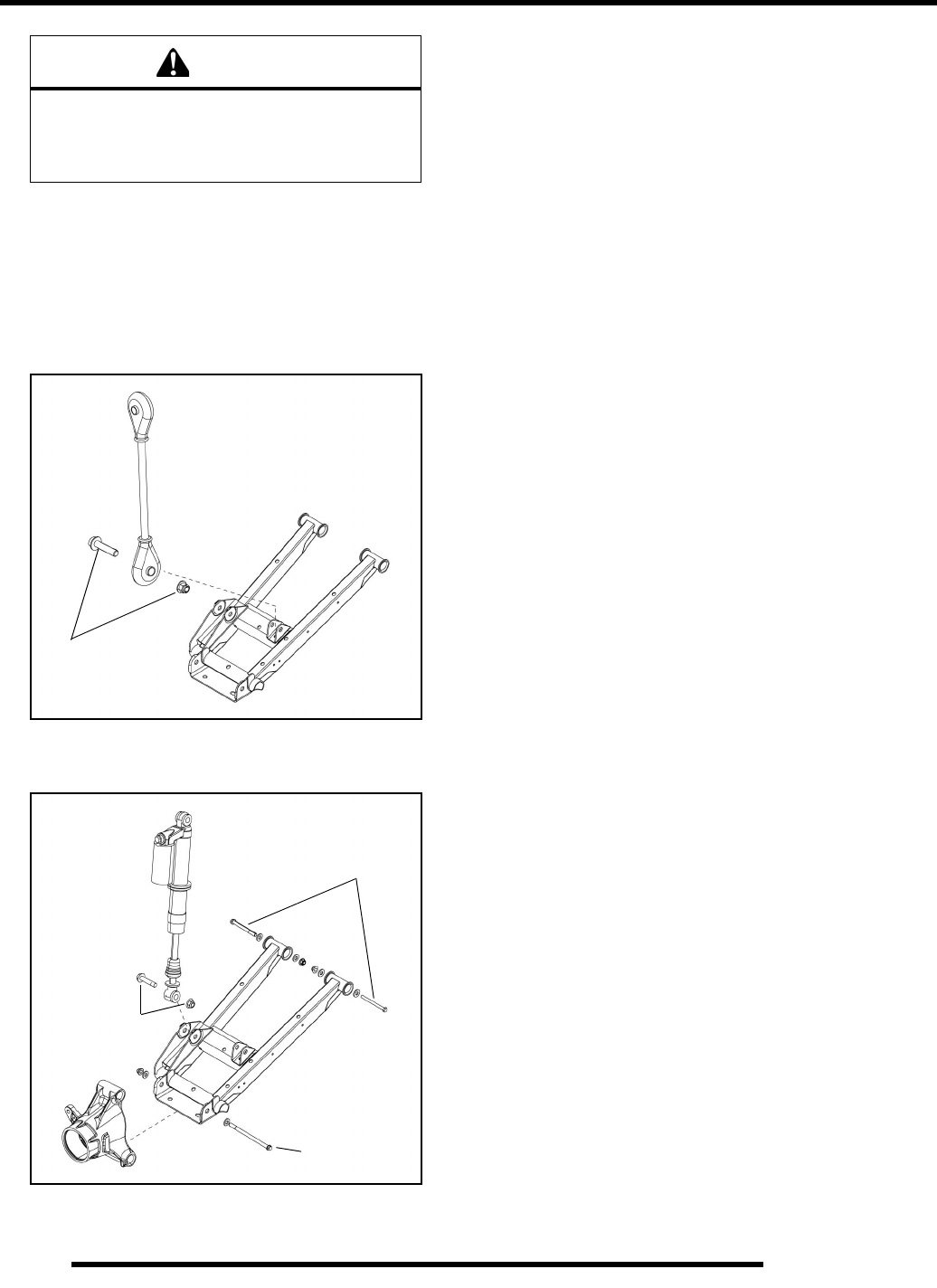
5.20
BODY / STEERING / SUSPENSION
4. If not replacing the A-arm, thoroughly clean the a-arm and
pivot tubes.
5. Insert new A-arm bushings and pivot tubes into new A-arm.
Lower A-arm Removal
1. Remove the lower fastener (F) retaining the stabilizer bar
linkage to the lower A-arm.
2. Remove the fastener (G) retaining the lower portion of the
shock to the lower A-arm.
3. Remove the fastener (H) attaching the lower A-arm to the
bearing carrier (see previous illustration).
4. Remove the (2) fasteners (J) attaching the lower A-arm to
the frame and remove the lower A-arm from the vehicle
(see previous illustration).
5. Examine A-arm and bearing carrier bushings and pivot
tubes (see “Exploded View”). Replace if worn. Discard
hardware.
6. If not replacing the A-arm, thoroughly clean the A-arm and
pivot tubes.
7. Insert new A-arm bushings and pivot tubes into new A-arm.
WARNING
The locking agent on the existing bolts was
destroyed during removal. DO NOT reuse old
hardware. Serious injury or death could result if
fasteners come loose during operation.
F
G
H
J
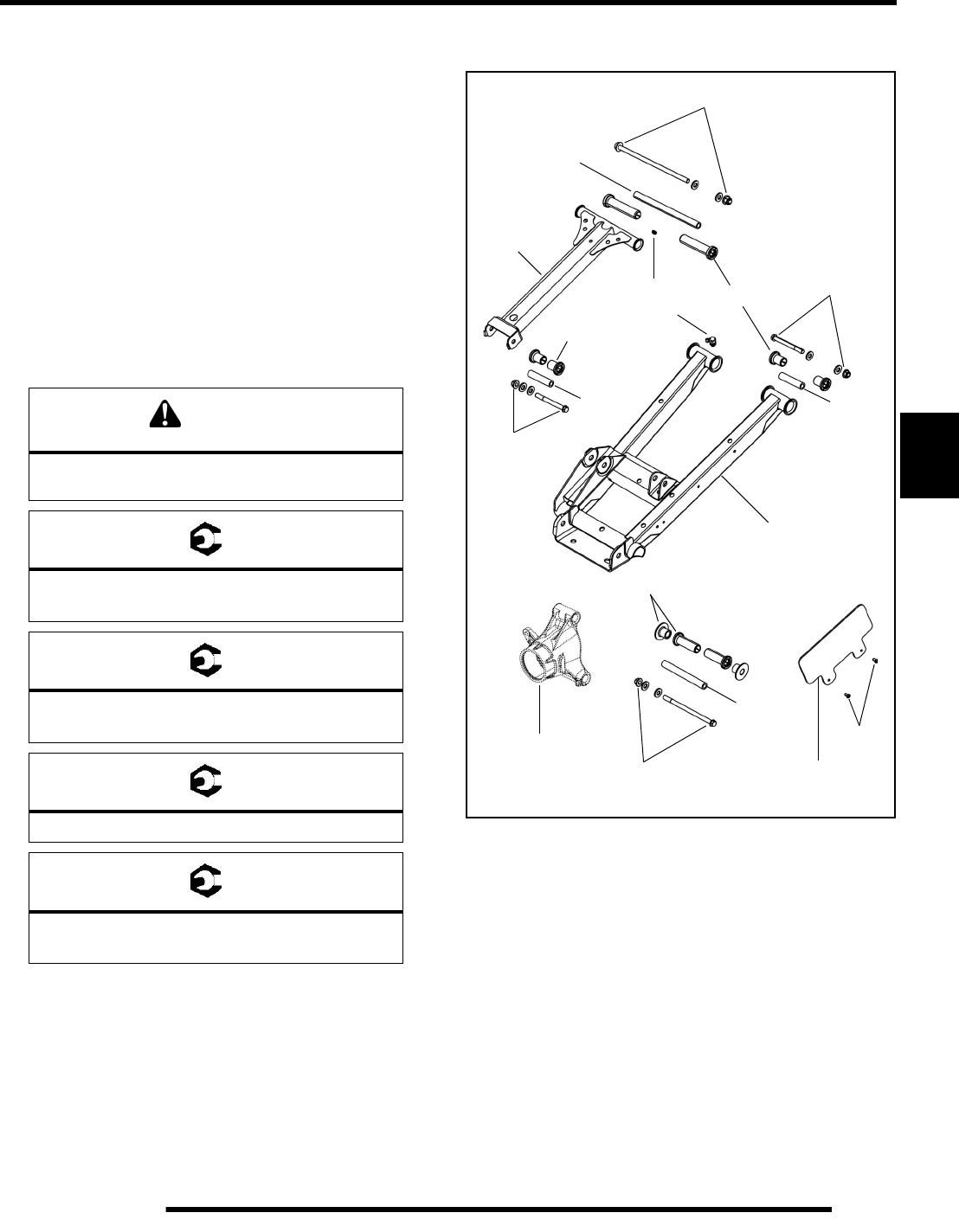
5.21
BODY / STEERING / SUSPENSION
5
Installation
1. Install lower A-arm assembly onto vehicle frame. Torque
new fasteners to specification.
2. Attach lower A-arm to bearing carrier. Torque new fastener
to specification.
3. Route brake line on top of the lower A-arm and between
lower shock mounting tabs.
4. Reinstall the lower portion of the shock to the lower A-arm.
Torque shock fastener to specification.
5. Install upper A-arm assembly onto vehicle frame. Torque
new fastener to specification.
6. Attach upper A-arm to bearing carrier. Torque new fastener
to specification.
7. Install wheel and torque wheel nuts to specification.
Exploded View
WARNING
Upon A-arm installation completion, test vehicle
at low speeds before putting into service.
= T
Rear Upper / Lower A-arm Bolts:
40 ft. lbs. (54 Nm)
= T
Lower Rear Bearing Carrier Bolts:
40 ft. lbs. (54 Nm)
= T
Shock Mounting Bolts: 30 ft. lbs. (41 Nm)
= T
Upper Rear Bearing Carrier Bolts:
40 ft. lbs. (54 Nm)
Upper
A-arm
Lower
A-arm
Screws
Bearing
CV
Bushings
Pivot Tube
Carrier
Pivot
Grease
Zerk
Shield
Tube
Bushings
Pivot
Tube
Bushings
Pivot
Tube
Upper Fastener
Lower
Fastener
Upper
Fastener
Lower
Fastener
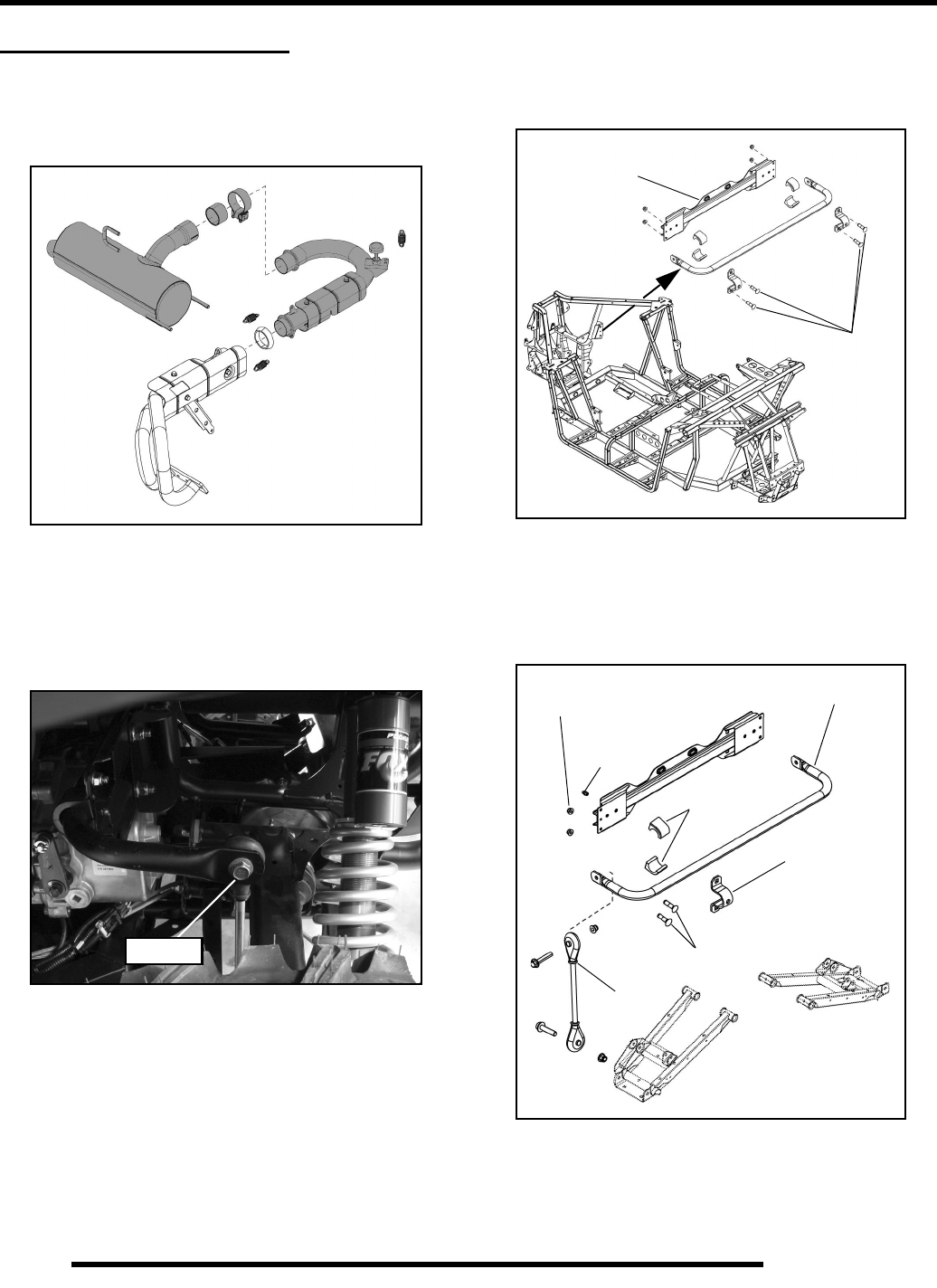
5.22
BODY / STEERING / SUSPENSION
REAR STABILIZER BAR
Removal / Installation
1. Remove the exhaust pipe and exhaust silencer from the
vehicle.
NOTE: The exhaust silencer can be removed
through the side of the vehicle after the exhaust pipe
is detached from the header pipe.
2. Remove the fastener retaining the stabilizer bar to the
linkage on each side of the vehicle.
3. Remove the (4) fasteners retaining the stabilizer bar to the
bracket.
4. Remove the stabilizer bar from the bracket (bracket can
remain attached to the frame).
5. Inspect the stabilizer bar for straightness. Inspect the
bushings and replace if needed.
6. Reverse the procedure for installation. Torque the stabilizer
bolts to 18 ft. lbs. (24 Nm).
Remove
Remove
Fasteners
Leave bracket
attached to frame.
Stabilizer Bar
Grease
Zerk
Bushings
Bracket
Linkage
18 ft. lbs.
(24 Nm)
Nuts
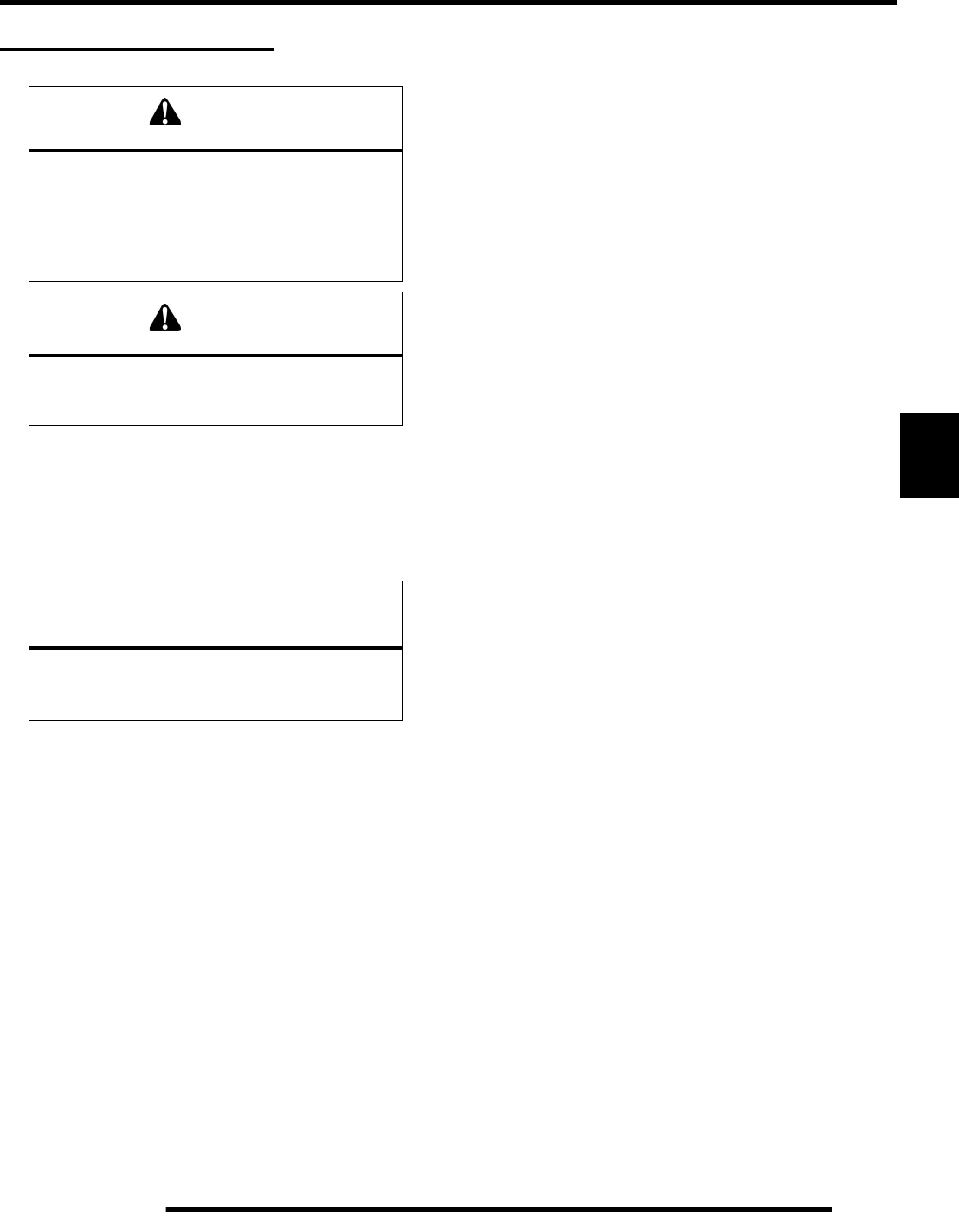
5.23
BODY / STEERING / SUSPENSION
5
DECAL REPLACEMENT
The side panels, front and rear fender cabs are plastic
polyethylene material. Therefore, they must be “flame treated”
prior to installing a decal to ensure good adhesion. A bonus of
the flame treating procedure is it can be used to reduce or
eliminate the whitish stress marks that are sometimes left after
a fender or cab is bent, flexed, or damaged.
To flame treat the decal area:
1. Pass the flame of a propane torch back and forth quickly
over the area where the decal is to be applied until the
surface appears slightly glossy. This should occur after just
a few seconds of flame treating. Do not hold the torch too
close to the surface (2-3 inches from the flame tip is
recommended). Keep the torch moving to prevent damage.
2. Apply the decal on one edge first. Slowly lay down
remainder of the decal while rubbing lightly over the decal
surface to eliminate any air bubbles during the application.
WARNING
The following procedure involves the use of an
open flame. Perform this procedure in a well
ventilated area, away from gasoline or other
flammable materials. Be sure the area to be
flame treated is clean and free of gasoline
or flammable residue.
WARNING
Do not flame treat components that are installed
on the vehicle. Remove the component from the
vehicle before flame treating.
CAUTION
Do not flame treat painted plastic components.
Painted plastic surfaces should only be wiped
clean prior to decal adhesion.

5.24
BODY / STEERING / SUSPENSION
SHOCKS / SPRINGS / FASTENERS
Exploded View
Shock Removal / Installation
1. Elevate the vehicle off the ground to relieve the suspension
load.
2. Remove the upper and lower fasteners retaining the shock
and remove the shock from the vehicle.
3. Reverse the procedure to reinstall the shock. Torque new
fasteners to 27-33 ft. lbs. (37-45 Nm).
Shock Replacement
1. Using a spring compressor, compress the shock spring far
enough to remove the spring retainer.
2. Remove the spring and adjusting cam from the existing
shock and install components onto the new shock.
3. Compress the shock spring and install the spring retainer.
IMPORTANT: The spring retainer gap should be 180°
from the end of the spring upon installation.
4. Reinstall the shock onto the vehicle and torque new
fasteners to 27-33 ft. lbs. (37-45 Nm).
Retainer gap
should be 180°
from spring end
Shock Spring
Compressor Tool
2870623

5.25
BODY / STEERING / SUSPENSION
5
FOX™ SHOCK EXPLODED VIEWS
FOX™ 2.0 ‘Piggyback’ Shock
Ref. Qty Description Ref. Qty Description
1. 1 Body Cap Asm. 16. 1 Screw Asm.
2. 1 Body Cap 17. 1 Reservoir End Cap Asm.
3. 1 Body 18. 1 Retaining Ring
4. 1 Eyelet 19. 1 Pellet Retainer Set Screw, Air Valve
5. 1 Shaft 20. 1 Nylon Ball, Air Valve
6. 1 Bearing Cap Asm. 21. 1 Preload Ring, Jam Nut
7. 1 Bearing Asm. 22. 1 Preload Ring
8. 1 Spacer 23. 1 Damping Adjust Asm., Piston
9. 1 Plate, Top-Out 24. 1 Damping Adjust Asm., Concentric Adjuster
10. 1 Valving Asm. 25. 2 Bearing, External
11. 1 Piston, Damping 26. 1 Bumper
12. 2 or 3 Plate, Back-Up 27. 2 Bearing, Spherical
13. 1 Lock Nut 28. 4 Retaining Ring
14. 1 Reservoir 29. 1 Decal
15. 1 Piston Asm, Floating (IFP) 30. - Shock Oil (2870995)
Preload Ring
10 ft. lbs. (14 Nm)
18 ft. lbs.
Loctite® 638™ / Primer N™
100 ft. lbs. (136 Nm)
(24 Nm)
Loctite® 638™ / Primer N™
50 ft. lbs. (68 Nm)

5.26
BODY / STEERING / SUSPENSION
FOX™ SHOCK SERVICE
General Service Information
Recommended Service Intervals
FOX™ Racing Shocks will perform the best if serviced at regular intervals:
• Every ride - Wash and dry the vehicle and suspension
• Every 100 hours - Visually inspect shock seals
• Every 500 hours or Annually - Change shock oil and replace seals
Front Shock Service Information Rear Shock Service Information
SHOCK DESIGN DETAILS
Travel 6.22”
Extended Length 19.66”
IFP Location 2.40”
Nitrogen Pressure 200 psi
Gas Shock Oil 2870995 (qt.)
SHOCK VALVING
COMPRESSION REBOUND
1.600 x 0.008 1.425 x 0.010
1.425 x 0.010 1.350 x 0.012
1.350 x 0.010 1.250 x 0.012
1.250 x 0.010 1.100 x 0.015
1.100 x 0.010 0.950 x 0.012
0.950 x 0.010 0.800 x 0.010
0.800 x 0.020 0.875 x .100 Back-Up
1.570 x 0.128 Top-Out 0.875 x .100 Back-Up
0.875 x .100 Back-Up
Piston Orifice: 2x 0.070
SHOCK DESIGN DETAILS
Travel 6.22”
Extended Length 21.34”
IFP Location 3.40”
Nitrogen Pressure 200 psi
Gas Shock Oil 2870995 (qt.)
SHOCK VALVING
COMPRESSION REBOUND
1.600 x 0.015 1.425 x 0.010
1.425 x 0.015 1.350 x 0.012
1.350 x 0.015 1.250 x 0.012
1.250 x 0.015 1.100 x 0.012
1.100 x 0.015 0.950 x 0.012
1.100 x 0.015 0.800 x 0.012
0.950 x 0.015 0.875 x 0.100 Back-Up
0.950 x 0.015 0.875 x 0.100 Back-Up
0.800 x 0.020
1.570 x 0.128 Top-Out
Piston Orifice: 2x 0.070

5.27
BODY / STEERING / SUSPENSION
5
FOX™ Shock Rebuild Information
When performing maintenance on FOX™ shocks, use the Gas
Shock Recharging Kit (PN 2200421), as it contains the
necessary valves, pressure gauge, and fittings to deflate and
pressurize shocks.
TIP: Extreme cleanliness is very important during all
disassembly and reassembly operations. This prevents dirt or
foreign particles from entering the shock, which causes
premature failure.
WARNING
FOX™ shocks contain high pressure nitrogen gas.
Extreme caution must be used while handling and
working with FOX™ shocks and related high pressure
service equipment. The pressure must be released from
the shock before disassembly. It is strongly
recommended you wear safety glasses and ear
protection during these procedures.
1. Safety Glasses
2. Latex Gloves
3. Lint Free Towels
4. Assembly Lube (lithium based grease)
5. Loctite #271
6. 12” Tie Wrap (Zip Tie)
7. MAPP Gas or Propane Torch
8. 1.834 TC Seal Kit
9. 5wt. Shock Fluid
Special Tools Required:
Body Holding Tool (PN 2871071)
Charging Needle (PN 7052069-A)
Gas Shock Recharging Kit (PN 2200421)
FOX™ Shock IFP Tool (PN 2871351)
Seal Installation Bullet Tool (PN 2201640) (PN 2201639)
10. IFP Depth Setting Tool
11. Seal Installation Bullet (5/8”)
12. Nitrogen Safety Needle
13. 5/8” Shaft Clamps
14. Adjustable Wrench
15. Pin Spanner Wrench (3/16” Pins)
16. 3/32” Hex Key (Allen Wrench)
17. 5/32” Hex Key (Allen Wrench)
18. Scribe or Dental Pick
19. 1/4” Flat Blade Screwdriver
20. #2 Phillips Screwdriver
21. 3/4” Open End Wrench
22. Standard Pliers
23. Small Needle Nose Pliers
24. Snap Ring Pliers
25. Socket
26. Torque Wrench
27. Torque Driver
28. Soft Faced Rubber Mallet
29. Nitrogen Tank w/ Regulator
30. Cleaning Solvent
31. Vise with soft jaws
32. Tape Measure

5.28
BODY / STEERING / SUSPENSION
FOX™ Shock Disassembly
NOTE: Read through all of these instructions first to
familiarize yourself with the rebuild procedure. Make
sure you have a clean work area, and all of the
necessary tools are available. Always use proper
safety equipment when working on shock
absorbers.
NOTE: Clean the entire shock assembly with soapy
water. Try to remove as much dirt and grime as
possible by scrubbing with a soft bristle brush.
Never pressure wash your shock, as this can force
water and debris inside which will damage the seals.
Dry the shock assembly with compressed air, if
available, or use clean towels.
1. If your shock DOES NOT have a spring installed, skip to
Step #4.
Measure the spring set length (Fig. 1). Record this number.
2. Back the preload adjustment ring off until spring is loose
on the body. Remove the lower spring retaining clip.
3. Remove the spring.
4. If the shock has spherical bearings in the body cap or shaft
eyelet, remove the reducer bushings and O-rings from both
ends of the shock. If your shock has polyurethane bushings
and sleeves, remove them from both ends of the shock
(Fig. 1).
5. Note and record the setting on the Compression Adjuster
Screw. Using the Flat Blade Screwdriver, count the clicks
as you turn the adjuster clockwise until it stops (Fig. 2).
Once you have written this number down, turn the screw
all the way counterclockwise until it stops.
6. Clean the entire shock assembly with soapy water. Try to
remove as much dirt and grime as possible by scrubbing
with a soft bristle brush. Never pressure wash your shock,
as this can force water and debris inside which will damage
the seals. Dry the shock assembly with compressed air, if
available, or use clean towels.
7. Use a 3/32” Hex Key to remove the button head screw from
the FOX™ air valve in the reservoir end cap.
8. Securely clamp FOX™ Nitrogen Safety Needle in vise.
9. Insert the FOX™ Safety Needle squarely into center of gas
valve (Fig. 3).
10. Using a blunt object, depress the air valve core to release
pressure.
11. When the shock is fully discharged, pull reservoir away
from the FOX™ Safety Needle in a straight, smooth
motion.
Figure 1
CAUTION
Point air valve away from face and body when
charging or discharging any shock.
Figure 2
Figure 3
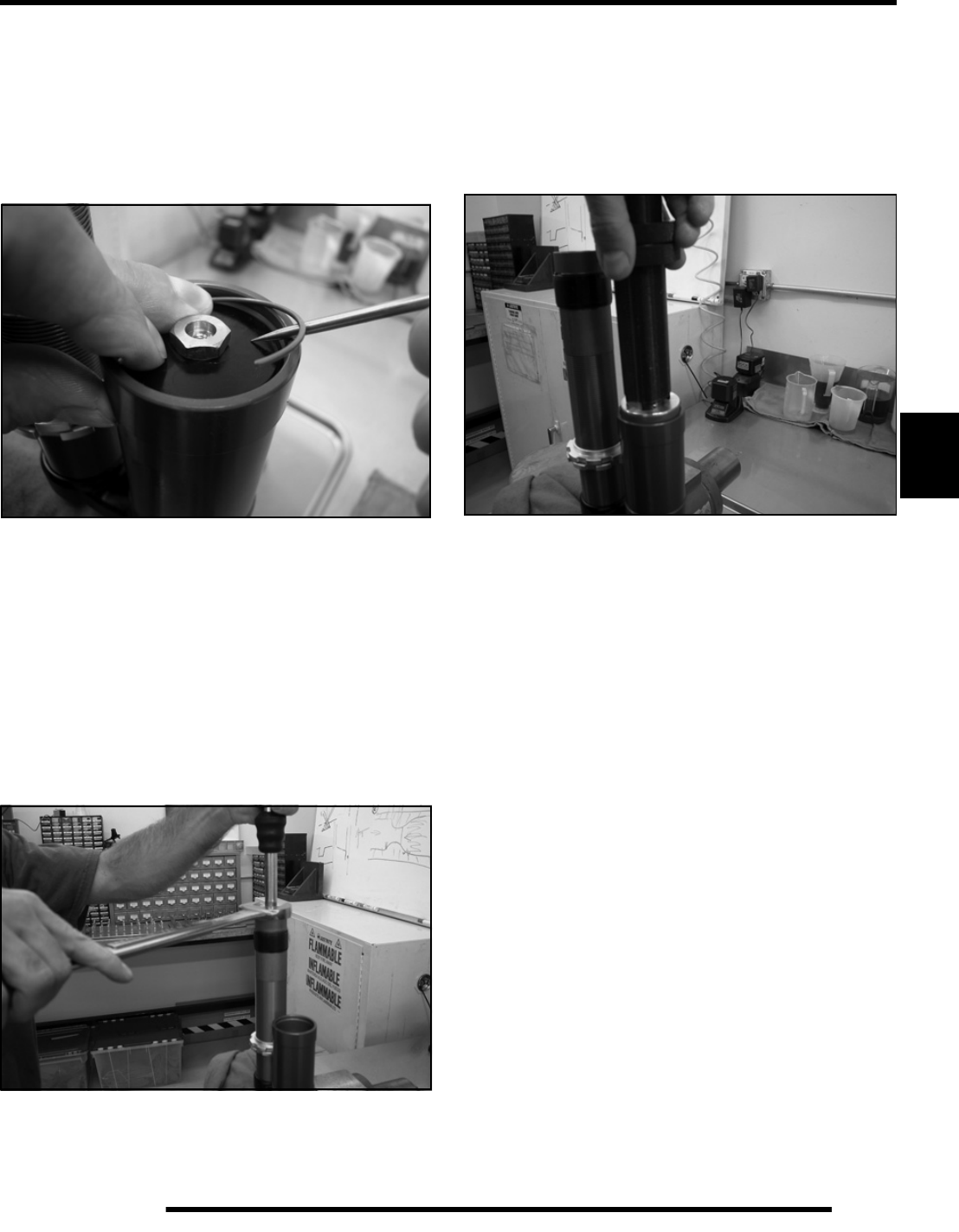
5.29
BODY / STEERING / SUSPENSION
5
12. Clamp the body cap of the shock securely in vise with shaft
side up.
13. Gently tap the reservoir end cap with a rubber mallet to
expose the wire retaining ring. Locate the end of the ring
and push inward with fingertip. Remove the retaining ring.
A scribe or dental pick can also be used for this step, but
use extreme caution not to scratch the bore of the reservoir
tube (Fig. 4).
14. Use pliers to grab flats of the gas valve of reservoir cap.
Extract cap from reservoir tube using a rocking or twisting
motion. Set reservoir cap aside on a clean, lint free paper
towel.
15. Use the appropriate size wrench to loosen the bearing
assembly (Fig. 5).
Unscrew the bearing assembly completely from the body
tube. Remove the shaft assembly from the body tube, and
place on a clean, lint free paper towel. Remove the shock
from the vise and pour shock oil from body tube into a
proper disposal container.
NOTE: DO NOT RE-USE OLD SHOCK OIL.
16. Clamp the body cap of the shock securely in vise with the
open end of the body tube pointing up.
17. Align the slot of the IFP Depth Setting Tool with the end
of the IFP (Internal Floating Piston). Engage the IFP by
rotating the tool 90 degrees (Fig. 6). Gently pull the IFP out
of the reservoir tube using the IFP Depth Setting Tool, and
place it on a clean, lint free towel. Remove the shock from
the vise and pour shock oil from body and reservoir tubes
into a proper disposal container. DO NOT RE-USE OLD
SHOCK OIL.
18. Using the 1/8” Hex Tool, remove the IFP bleed screw from
the IFP.
19. Clean the body tube, reservoir tube, and the IFP using
solvent. Dry with compressed air in a well ventilated area.
If compressed air is not available, dry parts using clean, lint
free paper towels and let sit in a well ventilated area to allow
the solvents to evaporate.
20. Set body assembly aside on a clean, lint free paper towel.
21. Clamp the shaft eyelet securely in vise with the piston end
up.
22. Using a 9/16” wrench, remove the piston lock nut from the
end of the shaft.
23. Hold the tip of a phillips head screwdriver against the end
of shaft. Hold the piston assembly under the top-out plate
and lift upwards (Fig. 7). Slide the piston assembly onto the
shaft of the Screwdriver. Pull the Screwdriver away from
shock shaft while supporting the piston assembly. Slide a
12” tie wrap through the entire piston assembly. Secure the
two ends of the zip tie together and remove the screwdriver.
There are many pieces to the piston assembly, and the
assembly order of these pieces is critical to the proper
performance of your shock. This step ensures that the
proper order is kept. Place piston assembly on a clean, lint
free paper towel.
Figure 4
Figure 5
Figure 6
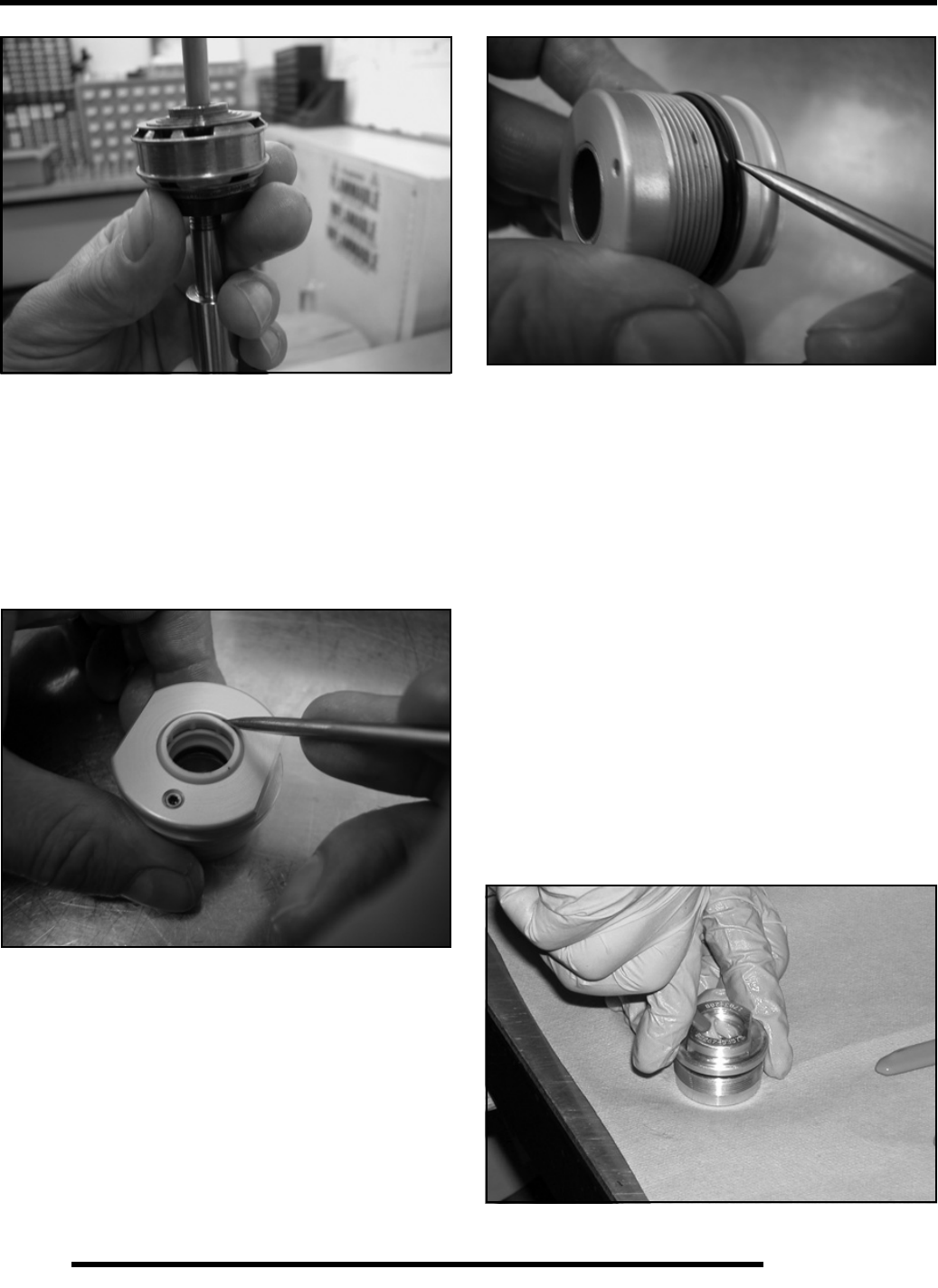
5.30
BODY / STEERING / SUSPENSION
24. Slide bearing assembly off of shaft. Use extreme caution
not to scratch inside of the bearing assembly when passing
it over the threads at end of shaft.
FOX™ Shock Rebuild
1. Use a scribe or dental pick to remove the U-cup wiper
(Fig. 8) and O-ring seals (Fig. 9) from the bearing housing.
Be careful not to scratch the seal grooves or the DU
bushing that is pressed into the bearing.
IMPORTANT: Use extreme caution when using a
scribe to remove seals. Always ”spear” the seal with
the point of the scribe. Do not wedge the point of the
scribe in behind the seal. This can scratch the surface
of the seal groove which will compromise the
performance and reliability of the shock absorber.
2. Thoroughly clean the bearing housing, and piston assembly
with solvent. Dry with compressed air in a well ventilated
area. If compressed air is not available, dry parts using
clean, lint free paper towels and let sit in a well ventilated
area to allow the remaining solvent to evaporate.
3. Use a scribe or dental pick to remove the O-ring seal from
the IFP.
4. Use a scribe or dental pick to remove the O-ring seals from
the reservoir end cap.
5. Install the new, well lubricated, O-rings into the bearing
housing. Correct placement of the shaft seal O-ring is in the
groove next to the DU bushing. Check to make sure the
seals are properly seated, and are not twisted. If a tool is
required to aid in proper seating of O-ring, use the non-
writing end of a pen, or a similar soft, blunt object, to push
it in.
6. Install the new U-cup seal into bearing. U-cup should be
installed so the cupped end is facing the DU bushing inside
of bearing. Check to make sure seal is properly seated. If a
tool is required to aid in proper seating of U-cup seal, use
the non-writing end of a pen, or a similar soft, blunt object,
to push it in (Fig. 10).
Figure 7
Figure 8
Figure 9
Figure 10

5.31
BODY / STEERING / SUSPENSION
5
7. Install the scraper in the bearing housing. Check for proper
orientation of the scraper in the bearing. The stepped side
of the scraper should be visible.
8. Install the new, well greased O-ring onto the IFP.
9. Replace the IFP bleed screw O-ring.
10. Install the new, well greased O-rings into the reservoir end
cap.
FOX™ Shock Reassembly
1. Clamp shaft eyelet securely in vise, and place seal bullet
tool on end of shaft.
2. Lubricate the bearing assembly seals with an ample amount
of assembly lube. Slide the bearing assembly onto shaft
with the scraper facing the eyelet (Fig. 11). This should be
done in a single smooth motion to avoid damaging the seals.
3. Insert the shaft of a Phillips head screwdriver through the
center of the piston assembly. The pointed end of the
screwdriver should be on the same side as the top-out plate.
Cut and remove the tie wrap that was holding the piston
assembly together.
4. Hold the piston assembly from underneath the top-out plate
and place the end of the screwdriver onto the end of the
shock shaft. Slide the piston assembly onto the shaft end.
Check to make sure the piston assembly is properly seated,
then install the piston lock nut. Torque the nut to 18 ft. lbs.
(24 Nm) using a torque wrench and 9/16” socket. Remove
shaft assembly from vise and set it aside on a clean, lint free
paper towel.
5. Clamp the body cap of the shock securely in the vise, with
the open end of the body facing up.
6. Using the flat blade screwdriver, turn the compression
adjuster screw counter clockwise until it stops turning.
7. Lubricate the new IFP O-ring with an ample amount of
assembly lube.
8. Fill the reservoir to the retaining ring groove with the
recommended oil. You should see bubbles rising to oil
surface. Wait until bubbling slows or stops completely. If
oil level has fallen, add more oil until level is at retaining
ring groove. Insert IFP into reservoir. Use a smooth motion
and push straight in until O-ring seats into the retaining ring
groove. Use your free hand to wrap new piston band around
IFP with the rounded edge out, and push the IFP into the
reservoir. Shock oil will come up through the IFP bleed
hole.
9. Push the IFP into the reservoir until you have enough oil
on top of the IFP so that the bleed hole is under the surface
of the oil (Fig. 12).
10. Quickly install the IFP Bleed Screw before the oil level
drops and tighten it with the 1/8” Hex Tool (Fig. 13).
NOTE: The IFP will spin in the reservoir when the
screw bottoms. This is OK.
11. Using the IFP Depth Setting Tool, push the IFP into the
reservoir until it stops.
Figure 11
Polaris Gas Shock Oil - 5 wt.
PN 2870995 - qt.
PN 2872279 - 2.5 gal.
Figure 12
Figure 13

5.32
BODY / STEERING / SUSPENSION
12. Fill shock body to the bottom of bearing threads with oil.
13. Using the IFP Depth Setting Tool, slowly pull the IFP up
to the mid point of the reservoir. Then push it down to the
bottom again (Fig. 14). Be careful not to pull the IFP out
completely. Also, be careful that the oil level in the shock
body does not disappear below the bottom of the body and
into the reservoir. If the oil does recede completely from the
body, you must remove the IFP and go back to step 7 of
reassembly.
14. As you push the IFP down, you should see bubbles rising
to the surface inside the body tube. Repeat this process
several times until you don’t see any new bubbles inside the
body tube.
15. Pull the IFP up until it’s top is approximately 1” from the
end of the reservoir and remove the IFP depth setting tool.
Again, be sure the oil level in the shock body does not drop
below the bottom of the body. If the oil does recede
completely from the body, you must remove the IFP and go
back to step 7 of reassembly. Add oil if necessary while
pulling up on the IFP.
16. Using the flat blade screwdriver, turn the Compression
Adjuster Screw clockwise until it stops turning.
17. Fill the body tube with oil approximately 1/4” below the
threads. Wrap the new piston band around the piston,
making sure the rounded edges face out. Insert the shaft
assembly into the body tube. Slowly push shaft into body
until piston assembly is approximately 1” below oil surface.
18. Stroke the shaft up and down slowly over about a 1” range
until no air bubble rise from the damping piston. Be careful
to keep the damping piston at least 1/4” below the surface
of the oil during this process.
19. Bring the damping piston up until it is approximately 1/4”
below the surface of the oil. Using the mallet, give 2 - 3
sharp blows to the eyelet, driving the damping piston down
into the shock body. This opens the valves on the damping
piston. You will see the released air bubbles come to the
surface of the oil.
20. Add oil to the body tube until the surface of the oil is to the
top of the threads inside the body tube.
21. Pull the damping piston up until it is just below the surface
of the oil. Add more oil if necessary.
22. Hold the shaft eyelet with one hand. With other hand, slide
the bearing assembly down the shaft until contact with the
body is made. Oil will overflow from around the bearing
(Figure 16).
23. Screw the bearing assembly into the body tube by hand,
holding the shaft up so that the bearing is in contact with
the bottom of the damping piston assembly. Be careful not
to cross-thread the bearing assembly. When the bearing will
no longer thread in by hand, turn the Compression Adjuster
Screw all the way counter clockwise using the flat blade
screwdriver.
24. Tighten the bearing assembly using the appropriate size
open end wrench.
25. Set IFP depth tool to specified length for the correct IFP
depth.
26. Insert IFP depth setting tool into reservoir and engage IFP.
Using a long 1/8” hex tool, remove the bleed screw from
the center of the IFP. TIP: Apply grease to the end of the
hex tool so that the bleed screw sticks to it. This will make
it easier to remove it from the IFP.
27. Push the IFP down to the correct depth setting. As you do
this, keep the open end of the IFP depth setting tool covered
with your hand. Oil will stream through the bleed hole in
the IFP as you push it further into the reservoir (Fig. 17).
Figure 14
Shock IFP Depth:
Front: 2.40” (6.10 cm)
Rear: 3.40” (8.64 cm)
Figure 16

5.33
BODY / STEERING / SUSPENSION
5
28. Install IFP bleed screw and tighten using the 1/8” hex tool.
Remove the IFP depth setting tool. Pour the residual oil out
of the reservoir tube into a proper disposal container.
29. Install the reservoir end cap with the FOX™ air valve
facing the outside of the reservoir tube. Push down on the
reservoir end cap using even pressure, until the retaining
ring groove is exposed. Install the wire retaining ring, and
check to make sure retaining ring is seated properly.
30. Push the shaft assembly completely into the body tube
(Fig. 18). It should go all the way down smoothly and
without interference. If it does not, disassemble and
reassemble per this procedure. Do not attempt to pull the
shaft assembly back out by hand.
31. If reservoir cap is not properly seated against the retaining
clip, tap it gently with a rubber mallet until it snaps into
place. Remove shock assembly from vise.
32. Securely clamp FOX™ Nitrogen Safety Needle in the vise.
Be sure to point the air valve away from your face and body.
33. Insert the safety needle squarely into center of FOX™ air
valve, and pressurize the reservoir. Continue filling until
the shaft has fully extended and the reservoir pressure is at
200 psi (Fig. 19).
34. Continue charging with gas as you pull the reservoir away
from the FOX™ Nitrogen Safety Needle using a smooth,
straight motion. Keep the reservoir as straight as possible
to prevent the safety needle from bending. As the safety
needle is pulled free from the FOX™ air valve, a popping
sound should be heard.
35. Install the button-head screw into the FOX™ air valve,
using a 3/32” hex key.
36. Remove the shock from the vise.
37. Clean all oil residue from the shock and reservoir with
solvent, and dry with compressed air in a well ventilated
area. If compressed air is not available, dry the shock and
reservoir using clean, lint free paper towels and let sit in a
well ventilated area to allow the solvents to evaporate.
38. Reinstall the spring and the spring retainer.
39. Thread the spring preload ring down against the spring, and
set the preload to the measurement you took when you
removed the spring.
40. Using the flat blade screwdriver, turn the Compression
Adjuster Screw all the way clockwise until it stops. Now
turn it counter clockwise while counting the clicks until it
matches the original setting which you wrote down during
disassembly.
41. Remove the shock from the vise.
42. Reinstall spherical bearing O-rings and reducers or
polyurethane bushings and sleeves.
NOTE: After installation, be sure to RIDE SLOWLY
initially to ensure the shock and the vehicle’s
suspension is performing correctly.
Figure 17
Figure 18
WARNING
CHARGE THE SHOCK USING NITROGEN GAS
ONLY. DO NOT FILL WITH ANY OTHER GASES.
Doing so compromises the performance of the shock
and may be EXTREMELY DANGEROUS!
Figure 19
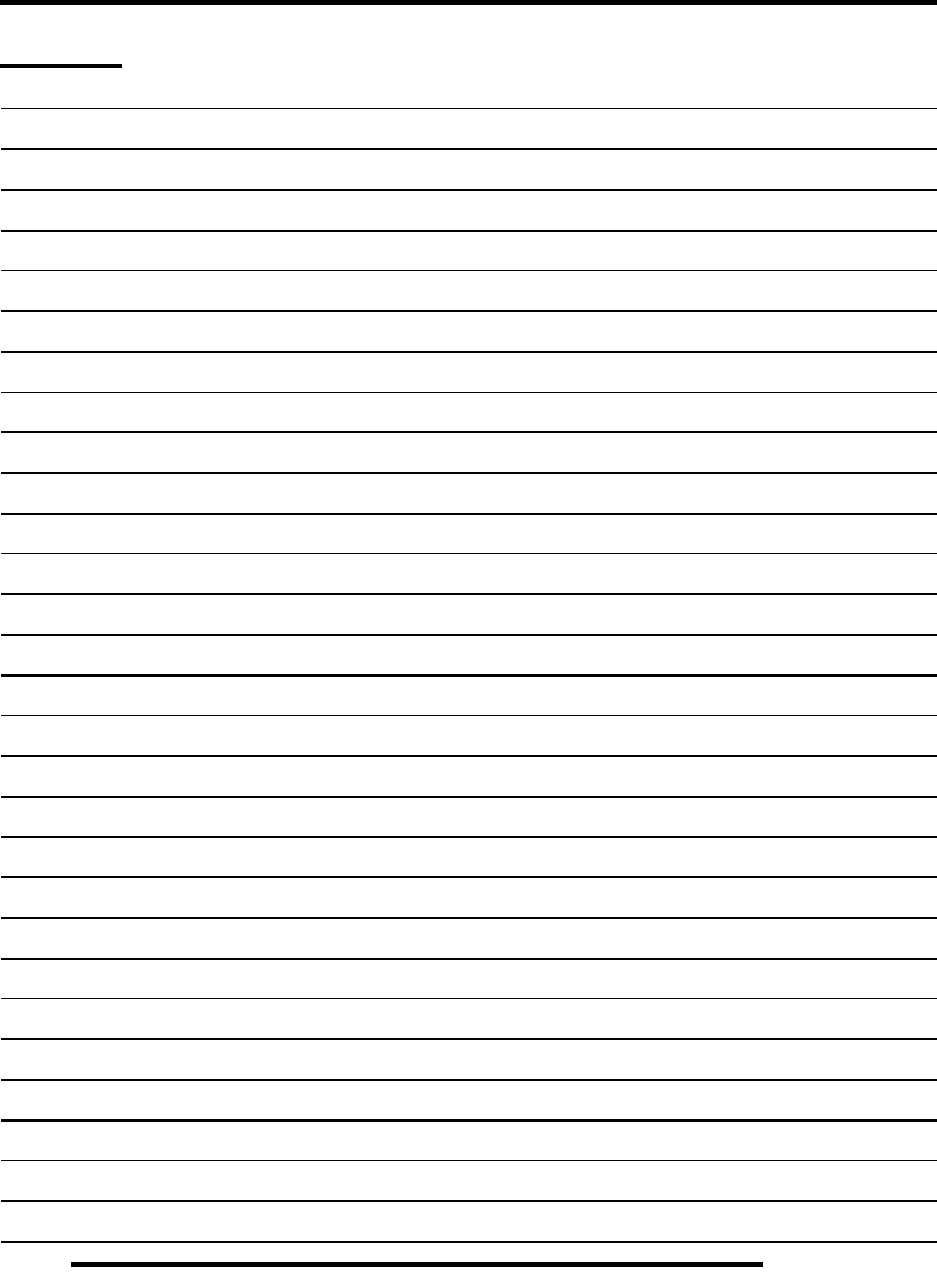
NOTES
BODY / STEERING / SUSPENSION
5.34

CLUTCHING
6.1
CHAPTER 6
CLUTCHING
6
SPECIAL TOOLS AND SUPPLIES . . . . . . . . . . . . . . . . . . . . . . . . . . . . . . . . . . . . . . . . . . 6.2
TORQUE SPECIFICATIONS. . . . . . . . . . . . . . . . . . . . . . . . . . . . . . . . . . . . . . . . . . . . . . . 6.2
PVT SYSTEM OVERVIEW . . . . . . . . . . . . . . . . . . . . . . . . . . . . . . . . . . . . . . . . . . . . . . . . 6.2
GENERAL OPERATION. . . . . . . . . . . . . . . . . . . . . . . . . . . . . . . . . . . . . . . . . . . . . . . . . . 6.2
DRIVE CLUTCH OPERATION . . . . . . . . . . . . . . . . . . . . . . . . . . . . . . . . . . . . . . . . . . . . . 6.2
DRIVEN CLUTCH OPERATION. . . . . . . . . . . . . . . . . . . . . . . . . . . . . . . . . . . . . . . . . . . . 6.3
PVT BREAK-IN (DRIVE BELT / CLUTCHES) . . . . . . . . . . . . . . . . . . . . . . . . . . . . . . . . . 6.3
MAINTENANCE / INSPECTION. . . . . . . . . . . . . . . . . . . . . . . . . . . . . . . . . . . . . . . . . . . . 6.3
OVERHEATING / DIAGNOSIS. . . . . . . . . . . . . . . . . . . . . . . . . . . . . . . . . . . . . . . . . . . . . 6.4
PVT SYSTEM SERVICE . . . . . . . . . . . . . . . . . . . . . . . . . . . . . . . . . . . . . . . . . . . . . . . . . . 6.5
PVT COVERS AND DUCTING COMPONENTS . . . . . . . . . . . . . . . . . . . . . . . . . . . . . . . 6.5
PVT DISASSEMBLY. . . . . . . . . . . . . . . . . . . . . . . . . . . . . . . . . . . . . . . . . . . . . . . . . . . . . 6.5
PVT ASSEMBLY. . . . . . . . . . . . . . . . . . . . . . . . . . . . . . . . . . . . . . . . . . . . . . . . . . . . . . . . 6.6
CLUTCH OFFSET PROCEDURE . . . . . . . . . . . . . . . . . . . . . . . . . . . . . . . . . . . . . . . . . . 6.7
DRIVE BELT . . . . . . . . . . . . . . . . . . . . . . . . . . . . . . . . . . . . . . . . . . . . . . . . . . . . . . . . . . . 6.9
BELT REMOVAL . . . . . . . . . . . . . . . . . . . . . . . . . . . . . . . . . . . . . . . . . . . . . . . . . . . . . . . 6.9
BELT INSPECTION . . . . . . . . . . . . . . . . . . . . . . . . . . . . . . . . . . . . . . . . . . . . . . . . . . . . . 6.9
BELT INSTALLATION . . . . . . . . . . . . . . . . . . . . . . . . . . . . . . . . . . . . . . . . . . . . . . . . . . . 6.9
PVT BREAK-IN (DRIVE BELT / CLUTCHES) . . . . . . . . . . . . . . . . . . . . . . . . . . . . . . . . . 6.9
DRIVE CLUTCH SERVICE . . . . . . . . . . . . . . . . . . . . . . . . . . . . . . . . . . . . . . . . . . . . . . . 6.10
SPRING SPECIFICATIONS . . . . . . . . . . . . . . . . . . . . . . . . . . . . . . . . . . . . . . . . . . . . . . 6.10
SHIFT WEIGHTS . . . . . . . . . . . . . . . . . . . . . . . . . . . . . . . . . . . . . . . . . . . . . . . . . . . . . . 6.11
NON-BRAKING EXPLODED VIEW (ALL MODELS) . . . . . . . . . . . . . . . . . . . . . . . . . . . 6.11
CLUTCH DISASSEMBLY. . . . . . . . . . . . . . . . . . . . . . . . . . . . . . . . . . . . . . . . . . . . . . . . 6.12
SPIDER REMOVAL . . . . . . . . . . . . . . . . . . . . . . . . . . . . . . . . . . . . . . . . . . . . . . . . . . . . 6.12
ROLLER, PIN, AND THRUST WASHER INSPECTION. . . . . . . . . . . . . . . . . . . . . . . . . 6.13
BUTTON TO TOWER CLEARANCE INSPECTION. . . . . . . . . . . . . . . . . . . . . . . . . . . . 6.14
SHIFT WEIGHT INSPECTION . . . . . . . . . . . . . . . . . . . . . . . . . . . . . . . . . . . . . . . . . . . . 6.14
BEARING INSPECTION. . . . . . . . . . . . . . . . . . . . . . . . . . . . . . . . . . . . . . . . . . . . . . . . . 6.14
CLUTCH INSPECTION . . . . . . . . . . . . . . . . . . . . . . . . . . . . . . . . . . . . . . . . . . . . . . . . . 6.15
MOVEABLE SHEAVE BUSHING INSPECTION . . . . . . . . . . . . . . . . . . . . . . . . . . . . . . 6.16
BUSHING SERVICE. . . . . . . . . . . . . . . . . . . . . . . . . . . . . . . . . . . . . . . . . . . . . . . . . . . . 6.16
CLUTCH ASSEMBLY. . . . . . . . . . . . . . . . . . . . . . . . . . . . . . . . . . . . . . . . . . . . . . . . . . . 6.18
DRIVEN CLUTCH SERVICE. . . . . . . . . . . . . . . . . . . . . . . . . . . . . . . . . . . . . . . . . . . . . . 6.20
EXPLODED VIEW . . . . . . . . . . . . . . . . . . . . . . . . . . . . . . . . . . . . . . . . . . . . . . . . . . . . . 6.20
CLUTCH DISASSEMBLY / INSPECTION . . . . . . . . . . . . . . . . . . . . . . . . . . . . . . . . . . . 6.20
CLUTCH ASSEMBLY. . . . . . . . . . . . . . . . . . . . . . . . . . . . . . . . . . . . . . . . . . . . . . . . . . . 6.22
TROUBLESHOOTING. . . . . . . . . . . . . . . . . . . . . . . . . . . . . . . . . . . . . . . . . . . . . . . . . . . 6.23

6.2
CLUTCHING
SPECIAL TOOLS AND SUPPLIES
TORQUE SPECIFICATIONS
PVT System Fastener Torques
PVT SYSTEM OVERVIEW
General Operation
The Polaris Variable Transmission (PVT) consists of three
major assemblies:
1) The Drive Clutch
2) The Driven Clutch
3) The Drive Belt
The internal components of the drive clutch and driven clutch
control engagement (initial vehicle movement), clutch upshift
and backshift. During the development of the Polaris vehicle,
the PVT system is matched first to the engine power curve; then
to average riding conditions and the vehicle’s intended usage.
Therefore, modifications or variations of components at random
are never recommended. Proper clutch setup and careful
inspection of existing components must be the primary
objective when troubleshooting and tuning.
Drive Clutch Operation
Drive clutches primarily sense engine RPM. The two major
components which control its shifting function are the shift
weights and the coil spring. Whenever engine RPM is
increased, centrifugal force is created, causing the shift
weights to push against rollers on the moveable sheave, which
is held open by coil spring preload. When this force becomes
higher than the preload in the spring, the outer sheave moves
inward and contacts the drive belt. This motion pinches the
drive belt between the spinning sheaves and causes it to rotate,
which in turn rotates the driven clutch.
At lower RPM, the drive belt rotates low in the drive clutch
sheaves. As engine RPM increases, centrifugal force causes the
drive belt to be forced upward on drive clutch sheaves.
TOOL DESCRIPTION PART NUMBER
Drive Clutch Puller (Short) PA-48595
Clutch Holding Wrench 9314177
Clutch Holding Fixture 2871358
Drive Clutch Spider Removal and
Installation Tool 2870341
Roller Pin Tool 2870910
Clutch Bushing Replacement
Too l K i t 2871226
Piston Pin Puller 2870386
Clutch Compression Tool 8700220
Clutch Bushing Replacement
Too l K i t 2871025
SPECIAL SUPPLIES PART NUMBER
Loctite™ 609 N/A
RTV Silicone Sealer 8560054
ITEM TORQUE VALUE
Drive Clutch Retaining Bolt 40 ft. lbs. (54 Nm)
Driven Clutch Retaining Bolt 17 ft. lbs. (23 Nm)
PVT Inner Cover Bolts 12 ft. lbs. (16 Nm)
PVT Outer Cover Bolts 45-50 in. lbs (5-5.6 Nm)
Drive Clutch Spider 200 ft. lbs. (271 Nm)
Drive Clutch Cover Plate 90 in. lbs. (10 Nm)
WARNING
All PVT maintenance or repairs should be performed by
a certified Polaris Master Service Dealer (MSD)
technician who has received the proper training and
understands the procedures outlined in this manual.
Because of the critical nature and precision balance
incorporated into the PVT components, it is
absolutely essential that no disassembly or repair
be made without factory authorized special tools
and service procedures.

6.3
CLUTCHING
6
Driven Clutch Operation
Driven clutches primarily sense torque, opening and closing
according to the forces applied to it from the drive belt and the
transmission input shaft. If the torque resistance at the trans-
mission input shaft is greater than the load from the drive belt,
the drive belt is kept at the outer diameter of the driven clutch
sheaves.
As engine RPM and horsepower increase, the load from the
drive belt increases, resulting in the belt rotating up toward the
outer diameter of the drive clutch sheaves and downward into
the sheaves of the driven clutch. This action, which increases the
driven clutch speed, is called upshifting.
Should the throttle setting remain the same and the vehicle is
subjected to a heavier load, the drive belt rotates back up toward
the outer diameter of the driven clutch and downward into the
sheaves of the drive clutch. This action, which decreases the
driven clutch speed, is called backshifting.
In situations where loads vary (such as uphill and downhill) and
throttle settings are constant, the drive and driven clutches are
continually shifting to maintain optimum engine RPM. At full
throttle a perfectly matched PVT system should hold engine
RPM at the peak of the power curve. This RPM should be
maintained during clutch upshift and backshift. In this respect,
the PVT system is similar to a power governor. Rather than vary
throttle position, as a conventional governor does, the PVT
system changes engine load requirements by either upshifting or
backshifting.
PVT Break-In (Drive Belt / Clutches)
A proper break-in of the clutches and drive belt will ensure a
longer life and better performance. Break in the clutches and
drive belt by operating at slower speeds during the 10 hours as
recommended (see Chapter 3 “Engine Break-In Period” for
break-in example). Pull only light loads. Avoid aggressive
acceleration and high speed operation during the break-in
period.
Maintenance / Inspection
Under normal use the PVT system will provide years of trouble
free operation. Periodic inspection and maintenance is required
to keep the system operating at peak performance. The
following list of items should be inspected and maintained to
ensure maximum performance and service life of PVT
components. Refer to the troubleshooting checklist at the end of
this chapter for more information.
1. Belt Inspection.
2. Drive and Driven Clutch Buttons and Bushings, Drive
Clutch Shift Weights and Pins, Drive Clutch Spider
Rollers and Roller Pins, Drive and Driven Clutch
Springs.
3. Sheave Faces. Clean and inspect for wear.
4. PVT System Sealing. Refer to the appropriate
illustration(s) on the following pages. The PVT system is
air cooled by fins on the drive clutch stationary sheave. The
fins create a low pressure area in the crankcase casting,
drawing air into the system through an intake duct. The
opening for this intake duct is located at a high point on the
vehicle (location varies by model). The intake duct draws
fresh air through a vented cover. All connecting air ducts
(as well as the inner and outer covers) must be properly
sealed to ensure clean air is being used for cooling the PVT
system and also to prevent water and other contaminants
from entering the PVT area. This is especially critical on
units subjected to frequent water forging.
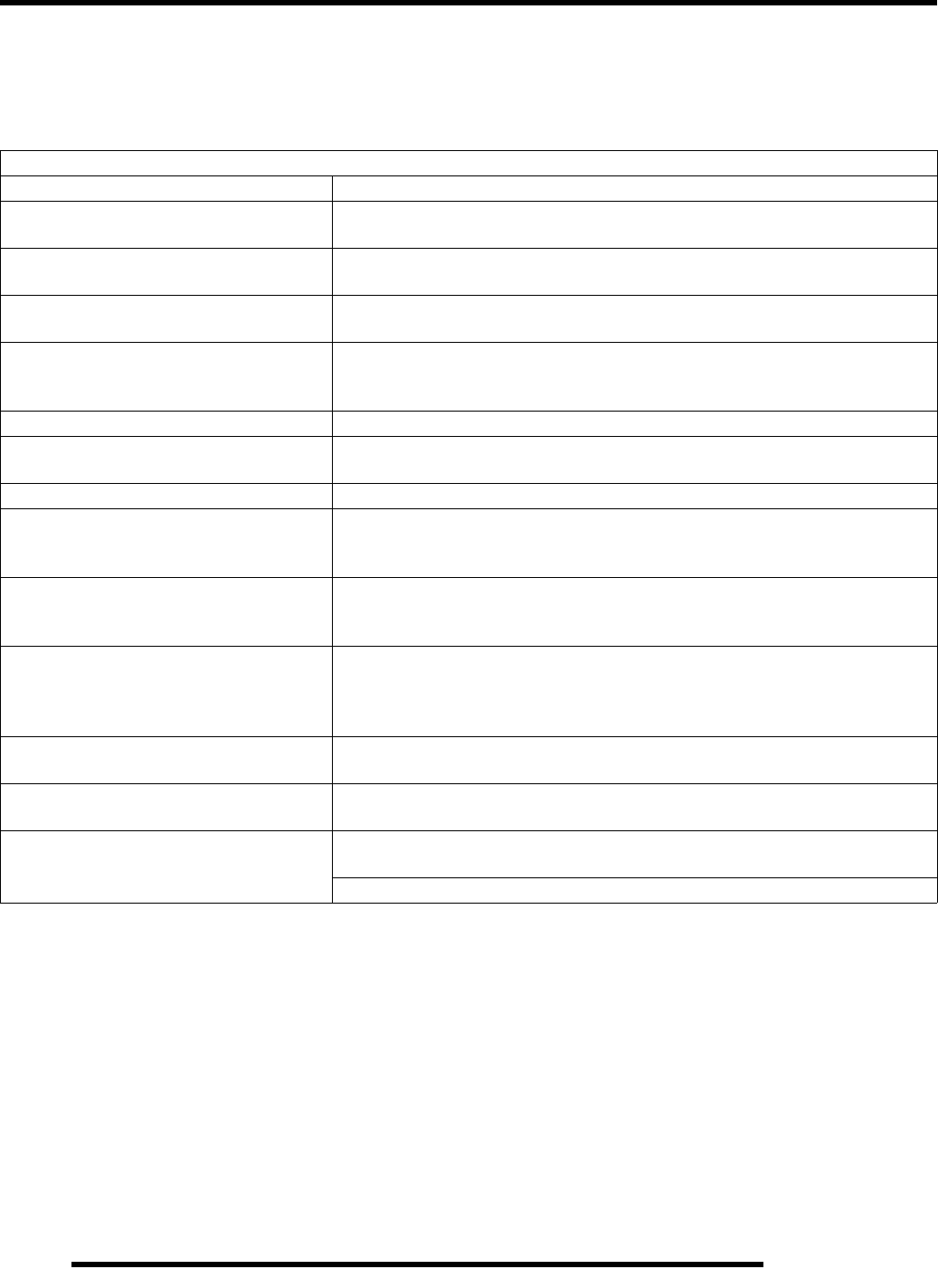
6.4
CLUTCHING
Overheating / Diagnosis
During routine maintenance, or whenever PVT system overheating is evident, it’s important to check the inlet and outlet ducting
for obstructions. Obstructions to air flow through the ducts will significantly increase PVT system operating temperatures. The
vehicle should be operated in Low when plowing or pulling heavy loads, or if extended low speed operation is anticipated.
Operating in Low Gear
Low gear should be used when pulling heavy loads, riding through rough terrain, or when basic operational ground speeds are less
than 7 MPH. Use High gear when basic operational ground speeds are more than 7 MPH.
IMPORTANT: Using High gear for heavy loads, hilly terrain, or in wet, muddy conditions will increase the chance
of drive belt burning.
CLUTCH DRIVE BELT & COVER RELATED ISSUES: DIAGNOSIS
Possible Causes Solutions / What to do
Loading the vehicle into a truck or tall
trailer when in high range. Shift transmission to Low during loading of the vehicle to prevent belt burning.
Starting out going up a steep incline from
a stopped position.
When starting out on an incline, use Low gear. Shift transmission to Low
during loading of the vehicle to prevent belt burning.
Driving at low RPM or low ground speed
(at approximately 3-7 MPH).
Drive at higher speed or use Low. The use of Low is highly recommended for
cooler PVT operating temperatures and longer component life.
Insufficient engine warm-up when
exposed to low ambient temperatures.
Warm engine at least 5 min., then with transmission in neutral, advance
throttle to approx. 1/8 throttle in short bursts, 5 to 7 times. The belt will
become more flexible and prevent belt burning.
Slow and easy clutch engagement. Fast, effective use of the throttle for efficient engagement.
Towing/Pushing at low RPM or low
ground speed. Use Low only.
Plowing snow, dirt, etc./utility use. Use Low only.
Stuck in mud or snow.
Shift the transmission to Low, carefully use fast, aggressive throttle
application to engage clutch. WARNING: Excessive throttle may cause loss
of control and vehicle overturn.
Climbing over large objects from a
stopped position.
Shift the transmission to Low, carefully use fast, aggressive, brief throttle
application to engage clutch. WARNING: Excessive throttle may cause loss
of control and vehicle overturn.
Belt slippage from water or snow
ingestion into the PVT system.
Shift the transmission to neutral. Using the throttle, vary the engine rpm from
idle to full throttle. Repeat several times as required. During this procedure,
the throttle should not be held at the full position for more than 10 seconds.
Clutch seals should be inspected for damage if repeated leaking occurs.
Clutch malfunction. Clutch component inspection should be performed by a Polaris MSD certified
technician.
Poor engine performance. Fouled spark plugs, foreign material in fuel tank, restricted fuel lines, or faulty
fuel pump may cause symptoms similar to clutching malfunction.
GENERAL RANGE OPERATION
GUIDELINES:
Low: Heavy pulling, basic operational speeds less than 7 MPH, riding
through rough terrain (swamps, mountains, ect.), or low ground speeds.
High: High ground speeds, or speeds above 7 MPH.
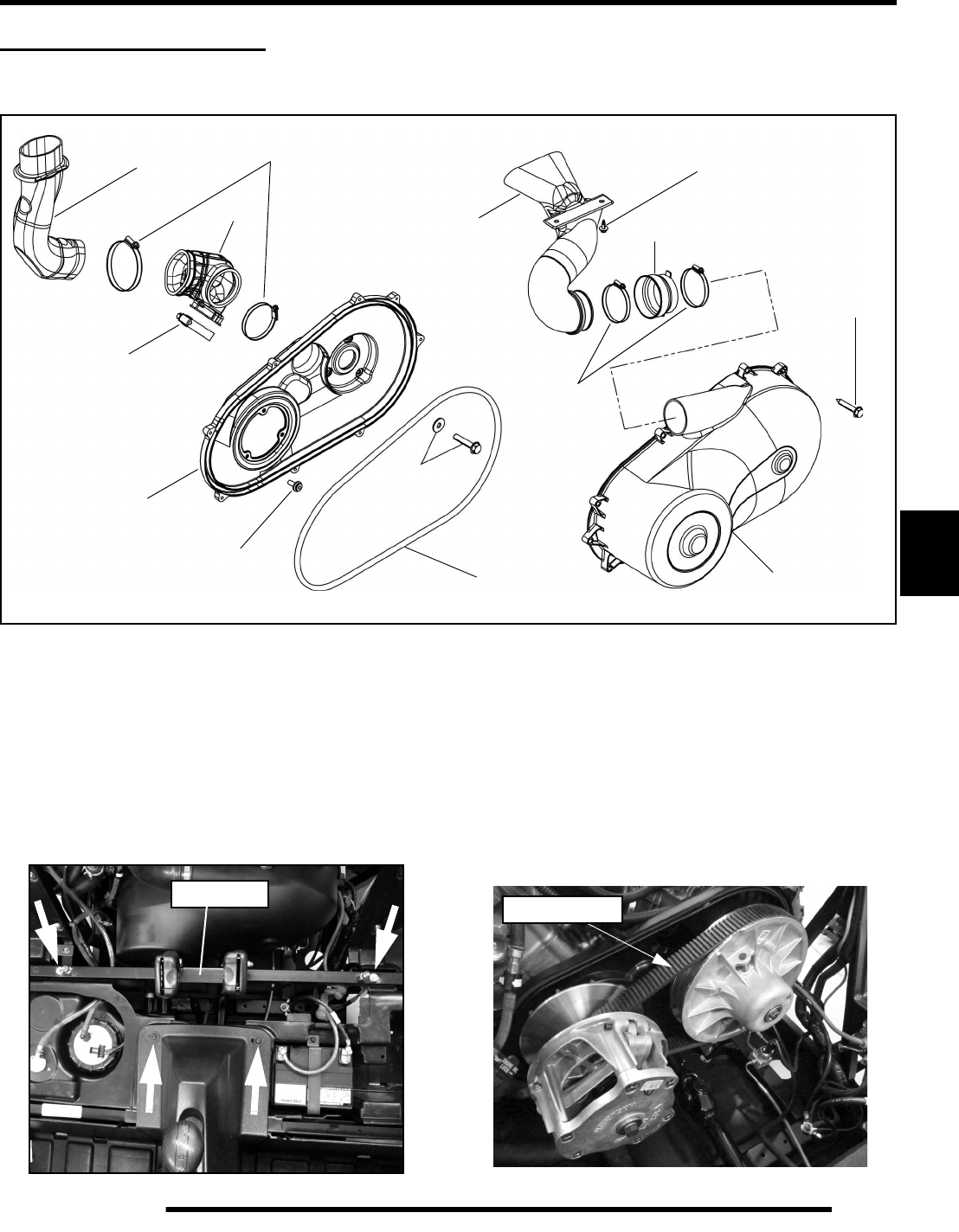
6.5
CLUTCHING
6
PVT SYSTEM SERVICE
PVT Covers and Ducting Components
PVT Disassembly
Some fasteners and procedures will vary. Refer to the Electronic
Parts Catalog for proper fastener placement.
1. Remove the driver’s seat.
2. Remove the passenger seaT and rear service panel to gain
access to the outer clutch cover (see Chapter 5).
3. Remove the (2) screws from the rear of the center console.
4. Remove the (2) fasteners from the rear seat base as shown
and remove it from the vehicle.
5. Loosen the hose clamp on the clutch outlet duct.
6. Remove the outer clutch cover screws and remove the
clutch cover.
7. Mark the drive belt direction of rotation and remove drive
belt (see “DRIVE BELT - Belt Removal”).
Inner
Clutch
Clamps
Outer
Cover
Outer
Push
Rivets
Outlet Duct
Clutch
Inlet Duct
Screws
Clutch Cover
Clutch Cover
Retainer
Screws
Cover Seal
Boot
Boot
Clamps
Bolt &
Washer
Clamp
Seat Base
Mark Rotation
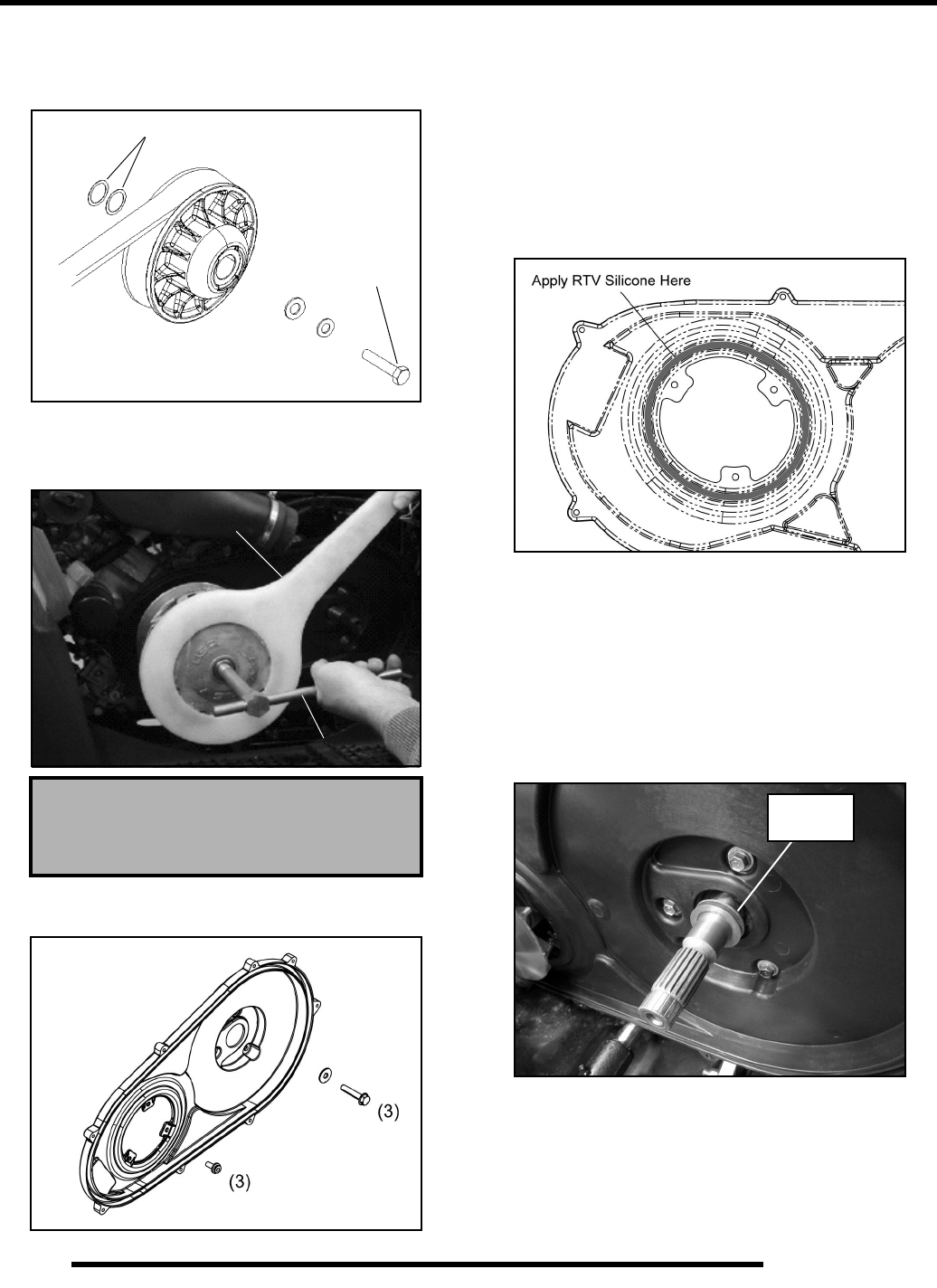
6.6
CLUTCHING
8. Remove the driven clutch retaining bolt and driven clutch.
9. Remove driven clutch offset spacers from the transmission
input shaft.
10. Install the Drive Clutch Holder (PN 9314177) (A).
11. Remove drive clutch retaining bolt and remove drive clutch
using the Drive Clutch Puller (PA-48595) (B).
12. Remove the (3) screws and (3) bolts that retain the inner
clutch cover to the engine and transmission.
PVT Assembly
1. Inspect inner clutch cover. Replace if cracked or damaged.
2. Inspect the seal on the transmission input shaft. Replace if
damaged.
3. Apply RTV silicone sealant to the back side of the inner
clutch cover to ensure a water tight fit between the engine
and inner clutch cover. Both surfaces must be clean to
ensure adhesion of silicone sealant.
4. Install and properly align the inner clutch cover.
5. Install the bolts and washers that retain the cover to the
transmission. Torque bolts to specification (see next page).
6. Install the screws that retain the cover to the engine. Torque
screws to specification (see next page). Remove any excess
silicone sealant.
7. Install clutch offset washers on the transmission input shaft.
8. Clean the splines inside the driven clutch and on the
transmission input shaft.
9. Apply a light film of grease to the splines on the shaft.
10. Install the driven clutch, washer, lock washer, and retaining
bolt. Torque to specification (see next page).
Drive Clutch Puller ( PA-48595)
Drive Clutch Holder (9314177)
Keep Spacers In Order (Note Thickness)
Retaining
Bolt
A
B
Offset
Washers

6.7
CLUTCHING
6
11. Clean end of taper on crankshaft and the taper bore inside
drive clutch.
12. Install drive clutch and torque retaining bolt to
specification.
13. Reinstall drive belt noting direction of belt rotation (see
“DRIVE BELT - Belt Installation”). If a new belt is
installed, install so numbers can be easily read.
14. Replace the outer clutch cover rubber gasket with the
narrow side out.
15. Reinstall outer clutch cover and secure with screws. Torque
screws to specification.
16. Install the clutch cover outlet duct and tighten the clamps.
17. Reinstall the rear seat base assembly and torque the
mounting bolts to 40 ft. lbs. (54 Nm).
Clutch Offset Procedure
If the vehicle exhibits drive clutch drag or hard shifting while at
idle speed, a clutch offset adjustment is required. Washers
located behind the driven clutch on the transmission input shaft
may need to be added or removed in order to obtain the proper
offset. Refer to the “Clutch Offset Procedure” provided below.
1. Follow steps 1-6 of the “PVT Disassembly” procedure.
2. Inspect the drive clutch belt to sheave clearance. If the belt
is contacting either sheave, remove the drive belt and driven
clutch.
3. Add or remove offset washers behind the driven clutch
accordingly to avoid belt contact with either drive clutch
sheave.
•.030" Offset Washer - PN 7556454
•.060" Offset Washer - PN 7556120
Inner Cover Bolt Torque (Rear):
12 ft. lbs. (16.6 Nm)
Outer Cover Bolt Torque:
45-50 in. lbs. (5-5.6 Nm)
Driven Clutch Retaining Bolt Torque:
17 ft. lbs. (23.5 Nm)
Drive Clutch Retaining Bolt Torque:
40 ft. lbs. (54 Nm)
CAUTION
Do not start the engine with the outer clutch cover
removed. Serious injury may result.
Incorrect
Offset
Offset
Washers

6.8
CLUTCHING
4. Reinstall the driven clutch and drive belt. Torque the driven
clutch retaining bolt to 17 ft. lbs. (23.5 Nm). Be sure to
rotate the driven clutch counterclockwise several times to
ensure the belt is tight and riding at the proper height in the
clutch.
5. Inspect the belt to sheave clearance again. If the belt rests
evenly between the drive clutch stationary and moveable
sheaves, the offset is correct and the vehicle can be
reassembled (see Step 7). If the belt is still contacting either
sheave, remove the drive belt and driven clutch. Add or
remove offset washers behind the driven clutch
accordingly.
• .030" Offset Washer - PN 7556454
•.060" Offset Washer - PN 7556120
6. Reinstall the driven clutch and drive belt. Torque the driven
clutch retaining bolt to 17 ft. lbs. (23.5 Nm). Be sure to
rotate the driven clutch counterclockwise several times to
ensure the belt is tight and riding at the proper height in the
clutch. The belt should now be resting evenly between the
drive clutch stationary and moveable sheaves.
7. Inspect the outer clutch cover gasket. Replace if damaged.
8. Install the outer clutch cover and torque the cover screws
to 45-50 in. lbs. (5-5.6 Nm).
9. Install the clutch cover outlet duct and tighten the clamps.
10. Sit in the driver’s seat, apply the brake and start the engine.
Place the gear selector in high range and test the vehicle for
drive clutch drag or hard shifting while at idle speed. If
shifting remains difficult, refer to the note below.
NOTE: If the vehicle or drive clutch is new (less than
0.2 hours), remain in the driver's seat with the gear
selector in high range. Allow the engine to idle for
five minutes to break in the drive clutch hub bearing.
11. Reinstall the rear seat base assembly and torque the
mounting bolts to 40 ft. lbs. (54 Nm).
12. Reinstall the rear service panel and seats.
17 ft. lbs.
(23.5 Nm)
Proper
Height
Correct
Offset
CAUTION
Do not leave the vehicle unattended.

6.9
CLUTCHING
6
DRIVE BELT
Belt Removal
1. Remove outer clutch cover as described in the “PVT
Disassembly” section.
2. Mark the drive belt direction of rotation so that it can be
installed in the same direction.
NOTE: Belt is normally positioned so that the part
number can be easily read.
3. To remove drive belt, place the transmission in “Park” and
push down on the belt firmly to open the clutch sheaves.
4. Then lift upward on the belt while pulling it out and down
over the driven clutch outer sheave.
Belt Inspection
1. Inspect belt for hour glassing (extreme circular wear in at
least one spot and on both sides of the belt). Hour glassing
occurs when the drive train does not move and the drive
clutch engages the belt.
2. Inspect belt for loose cords, missing cogs, cracks,
abrasions, thin spots, or excessive wear. Compare belt
measurements with a new drive belt. Replace if necessary.
3. Belts with thin spots, burn marks, etc., should be replaced
to eliminate noise, vibration, or erratic PVT operation. See
the Troubleshooting Chart at the end of this chapter for
possible causes.
Belt Installation
NOTE: Be sure to position belt in the same position
as when removed or so part number is easily read.
1. Loop belt over the drive clutch and over top of the driven
sheave.
2. While pushing down on top of belt, turn the back, or
moveable driven sheave, clockwise.
3. The belt then should be able to be pushed down into and
between the sheaves.
4. Continue rotating the driven clutch and belt clockwise until
the belt is fully installed.
PVT Break-In (Drive Belt / Clutches)
A proper break-in of the clutches and drive belt will ensure a
longer life and better performance. Break in the clutches and
drive belt by operating at slower speeds during the 10 hour
break-in period as recommended (see Chapter 3 “Engine
Break-In Period” for break-in example). Pull only light loads.
Avoid aggressive acceleration and high speed operation during
the break-in period.
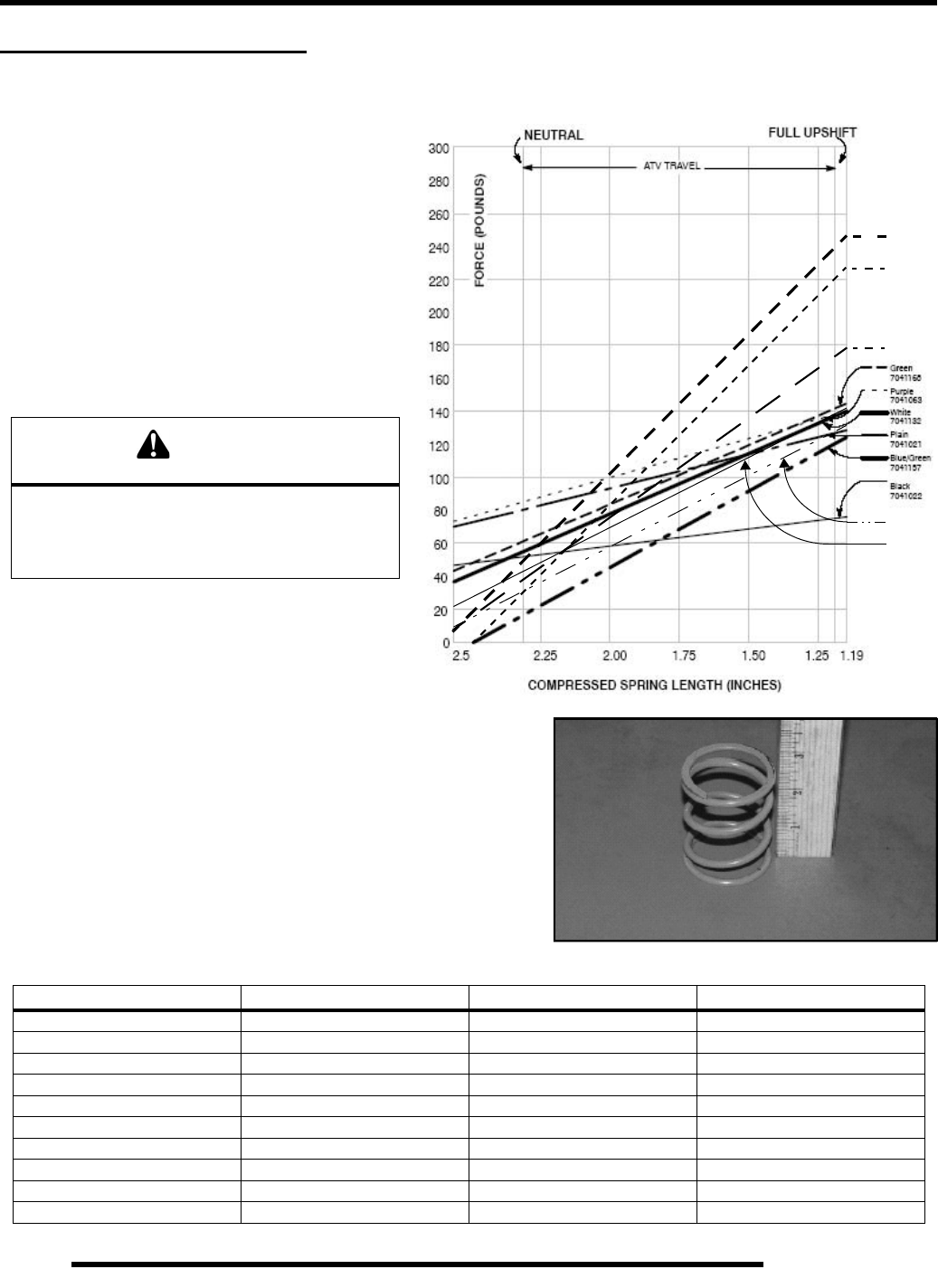
6.10
CLUTCHING
DRIVE CLUTCH SERVICE
Spring Specifications
The drive clutch spring has two primary functions:
1. To control clutch engagement RPM. The springs,
which have a higher rate when the clutch is in
neutral, will increase clutch engagement RPM.
2. To control the rate at which the drive belt moves
upward in the drive clutch sheaves. This is referred
to as drive clutch upshift.
There are other components which control upshift, but the
spring is one of the primary components in insuring
optimum performance. It is very important that the spring
is of the correct design and is in good condition.
The drive clutch spring is one of the most critical components of the PVT
system. It is also one of the easiest to service. Due to the severe relaxation the
spring is subject to during operation, it should always be inspected for
tolerance limits during any clutch operation diagnosis or repair.
With the spring resting on a flat surface, measure its free length from the outer
coil surfaces as shown. Refer to the spring specification chart for specific free
length measurements and tolerances. Also check to see that spring coils are
parallel to one another. Distortion of the spring indicates stress fatigue,
requiring replacement.
CAUTION
Never shim a drive clutch spring to increase its
compression rate. This may result in complete
stacking of the coils and subsequent clutch
cover failure.
Primary Clutch Springs
PART NUMBER COLOR CODE WIRE DIAMETER FREE LENGTH ± .125”
7041021 Plain .157" 4.38"
7041022 Black .140" 4.25"
7041063 Purple .168" 4.37"
7041132 White .177" 2.92"
7041157 Blue / Green .177" 2.53"
7041168 Green .177" 3.05"
7043199 Blue / Red .177" 2.53"
7043349 Red / White .200" 2.58"
7043372 Red / Blue .187" 2.56"
7043382 Red / Green .177" 2.63"
Red/White
7043349
Red/Blue
7043372
Red/Green
7043382
Black
7043594
Blue/Red
7043199

6.11
CLUTCHING
6
Shift Weights
Shown below are the shift weights which have been designed for the PVT system. These shift weights have many factors designed
into them for controlling engagement RPM and shifting patterns. Shift weights should not be changed or altered without first having
a thorough understanding of their positioning and the effects they may have on belt to sheave clearance, clutch balance and shifting
pattern.
Non-Braking Exploded View (All Models)
7043594 Black .177" 2.80"
Primary Clutch Springs
Washers
Bearing
Spring
Cover
Bearing
Bushing Lock
Washer
Bolt
Flat
Washer
Cover
Screws
Button
Pin
Washers
Roller
Nut
Shift
Weight
Bolt
Spacer
Spider
Button
Non-Braking
Bearing

6.12
CLUTCHING
Clutch Disassembly
1. Using a permanent marker, mark the cover, spider, and
moveable and stationary sheaves for reference, as the cast
in X's may not have been in alignment before disassembly.
2. Mark the stationary sheave and clutch shaft to verify the
shaft has not turned in the sheave after tightening the spider
during clutch assembly.
3. Remove cover bolts evenly in a cross pattern and remove
cover plate.
4. Inspect cover bushing (A). The outer cover bushing is
manufactured with a Teflon coating. Wear is determined
by the amount of Teflon remaining on the bushing.
5. Inspect area on shaft where bushing rides for wear, galling,
nicks, or scratches. Replace clutch assembly if worn or
damaged.
6. Remove and inspect the clutch spring. See “Drive Clutch
Spring Specifications” for spring inspection.
Spider Removal
1. Install clutch in holding fixture (PN 2871358) and loosen
the spider (counterclockwise) using Clutch Spider
Removal Tool (PN 2870341).
Cover Bushing Inspection:
Replace the cover bushing if more
brass than Teflon is visible on
the bushing. Refer to bushing
replacement in this chapter.
A
Clutch Holding Fixture:
(PN 2871358)
Spider Removal Tool:
(PN 2870341)
Inspect Shaft
Spider Removal Tool may
differ from what is shown

6.13
CLUTCHING
6
NOTE: It is important that the same number and
thickness of washers are reinstalled beneath the
spider during assembly. Be sure to note the number
and thickness of these washers.
Moveable Sheave Bushing Inspection
2. Inspect the Teflon™ coating on the moveable sheave
bushing.
Roller, Pin, and Thrust Washer Inspection
1. Inspect all rollers, bushings and roller pins by pulling a flat
metal rod across the roller. Turn roller with your finger. If
you notice resistance, galling, or flat spots, replace rollers,
pins and thrust washers in sets of three. Also inspect to see
if roller and bushing are separating. Bushing must fit
tightly in roller. Use the Roller Pin Tool (PN 2870910) to
replace rollers and pins. Take care not to damage roller
bushing or bearing surface of the new pin during
installation.
2. Rubber backed buttons can be used in all RANGER clutches
if the hollow roller pin is changed to the solid roller pin.
NOTE: The rubber side of the button is positioned
toward the solid roller pin.
Moveable Sheave Bushing Inspection:
Replace the cover bushing if more brass
than Teflon is visible on the bushing.
Refer to bushing replacement
in this chapter.
To maintain proper clutch balance and
belt-to-sheave clearance, be sure to
reinstall original quantity and thickness
washers
TeflonTM
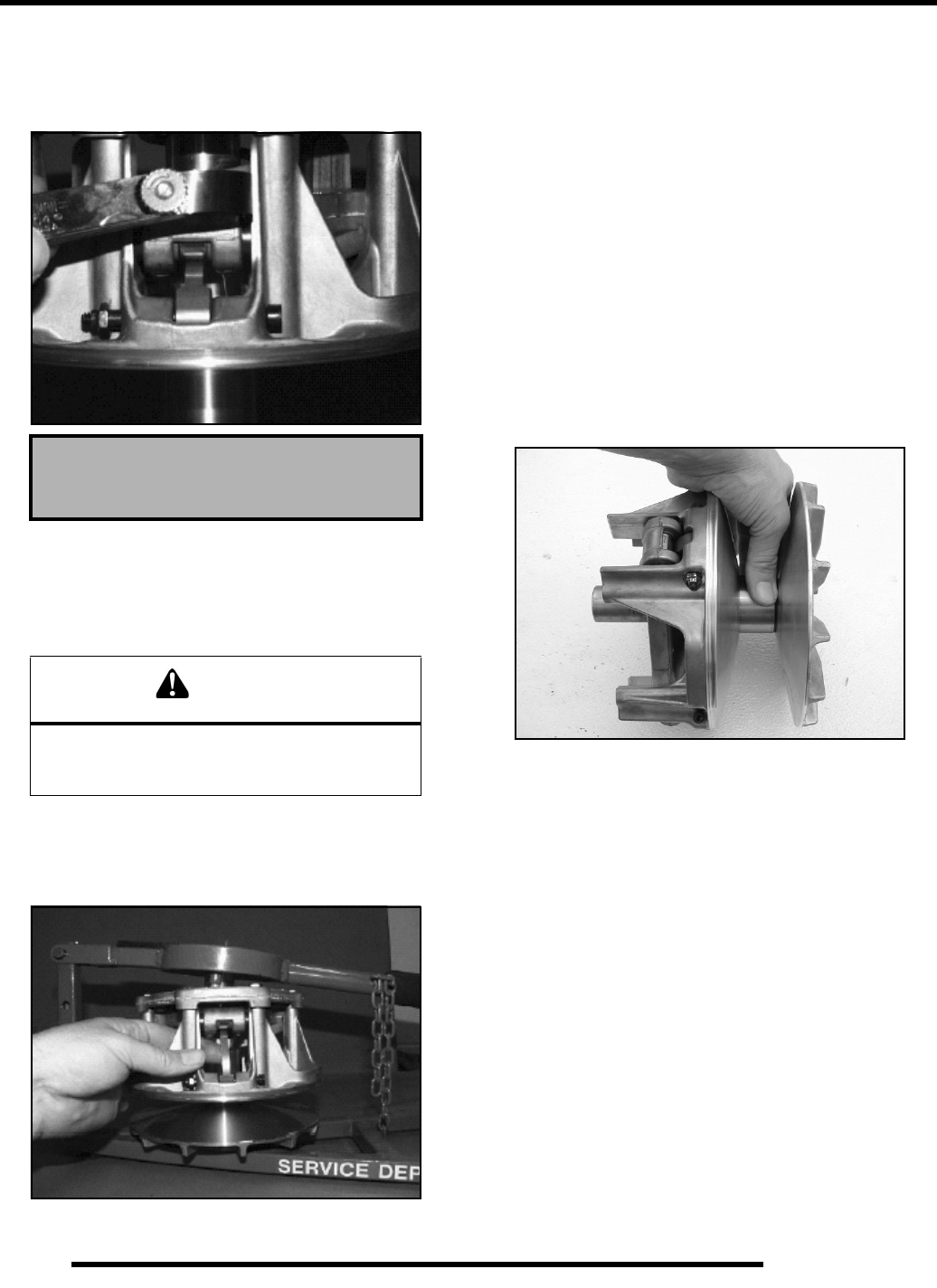
6.14
CLUTCHING
Button To Tower Clearance Inspection
1. Inspect for any clearance between spider button to tower.
If clearance exists, replace all buttons and inspect surface
of towers. See “Spider Removal” procedure.
2. Inspect sheave surfaces. Replace the entire clutch if worn,
damaged or cracked.
Shift Weight Inspection
1. If clutch is not disassembled, inspect as shown, using a
clutch holding tool to compress the moveable sheave. The
contact surface of the weight should be smooth and free of
dents or gall marks.
2. Remove shift weight bolts and weights. Inspect the contact
surface of the weight. The surface should be smooth and
free of dents or gall marks. Inspect the weight pivot bore
and pivot bolts for wear or galling. If weights or bolts are
worn or broken, replace in sets of three with new bolts.
NOTE: A damaged shift weight is usually caused by
a damaged or stuck roller in the spider assembly.
See “Roller, Pin and Thrust Washer Inspection”.
Bearing Inspection
1. Rotate the clutch bearing in both clockwise and counter-
clockwise directions. The non-braking bearing should
rotate in both directions on the shaft with only a slight
amount of drag.
2. Verify there is no binding or rough spots. If problems are
noted continue with disassembly.
Button to Tower Clearance:
000-.001”
WARNING
The clutch assembly is a precisely balanced
unit. Never replace parts with used parts from
another clutch assembly!
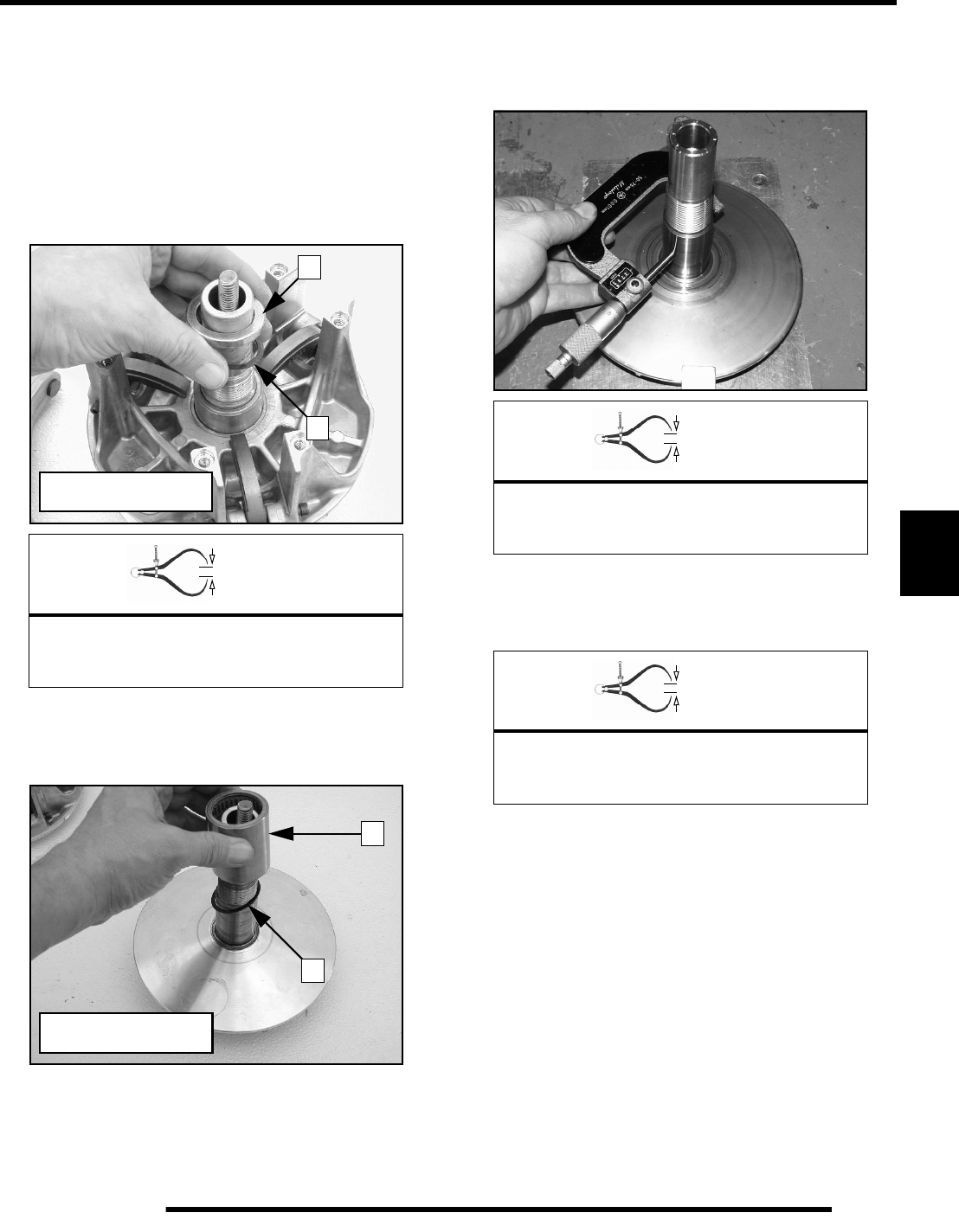
6.15
CLUTCHING
6
Clutch Inspection
NOTE: Remove cover, spring, and spider following
instructions for drive clutch removal, then proceed
as follows:
1. Remove the moveable sheave spacer sleeve (1) and the
thrust washer (2). Visually inspect the washer for damage.
2. Measure the thickness and compare to specification.
Replace if worn or damaged.
3. Remove the moveable clutch sheave.
4. Lift bearing (3) and thrust washer (4) off shaft. Replace as
an assembly if worn, damaged, or if problems were noted.
5. Inspect surface of shaft for pitting, grooves, or damage.
Measure the outside diameter and compare to
specifications. Replace the drive clutch assembly if shaft is
worn or damaged.
6. Visually inspect PTFE thrust washer for damage. Measure
the thickness and compare to specification. Replace if worn
or damaged.
= In. / mm.
Thrust Washer Thickness
Standard: .030” (.76 mm)
Service Limit: .025” (.64 mm)
1
2
Thickness of spacer may
differ from what is shown
3
4
Size of bearing may
differ from what is shown
= In. / mm.
Shaft Diameter:
Standard: 1.3745” - 1.375” (34.91 - 34.93 mm)
Service Limit: 1.3730” (34.87 mm)
= In. / mm.
PTFE Washer Thickness
Standard: .030” (.76 mm)
Service Limit: .025” (.64 mm)
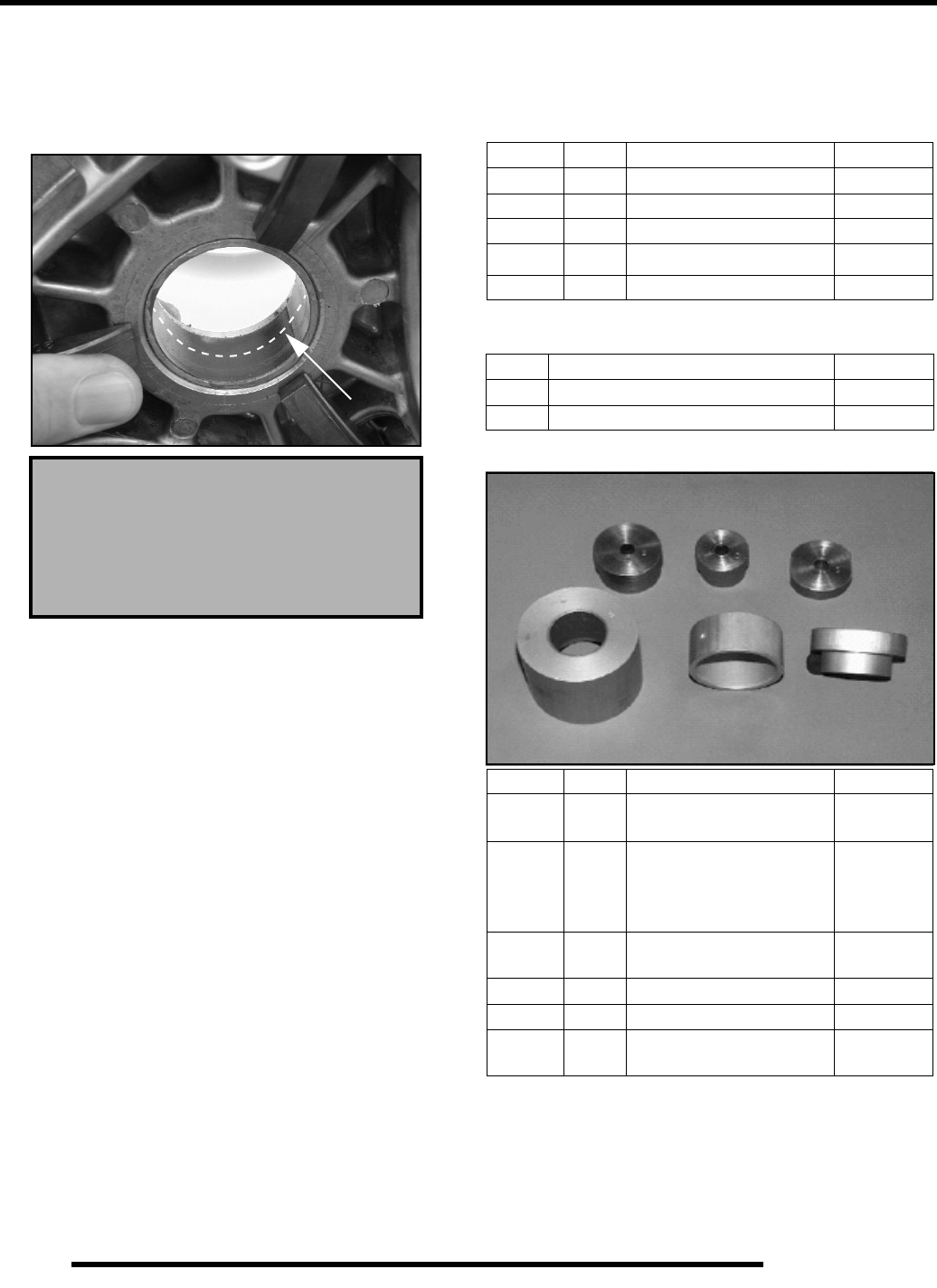
6.16
CLUTCHING
Moveable Sheave Bushing Inspection
Inspect the Teflon coating (arrow) on the moveable sheave
bushing. Inspect both sheaves for signs of wear, grooving or
cracking. De-glaze sheave surfaces with a 3M Scotch-Brite
Pad if needed.
Bushing Service
IMPORTANT: Special Tools Required
*Clutch Bushing Replacement Tool Kit (PN 2871226)
NOTE: Bushings are installed at the factory using
Loctite 609. In order to remove bushings it will be
necessary to apply heat evenly to the area around
each bushing. Clean all residual Loctite from
bushing bore prior to installing new bushing.
Moveable Sheave Bushing Inspection:
Replace the cover bushing if more brass
than Teflon is visible on the bushing.
Refer to bushing replacement
in this chapter.
EBS Clutch Bushing Tool Kit - 2201379
Item Qty. Part Description Part #
A, B 1 EBS Puller Tool 5132027
C 1 EBS Puller Nut 5132501
D 1 EBS Main Adapter 5132029
E1
EBS Bushing Removal Tool 5132028
-- 1 Instructions 9915111
Additional Special Tools
Qty. Part Description Part #
1 Clutch Bushing Replacement Tool Kit 2871226
1 Piston Pin Puller 2870386
Item Qty. Part Description Part #
#2 1 P-90 Drive/Driven Clutch
Bushing Install Tool 5020628
#3 1
Drive Clutch Cover
Bushing Removal/
Installation Tool (all
clutches)
5020629
#5 1 P-90 Driven Clutch Cover
Bushing Removal Tool 5020631
#8 1 Main Puller Adapter 5020632
#9 1 Adapter Reducer 5010279
#10 1 Number Two Puller
Adapter 5020633
#2 #3 #5
#8
#9
#10
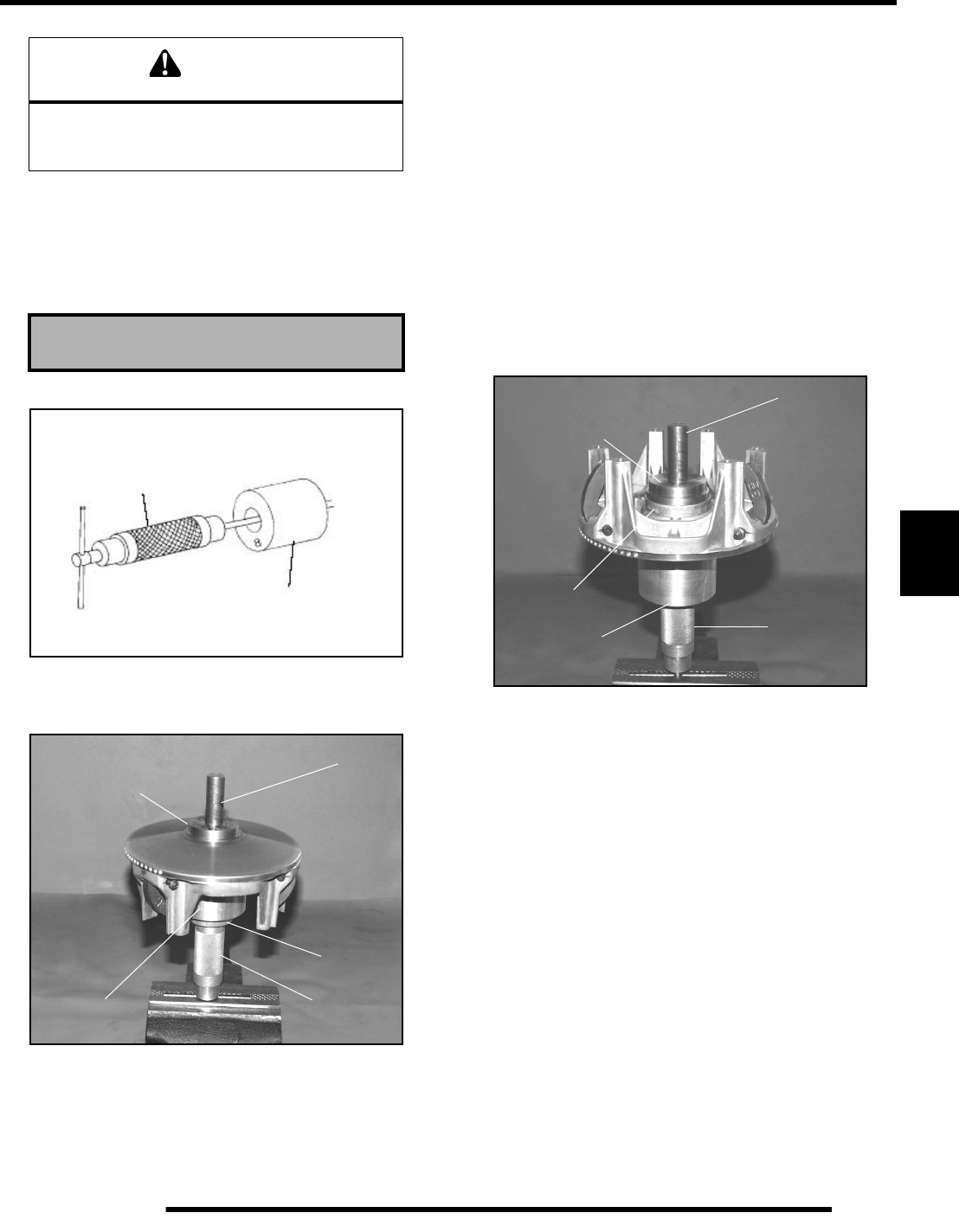
6.17
CLUTCHING
6
Moveable Sheave - Bushing Removal
1. Remove clutch as outlined previously in this chapter.
2. Install handle end of the Piston Pin Puller (PN 2870386)
securely into bench vise and lightly grease puller threads.
3. Remove nut from puller rod and set aside.
4. Install puller adapter (Item 10 from kit PN 2871226).
5. Install main adapter (Item D) onto puller.
6. With towers pointing toward the vise, slide sheave onto
puller rod.
7. Install removal tool (Item A, B) into center of sheave with
“A side" toward sheave.
NOTE: Use Bushing Tool PA-47336.
8. Install nut (C) onto end of puller rod and hand tighten. Turn
puller barrel to increase tension on sheave if needed. Using
a hand held propane torch, apply heat around outside of
bushing until tiny smoke tailings appear.
9. Turn sheave counterclockwise on puller rod until it comes
free. Lift sheave off puller.
10. Remove nut from puller rod and set aside.
11. Pull bushing removal tool and adapter from puller rod.
Remove bushing from tool and discard.
Drive Clutch Bushing Installation
1. Place main adapter (Item 8) on puller.
2. Apply Loctite 609 evenly to bushing bore inside
moveable sheave.
3. Set bushing in place on sheave.
4. Insert installation puller tool (Item A/B) with “A” side
down, into center of bushing.
NOTE: 800 EFI Clutch - Use Bushing Tool PA-47336.
5. With towers pointing upward, slide sheave, bushing and
tool onto puller rod.
6. Install nut on puller rod and hand tighten. Turn barrel to
apply additional tension if needed.
7. Turn sheave counterclockwise, making sure bushing is
drawn straight into bore. Continue until bushing is seated.
8. Remove nut from puller rod and set aside.
9. Remove sheave from puller.
10. Remove installation tool.
CAUTION
Clutch components will be hot! In order to avoid
serious burns, wear insulated gloves during the
removal process.
Piston Pin Puller (PN 2870386)
Piston Pin Puller
(PN 2870386)
Main Puller Adaptor (#8)
(PN 5020632)
Puller Tool (A,B)
Side “A” toward
sheave
Nut (C)
Main
Adapter (D)
Puller
Adapter (10)
Piston Pin
Puller
Puller Tool (A,B)
Side “A” toward
sheave
Nut (C)
Bushing
Main Adapter
(8)
Piston Pin
Puller
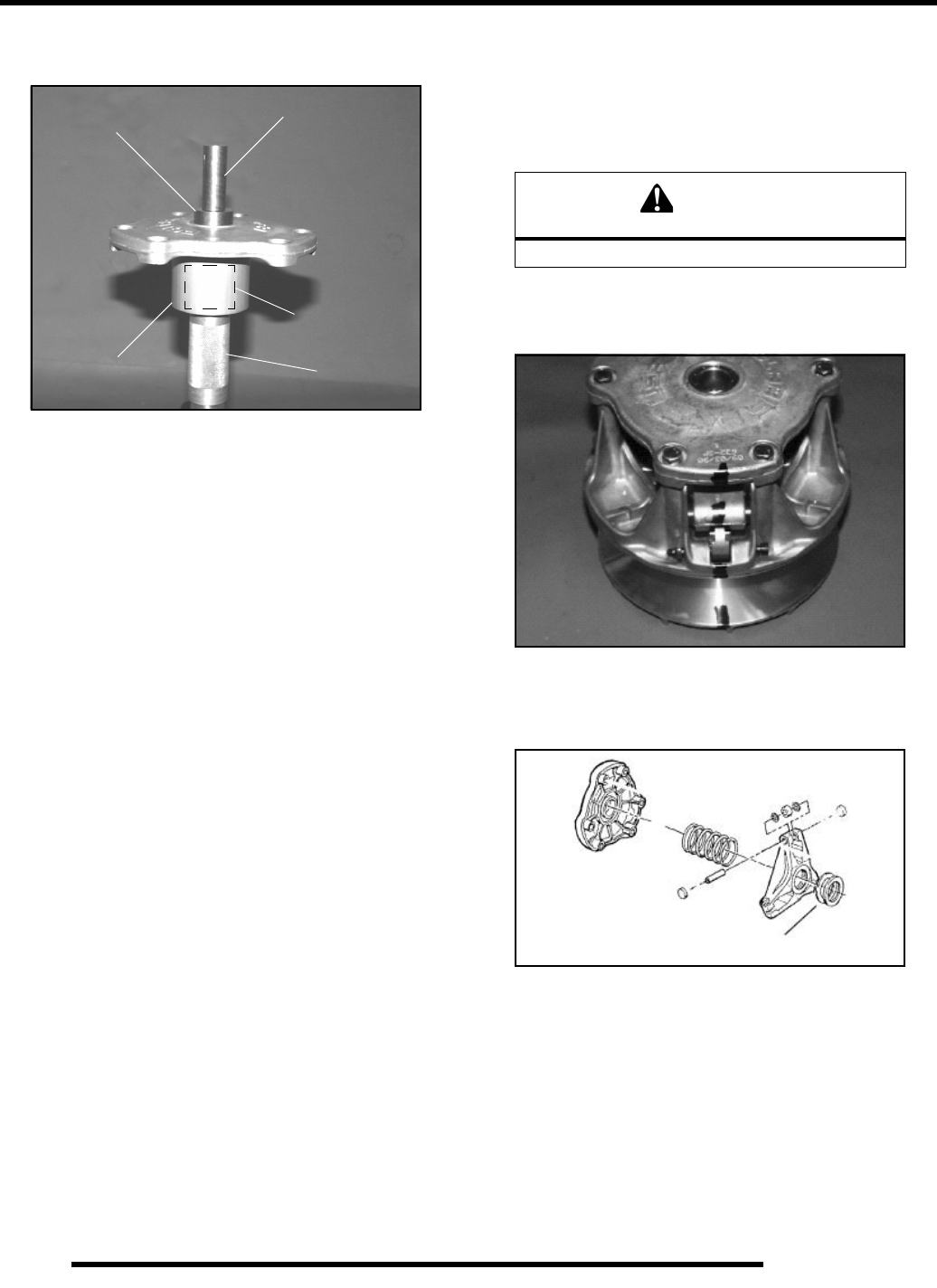
6.18
CLUTCHING
Cover Bushing Removal
1. Install main adapter (Item 8) on puller.
2. Install adapter reducer (Item 9).
3. From outside of clutch cover, insert removal tool (Item 3)
into cover bushing.
4. With inside of cover toward vise, slide cover onto puller.
5. Install nut onto puller rod and hand tighten. Turn puller
barrel to increase tension as needed.
6. Turn clutch cover counterclockwise on puller rod until
bushing is removed and cover comes free.
7. Remove nut from puller rod and set aside.
8. Remove bushing and bushing removal tool from puller.
Discard bushing.
Cover Bushing Installation
1. Apply Loctite 609 evenly to bushing bore in cover.
2. Working from inside of cover, insert new bushing and
bushing installation tool into center of clutch cover.
3. With main adapter on puller, insert cover onto puller rod,
placing outside of cover toward vise.
4. Install nut on rod and hand tighten. Turn puller barrel to
apply more tension if needed.
5. Turn clutch cover counterclockwise on puller rod until
bushing is seated.
6. Remove nut from puller rod. Take installation tool and
clutch cover off rod.
Clutch Assembly
NOTE: It is important that the same number and
thickness of washers are reinstalled beneath the
spider during assembly. The Teflon bushings are
self-lubricating.
Reassemble the drive clutch in the following sequence. Be sure
the “X”, or the marks that were made earlier are aligned during
each phase of assembly.
1. Install moveable sheave onto fixed sheave.
2. Install spider spacers. Use same quantity and thickness as
were removed.
3. Compress spider buttons for each tower and install spider,
making sure that “X”, or the marks that were made earlier,
on spider aligns with “X”, or the marks that were made
earlier, in moveable sheave.
Removal Tool
(3) Nut (C)
Adapter Reducer
(9)
Piston Pin
Puller
Main
Adapter (8)
CAUTION
Do not apply oil or grease to the bushings.
Spacer washers

6.19
CLUTCHING
6
4. Torque spider to specification using the holding fixture and
spider tool. Torque with smooth motion to avoid damage
to the stationary sheave.
5. Install shift weights using new lock nuts on the bolts.
6. Reinstall clutch spring.
7. Reinstall cover, aligning “X” mark with other marks.
8. Torque cover bolts evenly to specification.
= T
Spider Torque:
200 ft. lbs. (271 Nm)
CAUTION
Be sure the spider spacer washers are fully
seated in the recessed area in the spider.
Any misalignment will alter clutch balance.
Inverting the clutch while initially tightening the
spider will help position the washers.
= T
Cover Screw Torque:
90 in. lbs. (10.4 Nm)
Rotation
Nut on trailing side
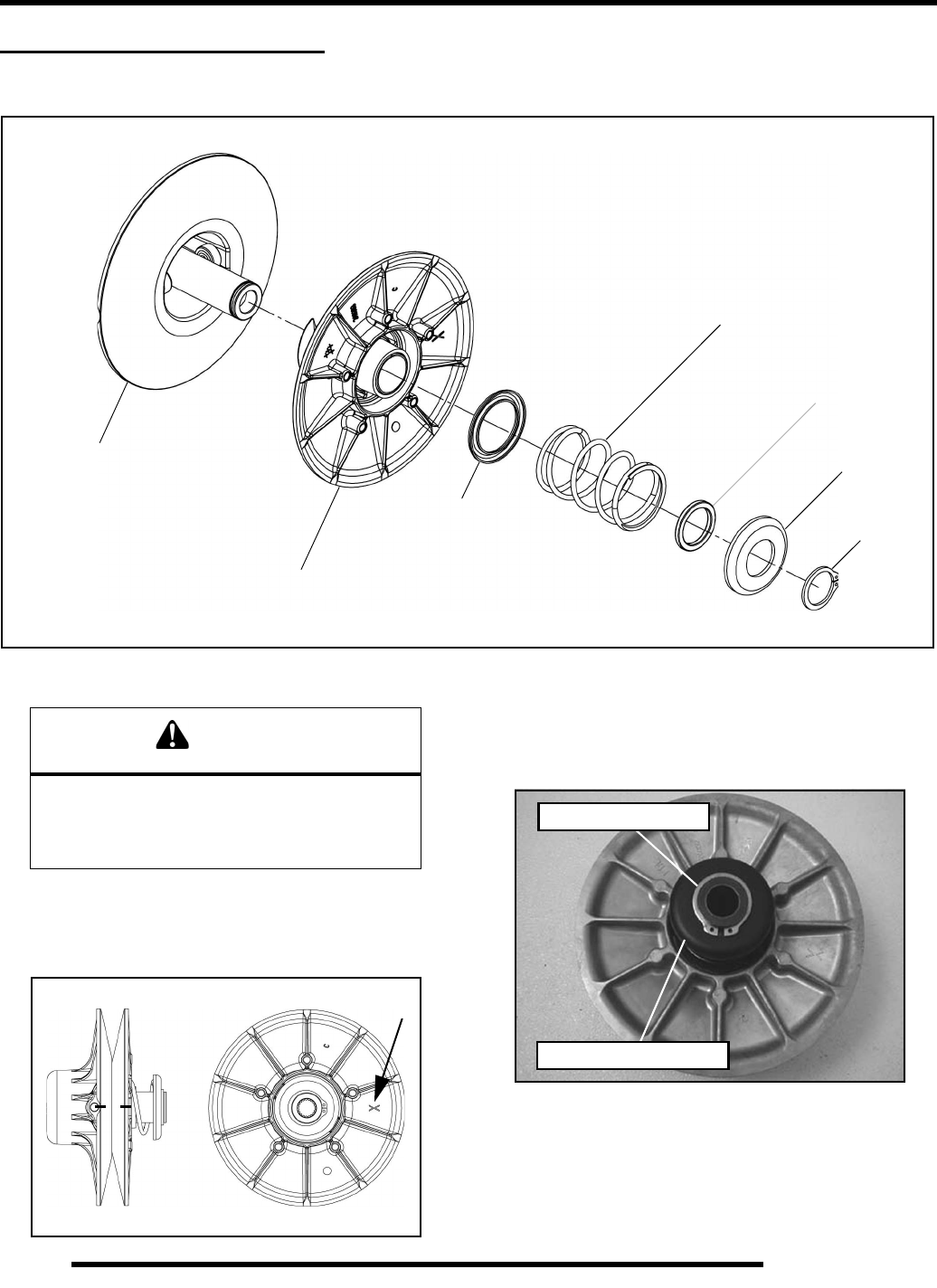
6.20
CLUTCHING
DRIVEN CLUTCH SERVICE
Exploded View
Clutch Disassembly / Inspection
1. Remove driven clutch from the transmission input shaft.
2. Mark the position of the clutch sheaves before disassembly
or use the X’s on the sheaves for reference. This aids in
reassembly and maintains clutch balance after reassembly.
3. Place the clutch into the Clutch Compression Tool PN
8700220. Using Compression Extensions PN PS-45909,
apply and hold downward pressure on the outer spring
retainer. Carefully remove the snap ring. Remember the
outer spring retainer contains strong spring pressure.
NOTE: Spring is compression only and has no
torsional wind.
Stationary
Moveable
Inner
Compression Spring
Outer
Retaining
Spring Retainer
Ring
Spacer
Spring Retainer
Secondary Sheave
Secondary Sheave
CAUTION
Wear eye protection when removing snap ring to
prevent serious personal injury.
Use caution when removing, the snap ring
pressure is loaded by the compression spring.
Remove Snap Ring
Outer Spring Retainer
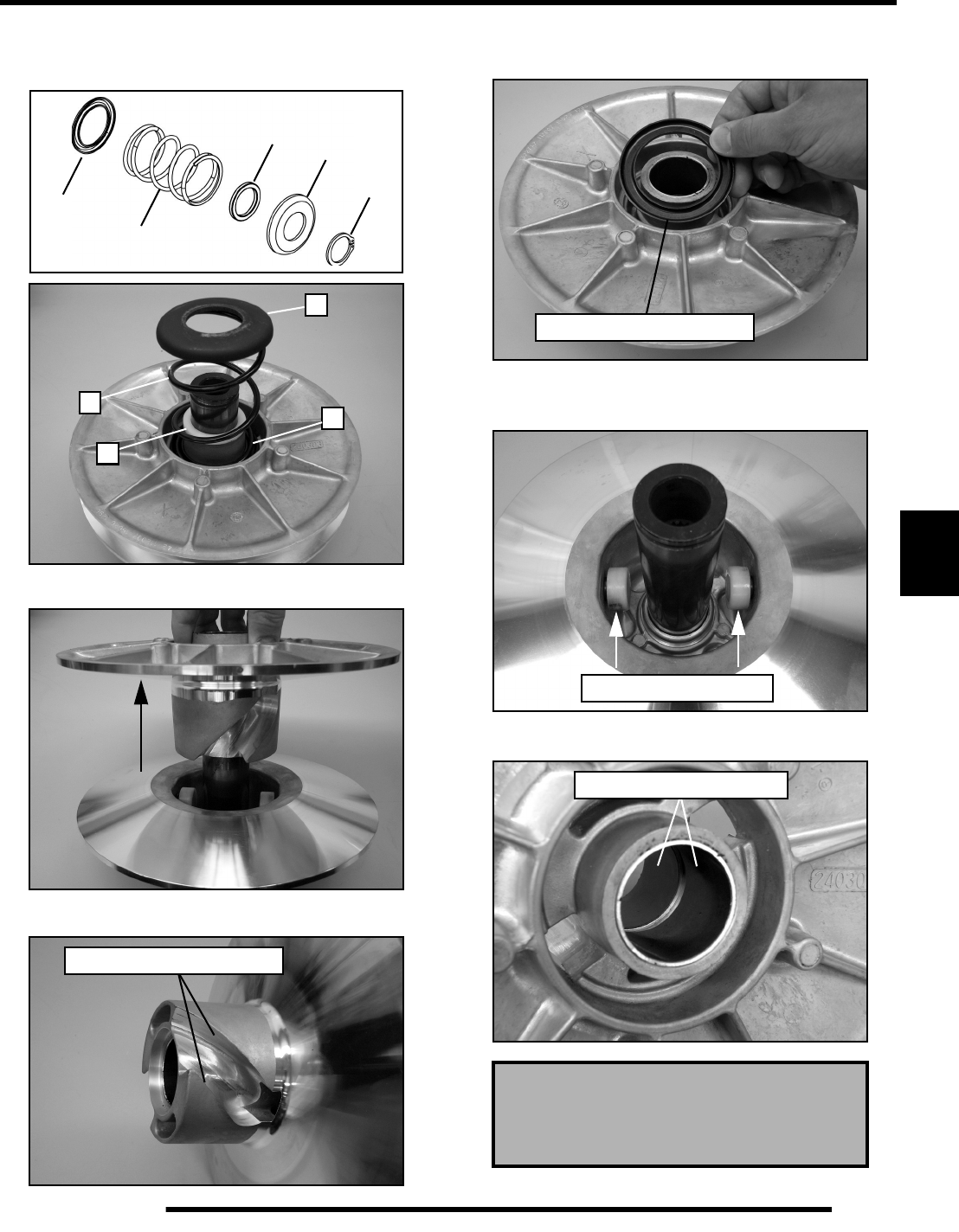
6.21
CLUTCHING
6
4. With the snap ring (A) removed and spring pressure
relieved, remove the outer spring retainer (B), compression
spring (C), spacer (D), and inner spring retainer (E).
5. Separate the two clutch sheaves.
6. Inspect the helix on the moveable sheave.
7. Remove the inner spring retainer from the inner sheave.
Inspect for wear and replace as needed.
8. Check the rollers in the stationary sheave for wear. If rollers
are worn, a new driven clutch assembly may be needed.
9. Inspect the bearings inside the moveable sheave.
A
B
C
E
D
CE
B
D
Inspect for Abnormal Wear
Moveable Sheave Bearing Inspection:
Replace the clutch assembly if more brass
than Teflon™ is visible on the bearing.
Inspect for Abnormal Wear
Check Rollers for Wear
Inspect Bearings for Wear

6.22
CLUTCHING
10. Inspect the Teflon™ coating on the moveable sheave
bearings.
11. Inspect driven clutch sheave faces for wear or damage.
12. Clean and inspect splines on helix and transmission input
shaft.
13. Lube splines with a light film of grease. Do not lubricate
the bearings!
Clutch Assembly
1. Install the inner spring retainer if removed. Do not apply
oil or grease to the bearings.
2. Align the “X” marks on each of the sheaves during
reassembly.
3. Install the spring into the inner retainer.
4. Install the spacer over the shaft.
5. Install the outer retainer on top of the spring.
6. Place the clutch into Clutch Compression Tool PN
8700220. Using Compression Extensions PN PS-45909,
apply and hold downward pressure on the outer spring
retainer. Carefully install the snap ring.
7. Compress the outer retainer and install the snap ring.
Assemble Sheaves
Snap Ring
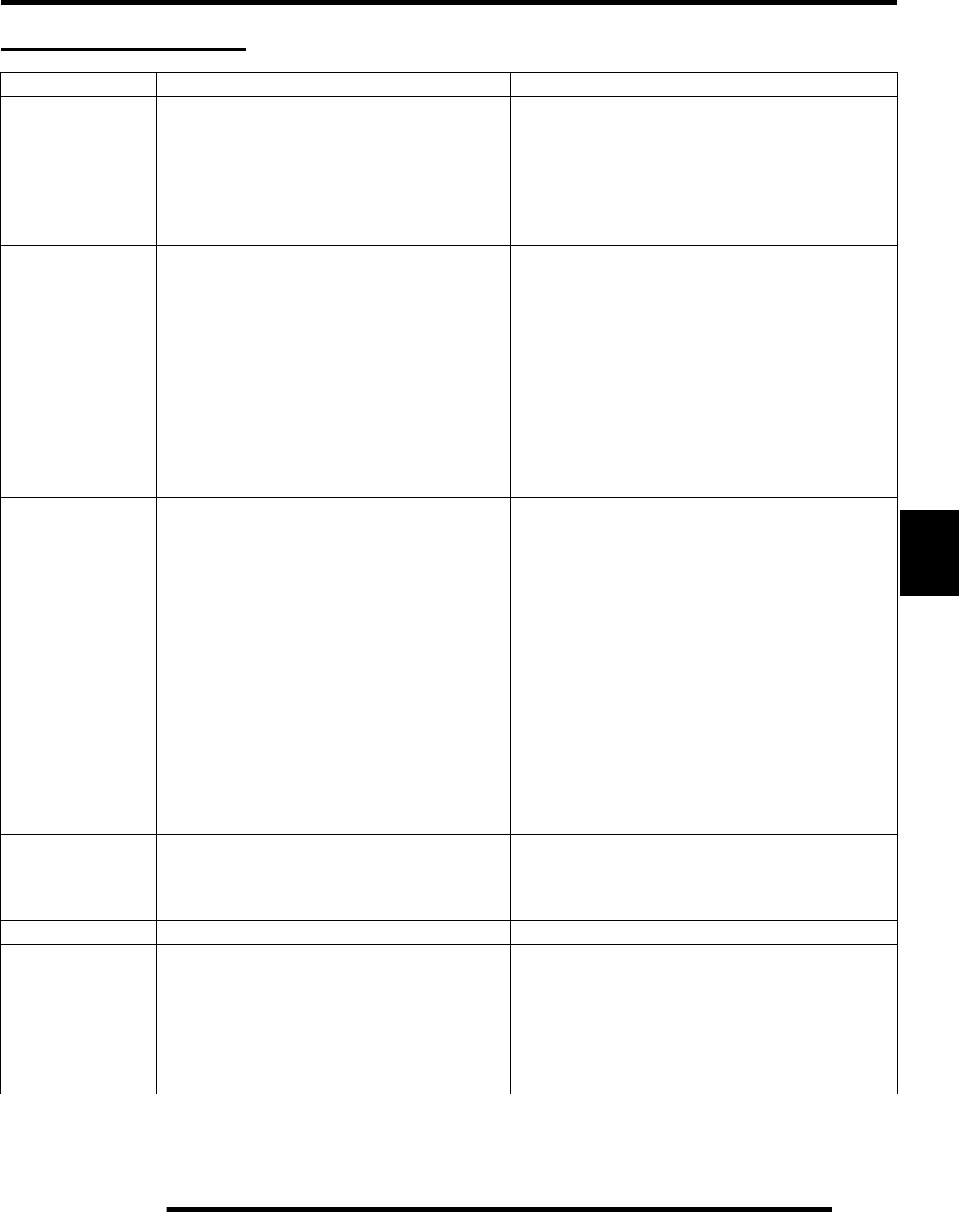
6.23
CLUTCHING
6
TROUBLESHOOTING
Situation Probable Cause Remedy
Engine RPM below
specified operating
range, although
engine is properly
tuned.
-Wrong or broken drive clutch spring.
-Drive clutch shift weight too heavy.
-Driven clutch spring broken or installed in wrong
helix location.
-Replace with recommended spring.
-Install correct shift weight kit to match engine
application.
-Replace spring; refer to proper installation location.
Erratic engine
operating RPM
during acceleration or
load variations.
-Drive clutch binding.
-Belt worn unevenly - thin / burnt spots.
-Driven clutch malfunction.
-Sheave face grooved.
A. Disassemble drive clutch; inspect shift weights for
wear and free operation.
B. Clean and polish stationary shaft hub; reassemble
clutch without spring to determine problem area.
Replace belt.
A. Replace ramp buttons.
B. Inspect movable sheave for excessive bushing
clearance.
-Replace the clutch.
Engine RPM above
specified operating
range.
-Incorrect drive clutch spring (too high spring rate).
-Drive clutch shift weights incorrect for application
(too light).
-Drive clutch binding.
-Driven clutch binding.
-Converter sheaves greasy; belt slipage.
-Install correct recommended spring.
-Install correct recommended shift weights.
-Disassemble and clean clutch, inspecting shift weights
and rollers. Reassemble without the spring and move
sheaves through entire range to further determine
probable cause.
-Disassemble, clean, and inspect driven clutch, noting
worn sheave bushing and ramp buttons and helix spring
location.
-Clean sheaves with denatured alcohol or brake cleaner,
install new belt.
Harsh drive clutch
engagement.
-Drive belt worn too narrow.
-Excessive belt / sheave clearance with new belt.
-Replace belt.
-Perform belt / sheave clearance adjustment with shim
washers beneath spider.
Drive belt turns over -Wrong belt for application. -Replace with correct belt.
Belt burnt, thin spots
-Abuse (continued throttle application when
vehicle is stationary, excess load)
-Dragging brake
-Slow, easy clutch engagement
-Caution operator to operate machine within guidelines.
-Inspect brake system.
-Fast, effective use of throttle for efficient engagement.

6.24
CLUTCHING
Troubleshooting, Continued.....
Situation Probable Cause Remedy
PVT cover
overheating (melting)
-Plugged air intake or outlet.
-Belt slippage due to water, oil, grease, etc., rubbing
on cover.
-Clutches or weight being applied to cover while in
operation.
-High vs. low range.
-Clear obstruction
-Inspect system. Clean , repair or replace as necessary.
Seal PVT system ducts.
-Remove weight. Inform operator.
-Instruct operator on guidelines for operation in proper
driving range for different terrain as outlined in Owner’s
Safety and Maintenance Manual.
Water ingestion
-Cover seals or ducts leaking
-Operator error
-Find leak and repair as necessary.
-Instruct operator on guidelines for operation in wet
terrain as outlined in Owner’s Safety and Maintenance
Manual.
Belt slippage
-Belt worn out
-Water ingestion
-Belt contaminated with oil or grease
-Replace belt.
-Inspect and seal PVT system.
-Inspect and clean.
PVT noise
-Belt worn or separated, thin spots, loose belt
-Broken or worn clutch components, cover hitting
clutches
-Replace belt.
-Inspect and repair as necessary.
Engagement
erratic or stabby
-Thin spots on belt, worn belt
-Drive clutch bushings stick
-Replace belt. Refer to belt burnt troubleshooting and
instruct operator.
-Inspect and repair clutches.

FINAL DRIVE
7.1
CHAPTER 7
FINAL DRIVE
7
SPECIAL TOOLS . . . . . . . . . . . . . . . . . . . . . . . . . . . . . . . . . . . . . . . . . . . . . . . . . . . . . . . 7.2
TORQUE SPECIFICATIONS. . . . . . . . . . . . . . . . . . . . . . . . . . . . . . . . . . . . . . . . . . . . . . . 7.2
FRONT BEARING CARRIER . . . . . . . . . . . . . . . . . . . . . . . . . . . . . . . . . . . . . . . . . . . . . . 7.2
BEARING CARRIER INSPECTION / REMOVAL. . . . . . . . . . . . . . . . . . . . . . . . . . . . . . . 7.2
BEARING REPLACEMENT . . . . . . . . . . . . . . . . . . . . . . . . . . . . . . . . . . . . . . . . . . . . . . . 7.3
BEARING CARRIER INSTALLATION . . . . . . . . . . . . . . . . . . . . . . . . . . . . . . . . . . . . . . . 7.4
FRONT DRIVE SHAFT . . . . . . . . . . . . . . . . . . . . . . . . . . . . . . . . . . . . . . . . . . . . . . . . . . . 7.5
DRIVE SHAFT REMOVAL . . . . . . . . . . . . . . . . . . . . . . . . . . . . . . . . . . . . . . . . . . . . . . . . 7.5
DRIVE SHAFT / CV JOINT HANDLING TIPS . . . . . . . . . . . . . . . . . . . . . . . . . . . . . . . . . 7.6
OUTER CV JOINT / BOOT REPLACEMENT. . . . . . . . . . . . . . . . . . . . . . . . . . . . . . . . . . 7.6
INNER PLUNGING JOINT / BOOT REPLACEMENT . . . . . . . . . . . . . . . . . . . . . . . . . . . 7.8
DRIVE SHAFT INSTALLATION . . . . . . . . . . . . . . . . . . . . . . . . . . . . . . . . . . . . . . . . . . . . 7.9
PROPSHAFT SERVICE . . . . . . . . . . . . . . . . . . . . . . . . . . . . . . . . . . . . . . . . . . . . . . . . . 7.11
REMOVAL / INSTALLATION . . . . . . . . . . . . . . . . . . . . . . . . . . . . . . . . . . . . . . . . . . . . . 7.11
PROPSHAFT U-JOINT SERVICE. . . . . . . . . . . . . . . . . . . . . . . . . . . . . . . . . . . . . . . . . . 7.12
DISASSEMBLY. . . . . . . . . . . . . . . . . . . . . . . . . . . . . . . . . . . . . . . . . . . . . . . . . . . . . . . . 7.12
ASSEMBLY . . . . . . . . . . . . . . . . . . . . . . . . . . . . . . . . . . . . . . . . . . . . . . . . . . . . . . . . . . 7.12
FRONT GEARCASE / CENTRALIZED HILLIARD . . . . . . . . . . . . . . . . . . . . . . . . . . . . . 7.14
CENTRALIZED HILLIARD EXPLODED VIEW. . . . . . . . . . . . . . . . . . . . . . . . . . . . . . . . 7.14
ALL WHEEL DRIVE OPERATION . . . . . . . . . . . . . . . . . . . . . . . . . . . . . . . . . . . . . . . . . 7.15
AWD DIAGNOSIS. . . . . . . . . . . . . . . . . . . . . . . . . . . . . . . . . . . . . . . . . . . . . . . . . . . . . . 7.16
GEARCASE REMOVAL . . . . . . . . . . . . . . . . . . . . . . . . . . . . . . . . . . . . . . . . . . . . . . . . . 7.17
GEARCASE DISASSEMBLY / INSPECTION. . . . . . . . . . . . . . . . . . . . . . . . . . . . . . . . . 7.17
GEARCASE ASSEMBLY / INSPECTION. . . . . . . . . . . . . . . . . . . . . . . . . . . . . . . . . . . . 7.20
GEARCASE INSTALLATION . . . . . . . . . . . . . . . . . . . . . . . . . . . . . . . . . . . . . . . . . . . . . 7.22
REAR BEARING CARRIER. . . . . . . . . . . . . . . . . . . . . . . . . . . . . . . . . . . . . . . . . . . . . . . 7.23
BEARING CARRIER INSPECTION / REMOVAL. . . . . . . . . . . . . . . . . . . . . . . . . . . . . . 7.23
BEARING REPLACEMENT . . . . . . . . . . . . . . . . . . . . . . . . . . . . . . . . . . . . . . . . . . . . . . 7.24
BEARING CARRIER BUSHING REPLACEMENT . . . . . . . . . . . . . . . . . . . . . . . . . . . . . 7.25
BEARING CARRIER INSTALLATION . . . . . . . . . . . . . . . . . . . . . . . . . . . . . . . . . . . . . . 7.25
REAR DRIVE SHAFT . . . . . . . . . . . . . . . . . . . . . . . . . . . . . . . . . . . . . . . . . . . . . . . . . . . 7.27
DRIVE SHAFT REMOVAL . . . . . . . . . . . . . . . . . . . . . . . . . . . . . . . . . . . . . . . . . . . . . . . 7.27
OUTER CV JOINT / BOOT REPLACEMENT. . . . . . . . . . . . . . . . . . . . . . . . . . . . . . . . . 7.28
INNER PLUNGING JOINT / BOOT REPLACEMENT . . . . . . . . . . . . . . . . . . . . . . . . . . 7.30
DRIVE SHAFT EXPLODED VIEW . . . . . . . . . . . . . . . . . . . . . . . . . . . . . . . . . . . . . . . . . 7.33
DRIVE SHAFT INSTALLATION . . . . . . . . . . . . . . . . . . . . . . . . . . . . . . . . . . . . . . . . . . . 7.33
REAR GEARCASE . . . . . . . . . . . . . . . . . . . . . . . . . . . . . . . . . . . . . . . . . . . . . . . . . . . . . 7.35
GENERAL OPERATION. . . . . . . . . . . . . . . . . . . . . . . . . . . . . . . . . . . . . . . . . . . . . . . . . 7.35
GEARCASE REMOVAL . . . . . . . . . . . . . . . . . . . . . . . . . . . . . . . . . . . . . . . . . . . . . . . . . 7.36
GEARCASE DISASSEMBLY . . . . . . . . . . . . . . . . . . . . . . . . . . . . . . . . . . . . . . . . . . . . . 7.37
DIFFERENTIAL DISASSEMBLY . . . . . . . . . . . . . . . . . . . . . . . . . . . . . . . . . . . . . . . . . . 7.41
DIFFERENTIAL ASSEMBLY . . . . . . . . . . . . . . . . . . . . . . . . . . . . . . . . . . . . . . . . . . . . . 7.42
GEARCASE ASSEMBLY . . . . . . . . . . . . . . . . . . . . . . . . . . . . . . . . . . . . . . . . . . . . . . . . 7.43
GEARCASE INSTALLATION . . . . . . . . . . . . . . . . . . . . . . . . . . . . . . . . . . . . . . . . . . . . . 7.45
GEARCASE EXPLODED VIEW . . . . . . . . . . . . . . . . . . . . . . . . . . . . . . . . . . . . . . . . . . . 7.46
WHEEL HUBS . . . . . . . . . . . . . . . . . . . . . . . . . . . . . . . . . . . . . . . . . . . . . . . . . . . . . . . . . 7.47
FRONT HUB EXPLODED VIEW . . . . . . . . . . . . . . . . . . . . . . . . . . . . . . . . . . . . . . . . . . 7.47
REAR HUB EXPLODED VIEW. . . . . . . . . . . . . . . . . . . . . . . . . . . . . . . . . . . . . . . . . . . . 7.47

7.2
FINAL DRIVE
SPECIAL TOOLS
TORQUE SPECIFICATIONS
Wheel and Hub Torque Table
FRONT BEARING CARRIER
Bearing Carrier Inspection / Removal
1. Elevate front of vehicle and safely support machine under
the frame area.
2. Check bearings for side play by grasping the top and bottom
of the tire firmly and checking for movement. The tire
should rotate smoothly without binding or rough spots.
3. Remove the (4) wheel nuts and remove the front wheel.
4. Remove the cotter pin and loosen the front wheel hub castle
nut. Remove the nut, and (2) cone washers from the front
wheel hub assembly.
5. Remove the fastener retaining the steering tie rod end to the
front bearing carrier.
PART NUMBER TOOL DESCRIPTION
2872608 Roll Pin Removal Tool
8700226 CV Boot Clamp Pliers
(earless type)
PU-48951 Axle Boot Clamp Tool
ITEM NUT TYPE SPECIFICATION
Aluminum Wheels
(Cast)
Lug Nut
(1) 30 ft. lbs. + 90° (1/4 turn)
Steel Wheels Flange Nut
(2) 35 ft. lbs. (47 Nm)
Front Hub
Castle Nut - 80 ft. lbs. (108 Nm)
Rear Hub
Castle Nut - 80 ft. lbs. (108 Nm)
Steel Wheel
(Standard Models)
35 ft. lbs. (47 Nm)
#1 #2
Aluminum Wheel
(LE Models)
30 ft. lbs. + 90° (1/4 turn)
CAUTION
Serious injury may result if machine tips or falls.
Be sure machine is secure before beginning this
service procedure. Wear eye protection when
removing bearings and seals.
Castle Nut
Cotter Pin
Cone
Washers

7.3
FINAL DRIVE
7
6. Remove the two front brake caliper mounting bolts and
remove the caliper from the brake disc (see Chapter 9).
CAUTION: Do not hang the caliper by the brake line. Use
wire to hang caliper to prevent damage to the brake line.
7. Remove the front wheel hub assembly.
8. Remove the upper and lower ball joint pinch bolts.
9. Using a soft faced hammer, lightly tap on the bearing carrier
while removing the upper and lower ball joint ends.
10. Remove the bearing carrier from the front drive shaft.
11. Rotate bearing by hand and check for smooth rotation.
Visually inspect bearing for moisture, dirt, or corrosion.
NOTE: Due to extremely close tolerances and
minimal wear, the bearings must be inspected
visually, and by feel. While rotating bearings by
hand, inspect for rough spots, discoloration, or
corrosion. The bearings should turn smoothly and
quietly, with no detectable up and down movement
and minimal movement sideways between inner and
outer race.
12. Replace bearing if moisture, dirt, corrosion, or roughness
is evident.
Bearing Replacement
Bearing Removal
1. Remove the outer snap ring.
2. From the back side of the bearing carrier, tap on the outer
bearing race with a drift punch in the reliefs as shown.
3. Drive bearing out evenly by tapping on outer race only.
Once bearing is at bottom of casting, support casting on
outer edges so bearing can be removed.
4. Inspect the bearing carrier housing for scratches, wear or
damage. Replace front bearing carrier if damaged.
Pinch
Bolts
Snap Ring

7.4
FINAL DRIVE
Bearing Installation
5. Thoroughly clean the front bearing carrier housing and the
outer race on the new bearing. Be sure that all oil residue
has been removed from each surface.
6. Support the bottom of the bearing carrier housing.
7. Apply Loctite® 603™ retaining compound to the outer
circumference of the new bearing race and carefully press
the new bearing into the bearing carrier housing.
NOTE: Use care to not allow any of the Loctite®
compound to get in the bearing.
8. Wipe the housing clean of any excess compound and install
the snap ring.
Bearing Carrier Installation
1. Install drive shaft axle through the backside of the bearing
carrier.
2. Install the upper and lower ball joint ends into the front
bearing carrier.
3. Install pinch bolts and torque to specification.
4. Apply grease to drive shaft axle splines.
5. Install front wheel hub assembly, cone washers, and hand
tighten the castle nut. Install washers with domed side out.
6. Install brake caliper mounting bolts and torque to
specification.
7. Install the steering tie rod end onto the front bearing carrier.
CAUTION
Use an arbor and press only on the outer race,
otherwise bearing damage may occur.
Apply
Loctite® 603™
Bearing
Snap Ring
= T
Pinch Bolts:
22.5 ft. lbs. (30.5 Nm)
= T
Front Caliper Mounting Bolts:
31-34 ft. lbs. (42-46 Nm)
CAUTION
New bolts have a pre-applied locking agent
which is destroyed upon removal. Always use
new brake caliper mounting bolts
upon assembly.
22.5 ft. lbs.
30.5 (Nm)
Out
Cone Washers
Wheel
Hub
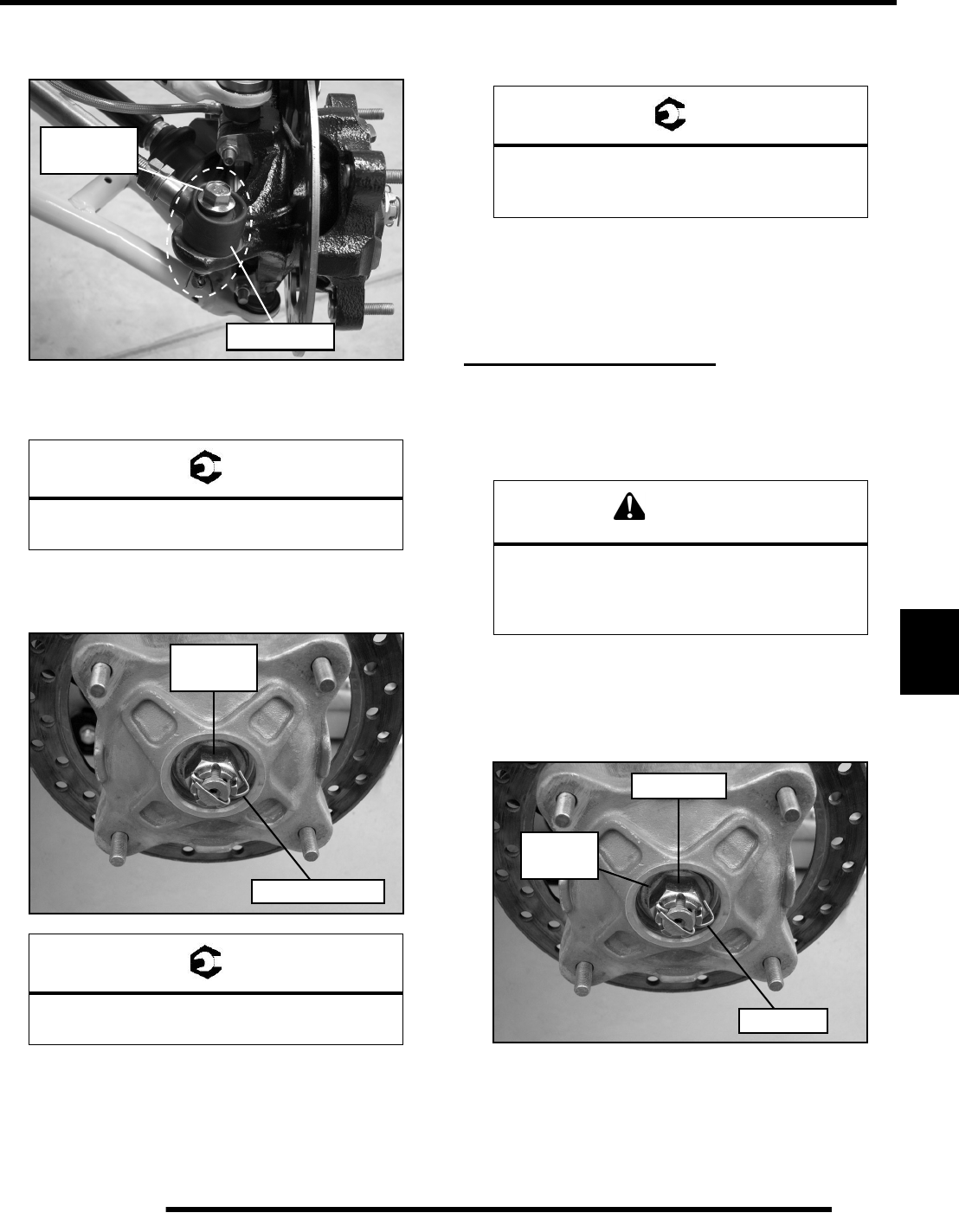
7.5
FINAL DRIVE
7
NOTE: Refer to the photos below to ensure proper
placement of the tie rod end.
8. Torque the tie rod end fastener to specification and install
a new cotter pin.
9. Torque wheel hub nut to specification and install a new
cotter pin. Tighten nut slightly if necessary to align cotter
pin holes.
10. Install wheel and (4) wheel nuts. Torque wheel nuts to
specification.
11. Rotate wheel and check for smooth operation. Bend both
ends of cotter pin around end of spindle in different
directions.
FRONT DRIVE SHAFT
Drive Shaft Removal
1. Elevate front of vehicle and safely support machine under
the frame area.
2. Remove the (4) wheel nuts and remove the front wheel.
3. Remove the cotter pin and loosen the front wheel hub castle
nut. Remove the nut, and (2) cone washers from the front
wheel hub assembly.
4. Remove the two front brake caliper mounting bolts and
remove the caliper from the brake disc (see Chapter 9).
CAUTION: Do not hang the caliper by the brake line. Use
wire to hang caliper to prevent damage to the brake line.
= T
Tie Rod End Fastener:
42.5 ft. lbs. (58 Nm)
= T
Wheel Hub Castle Nut:
80 ft. lbs. (108 Nm)
Tie Rod End
42.5 ft. lbs.
58 (Nm)
80 ft. lbs.
NEW Cotter Pin
(108 Nm)
= T
Wheel Nuts:
Steel Wheels: 35 ft. lbs. (47 Nm)
Aluminum Wheels: 30 ft. lbs. + 90° (1/4 turn)
CAUTION
Serious injury may result if machine tips or falls.
Be sure machine is secure before beginning this
service procedure. Wear eye protection when
removing bearings and seals.
Castle Nut
Cotter Pin
Cone
Washers

7.6
FINAL DRIVE
5. Remove the front wheel hub assembly.
6. Remove the upper ball joint pinch bolt.
7. Using a soft faced hammer, lightly tap on the bearing carrier
while removing the upper ball joint end.
8. Remove the drive shaft from the front bearing carrier.
9. With a short, sharp jerk, remove drive shaft from the front
gearcase.
Drive Shaft / CV Joint Handling Tips
Care should be exercised during drive shaft removal or when
servicing CV joints. Drive shaft components are precision parts.
Cleanliness and following these instructions is very important to
ensure proper shaft function and a normal service life.
• The complete drive shaft and joint should be handled by
getting hold of the interconnecting shaft to avoid
disassembly or potential damage to the drive shaft
joints.
• Over-angling of joints beyond their capacity could
result in boot or joint damage.
• Make sure surface-ground areas and splines of shaft are
protected during handling to avoid damage.
• Do not allow boots to come into contact with sharp
edges or hot engine and exhaust components.
• The drive shaft is not to be used as a lever arm to
position other suspension components.
• Never use a hammer or sharp tools to remove or to
install boot clamps.
• Be sure joints are thoroughly clean and that the proper
amount and type of grease is used to refill when joint
boots are replaced and when joints are cleaned. Refer to
text for grease capacity of CV joints and CV joint
boots.
Outer CV Joint / Boot Replacement
NOTE: Refer the “Electronic Parts Catalog” for the
required parts to service the drive shaft. Some drive
shafts have “Boot Replacement Kits” that include a
new boot, clamps, and the required amount of
grease.
1. Remove clamps from rubber boot using the proper boot
clamp pliers.
2. Remove the large end of the boot from the CV joint and
slide the boot back.
3. Use a soft-faced hammer or brass drift to separate the outer
CV joint from the drive shaft.
NOTE: If using a brass drift, be sure to tap on the
inner race of the joint only.
Pinch
Bolt
CV Boot Clamp Pliers:
Earless Type - 8700226
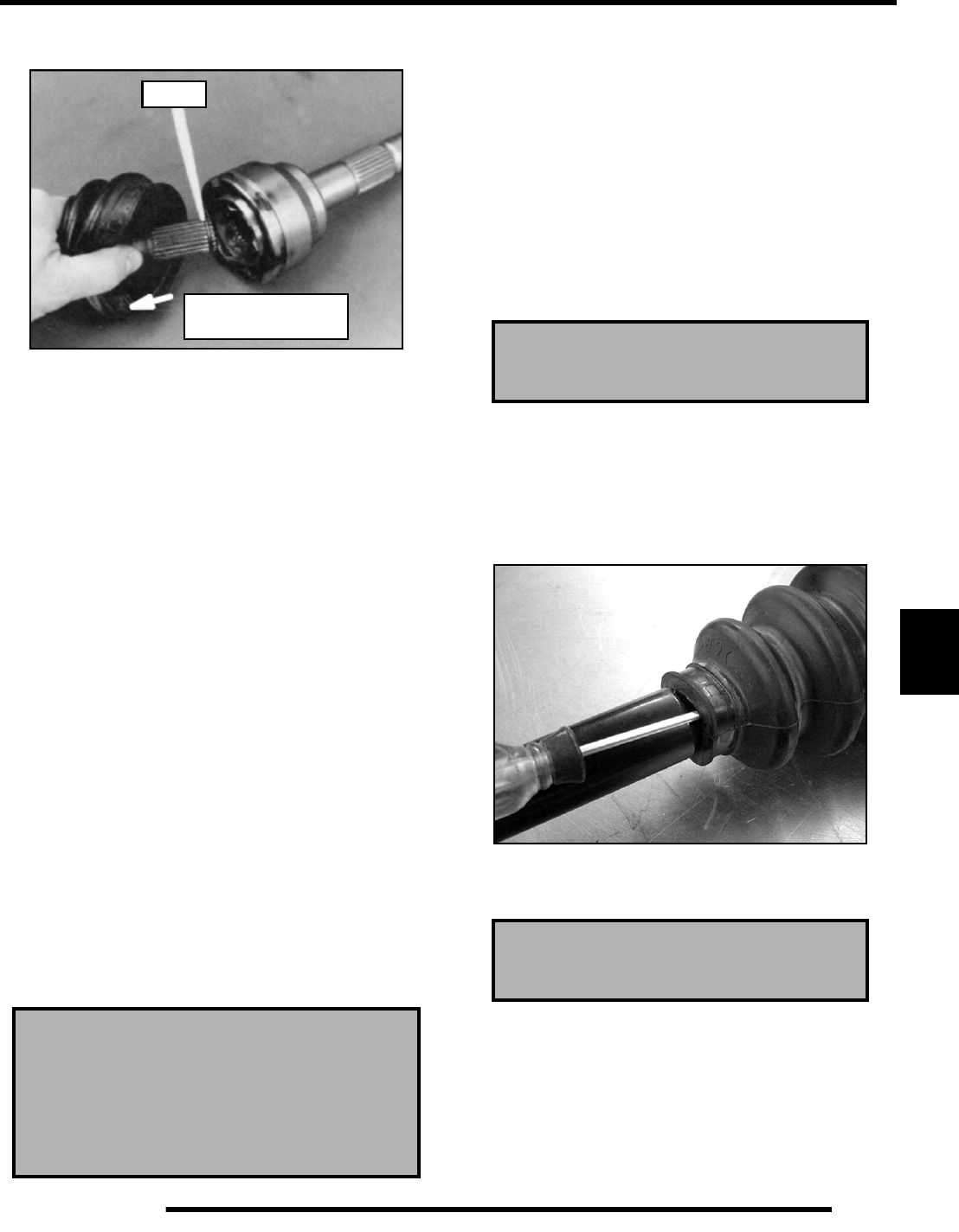
7.7
FINAL DRIVE
7
4. Make sure the circlip remains on the shaft and not left in
the joint. Discard the circlip as it will be replaced.
5. Remove the small clamp and boot from the drive shaft.
IMPORTANT: If the grease in the joint is obviously
contaminated with water and/or dirt, the joint should
be replaced.
6. Thoroughly clean the joint with an appropriate solvent and
dry the joint to prevent any residual solvent from being left
in the joint upon reassembly.
7. Visually inspect the joint by tilting the inner race to one side
to expose each ball. Severe pitting, galling, play between
the ball and its cage window, any cracking or damage to the
cage, pitting or galling or chips in raceways call for joint
replacement.
8. Apply a light coat of grease to the end of the drive shaft and
slide the new clamp and boot (small end first) over the shaft
and position the boot in its groove machined in the shaft.
9. Install a NEW circlip on the end of the shaft.
10. Grease the joint with the special CV joint grease provided
in the boot replacement kit. Fill the cavity behind the balls
and the splined hole in the joint’s inner race. Pack the ball
tracks and outer face flush with grease. Place any remaining
grease into the boot. Install small boot clamp.
NOTE: It is very important to use the correct type
and quantity of grease by using the grease
contained in the boot kit. DO NOT use a substitute
grease and DO NOT overfill or under fill the CV joint.
11. Slide the joint onto the drive shaft splines and align the
circlip with the lead-in chamfer on the inner race.
12. Use a soft-faced hammer to tap the CV joint into the splines
of the axle. Pull on the joint to ensure it’s securely installed.
13. Add the remaining grease through large end of boot.
14. Pull the boot over the joint and position the boot lips into
the grooves on the joint housing and shaft. Make sure the
boot is not dimpled or collapsed.
15. Install and secure the CV boot with the large clamp using
the “earless” clamp pliers.
16. While pulling out on the CV shaft, slide a straight O-ring
pick or a small slotted screw driver between the small end
of the boot and the shaft. This will allow the air pressure to
equalize in the CV boot in the position that the joint will
spend most of its life. Before you remove your instrument,
be sure the small end of the boot is in its correct location
on the shaft.
17. Install and secure the small clamp on the boot using the
“earless” clamp pliers.
Boot Replacement Grease Requirement:
Grease Service Kits
PN 1350059 (20g) / PN 1350046 (30g) / PN 1350047 (50g)
Outer CV Joint Capacity: 80g
Circlip
Pull shaft to remove
from CV joint
CV Boot Clamp Pliers
Earless Type: 8700226
CV Boot Clamp Pliers
Earless Type: 8700226

7.8
FINAL DRIVE
Inner Plunging Joint / Boot Replacement
1. Remove the front drive shaft from the vehicle (see
“FRONT DRIVE SHAFT - Removal”).
2. Remove and discard the boot clamps.
3. Remove the large end of the boot from the plunging joint
and slide the boot back.
4. Use a soft-faced hammer or brass drift to separate the
plunging joint from the drive shaft.
NOTE: If using a brass drift, be sure to tap on the
inner race of the joint only.
5. Make sure the circlip remains on the shaft and not left in
the joint. Discard the circlip.
6. Remove the boot from the drive shaft.
IMPORTANT: If the grease in the joint is obviously
contaminated with water and/or dirt, the joint should
be replaced.
7. Thoroughly clean the joint with an appropriate solvent and
dry the joint to prevent any residual solvent from being left
in the joint upon reassembly.
8. Visually inspect the joint by tilting the inner race to one side
to expose each ball. Severe pitting, galling, play between
the ball and its cage window, any cracking or damage to the
cage, pitting or galling or chips in raceways call for joint
replacement.
9. Clean the splines on the end of the shaft and apply a light
coat of grease prior to reassembly.
10. Slide the small boot clamp and boot (small end first) onto
the drive shaft and position the boot in it’s groove machined
in the shaft.
11. Install a NEW circlip on the end of the shaft.
12. Grease the joint with the special joint grease provided in the
boot replacement kit. Fill the cavity behind the balls and the
splined hole in the joint’s inner race. Pack the ball tracks
and outer face flush with grease. Place any remaining
grease into the boot.
NOTE: The amount of grease that’s provided is pre-
measured, so use all the grease.
13. Fully compress the joint and push the drive shaft firmly into
the inner race.
14. Align the circlip with the lead-in chamfer.
15. Use a soft-faced hammer to tap the joint onto the drive shaft
until it locks into place.
16. Pull on the joint to make sure it is securely locked into place.
17. Remove excess grease from the plunging joint’s external
surfaces and place the excess grease in the boot.
18. Pull the boot over the joint and position the boot lips into
the grooves on the joint housing and shaft. Make sure the
boot is not dimpled or collapsed.
19. Install and secure the small clamp on the boot using the
“earless” clamp pliers.
20. Pull out on the drive shaft to center the joint in the housing.
Slide a straight O-ring pick or a small slotted screw driver
between the large end of the boot and the joint housing and
lift up to equalize the air pressure in the boot.
CV Boot Clamp Pliers
Earless Type: 8700226
CAUTION
Complete disassembly of the plunging joint is
NOT recommended. The internal components
are a precision fit and develop their own
characteristic wear patterns. Intermixing the
internal components could result in looseness,
binding, and/or premature failure of the joint.
CAUTION
The grease provided in the replacement kit is
specially formulated for wear resistance and
durability. DO NOT use substitutes
or mix with other lubricants.
Boot Replacement Grease Requirement:
Grease Service Kits
PN 1350059 (20g) / PN 1350046 (30g) / PN 1350047 (50g)
Inner Plunging Joint Capacity: 80g
CV Boot Clamp Pliers
Earless Type: 8700226
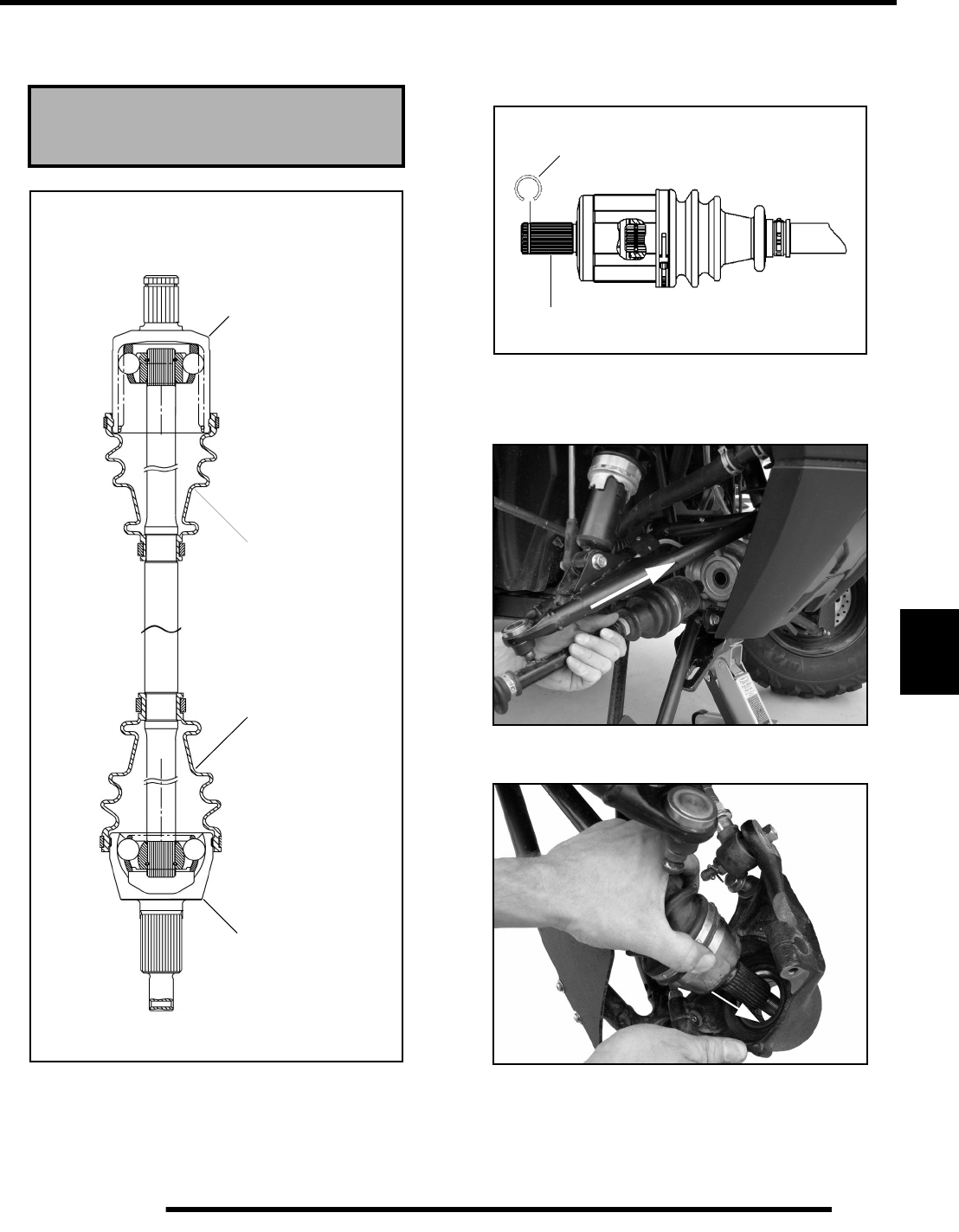
7.9
FINAL DRIVE
7
21. Position the boot lip in its groove. Install and secure the
boot with the large clamp using the “earless” clamp pliers. Drive Shaft Installation
1. Install new spring ring on drive shaft. Apply an anti-seize
compound to splines.
2. Align splines of drive shaft with front gearcase and reinstall
the drive shaft. Use a rubber mallet to tap on the outboard
end of the drive shaft if necessary
3. Install drive shaft into the front bearing carrier.
4. Install the upper ball joint end into the front bearing carrier.
CV Boot Clamp Pliers
Earless Type: 8700226
FRONT DRIVE SHAFT
Grease Capacity
80 Grams
Grease Capacity
80 Grams
Plunging
Joint
CV Joint
Apply
Anti-Seize
NEW
Spring Ring

7.10
FINAL DRIVE
5. Install the upper pinch bolt and torque to specification.
6. Apply grease to drive shaft axle splines.
7. Install front wheel hub assembly, cone washers, and hand
tighten the castle nut. Install washers with domed side out.
8. Torque wheel hub nut to specification and install a new
cotter pin. Tighten nut slightly if necessary to align cotter
pin holes.
9. Install brake caliper mounting bolts and torque to
specification.
10. Install wheel and (4) wheel nuts. Torque wheel nuts to
specification.
11. Rotate wheel and check for smooth operation. Bend both
ends of cotter pin around end of spindle in different
directions.
= T
Pinch Bolts:
22.5 ft. lbs. (30.5 Nm)
22.5 ft. lbs.
30.5 (Nm)
Out
Cone Washers
Wheel
Hub
80 ft. lbs.
NEW Cotter Pin
(108 Nm)
= T
Wheel Hub Castle Nut:
80 ft. lbs. (108 Nm)
= T
Front Caliper Mounting Bolts:
31-34 ft. lbs. (42-46 Nm)
CAUTION
New bolts have a pre-applied locking agent
which is destroyed upon removal. Always use
new brake caliper mounting bolts
upon assembly.
= T
Wheel Nuts:
Steel Wheels: 35 ft. lbs. (47 Nm)
Aluminum Wheels: 30 ft. lbs. + 90° (1/4 turn)

7.11
FINAL DRIVE
7
PROPSHAFT SERVICE
Removal / Installation
1. Locate the propshaft roll pin and use the Roll Pin Removal
Tool (PN 2872608) to remove the roll pin.
NOTE: Front wheel can be removed to gain better
access to the propshaft roll pin.
2. Remove the gear selector cap and remove the retaining
screw.
3. Remove the Torx screws retaining the center console to
access the propshaft.
4. Slide prop shaft back far enough to remove it from the front
gearcase input shaft.
5. Pull sharply forward to remove it from transmission shaft.
NOTE: You may have to loosen the front gearcase
mounting bolts to allow for propshaft removal.
6. Remove the fasteners retaining the plastic skid plate and
remove the skid plate from the vehicle.
7. Remove the propshaft from the vehicle.
8. Reverse removal steps to reinstall propshaft. Use a NEW
Roll Pin (Spring Pin) upon reassembly.
Roll Pin Removal Tool (PN 2872608)
Screw
Torx Screws
Cap
Torx Screws
Torx Screws
Screws
Cupped
Washers
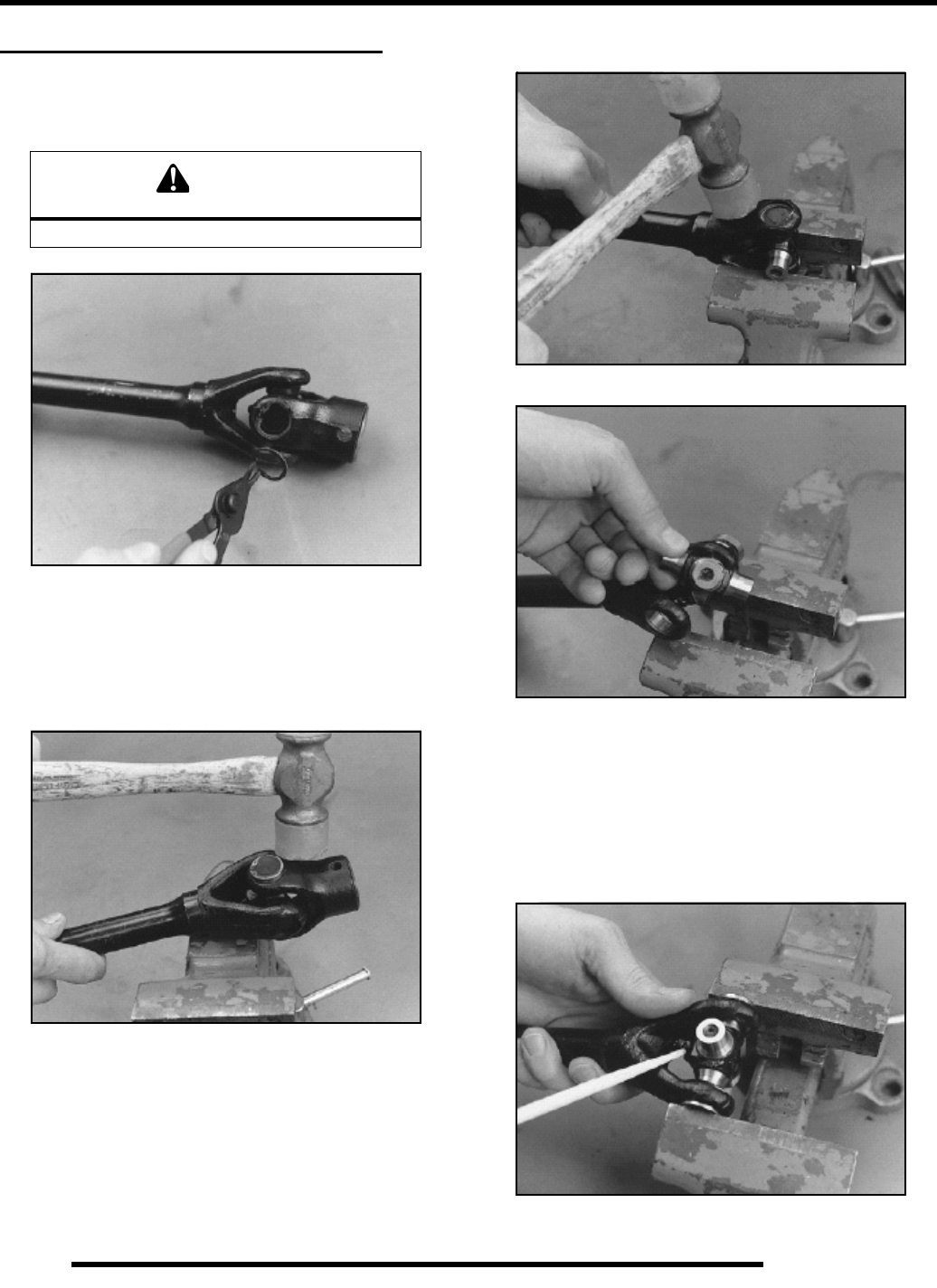
7.12
FINAL DRIVE
PROPSHAFT U-JOINT SERVICE
Disassembly
1. Remove internal or external snap ring from bearing caps.
NOTE: If yoke or bearing is removed, cross bearing
must be replaced. Note orientation of grease fitting
and mark inner and outer yoke for correct re-
positioning during installation.
2. Support inner yoke as shown and drive outer yoke down
(bearing cap out) with a soft face hammer.
3. Support U-joint in vise as shown and drive inner yoke down
to remove remaining bearing caps.
4. Force U-joint cross to one side and lift out of inner yoke.
Assembly
1. Install new bearing caps in yoke by hand. Carefully install
U-joint cross with grease fitting properly positioned
inward toward center of shaft. Take care not to dislodge
needle bearings upon installation of cross joint.
2. Tighten vise to force bearing caps in.
CAUTION
Always wear eye protection.
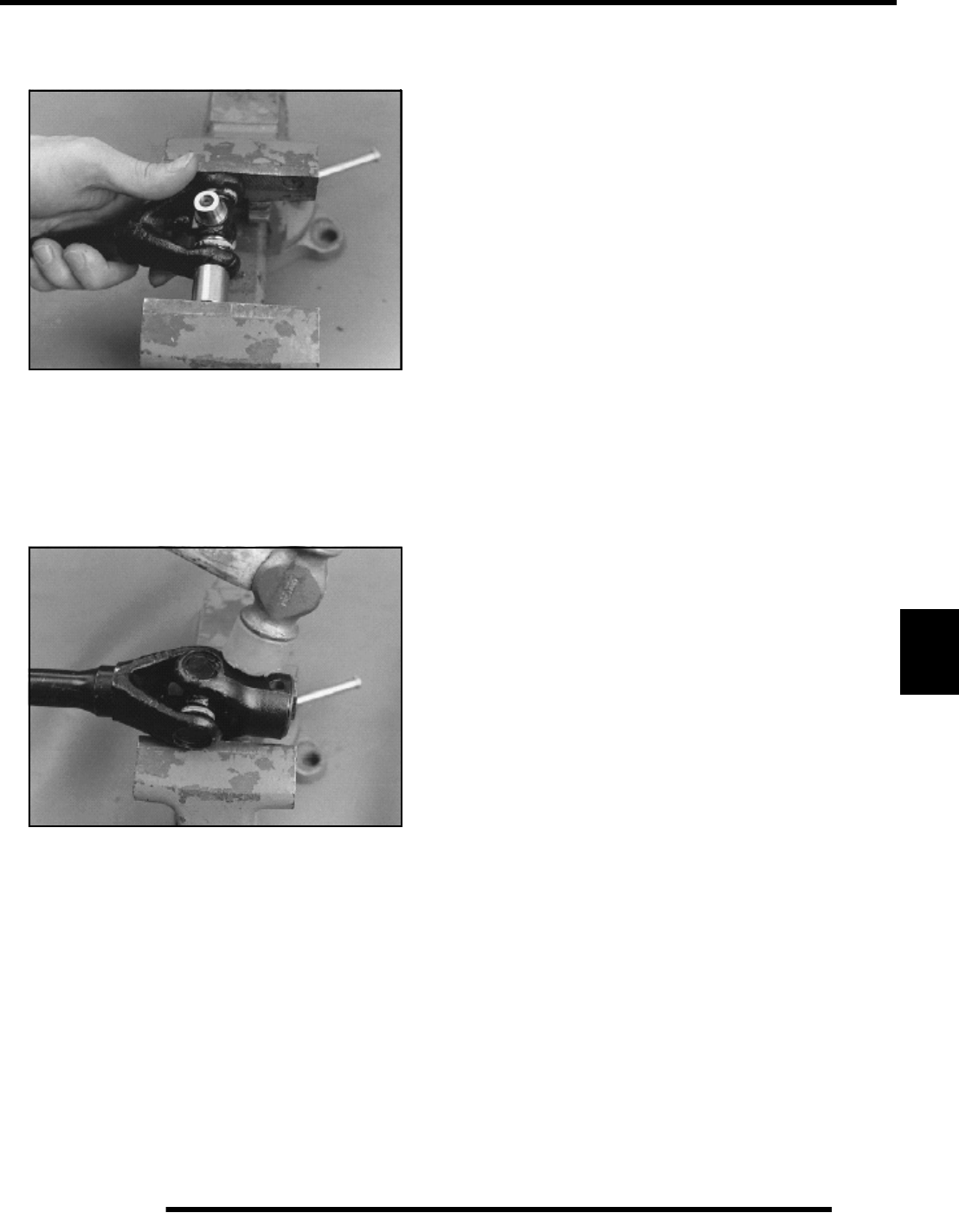
7.13
FINAL DRIVE
7
3. Using a suitable arbor, fully seat the bearing cap in one side.
Continually check for free movement of bearing cross as
bearing caps are assembled.
4. Install snap ring to contain bearing cap just installed.
Repeat procedure for other side.
5. Install outer yoke, aligning marks made at disassembly and
repeat Steps 1-3 to install bearing caps on outer yoke.
6. Seat all bearing caps against snap rings by supporting cross
shaft and tapping on each corner as shown.
7. When installation is complete, yokes must pivot freely in
all directions without binding. If the joint is stiff or binding,
tap the yoke lightly to center the joint until it pivots freely.

7.14
FINAL DRIVE
FRONT GEARCASE / CENTRALIZED HILLIARD
Centralized Hilliard Exploded View
8-10 ft. lbs.
(11-14 Nm)
7-11 ft. lbs.
(10-15 Nm)
8-10 ft. lbs.
(11-14 Nm)
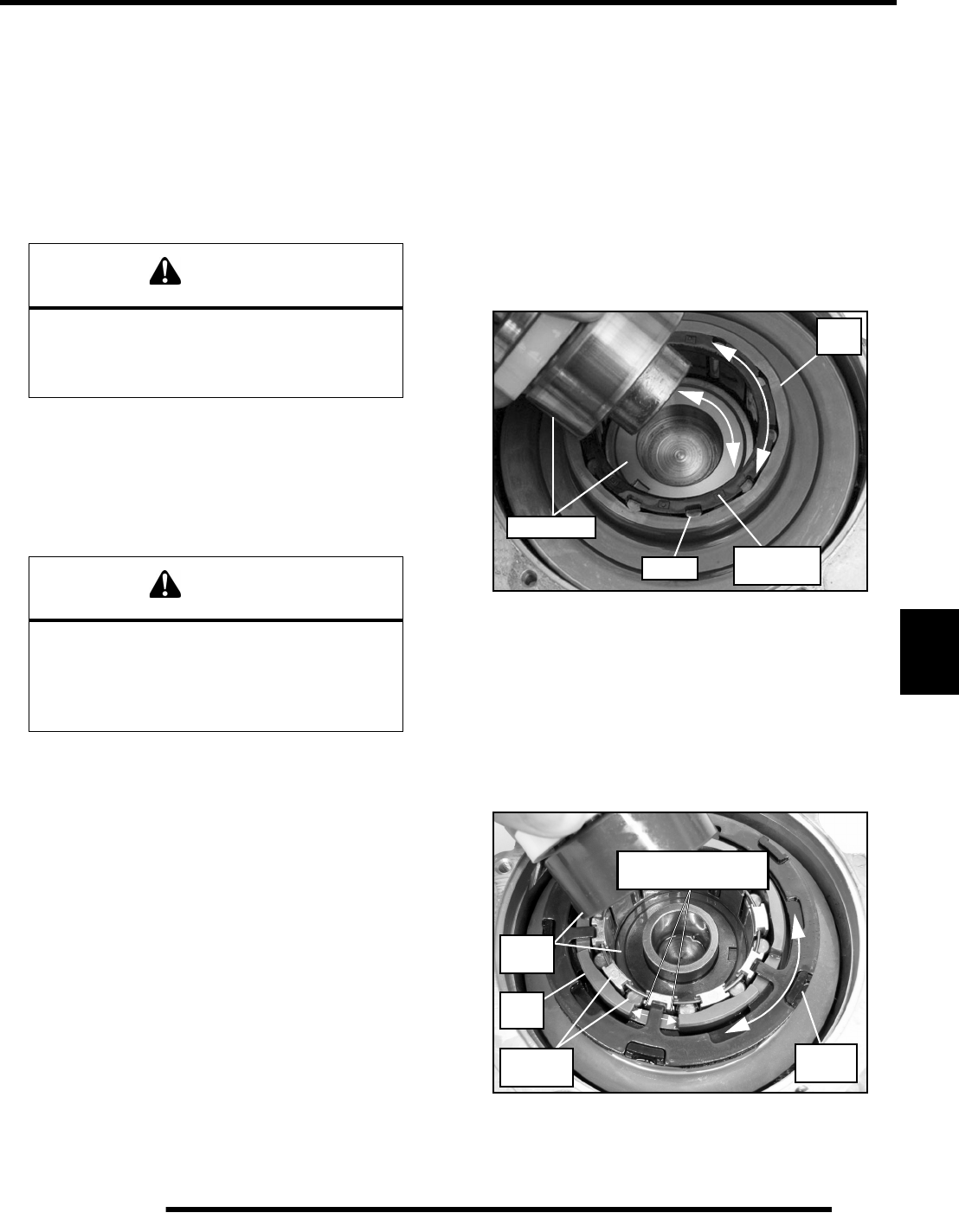
7.15
FINAL DRIVE
7
All Wheel Drive Operation
The AWD switch may be turned on or off while the vehicle is
moving, however, AWD will not enable until the engine RPM
drops below 3100. Once the AWD is enabled, it remains enabled
until the switch is turned off.
Engage the AWD switch before getting into conditions where
the front wheel drive may be needed. If the rear wheels are
spinning, release the throttle before switching to AWD.
With the AWD switch off, the vehicle drives through the rear
wheels only (2 wheel drive). When the AWD is enabled, the
front drive acts as an on-demand AWD system. This means, the
front drive will engage once the rear wheels have lost traction,
and will remain engaged until the torque requirement goes away
(i.e. rear wheels regain traction).
AWD Engagement: When the AWD switch is activated, the
AWD coil is powered by a 12 Vdc input which creates a
magnetic field. This magnetic field attracts an armature plate
that is keyed to the roll cage. When the ring gear and roll cage
are spinning (vehicle is moving), the energized coil and
armature plate will apply drag to the roll cage that indexes the
rollers inside the ring gear to an engagement position. While in
the engagement position, the front drive will be in an “over-
running” condition (not engaged), until the rear wheels lose
traction. Once the rear wheels begin to lose traction, the front
drive will engage by coupling the output hubs to the ring gear via
the rollers. The front drive will remain engaged until the torque
requirement goes away (i.e. rear wheels regain traction).
AWD Disengagement: Once the rear wheels regain traction,
the front wheels will return to the “over-running” condition. The
vehicle is now back to rear wheel drive until the next loss of rear
wheel traction occurs.
Torsion Spring Operation: The torsion spring acts as a return
mechanism to help disengage the coupling of the output hubs
and ring gear by creating an “over-running” condition for the
rollers upon disengagement.
CAUTION
Switching to AWD while the rear wheels are
spinning may cause severe drive shaft and
gearcase damage. Always switch to AWD while
the rear wheels have traction or are at rest.
CAUTION
If the rear wheels are spinning, release the
throttle before turning the AWD switch on.
If AWD is engaged while the wheels are
spinning, severe drive shaft and front
gearcase damage could result.
Roll Cage
& H-Springs
Output Hubs
Ring
Gear
Rollers
Ring
Gear
Centers Roll Cage and
Torsion
Spring
Roll Cage
& Rollers
Rollers in Ring Gear
Output
Hubs
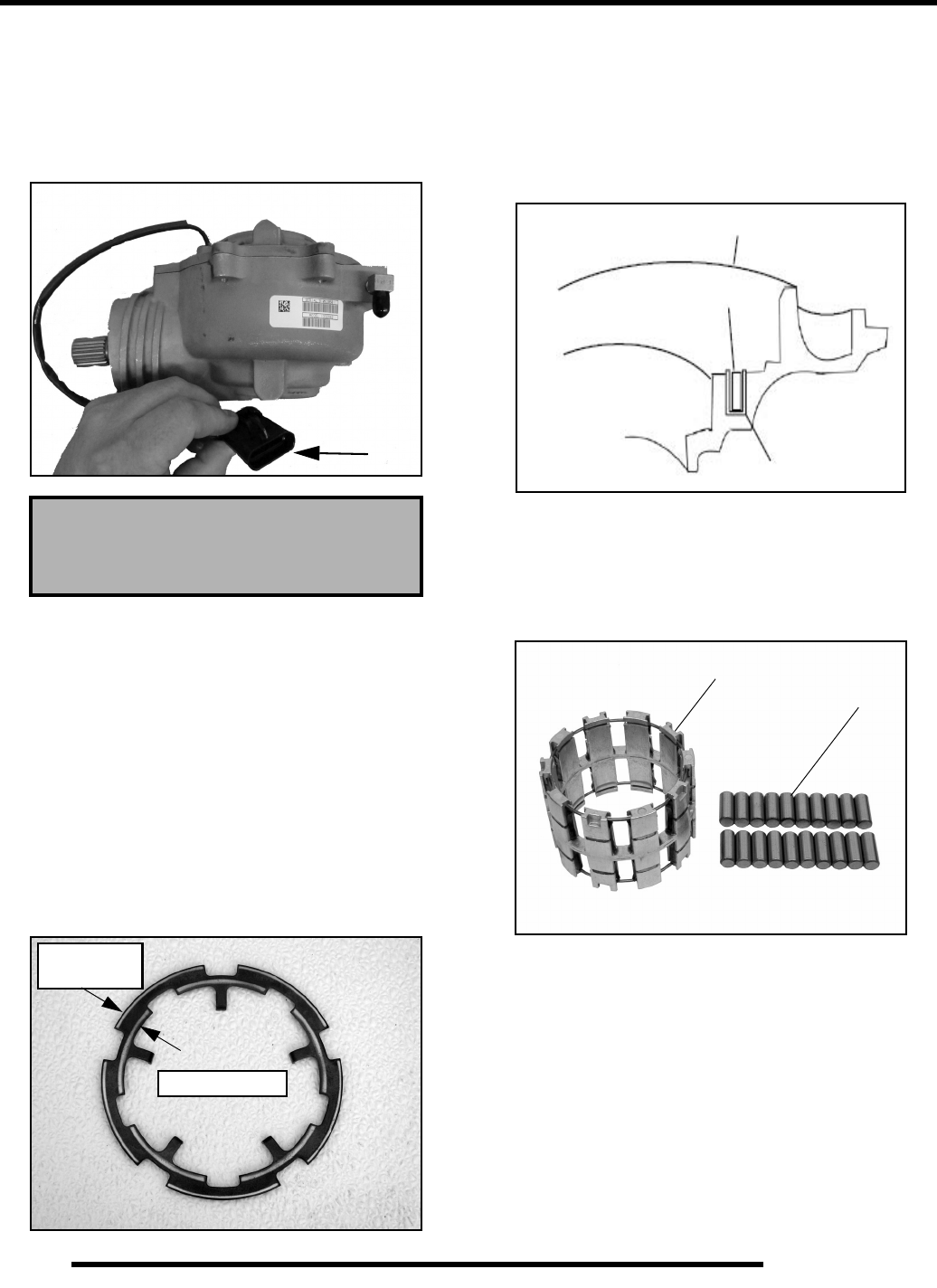
7.16
FINAL DRIVE
AWD Diagnosis
Symptom: AWD Will Not Engage
1. Check the gearcase coil resistance. To test the coil
resistance, measure between the Grey and Brown/White
wires. The measurement should be within specification.
2. Turn the ignition and AWD switches on and place gear
selector in High or Low gear. Check for minimum battery
voltage at the Gray and Brown/White chassis wires that
power the coil. A minimum of 11 Vdc should be present.
3. If electrical tests are within specification, remove gearcase
(see “Gearcase Removal”) and inspect components.
4. Inspect the armature plate for a consistent wear pattern.
There should be two distinct wear bands (one band inside
the other). If only one band of wear is present (or if there
is wear between the two bands), inspect the coil area as
indicated in Step 5. A wear band with an interrupted wear
mark may indicate a warped plate, which may cause
intermittent operation. See the following illustrations:
5. Check to make sure the coil is seated in the U-shaped insert
that is pressed into the gearcase cover. The top of the coil
should be seated below the U-shaped insert. The U-shaped
insert controls the pole gap. If the top of the coil is above
the surface of the U-shaped insert it raises the armature
plate, thereby increasing pole gap. If the pole gap increases
the coil will not be strong enough to engage the AWD
system. If this is found, replace the cover plate assembly.
6. Inspect the rollers for nicks and scratches. The rollers must
slide up, down, in and out freely within the roll cage sliding
surfaces and H-springs.
7. Inspect the roll cage assembly for cracks or excessive wear.
If damaged, replace the roll cage assembly.
Front Gearcase Coil Resistance:
21.6 - 26.4 Ohms
Check for
Armature Plate
wear bands
Gearcase Cover Plate Asm.
Coil
U-shaped insert
Side cutaway
view of cover
Rollers
Roll Cage Assembly
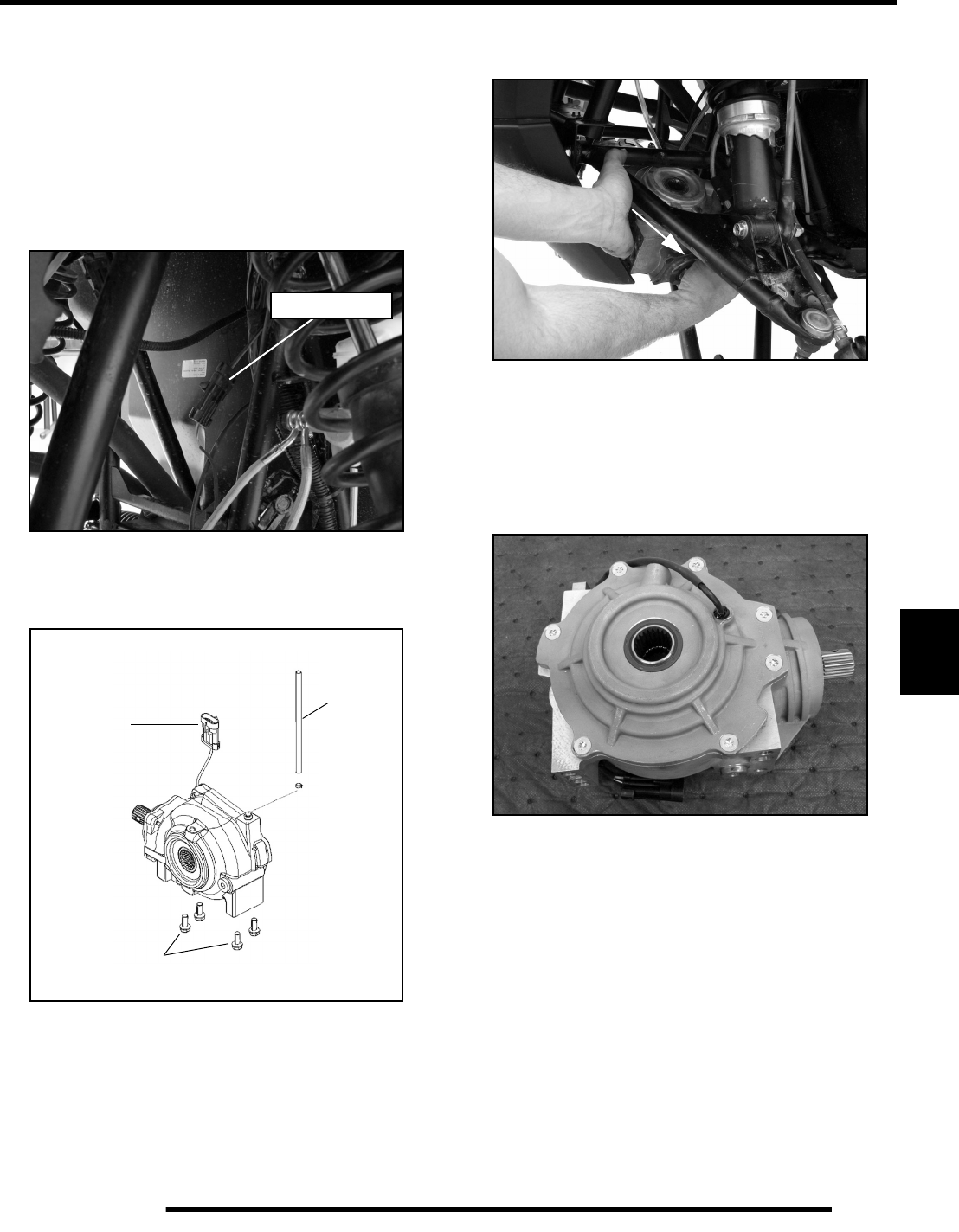
7.17
FINAL DRIVE
7
Gearcase Removal
1. Stop engine and place gear selector in Park.
2. Refer to “FRONT DRIVE SHAFT - Drive Shaft Removal”
and remove both front drive shafts from the front gearcase.
3. Remove the propshaft (see “PROPSHAFT SERVICE”).
4. Disconnect the wire harness above the front gearcase and
remove the harness from the retaining dart.
5. Remove the vent line from the front gearcase.
6. Remove the (4) bolts securing the front gearcase to frame.
7. Remove the gearcase from the front LH wheel well area and
slide it between the upper and lower A-arm.
Gearcase Disassembly / Inspection
1. Drain and properly dispose of gearcase fluid. Remove any
metal particles from the drain plug magnet.
2. Remove the (7) cover screws and remove the cover plate.
3. Remove and inspect the armature plate. Refer to “AWD
Diagnosis” for detailed inspection process.
AWD Harness
Remove 4 Bolts
Remove
Vent Line
Disconnect
Harness

7.18
FINAL DRIVE
4. Remove the LH output hub assembly from the clutch
housing.
5. Carefully remove the armature plate, torsion spring retainer
and torsion spring from the ring gear.
6. Remove the clutch housing / ring gear from the gearcase
housing.
7. Remove the RH output hub assembly from the gearcase
housing.
8. Remove pinion seal. The pinion seal must be replaced every
time it is removed. Take out the internal snap ring. Remove
pinion / bearing assembly from the gearcase housing by
pulling and rocking the pinion shaft strait out. Inspect and
clean the gearcase housing and replace ALL oil seals.
9. Clean and inspect all parts. Check for excessive wear or
damage.
Armature plate
Spring and
Retainer
Replace
Seals
Internal Snap Ring
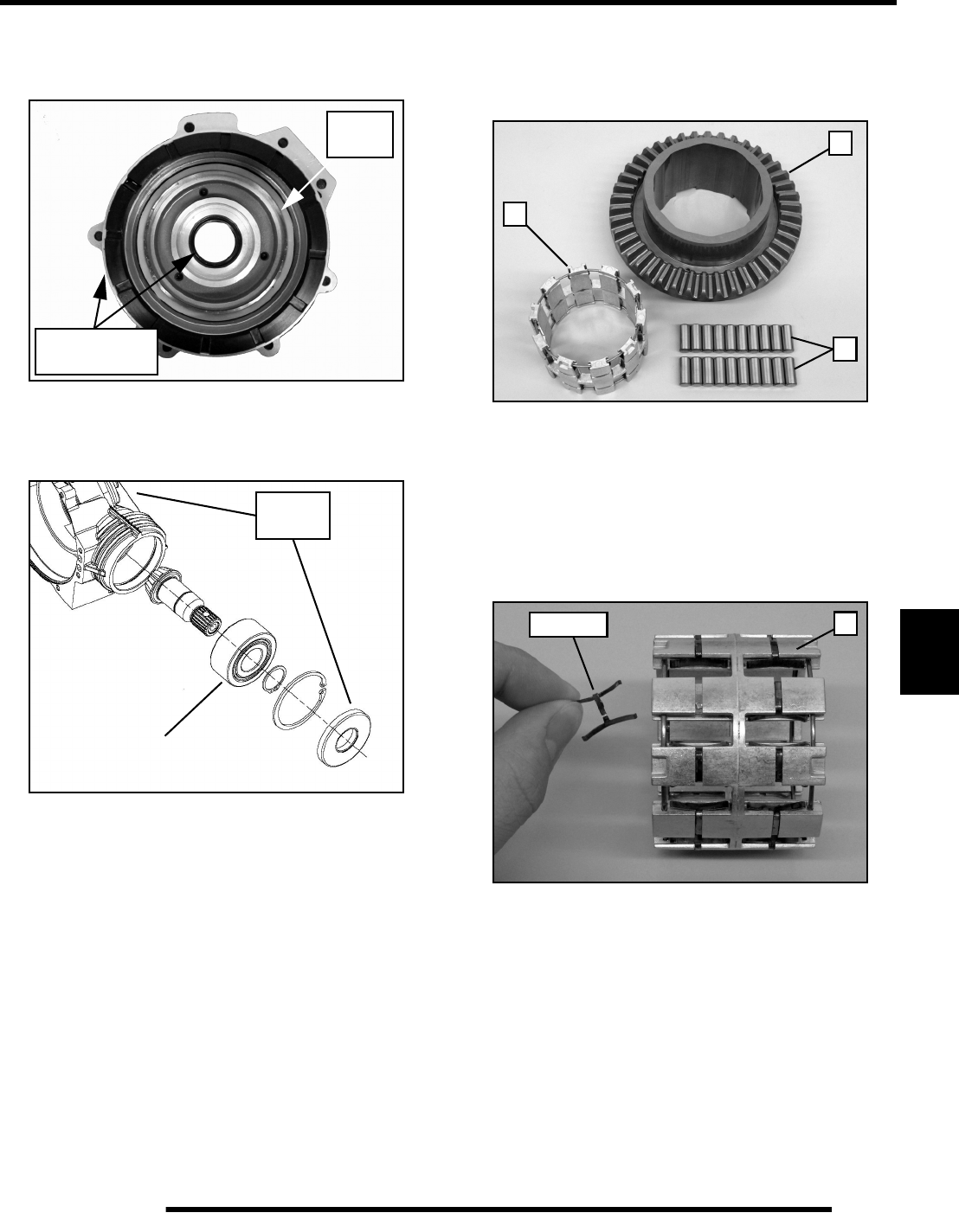
7.19
FINAL DRIVE
7
10. Inspect the coil located in the cover plate assembly. Refer
to “AWD Diagnosis” for detailed inspection process.
Replace the cover plate seal and O-ring.
11. Disassemble the pinion shaft assembly. Inspect the
bearings and replace if needed. Replace the pinion cover
seal and O-ring.
12. Remove the roll cage assembly and rollers from the clutch
housing. Use a shop towel to cover the housing in order to
retain all the rollers.
NOTE: Rollers are spring loaded. Take care not to
allow them to fall out or lose them upon removal of
the roll cage.
13. Thoroughly clean all parts and inspect the rollers (A) for
nicks and scratches. The rollers must slide up and down and
in and out freely within the roll cage sliding surfaces and
H-springs.
IMPORTANT: Refer to the “Electronic Parts Catalog”
for individual part availability. Most parts are to be
replaced as an assembly or as a complete kit.
14. Inspect the roll cage assembly (B) sliding surfaces and H-
springs. The sliding surfaces must be clean and free of
nicks, burrs or scratches. If damaged, replace the roll cage
assembly.
15. Inspect clutch housing ring gear (C) for a consistent wear
pattern. Inspect the ring gear for chipped, broken, or
missing teeth.
Inspect
Coil
Replace
O-Ring & Seal
Replace
Seals
Inspect bearing
A
C
B
B
H-Spring
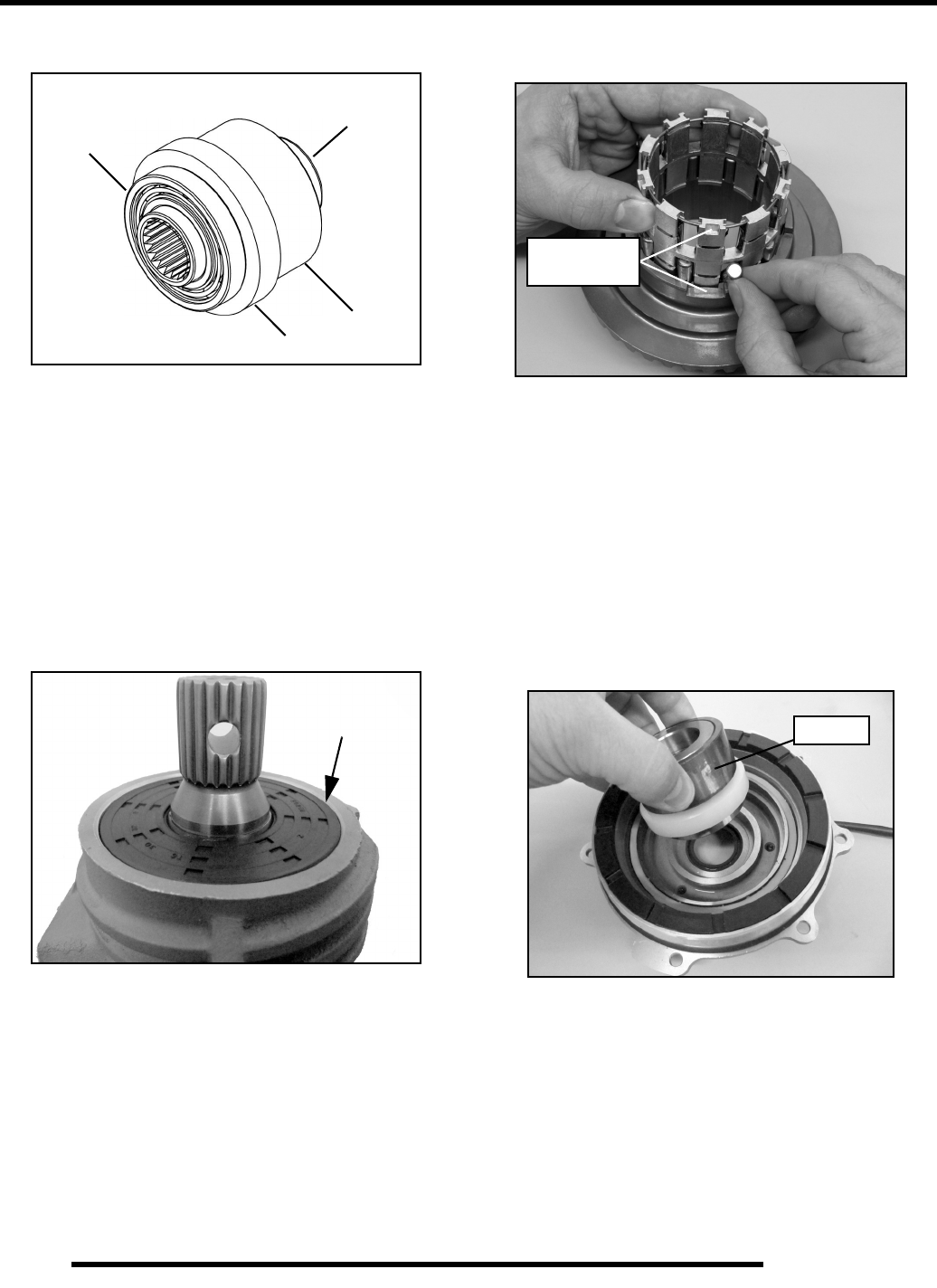
7.20
FINAL DRIVE
16. Inspect both output hub assemblies. Inspect the bearings
and replace if needed.
Gearcase Assembly / Inspection
1. As mentioned during gearcase disassembly section,
replace all O-rings, seals, and worn components.
2. If bearing replacement was required, press new bearings on
to the pinion shaft assembly and install snap ring.
3. Install pinion shaft assembly and install the internal snap
ring.
4. Press the pinion shaft seal into the pinion cover, until the
seal is just below chamfer of gearcase.
5. Carefully install the rollers into the roll cage assembly
while installing the assembly into the clutch housing.
NOTE: Install the roll cage so that the ring gear
grooves line up with the roll cage slots (see below).
IMPORTANT: To ensure gearcase is assembled
properly, assemble the gearcase components
starting with the cover plate and build upward.
6. Install a new O-ring on the cover plate assembly.
NOTE: Be sure the square O-ring is placed flat on
the cover surface. If the O-ring is twisted fluid
leakage may occur.
7. Carefully install the LH output hub assembly with the thrust
bearing into the cover plate. Take care not to damage the
new cover plate seal while installing the output hub.
8. Install the armature plate and assemble the clutch housing:
Bearing
Spacer
Roller
Thrust
Bearing
Surface
Press Seal in Just
Past Chamfer
Align during
installation
LH Hub

7.21
FINAL DRIVE
7
9. Install the torsion spring by wrapping each leg of the spring
around the dowel pin on the ring gear.
10. Align the spring retainer dowel pin with the ring gear dowel
pin and install the retainer on top of the torsion spring.
11. Check the action of the torsion spring by rotating in both
directions to ensure the spring and retainer are installed
properly.
12. Be sure the armature plate tabs are fully engaged into the
roll cage assembly and are resting on the cut-grooves of the
ring gear.
NOTE: Verify armature plate tabs are in the slots on
the roll cage and are resting in the ring gear grooves.
13. While holding the clutch housing and the armature plate in
the roll cage, flip the clutch housing assembly over and set
it on the cover plate.
NOTE: Be sure to hold armature plate in place until
the housing is completely resting on the cover plate.
14. Install the RH output hub into the clutch housing assembly.
15. Line up the gearcase housing with the cover plate assembly.
Set the gearcase housing on top of the assembled cover
plate. Take care not to damage the new seal when installing
the gearcase housing.
Align during
installation
Engage
Tabs
Armature Plate
& Torsion Spring
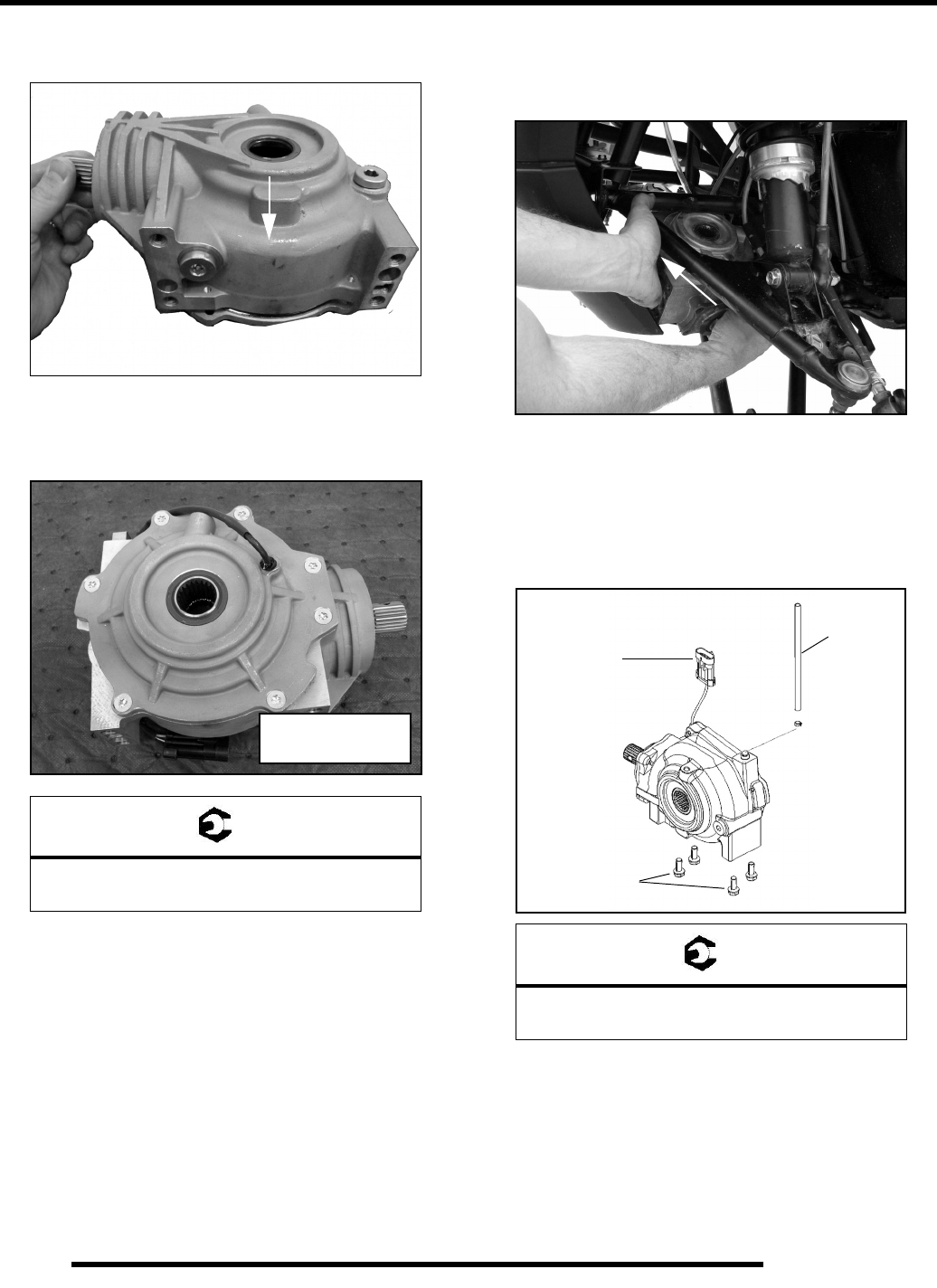
7.22
FINAL DRIVE
NOTE: Rotate the input shaft while setting the
gearcase housing in place.
16. While holding the gearcase together, flip it over and install
the cover plate screws. Torque screws to 7-11 ft. lbs. (10-
15 Nm).
Gearcase Installation
1. Install the gearcase back into the vehicle through the LH
wheel well area, between the upper and lower A-arms.
2. Install the propshaft onto the front gearcase input shaft. Use
a NEW spring pin in the front propshaft.
3. Install the (4) bolts that secure the front gearcase to the
frame and torque to 30 ft. lbs. (41 Nm).
4. Install the vent line.
= T
Cover Plate Screws:
7-11 ft. lbs. (10-15 Nm)
Torque All Cover
Plate Screws
= T
Front Gearcase Mounting Bolts:
30 ft. lbs. (41 Nm)
30 ft. lbs.
Install
Vent Line
Connect
Harness
(41 Nm)
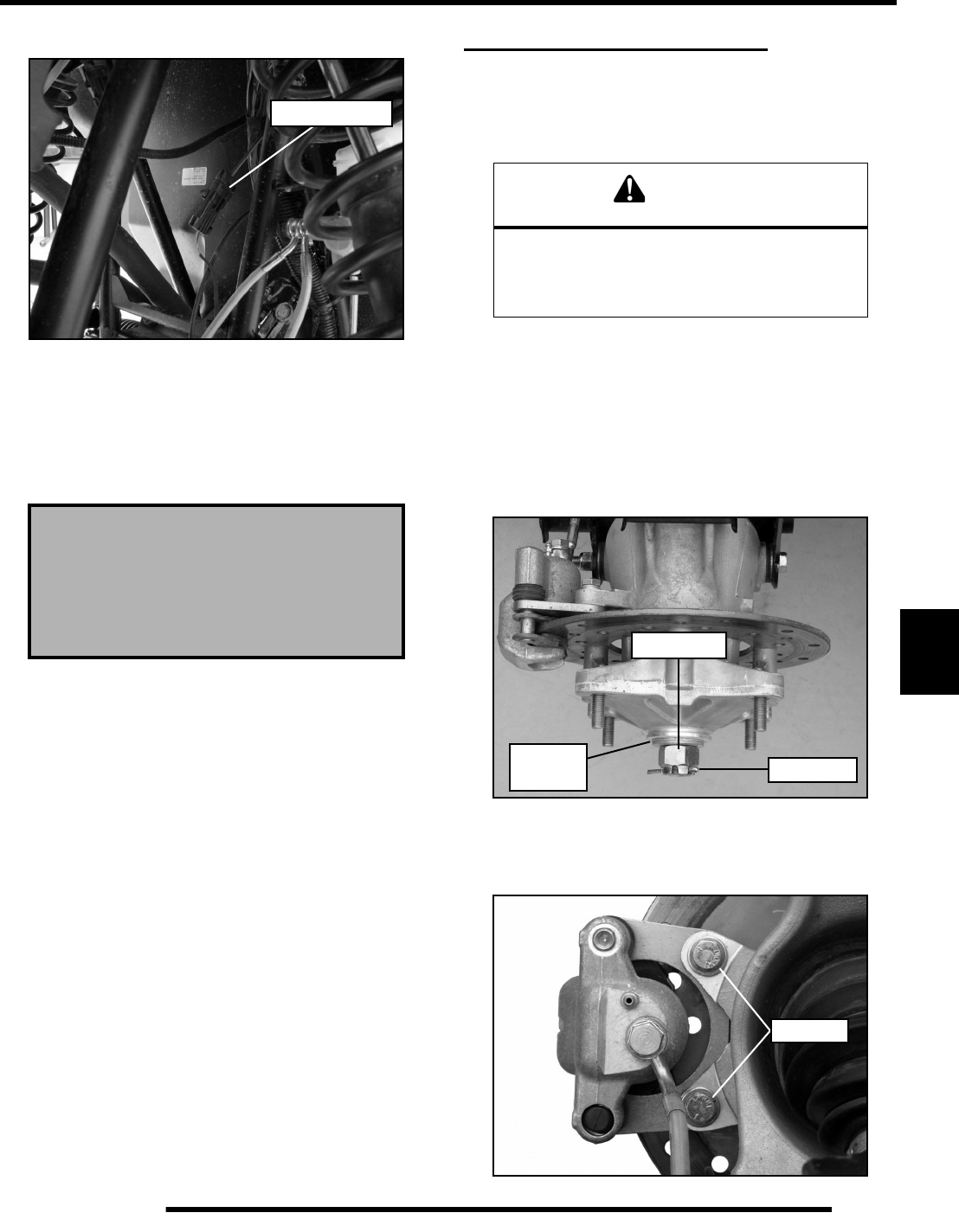
7.23
FINAL DRIVE
7
5. Connect the AWD wire harness.
6. Refer to “FRONT DRIVE SHAFT - Drive Shaft
Installation” and install both front drive shafts into the front
gearcase.
7. Add the proper lubricant to the front gearcase. Refer to
Chapter 2 for fluid fill and change information.
REAR BEARING CARRIER
Bearing Carrier Inspection / Removal
1. Elevate rear of vehicle and safely support machine under
the frame area.
2. Check bearings for side play by grasping the top and bottom
of the tire firmly and checking for movement. The tire
should rotate smoothly without binding or rough spots.
3. Remove the (4) wheel nuts and remove the rear wheel.
4. Remove the cotter pin and loosen the rear wheel hub castle
nut. Remove the nut, and (2) cone washers from the rear
wheel hub assembly.
5. Remove the two brake caliper mounting bolts.
CAUTION: Do not hang the caliper by the brake line. Use
wire to hang caliper to prevent damage to the brake line.
Polaris Demand Drive Plus
(PN 2877922)
Front Housing Capacity
6.75 fl. oz. (200 ml)
AWD Harness
CAUTION
Serious injury may result if machine tips or falls.
Be sure machine is secure before beginning this
service procedure. Wear eye protection when
removing bearings and seals.
Castle Nut
Cotter Pin
Cone
Washers
Remove

7.24
FINAL DRIVE
6. Remove the rear wheel hub assembly.
7. Remove the bolts that attach the rear bearing carrier to the
upper and lower A-arms.
8. Remove the bearing carrier from the rear drive shaft.
9. Rotate bearing by hand and check for smooth rotation.
Visually inspect bearing for moisture, dirt, or corrosion.
NOTE: Due to extremely close tolerances and
minimal wear, the bearings must be inspected
visually, and by feel. While rotating bearings by
hand, inspect for rough spots, discoloration, or
corrosion. The bearings should turn smoothly and
quietly, with no detectable up and down movement
and minimal movement sideways between inner and
outer race.
10. Replace bearing if moisture, dirt, corrosion, or roughness
is evident.
Bearing Replacement
Bearing Removal
1. Remove outer snap ring.
2. From the back side of the bearing carrier, tap on the outer
bearing race with a drift punch in the reliefs as shown.
3. Drive bearing out evenly by tapping on outer race only.
Once bearing is at bottom of casting, support casting on
outer edges so bearing can be removed.
4. Inspect the bearing carrier housing for scratches, wear or
damage. Replace rear bearing carrier if damaged.
Snap Ring

7.25
FINAL DRIVE
7
Bearing Installation
5. Thoroughly clean the rear bearing carrier housing and the
outer race on the new bearing. Be sure that all oil residue
has been removed from each surface.
6. Support the bottom of the bearing carrier housing.
7. Apply Loctite® 603™ retaining compound to the outer
circumference of the new bearing race and carefully press
the new bearing into the bearing carrier housing.
NOTE: Use care to not allow any of the Loctite®
compound to get in the bearing.
8. Wipe the housing clean of any excess compound and install
the snap ring.
Bearing Carrier Bushing Replacement
Check bearing carrier bushings and pivot tubes for excessive
wear or damage. If replacement is required, slide pivot tubes out
and remove bushings with a drift punch. Install new bushings by
pressing them into the bearing carrier.
Bearing Carrier Installation
1. Install drive shaft axle through the backside of the bearing
carrier. Be sure bushings and pivot tubes are installed.
2. Install the fasteners that attach the rear bearing carrier to the
upper and lower A-arms. Torque bolts to specification.
3. Apply grease to drive shaft axle splines.
CAUTION
Use an arbor and press only on the outer race,
otherwise bearing damage may occur.
Apply
Loctite® 603™
Bearing
Snap Ring
Pivot Tube
Pivot
Control Arm
Bushing
Control Arm
Bushing
Bushing
Pivot Tube
= T
Upper Rear Bearing Carrier Bolts:
40 ft. lbs. (54 Nm)
= T
Lower Rear Bearing Carrier Bolts:
40 ft. lbs. (54 Nm)

7.26
FINAL DRIVE
4. Install rear wheel hub assembly, cone washers, and hand
tighten the castle nut. Install washers with domed side out.
5. Install brake caliper mounting bolts and torque to 18 ft. lbs.
(24 Nm).
6. Torque wheel hub nut to 80 ft. lbs. (108 Nm) and install a
NEW cotter pin. Tighten nut slightly if necessary to align
cotter pin holes.
7. Install wheel and (4) wheel nuts. Torque wheel nuts to
specification.
8. Rotate wheel and check for smooth operation. Bend both
ends of cotter pin around end of spindle in different
directions.
= T
Rear Caliper Mounting Bolts:
18 ft. lbs. (24 Nm)
CAUTION
New bolts have a pre-applied locking agent
which is destroyed upon removal. Always use
new brake caliper mounting bolts
upon assembly.
Out
Cone Washers
Wheel
Hub
18 ft. lbs.
24 (Nm)
= T
Wheel Hub Castle Nut:
80 ft. lbs. (108 Nm)
= T
Wheel Nuts:
Steel Wheels: 35 ft. lbs. (47 Nm)
Aluminum Wheels: 30 ft. lbs. + 90° (1/4 turn)
80 ft. lbs.
(108 Nm)
NEW Cotter Pin
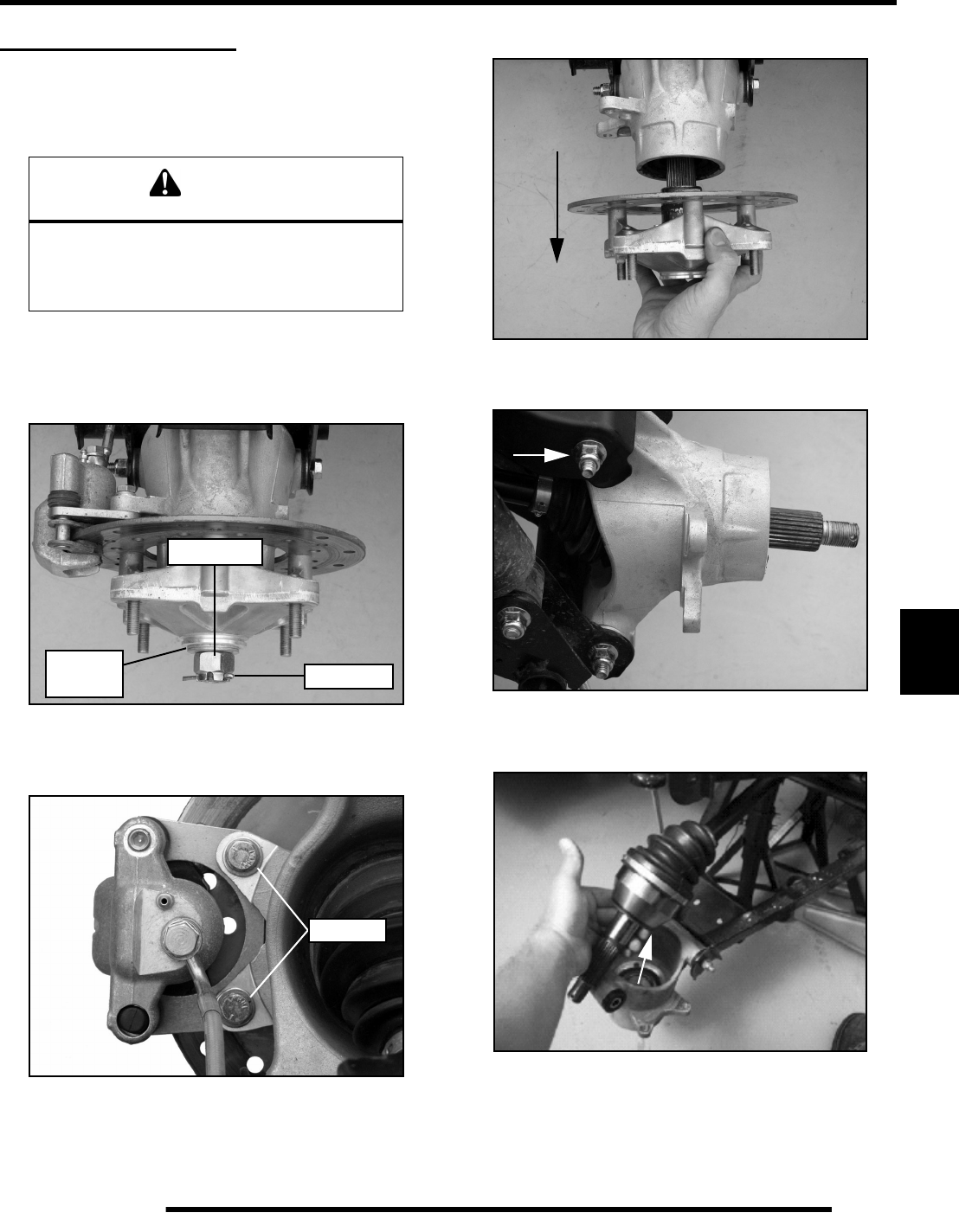
7.27
FINAL DRIVE
7
REAR DRIVE SHAFT
Drive Shaft Removal
1. Elevate rear of vehicle and safely support machine under
the frame area.
2. Remove the (4) wheel nuts and remove the rear wheel.
3. Remove the cotter pin and loosen the rear wheel hub castle
nut. Remove the nut, and (2) cone washers from the rear
wheel hub assembly.
4. Remove the two brake caliper attaching bolts.
CAUTION: Do not hang the caliper by the brake line. Use
wire to hang caliper to prevent damage to the brake line.
5. Remove the rear wheel hub assembly.
6. Remove the bolt that attaches the rear bearing carrier to the
upper A-arm.
7. Slide the rear drive shaft out of the bearing carrier by
pulling the bearing carrier assembly outward and tipping it
down to remove the shaft.
8. Grasp the rear drive shaft and pull sharply outward on the
shaft to disengage it from the rear gearcase.
CAUTION
Serious injury may result if machine tips or falls.
Be sure machine is secure before beginning this
service procedure. Wear eye protection when
removing bearings and seals.
Castle Nut
Cotter Pin
Cone
Washers
Remove
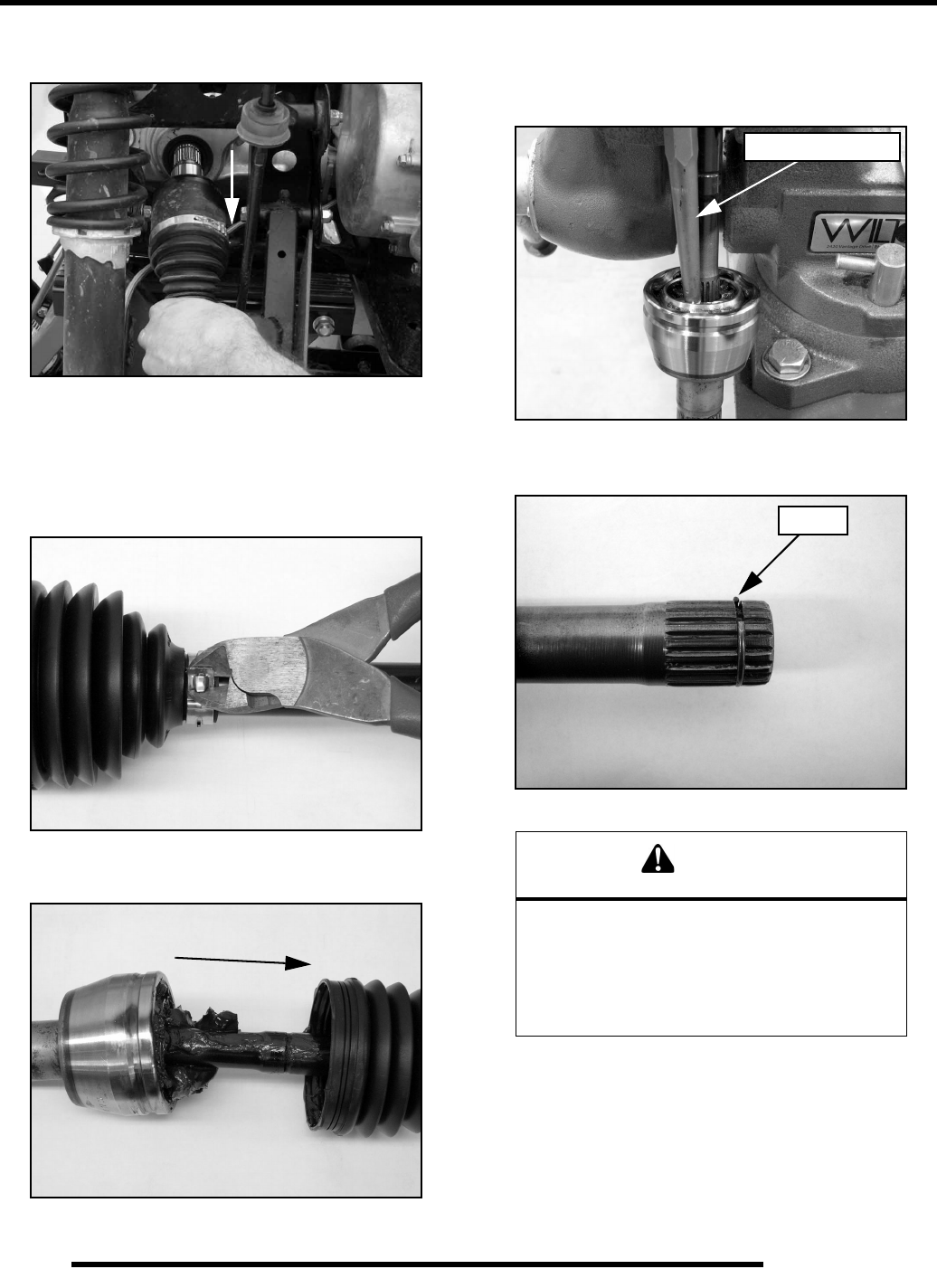
7.28
FINAL DRIVE
NOTE: Take care when removing to prevent
damaging the seal.
9. Inspect the axle splines and CV boots for any damage.
Outer CV Joint / Boot Replacement
1. Using a side cutters, cut away and discard the boot clamps.
2. Remove the large end of the boot from the CV joint and
slide the boot down the shaft.
3. Clean the grease from the face of the joint.
4. Place the drive shaft in a soft-jawed vise. Using a soft-faced
hammer, or brass drift, strike the inner race of the joint to
drive the joint off the drive shaft. Be sure to tap evenly
around the joint to avoid binding.
IMPORTANT: Tap on inner race only!
5. Make sure the circlip is on the shaft and not left in the joint.
6. Remove the CV boot from the shaft.
CAUTION
Complete disassembly of the CV joint is NOT
recommended. The internal components are a
precision fit and develop their own characteristic
wear patterns. Intermixing the internal
components could result in looseness, binding,
and/or premature failure of the joint.
Brass Drift Shown
Circlip
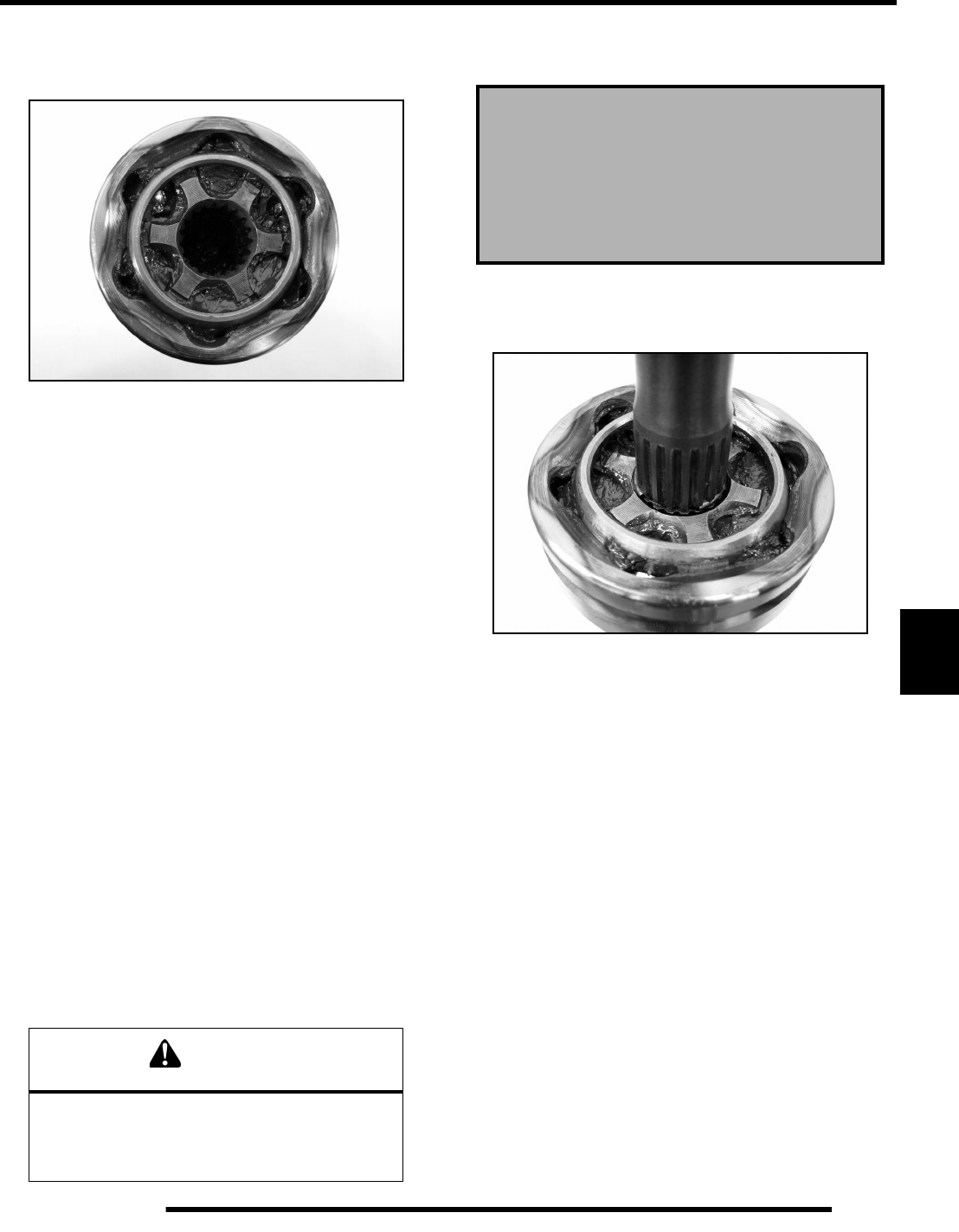
7.29
FINAL DRIVE
7
IMPORTANT: If the grease in the joint is obviously
contaminated with water and/or dirt, the joint should
be replaced.
7. Thoroughly clean the joint with an appropriate solvent and
dry the joint to prevent any residual solvent from being left
in the joint upon reassembly.
8. Visually inspect the joint by tilting the inner race to one side
to expose each ball. Severe pitting, galling, play between
the ball and its cage window, any cracking or damage to the
cage, pitting or galling or chips in raceways call for joint
replacement.
NOTE: Shiny areas in ball tracks and on the cage
spheres are normal. Do not replace CV joints
because parts have polished surfaces. Replace CV
joint only if components are cracked, broken, worn
or otherwise unserviceable.
9. Clean the splines on the end of the shaft and apply a light
coat of grease prior to reassembly.
10. Slide the small boot clamp and boot (small end first) onto
the drive shaft and position the boot in it’s groove machined
in the shaft.
11. Install a NEW circlip on the end of the shaft.
12. Grease the joint with the special CV joint grease provided
in the boot replacement kit. Fill the cavity behind the balls
and the splined hole in the joint’s inner race. Pack the ball
tracks and outer face flush with grease. Place any remaining
grease into the boot.
NOTE: The amount of grease that’s provided is pre-
measured, so use all the grease.
13. Slide the joint onto the drive shaft splines and align the
circlip with the lead-in chamfer on the inner race of the
joint.
14. Use a soft-faced hammer to tap the joint onto the drive shaft
until it locks into place.
15. Pull on the joint to make sure it is securely locked in place.
16. Remove excess grease from the CV joint's external surfaces
and place the excess grease in the boot.
17. Pull the boot over the joint and position the boot lips into
the grooves on the joint housing and shaft. Make sure the
boot is not dimpled or collapsed.
CAUTION
The grease provided in the replacement kit is
specially formulated for wear resistance and
durability. DO NOT use substitutes
or mix with other lubricants.
Boot Replacement Grease Requirement:
Grease Only Service Kits
PN 1350059 (20g) / PN 1350046 (30g) / PN 1350047 (50g)
Outer CV Joint Capacity: 90g

7.30
FINAL DRIVE
18. Install and tighten the large clamp using the Axle Boot
Clamp Tool (PU-48951).
19. While pulling out on the CV shaft, slide a straight O-ring
pick or a small slotted screw driver between the small end
of the boot and the shaft. This will allow the air pressure to
equalize in the CV boot in the position that the joint will
spend most of its life. Before you remove your
instrument, be sure the small end of the boot is in its correct
location on the shaft.
20. Install and tighten the small clamp on the boot using the
Axle Boot Clamp Tool (PU-48951).
Inner Plunging Joint / Boot Replacement
1. Using a side cutters, cut away and discard the boot clamps.
Axle Boot Clamp Tool
PU-48951 Axle Boot Clamp Tool
PU-48951

7.31
FINAL DRIVE
7
2. Remove the large end of the boot from the plunging joint
and slide the boot down the shaft.
3. Clean the grease from the face of the joint.
4. Place the drive shaft in a soft-jawed vise.
5. Using a soft-faced hammer, or brass drift, strike the inner
race of the joint to drive the joint off the drive shaft. Be sure
to tap evenly around the joint to avoid binding.
IMPORTANT: Tap on inner race only!
6. Make sure the circlip is still on the shaft and not left in the
joint.
7. Remove the boot from the shaft.
IMPORTANT: If the grease in the joint is obviously
contaminated with water and/or dirt, the joint should
be replaced.
8. Thoroughly clean the joint with an appropriate solvent and
dry the joint to prevent any residual solvent from being left
in the joint upon reassembly.
9. Visually inspect the joint for damage. Replace if needed.
10. Clean the splines on the end of the shaft and apply a light
coat of grease prior to reassembly.
11. Slide the small boot clamp and boot (small end first) onto
the drive shaft and position the boot in its groove machined
in the shaft.
12. Install a NEW circlip on the end of the shaft.
13. Grease the joint with the special joint grease provided in the
boot replacement kit. Fill the cavity behind the balls and the
splined hole in the joint’s inner race. Pack the ball tracks
and outer face flush with grease. Place any remaining
grease into the boot.
Brass Drift Shown
Circlip
CAUTION
Complete disassembly of the plunging joint is
NOT recommended. The internal components
are a precision fit and develop their own
characteristic wear patterns. Intermixing the
internal components could result in looseness,
binding, and/or premature failure of the joint.
CAUTION
The grease provided in the replacement kit is
specially formulated for wear resistance and
durability. DO NOT use substitutes
or mix with other lubricants.
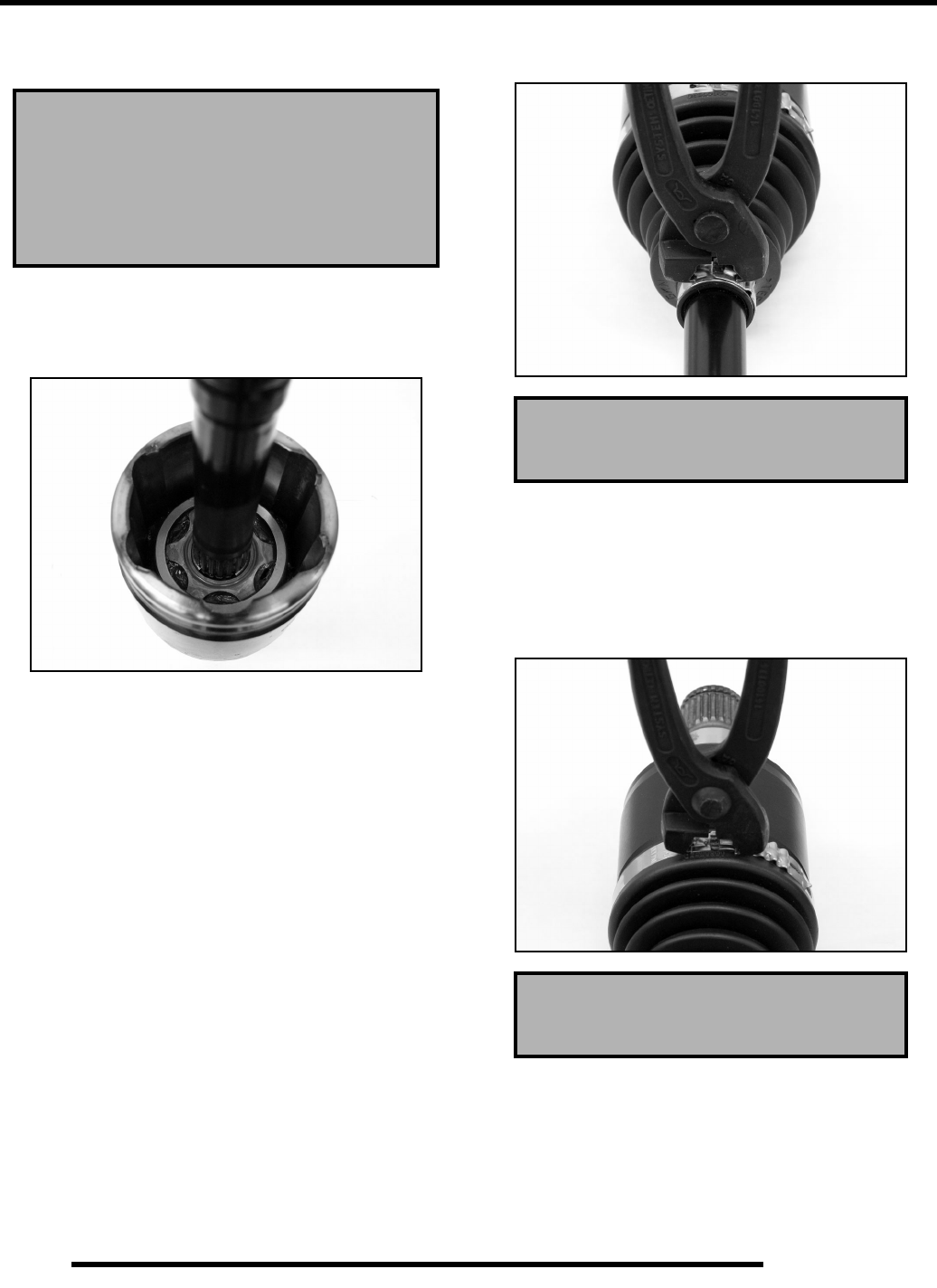
7.32
FINAL DRIVE
NOTE: The amount of grease that’s provided is pre-
measured, so use all the grease.
14. Fully compress the joint and push the drive shaft firmly into
the inner race.
15. Align the circlip with the lead-in chamfer.
16. Use a soft-faced hammer to tap the joint onto the drive shaft
until you reach the end of the splines and the joint locks in
place.
17. Pull on the joint to test that the circlip is seated and that the
joint is securely fastened to the shaft.
18. Remove excess grease from the plunging joint’s external
surfaces and place the excess grease in the boot.
19. Pull the boot over the joint and position the boot lips into
the grooves on the joint housing and shaft. Make sure the
boot is not dimpled or collapsed.
20. Install and tighten the small clamp using the Axle Boot
Clamp Tool (PU-48951).
21. Pull out on the drive shaft to center the joint in the housing.
Slide a straight O-ring pick or a small slotted screw driver
between the large end of the boot and the joint housing and
lift up to equalize the air pressure in the boot.
22. Position the boot lip in its groove. Install and tighten the
large clamp using the Axle Boot Clamp Tool (PU-48951).
Boot Replacement Grease Requirement:
Grease Only Service Kits
PN 1350059 (20g) / PN 1350046 (30g) / PN 1350047 (50g)
Inner Plunging Joint Capacity: 90g
Axle Boot Clamp Tool
PU-48951
Axle Boot Clamp Tool
PU-48951

7.33
FINAL DRIVE
7
Drive Shaft Exploded View Drive Shaft Installation
1. Install new spring ring on drive shaft. Apply anti-seize
compound to splines.
2. Align splines of drive shaft with rear gearcase and reinstall
the drive shaft. Use a rubber mallet to tap on the outboard
end of the drive shaft if necessary.
NOTE: Take care when installing the drive shaft to
prevent damaging the seal.
3. Slide the rear drive shaft into the rear bearing carrier.
REAR SHAFT
CV Joint
Plunging
Spring Ring
Gear Side
Boot Kit
Wheel Side
Boot Kit
Joint
Spring Ring
Large Clamp
Grease Pack
Small Clamp
Spring Ring
Large Clamp
Grease Pack
Apply
Anti-Seize
NEW
Spring Ring

7.34
FINAL DRIVE
4. Lift bearing carrier into place and install the bolt attaching
the bearing carrier to the upper A-arm. Torque fastener to
specification.
5. Apply grease to drive shaft axle splines.
6. Install rear wheel hub assembly, cone washers, and hand
tighten the castle nut. Install washers with domed side out.
7. Install brake caliper mounting bolts and torque to 18 ft. lbs.
(24 Nm).
8. Torque wheel hub nut to 80 ft. lbs. (108 Nm) and install a
NEW cotter pin. Tighten nut slightly if necessary to align
cotter pin holes.
9. Install wheel and (4) wheel nuts. Torque wheel nuts to
specification.
= T
Upper Rear Bearing Carrier Bolt:
40 ft. lbs. (54 Nm)
Out
Cone Washers
Wheel
Hub
18 ft. lbs.
24 (Nm)
= T
Rear Caliper Mounting Bolts:
18 ft. lbs. (24 Nm)
CAUTION
New bolts have a pre-applied locking agent
which is destroyed upon removal. Always use
new brake caliper mounting bolts
upon assembly.
= T
Wheel Hub Castle Nut:
80 ft. lbs. (108 Nm)
= T
Wheel Nuts:
Steel Wheels: 35 ft. lbs. (47 Nm)
Aluminum Wheels: 30 ft. lbs. + 90° (1/4 turn)
80 ft. lbs.
(108 Nm)
NEW Cotter Pin
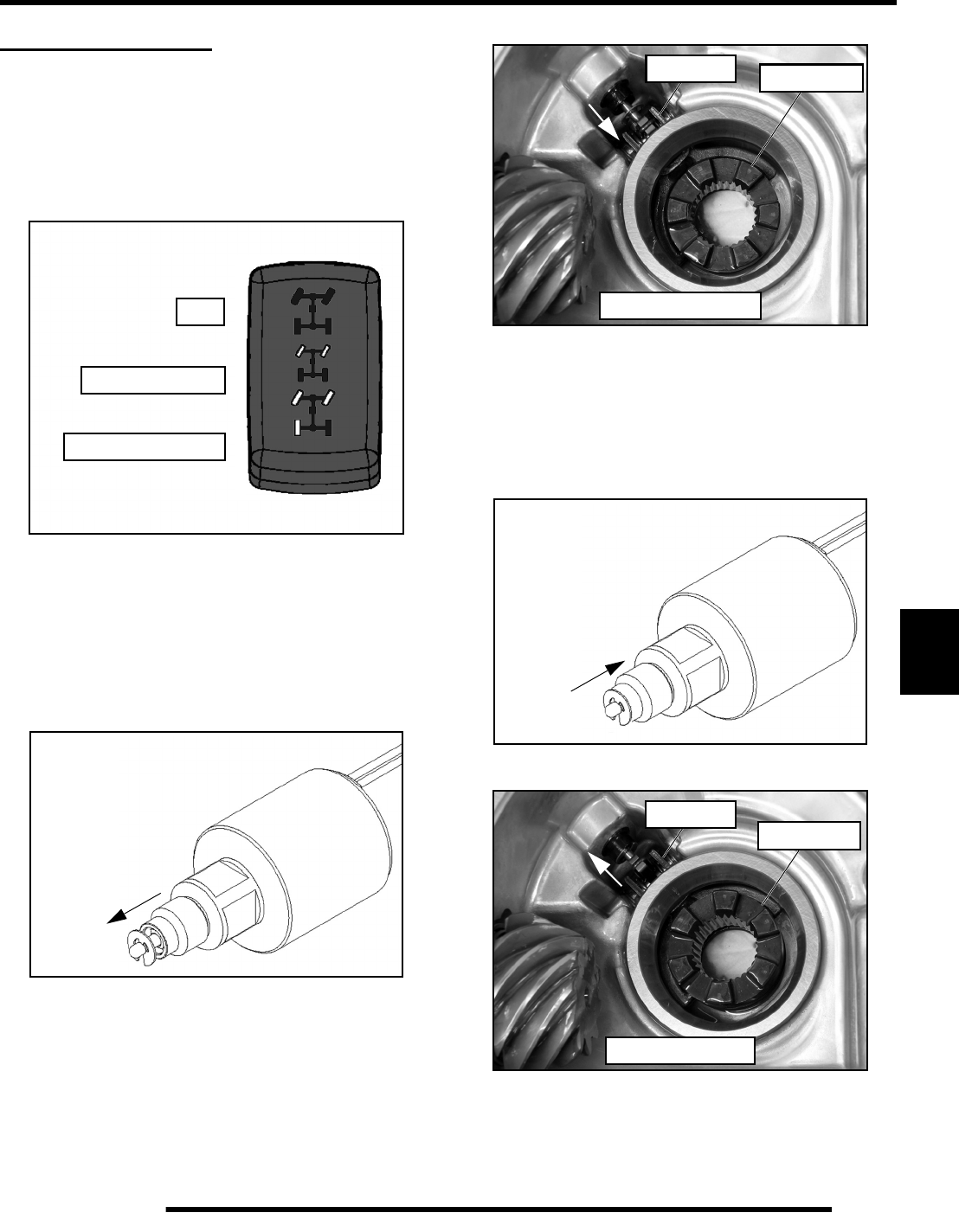
7.35
FINAL DRIVE
7
REAR GEARCASE
General Operation
The rear gearcase has three traction operational modes: AWD,
Differential Lock, and Differential Unlock. Locking the rear
differential is beneficial in low traction and rough terrain
conditions. Unlocking the rear differential makes maneuvering
easier and minimizes damage to turf and sensitive terrains.
When “Differential-Unlock” is selected on the switch, the rear
differential becomes unlocked for tighter turns. An electrical
solenoid mounted in the rear gearcase housing actuates the shift
yoke. The solenoid plunger extends out to move the shift yoke
and slides the clutch gear away from the engagement dogs that
are attached to the differential gear assembly. This unlocks the
rear differential.
When “Differential-Lock” is selected on the switch, power is
removed from the electrical solenoid allowing the solenoid
plunger to retract. Spring tension moves the shift yoke back into
place and engages the clutch gear into the engagement dogs that
are attached to the differential gear assembly, locking the rear
differential as a solid rear axle.
AWD
Differential - Lock
Differential - Unlock
When switch position is set
to “Unlock”, the solenoid is
powered and the
plunger extends
to disengage the
clutch gear and
unlock the
differential.
Differential - Unlock
Shift Yoke Clutch Gear
When switch position is set
to “Lock”, power is removed
from the solenoid and spring
tension retracts the
plunger to engage
the clutch gear
and lock the
differential.
Differential - Lock
Shift Yoke
Clutch Gear
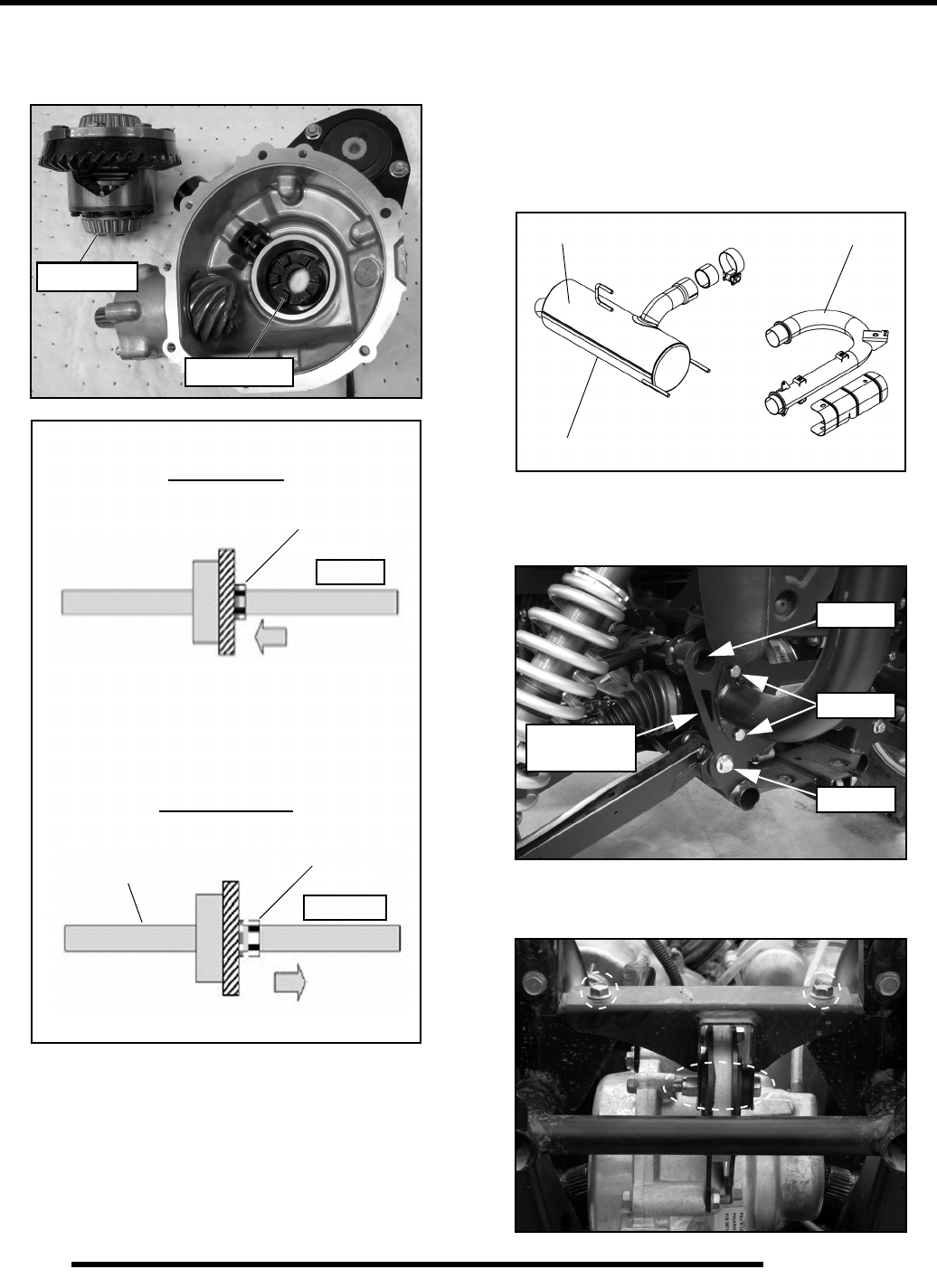
7.36
FINAL DRIVE
When the clutch gear is unlocked the rear drive shafts are
dependent on the differential allowing tighter turns. When it’s
locked it becomes a solid rear axle increasing traction.
Gearcase Removal
1. Drain the fluid from the rear gearcase and remove the rear
drive shafts from each side of the rear gearcase.
See “REAR DRIVE SHAFT” on page 7.28
2. Remove the exhaust pipe and exhaust silencer to allow for
gearcase removal.
3. Remove the (4) bolts retaining the rear rack cab frame to
the rear suspension plate. Remove the upper A-arm bolts,
lower rear A-arm bolts, and plate.
4. Remove the (2) rear gearcase mount bracket fasteners and
mount bolt and remove bracket from vehicle.
Differential
Clutch Gear
IRS Axle Clutch Gear
Unlocked
Locked Mode
Unlocked Mode
Axle Shaft
Clutch Gear
Locked
Axle Shaft
Axle Shaft
Axle Shaft
Silencer
Remove
Remove
Remove
Remove
Suspension
Plate
Remove
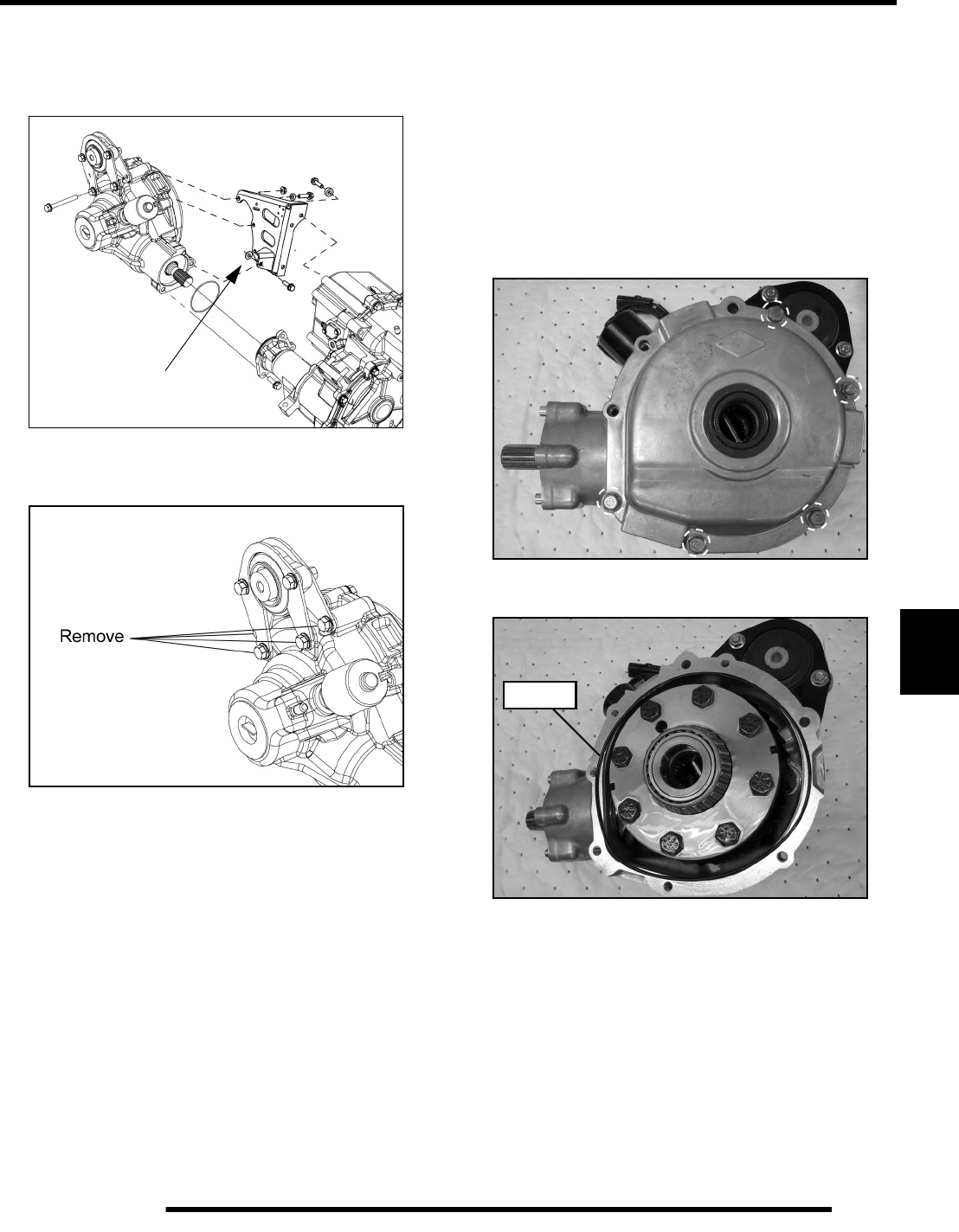
7.37
FINAL DRIVE
7
5. Disconnect the differential solenoid 2-wire harness.
6. Remove the fasteners and bracket that secure the rear
gearcase to the transmission.
7. Remove the (4) fasteners and remove the rear mount from
the rear gearcase.
8. Pull the rear gearcase towards the rear of the vehicle to
disengage it from the transmission.
NOTE: If the splined coupler doesn’t slide off the
input shaft on the rear gearcase, use a screwdriver
to hold back the coupler while pulling the rear
gearcase back further to disengage it.
9. Remove the vent line and lift the rear gearcase upward and
on its side to remove it from the vehicle.
Gearcase Disassembly
IMPORTANT: The pinion gear assembly is NOT
intended to be disassembled from the case, as it
requires special OEM tooling in order to properly
reassemble. If there is any damage to the pinion gear,
bearings or case, the entire gearcase assembly must
be replaced. Pinion and ring gear shimming
information is NOT provided in this Service Manual
due to OEM manufacturing requirements.
1. Remove the remaining cover bolts from the rear gearcase.
2. Remove the cover and O-ring seal from the gearcase.
Note the number or
thickness of shims for
reassembly purposes.
O-Ring
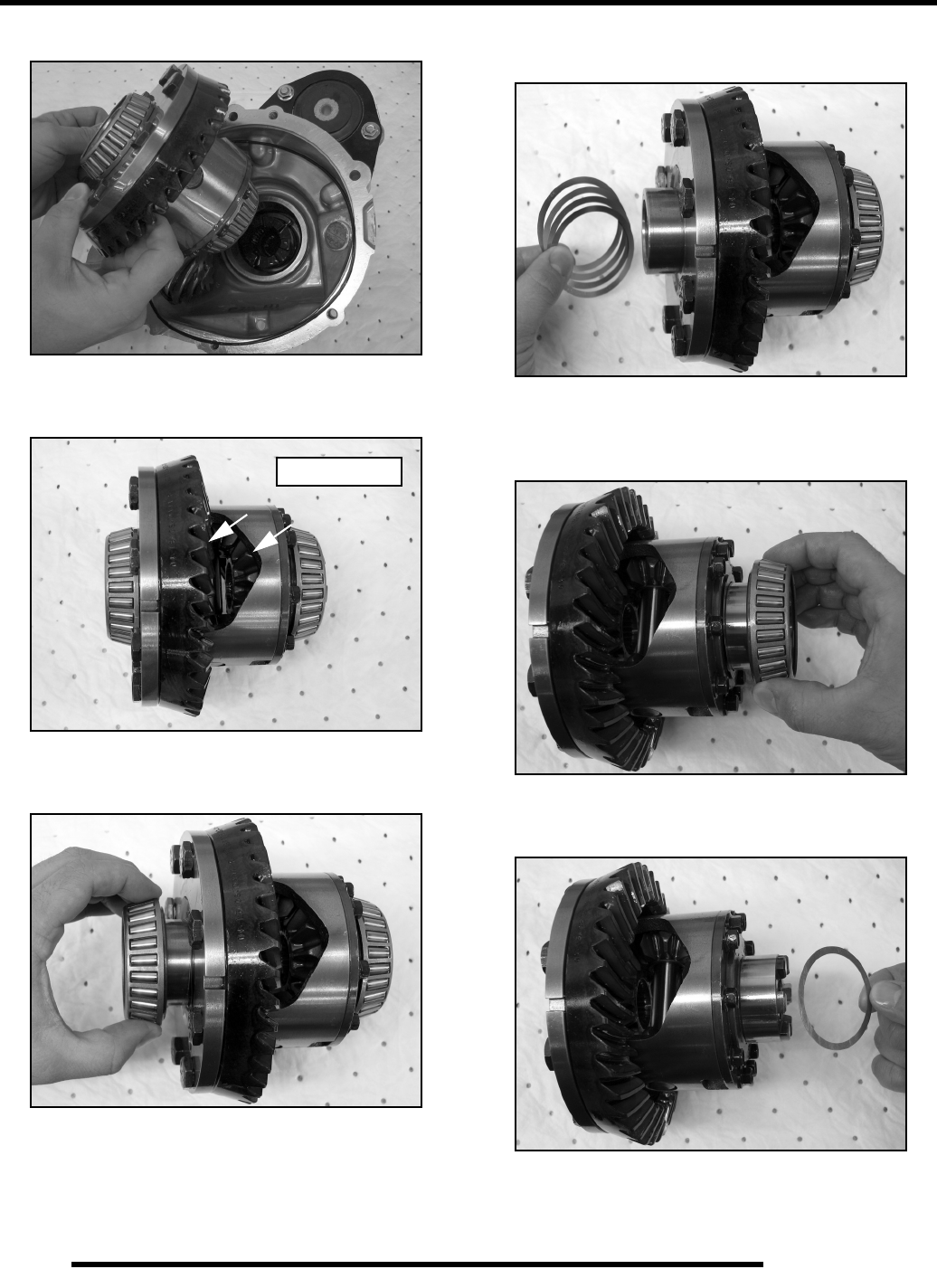
7.38
FINAL DRIVE
3. Remove the differential assembly from the housing.
4. Inspect the ring gear and differential gears for chipped,
worn, or broken teeth.
5. Remove the bearing from the top portion of the differential
assembly. Inspect the bearing for smoothness and wear.
6. Remove the shim(s) from the differential assembly. Be sure
to keep the shims together for reassembly.
7. Remove the bearing from the lower portion of the
differential assembly. Inspect the bearing for smoothness
and wear.
8. Remove the shim(s) from the differential assembly. Be sure
to keep the shims together for reassembly.
Inspect Teeth

7.39
FINAL DRIVE
7
9. Inspect each differential bearing and race for signs of wear
or damage. If bearing replacement is required, use standard
bearing puller tools to remove the bearing races.
10. Remove the seals from the gearcase housing and cover and
replace the O-ring in the gearcase cover.
11. Remove the pinion shaft seal using a seal puller or other
suitable method.
12. Inspect the pinion shaft by rotating the assembly in the
gearcase housing while checking for any looseness or
roughness. Inspect the pinion gear for chipped, worn, or
broken teeth. If damaged, replace the gearcase assembly.
NOTE: In the event damage to the gears, pinion
bearings or housing requires replacement, the entire
assembly must be replaced.
13. Remove the differential solenoid from the gearcase if
servicing the solenoid, shift lever, shift lever spring, or shift
yoke. If none of these items are being serviced, the solenoid
can remain installed in the gearcase.
14. If the solenoid was removed for servicing, inspect the tip
of the solenoid for wear. If the tip of the solenoid is
flattened, the solenoid must be replaced.
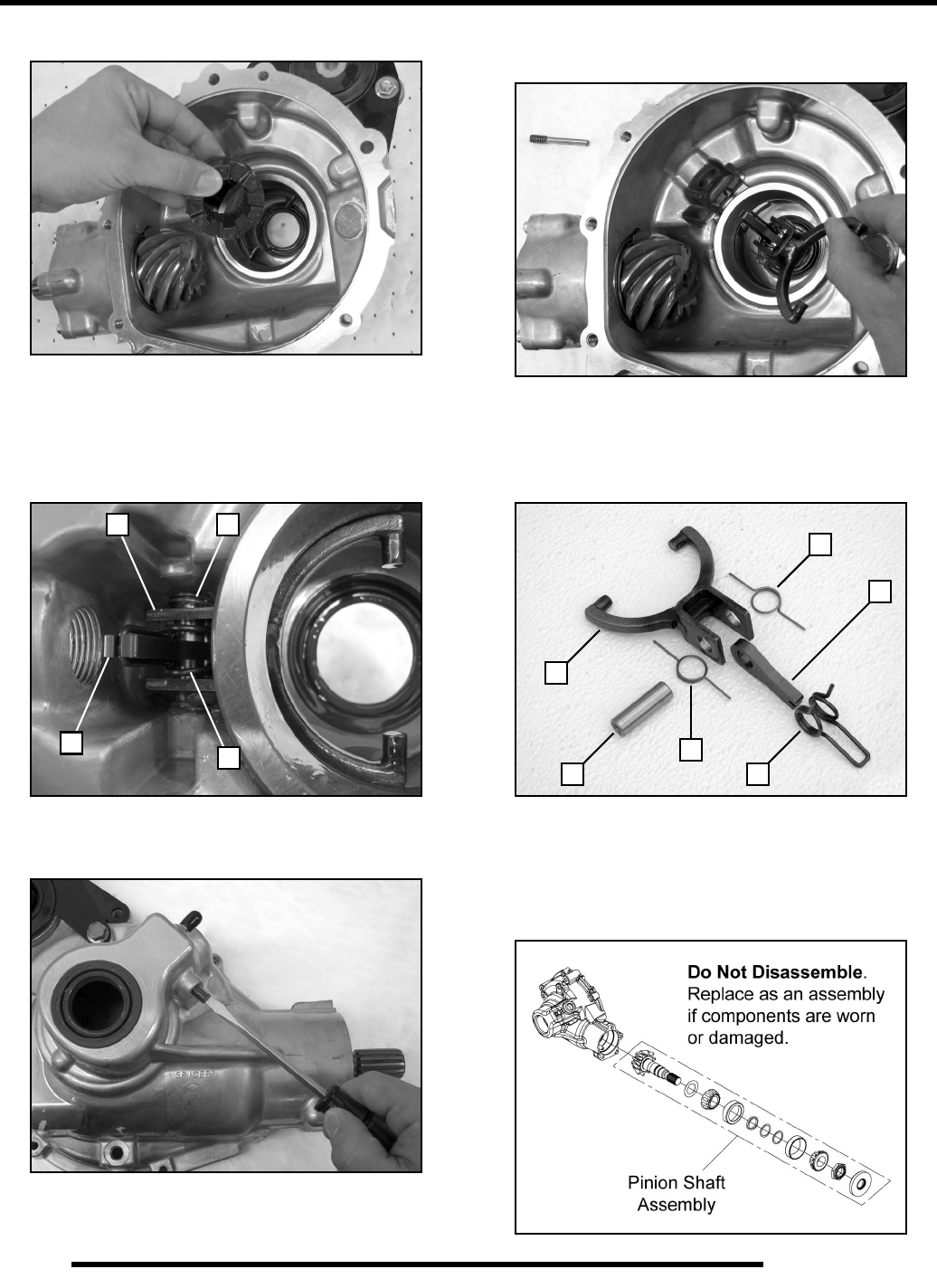
7.40
FINAL DRIVE
15. Remove the clutch gear from the gearcase.
16. Inspect the shift lever (A), shift lever spring (B), shift return
springs (C), and shift yoke (D) for excessive wear or
damage. If disassembly is required, proceed to the next
step. If no disassembly is required, proceed to “Gearcase
Assembly”.
17. Loosen and remove the lock pin assembly from the
gearcase housing.
18. Carefully remove the shift yoke assembly from the
gearcase cover.
19. Inspect the shift lever (A), shift lever spring (B), shift return
springs (C), shift yoke (D), and lock pin bushing (E).
Inspect the components for excessive wear or damage and
replace as needed.
NOTE: The pinion shaft assembly is NOT intended
to be disassembled from the case, as it requires
special OEM tooling in order to properly reassemble.
If there is any damage to the pinion gear, bearings or
case, the gearcase assembly must be replaced.
B
CD
A
A
B
C
C
D
E
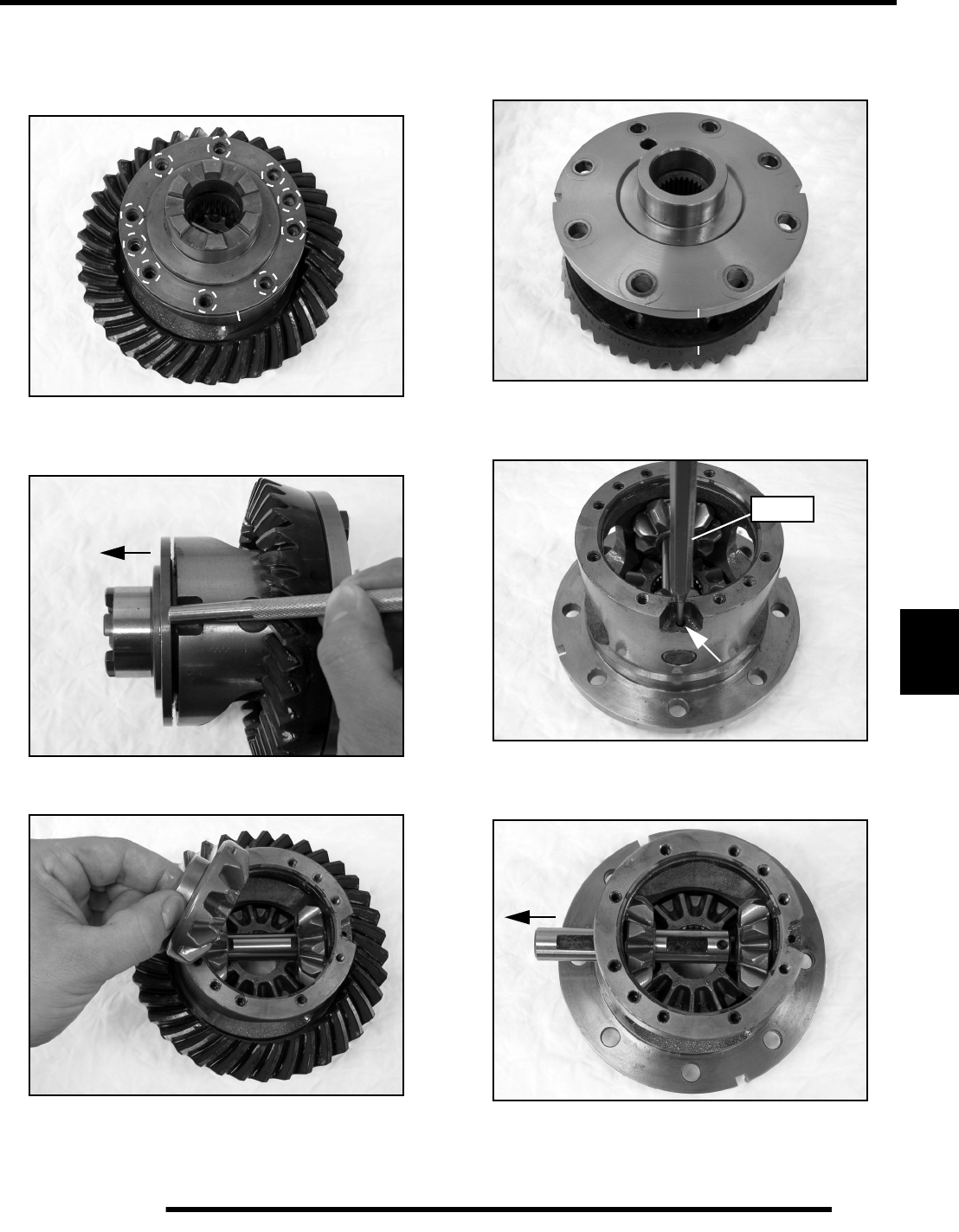
7.41
FINAL DRIVE
7
Differential Disassembly
1. Use a scribe to mark the differential cover and case.
Remove the (10) screws retaining the differential cover.
2. Use a brass punch in the recessed area as shown to remove
the differential cover.
3. Remove the upper differential gear.
4. Use a scribe to mark the ring gear and differential case.
Remove the (8) bolts that secure the ring gear to the
differential and allow the ring gear to slide down and off.
5. Place the differential assembly upright. Use a roll pin punch
to remove the roll pin from the differential case.
6. With the roll pin removed, slide the cross pin out and
remove the remaining differential gears.
Punch
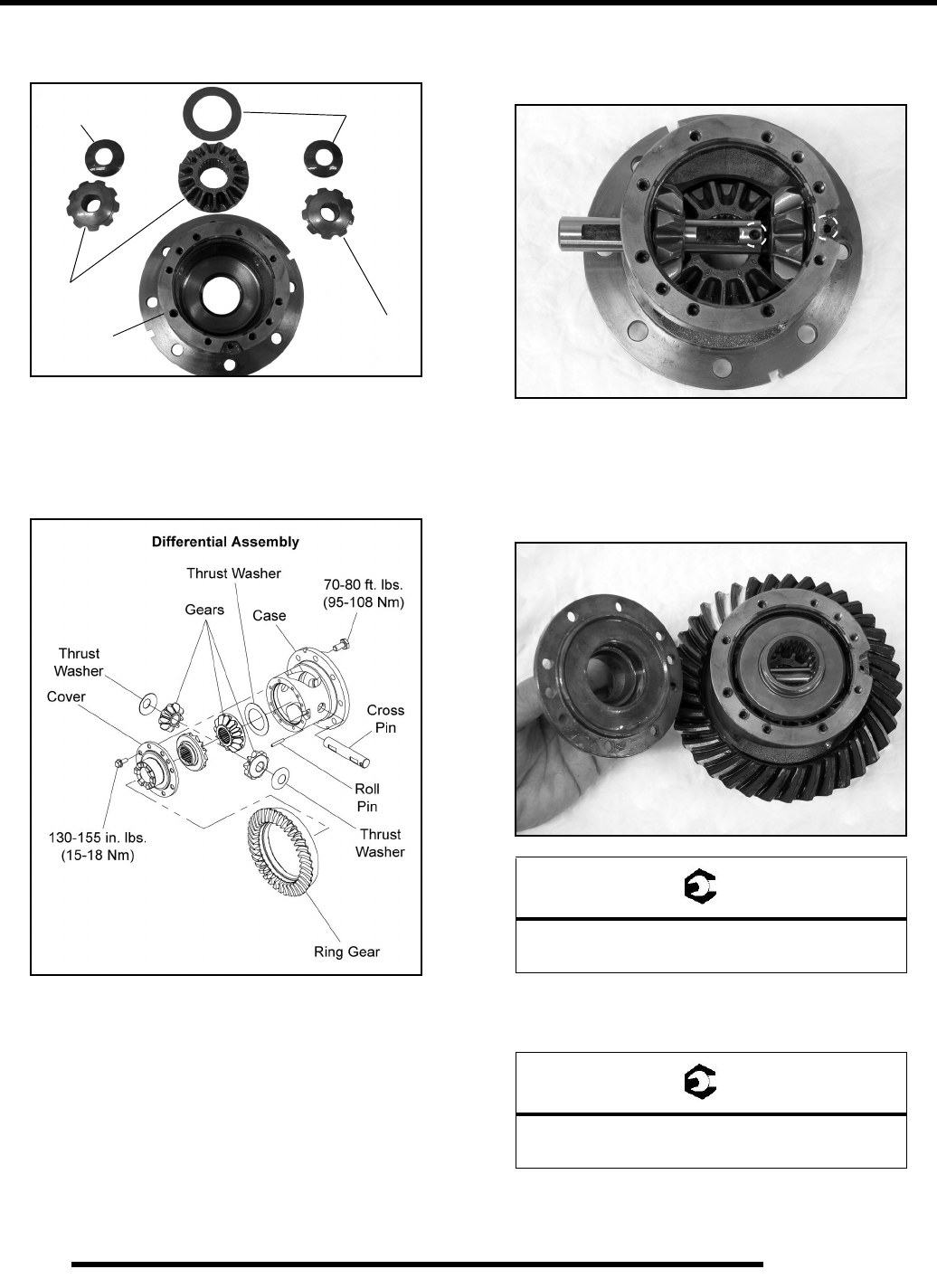
7.42
FINAL DRIVE
7. Inspect the gears, thrust washers and differential case for
excessive wear or damage. Replace components if needed.
Differential Assembly
1. Thoroughly clean the differential components prior to
reassembly.
2. Install the lower differential gear and thrust washer.
3. Install the side differential gears and thrust washers and
slide the cross pin into position with the hole side facing the
hole in the differential case.
4. Install a new roll pin.
5. Install the upper differential gear and differential cover.
Apply Loctite® 271 to the cover screws and torque the
screws to specification.
6. Install the ring gear and torque the retaining bolts to
specification.
Thrust
Gear
Gears
Washers
Thrust
Washer
Differential
Case
Apply Loctite® 271
= T
Differential Cover Screws:
130-155 in. lbs. (15-18 Nm)
= T
Ring Gear Bolts:
70-80 ft. lbs. (95-108 Nm)

7.43
FINAL DRIVE
7
Gearcase Assembly
1. Replace all worn components.
2. If removed, install new bearing races using standard
bearing installation tools and an arbor press.
NOTE: Grease all seals and O-rings with Polaris All
Season Grease (PN 2871322) upon assembly.
3. Install new seals into the gearcase housing and gearcase
cover using a standard seal installer or other suitable
method.
4. Install a new O-ring in the gearcase cover.
5. Install a new pinion shaft seal using a standard seal installer
or other suitable method.
6. Install the original shim(s) previously removed onto the
appropriate sides of the differential assembly. Install the
bearings by hand as they are a slip-fit.
7. If previously removed; assembly the shift lever (A), shift
lever spring (B), shift return springs (C), shift yoke (D), and
lock pin bushing (E).
WARNING
Wear the appropriate safety equipment while
installing races to reduce the risk of injury.
A
B
C
C
D
E

7.44
FINAL DRIVE
8. Carefully install the shift yoke assembly into the gearcase.
9. Install the shift yoke assembly with the shift return springs
(C), facing down in the housing.
10. Install the lock pin assembly and tighten.
11. Install the differential assembly into the gearcase housing
and install a new lightly greased O-ring onto the cover.
12. Assemble the gearcase halves and install the bolts that
secure the cover to the housing. Torque the bolts in a criss-
cross pattern to 23-27 ft. lbs. (31-37 Nm).
13. If previously removed, install the differential solenoid.
Torque the solenoid to 30-40 ft. lbs. (41-54 Nm).
C
O-Ring
23-27 ft. lbs.
(31-37 Nm)
30-40 ft. lbs.
(41-54 Nm)
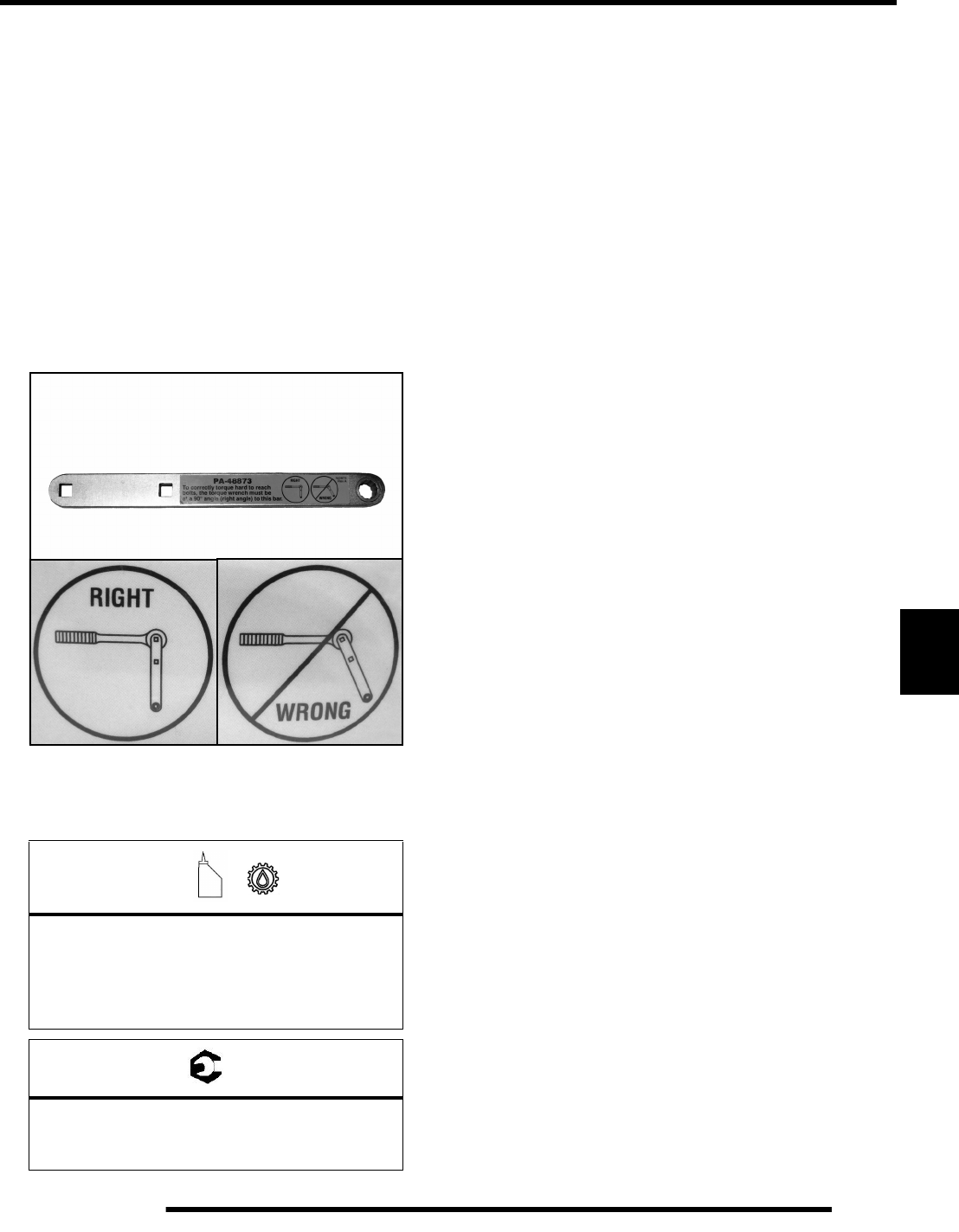
7.45
FINAL DRIVE
7
Gearcase Installation
1. Install the rear gearcase by reversing the procedure listed
under “REAR GEARCASE - Gearcase Removal” at the
beginning of this section.
IMPORTANT: When reinstalling the transmission to
rear gearcase mount bracket, it is extremely important
to torque all (7) fasteners to specification. Refer to the
“Installation” procedure listed on page 4.14.
NOTE: Special tool (PA-48873) will be required to
torque the mounting bracket fasteners when the
transmission and rear gearcase are installed in the
vehicle. Refer to the “Installation” procedure listed
on page 4.14.
2. Add Polaris ATV Angle Drive Fluid to rear gearcase. Refer
to maintenance information in Chapter 2 for more details.
Torque drain and fill plugs to specification.
=
Rear Gearcase Capacity:
22 fl. oz. (650 ml)
or to bottom of fill plug hole threads
See Chapter 2
= T
Drain / Fill Plug:
Drain Plug - 30-45 in. lbs. (3-5 Nm)
Fill Plug - 40 ft. lbs. (54 Nm)
Special Tool
PA-48873

7.46
FINAL DRIVE
Gearcase Exploded View
REF# DESCRIPTION QTY REF# DESCRIPTION QTY
1 Screw 2 20 Screw 8
2 Screw 2 21 Lever, Shift 1
3 Bracket, Rear Mount, RH 1 22 Spring, Shift Lever 1
4 Bracket, Rear Mount, LH 1 23 Spring, Shift Return 2
5 Mount, Rear 1 24 Pin Lock Asm. 1
6 Nut, Flanged 2 25 Seal 1
7 Assembly, Rear Housing, RH 1 26 Bushing, Dowel 2
8 Plug, Fill w/O-Ring 1 27 Solenoid, Diff Lock 1
9 Bushing, Pin Lock 1 28 Bearing, Tapered Roller 1
10 Bearing, Ball 2 29 Screw, Flange Head 10
11 Plug, Drain 1 30 Case, Diff Cover Half 1
12 Shim Kit 2 31 Thrust Washer, Pinion 2
13 Gear, Clutch 1 32 Gear, Diff, Pinion Mate 2
14 Yoke, Shift 1 33 Gear, Diff Side 2
15 O-Ring 1 34 Thrust Washer, Side Gear 1
16 Cover Asm., Rear 1 35 Case, Diff Half 1
17 Screw 2 36 Pin, Diff, Cross 1
18 Seal, Oil 2 37 Pin, Spring 1
19 Screw, Flanged 4
1
2
3
4
5
67
9
10
13
14
15
16
17 18
19
20
12
22
30-45 in. lbs.
(3-5 Nm)
40 ft. lbs.
(54 Nm)
23-27 ft. lbs.
(31-37 Nm)
6
7
70-80 ft. lbs.
(95-108 Nm)
23-27 ft. lbs.
(31-37 Nm)
8
11
12
23
21
24
25
26
27
28
29
30
31
32
33 34
35
36
37
18
130-155 in. lbs.
(15-18 Nm)
30-40 ft. lbs.
(41-54 Nm)
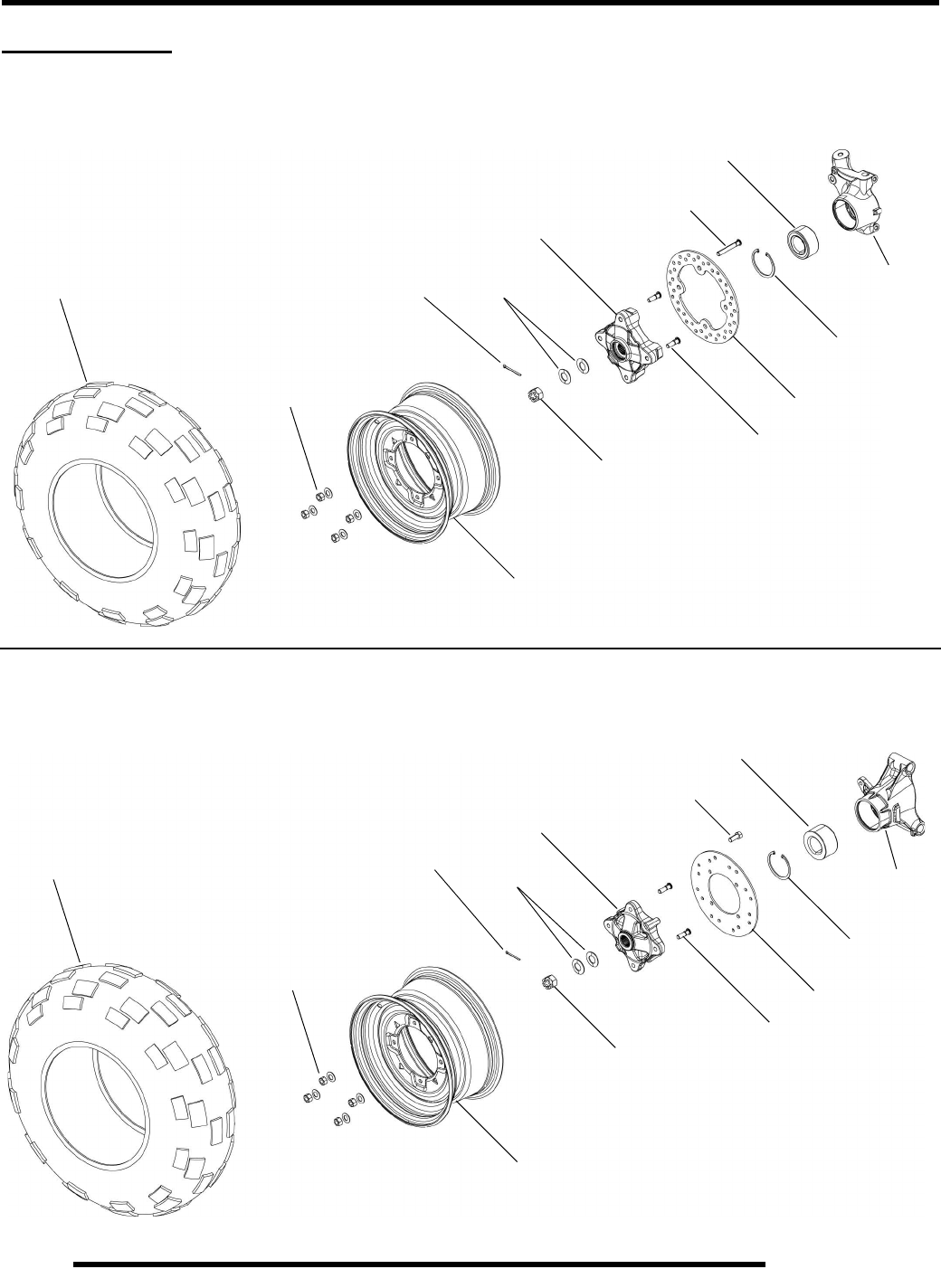
7.47
FINAL DRIVE
WHEEL HUBS
Front Hub Exploded View
Rear Hub Exploded View
Wheel Nuts
Front Rim
Castle Nut
Cotter Pin
Cone
Wheel Hub
Brake Disc
Bolts
Retaining
Sealed
Ball Bearing
Bearing
Front Tire Washers
35 ft. lbs.
(47 Nm)
80 ft. lbs.
(108 Nm)
Ring
Carrier
(Steel)
Studs
Rear Rim
Castle Nut
Cotter Pin Cone
Wheel Hub
Brake Disc
Bolts
Retaining
Sealed
Ball Bearing
Bearing
Rear Tire Washers
80 ft. lbs.
(108 Nm)
Ring
Carrier
(Steel)
Studs
Wheel Nuts
35 ft. lbs.
(47 Nm)

NOTES
FINAL DRIVE
7.48

TRANSMISSION
8.1
CHAPTER 8
TRANSMISSION
8
TORQUE VALUES / SPECIFICATIONS . . . . . . . . . . . . . . . . . . . . . . . . . . . . . . . . . . . . . . 8.2
SHIFT LEVER . . . . . . . . . . . . . . . . . . . . . . . . . . . . . . . . . . . . . . . . . . . . . . . . . . . . . . . . . . 8.2
REMOVAL . . . . . . . . . . . . . . . . . . . . . . . . . . . . . . . . . . . . . . . . . . . . . . . . . . . . . . . . . . . . 8.2
INSTALLATION . . . . . . . . . . . . . . . . . . . . . . . . . . . . . . . . . . . . . . . . . . . . . . . . . . . . . . . . 8.2
SHIFT CABLE INSPECTION / ADJUSTMENT. . . . . . . . . . . . . . . . . . . . . . . . . . . . . . . . . 8.3
TRANSMISSION SERVICE. . . . . . . . . . . . . . . . . . . . . . . . . . . . . . . . . . . . . . . . . . . . . . . . 8.4
TRANSMISSION REMOVAL / SERVICE NOTES . . . . . . . . . . . . . . . . . . . . . . . . . . . . . . 8.4
TRANSFER CASE DISASSEMBLY . . . . . . . . . . . . . . . . . . . . . . . . . . . . . . . . . . . . . . . . . 8.4
TRANSFER CASE REASSEMBLY . . . . . . . . . . . . . . . . . . . . . . . . . . . . . . . . . . . . . . . . . 8.7
TRANSMISSION SHIFT HOUSING DISASSEMBLY. . . . . . . . . . . . . . . . . . . . . . . . . . . . 8.9
TRANSMISSION SHIFT HOUSING REASSEMBLY . . . . . . . . . . . . . . . . . . . . . . . . . . . 8.13
TROUBLESHOOTING. . . . . . . . . . . . . . . . . . . . . . . . . . . . . . . . . . . . . . . . . . . . . . . . . . . 8.18
TROUBLESHOOTING CHECKLIST. . . . . . . . . . . . . . . . . . . . . . . . . . . . . . . . . . . . . . . . 8.18
TRANSMISSION EXPLODED VIEW. . . . . . . . . . . . . . . . . . . . . . . . . . . . . . . . . . . . . . . . 8.19
SHIFT HOUSING / TRANSFER CASE EXPLODED VIEW . . . . . . . . . . . . . . . . . . . . . . 8.19

8.2
TRANSMISSION
TORQUE VALUES / SPECIFICATIONS
Maintain and check/change these items in accordance with the
maintenance schedule in Chapter 2 or during service repairs.
SHIFT LEVER
Removal
1. Pry the shift lever cover using a suitable tool and remove
the screw. Pull knob off the shifter.
2. Refer to Chapter 5 for console cover removal.
3. Disconnect cable from shifter.
4. Remove the clip attaching the gear selector to the machine
frame.
5. Lift the gear shift selector out of mounting bracket and
away from frame.
Installation
1. Perform the steps in reverse order to install the gear shift
selector (shifter, cable, console, shift knob).
2. Tighten the shift cable nut to specification.
ITEM TORQUE VALUE
Transmission Fill Plugs 40-50 ft. lbs. (54-67 Nm)
Transmission Drain /
Level Plugs 30-45 in. lbs. (0.2-0.3 Nm)
Transmission Case
Screws 23-27 ft. lbs. (31-36 Nm)
Shift Cable Lever Screw 15-20 ft. lbs. (20-27 Nm)
Detent Sleeve Assembly 40-45 ft. lbs. (54-61 Nm)
Outer Detent Screw 23-27 ft. lbs. (31-37 Nm)
Drain Plugs / Check Plug 30-45 in. lbs. (0.2-0.3 Nm)
Ground Speed Sensor
Screw 130-155 in. lbs. (15-18 Nm)
Gear Position Sensor
Screws 25-40 in. lbs. (3-5 Nm)
Pivot Pin Set Screw 100-125 in. lbs. (11-14 Nm)
Park Flange Screws 130-155 in. lbs. (15-18 Nm)
Transmission Isolator
Mounting Screws 23-27 ft. lbs. (31-36 Nm)
Transmission Lubricant
Capacity
AGL Plus PN 2878068
24 oz. (710 ml)
Transfer Case Lubricant
Capacity
AGL Plus PN 2878068
14 oz. (414 ml)
Rear Gearcase Fluid
Capacity
ADF PN 2871653
22 oz. (650 ml)
= T
Shift Cable Nut Torque:
130-155 in. lbs. (14.7-17.5 Nm)

8.3
TRANSMISSION
8
Shift Cable Inspection / Adjustment
Shift cable adjustment may be necessary if symptoms include:
• No AWD or gear position display on instrument cluster
• Ratcheting noise on deceleration
• Inability to engage a gear
• Excessive gear clash (noise)
• Gear selector moving out of desired range
1. Locate the shift cable in the rear LH wheel well area.
2. Inspect shift cable, clevis pin, pivot bushings, and dust
boot. Replace if worn or damaged.
3. If adjustment is required, loosen the lower jam nut and pull
the cable out of the mount to move the upper jam nut.
4. Adjust the shift cable so there is the same amount of cable
travel when shifting slightly past the detents of HIGH (H)
gear and PARK (P).
5. Thread the upper or lower jam nut as required to obtain
proper cable adjustment.
NOTE: This procedure may require a few attempts to
obtain the proper adjustment.
6. Once the proper adjustment is obtained, place the shift
cable and upper jam nut into the mount. Tighten the lower
jam nut against the mount.
7. Start engine and shift through all gears to ensure the shift
cable is properly adjusted. If transmission still ratchets after
cable adjustment, check the CVT system for belt movement
at idle. If difficulty shifting persists, the transmission may
require service.
Shift Cable
Mount
Dust Boot
Clevis Pin
Shift Cable
Lower
Jam Nut
Upper
Jam Nut
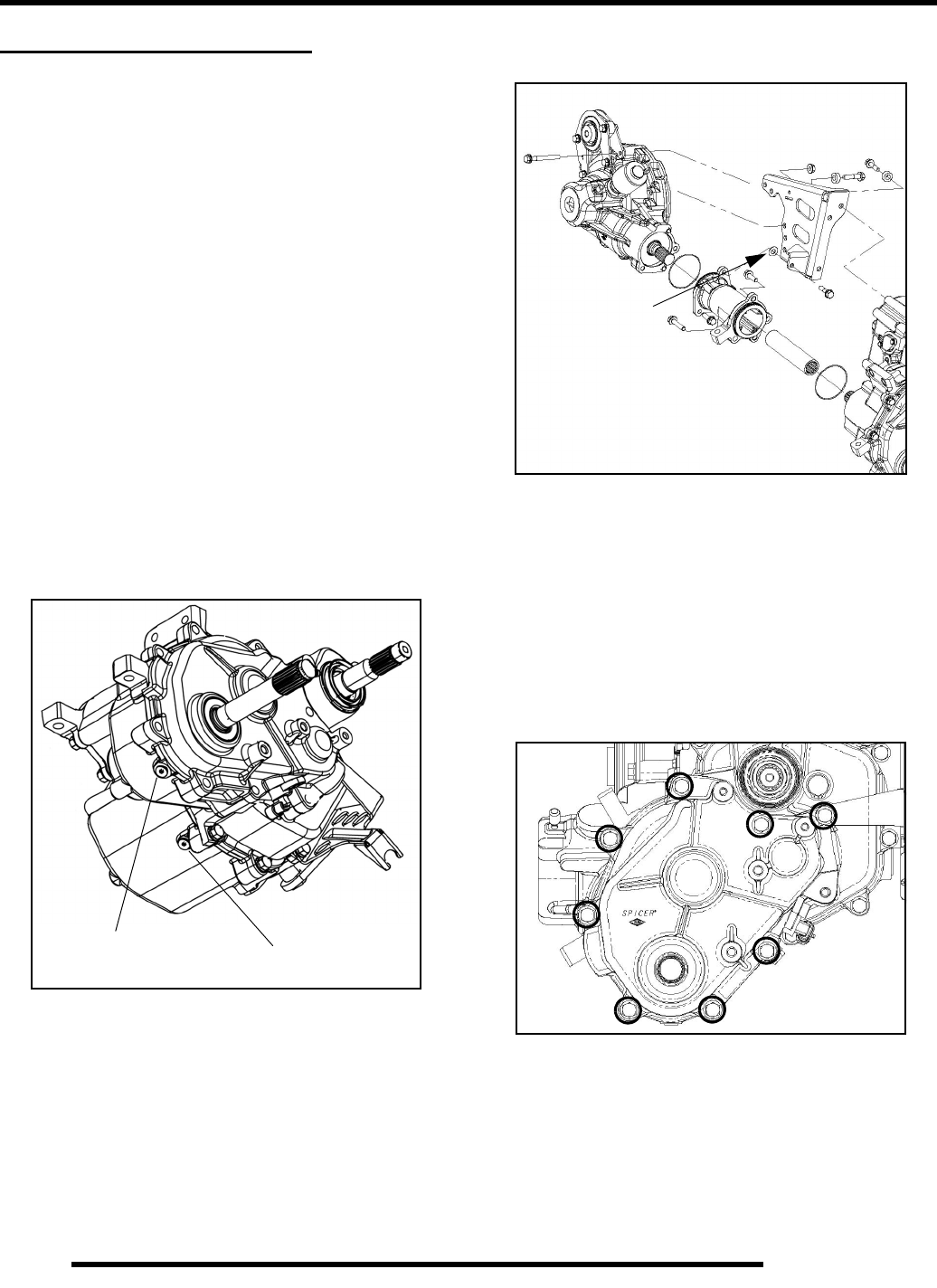
8.4
TRANSMISSION
TRANSMISSION SERVICE
Transmission Removal / Service Notes
The engine, transmission and rear differential are bolted
together as a unit. Removal of the transmission is not possible
without removing the engine and differential.
The shift housing cannot be removed without first
disassembling the transfer case.
NOTE: Refer to the “Engine Removal” section in
Chapter 3 to remove the engine and drivetrain.
Transfer Case Disassembly
IMPORTANT: Shift housing repairs are not possible
without performing transfer case disassembly. Read
and understand all instructions before beginning
disassembly.
NOTE: Exploded views are located at the end of this
chapter for additional information.
1. Place the transmission in the neutral position.
2. Drain both the transfer case and transmission case halves.
3. Remove the (7) fasteners retaining the transmission to rear
gearcase mount bracket.
4. Remove the connector tube bolts securing the rear gear case
and transmission transfer case.
5. Inspect the driveshaft splines for wear and the O-rings for
damage. Replace if found to be worn or damaged.
6. Remove the LH front isolator mount bracket. Refer to
Chapter 3.
7. Remove the screws from the transfer case cover and
remove the cover (note position of the longest screw #4).
Transmission Gearcase
Drain Plug
Transfer Case
Drain Plug
Note the number or
thickness of shims for
reassembly purposes.
1
2
3
4
5
6
7
8

8.5
TRANSMISSION
8
8. After removing the cover, remove the intermediate shaft
bearing cup and shims from the cover. Bearing cup is a slip-
fit. Note and record the number and thickness of shims and
set aside. Also note the two alignment dowels (circle) in the
cover for installation.
NOTE: Record the number and thickness of shims
for reassembly.
9. Disassemble the cover as required, replacing components
that are failed or worn. Check bearings for wear or damage
and replace as needed using a press and standard bearing
removal tools. Discard removed bearings as they become
damaged by the removal process.
10. Remove the intermediate pinion shaft assembly from the
housing. Check bearings and gear teeth for wear or damage
and replace as needed. The shaft can be disassembled as
shown using a press and standard bearing removal tools.
11. Disassemble the output pinion shaft assembly by removing
the retaining screws on the bearing cup/bracket assembly.
Replace the output shaft seal. The output pinion shaft can
be disassembled as shown using a press and standard
bearing removal tools.
12. Output shaft bearing cup is a slip-fit. Remove, note and
record the number and thickness of shims and set aside.
Note the alignment dowels (circled) in the cover for
installation.
x 3

8.6
TRANSMISSION
13. Remove the front output pinion shaft assembly. The shaft
can be disassembled as shown using a press and standard
bearing removal tools.
14. Remove the upper snap ring from the top side of the 21T
main pinion gear and remove the gear.
15. Remove the lower snap ring from under the gear.
16. Remove the intermediate shaft seal using a seal puller or
other suitable method.

8.7
TRANSMISSION
8
Transfer Case Reassembly
1. Install the intermediate shaft seal (circled) flush or slightly
below the case. Install circlips and gear onto the input
intermediate shaft as shown.
2. Install the front output pinion shaft assembly.
NOTE: Bearing is pressed onto the shaft
3. Install the shims, bearing cup and alignment dowels into the
retaining bracket.
4. Install a new output shaft seal flush with the case. Install
the output pinion shaft assembly and bearing cup/bracket
assembly as shown. Verify the alignment dowels are
seated. Torque the bracket screws evenly to specification.
= T
Output Pinion Shaft Bracket Screws:
23-27 ft. lbs. (31-37 Nm)
x 3
x 2
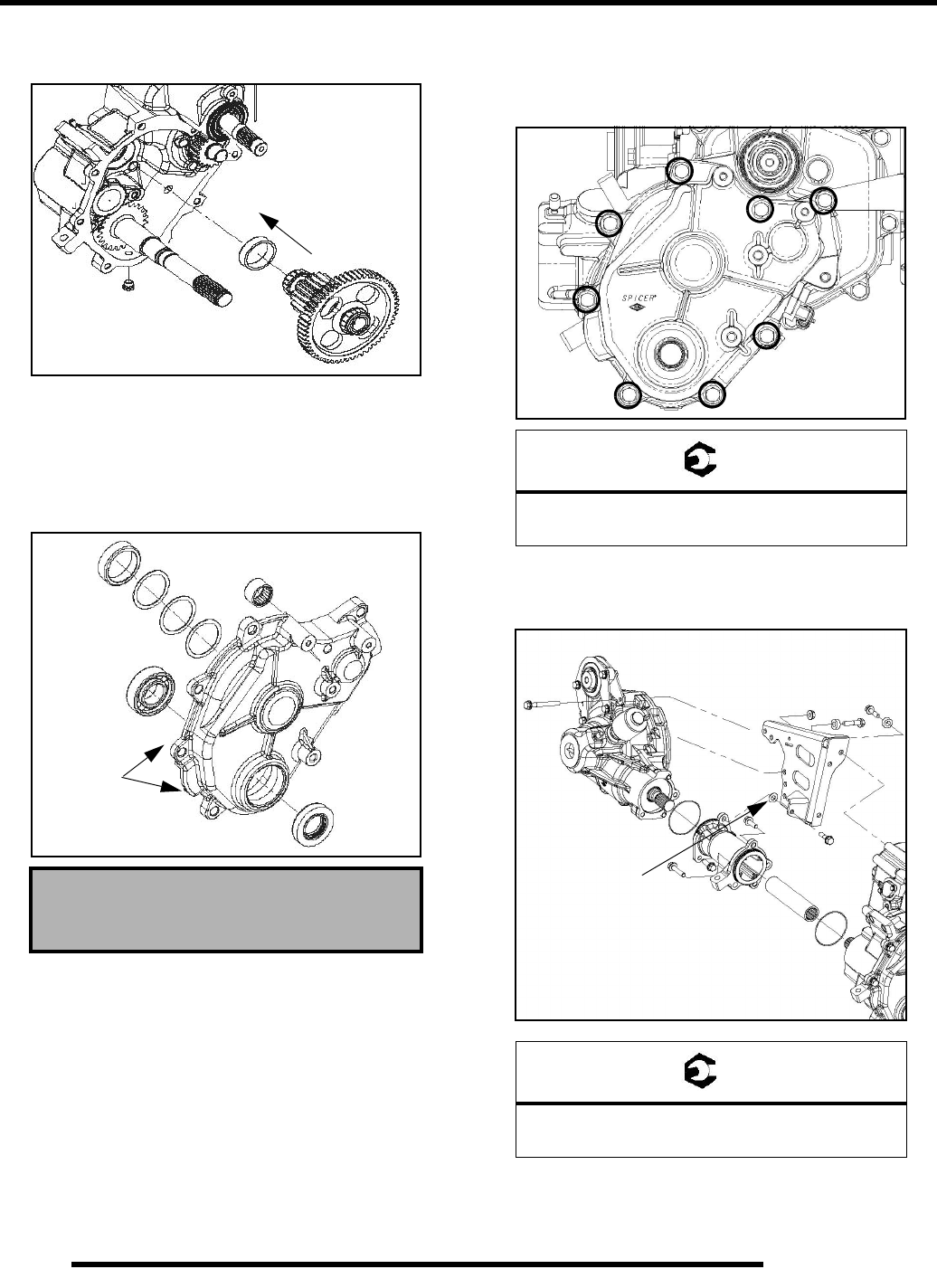
8.8
TRANSMISSION
5. Reinstall the intermediate pinion shaft assembly and
bearing cup.
6. Assemble the transfer case cover using new components as
required. Press in new bearings and a seal using standard
installation tools. (needle bearing is installed round edge
inward) Install a new shaft seal flush with the surface, the
shims and bearing cup. Apply a thin coat of sealant to the
mating surfaces. Apply lubricant to the seal lip.
7. Install the transfer case cover. Align the dowels (#1 & #7)
and insert the cover screws (note position of the longest
screw #4). Torque the screws evenly to specification in
sequence as shown.
8. Reinstall the transmission to rear gearcase mount bracket.
Hand tighten all fasteners first, then torque fasteners to
specification.
Apply Sealant PN 2871557
To Case Mating Surfaces
2871557
= T
Transfer Case Cover Screws:
23-27 ft. lbs. (31-37 Nm)
= T
Mount Bracket Fasteners:
23-27 ft. lbs. (31-37 Nm)
1
2
3
4
5
6
7
8
Use same number or
thickness of shims as
found during disassembly.

8.9
TRANSMISSION
8
Transmission Shift Housing Disassembly
IMPORTANT: Shift housing repairs are not possible
without performing transfer case disassembly. Read
and understand all instructions before beginning
disassembly.
1. Verify transmission is in neutral. Remove the (7) shift
housing case screws from the front of the transmission and
(2) from the backside as shown.
NOTE: Shift cable bracket removal is required.
2. Place the transmission shift housing onto a flat surface as
shown. Lift the transmission case half straight up and
remove.
NOTE: Shaft components may “catch” during
transmission case half disassembly. Work slowly
and deliberately to avoid component loss or
damage.
3. Remove the retaining ring and retaining plate.
4. Remove the reverse clutch gear assembly from the housing.
Note the orientation of the needle bearing. Inspect these
components and replace if needed.
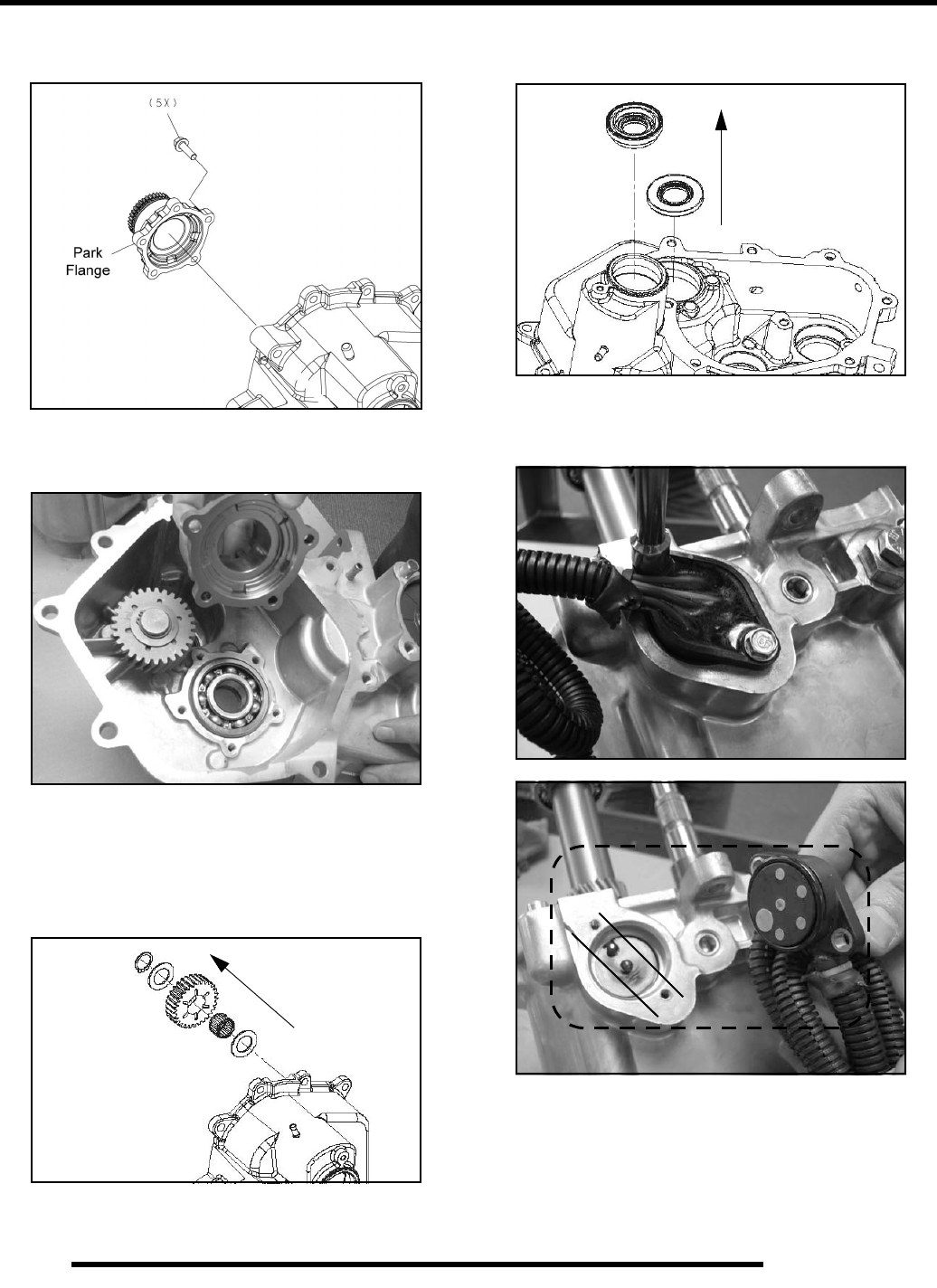
8.10
TRANSMISSION
5. Remove the (5) screws retaining the park flange. Inspect the
park flange for wear or damage. Replace if needed.
6. Inspect the shaft bearing. Use a standard bearing puller to
remove the shaft bearing if required.
NOTE: Do not pull bearing from cases for
inspection, as the removal process damages the
bearing.
7. Remove the reverse idler snap ring, upper washer, gear,
needle bearing, and lower washer from the idler shaft.
NOTE: The reverse idler shaft is a non-serviceable
item and should not be pressed out of the housing.
8. Remove the input shaft seal and clutch intermediate shaft
seal using a seal puller or punch.
9. Remove the (2) screws that attach the gear position sensor
to the shift housing. Inspect the O-ring, switch poles and
contact pins for wear or damage. Replace parts as required.
Neutral
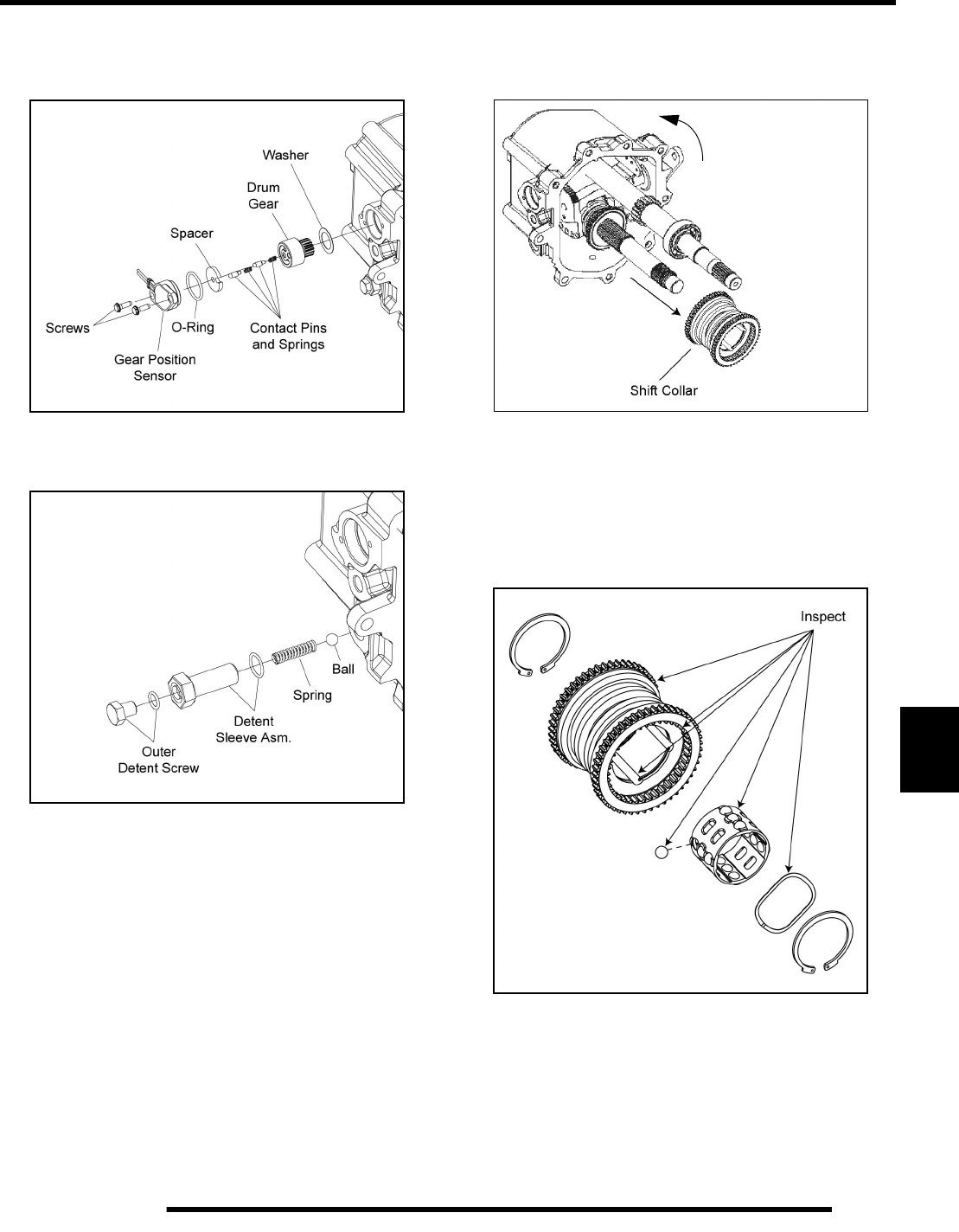
8.11
TRANSMISSION
8
10. Remove the spacer, contact pins, springs, drum gear and
washer from the shift housing. Replace any worn or
damaged components.
11. Remove the inner shift detent screws, springs, and balls
from the shift housing.
NOTE: Never remove the outer shift detent screw
first. Removal of the outer screw will allow the detent
ball and spring to fall into the shift housing.
12. Remove the park/reverse spacer from the clutch shaft.
13. Pull back fully on gear selector arm to bring shift collar up
and disengage the shift collar from the clutch yoke. Lifting
on the clutch shaft may aid in shift collar removal.
14. Inspect the inner and outer gear teeth and splines on both
ends of the shift collar for excessive wear or damage.
15. Remove the retaining rings from each end of the shift collar.
16. Remove the wave spring and ball bearing cage assembly
from the shift collar as shown.
17. Inspect the inner and outer gear teeth and ball bearing
channels on both ends of the shift collar for excessive wear
or damage.
18. Remove the sliding shoes from the clutch yoke.
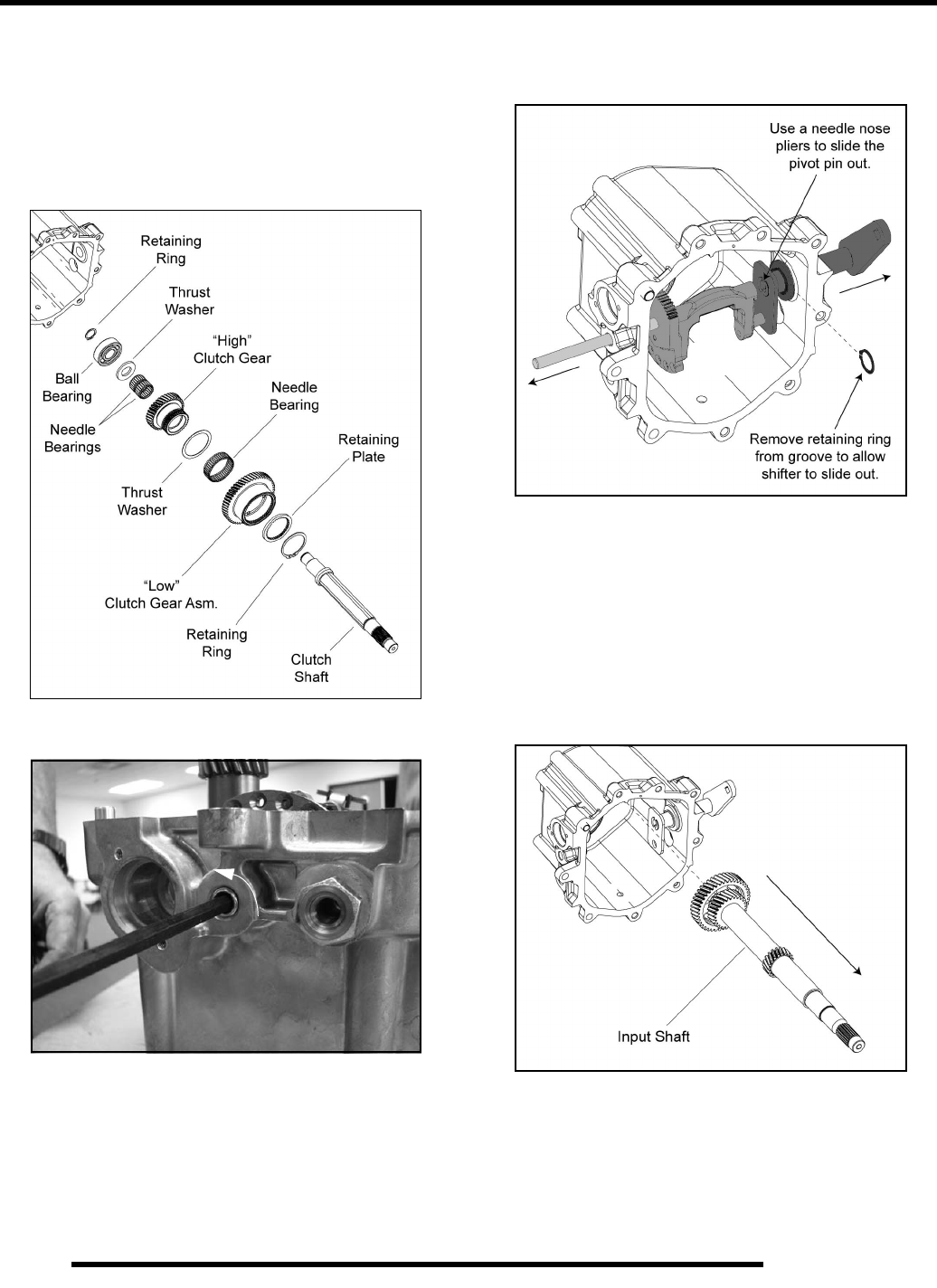
8.12
TRANSMISSION
19. Remove the clutch shaft assembly from the housing. The
forward gear assembly and bearings will remain on the
shaft upon removal.
20. Disassemble the clutch shaft as needed by removing both
retaining rings and separating the high and low gears from
the clutch shaft. Inspect all parts for wear or damage and
replace as required.
21. Remove the set screw retaining the pivot pin.
22. Locate the retaining ring on the shifter assembly and move
the retaining ring out of the groove to allow the shifter
assembly to slide out.
23. Use a needle nose pliers to grab the pivot pin and slide the
pin out of the case.
24. Remove the clutch yoke from the shifter assembly and out
from the transmission housing.
25. Remove the transmission input shaft from the housing.
Inspect the shaft bearing and replace if required using a
shop press. Inspect the gears for damage and/or wear.
Replace the shaft if required.
Pivot
Pin
Shifter
Assembly
Clutch
Yoke
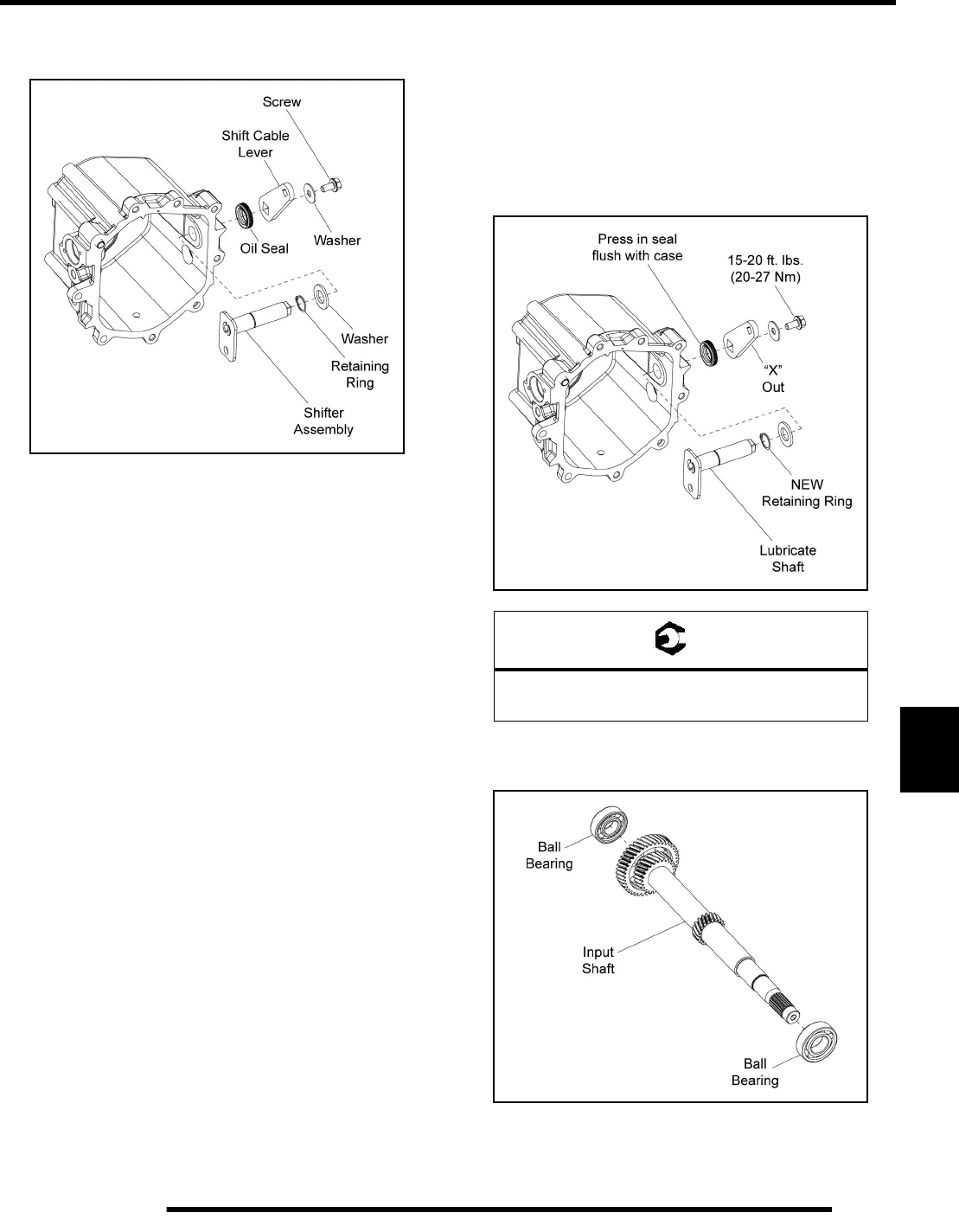
8.13
TRANSMISSION
8
26. Remove the screw from the end of the shift cable lever and
remove the shifter assembly from the housing.
27. Inspect the shifter assembly shaft and housing for excessive
wear or damage. Replace components if needed.
28. Inspect and replace the case bearings if required.
NOTE: Do not pull bearings from case for
inspection, as the removal process damages the
bearing.
Transmission Shift Housing Reassembly
1. Install a new shift cable lever seal and press it flush with
the case. Apply lubricant to the seal lip.
2. Lubricate the shaft of the shifter assembly and install the
assembly into the housing with a new retaining ring and
washer. Install the shift cable lever (“X” facing out) and
torque the retaining screw to specification.
3. Assemble the input shaft with new ball bearings (if
required).
NOTE: Install new bearings and seals by pressing
on the outer edge only.
= T
Shift Cable Lever Screw:
15-20 ft. lbs. (20 - 27 Nm)
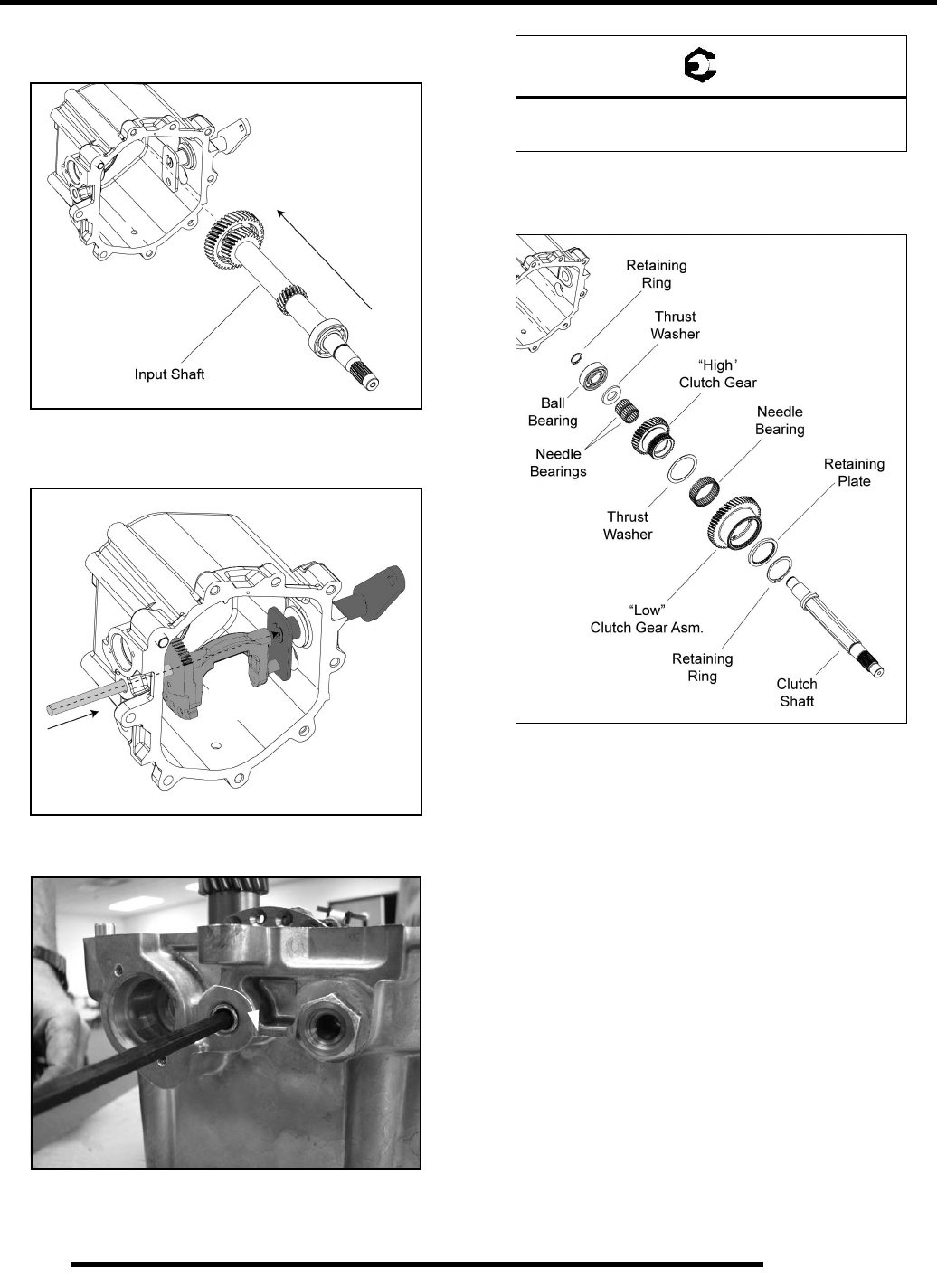
8.14
TRANSMISSION
4. Install the input shaft assembly into the transmission
housing.
5. Install the clutch yoke into the shifter assembly. Align the
holes and install clutch yoke pivot pin.
6. Install the pivot pin set screw and torque to specification.
7. Assemble the clutch shaft with new needle bearings. Press
a new ball bearing onto the end of the shaft and install a new
retaining ring.
8. Install the clutch shaft into the transmission housing.
9. Install the sliding shoes onto the clutch yoke.
Pivot
Pin
Shifter
Assembly
Clutch
Yoke
= T
Pivot Pin Set Screw:
100-125 in. lbs. (11-14 Nm)
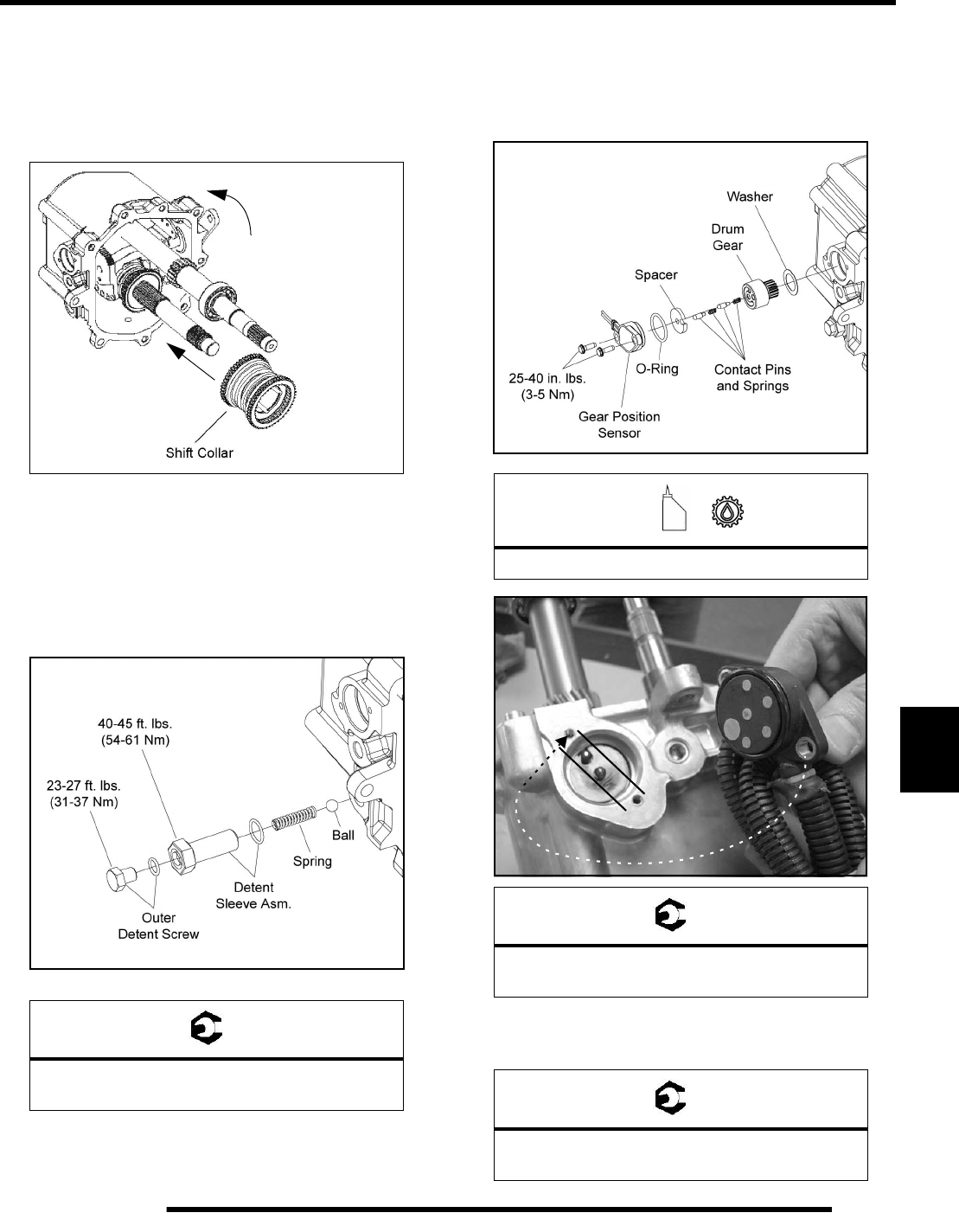
8.15
TRANSMISSION
8
10. Install the shift collar onto the clutch shaft. Pull back fully
on gear selector arm to bring the shift yoke arms up and
engage the shift shoes onto the center groove of the shift
collar. Shifting the clutch shaft position may aid in shift
collar installation. Install the park/reverse spacer on top of
the shift collar as shown.
11. Install the dent sleeve assembly, ball, spring and outer
detent screw. Use new O-rings anytime these screws are
removed. Torque the detent sleeve assembly to
specification. TURN THE OUTER DETENT SCREW
ONLY UNTIL LIGHT SHIFTING RESISTANCE IS
FELT AT THIS TIME. PLACE THE TRANSMISSION
IN NEUTRAL.
12. With the transmission in neutral, lubricate and install the
thrust washer, drum gear, plate, springs, contact pins and
the gear position sensor/O-ring assembly. Verify the
contact pins are aligned as shown with the transmission in
neutral. Torque the retaining screws to specification.
13. Complete the shift detent screw installation. Torque the
outer detent screws to specification.
= T
Detent Sleeve Assembly:
40-45 ft. lbs. (54-61 Nm)
=
Apply Lubricant to shift drum components
= T
Gear Position Sensor Screws:
25-40 in. lbs. (3-5 Nm)
= T
Outer Detent Screws:
23-27 ft. lbs. (31-37 Nm)
H
P
R
N
L
Neutral
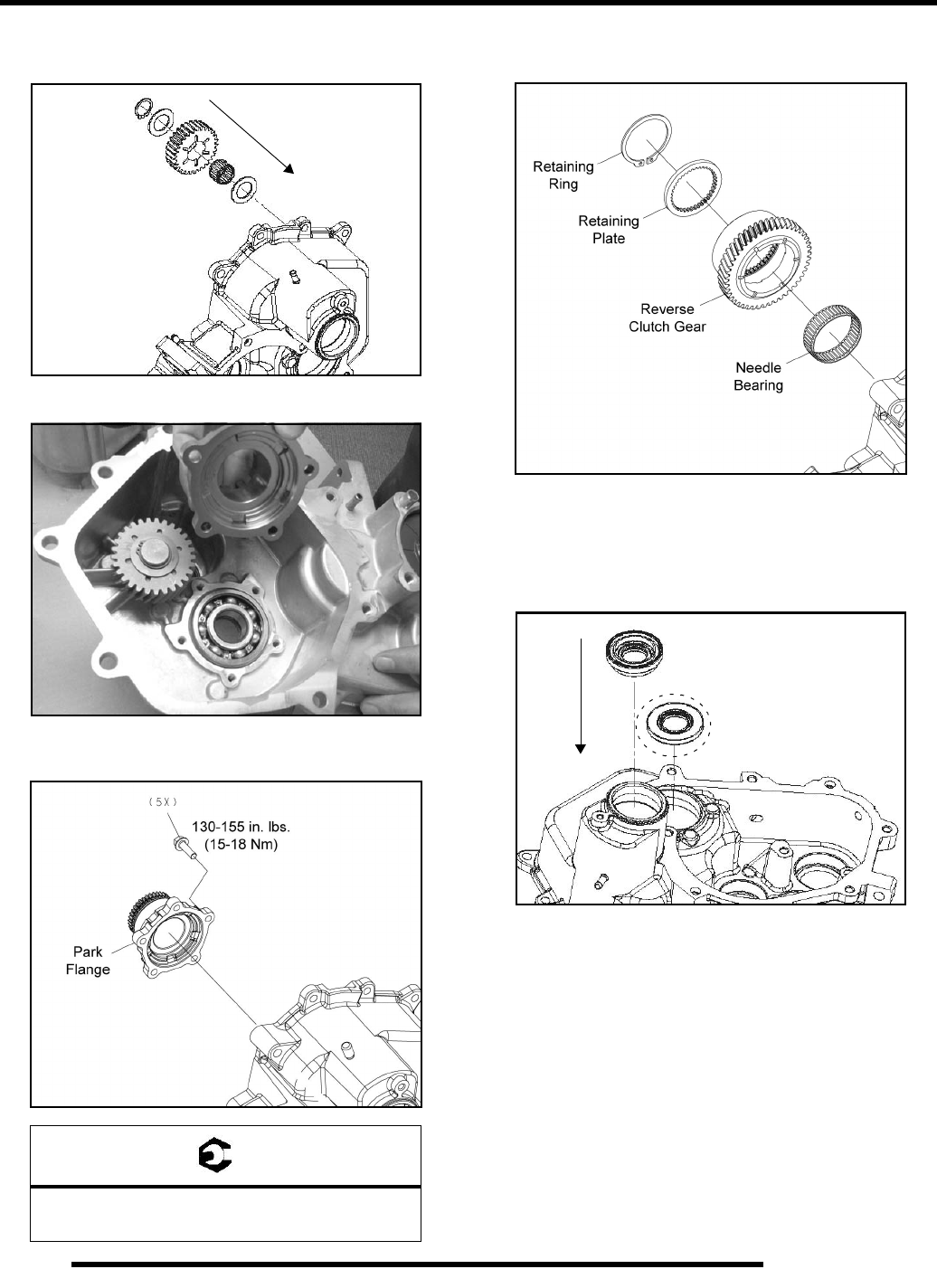
8.16
TRANSMISSION
14. Install the reverse idler lower washer, needle bearing, gear,
upper washer and retaining ring onto the idler shaft.
15. Install a new shaft bearing (if required).
16. Install the park flange and torque the (5) screws to
specification.
17. Install the reverse clutch assembly onto the park flange.
Note the orientation of the needle bearing.
18. Install the retaining plate and a new retaining ring.
19. Install the input shaft seal and verify it is fully seated. Install
the intermediate shaft seal (circled) flush or slightly below
the case. Apply lubricant to both seal lips.
= T
Park Flange Screws:
130-155 in. lbs. (15-18 Nm)

8.17
TRANSMISSION
8
20. Place the transmission shift housing onto a flat surface as
shown. Apply a bead of crankcase sealant onto the mating
surfaces. Align the dowels and install the transmission case
half onto the shift housing while rotating the input shaft,
using care not to damage the seal surfaces.
21. Install the shift cable bracket (7) shift housing case screws
to the front of the transmission. Torque to specification.
22. Install the (2) shift housing case screws to the backside as
shown. Torque to specification.
NOTE: Shift cable bracket installation is required.
23. Proceed with transfer case reassembly.
See “Transfer Case Reassembly” on page 8.7
Apply Sealant PN 2871557
to Case Mating Surfaces
= T
Shift Housing Screws:
23-27 ft. lbs. (31-37 Nm)
2871557
= T
Shift Housing Screws:
23-27 ft. lbs. (31-37 Nm)
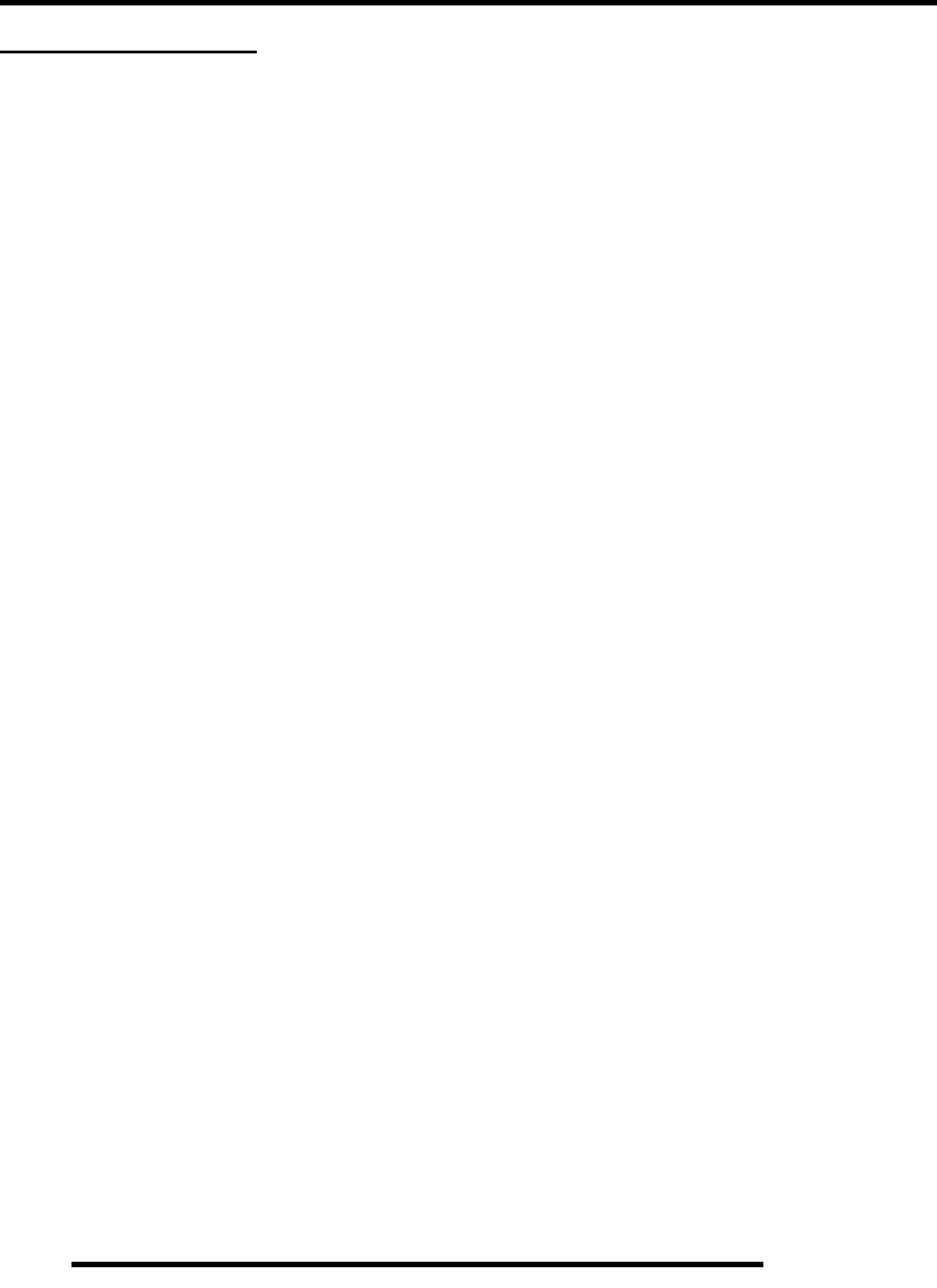
8.18
TRANSMISSION
TROUBLESHOOTING
Troubleshooting Checklist
Check the following items when shifting difficulty is
encountered:
• Idle speed adjustment
• PVT alignment
• Transmission oil type/quality
• Transmission torque stop adjustment (where applicable)
• Engine torque stop adjustment (where applicable)
• Drive belt deflection
• Loose fasteners on rod ends
• Loose fasteners on selector box
• Worn rod ends, clevis pins, or pivot arm bushings
• Linkage rod adjustment and rod end positioning
• Shift selector rail travel
• Worn, broken or damaged internal transmission
components
NOTE: To determine if shifting difficulty is caused
by an internal transmission problem, isolate the
transmission by disconnecting the shifter from
transmission bellcrank. Verify the engine RPM is set
to specification. Manually select each gear range at
the transmission bellcrank, and test ride vehicle. If it
functions properly, the problem is outside the
transmission.
If transmission problem remains, disassemble
transmission and inspect all gear dogs for wear
(rounding), damage. Inspect all bearings, circlips,
thrust washers and shafts for wear.
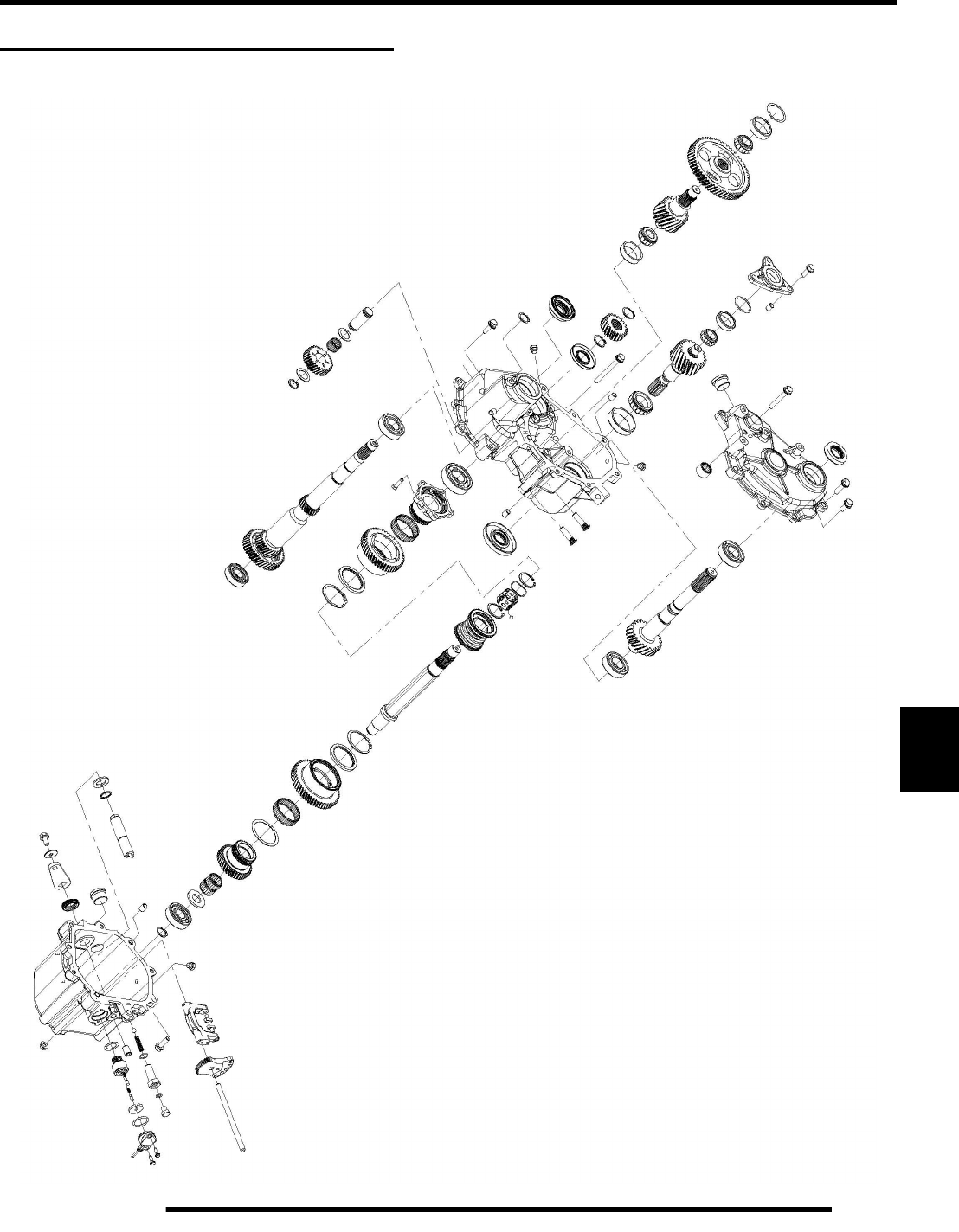
8.19
TRANSMISSION
8
TRANSMISSION EXPLODED VIEW
Shift Housing / Transfer Case Exploded View
Transfer Case
Shift Housing
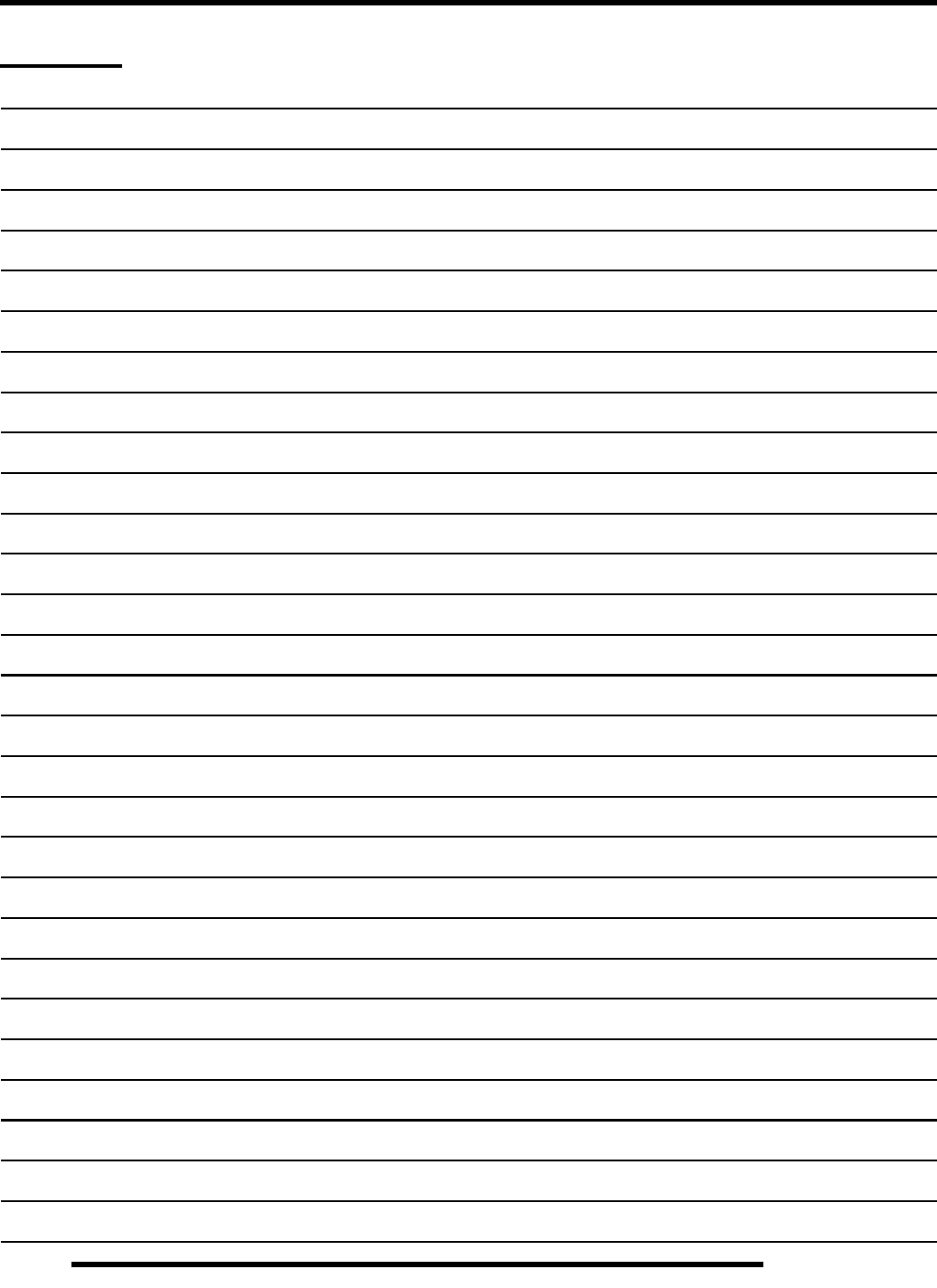
NOTES
TRANSMISSION
8.20
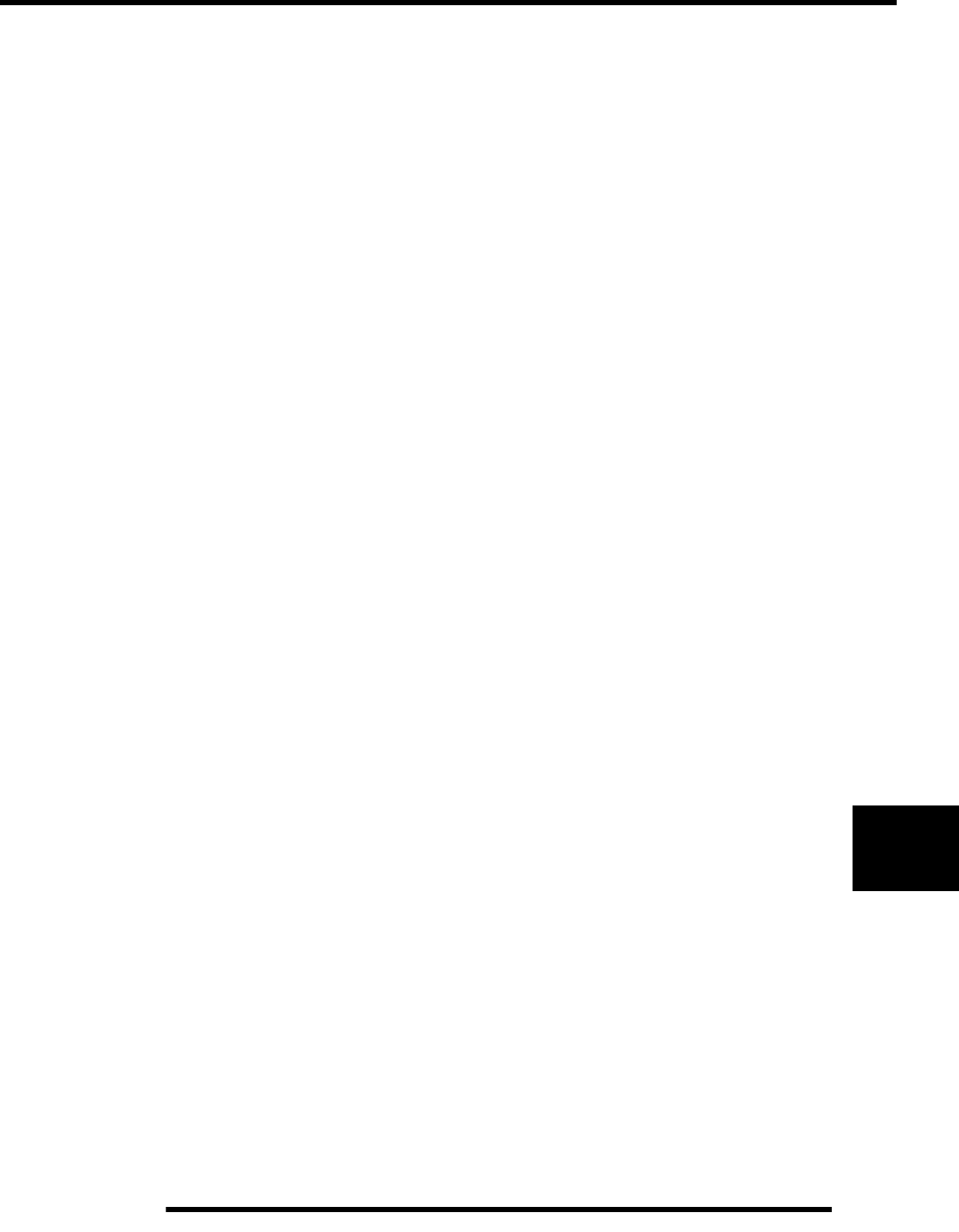
BRAKES
9.1
CHAPTER 9
BRAKES
9
GENERAL SPECIFICATIONS. . . . . . . . . . . . . . . . . . . . . . . . . . . . . . . . . . . . . . . . . . . . . . 9.2
TORQUE SPECIFICATIONS. . . . . . . . . . . . . . . . . . . . . . . . . . . . . . . . . . . . . . . . . . . . . . . 9.2
SPECIAL TOOLS . . . . . . . . . . . . . . . . . . . . . . . . . . . . . . . . . . . . . . . . . . . . . . . . . . . . . . . 9.2
BRAKE SYSTEM SERVICE NOTES. . . . . . . . . . . . . . . . . . . . . . . . . . . . . . . . . . . . . . . . . 9.3
BRAKE NOISE TROUBLESHOOTING . . . . . . . . . . . . . . . . . . . . . . . . . . . . . . . . . . . . . . . 9.3
HYDRAULIC BRAKE SYSTEM OPERATION . . . . . . . . . . . . . . . . . . . . . . . . . . . . . . . . . . 9.4
BRAKE SYSTEM EXPLODED VIEW . . . . . . . . . . . . . . . . . . . . . . . . . . . . . . . . . . . . . . . . 9.5
MASTER CYLINDER. . . . . . . . . . . . . . . . . . . . . . . . . . . . . . . . . . . . . . . . . . . . . . . . . . . . . 9.6
REMOVAL . . . . . . . . . . . . . . . . . . . . . . . . . . . . . . . . . . . . . . . . . . . . . . . . . . . . . . . . . . . . 9.6
INSTALLATION . . . . . . . . . . . . . . . . . . . . . . . . . . . . . . . . . . . . . . . . . . . . . . . . . . . . . . . . 9.6
BRAKE PEDAL LEVER . . . . . . . . . . . . . . . . . . . . . . . . . . . . . . . . . . . . . . . . . . . . . . . . . . . 9.6
PEDAL REMOVAL . . . . . . . . . . . . . . . . . . . . . . . . . . . . . . . . . . . . . . . . . . . . . . . . . . . . . . 9.6
PEDAL INSTALLATION . . . . . . . . . . . . . . . . . . . . . . . . . . . . . . . . . . . . . . . . . . . . . . . . . . 9.6
BRAKE BLEEDING / FLUID CHANGE . . . . . . . . . . . . . . . . . . . . . . . . . . . . . . . . . . . . . . . 9.7
FRONT BRAKE PADS. . . . . . . . . . . . . . . . . . . . . . . . . . . . . . . . . . . . . . . . . . . . . . . . . . . . 9.8
PAD REMOVAL . . . . . . . . . . . . . . . . . . . . . . . . . . . . . . . . . . . . . . . . . . . . . . . . . . . . . . . . 9.8
PAD INSPECTION . . . . . . . . . . . . . . . . . . . . . . . . . . . . . . . . . . . . . . . . . . . . . . . . . . . . . . 9.8
PAD ASSEMBLY / INSTALLATION . . . . . . . . . . . . . . . . . . . . . . . . . . . . . . . . . . . . . . . . . 9.9
BRAKE BURNISHING PROCEDURE . . . . . . . . . . . . . . . . . . . . . . . . . . . . . . . . . . . . . . . 9.9
FRONT CALIPER SERVICE . . . . . . . . . . . . . . . . . . . . . . . . . . . . . . . . . . . . . . . . . . . . . . 9.10
CALIPER EXPLODED VIEW . . . . . . . . . . . . . . . . . . . . . . . . . . . . . . . . . . . . . . . . . . . . . 9.10
CALIPER REMOVAL . . . . . . . . . . . . . . . . . . . . . . . . . . . . . . . . . . . . . . . . . . . . . . . . . . . 9.10
CALIPER DISASSEMBLY . . . . . . . . . . . . . . . . . . . . . . . . . . . . . . . . . . . . . . . . . . . . . . . 9.11
CALIPER INSPECTION . . . . . . . . . . . . . . . . . . . . . . . . . . . . . . . . . . . . . . . . . . . . . . . . . 9.12
CALIPER ASSEMBLY . . . . . . . . . . . . . . . . . . . . . . . . . . . . . . . . . . . . . . . . . . . . . . . . . . 9.12
CALIPER INSTALLATION . . . . . . . . . . . . . . . . . . . . . . . . . . . . . . . . . . . . . . . . . . . . . . . 9.13
FRONT BRAKE DISC . . . . . . . . . . . . . . . . . . . . . . . . . . . . . . . . . . . . . . . . . . . . . . . . . . . 9.14
DISC RUNOUT. . . . . . . . . . . . . . . . . . . . . . . . . . . . . . . . . . . . . . . . . . . . . . . . . . . . . . . . 9.14
DISC INSPECTION . . . . . . . . . . . . . . . . . . . . . . . . . . . . . . . . . . . . . . . . . . . . . . . . . . . . 9.14
DISC REPLACEMENT . . . . . . . . . . . . . . . . . . . . . . . . . . . . . . . . . . . . . . . . . . . . . . . . . . 9.14
REAR BRAKE PADS. . . . . . . . . . . . . . . . . . . . . . . . . . . . . . . . . . . . . . . . . . . . . . . . . . . . 9.15
PAD REMOVAL . . . . . . . . . . . . . . . . . . . . . . . . . . . . . . . . . . . . . . . . . . . . . . . . . . . . . . . 9.15
PAD INSPECTION . . . . . . . . . . . . . . . . . . . . . . . . . . . . . . . . . . . . . . . . . . . . . . . . . . . . . 9.16
PAD ASSEMBLY / INSTALLATION . . . . . . . . . . . . . . . . . . . . . . . . . . . . . . . . . . . . . . . . 9.16
BRAKE BURNISHING PROCEDURE . . . . . . . . . . . . . . . . . . . . . . . . . . . . . . . . . . . . . . 9.17
REAR CALIPER SERVICE . . . . . . . . . . . . . . . . . . . . . . . . . . . . . . . . . . . . . . . . . . . . . . . 9.18
CALIPER EXPLODED VIEW . . . . . . . . . . . . . . . . . . . . . . . . . . . . . . . . . . . . . . . . . . . . . 9.18
CALIPER REMOVAL . . . . . . . . . . . . . . . . . . . . . . . . . . . . . . . . . . . . . . . . . . . . . . . . . . . 9.18
CALIPER DISASSEMBLY . . . . . . . . . . . . . . . . . . . . . . . . . . . . . . . . . . . . . . . . . . . . . . . 9.19
CALIPER INSPECTION . . . . . . . . . . . . . . . . . . . . . . . . . . . . . . . . . . . . . . . . . . . . . . . . . 9.19
CALIPER ASSEMBLY . . . . . . . . . . . . . . . . . . . . . . . . . . . . . . . . . . . . . . . . . . . . . . . . . . 9.20
CALIPER INSTALLATION . . . . . . . . . . . . . . . . . . . . . . . . . . . . . . . . . . . . . . . . . . . . . . . 9.20
REAR BRAKE DISC . . . . . . . . . . . . . . . . . . . . . . . . . . . . . . . . . . . . . . . . . . . . . . . . . . . . 9.21
DISC INSPECTION . . . . . . . . . . . . . . . . . . . . . . . . . . . . . . . . . . . . . . . . . . . . . . . . . . . . 9.21
DISC REPLACEMENT . . . . . . . . . . . . . . . . . . . . . . . . . . . . . . . . . . . . . . . . . . . . . . . . . . 9.21
TROUBLESHOOTING. . . . . . . . . . . . . . . . . . . . . . . . . . . . . . . . . . . . . . . . . . . . . . . . . . . 9.22
BRAKES SQUEAL / POOR BRAKE PERFORMANCE . . . . . . . . . . . . . . . . . . . . . . . . . 9.22
PEDAL VIBRATION . . . . . . . . . . . . . . . . . . . . . . . . . . . . . . . . . . . . . . . . . . . . . . . . . . . . 9.22
CALIPER OVERHEATS (BRAKES DRAG) . . . . . . . . . . . . . . . . . . . . . . . . . . . . . . . . . . 9.22
BRAKES LOCK. . . . . . . . . . . . . . . . . . . . . . . . . . . . . . . . . . . . . . . . . . . . . . . . . . . . . . . . 9.22

9.2
BRAKES
GENERAL SPECIFICATIONS
TORQUE SPECIFICATIONS SPECIAL TOOLS
FRONT BRAKE SYSTEM
Item Standard Service Limit
Front Brake Pad Thickness .297 ± .007" (7.54 ± .178 mm) .180" (4.6 mm)
Front Brake Disc Thickness .188" (4.78 mm) .170" (4.32 mm)
Front Brake Disc Runout - .010" (.254 mm)
REAR BRAKE SYSTEM
Item Standard Service Limit
Rear Brake Pad Thickness .298 ± .007" (7.57 ± .178 mm) .180" (4.6 mm)
Rear Brake Disc Thickness .188" (4.78 mm) .170" (4.32 mm)
Rear Brake Disc Runout - .010" (.254 mm)
Item Torque
ft. lbs. Torque
Nm
Front Caliper Mounting Bolts 31-34 42-46
Rear Caliper Mounting Bolts 18 24
Brake Line Flare 12-15 16-20
Brake Line Banjo Bolts
(Caliper Attachment) 15 20
Brake Line Banjo Bolt
(Master Cylinder Attachment) 15 20
Front Brake Disc to Hub Bolts 18 24
Rear Brake Disc to Hub Bolts 28 38
Brake Switch 12-15 16-20
Master Cylinder to Frame 17 23
Brake Pedal Mounting Bracket
to Frame 17 23
Part Number Tool Description
2870975 Mity Vac™ Pressure Test Tool
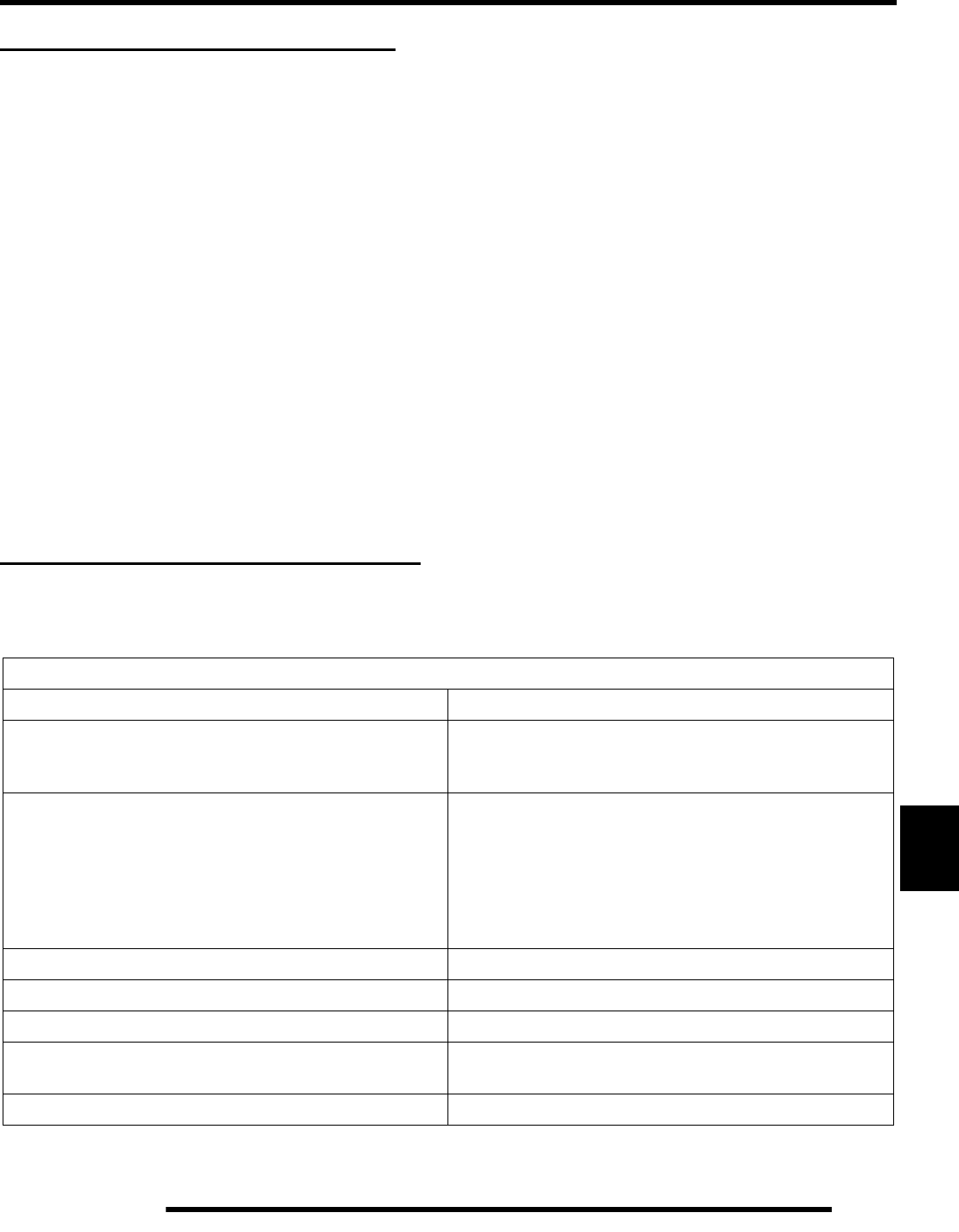
9.3
BRAKES
9
BRAKE SYSTEM SERVICE NOTES
Disc brake systems are light weight, low maintenance, and perform well in the conditions this vehicle will routinely encounter. There
are a few things to remember when replacing disc brake pads or performing brake system service to ensure proper system function
and maximum pad service life.
• Optional pads are available to suit conditions in your area. Select a pad to fit riding style and environment.
• Do not over-fill the master cylinder fluid reservoir.
• Make sure the brake pedal returns freely and completely.
• Adjust stop pin on front caliper after pad service.
• Check and adjust master cylinder reservoir fluid level after pad service.
• Make sure atmospheric vent on reservoir is unobstructed.
• Test for brake drag after any brake system service and investigate cause if brake drag is evident.
• Make sure caliper moves freely on guide pins (where applicable).
• Inspect caliper piston seals for foreign material that could prevent caliper pistons from returning freely.
• Perform a brake burnishing procedure after installing new pads to maximize service life.
• DO NOT lubricate or clean the brake components with aerosol or petroleum products. Use only approved brake cleaning
products.
BRAKE NOISE TROUBLESHOOTING
Dirt or dust buildup on the brake pads and disc is the most common cause of brake noise (squeal caused by vibration). If cleaning
does not reduce the occurrence of brake noise, Permatex™ Disc Brake Quiet can be applied to the back of the pads. Follow directions
on the package. This will keep pads in contact with caliper piston(s) to reduce the chance of squeaks caused by dirt or dust.
Brake Noise Troubleshooting
Possible Cause Remedy
Dirt, dust, or imbedded material on pads or disc Spray disc and pads with CRC Brakeleen™ or an equivalent
non-flammable aerosol brake cleaner. Remove pads and/or disc
hub to clean imbedded material from disc or pads.
Pad(s) dragging on disc (noise or premature pad wear) because
of improper adjustment
Master cylinder reservoir overfilled
Master cylinder compensating port restricted
Master cylinder piston not returning completely
Caliper piston(s) not returning
Operator error (riding the brake)
Adjust pad stop (front calipers)
Set to proper level
Clean compensating port
Inspect. Repair as necessary
Clean piston(s) seal
Educate operator
Loose wheel hub or bearings Check wheel and hub for abnormal movement.
Brake disc warped or excessively worn Replace disc
Brake disc misaligned or loose Inspect and repair as necessary
Noise is from other source (axle, hub, disc or wheel) If noise does not change when brake is applied check other
sources. Inspect and repair as necessary
Wrong pad for conditions Change to a softer or harder pad
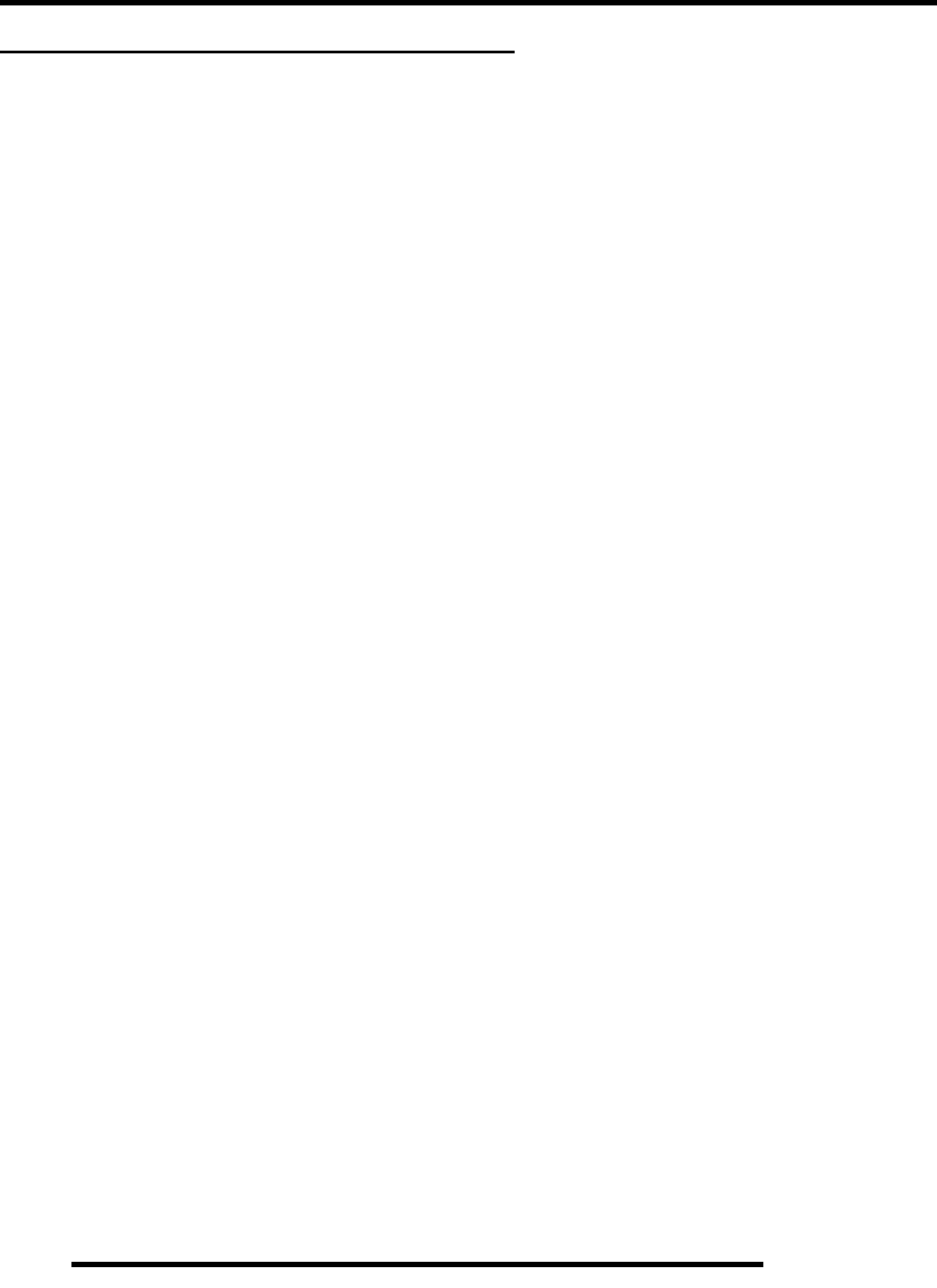
9.4
BRAKES
HYDRAULIC BRAKE SYSTEM OPERATION
The Polaris brake system consists of the following components or assemblies: brake pedal, master cylinder, hydraulic brake lines,
brake calipers, brake pads, and brake discs, which are secured to the drive line.
When the foot activated brake lever is applied it applies pressure on the piston within the master cylinder. As the master cylinder
piston moves inward it closes a small opening (compensating port) within the cylinder and starts to build pressure within the brake
system. As the pressure within the system is increased, the pistons located in the brake calipers move outward and apply pressure
to the moveable brake pads. These pads contact the brake discs and move the calipers in their floating bracket, pulling the stationary
side pads into the brake discs. The resulting friction reduces brake disc and vehicle speed.
The friction applied to the brake pads will cause the pads to wear. As these pads wear, the piston within the caliper moves further
outward and becomes self adjusting. Fluid from the reservoir fills the additional area created when the caliper piston moves outward.
Brake fluid level is critical to proper system operation. Too little fluid will allow air to enter the system and cause the brakes to feel
spongy. Too much fluid could cause brakes to drag due to fluid expansion.
Located within the master cylinder is the compensating port which is opened and closed by the master cylinder piston assembly. As
the temperature within the hydraulic system changes, this port compensates for fluid expansion or contraction. Due to the high
temperatures created within the system during heavy braking, it is very important that the master cylinder reservoir have adequate
space to allow for fluid expansion. Never overfill the reservoir! Do not fill the reservoir beyond the MAX LEVEL line!
When servicing Polaris brake systems use only Polaris DOT 4 Brake Fluid (PN 2872189). WARNING: Once a bottle is opened,
use what is necessary and discard the rest in accordance with local laws. Do not store or use a partial bottle of brake fluid. Brake
fluid is hygroscopic, meaning it rapidly absorbs moisture. This causes the boiling temperature of the brake fluid to drop, which can
lead to early brake fade and the possibility of serious injury.

9.5
BRAKES
9
BRAKE SYSTEM EXPLODED VIEW
RZR SW
Caliper Banjo Style Fittings:
15 ft. lbs. (20 Nm).
All Caliper Bleed Screws:
47 in. lbs. (5.3 Nm)
Master Cylinder Side View
Cross
MC Rear
Brake Line
RH Rear Line
RH Front
Brake Line
Front Calipers
Brake
Master Cylinder
LH Front
Rear Calipers
Brake Line
LH Rear Line
1
2
1
1
2
2
1
3All Flare Style Fittings:
12-15 ft. lbs. (16-20 Nm)
3
1
1
2
2
15 ft. lbs.
(20 Nm)
3
Fitting
Switch
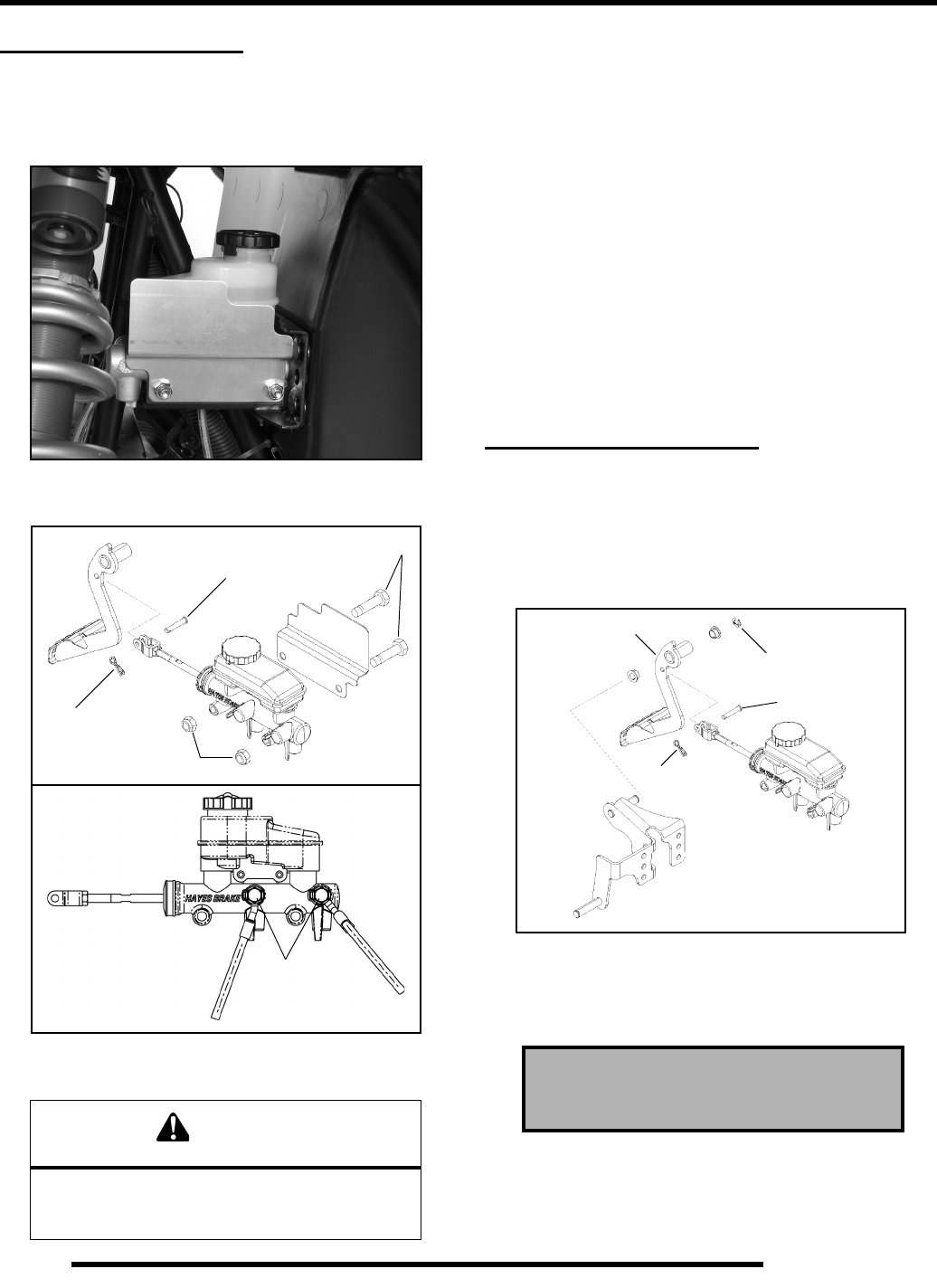
9.6
BRAKES
MASTER CYLINDER
Removal
1. Locate the master cylinder above the left front tire in the
wheel well area.
2. Remove the clip (A) from the clevis pin (B) that attaches
the master cylinder to the brake pedal lever.
3. Place a container to catch brake fluid under the master
cylinder brake line banjo bolts (C).
NOTE: Make note of front and rear brake line
locations to master cylinder.
4. Loosen the brake line banjo bolts (C) and allow fluid to
drain.
NOTE: Dispose of fluid properly. Do not re-use.
5. Remove the two mounting fasteners (D) that secure the
master cylinder to the frame.
Installation
1. Reverse Steps 1-5 for master cylinder installation.
Refer to the torque specifications in the illustration.
2. After installing the foot brake check pedal freeplay. Pedal
freeplay should not exceed .090” (2.286 mm).
BRAKE PEDAL LEVER
Pedal Removal
1. Locate the brake pedal lever (L) and remove the master
cylinder clevis pin (B) and clip (A).
2. Remove the E-ring (E) from the pedal mount and remove
the brake pedal lever (L) from the vehicle.
Pedal Installation
1. Reverse “Removal” steps to install brake pedal lever.
Brake pedal freeplay should not exceed .090” (2.28 mm).
CAUTION
Brake fluid will damage finished surfaces.
Do not allow brake fluid to come in contact
with finished surfaces.
Master Cylinder
A
15 ft. lbs.
(20 Nm)
B
C
D
D
17 ft. lbs.
(23 Nm)
Brake Pedal Freeplay:
.090” (2.28 mm)
B
A
L
E
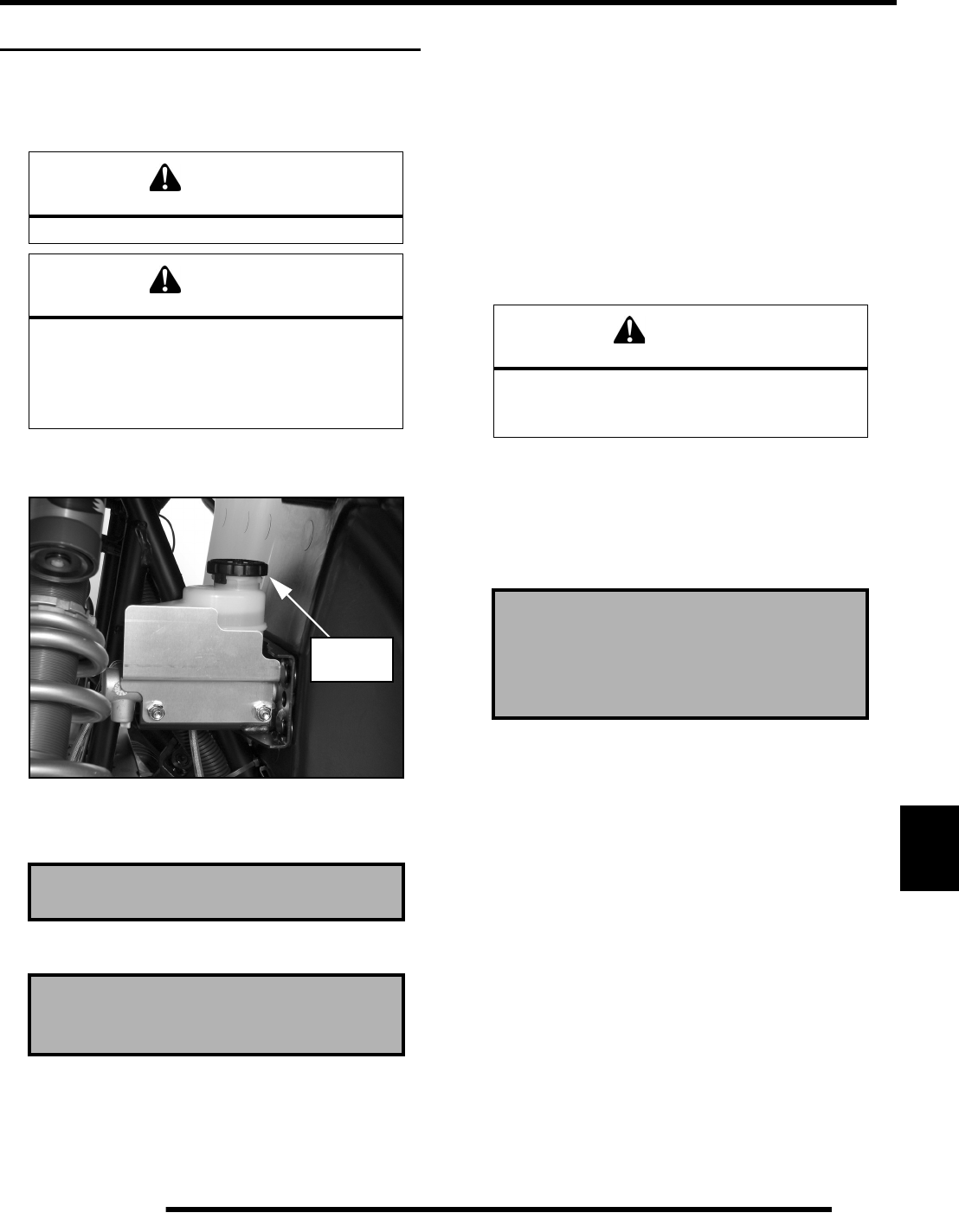
9.7
BRAKES
9
BRAKE BLEEDING / FLUID CHANGE
NOTE: When bleeding the brakes or replacing the
fluid always start with the furthest caliper from the
master cylinder.
1. Clean master cylinder reservoir cover thoroughly and
remove the cover.
2. If changing fluid, remove old fluid from reservoir with a
Mity Vac™ pump or similar tool.
3. Add brake fluid to the indicated MAX level of reservoir.
4. Begin bleeding procedure with the caliper that is farthest
from the master cylinder. Install a box end wrench on
caliper bleeder screw. Attach a clean, clear hose to fitting
and place the other end in a clean container. Be sure the hose
fits tightly on fitting.
5. Have an assistant slowly pump foot pedal until pressure
builds and holds.
6. Hold brake pedal on to maintain pedal pressure, and open
bleeder screw. Close bleeder screw and release foot pedal.
NOTE: Do not release foot pedal before bleeder
screw is tight or air may be drawn into master
cylinder.
7. Repeat procedure until clean fluid appears in bleeder hose
and all air has been purged. Add fluid as necessary to
maintain level in reservoir.
8. Tighten bleeder screw securely and remove bleeder hose.
Torque bleeder screw to 47 in. lbs. (5.3 Nm).
9. Repeat procedure Steps 5 - 8 for the remaining calipers.
10. Add brake fluid to MAX level inside reservoir.
11. Install master cylinder reservoir cover.
12. Field test machine at low speed before putting into service.
Check for proper braking action and pedal reserve. With
pedal firmly applied, pedal reserve should be no less than
1/2"(1.3 cm).
13. Check brake system for fluid leaks.
CAUTION
Always wear safety glasses.
CAUTION
Brake fluid will damage finished surfaces. Do not
allow brake fluid to come in contact with finished
surfaces. This procedure should be used to
change fluid or bleed brakes during
regular maintenance.
Mity Vac™ (PN 2870975)
Polaris DOT 4 Brake Fluid
(PN 2872189)
Master Cylinder Remove
Cover
CAUTION
Maintain at least 1/2"(1.27 cm) of brake fluid in
the reservoir to prevent air from
entering the master cylinder.
Master Cylinder Fluid Level
Between the MIN and MAX line shown
on the reservoir.

9.8
BRAKES
FRONT BRAKE PADS
Pad Removal
1. Elevate and support front of vehicle.
2. Remove the wheel nuts, washers and front wheel.
3. Loosen the pad adjuster screw 2-3 turns.
4. Remove the upper and lower caliper mounting bolts and
remove the caliper from the front hub.
NOTE: When removing caliper, use care not to
damage brake line. Support caliper so to avoid
kinking or bending brake line.
5. Push caliper piston into caliper bore slowly using a
C-clamp or locking pliers with pads installed.
NOTE: Brake fluid will be forced through
compensating port into master cylinder fluid
reservoir when piston is pushed back into caliper.
Remove excess fluid from reservoir as required.
6. Push the mounting bracket inward and the slip outer brake
pad out between the bracket and caliper body.
7. Remove the inner pad from the bracket and caliper.
Pad Inspection
1. Measure the thickness of the pad material. Replace pads if
worn beyond the service limit.
CAUTION
Use care when supporting vehicle so that it
does not tip or fall.
Severe injury may occur if machine tips or falls.
Front Brake Pad Thickness:
.297 ± .007" (7.5 ± .178 mm)
Service Limit: .180” (4.6 mm)
Measure
Thickness

9.9
BRAKES
9
Pad Assembly / Installation
1. Lubricate mounting bracket pins with a light film of
Polaris Premium All Season Grease (PN 2871423), and
install rubber dust boots.
2. Compress mounting bracket and make sure dust boots are
fully seated. Install pads with friction material facing each
other.
3. Install caliper onto front hub and torque mounting bolts to
specification.
4. Slowly pump the brake pedal until pressure has been built
up. Maintain at least 1/2, (12.7 mm) of brake fluid in the
reservoir to prevent air from entering the brake system.
5. Install the adjustment set screw and turn clockwise until
stationary pad contacts disc, then back off 1/2 turn
(counterclockwise).
6. Verify fluid level in reservoir is up to MAX line inside
reservoir and install reservoir cap.
7. Install wheel and torque wheel nuts to specification.
Brake Burnishing Procedure
It is required that a burnishing procedure be performed after
installation of new brake pads to extend service life and reduce
noise.
Start machine and slowly increase speed to 30 mph. Gradually
apply brakes to stop machine. Allow pads and disc to cool
sufficiently during the procedure. Do not allow pads or disc to
become hot or warping may result. Repeat this procedure 10
times.
WARNING
If brake pads are contaminated with grease, oil,
or liquid soaked do not use the pads.
Use only new, clean pads.
= T
Front Caliper Mount Bolt Torque:
31-34 ft. lbs. (42-46 Nm)
Apply Grease to Each
Bracket Pin
31-34 ft. lbs.
(42-46 Nm)
Master Cylinder Fluid
Up to MAX line inside reservoir
= T
Wheel Nuts:
Steel Wheels: 35 ft. lbs. (47 Nm)
Aluminum Wheels: 30 ft. lbs. + 90° (1/4 turn)
1/2 Turn
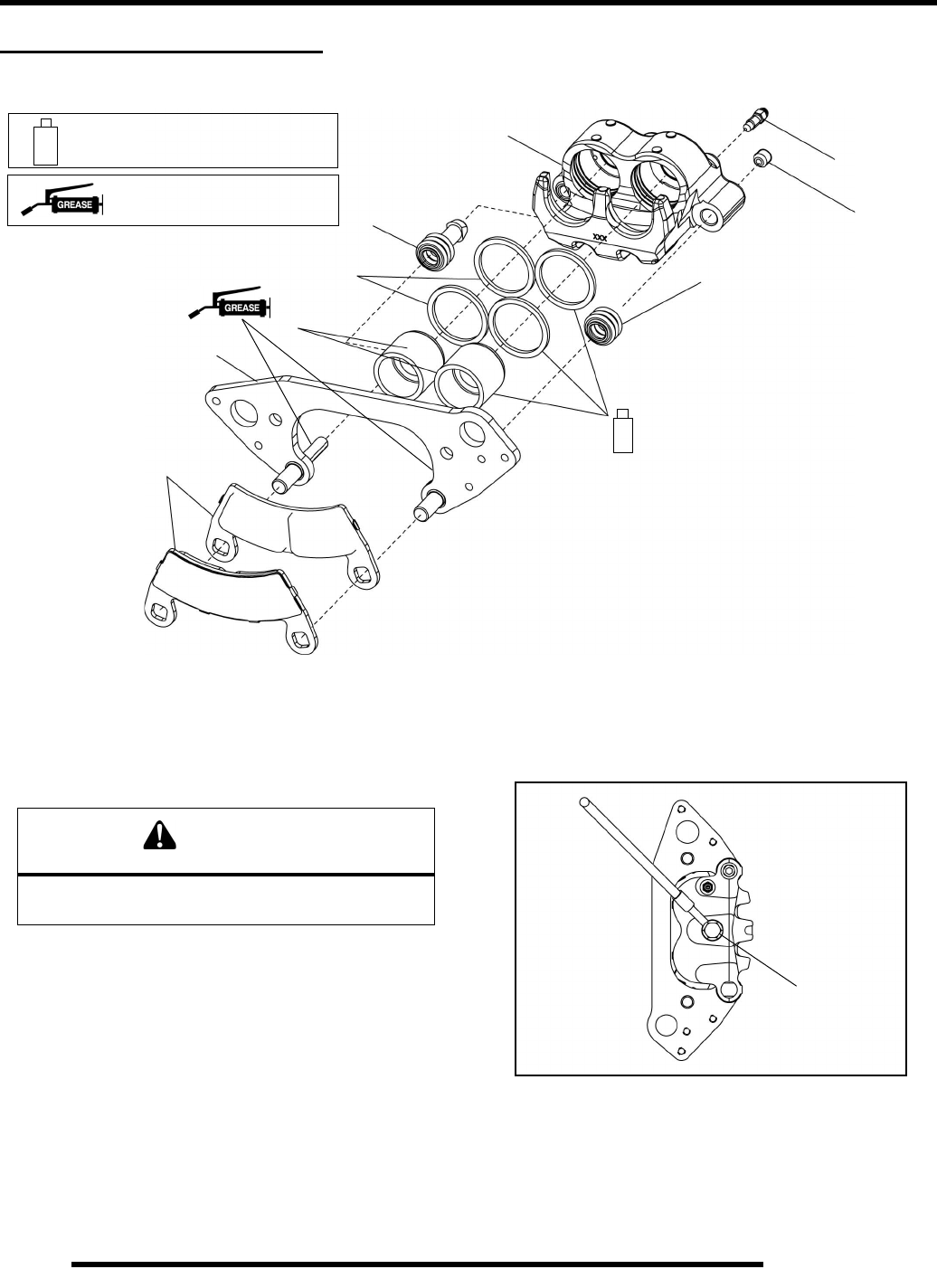
9.10
BRAKES
FRONT CALIPER SERVICE
Caliper Exploded View
Caliper Removal
1. Elevate and safely support the front of the vehicle.
2. Remove the (4) wheel nuts and the front wheel.
3. Clean caliper area before removal.
4. Place a container below the caliper to catch brake fluid
when removing the line. Remove brake line from caliper.
A
B
C
D
47 in. lbs.
(5.3 Nm)
A. Socket Set Screw
B. Bleeder Screw
C. Caliper Assy.
D. Boots
E. Square O-rings
F. Pistons
G . C a l i p e r M o u n t
H. Brake Pads
F
G
H
Apply Polaris All Purpose
Grease
Apply Polaris DOT 4 Brake Fluid
to Components
D
E
CAUTION
Use care when supporting vehicle so that it does not
tip or fall. Severe injury may occur.
Remove
Brake Line

9.11
BRAKES
9
5. Loosen brake pad adjustment set screw 2-3 turns to allow
brake pad removal after the caliper is removed.
6. Remove the two caliper mounting bolts and remove the
caliper assembly from the front hub.
Caliper Disassembly
1. Remove both brake pads from the caliper (see “FRONT
BRAKE PADS - Pad Removal”).
2. Remove mount bracket assembly and dust boots.
3. Thoroughly clean the caliper before disassembly and
prepare a clean work area for disassembly.
4. Use a commercially available caliper piston pliers to extract
the pistons from the caliper.
IMPORTANT: Do not remove the caliper pistons with
a standard pliers. The piston sealing surfaces will
become damaged if a standard pliers is used.
5. Once the pistons are removed, use a pick to carefully
remove the square O-rings from the caliper. O-rings should
be replaced during caliper service.
Remove
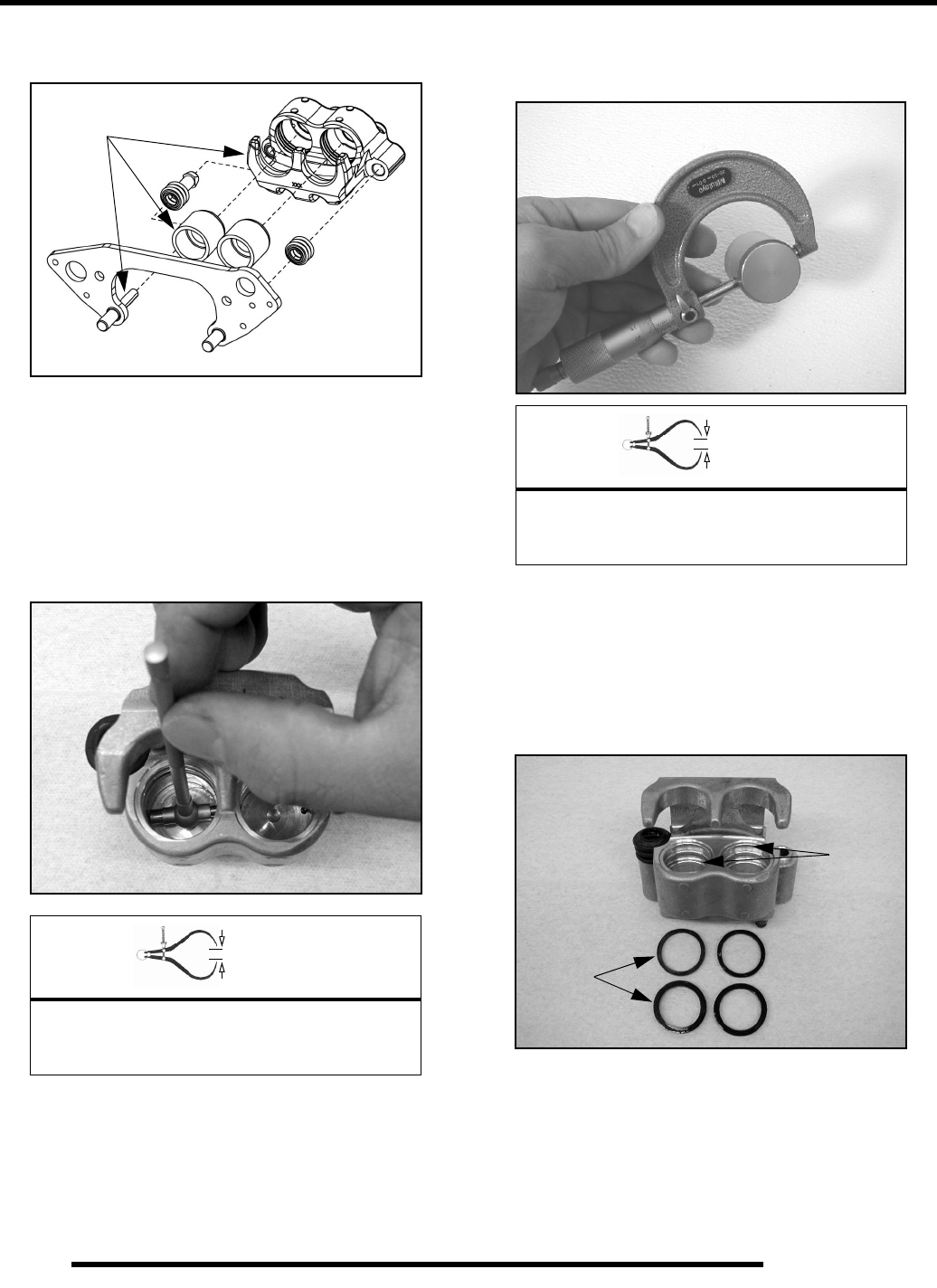
9.12
BRAKES
6. Clean the caliper body, piston, and retaining bracket with
brake cleaner or alcohol.
NOTE: Be sure to clean seal grooves in caliper
body.
Caliper Inspection
1. Inspect caliper body for nicks, scratches, pitting or wear.
Measure bore size and compare to specifications. Replace
if damaged or worn beyond service limit.
2. Inspect piston for nicks, scratches, pitting or wear. Measure
piston diameter and replace if damaged or worn beyond
service limit.
3. Inspect the brake disc and pads as outlined in this chapter.
Caliper Assembly
1. Install new O-rings in the caliper body. Be sure the
grooves are clean and free of residue or brakes may drag
upon assembly.
2. Coat pistons with clean Polaris DOT 4 Brake Fluid. Install
pistons with a twisting motion while pushing inward.
Piston should slide in and out of bore smoothly, with light
resistance.
= In. / mm.
Front Caliper Piston Bore I.D.:
Std: 1.373” (34.87 mm)
Service Limit: 1.375” (34.93 mm)
Clean
Components
= In. / mm.
Front Caliper Piston O.D.:
Std: 1.370” (34.80 mm)
Service Limit: 1.368” (34.75 mm)
New
Seal
Grooves
O-Rings
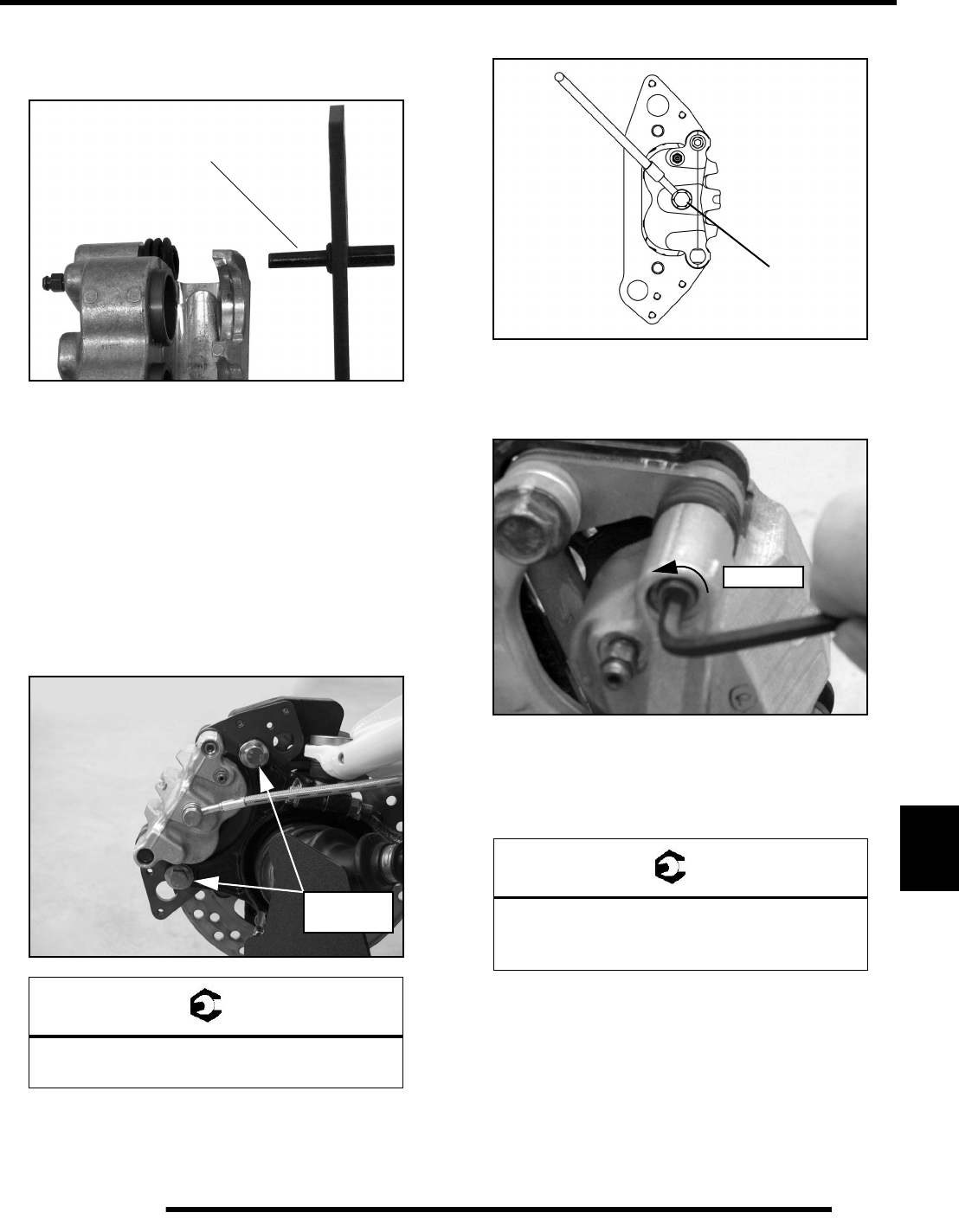
9.13
BRAKES
9
3. Lubricate the mounting bracket pins with Polaris Premium
All Season Grease (PN 2871423), and install the rubber
dust seal boots.
4. Compress the mounting bracket and make sure the dust seal
boots are fully seated. Install the brake pads. Clean the disc
and pads with brake parts cleaner or denatured alcohol to
remove any dirt, oil or grease.
Caliper Installation
1. Install the brake line onto the caliper taking care not to
allow any debris to enter the caliper.
2. Install the caliper and torque the mounting bolts to
specification.
3. Torque the banjo bolt to the proper torque specification.
4. Install the adjustment set screw and turn clockwise until
stationary pad contacts disc, then back off 1/2 turn
(counterclockwise).
5. Perform brake bleeding procedure as outlined earlier in this
chapter.
6. Install wheel and torque wheel nuts to specification.
7. Field test unit for proper braking action before putting into
service. Inspect for fluid leaks and firm brakes. Make sure
the brake is not dragging when pedal is released. If the brake
drags, re-check assembly and installation.
NOTE: If new pads are installed, refer to “FRONT
BRAKE PADS - Brake Burnishing Procedure”.
= T
Front Caliper Mount Bolt Torque:
31-34 ft. lbs. (42-46 Nm)
Apply Grease to Each
Bracket Pin
31-34 ft. lbs.
(42-46 Nm)
= T
Wheel Nuts:
Steel Wheels: 35 ft. lbs. (47 Nm)
Aluminum Wheels: 30 ft. lbs. + 90° (1/4 turn)
15 ft. lbs.
(20 Nm)
1/2 Turn

9.14
BRAKES
FRONT BRAKE DISC
Disc Runout
1. Mount dial indicator as shown to measure disc runout.
Slowly rotate the disc and read total runout on the dial
indicator. Replace the disc if runout exceeds specification.
Disc Inspection
1. Visually inspect disc for scoring, scratches, or gouges.
Replace the disc if any deep scratches are evident.
2. Use a 0-1” micrometer and measure the disc thickness at
eight different points around the pad contact surface.
Replace disc if worn beyond service limit.
Disc Replacement
1. Remove the front brake caliper (see “FRONT CALIPER
SERVICE”).
2. Remove wheel hub cotter pin, castle nut and washers.
3. Remove the wheel hub assembly from the vehicle and
remove the (4) bolts retaining the disc to the hub.
4. Clean the wheel hub mating surface and install new disc on
wheel hub.
5. Install new bolts and torque to 18 ft. lbs. (24 Nm).
Brake Disc Runout
Service Limit .010” (.254 mm)
Measure
Thickness
Front
Disc
Brake Disc Thickness
New .188” (4.78 mm)
Service Limit .170” (4.32 mm)
Brake Disc Thickness Variance
Service Limit: .002” (.051 mm)
difference between measurements
Cotter
Pin
Washers
Nut
(4) Bolts
18 ft. lbs.
(24 Nm)

9.15
BRAKES
9
6. Install wheel hub assembly, washers, and castle nut. Torque
castle nut to 80 ft. lbs. (108 Nm) and install a new cotter pin.
7. Install the front brake caliper (see “FRONT CALIPER
SERVICE”).
8. Follow bleeding procedure outlined earlier in this chapter.
9. Field test unit for proper braking action before putting into
service. Inspect for fluid leaks and firm brakes. Make sure
the brake is not dragging when pedal is released. If the brake
drags, re-check assembly and installation.
REAR BRAKE PADS
Pad Removal
1. Elevate and support rear of vehicle.
2. Remove the rear wheel.
3. Loosen pad adjuster screw 2-3 turns.
4. Remove the two caliper mounting bolts and lift caliper off
the brake disc.
NOTE: When removing caliper, be careful not to
damage brake line. Support caliper so as not to kink
or bend brake line.
CAUTION
Always use new brake disc mounting bolts. The
bolts have a pre-applied locking agent which is
destroyed upon removal.
CAUTION
Use care when supporting vehicle so that it
does not tip or fall.
Severe injury may occur if machine tips or falls.
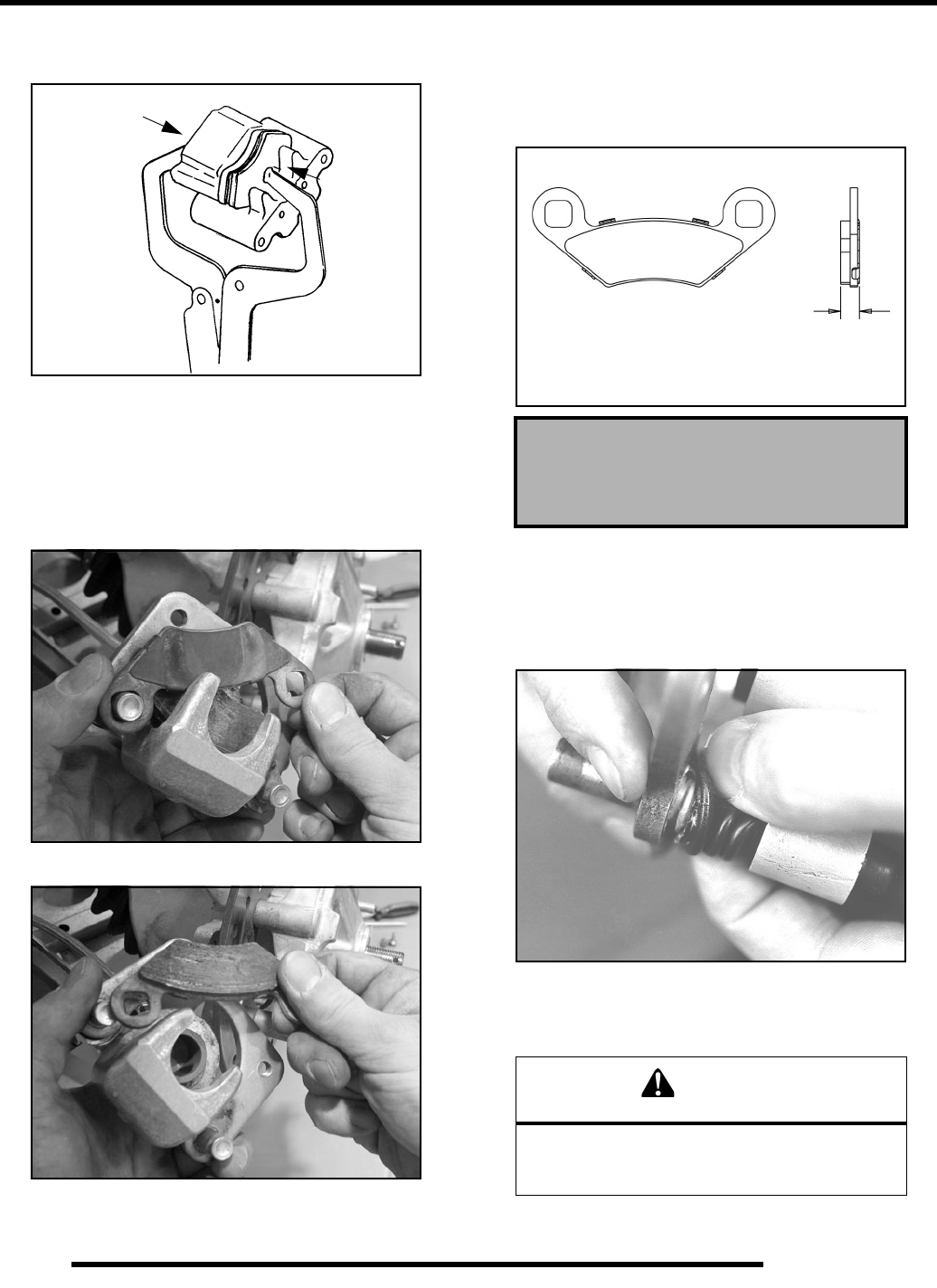
9.16
BRAKES
5. Push caliper piston into the caliper bore slowly using a C-
clamp or locking pliers with pads installed.
NOTE: Brake fluid will be forced through
compensating port into master cylinder fluid
reservoir when piston is pushed back into caliper.
Remove excess fluid from reservoir as required.
6. Push caliper mounting bracket inward and slip outer brake
pad past the edge to remove.
7. Remove the inner brake pad.
Pad Inspection
1. Clean the caliper with brake cleaner or alcohol.
2. Measure the thickness of the pad material. Replace pads if
worn beyond the service limit.
Pad Assembly / Installation
1. Lubricate mounting bracket pins with a light film of
Polaris Premium All Season Grease (PN 2871423), and
install rubber dust boots.
2. Compress mounting bracket and make sure dust boots are
fully seated. Install pads with friction material facing each
other.
Rear Brake Pad Thickness
New .298” ± .007” (7.57 mm ± .178 mm)
Service Limit .180” (4.6 mm)
WARNING
If brake pads are contaminated with grease,
oil, or liquid soaked do not use the pads.
Use only new clean pads.
Measure
Thickness
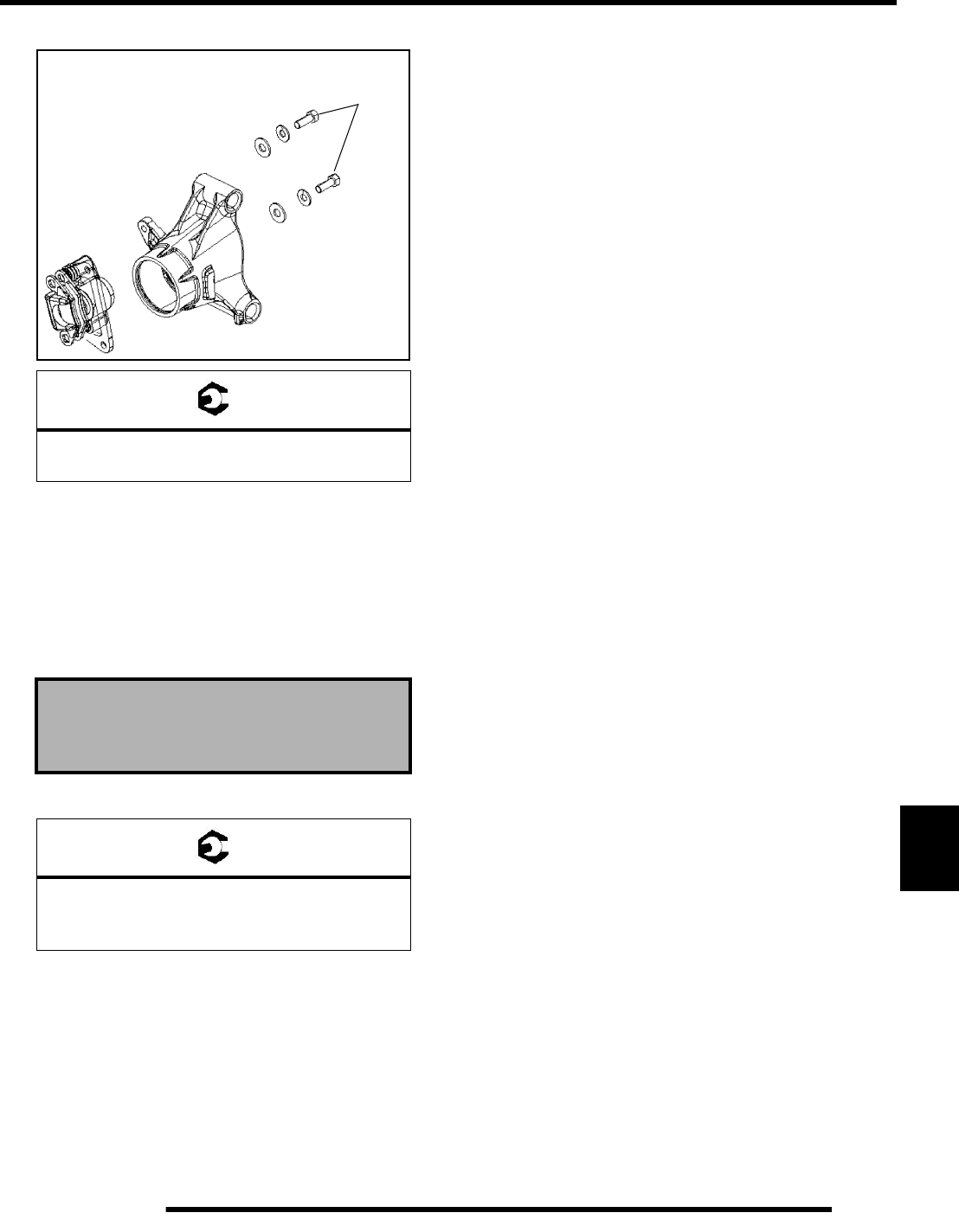
9.17
BRAKES
9
3. Install caliper and torque mounting bolts to specification.
4. Slowly pump the brake pedal until pressure has been built
up. Maintain at least 1/2, (12.7 mm) of brake fluid in the
reservoir to prevent air from entering the brake system.
5. Install the adjustment set screw and turn clockwise until the
stationary pad contacts the disc, then back off 1/2 turn.
6. Verify fluid level in reservoir is up to the MAX line inside
reservoir and install reservoir cap.
7. Install wheel and torque wheel nuts to specification.
Brake Burnishing Procedure
It is required that a burnishing procedure be performed after
installation of new brake pads to extend service life and reduce
noise.
Start machine and slowly increase speed to 30 mph. Gradually
apply brakes to stop machine. Allow pads and disc to cool
sufficiently during the procedure. Do not allow pads or disc to
become hot or warping may result. Repeat this procedure 10
times.
= T
Rear Caliper Mount Bolt Torque:
18 ft. lbs. (24 Nm)
Master Cylinder Fluid
Up to MAX line inside reservoir
= T
Wheel Nuts:
Steel Wheels: 35 ft. lbs. (47 Nm)
Aluminum Wheels: 30 ft. lbs. + 90° (1/4 turn)
18 ft. lbs.
(24 Nm)

9.18
BRAKES
REAR CALIPER SERVICE
Caliper Exploded View
Caliper Removal
1. Elevate and safely support the rear of the vehicle.
2. Remove the (4) wheel nuts and rear wheel.
3. Clean caliper area before removal.
4. Place a container below the caliper to catch the brake fluid
when removing the line. Remove brake line from caliper.
5. Loosen the brake pad adjustment set screw to allow brake
pad removal after the caliper is removed.
6. Remove the two caliper mounting bolts and remove the
caliper.
A. Brake Pad
B. Mount Bracket
C. Piston
D. Caliper Assy.
E. Square Ring (thick)
F. Square Ring (thin)
G. Boot, Pin Bushing
H. Boot, Pin Seal
I. Bleeder Screw
K. Set Screw
A
B
C
D
EF
G
H
I
K
Apply Polaris DOT 4 Brake Fluid
to Component
Apply Polaris All Purpose
Grease
47 in. lbs.
(5.3 Nm)
CAUTION
Use care when supporting vehicle so that it does not
tip or fall. Severe injury may occur.
Remove
Brake Line
Remove
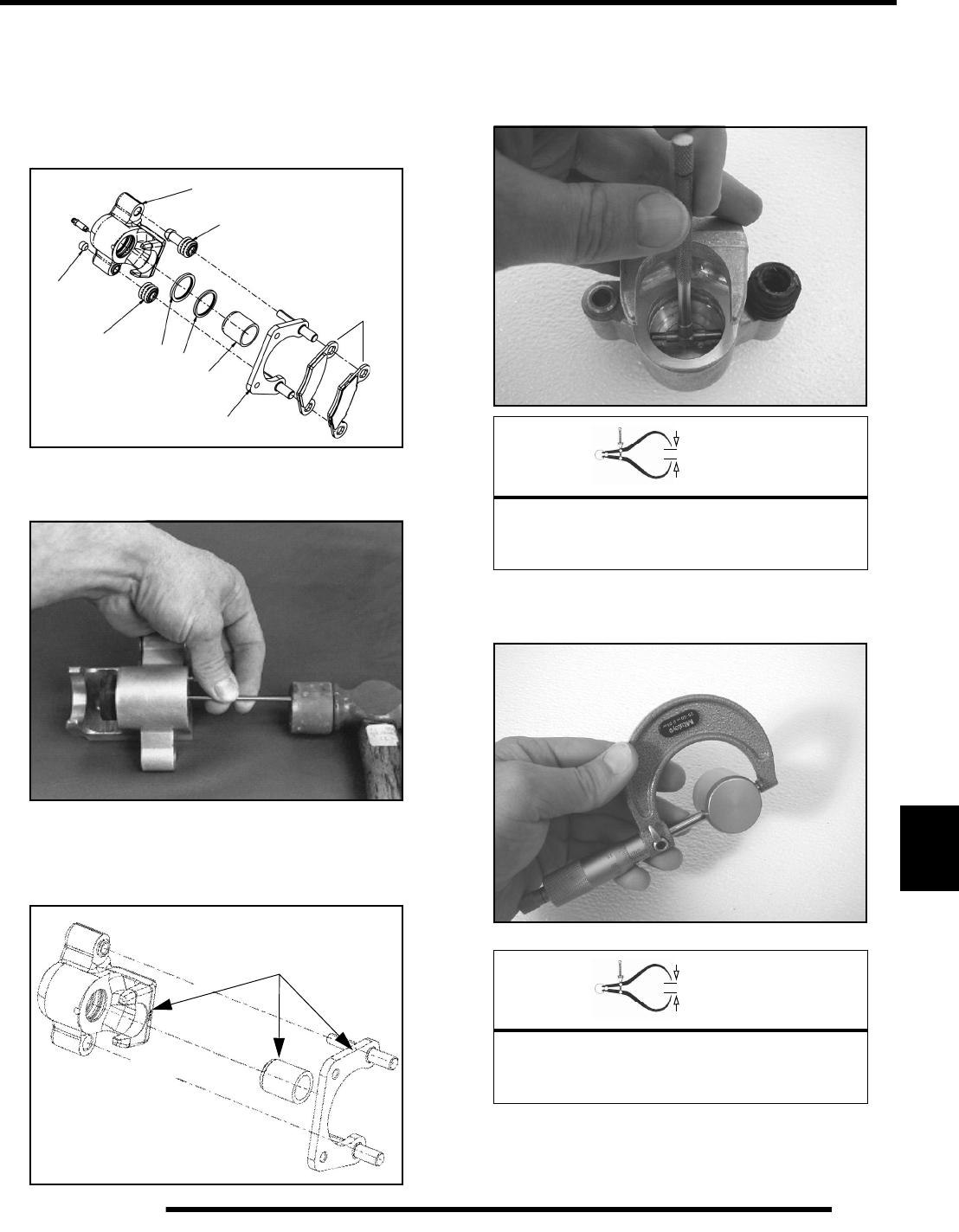
9.19
BRAKES
9
Caliper Disassembly
1. Remove brake pad adjustment set screw (K).
2. Push upper pad retainer pin inward and slip brake pads past
the edge and remove from the caliper.
3. Remove mounting bracket (B) and dust boots (G) and (H).
4. Using a hammer and a small punch, remove the piston (C)
from the caliper body (D). Remove the square O-rings (E)
and (F) from the caliper body (D).
5. Clean the caliper body, piston, and retaining bracket with
brake cleaner or alcohol.
NOTE: Be sure to clean seal grooves in caliper
body.
Caliper Inspection
1. Inspect caliper body for nicks, scratches or wear. Measure
bore size and compare to specifications. Replace if damage
is evident or if worn beyond service limit.
2. Inspect piston for nicks, scratches, wear or damage.
Measure diameter and replace if damaged or worn beyond
service limit.
3. Inspect the brake disc and pads as outlined in this chapter.
H
G
C
K
D
B
Pads
F
E
Clean Components
= In. / mm.
Rear Caliper Piston Bore I.D.:
Standard: 1.505” (38.23 mm)
Service Limit: 1.507” (38.28 mm)
= In. / mm.
Rear Caliper Piston O.D.:
Standard: 1.500” (38.10 mm)
Service Limit: 1.498” (38.05 mm)

9.20
BRAKES
Caliper Assembly
1. Install new caliper seals (A) in the caliper body (B). Be
sure groove is clean and free of residue or brakes may drag
upon assembly.
2. Coat piston with clean Polaris DOT 4 Brake Fluid (PN
2872189). Install piston (D) with a twisting motion while
pushing inward. Piston should slide in and out of bore
smoothly with light resistance.
3. Lubricate the mounting bracket pins with Polaris Premium
All Season Grease (PN 2871423), and install the rubber
dust seal boots.
4. Compress the mounting bracket and make sure the dust
seals are fully seated. Install the brake pads. Clean the disc
and pads with brake parts cleaner or denatured alcohol to
remove any dirt, oil or grease.
Caliper Installation
1. Install the rear caliper with the mounting bolts. Torque
mounting bolts to specification.
2. Install brake line banjo bolt and torque to specification.
3. Install the pad adjustment screw and turn until stationary
pad contacts disc, then back off 1/2 turn.
4. Follow bleeding procedure outlined earlier in this chapter.
5. Install wheel and torque wheel nuts to specification.
NOTE: If new pads are installed, refer to “REAR
BRAKE PADS - Brake Burnishing Procedure”.
Polaris Premium All Season Grease
(PN 2871423)
A
B
D
= T
Rear Caliper Mount Bolt Torque:
18 ft. lbs. (24 Nm)
= T
Wheel Nuts:
Steel Wheels: 35 ft. lbs. (47 Nm)
Aluminum Wheels: 30 ft. lbs. + 90° (1/4 turn)
18 ft. lbs.
(24 Nm)
15 ft. lbs.
(21 Nm)

9.21
BRAKES
9
REAR BRAKE DISC
Disc Inspection
1. Visually inspect disc for scoring, scratches, or gouges.
Replace the disc if any deep scratches are evident.
2. Use a 0-1” micrometer and measure the disc thickness at
eight different points around the pad contact surface.
Replace disc if worn beyond service limit.
3. Mount a dial indicator and measure disc runout. Slowly
rotate the disc and read total runout on the dial indicator.
Replace the disc if runout exceeds specifications.
Disc Replacement
1. Remove rear brake caliper (see “REAR CALIPER
SERVICE”).
2. Remove wheel hub cotter pin, castle nut and washers.
3. Remove the hub assembly from the vehicle and remove the
(4) bolts retaining the disc to the hub.
4. Clean the wheel hub mating surface and install new disc on
wheel hub.
5. Install new bolts and torque to 28 ft. lbs. (38 Nm).
6. Install wheel hub assembly, washers, and castle nut. Torque
castle nut to 80 ft. lbs. (108 Nm) and install a new cotter pin.
7. Install rear caliper (see “REAR CALIPER SERVICE”).
Follow bleeding procedure outlined earlier in this chapter.
8. Field test unit for proper braking action before putting into
service. Inspect for fluid leaks and firm brakes. Make sure
the brake is not dragging when pedal is released. If the brake
drags, re-check assembly and installation.
Brake Disc Thickness
New: .188” (4.78 mm)
Service Limit: .170” (4.32 mm)
Brake Disc Thickness Variance
Service Limit .002” (.051 mm)
difference between measurements
Brake Disc Runout
Service Limit .010” (.254 mm)
Measure
Thickness
Front
View
Side
View
CAUTION
Always use new brake disc mounting bolts. The
bolts have a pre-applied locking agent which is
destroyed upon removal.
Cotter
Pin
Washers
Nut
(4) Bolts
28 ft. lbs.
(38 Nm)

9.22
BRAKES
TROUBLESHOOTING
Brakes Squeal / Poor Brake Performance
• Air in system
• Water in system (brake fluid contaminated)
• Caliper or disc misaligned
• Caliper dirty or damaged
• Brake line damaged or lining ruptured
• Worn disc and/or friction pads
• Incorrectly adjusted stationary pad
• Worn or damaged master cylinder or components
• Damaged break pad noise insulator
• Brake pads dragging
• Brake caliper dragging
Pedal Vibration
• Disc damaged
• Disc worn (runout or thickness variance exceeds
service limit)
Caliper Overheats (Brakes Drag)
• Compensating port plugged
• Pad clearance set incorrectly
• Brake pedal binding or unable to return fully
• Residue build up under caliper seals
• Operator riding brakes
Brakes Lock
• Alignment of caliper to disc
• Caliper pistons sticking
• Improper assembly of brake system components
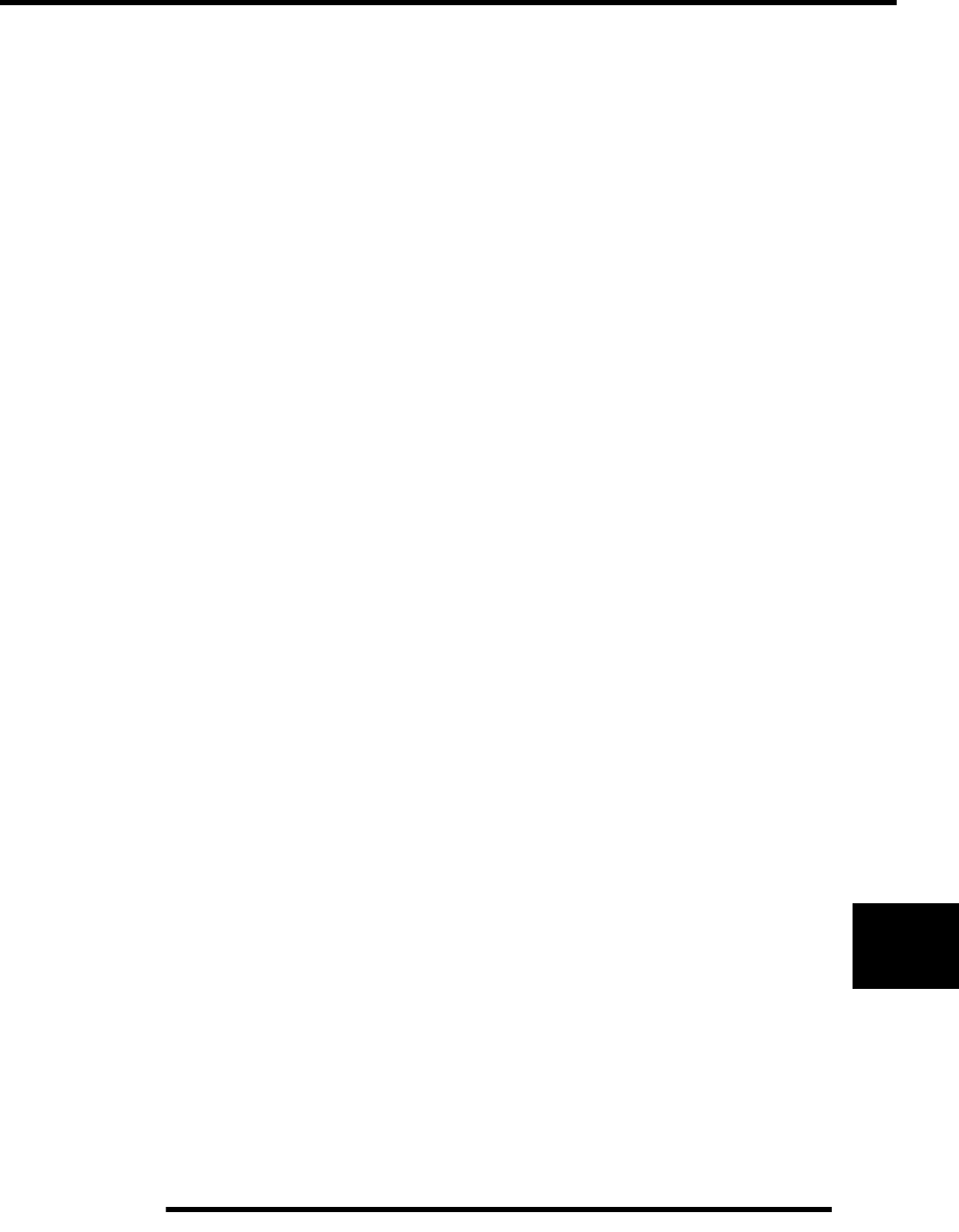
ELECTRICAL
10.1
CHAPTER 10
ELECTRICAL
10
GENERAL INFORMATION . . . . . . . . . . . . . . . . . . . . . . . . . . . . . . . . . . . . . . . . . . . . . . . 10.3
SPECIAL TOOLS . . . . . . . . . . . . . . . . . . . . . . . . . . . . . . . . . . . . . . . . . . . . . . . . . . . . . . 10.3
ELECTRICAL SERVICE NOTES . . . . . . . . . . . . . . . . . . . . . . . . . . . . . . . . . . . . . . . . . . 10.3
UNDER-DASH COMPONENTS . . . . . . . . . . . . . . . . . . . . . . . . . . . . . . . . . . . . . . . . . . . 10.3
SWITCHES / CONTROLS. . . . . . . . . . . . . . . . . . . . . . . . . . . . . . . . . . . . . . . . . . . . . . . . 10.3
BRAKE LIGHT SWITCH. . . . . . . . . . . . . . . . . . . . . . . . . . . . . . . . . . . . . . . . . . . . . . . . . 10.3
HEADLAMP SWITCH. . . . . . . . . . . . . . . . . . . . . . . . . . . . . . . . . . . . . . . . . . . . . . . . . . . 10.4
IGNITION KEY SWITCH. . . . . . . . . . . . . . . . . . . . . . . . . . . . . . . . . . . . . . . . . . . . . . . . . 10.4
AWD / 2WD / TURF SWITCH. . . . . . . . . . . . . . . . . . . . . . . . . . . . . . . . . . . . . . . . . . . . . 10.5
BLACKOUT SWITCH . . . . . . . . . . . . . . . . . . . . . . . . . . . . . . . . . . . . . . . . . . . . . . . . . . . 10.5
I.R. LIGHT SWITCH . . . . . . . . . . . . . . . . . . . . . . . . . . . . . . . . . . . . . . . . . . . . . . . . . . . . 10.6
WINCH SWITCH. . . . . . . . . . . . . . . . . . . . . . . . . . . . . . . . . . . . . . . . . . . . . . . . . . . . . . . 10.6
TRANSMISSION (GEAR POSITION) SWITCH . . . . . . . . . . . . . . . . . . . . . . . . . . . . . . . 10.7
VEHICLE SPEED SENSOR . . . . . . . . . . . . . . . . . . . . . . . . . . . . . . . . . . . . . . . . . . . . . . 10.7
SPEED SENSOR LOCATION . . . . . . . . . . . . . . . . . . . . . . . . . . . . . . . . . . . . . . . . . . . . 10.7
SPEED SENSOR TESTING. . . . . . . . . . . . . . . . . . . . . . . . . . . . . . . . . . . . . . . . . . . . . . 10.7
REAR DIFFERENTIAL SOLENOID. . . . . . . . . . . . . . . . . . . . . . . . . . . . . . . . . . . . . . . . . 10.8
DIFFERENTIAL SOLENOID OVERVIEW . . . . . . . . . . . . . . . . . . . . . . . . . . . . . . . . . . . 10.8
DIFFERENTIAL SOLENOID CIRCUIT OPERATION. . . . . . . . . . . . . . . . . . . . . . . . . . . 10.8
INSTRUMENT CLUSTER . . . . . . . . . . . . . . . . . . . . . . . . . . . . . . . . . . . . . . . . . . . . . . . . 10.9
OVERVIEW. . . . . . . . . . . . . . . . . . . . . . . . . . . . . . . . . . . . . . . . . . . . . . . . . . . . . . . . . . . 10.9
RIDER INFORMATION DISPLAY . . . . . . . . . . . . . . . . . . . . . . . . . . . . . . . . . . . . . . . . 10.10
INFORMATION DISPLAY AREA . . . . . . . . . . . . . . . . . . . . . . . . . . . . . . . . . . . . . . . . . 10.10
DIAGNOSTIC MODE . . . . . . . . . . . . . . . . . . . . . . . . . . . . . . . . . . . . . . . . . . . . . . . . . . 10.13
INSTRUMENT CLUSTER PINOUTS . . . . . . . . . . . . . . . . . . . . . . . . . . . . . . . . . . . . . . 10.14
INSTRUMENT CLUSTER REMOVAL . . . . . . . . . . . . . . . . . . . . . . . . . . . . . . . . . . . . . 10.14
INSTRUMENT CLUSTER INSTALLATION . . . . . . . . . . . . . . . . . . . . . . . . . . . . . . . . . 10.14
ALL WHEEL DRIVE COIL . . . . . . . . . . . . . . . . . . . . . . . . . . . . . . . . . . . . . . . . . . . . . . . 10.15
OPERATION OVERVIEW . . . . . . . . . . . . . . . . . . . . . . . . . . . . . . . . . . . . . . . . . . . . . . 10.15
DIAGNOSING SYSTEM FAILURES. . . . . . . . . . . . . . . . . . . . . . . . . . . . . . . . . . . . . . . 10.15
HEAD LIGHTS. . . . . . . . . . . . . . . . . . . . . . . . . . . . . . . . . . . . . . . . . . . . . . . . . . . . . . . . 10.15
HEADLIGHT ADJUSTMENT . . . . . . . . . . . . . . . . . . . . . . . . . . . . . . . . . . . . . . . . . . . . 10.15
HEADLAMP BULB REPLACEMENT . . . . . . . . . . . . . . . . . . . . . . . . . . . . . . . . . . . . . . 10.16
HEADLAMP HOUSING REMOVAL . . . . . . . . . . . . . . . . . . . . . . . . . . . . . . . . . . . . . . . 10.16
HEADLAMP HOUSING INSTALLATION . . . . . . . . . . . . . . . . . . . . . . . . . . . . . . . . . . . 10.16
TAIL / BRAKE LIGHTS . . . . . . . . . . . . . . . . . . . . . . . . . . . . . . . . . . . . . . . . . . . . . . . . . 10.17
BULB REPLACEMENT. . . . . . . . . . . . . . . . . . . . . . . . . . . . . . . . . . . . . . . . . . . . . . . . . 10.17
COOLING SYSTEM SCHEMATIC . . . . . . . . . . . . . . . . . . . . . . . . . . . . . . . . . . . . . . . . 10.18
COOLING SYSTEM BREAK-OUT DIAGRAM . . . . . . . . . . . . . . . . . . . . . . . . . . . . . . . 10.18
FAN CONTROL CIRCUIT OPERATION / TESTING . . . . . . . . . . . . . . . . . . . . . . . . . . 10.19
FAN CONTROL CIRCUIT BYPASS TEST. . . . . . . . . . . . . . . . . . . . . . . . . . . . . . . . . . 10.19
COOLANT TEMPERATURE SENSOR . . . . . . . . . . . . . . . . . . . . . . . . . . . . . . . . . . . . 10.19
EFI DIAGNOSTICS . . . . . . . . . . . . . . . . . . . . . . . . . . . . . . . . . . . . . . . . . . . . . . . . . . . . 10.19
EFI COMPONENT TESTING . . . . . . . . . . . . . . . . . . . . . . . . . . . . . . . . . . . . . . . . . . . . 10.19
FUEL SENDER . . . . . . . . . . . . . . . . . . . . . . . . . . . . . . . . . . . . . . . . . . . . . . . . . . . . . . . 10.19
TESTING . . . . . . . . . . . . . . . . . . . . . . . . . . . . . . . . . . . . . . . . . . . . . . . . . . . . . . . . . . . 10.19
FUSE BOX: FUSES / RELAYS / CIRCUIT BREAKER . . . . . . . . . . . . . . . . . . . . . . . . . 10.20
OVERVIEW / OPERATION . . . . . . . . . . . . . . . . . . . . . . . . . . . . . . . . . . . . . . . . . . . . . 10.20
RELAY OPERATION . . . . . . . . . . . . . . . . . . . . . . . . . . . . . . . . . . . . . . . . . . . . . . . . . . 10.21
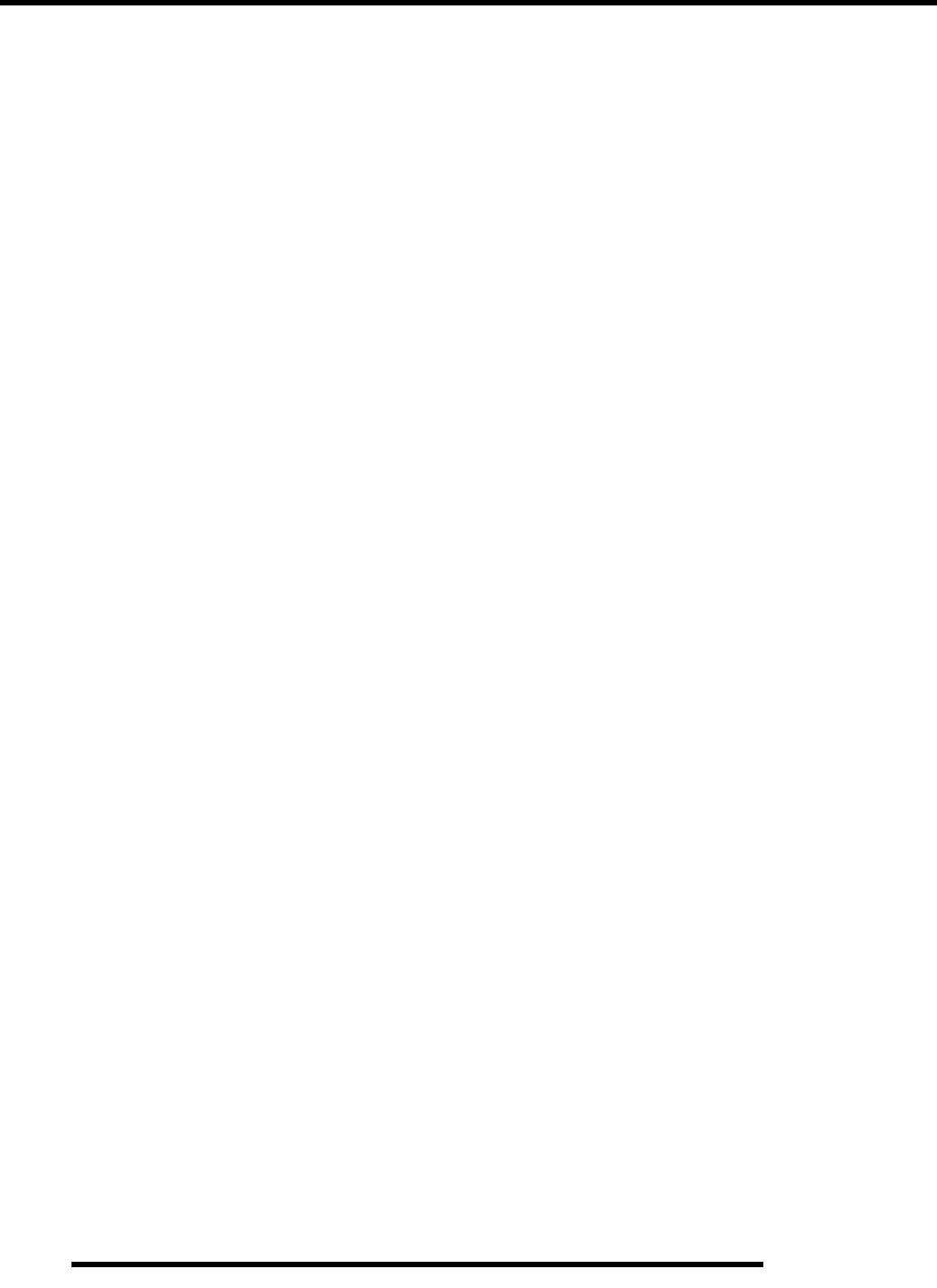
10.2
ELECTRICAL
CHARGING SYSTEM . . . . . . . . . . . . . . . . . . . . . . . . . . . . . . . . . . . . . . . . . . . . . . . . . . 10.22
CURRENT DRAW - KEY OFF . . . . . . . . . . . . . . . . . . . . . . . . . . . . . . . . . . . . . . . . . . . 10.22
CHARGING SYSTEM “BREAK EVEN” TEST . . . . . . . . . . . . . . . . . . . . . . . . . . . . . . . 10.22
CHARGING SYSTEM ALTERNATOR TESTS. . . . . . . . . . . . . . . . . . . . . . . . . . . . . . . 10.23
REGULATOR / RECTIFIER TEST . . . . . . . . . . . . . . . . . . . . . . . . . . . . . . . . . . . . . . . . 10.24
CHARGING SYSTEM TESTING FLOW CHART . . . . . . . . . . . . . . . . . . . . . . . . . . . . . 10.25
BATTERY SERVICE . . . . . . . . . . . . . . . . . . . . . . . . . . . . . . . . . . . . . . . . . . . . . . . . . . . 10.26
BATTERY SPECIFICATIONS . . . . . . . . . . . . . . . . . . . . . . . . . . . . . . . . . . . . . . . . . . . 10.26
GENERAL BATTERY INFORMATION. . . . . . . . . . . . . . . . . . . . . . . . . . . . . . . . . . . . . 10.26
BATTERY REMOVAL / INSTALLATION . . . . . . . . . . . . . . . . . . . . . . . . . . . . . . . . . . . 10.26
BATTERY OFF SEASON STORAGE . . . . . . . . . . . . . . . . . . . . . . . . . . . . . . . . . . . . . 10.26
BATTERY TESTING. . . . . . . . . . . . . . . . . . . . . . . . . . . . . . . . . . . . . . . . . . . . . . . . . . . 10.26
OCV - OPEN CIRCUIT VOLTAGE TEST. . . . . . . . . . . . . . . . . . . . . . . . . . . . . . . . . . . 10.27
LOAD TEST . . . . . . . . . . . . . . . . . . . . . . . . . . . . . . . . . . . . . . . . . . . . . . . . . . . . . . . . . 10.27
BATTERY CONDUCTANCE ANALYZER . . . . . . . . . . . . . . . . . . . . . . . . . . . . . . . . . . 10.27
CHARGING PROCEDURE . . . . . . . . . . . . . . . . . . . . . . . . . . . . . . . . . . . . . . . . . . . . . 10.28
STARTING SYSTEM. . . . . . . . . . . . . . . . . . . . . . . . . . . . . . . . . . . . . . . . . . . . . . . . . . . 10.28
TROUBLESHOOTING . . . . . . . . . . . . . . . . . . . . . . . . . . . . . . . . . . . . . . . . . . . . . . . . . 10.28
VOLTAGE DROP TEST . . . . . . . . . . . . . . . . . . . . . . . . . . . . . . . . . . . . . . . . . . . . . . . . 10.29
STARTER MOTOR REMOVAL / DISASSEMBLY . . . . . . . . . . . . . . . . . . . . . . . . . . . . 10.29
BRUSH INSPECTION / REPLACEMENT . . . . . . . . . . . . . . . . . . . . . . . . . . . . . . . . . . 10.29
ARMATURE TESTING. . . . . . . . . . . . . . . . . . . . . . . . . . . . . . . . . . . . . . . . . . . . . . . . . 10.30
STARTER REASSEMBLY / INSTALLATION . . . . . . . . . . . . . . . . . . . . . . . . . . . . . . . . 10.31
STARTER DRIVE. . . . . . . . . . . . . . . . . . . . . . . . . . . . . . . . . . . . . . . . . . . . . . . . . . . . . 10.32
STARTER SOLENOID BENCH TEST . . . . . . . . . . . . . . . . . . . . . . . . . . . . . . . . . . . . . 10.32
STARTER SOLENOID OPERATION . . . . . . . . . . . . . . . . . . . . . . . . . . . . . . . . . . . . . . 10.32
STARTER EXPLODED VIEW . . . . . . . . . . . . . . . . . . . . . . . . . . . . . . . . . . . . . . . . . . . 10.33
STARTING SYSTEM TESTING FLOW CHART . . . . . . . . . . . . . . . . . . . . . . . . . . . . . . 10.34

10.3
ELECTRICAL
10
GENERAL INFORMATION
Special Tools
Electrical Service Notes
Keep the following notes in mind when diagnosing an electrical
problem:
• Refer to wiring diagram for stator and electrical
component resistance specifications.
• When measuring resistance of a component that has a
resistance value under 10 Ohms, remember to subtract
meter lead resistance from the reading. Connect the
leads together and record the resistance. The resistance
of the component is equal to tested value minus the lead
resistance.
• Become familiar with the operation of your meter. Be
sure leads are in the proper jack for the test being
performed (i.e. 10A jack for current readings). Refer to
the Owner’s Manual included with your meter for more
information.
• Voltage, amperage, and resistance values included in
this manual are obtained with a Fluke™ 77 Digital
Multimeter (PV-43568). This meter is used when
diagnosing electrical problems. Readings obtained with
other meters may differ.
• Pay attention to the prefix on the multimeter reading (K,
M, etc.) and the position of the decimal point.
• For resistance readings, isolate the component to be
tested. Disconnect it from the wiring harness or power
supply.
Under-Dash Components
The following switches and components can be accessed
underneath the instrument / dash panel:
• Speedometer
• Speedometer Mode Switch
• Digital Wrench Diagnostic Connector
• Digital Wrench / ECU Reflash 9 Vdc Battery Plug
• AWD Switch
• Headlamp Switch
• 12 Vdc Accessory Power Point
• Ignition Switch
• Fuse / Relay Panel
SWITCHES / CONTROLS
Brake Light Switch
1. The brake switch can be accessed by removing the driver’s
seat. The switch is located under the outer PVT cover
along the lower frame. The brake pressure switch is
installed into the cross fitting block.
2. Disconnect wire harness from switch and connect an
ohmmeter across switch contacts. The reading should be
infinite (OL).
3. Apply the brake and check for continuity. If there is no
continuity or if resistance is greater than .5 ohms, clean the
switch terminals. Re-test and replace switch if necessary.
Part Number Tool Description
PV-43568 Fluke™ 77 Digital Multimeter
PV-43526 Connector Test Kit
2870630 Timing Light
PU-50338 Battery Hydrometer
2460761 Hall Effect Sensor Probe Harness
2871745 Static Timing Light Harness
- Digital Wrench™ (see Chapter 4)
Brake Switch
PVT Cover

10.4
ELECTRICAL
Headlamp Switch
4. Disconnect the headlamp switch harness by depressing the
connector locks and pulling on the connector. Do not pull
on the wiring.
5. Test between the 3 sets of outputs (OFF / LOW / HIGH).
If any of the tests fail, replace headlamp switch assembly.
• Move the switch to HIGH. There should be continuity
between switch pins 2 and 3; 5 and 6.
• Move the switch to LOW. There should be continuity
between switch pins 2 and 3; 4 and 5.
• Move the switch to OFF. There should be continuity
between switch pins 1 and 2; 4 and 5.
NOTE: Pins 7 and 8 provide power and ground to
light the switch lamp.
Ignition Key Switch
1. Disconnect the key switch harness by lifting the connector
lock and pulling on the connector. Do not pull on the
wiring.
2. Test between the 3 sets of outputs (OFF / ON / START). If
any of the tests fail, replace ignition switch assembly.
• Turn the ignition key to ON. There should be continuity
between switch pins C and D; A and F.
• Turn the ignition key to START. There should be
continuity between switch pins A and B; C and D.

10.5
ELECTRICAL
10
AWD / 2WD / TURF Switch
1. Disconnect the AWD / 2WD / TURF switch harness by
depressing the connector locks and pulling on the
connector. Do not pull on the wiring.
2. Test between the 3 sets of outputs (AWD / 2WD / TURF).
If any of the tests fail, replace the switch assembly.
• Move the switch to AWD. There should be continuity
between switch pins 2 and 3.
• Move the switch to 2WD. There should be no
continuity between any pins.
• Move the switch to TURF. There should be continuity
between switch pins 1 and 2.
Blackout Switch
1. Disconnect the blackout switch harness by depressing the
connector locks and pulling on the connector. Do not pull
on the wiring.
2. Test between the 2 sets of outputs (OFF / ON). If any of the
tests fail, replace the blackout switch assembly.
• Move the switch to ON (POS 1). There should be
continuity between switch pins 2 and 3.
• Move the switch to OFF (POS 3). There should be
continuity between switch pins 1 and 2.
NOTE: Pins 7 and 8 provide power and ground to
light the switch lamp.
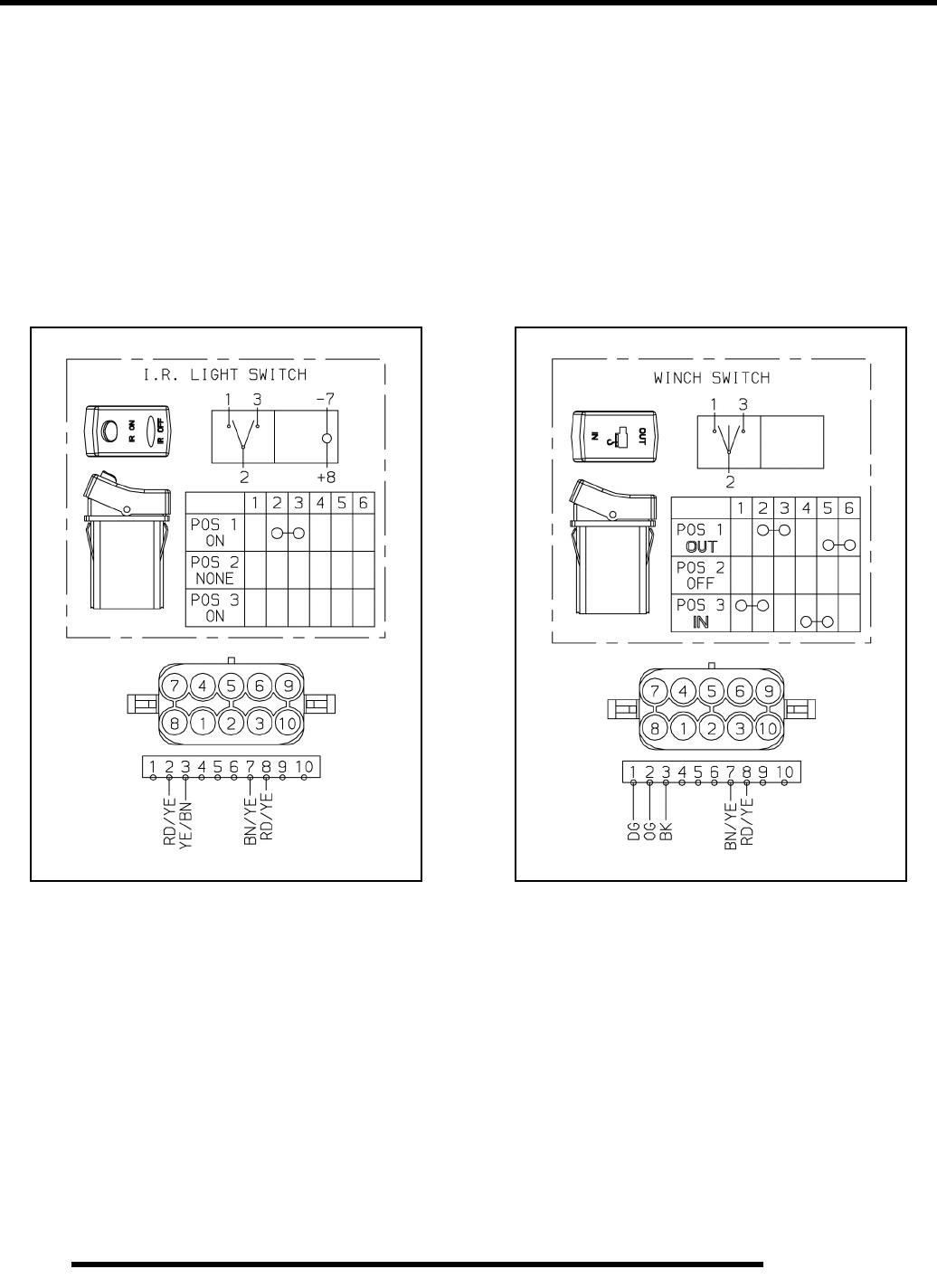
10.6
ELECTRICAL
I.R. Light Switch
1. Disconnect the I.R. light switch harness by depressing the
connector locks and pulling on the connector. Do not pull
on the wiring.
2. Test between the 2 sets of outputs (OFF / ON). If any of the
tests fail, replace the light switch assembly.
• Move the switch to ON (POS 1). There should be
continuity between switch pins 2 and 3.
• Move the switch to OFF (POS 3). There should be no
continuity between any pins.
NOTE: Pins 7 and 8 provide power and ground to
light the switch lamp.
Winch Switch
1. Disconnect the winch switch harness by depressing the
connector locks and pulling on the connector. Do not pull
on the wiring.
2. Test between the 2 sets of outputs (OUT / IN). If any of the
tests fail, replace the winch switch assembly.
• Move the switch to OUT. There should be continuity
between switch pins 2 and 3.
• Move the switch to IN. There should be continuity
between switch pins 1 and 2.

10.7
ELECTRICAL
10
Transmission (Gear Position) Switch
1. Disconnect the transmission switch harness by lifting the
connector lock and pulling on the connector. Do not pull
on the wiring.
2. Test the transmission switch continuity readings for each
gear position and compare to the specification table below.
VEHICLE SPEED SENSOR
Speed Sensor Location
The speed sensor is located in the transmission transfer case
cover and can be accessed through the rear LH wheel well area.
Speed Sensor Testing
Special Tools Required:
Static Timing Light Harness (PN 2871745)
Hall Sensor Probe Harness (PN 2460761)
1. Disconnect the 3 wire harness from the speed sensor and
remove the sensor from the transmission.
2. Connect the wires from the Static Timing Light Harness to
the sensor 3 pin connector using the Hall Sensor Probe
Harness (PN 2460761).
3. Pass a screwdriver back and forth in front of the sensor tip.
4. Be sure connections are good and 9V battery is in good
condition. If the light flashes, the sensor is good.
Gear Position Resistance Value
when measured at
terminals A and B
HIGH 620
LOW 300
NEU 160
REV 75
PARK 24
Speed Sensor

10.8
ELECTRICAL
REAR DIFFERENTIAL SOLENOID
Differential Solenoid Overview
The differential solenoid is located on the rear gear case. The
solenoid actuates an engagement dog, which locks and unlocks
the rear differential. Refer to Chapter 7 for more information on
the rear differential mechanical operation.
Differential Solenoid Circuit Operation
The Rear Diff Solenoid Relay is attached to the rear plastic LH
panel divider behind the driver’s seat.
When the switch is pushed to activate “TURF”, a ground signal
is provided to the ECU from the AWD / 2WD / TURF Switch.
Depending on engine speed and gear position criteria, the ECU
energizes the Rear Diff Solenoid Relay allowing it to enable the
differential solenoid.
If the rear differential fails to switch from operational modes:
• Check the solenoid and relay connectors. Look for
loose wires or bad connections.
• Check for power from the relay connector, to ensure the
solenoid has power to be activated.
• Check the AWD / 2WD / TURF Switch wires for loose
connections.
• Remove solenoid from rear differential and ensure the
solenoid plunger is actuating.
CAUTION
Do not power the solenoid with 12 Volts for more
than 1 second, or damage may occur to solenoid.

10.9
ELECTRICAL
10
INSTRUMENT CLUSTER
Overview
The instrument cluster displays critical vehicle information to the user. Reference the following page for display functions and
descriptions.
NOTE: Some features are not applicable to all models.
IMPORTANT: The use of a high pressure washer may damage the instrument cluster. Wash the vehicle by hand
or with a garden hose using mild soap. Certain products, including insect repellents and chemicals, will damage
the instrument cluster lens. Do not use alcohol to clean the instrument cluster. Do not allow insect sprays to
contact the lens. Immediately clean off any gasoline that splashes on the instrument cluster.

10.10
ELECTRICAL
Rider Information Display
The rider information display is located in the instrument
cluster. All segments will light up for 1 second at start-up.
NOTE: If the instrument cluster fails to illuminate:
•A battery over-voltage may have occurred and
the instrument cluster may have shut off to
protect the electronic speedometer.
•The Blackout Switch may be turned on.
1. Vehicle Speed Display - Analog display of vehicle speed
in MPH or km/h.
2. Information Display Area - Odometer / Trip Meter /
Tachometer / Engine Temperature / Engine Hours /
Service Info / Clock - LCD display of the service hour
interval, total vehicle miles or km., total engine hours, a trip
meter, engine RPM and engine temperature.
3. MPH / KM/H Display - MPH is displayed when the
instrument cluster is in the Standard mode. KM/H is
displayed when the instrument cluster is in the Metric
mode.
4. High Beam Indicator LED icon illuminates whenever the
Headlamp switch is in the high beam position.
5. Fuel Level Indicator - LCD bar graph indicating current
fuel level. All segments will flash when the last segment is
cleared indicating a low fuel warning.
6. Clock - Displays current time in either 12-hour or 24-hour
formats.
7. Engine Temperature Indicator - LED icon illuminates
when the ECM determines the engine is overheating. The
indicators will initially flash to indicate the engine is
overheating. The indicators will stay lit and not flash if a
severe overheating condition exists.
8. Service Interval Indicator - Preset at the factory and
adjustable by the user, a flashing wrench symbol alerts the
operator that the preset service interval has been reached
and maintenance should be performed. The wrench icon
will flash for 10 seconds upon start-up once it reaches 0.
9. Check Engine MIL - Illuminated when the ECM has
detected a Diagnostic Trouble Code in the engine
management system.
10. AWD Indicator - Illuminated when the AWD / TURF
switch is in the AWD position.
11. TURF Indicator - Illuminated when the AWD / TURF
switch is in the TURF position.
12. Neutral Gear Indicator - LED icon illuminates when gear
selector is in the neutral (N) position.
13. Gear Position Indicator - Displays gear selector position.
H = High
L = Low
N = Neutral
R = Reverse
P = Park
-- = Gear Signal Error (shifter stuck between gears)
14. Power Steering System MIL - LED icon illuminates when
a fault has occurred with the power steering system. This
indicator illuminates when the key is turned to the ON
position and goes off when the engine is started.
15. Turn Signal / Hazard Lamp Indicator - LED icon
illuminates whenever the LH, RH or hazard lamps are
activated.
16. Helmet / Seat Belt Indicator - LED icon illuminates for
several seconds when the key is turned to the ON position.
The lamp is a reminder to the operator to ensure all riders
are wearing helmets and seat belts before operating the
vehicle.
Information Display Area
The LCD portion of the instrument cluster is the information
display area. Information displayed in this area includes:
odometer, trip meter, engine RPM, engine hours, service
interval, clock, engine Diagnostic Trouble Codes (DTCs) and
power steering DTCs.
Odometer
The odometer records and displays the total distance traveled by
the vehicle. The odometer can not be reset.
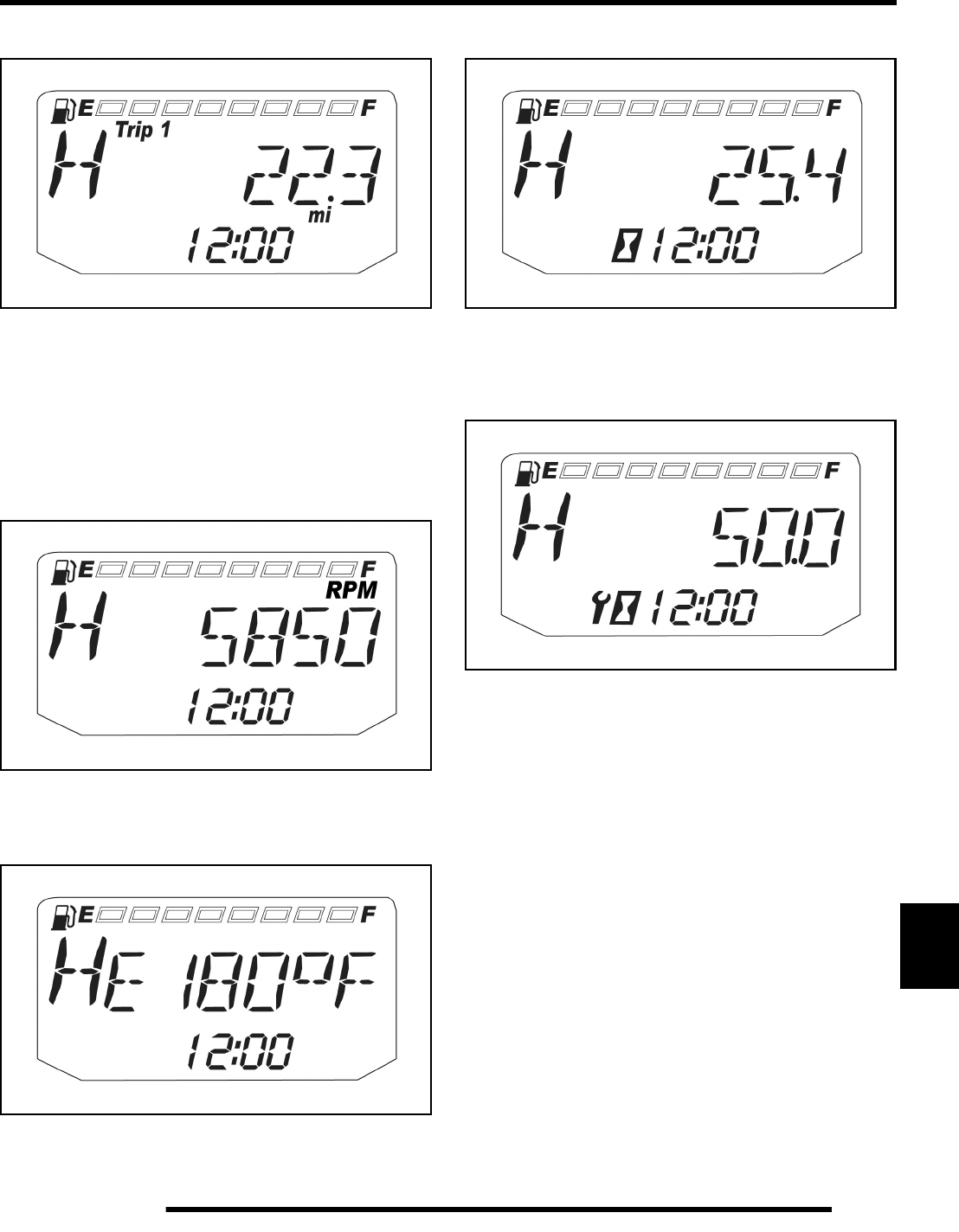
10.11
ELECTRICAL
10
Trip Meter
The trip meter records the miles traveled by the vehicle on each
trip. To reset the trip meter:
1. Toggle the MODE button to TRIP 1.
2. To reset to 0, push and hold the MODE button until the
distance display changes to 0.
Tachometer (RPM)
Engine RPM can be displayed digitally.
Engine Temperature
Engine temperature can be displayed in Fahrenheit or Celsius.
Refer to “Units of Measurement” to change the format.
Engine Hours
Engine hours are logged anytime the engine is running. Total
hours can not be reset.
Programmed Service Interval
The initial factory service interval setting is 50 hours. Each time
the engine is started, the engine hours are subtracted from the
service interval hours. When the service interval reaches 0, the
LCD wrench icon will flash for approximately 10 seconds each
time the engine is started.
To change the hour setting or reset the function, follow these
steps:
1. Toggle the MODE button until the wrench icon is
displayed in the information area.
2. Press and hold the MODE button until the information
display area begins to flash.
3. Toggle the MODE button to increase the service interval
hours in 5 hour increments to a maximum of 100 hours.
4. To turn off the service interval function, toggle the MODE
button until “OFF” is displayed.

10.12
ELECTRICAL
Clock
The clock displays the time in a 12-hour or 24-hour format.
Refer to “Units of Measurement” to change the format
(Standard 12-hour / Metric-24 hour). To set the clock, follow
these steps:
1. Toggle the MODE button until the odometer is displayed.
2. Press and hold the MODE button until the hour segment
flashes. Release the button
3. With the segment flashing, tap the MODE button to
advance to the desired setting.
4. Press and hold the MODE button until the next segment
flashes. Release the button.
5. Repeat steps 3-4 twice to set the 10 minute and 1 minute
segments. After completing the 1-minute segment, step 4
will save the new settings and exit the clock mode.
Units of Measurement
To change between Standard and Metric units of measurement,
follow these steps:
1. Turn the key to the OFF position.
2. Press and hold the MODE button while turning the key to
the ON position.
3. When the display flashes the distance setting, tap the
MODE button to advance to the desired setting.
4. Press and hold the MODE button to save the setting and
advance to the next display option.
5. Repeat the procedure to change remaining display settings.
Standard Display Metric Display
Distance Miles (MPH) Kilometers (KM/H)
Time 12-Hour Clock 24-Hour Clock
Temperature Fahrenheit Celsius
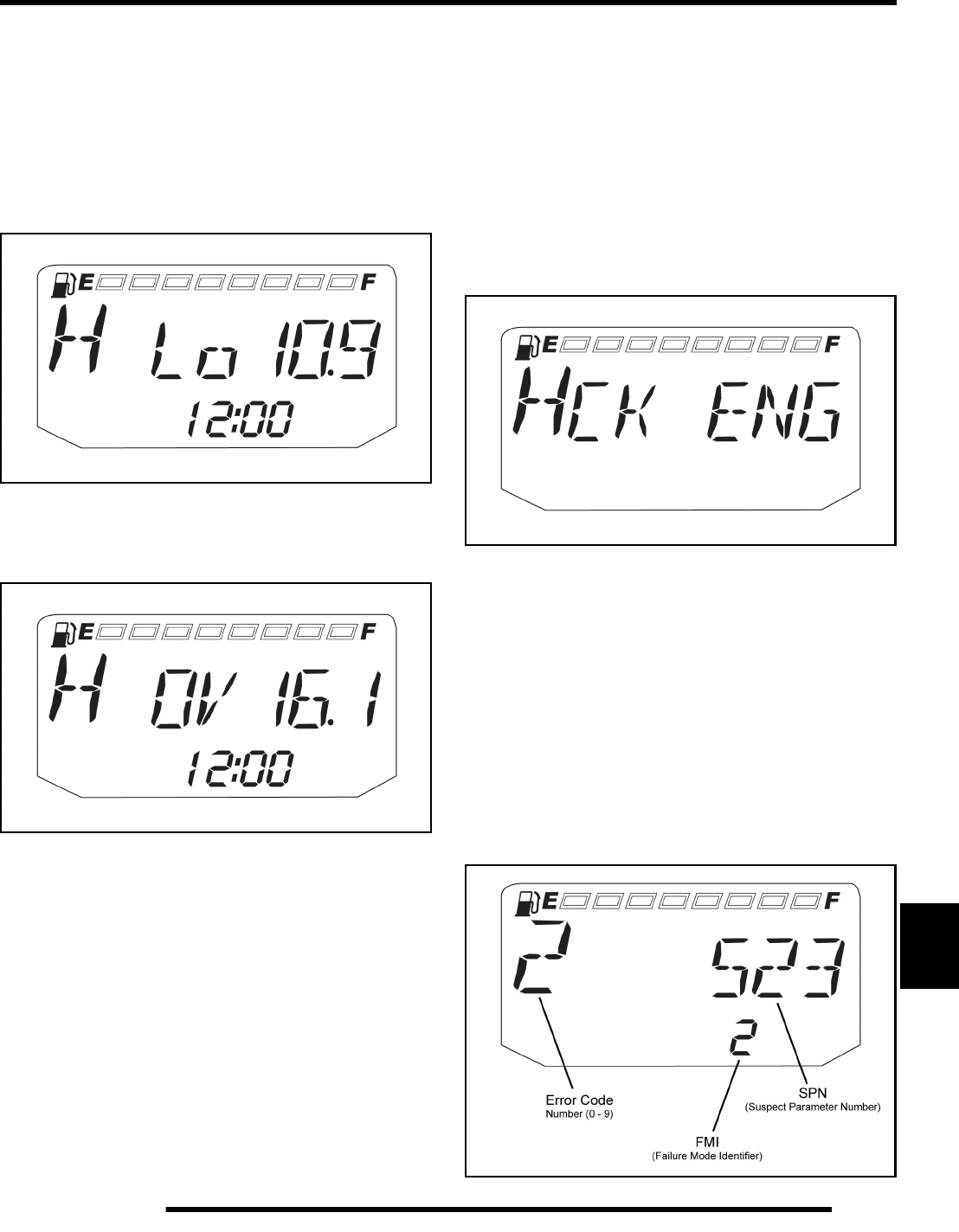
10.13
ELECTRICAL
10
Under / Over Voltage
This warning usually indicates that the vehicle is operating at an
RPM too low to keep the battery charged. It may also occur
when the engine is at idle and a high electrical load is applied
(lights, cooling fan or other accessories).
If battery voltage drops below 11 volts, a warning screen will
display “Lo” and provide the present battery voltage. If voltage
drops below 8.5 volts, LCD backlighting and icons will turn off.
If battery voltage rises above 16 volts, a warning screen will
display “OV” and provide the present battery voltage. If voltage
rises above 16.5 volts, LCD backlighting and icons will turn off.
Diagnostic Mode
The diagnostic mode is accessible only when the check engine
MIL has been activated.
Use the following procedure to display diagnostic trouble codes
that were activated during current ignition cycle causing the
MIL to illuminate. Diagnostic trouble codes will remain stored
in the gauge (even if MIL turns off) until the key is turned off.
1. If the trouble code(s) are not displayed, use the MODE
button to toggle until “CK ENG” displays on the
information display area.
2. Press and hold the MODE button to enter the diagnostics
code menu.
3. A set of three numbers will appear in the information area.
• The first number (located far left) can range from 0 to 9.
This number represents the total number of trouble code
present (example: 2 means there are 3 codes present).
• The second number (located top right) can be 2 to 6
digits in length. This number equates to the suspected
area of fault (SPN).
• The third number (located bottom right) can be 1 to 2
digits in length. This number equates to the fault mode
(FMI).

10.14
ELECTRICAL
4. Use the trouble code reference table in the EFI Chapter for
a description of each code.
5. If more than one code exists, press the MODE button to
advance to the next trouble code.
6. To exit the diagnostic mode, press and hold the MODE
button or turn the ignition key OFF once the codes are
recorded.
NOTE: If there is a diagnostic problem with the
power steering system, the power steering MIL will
illuminate and blink in place of the check engine MIL.
Instrument Cluster Pinouts
Instrument Cluster Removal
NOTE: Do not allow alcohol or petroleum products
to come in contact with the instrument cluster lens.
1. Disconnect the wire harness connector from the back side
of the instrument cluster.
2. Push the instrument cluster out from the back side of the
dash while securely holding the dash and rubber mount.
NOTE: Do not remove the rubber mount from the
dash panel. Only remove the rubber mount if
necessary. The bezel is a snap-on assembly and is a
serviceable part.
Instrument Cluster Installation
1. Spray a soap and water mixture onto the outer surface area
of the instrument cluster. This will help the instrument
cluster slide into the rubber mount more easily.
2. Be sure the rubber mount inside the dash is fully installed
and that the indexing key on the rubber mount is lined up
with the keyway in the dash.
3. Hold the dash securely and insert the instrument cluster into
the dash. Twist the instrument cluster gently in a clockwise
motion to properly seat the instrument cluster into the
rubber mount. Apply pressure on the bezel while pressing
down on the instrument cluster.
FUNCTION PIN
CAN High 1
CAN Low 2
Switched Power (Vdc) 3
Constant Power (Vdc) 4
Ground 5
Turn Signal Input, LH 6
Turn Signal Input, RH 7
High Beam Input 8
Fuel Level Sensor 11
Blackout Mode 12
Rubber Mount
Instrument Cluster
Bezel
Push Instrument
Cluster Outward Dash Panel
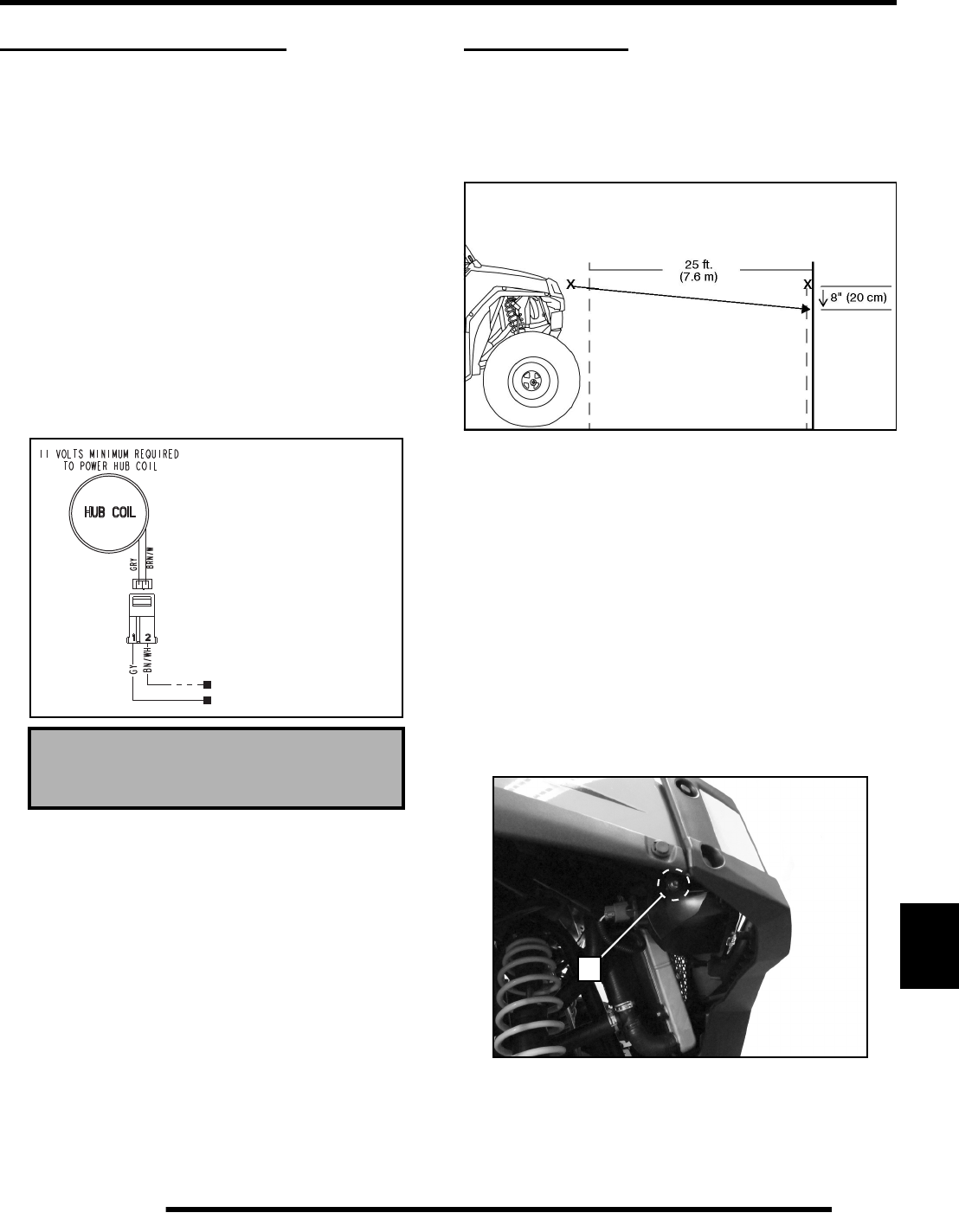
10.15
ELECTRICAL
10
ALL WHEEL DRIVE COIL
Operation Overview
• When the AWD switch is “ON”, 12 VDC power is
present at the hub coil.
• If the criteria is met, the instrument cluster provides a
ground path at pin #16 (brown/white wire). When this
occurs the AWD icon should display in the instrument
cluster.
• The AWD system must be grounded to operate.
Diagnosing System Failures
• Verify the AWD switch is functional and that a
minimum of 11 volts is present at the hub coil.
• Verify the AWD hub coil is functional. Test the AWD
hub coil using an ohm meter. See specifications below:
• Verify the wiring harness, wiring, connectors, connector
pins and grounds are undamaged, clean and connect
properly.
• Verify continuity of wire connections with a known
good volt/ohm meter.
IMPORTANT: Verify all wires and wiring connections
have been tested properly with a known good volt/
ohm meter before suspecting a component failure.
80% of all electrical issues are caused by bad/failed
connections and grounds.
HEAD LIGHTS
Headlight Adjustment
The headlight beam is adjustable.
1. Place the vehicle on a level surface with the headlight
approximately 25 ft. (7.6 m) from a wall.
2. Measure the distance from the floor to the center of the
headlight and make a mark on the wall at the same height.
3. With the machine in Park, start the engine and turn the
headlight switch to on.
4. The most intense part of the headlight beam should be
aimed 8 in. (20 cm) below the mark placed on the wall in
Step 2.
NOTE: Rider weight must be included in the seat
while performing this procedure.
5. Adjust the beam to the desired position by loosening the
adjustment screw (A) and moving the lamp to the
appropriate height.
AWD Hub Coil Resistance:
24 ± 5%
7HVW5HVLVWDQFH
5HDGLQJVVKRXOGEH
*<WR%1:+a2KPV
*<WR*URXQG1R&RQQHFWLRQ
A
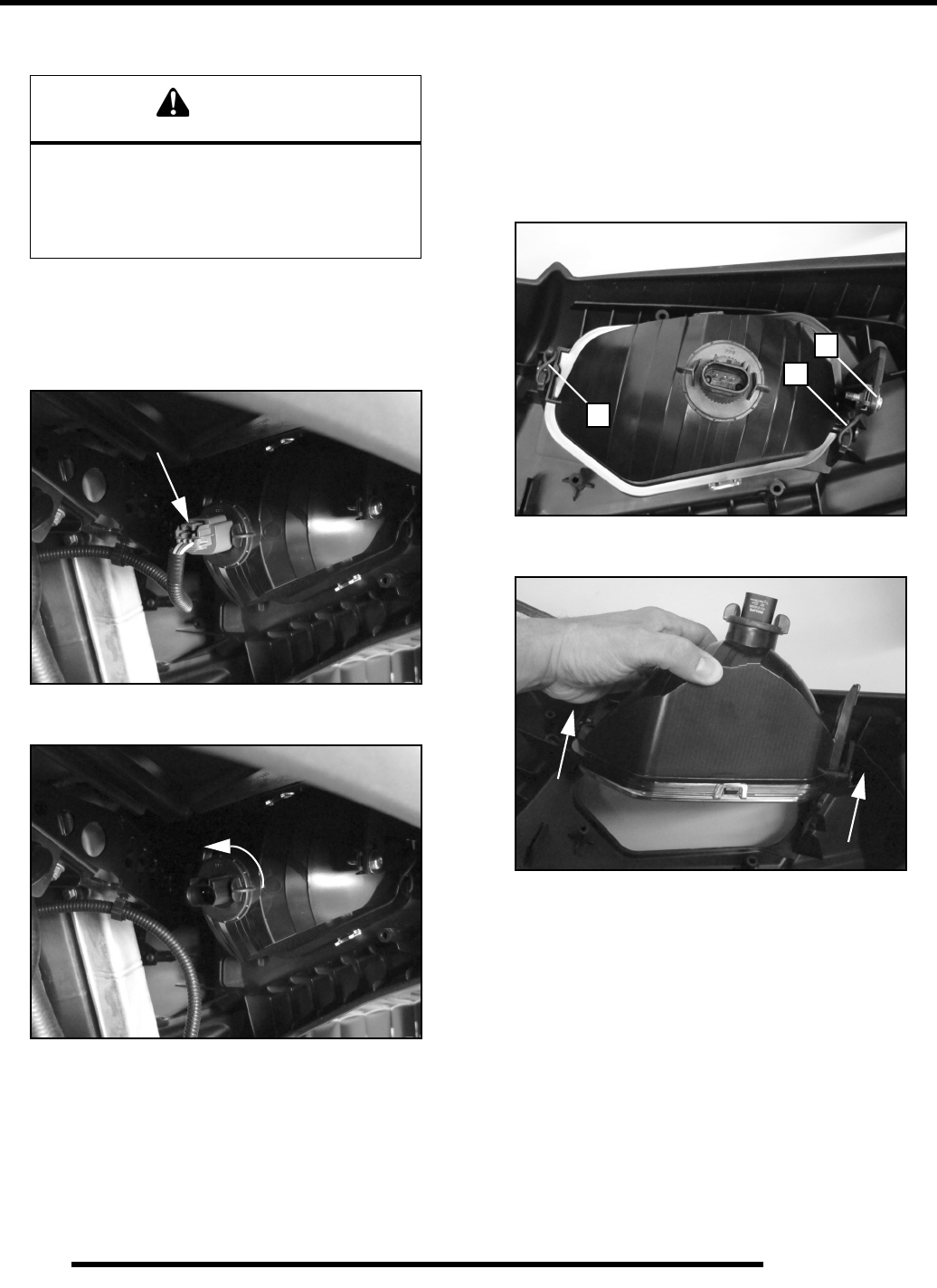
10.16
ELECTRICAL
6. Adjust the beam to desired position. Repeat the procedure
to adjust the other headlight.
Headlamp Bulb Replacement
1. Disconnect the wire harness from the headlamp bulb. Be
sure to pull on the connector, not on the wiring.
2. Turn the bulb counterclockwise to remove it.
3. Insert new bulb. Reinstall the wire harness onto the
headlamp assembly.
NOTE: Make sure the tabs on the bulb locate
properly in the housing.
Headlamp Housing Removal
1. Disconnect the wire harness from the headlamp bulb. Be
sure to pull on the connector, not on the wiring.
2. Remove the O-rings (A) from the headlamp brackets on
both sides of the headlamp.
3. Remove the adjustment screw (B) from the bracket.
4. Carefully remove the headlamp from the front bumper.
Headlamp Housing Installation
1. Install the headlamp housing back into the front bumper.
2. Secure the headlamp housing with the rubber O-rings (A)
on both sides of the headlamp and install the adjustment
screw (B).
3. Reconnect wire harness or re-insert bulb if previously
removed.
4. Adjust headlights using the “Headlight Adjustment”
procedure in this section.
WARNING
Due to the nature of light utility vehicles and
where they are operated, headlight lenses
become dirty. Frequent washing is necessary to
maintain lighting quality. Riding with poor
lighting can result in severe injury or death.
A
A
B
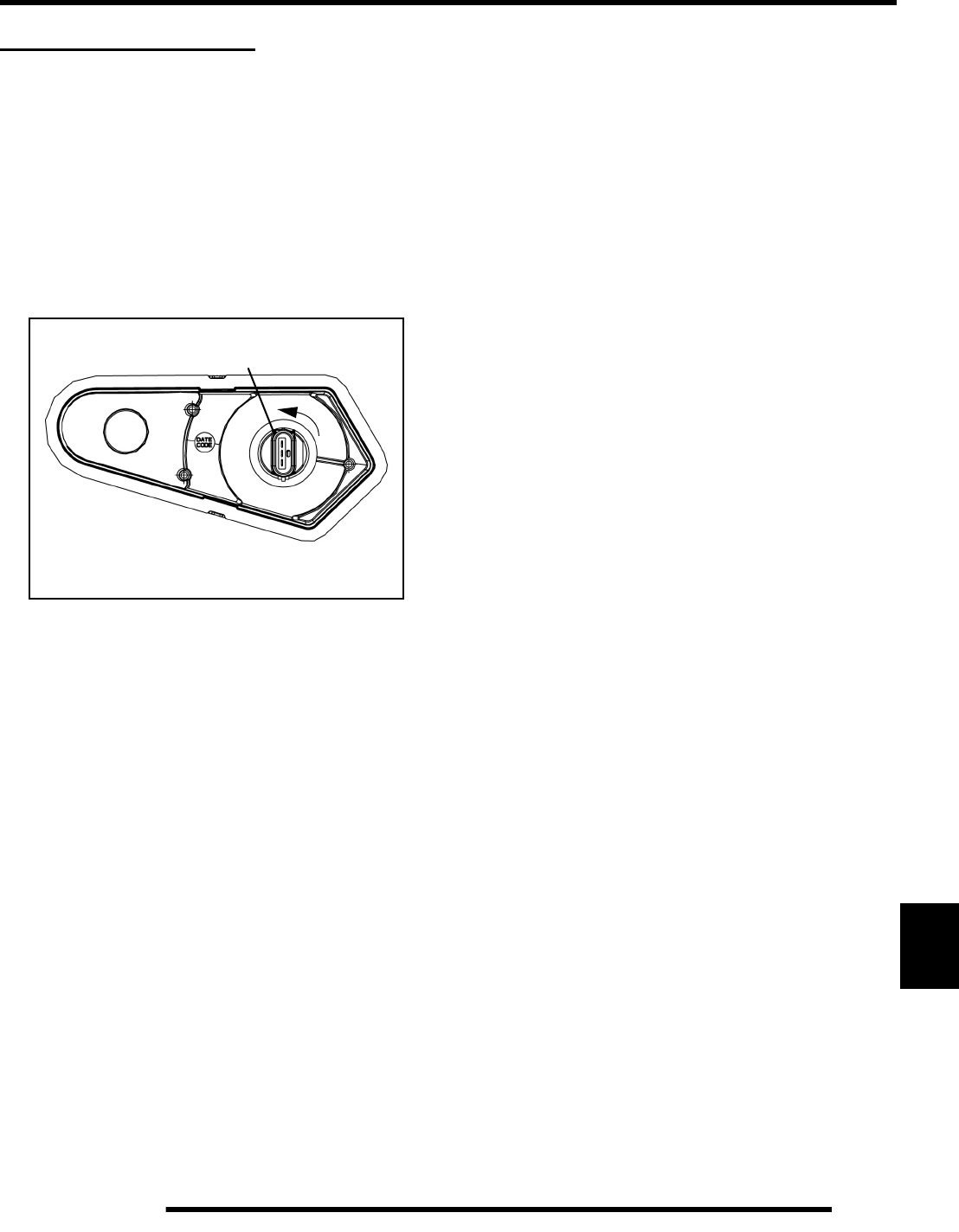
10.17
ELECTRICAL
10
TAIL / BRAKE LIGHTS
Bulb Replacement
Before replacing the bulb(s), use a digital multi-meter to test the
harness to ensure the lamp is receiving 12 volts and that a ground
path is present.
If a tail light or brake light does not work the bulb may need to
be replaced.
1. Remove bulb by turning the rubber base 1/4 turn and
pulling the bulb out. Replace it with recommended bulb.
Apply Dielectric Grease (PN 2871329).
2. Test the tail light and brake light to verify it is working
properly.
Tail / Brake
Light

10.18
ELECTRICAL
COOLING SYSTEM SCHEMATIC
Cooling System Break-Out Diagram

10.19
ELECTRICAL
10
Fan Control Circuit Operation / Testing
Power is supplied to the fan via the Orange/Black wire when the
relay is ON. The ground path for the fan motor is through the
Brown harness wire. Refer to “RELAYS” later in this chapter
for more information on fan functions.
NOTE: The fan may not function or operation may
be delayed if coolant level is low or if air is trapped in
the cooling system. Be sure cooling system is full
and purged of air. Refer to Maintenance Chapter 2
for cooling system information.
Fan Control Circuit Bypass Test
1. Disconnect harness from coolant temperature sensor on
the engine cylinder head (see Chapter 4 for location).
2. With the transmission in Park, start the engine. After a few
seconds, the fan should start running and the “Check
Engine” indicator should display on the instrument cluster.
This indicates all other components are working properly.
3. If the fan does not run or runs slowly, check the fan motor
wiring, ground, motor condition and mechanical relay for
proper operation. Repair or replace as necessary. If the fan
runs with the sensor harness disconnected, but will not turn
on when the engine is hot, check the coolant temperature
sensor and connector terminals.
Coolant Temperature Sensor
The coolant temperature sensor can be tested using an ohmmeter
or voltmeter.
1. With the engine and temperature sensor at room
temperature (68F = 20C), disconnect the harness.
2. With the meter in the ohms mode, place the meter leads
onto the sensor contacts.
3. Use the table Temperature / Resistance table to determine
if the sensor needs to be replaced.
NOTE: If the coolant temperature sensor or circuit
malfunctions the radiator fan will default to 'ON'.
EFI DIAGNOSTICS
EFI Component Testing
All EFI component information and diagnostic testing
procedures are located in Chapter 4.
Refer to Chapter 4 “Electronic Fuel Injection System (EFI)”
when diagnosing an EFI system or component.
FUEL SENDER
Testing
1. Drain the fuel tank and remove it from the vehicle (see
Chapter 4).
2. Set the fuel tank on a flat surface. Using an Ohm meter,
measure the resistance of the fuel sender as shown below.
3. Allow the sender float to sit in the empty position and
compare to specification.
4. Slowly tilt the tank so that gravity moves the sender float
to the full position and compare to specification.
5. If the readings are out of specification, or if the reading is
erratic or LCD display “sticks”, check the following before
replacing the fuel pump assembly:
• Loose float
• Float contact with tank
• Bent float rod
If none of the conditions exist, the fuel sender assembly is faulty.
Replace the fuel pump assembly (see Chapter 4).
CAUTION
Keep hands away from fan blades during
operation. Serious personal injury could result.
TEMPERATURE F (C) RESISTANCE
68F (20 C) 2.5 k 6%
212F (100 C) 186 2%
Fuel Sender - Empty: 90 ± 4.5
Fuel Sender - Full: 6 ± 1
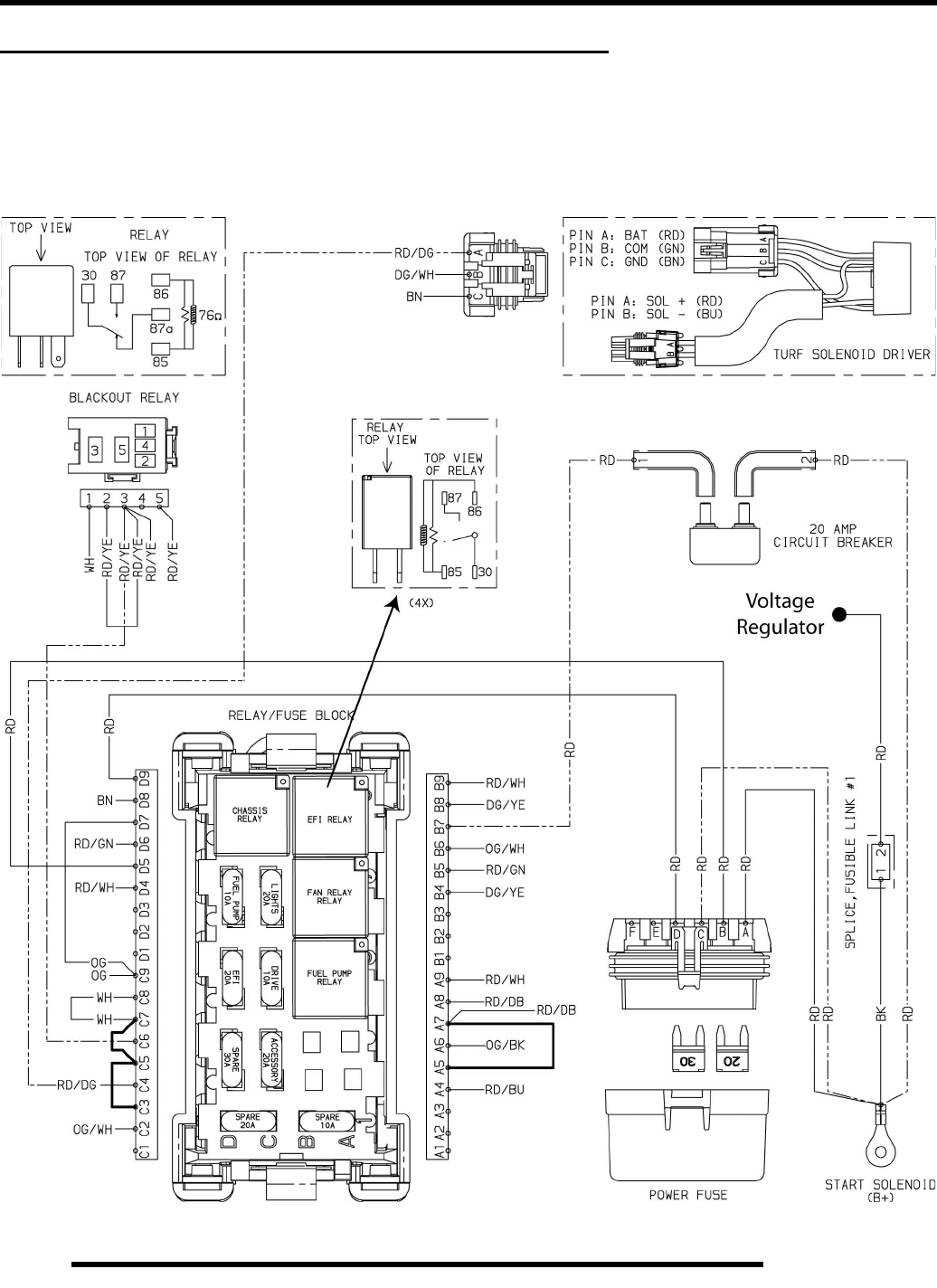
10.20
ELECTRICAL
FUSE BOX: FUSES / RELAYS / CIRCUIT BREAKER
Overview / Operation
Located in the fuse box under the dash, the fuses provide overload protection for wiring and components such as the instrument
cluster, ECU, EFI system, chassis power, lights and accessories. The relays assist with component operation like the cooling fan,
fuel pump and EFI system. A separate 20-amp circuit breaker protects the fan motor circuit.

10.21
ELECTRICAL
10
Relay Operation
Located in the fuse box under the dash, the relays assist with
component operation like the cooling fan, fuel pump and EFI
system.
NOTE: The Rear Diff Solenoid Relay is mounted
separately, attached to the rear plastic LH panel
divider behind the driver’s seat.
NOTE: The Blackout Relay is secured to the wire
harness near the fuse box.
CHASSIS RELAY provides power to the following systems:
• Lights (Headlights / Taillights / I.R. Lights / Blackout
Circuit)
• Drive (AWD / TURF)
• Accessory (12V Recepticles / Accessory Options)
EFI RELAY provides power to the following systems:
• Fuel Injectors
• Cam Phase Sensor
• Ignition Coil
•Fan Relay
• Fuel Pump Relay
FAN RELAY provides power to the following system:
•Fan Motor
FUEL PUMP RELAY provides power to the following
system:
• Fuel Pump
REAR DIFF SOLENOID RELAY provides power to the
following system:
• Rear Differential Solenoid
CHASSIS RELAY
COLOR FUNCTION
Red 30-Amp fuse protected 12 Vdc
constant battery voltage.
Brown Relay coil ground.
Orange ECU 12 Vdc power input to enable
relay.
White Provides 12 Vdc power for lights, drive
and accessory circuits.
EFI RELAY
COLOR FUNCTION
Red / White 20-Amp fuse protected 12 Vdc
constant battery voltage.
Dark Green / Yellow ECU ground input to enable relay.
Red / White 20-Amp fuse protected 12 Vdc
constant battery voltage.
Red / Dark Blue Provides 12 Vdc power for EFI system
circuits.
FAN RELAY
COLOR FUNCTION
Red 20-Amp circuit breaker protected 12
Vdc constant battery power.
Orange / White ECU ground input to enable relay.
Red / Dark Blue 12 Vdc switched power from EFI relay.
Orange / Black Provides 12 Vdc power for fan
operation.
FUEL PUMP RELAY
COLOR FUNCTION
Red / Light Green 10-Amp fuse protected 12 Vdc battery
voltage.
Dark Green / Yellow ECU ground input to enable relay.
Red / Dark Blue BUS Bar - 12 Vdc switched power
from EFI relay.
Red / Light Blue Provides 12 Vdc power for fuel pump
operation.
REAR DIFF SOLENOID RELAY
COLOR FUNCTION
Red / Dark Green 10-Amp fuse protected 12 Vdc battery
voltage.
Dark Green / White ECU input to enable relay.
Brown Relay coil ground.
Red Relay switched power to operate the
Rear Diff Solenoid.
Blue Ground to energize the Rear Diff
Solenoid.
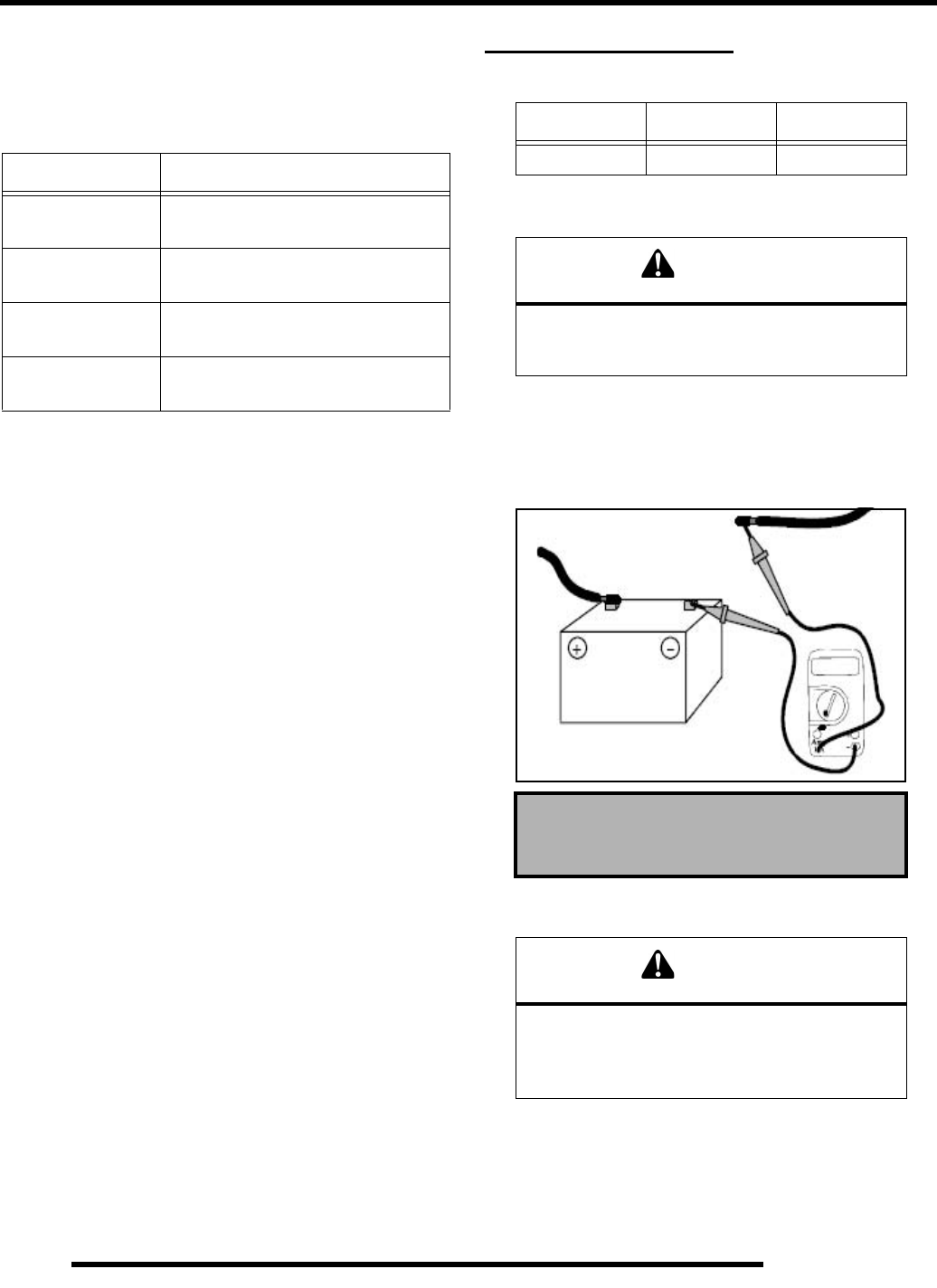
10.22
ELECTRICAL
BLACKOUT RELAY provides power to the following
system:
• Rear Differential Solenoid
CHARGING SYSTEM
Current Draw - Key Off
Connect an ammeter in series with the negative battery cable.
Check for current draw with the key off. If the draw is excessive,
loads should be disconnected from the system one by one until
the draw is eliminated. Check component wiring as well as the
component for partial shorts to ground to eliminate the draw.
Charging System “Break Even” Test
The “break even” point of the charging system is the point at
which the alternator overcomes all system loads (lights, etc.)
and begins to charge the battery. Depending on battery condition
and system load, the break even point may vary slightly. The
battery should be fully charged before performing this test.
BLACKOUT RELAY
COLOR FUNCTION
White Ground input from Blackout Switch to
enable (open) relay
Red / Yellow BUS Bar - 10-Amp fuse protected 12
Vdc battery voltage.
Red / Yellow 10-Amp fuse protected 12 Vdc battery
voltage.
Red / Yellow Provides 12 Vdc power for all light
circuits.
Alternator Output
RPM AMPS VOLTS
2500 20 13.2 Vdc
CAUTION
Do not connect or disconnect the battery cable
or ammeter with the engine running. Damage will
occur to electrical components.
Current Draw - Key Off:
Maximum of .01 DCA (10 mA)
CAUTION
Do not allow the battery cables to become
disconnected with the engine running. Follow the
steps below as outlined to reduce the chance of
damage to electrical components.
Current Draw Inspection
Key Off
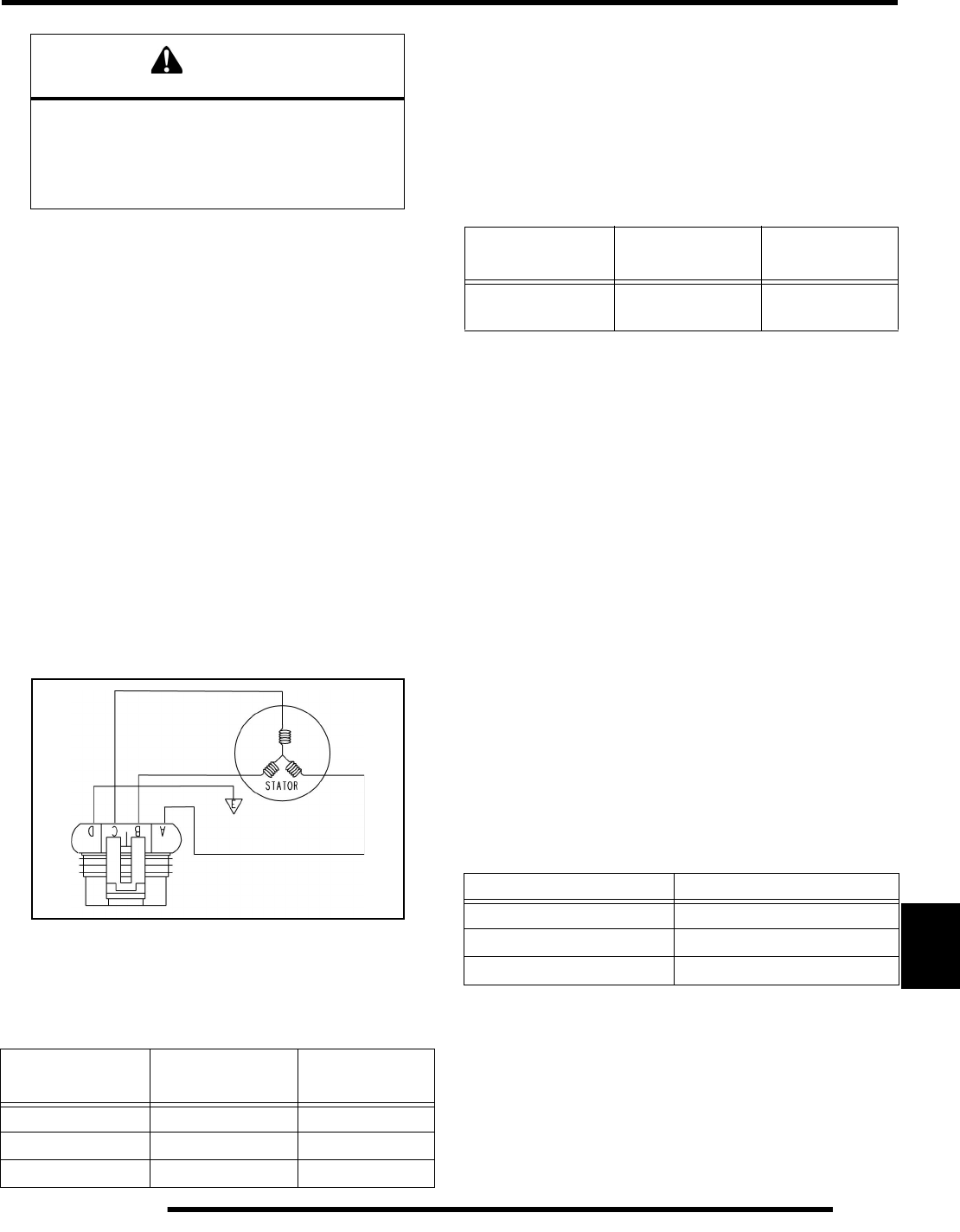
10.23
ELECTRICAL
10
1. Using an inductive amperage metering device, (set to DC
amps) connect to the negative battery cable.
2. With engine off, key switch and lights in the on position,
the ammeter should read negative amps (battery discharge).
3. Shift transmission into park and start the engine. With the
engine running at idle, observe meter readings.
4. Increase engine RPM while observing ammeter and
tachometer. Note the RPM at which the battery starts to
charge (ammeter indication is positive).
5. With lights and other electrical loads off, the “break even”
point should occur at approximately 1500 RPM or lower.
6. With the engine running, turn the lights on and depress the
brake pedal to keep brake lights on.
7. Repeat test, observing ammeter and tachometer. With
lights on, charging should occur at or below 2000 RPM.
Charging System Alternator Tests
Three tests can be performed using a multi-meter to determine
the condition of the stator (alternator).
TEST 1: Resistance Value of Each Stator Leg
1. Measure the resistance value of each of the three stator
legs: Y1 to Y2, Y1 to Y3, and Y2 to Y3. Each test should
measure: 0.19 ± 15%
NOTE: If there are any significant variations in ohm
readings between the three legs it is an indication
that one of the stator legs may be weak or failed.
TEST 2: Resistance Value of Each Stator Leg to Ground
1. Measure the resistance value of each of the stator legs to
ground: Y1 to Ground, Y2 to Ground, Y3 to Ground.
Each test should measure: Open Line (OL)
NOTE: Any measurement other than Infinity (open)
will indicate a failed or shorted stator leg.
TEST 3: Measure AC Voltage Output of Each Stator Leg at
Charging RPM
1. Set the selector dial to measure AC Voltage.
2. Start the engine and let it idle.
3. While holding the engine at a specified RPM, separately
measure the voltage across each ‘leg’ of the stator by
connecting the meter leads to the wires leading from the
alternator (Y1 to Y2, Y1 to Y3, Y2 to Y3).
4. Refer to the following table for approximate AC Voltage
readings according to RPM. Test each leg at the specified
RPM in the table.
Example: The alternator current output reading should be
approximately 18 VAC at 1300 RPM between each ‘leg’.
NOTE: If one or more of the stator leg output AC
voltage varies significantly from the specified value,
the stator may need to be replaced.
WARNING
Never start the engine with an ammeter
connected in series. Damage to the meter or
meter fuse will result.
Do not run test for extended period of time.
Do not run test with high amperage accessories.
Test Connect Meter
Leads To: Ohms Reading
Battery Charge Coil Y1 to Y2 0.19 ± 15%
Battery Charge Coil Y1 to Y3 0.19 ± 15%
Battery Charge Coil Y2 to Y3 0.19 ± 15%
Y1
Y2
Y3
Test Connect Meter
Leads To: Ohms Reading
Battery Charge Coil Y1, Y2, or Y3
to Ground Open Line
(Infinity)
RPM Reading AC Voltage (VAC) Reading
1300 18 VAC ± 25 %
3000 42 VAC ± 25 %
5000 64 VAC ± 25 %

10.24
ELECTRICAL
Regulator / Rectifier Test
• Remove the regulator / rectifier from the vehicle. NOTE: Unit must be cool for accurate testing.
•Use DIODE CHECK function on the Fluke 77 DMM
• Perform all tests described in test table below. Test results describe a properly functioning component.
Regulator / Rectifier Test Table - Set DMM to DIODE CHECK Function
DMM RED LEAD DMM BLACK LEAD RESULT
AC - 1 (3-wire connector) AC - 2 (3-wire connector) Open Circuit
AC - 2 (3-wire connector) AC - 3 (3-wire connector) Open Circuit
AC - 1 (3-wire connector) AC - 3 (3-wire connector) Open Circuit
AC - 2 (3-wire connector) AC - 1 (3-wire connector) Open Circuit
AC - 3 (3-wire connector) AC - 1 (3-wire connector) Open Circuit
AC - 3 (3-wire connector) AC - 2 (3-wire connector) Open Circuit
RED Battery + (2-wire connector) BLACK Ground (2-wire connector) Open Circuit
BLACK Ground (2-wire connector) RED Battery + (2-wire connector) 2300mV to 2400mV
BLACK Ground (2-wire connector) Regulator / Rectifier Case Closed Circuit (continuity)
BLACK Ground (2-wire connector) Any Phase Open Circuit
AC - 1 (3-wire connector) BLACK Ground (2-wire connector) Open Circuit
AC - 2 (3-wire connector) BLACK Ground (2-wire connector) 2200mV to 2300mV
AC - 3 (3-wire connector) BLACK Ground (2-wire connector) Open Circuit
RED Battery + (2-wire connector) Any Phase Open Circuit
AC - 1 (3-wire connector) RED Battery + (2-wire connector) 400mV to 500mV
AC - 2 (3-wire connector) RED Battery + (2-wire connector) 400mV to 500mV
AC - 3 (3-wire connector) RED Battery + (2-wire connector) 400mV to 500mV
NOTE: If the temperature of the regulator / rectifier exceeds
194 °F (90°C), the unit will turn itself off to cool down. The
unit will turn on at approximately 167°F (75°C). If it turns off,
verify the housing cooling fins are clean, free from debris
and that adequate airflow is present.

10.25
ELECTRICAL
10
Charging System Testing Flow Chart
Whenever charging system problems are suspected, proceed with the following system check after verifying that all wires are in good
condition, connected and not exposed or pinched.
Using a multitester set on D.C. volts, mea-
sure the battery open circuit voltage (See
earlier test). It should be 12.4 volts or more.
Is it?
Meter Setting: DC Volts
With the transmission in Park, start the
Meter Setting: DC Amps
Perform system “Break Even Amperage”
Meter Setting: DC Volts
Reconnect the alternator wires. Note: Red
wire must be connected to harness. Battery
voltage must be present on red wire terminal
on harness side of voltage regulator connector.
Is voltage present?
If all of the previous tests indicate a good
Yes
No
No
Yes
Yes
Remove the battery and properly ser-
vice. Reinstall the fully charged battery
or a fully charged shop battery.
No
Check Key off Current Draw.
Yes
Check for owner modification, and
discuss operating habits. The battery
will continually discharge if operated
below the “Break Even” RPM. Con-
tinued problems would call for battery
inspection.
Yes
Inspect the wiring harness between
the panel and the stator for
remove the recoil and flywheel.
Inspect the flywheel magnets, stator
coils and stator wires for damage.
No
Check stator, regulator, ground, battery
and battery connections. Also check
wire connections and wire condition.
Repair or replace faulty wiring or
No
engine and increase RPM to between 3000
test outlined in this chapter.
Does charging occur as specified?
Ohm stator wires, if bad replace stator, if good,
continue with alternator output test.
Meter Setting: AC Volts
Disconnect the Yellow wires from the regulator /
rectifier. Using a multitester, perform an Alternator
Output test. See test procedure on Page 10.24.
damage. If no damage is found,
Repair or replace any damaged
components.
components.
and 4000. Read battery voltage with the
multitester. Readings should increase to
between 13.0 and 14.6 V D.C. Do they?
Does output meet specification?
condition, but the charging voltage does not
rise above battery voltage at the connector
or wire harness, replace the voltage regulator.

10.26
ELECTRICAL
BATTERY SERVICE
Battery Specifications
General Battery Information
IMPORTANT: Never attempt to add electrolyte or
distilled water to a Maintenance Free battery. Doing so
will damage the case and shorten the life of the
battery.
1. Check battery voltage with a volt/ohm meter. A fully
charged battery should be 12.8 V or higher.
2. If the voltage is below 12.6 V, the battery will need to be
recharged (see “Charging Procedure”).
To service a Maintenance Free battery:
1. Remove battery from the vehicle (see Chapter 2).
2. Test battery with a voltage meter or load tester to determine
battery condition. This will determine the length of time
required to charge the battery to full capacity. Refer to OCV
table (see “OCV - Open Circuit Voltage Test”).
3. Charge the battery as recommended (see “Charging
Procedure”).
Battery Removal / Installation
See Chapter 2 “Maintenance” for battery removal and
installation procedures.
Battery Off Season Storage
Whenever the vehicle is not used for a period of three months or
more, remove the battery from the vehicle, ensure that it's fully
charged, and store it out of the sun in a cool, dry place. Check
battery voltage each month during storage and recharge as
needed to maintain a full charge.
NOTE: Battery charge can be maintained by using a
Polaris battery tender charger or by charging once a
month to make up for normal self-discharge. Battery
tenders can be left connected during the storage
period, and will automatically charge the battery if
the voltage drops below a pre-determined point.
Battery Testing
Whenever a service complaint is related to either the starting or
charging systems, the battery should be checked first.
Following are two tests which can easily be made on a sealed
Maintenance Free battery to determine its condition: OCV Test
and a Load Test.
Type Polaris / Yuasa YTX20HL-BS
Sealed - Maintenance Free
Voltage 12 Vdc
Nominal Capacity @
10 HR Rate 18 AH
CCA 310
Nominal Open
Circuit Voltage 12.8 Vdc or more.
Recommended
Charging Rate 1.8A @ 5-10 HR or 9.0A @ 1 HR
WARNING
CALIFORNIA PROPOSITION 65 WARNING:
Batteries, battery posts, terminals and related
accessories contain lead and lead compounds, and
other chemicals known to the State of California to
cause cancer and birth defects or other reproductive
harm. WASH HANDS AFTER HANDLING.
WARNING
Battery electrolyte is poisonous. It contains acid!
Serious burns can result from contact with the skin,
eyes, or clothing.
ANTIDOTE:
External: Flush with water.
Internal: Drink large quantities of water or milk. Follow
with milk of magnesia, beaten egg, or vegetable oil.
Call a physician immediately.
Eyes: Flush with water for 15 minutes and get prompt
medical attention.
Batteries produce explosive gases. Keep sparks,
flame, cigarettes, etc. away. Ventilate when charging
or using in closed space. Always shield eyes when
working near batteries.
Keep out of reach of children.
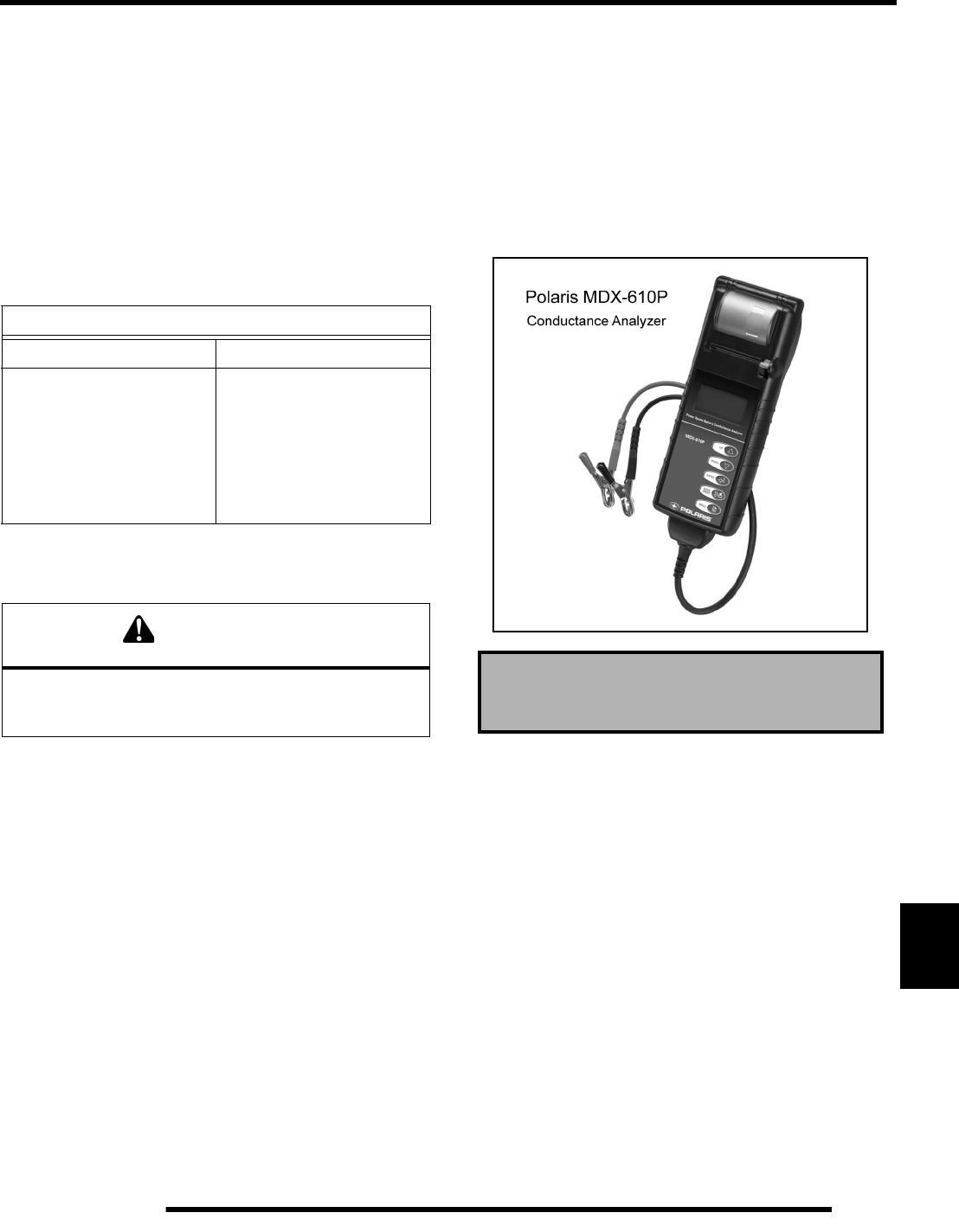
10.27
ELECTRICAL
10
OCV - Open Circuit Voltage Test
Battery voltage should be checked with a digital multitester.
Readings of 12.6 volts or less require further battery testing and
charging. See the following chart and “Load Test”.
NOTE: Maintenance Free batteries should be kept at
a high state of charge during storage. If the battery is
stored or used at a low state of charge, hard crystal
sulfation will form on the plates, reducing the
efficiency and service life of the battery.
NOTE: Use a volt/ohm meter to test battery voltage.
Load Test
A battery may indicate a full charge condition in the OCV test,
but still may not have the storage capacity necessary to properly
function in the electrical system. For this reason, a battery
capacity or load test should be conducted whenever poor battery
performance is encountered.
To perform this test, use a load testing device that has an
adjustable load. Apply a load of three times the ampere-hour
rating. At 14 seconds into the test, check battery voltage. A good
12V battery will have at least 10.5 volts. If the reading is low,
charge the battery and retest.
Battery Conductance Analyzer
Conductance describes the ability of a battery to conduct
current. A conductance tester functions by sending a low
frequency AC signal through the battery and a portion of the
current response is captured, from this output a conductance
measurement is calculated. Conductance testing is more
accurate than voltage, specific gravity, or load testing.
Authorized Polaris dealers/distributors are required to use the
conductance analyzer when testing 12V Polaris batteries.
OPEN CIRCUIT VOLTAGE
State of Charge Maintenance Free
100% 13.0 V
75% Charged 12.8 V
50% Charged 12.5 V
25% Charged 12.0 V
0% Charged 11.5 V or less
CAUTION
To prevent shock or component damage, remove spark
plug high tension leads and connect securely to
engine ground before proceeding.
Polaris MDX-610P
SPX PN: PU-50296
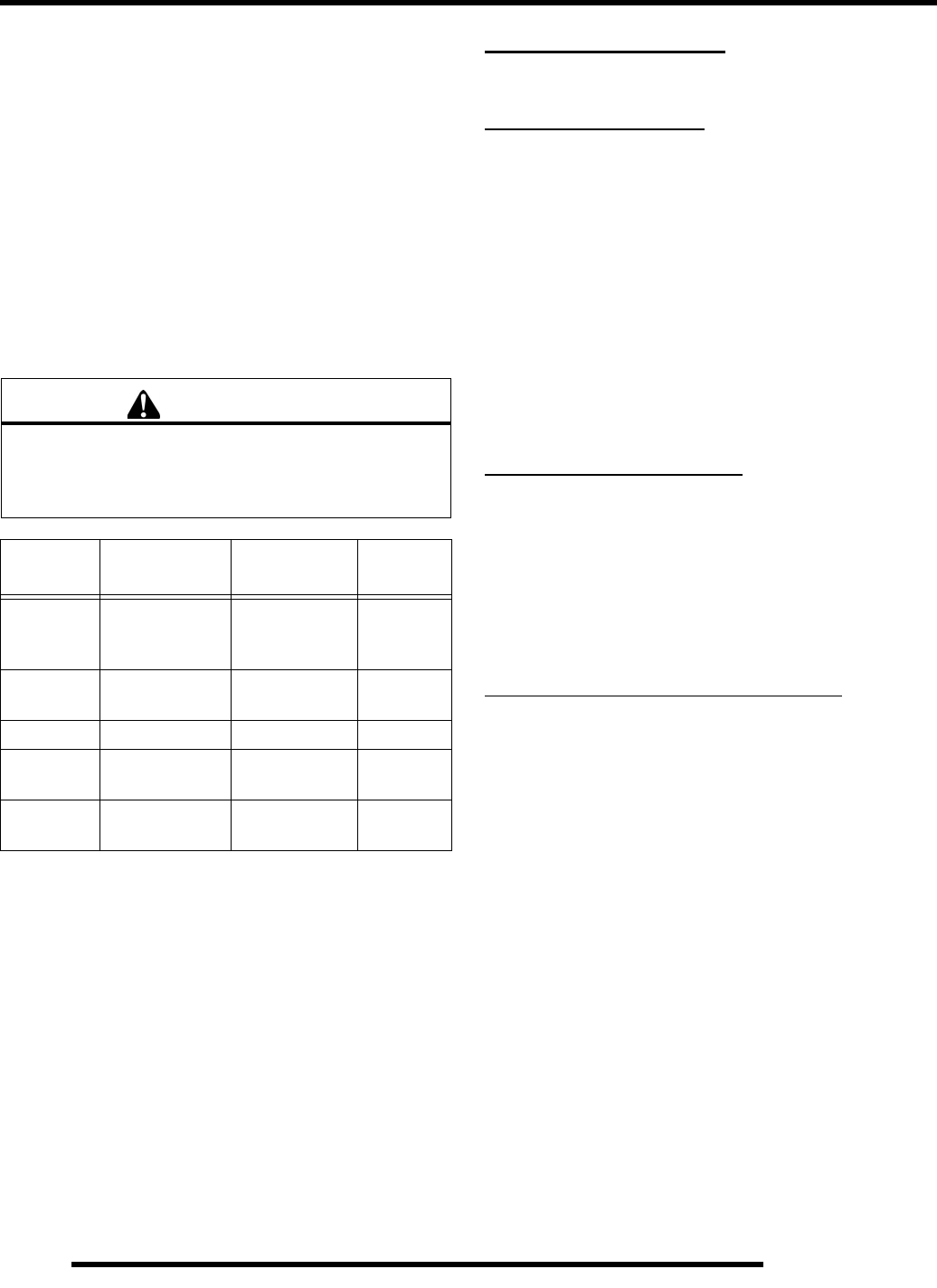
10.28
ELECTRICAL
Charging Procedure
If battery voltage is 12.6 Vdc or less, the battery may need
recharging. When using an automatic charger, refer to the
charger manufacturer’s instructions for recharging.
Do not exceed 9 amps when charging the battery.
NOTE: Charge the battery using an automatic
charger that will not exceed 14.6 Vdc. An automatic
charger will signal when charging is complete.
NOTE: Allow the battery to stand disconnected for
at least 1-2 hours after being properly charged. If the
voltage drops below 12.6 volts, charging was
ineffective or the battery needs to be replaced.
NOTE: Follow the charger instructions supplied by
the manufacture regarding the order or connections,
switch positions and when to connect the charger to
an outlet.
STARTING SYSTEM
Troubleshooting
Starter Motor Does Not Run
• Battery discharged
• Loose or faulty battery cables or corroded connections
(see Voltage Drop Tests)
• Related wiring loose, disconnected, or corroded
• Poor ground connections at battery cable, starter motor
or starter solenoid (see Voltage Drop Tests)
• Faulty key switch
• Faulty starter solenoid or starter motor
• Engine problem - seized or binding (can engine be
rotated easily)
Starter Motor Turns Over Slowly
• Battery discharged
• Excessive circuit resistance - poor connections (see
Voltage Drop Test)
• Engine problem - seized or binding (can engine be
rotated easily)
• Faulty or worn brushes in starter motor
Starter Motor Turns - Engine Does Not Rotate
• Faulty starter drive
• Faulty starter drive gears or starter motor gear
• Faulty flywheel gear or loose flywheel
WARNING
An overheated battery could explode, causing severe
injury or death. Always watch charging times carefully.
Stop charging if the battery becomes very warm to the
touch. Allow it to cool before resuming charging.
State of
Charge Voltage (DC) Action Charge
Time
100% 12.8 - 13.0 None, check
again in 3
months
None
Required
75% - 100% 12.5 - 12.8 May need
slight charge 3 - 6 hrs
50% - 75% 12.0 - 12.5 Needs Charge 5 - 11 hrs
25% - 50% 11.5 - 12.0 Needs Charge At least
13 hrs
0% - 25% 11.5 or less Needs Charge At least
20 hrs

10.29
ELECTRICAL
10
Voltage Drop Test
The Voltage Drop Test is used to test for bad connections. When
performing the test, you are testing the amount of voltage drop
through the connection. A poor or corroded connection will
appear as a high voltage reading. Voltage shown on the meter
when testing connections should not exceed .1 VDC per
connection or component.
To perform the test, place the meter on DC volts and place the
meter leads across the connection to be tested. Refer to the
voltage drop tests on the starter system in this chapter.
Starter Motor Removal / Disassembly
NOTE: Use electrical contact cleaner to clean starter
motor parts. Some solvents may leave a residue or
damage internal parts and insulation.
1. Remove the starter from the engine.
2. Remove the two bolts, washers, and sealing O-Rings.
Inspect O-Rings and replace if damaged.
NOTE: Note the alignment marks on both ends of
the starter motor casing. These marks must align
during reassembly.
3. Remove the front bracket assembly and the rear bracket
assembly. Remove the shims from the armature shaft and
inspect the O-rings located on the armature housing.
NOTE: The shims will be replaced during
reassembly.
Brush Inspection / Replacement
1. Measure resistance between starter input terminal and
insulated brushes. The reading should be .3 ohms or less.
Remember to subtract meter lead resistance.
Voltage should not exceed
.1 DC volts per connection
O-Rings
Shims

10.30
ELECTRICAL
2. Measure resistance between insulated brush and starter
housing. Reading should be infinite (OL). Inspect
insulation on brush wires for damage and repair or replace
as necessary.
3. Slide positive brush springs to the side, pull brushes out of
their guides and remove brush plate. Slide brush end frame
off end of starter.
NOTE: The electrical input post must stay with the
field coil housing.
4. Measure resistance between ground brush and brush plate.
Resistance should be .3 ohms or less.
Brush Inspection
1. Measure length of each carbon brush. Replace brush
assembly when worn to 5/16” (8 mm) or less. The brushes
must slide freely in their holders.
Brush Replacement
1. Remove terminal nut with lock washer, flat washer, large
phenolic washer, the small phenolic spacers, and sealing
O-ring. Inspect O-ring and replace if damaged.
2. Slide positive brush springs to the side, pull brushes out of
their guides and remove brush plate.
Armature Testing
1. Remove armature from starter casing. Note order of shims
on drive end for reassembly.
2. Inspect surface of commutator. Replace if excessively
worn or damaged.
3. Using a digital multitester, measure the resistance between
each of the commutator segments. The reading should be
.3 ohms or less.
Limit 5/16” (8 mm)
Brush Length
CAUTION
Some cleaning solvents may damage the
insulation in the starter. Care should be
exercised when selecting an appropriate
solvent. If the commutator needs cleaning use
only electrical contact cleaner.
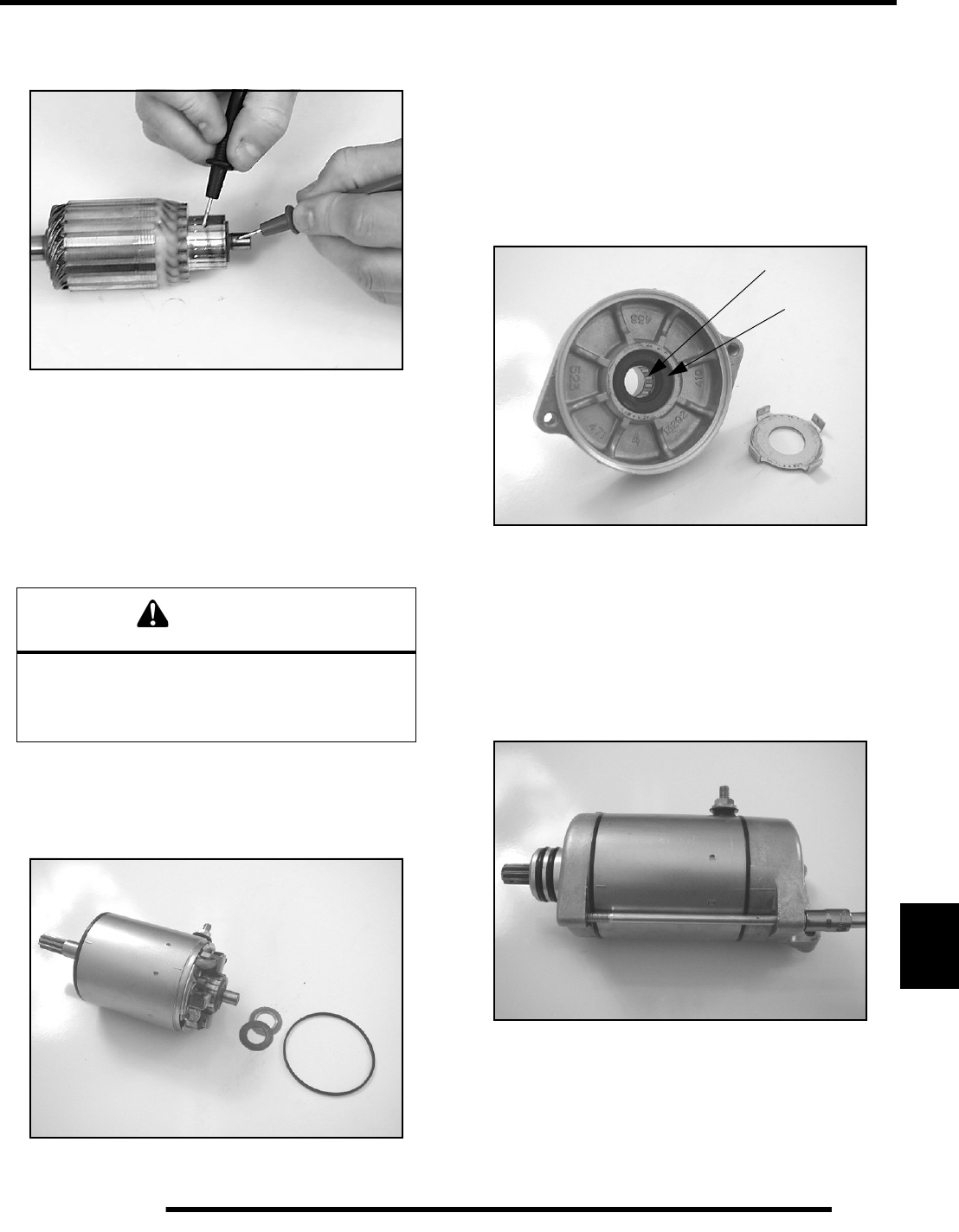
10.31
ELECTRICAL
10
4. Measure the resistance between each commutator segment
and the armature shaft. The reading should be infinite (no
continuity).
5. Check commutator bars for discoloration. Bars discolored
in pairs indicate shorted coils, requiring replacement of the
starter motor.
6. Place armature in a growler. Turn growler on and position
a hacksaw blade or feeler gauge lengthwise 1/8” (.3 cm)
above armature coil laminates. Rotate armature 360. If
hacksaw blade is drawn to armature on any pole, the
armature is shorted and must be replaced.
Starter Reassembly / Installation
1. Install brush plate to field magnet housing aligning index
tab.
2. Install O-ring, two small phenolic spacers, large phenolic
washer, flat washer, lock washer, and terminal nut.
3. While holding brush springs away from brushes, push
brushes back and hold in place.
4. Slide armature into field magnet housing. Release brushes.
5. Lightly grease the drive roller bearing and reinstall drive
end frame on armature. Inspect seal for wear or damage.
Replace drive end cap if necessary.
6. Be sure wire insulation is in place around positive brush
wire and pushed completely into slot on phenolic plate.
7. Using Dielectric Grease (PN 2871329), lubricate brush end
bushing and install shims.
8. Align brush plate and install cover and screws.
9. Lightly grease pinion shaft and install pinion, spring
stopper, and snap ring.
10. Completely assemble starter motor and torque set bolts to
35 - 52 in. lbs. (3.9 - 5.9 Nm).
11. Install the starter onto the engine case. Hand tighten each
of the starter bolts. Torque the bottom bolt first to 9 ft.
lbs. (12 Nm). Then torque the top bolt to the same
specification.
CAUTION
Use care when handling starter housing.
Do not drop or strike the housing as magnet damage
is possible. If magnets are damaged,
starter must be replaced.
Roller Bearing
Seal
Set Bolt Torque: 35-52 in. lbs. (3.9-5.9 Nm)

10.32
ELECTRICAL
NOTE: It is important to tighten the bottom starter
bolt first (circle), as the bottom hole acts as a pilot
hole to properly align the starter drive (bendix) with
the flywheel. This helps to prevent binding and
starter damage.
Starter Drive
If the garter spring is damaged, the overrun clutch may fail to
return properly. Use either of the following methods to remove
and install a new garter spring:
1. Screw the overrun clutch out to the engaged position on the
pinion shaft assembly. Use a small piece of wire with the
end bent in a hook and pick the old spring out of its
channel. Slide it off the end of the shaft. Slide the new
spring over the overrun clutch and into the spring groove.
Make sure the spring is positioned between the shoe
alignment pins and the back flange of the anti kick-out
shoes.
2. Remove the retaining ring, thrust washer, spring retainers
and clutch return spring. Screw the overrun clutch off the
end of the pinion shaft. Remove the old spring and install
a new one. Lightly grease the pinion shaft and reinstall the
clutch, spring, retainers, end washer and lock ring in the
reverse order. Make sure the end washer is positioned
properly so that it will hold the lock ring in its groove.
Starter Solenoid Bench Test
Test the start solenoid by powering the solenoid using battery
voltage for a maximum of 5 seconds. With the solenoid
energized, resistance should read about 0 - 0.5 between
terminals (A) and (B). If resistance measurement is out of
specification, replace the starter solenoid.
Starter Solenoid Operation
To energize the Starter Solenoid the following must occur:
• The brake must be applied to provide a ground path via
the Orange wire.
• The key switch must be turned to the “start” position to
provide 12V power via the White / Red wire.
• Once the pull-in coil is energized, the solenoid provides
a current path for 12V power to reach the starter motor.
A. Gear Assembly
B. Thrust Washer
C. Busing
D. Retaining Ring
E. Thrust Washer
F. Stopper
G. Cover
H. Spring
A
B
C
D
E
F
G
H
AB
Energize
Here

10.33
ELECTRICAL
10
Starter Exploded View
1. Rubber Ring*
2. Brush Spring
3. Thrust Washer
4. Gear Assembly
5. O-Ring*
6. Brush Complete
7. O-Ring*
8. Thrust Washer
9. Shaft Complete
10. Gear Assembly
11. Through Bolt
12. Cover
13. Stopper
14. Snap Ring
15. Washer
16. Flange Bolt
17. Thrust Washer
18. Flange Bushing
* Indicates - Do not reuse.
Replace with new parts.

10.34
ELECTRICAL
STARTING SYSTEM TESTING FLOW CHART
Condition: Starter fails to turn over the engine.
With the tester on the VDC position, place the
tester's black lead on the battery negative and the
red lead on the battery positive. Reading should
be 12.4 V D. C. or greater.
Remove battery and properly service. Install
fully charged shop battery to continue test.
Disconnect 2-wire connector at the solenoid.
Using a multi-meter, connect the black meter lead
to the Orange/Green harness wire and the red
meter lead to the White/Red harness wire. Apply
the brake and turn ignition switch to the “start”
position. Meter should read battery voltage.
Check for voltage at the chassis 20 Amp fuse
and then check for voltage entering the
ignition switch. Battery voltage should be
present. If battery voltage is present at the
ignition switch, but not the solenoid, replace
the switch. NOTE: The brake MUST be
applied when performing these tests.
Test the start solenoid by powering the solenoid via the 2-wire connection.
With the solenoid energized, resistance should read about 0.5 ± 10%
between the two terminals. If resistance measurement is out of specification,
replace the starter solenoid (see “Starter Solenoid Bench Test”)
Reconnect the solenoid. Connect the tester black lead
to the battery positive and the red lead to the solenoid
end of the battery-to-solenoid wire. Turn the ignition
key to the “start” position. Reading should be less
than .1 V D.C.
Clean the battery-to-solenoid cable ends
or replace the cable.
Connect the black tester lead to solenoid end of
battery-to-solenoid cable. Connect red tester lead
to solenoid end of solenoid-to-starter cable. Turn
the ignition key to the “start” position. Reading
should be less than .1 V D.C.
Replace the starter solenoid.
Connect the black tester lead to the solenoid end of
the solenoid-to-starter cable. Connect the red
tester lead to the starter end of the same cable. Turn
the ignition key to the “start” position. The reading
should be less than .1 V D.C.
Clean the solenoid-to-starter cable ends or
replace the cable.
If all of these indicate a good condition, yet the starter still fails to
turn, the starter must be removed for static testing and inspection.
Yes
Yes
Yes
Yes
No
No
No
Yes
No
No
Voltage Drop
Testing
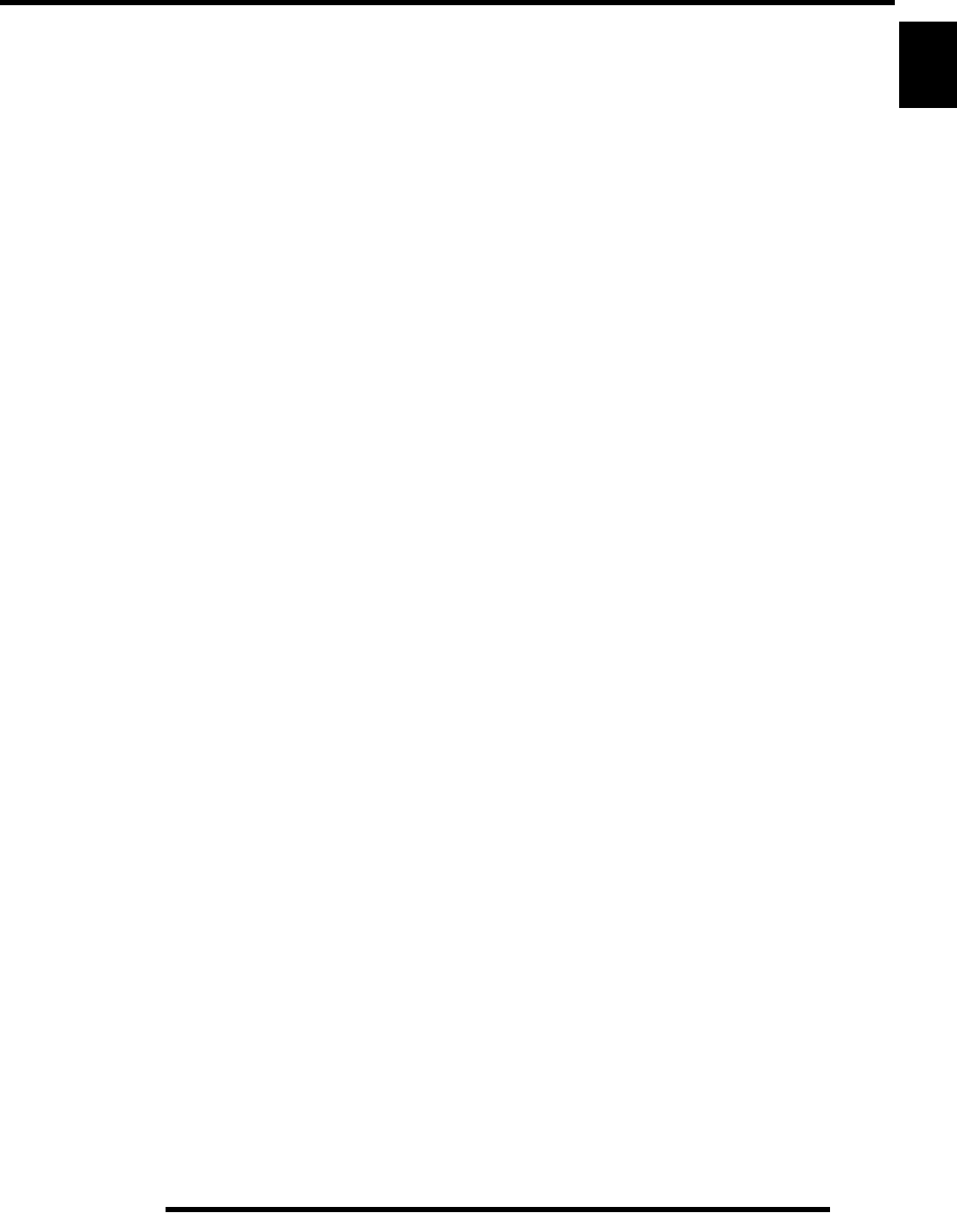
IX.1
IX
A
Air Filter Service . . . . . . . . . . . . . . . . . . . . . . . . . . . . . . 2.13
All Wheel Drive (AWD) Coil . . . . . . . . . . . . . . . . . . . 10.17
Authorization Key . . . . . . . . . . . . . . . . . . . . . . . . . . . . . 4.45
Authorization, Reflash . . . . . . . . . . . . . . . . . . . . . . . . . . 4.43
AWD, Diagnosis . . . . . . . . . . . . . . . . . . . . . . . . . . . . . . . 7.17
AWD, Operation . . . . . . . . . . . . . . . . . . . . . . . . . . . . . . . 7.16
B
Balance Shaft Gear, Removal . . . . . . . . . . . . . . . . . . . . . 3.43
Ball Joint Service . . . . . . . . . . . . . . . . . . . . . . . . . . . . . . 5.18
Battery Charging . . . . . . . . . . . . . . . . . . . . . . . . . . . . . . . 2.27
Battery Installation . . . . . . . . . . . . . . . . . . . . . . . . . . . . . 2.26
Battery Maintenance . . . . . . . . . . . . . . . . . . . . . . . . . . . . 2.26
Battery Removal . . . . . . . . . . . . . . . . . . . . . . . . . . . . . . . 2.26
Battery Service . . . . . . . . . . . . . . . . . . . . . . . . . . . . . . . 10.30
Battery Storage . . . . . . . . . . . . . . . . . . . . . . . . . . . . . . . 10.30
Body Removal . . . . . . . . . . . . . . . . . . . . . . . . . . . . . . . . 5.10
Brake Burnishing . . . . . . . . . . . . . . . . . . . . . . . . . . 9.9, 9.17
Brake Caliper Assembly, Front . . . . . . . . . . . . . . 9.10, 9.12
Brake Caliper Assembly, Rear . . . . . . . . . . . . . . . . . . . . 9.18
Brake Caliper Inspection, Front . . . . . . . . . . . . . . . . . . . 9.12
Brake Caliper Installation, Front . . . . . . . . . . . . . . . . . . 9.13
Brake Caliper Removal, Front . . . . . . . . . . . . . . . . . . . . 9.10
Brake Disc, Front . . . . . . . . . . . . . . . . . . . . . . . . . . . . . . 9.14
Brake Disc, Rear . . . . . . . . . . . . . . . . . . . . . . . . . . . . . . . 9.21
Brake Hose and Fitting Inspection . . . . . . . . . . . . . . . . . 2.32
Brake Pad Assembly, Front . . . . . . . . . . . . . . . . . . . . . . . 9.9
Brake Pad Inspection . . . . . . . . . . . . . . . . . . . . . . . . . . . 2.32
Brake Pad Thickness, Front . . . . . . . . . . . . . . . . . . . . . . . 9.8
Brake Pads, Front . . . . . . . . . . . . . . . . . . . . . . . . . . . . . . . 9.8
Brake Pads, Rear . . . . . . . . . . . . . . . . . . . . . . . . . . . . . . . 9.15
Brake Pads, Removal, Front . . . . . . . . . . . . . . . . . . . . . . . 9.8
Brake Pedal, Installation . . . . . . . . . . . . . . . . . . . . . . . . . . 9.6
Brake Pedal, Removal . . . . . . . . . . . . . . . . . . . . . . . . . . . 9.6
Brake System Inspection . . . . . . . . . . . . . . . . . . . . . . . . 2.32
Brake System, Bleeding . . . . . . . . . . . . . . . . . . . . . . . . . . 9.7
Brake System, Exploded View . . . . . . . . . . . . . . . . . . . . . 9.5
Brake System, Operation . . . . . . . . . . . . . . . . . . . . . . . . . 9.4
Brake, Front Pad Assembly . . . . . . . . . . . . . . . . . . . . . . . 9.9
Break-In Period . . . . . . . . . . . . . . . . . . . . . . . . . . . . . . . . . 2.3
Break-In, PVT System (Belt) . . . . . . . . . . . . . . . . . . . . . . 6.3
Breather Hose Inspection . . . . . . . . . . . . . . . . . . . . . . . . 2.17
C
Cab Frame, Assembly / Removal . . . . . . . . . . . . . . . . . . . 5.3
Caliper, Front . . . . . . . . . . . . . . . . . . . . . . . . . . . . . . . . . 9.10
Caliper, Rear . . . . . . . . . . . . . . . . . . . . . . . . . . . . . . . . . . 9.18
Cam Gear, Reassembly . . . . . . . . . . . . . . . . . . . . . . . . . . 3.42
Cam Gear, Removal . . . . . . . . . . . . . . . . . . . . . . . . . . . . 3.41
Cargo Box Removal . . . . . . . . . . . . . . . . . . . . . . . . . . . . 5.12
Centralized Hilliard, Exploded View . . . . . . . . . . . . . . . 7.15
Charging System . . . . . . . . . . . . . . . . . . . . . . . . . . . . . . 10.26
Charging System, Alternator Tests . . . . . . . . . . . . . . . . 10.26
Chassis . . . . . . . . . . . . . . . . . . . . . . . . . . . . . . . . . . . . . . . 5.9
Circuit Breaker . . . . . . . . . . . . . . . . . . . . . . . . . . . . . . . 10.22
Clutch Offset Procedure . . . . . . . . . . . . . . . . . . . . . . . . . .6.7
Combustion Chamber . . . . . . . . . . . . . . . . . . . . . . . . . . .3.30
Communication Problems, Digital Wrench . . . . . . . . . .4.39
Compression Test . . . . . . . . . . . . . . . . . . . . . . . . . . . . . .2.17
Console and Floor Panel Removal . . . . . . . . . . . . . . . . .5.13
Conversion Table . . . . . . . . . . . . . . . . . . . . . . . . . . . . . . .1.6
Coolant Level Inspection . . . . . . . . . . . . . . . . . . . . . . . .2.22
Coolant Strength and Type . . . . . . . . . . . . . . . . . . . . . . .2.22
Cooling System Bleeding Procedure . . . . . . . . . . . . . . . .3.14
Cooling System Hoses . . . . . . . . . . . . . . . . . . . . . . . . . .2.23
Cooling System Specifications . . . . . . . . . . . . . . . . . . . .3.12
Cooling System, Pressure Test . . . . . . . . . . . . . . . . . . . .3.12
Crankshaft Gear, Removal . . . . . . . . . . . . . . . . . . . . . . .3.43
Crankshaft Position Sensor (CPS) . . . . . . . . . . . . . . . . . .4.13
Cylinder Head Assembly . . . . . . . . . . . . . . . . . . . . . . . .3.32
Cylinder Head Assembly Exploded View . . . . . . . . . . .3.25
Cylinder Head Disassembly . . . . . . . . . . . . . . . . . . . . . .3.28
Cylinder Honing To De-glaze . . . . . . . . . . . . . . . . . . . . .3.36
Cylinder Inspection . . . . . . . . . . . . . . . . . . . . . . . . . . . . .3.35
D
Decal Replacement . . . . . . . . . . . . . . . . . . . . . . . . . . . . .5.23
Decimal Equivalent Chart . . . . . . . . . . . . . . . . . . . . . . . . .1.8
Diagnostic Code Table . . . . . . . . . . . . . . . . . . . . . . . . . .4.35
Diagnostic Codes, Instrument Cluster . . . . . . . . . . . . . .10.15
Digital Wrench Communication Errors . . . . . . . . . . . . .4.39
Digital Wrench Diagnostic Software . . . . . . . . . . . . . . .4.39
Digital Wrench Versions . . . . . . . . . . . . . . . . . . . . . . . . .4.39
Digital Wrench, Controller Reprogramming . . . . . . . . .4.43
Digital Wrench, Updates . . . . . . . . . . . . . . . . . . . . . . . . .4.41
Digital Wrench, Version and Update ID . . . . . . . . . . . . .4.40
Drive Belt, Inspection . . . . . . . . . . . . . . . . . . . . . . . . . . . .6.9
Drive Belt, Installation . . . . . . . . . . . . . . . . . . . . . . . . . . .6.9
Drive Belt, Removal . . . . . . . . . . . . . . . . . . . . . . . . . . . . .6.9
Drive Clutch, Assembly . . . . . . . . . . . . . . . . . . . . . . . . .6.18
Drive Clutch, Exploded View (2010) . . . . . . . . . . . . . . .6.11
Drive Clutch, Operation . . . . . . . . . . . . . . . . . . . . . . . . . .6.2
Drive Clutch, Service . . . . . . . . . . . . . . . . . . . . . . . . . . .6.10
Drive Clutch, Shift Weights . . . . . . . . . . . . . . . . . . . . . .6.11
Drive Clutch, Spring . . . . . . . . . . . . . . . . . . . . . . . . . . . .6.10
Drive Shaft Boot Inspection . . . . . . . . . . . . . . . . . . . . . .2.25
Driven Clutch, Assembly (Fixed Helix) . . . . . . . . . . . . .6.22
Driven Clutch, Disassembly (Fixed Helix) . . . . . . . . . . .6.20
Driven Clutch, Exploded View (Fixed Helix) . . . . . . . .6.20
Driven Clutch, Operation . . . . . . . . . . . . . . . . . . . . . . . . .6.3
Driven Clutch, Service (Fixed Helix) . . . . . . . . . . . . . . .6.20
Driveshaft / CV Joint, Handling Tips . . . . . . . . . . . . . . . .7.6
E
ECU Replacement . . . . . . . . . . . . . . . . . . . . . . . . . . . . . .4.39
EFI Operation Overview . . . . . . . . . . . . . . . . . . . . . . . . .4.10
EFI Priming / Starting Procedure . . . . . . . . . . . . . . . . . .4.11
EFI System, Component Locations . . . . . . . . . . . . . . . . . .4.6
EFI System, Exploded View . . . . . . . . . . . . . . . . . . . . . . .4.5
EFI, Diagnostic Codes . . . . . . . . . . . . . . . . . . . . . . . . . . .4.35
EFI, Service Notes . . . . . . . . . . . . . . . . . . . . . . . . . . . . . . .4.4
EFI, Troubleshooting . . . . . . . . . . . . . . . . . . . . . . . . . . .4.38
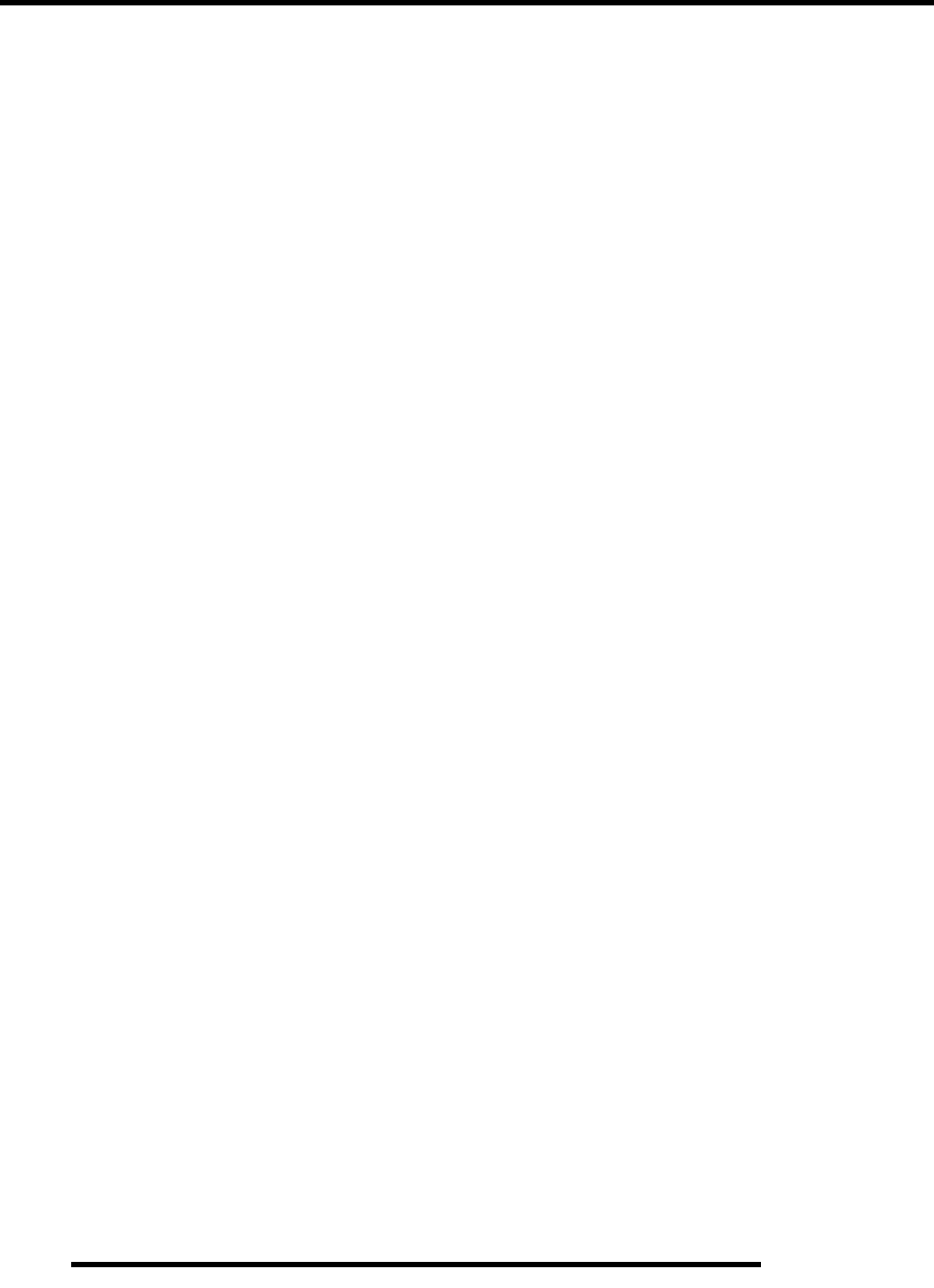
IX.2
Electrical, Cooling System Breakout Diagram . . . . . . .10.20
Electronic Control Unit (ECU) . . . . . . . . . . . . . . . . . . . .4.11
Engine and Transmission Separation . . . . . . . . . . . . . . .3.24
Engine Assembly and Installation . . . . . . . . . . . . . . . . . .3.60
Engine Break-In Period . . . . . . . . . . . . . . . . . . . . . . . . . .3.61
Engine Coolant Temperature Sensor (ECT) . . . . . . . . . .4.33
Engine Cooling System . . . . . . . . . . . . . . . . . . . . . . . . . .3.12
Engine Designation Number . . . . . . . . . . . . . . . . . . . . . . .1.2
Engine Exploded Views . . . . . . . . . . . . . . .3.2, 3.3, 3.4, 3.6
Engine Fastener Torque Patterns . . . . . . . . . . . . . . . . . . . .3.7
Engine Lubrication . . . . . . . . . . . . . . . . . . . . . . . . 3.15, 3.61
Engine Oil and Filter Change . . . . . . . . . . . . . . . . . . . . .2.15
Engine Oil Flow Chart . . . . . . . . . . . . . . . . . . . . . . . . . .3.16
Engine Oil Level . . . . . . . . . . . . . . . . . . . . . . . . . . . . . . .2.15
Engine Oil Pressure Test . . . . . . . . . . . . . . . . . . . . . . . . .3.15
Engine Oil Priming . . . . . . . . . . . . . . . . . . . . . . . . . . . . .3.60
Engine Oil Pump Installation . . . . . . . . . . . . . . . . . . . . .3.51
Engine Removal . . . . . . . . . . . . . . . . . . . . . . . . . . . . . . .3.17
Engine Serial Number Location . . . . . . . . . . . . . . . . . . . .1.2
Engine Service Specifications . . . . . . . . . . . . . . . . . . . . . .3.9
Engine Temperature Sensor Replacement . . . . . . . . . . .4.33
Engine Temperature Sensor Test . . . . . . . . . . . . . . . . . .4.33
Engine Torque Specifications . . . . . . . . . . . . . . . . . . . . . .3.8
Engine, Accessible Components . . . . . . . . . . . . . . . . . . .3.15
Engine, Balance Shaft Removal . . . . . . . . . . . . . . . . . . .3.47
Engine, Camshaft Inspection . . . . . . . . . . . . . . . . . . . . . .3.47
Engine, Camshaft Installation . . . . . . . . . . . . . . . . . . . . .3.49
Engine, Cooling System Troubleshooting . . . . . . . . . . .3.63
Engine, Crankcase Assembly . . . . . . . . . . . . . . . . . . . . .3.48
Engine, Crankshaft Gear Removal . . . . . . . . . . . . . . . . .3.44
Engine, Crankshaft Installation . . . . . . . . . . . . . . . . . . . .3.49
Engine, Cylinder Head Assembly . . . . . . . . . . . . . 3.32, 3.57
Engine, Cylinder Head Inspection . . . . . . . . . . . . . . . . . .3.27
Engine, Cylinder Head Removal . . . . . . . . . . . . . . . . . . .3.26
Engine, Cylinder Head Warp . . . . . . . . . . . . . . . . . . . . .3.27
Engine, Cylinder Honing . . . . . . . . . . . . . . . . . . . . . . . . .3.36
Engine, Cylinder Inspection . . . . . . . . . . . . . . . . . . . . . .3.35
Engine, Cylinder Installation . . . . . . . . . . . . . . . . . . . . . .3.50
Engine, Cylinder Removal . . . . . . . . . . . . . . . . . . . . . . .3.33
Engine, Flywheel / Stator Installation . . . . . . . . . . . . . . .3.57
Engine, Flywheel / Stator Removal . . . . . . . . . . . . . . . . .3.39
Engine, Flywheel Removal . . . . . . . . . . . . . . . . . . . . . . .3.40
Engine, Gear(s) Removal . . . . . . . . . . . . . . . . . . . . . . . .3.40
Engine, Gears, Installation . . . . . . . . . . . . . . . . . . . . . . .3.52
Engine, Oil Pump Removal . . . . . . . . . . . . . . . . . . . . . . .3.44
Engine, Piston Installation . . . . . . . . . . . . . . . . . . . . . . . .3.50
Engine, Piston Removal, Inspection . . . . . . . . . . . . . . . .3.34
Engine, Piston Ring Installed Gap . . . . . . . . . . . . . . . . .3.38
Engine, Piston to Cylinder Clearance . . . . . . . . . . . . . . .3.37
Engine, Piston to Rod Clearance . . . . . . . . . . . . . . . . . . .3.37
Engine, Push Rod Inspection . . . . . . . . . . . . . . . . . . . . .3.26
Engine, Rocker Arm Inspection . . . . . . . . . . . . . . . . . . .3.26
Engine, Starter Drive Removal . . . . . . . . . . . . . . . . . . . .3.38
Engine, Stator Gear Cover Seal(s) Installation . . . . . . . .3.54
Engine, Stator Installation . . . . . . . . . . . . . . . . . . . . . . . .3.57
Engine, Troubleshooting . . . . . . . . . . . . . . . . . . . . . . . . 3.62
Engine, Valve Inspection . . . . . . . . . . . . . . . . . . . . . . . . 3.29
Engine, Valve Lifter Removal, Inspection . . . . . . . . . . . 3.33
Engine, Valve Seal/Spring Service . . . . . . . . . . . . . . . . 3.27
Engine, Valve Sealing Test . . . . . . . . . . . . . . . . . . . . . . 3.33
Engine, Valve Seat Reconditioning . . . . . . . . . . . . . . . . 3.30
Exhaust, Spark Arrestor . . . . . . . . . . . . . . . . . . . . . . . . . 2.17
F
Fan Control Circuit Bypass Test . . . . . . . . . . . . . . . . . 10.21
Fan Control Circuit Operation . . . . . . . . . . . . . . . . . . . 10.21
Floor . . . . . . . . . . . . . . . . . . . . . . . . . . . . . . . . . . . . . . . . . 5.7
Flywheel / Stator Removal . . . . . . . . . . . . . . . . . . . . . . . 3.39
Flywheel, Removal . . . . . . . . . . . . . . . . . . . . . . . . . . . . 3.39
Fox Shock Service . . . . . . . . . . . . . . . . . . . . . . . . . . . . . 5.31
Front A-arm, Replacement . . . . . . . . . . . . . . . . . . . . . . . 5.16
Front Bearing Carrier . . . . . . . . . . . . . . . . . . . . . . . . . . . . 7.2
Front Body / Dash Removal . . . . . . . . . . . . . . . . . . . . . . 5.11
Front Body Work . . . . . . . . . . . . . . . . . . . . . . . . . . . . . . . 5.4
Front Bumper . . . . . . . . . . . . . . . . . . . . . . . . . . . . . .5.5, 5.10
Front Caliper, Piston Bore I.D. . . . . . . . . . . . . . . . . . . . 9.12
Front Driveshaft, CV Joint / Boot Replacement . . . . . . . 7.6
Front Driveshaft, Installation . . . . . . . . . . . . . . . . . . . . . . 7.9
Front Driveshaft, Removal . . . . . . . . . . . . . . . . . . . . . . . . 7.5
Front Fender Flair Removal . . . . . . . . . . . . . . . . . . . . . . 5.11
Front Gearcase Lubrication . . . . . . . . . . . . . . . . . . . . . . 2.20
Front Gearcase, Assembly . . . . . . . . . . . . . . . . . . . . . . . 7.21
Front Gearcase, Centralized Hilliard . . . . . . . . . . . . . . . 7.14
Front Gearcase, Disassembly / Inspection . . . . . . . . . . . 7.18
Front Gearcase, Installation . . . . . . . . . . . . . . . . . . . . . . 7.23
Front Gearcase, Removal . . . . . . . . . . . . . . . . . . . . . . . . 7.18
Fuel Filter . . . . . . . . . . . . . . . . . . . . . . . . . . . . . . . . . . . . 2.11
Fuel Injectors . . . . . . . . . . . . . . . . . . . . . . . . . . . . . . . . . 4.17
Fuel Line . . . . . . . . . . . . . . . . . . . . . . . . . . . . . . . . . . . . 2.11
Fuel Lines, Quick Connect . . . . . . . . . . . . . . . . . . . . . . . 4.10
Fuel Pump Assembly . . . . . . . . . . . . . . . . . . . . . . . . . . . 4.20
Fuel Pump Replacement . . . . . . . . . . . . . . . . . . . . . . . . 4.22
Fuel Pump Test . . . . . . . . . . . . . . . . . . . . . . . . . . . . . . . 4.21
Fuel Sender Test . . . . . . . . . . . . . . . . . . . . . . . . . .4.20, 10.21
Fuel System . . . . . . . . . . . . . . . . . . . . . . . . . . . . . . . . . . 2.11
Fuel System Diagnostics . . . . . . . . . . . . . . . . . . . . . . . . 4.39
Fuel Tank Replacement . . . . . . . . . . . . . . . . . . . . . . . . . 4.25
Fuel Tank, Exploded View . . . . . . . . . . . . . . . . . . . . . . . 4.9
Fuses . . . . . . . . . . . . . . . . . . . . . . . . . . . . . . . . . . . . . . . 10.22
G
Gear / Stator Housing Seal Replacement . . . . . . . . . . . . 3.54
Gear Position Indicator Switch Test . . . . . . . . . . . . . . . 10.7
General Specifications, Brakes . . . . . . . . . . . . . . . . . . . . 9.2
Ground, Engine . . . . . . . . . . . . . . . . . . . . . . . . . . . . . . . 2.27
Guided Diagnostics . . . . . . . . . . . . . . . . . . . . . . . . . . . . 4.39
H
Head Lights . . . . . . . . . . . . . . . . . . . . . . . . . . . . . . . . . 10.17
Hood . . . . . . . . . . . . . . . . . . . . . . . . . . . . . . . . . . . . . . . . . 5.4
Hood Removal . . . . . . . . . . . . . . . . . . . . . . . . . . . . . . . . 5.11
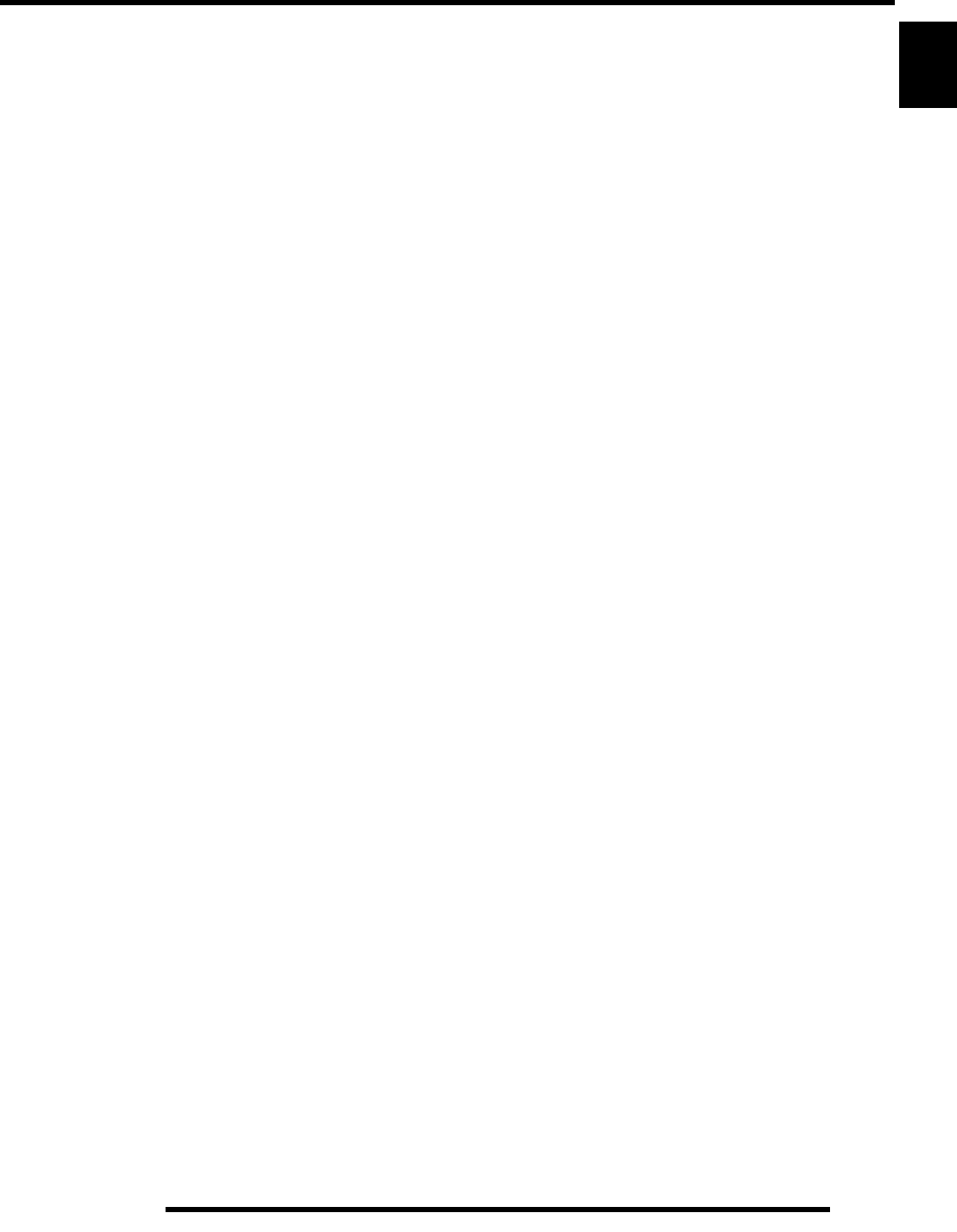
IX.3
IX
I
Idle Air Control (IAC) . . . . . . . . . . . . . . . . . . . . . . . . . . 4.27
Ignition Coil . . . . . . . . . . . . . . . . . . . . . . . . . . . . . . . . . . 4.34
Ignition Coil Replacement . . . . . . . . . . . . . . . . . . . . . . . 4.34
Ignition Coil Test . . . . . . . . . . . . . . . . . . . . . . . . . . . . . . 4.34
Instrument Cluster . . . . . . . . . . . . . . . . . . . . . . . . . . . . 10.10
Instrument Cluster, Installation . . . . . . . . . . . . . . . . . . 10.16
Instrument Cluster, Removal . . . . . . . . . . . . . . . . . . . . 10.16
K
Key, Reprogramming Authorization . . . . . . . . . . . . . . . 4.45
L
Leakdown Test . . . . . . . . . . . . . . . . . . . . . . . . . . . . . . . . 2.17
Lubrication Grease Points . . . . . . . . . . . . . . . . . . . . . . . . 2.8
M
Main Frame . . . . . . . . . . . . . . . . . . . . . . . . . . . . . . . . . . . . 5.9
Maintenance Quick Reference Chart . . . . . . . . . . . . 2.6, 2.7
Maintenance Schedule . . . . . . . . . . . . . . . . . . . . . . . . . . 2.33
Maintenance, Brake System . . . . . . . . . . . . . . . . . . . . . . 2.32
Maintenance, Cooling System . . . . . . . . . . . . . . . . . . . . 2.22
Maintenance, Electrical and Ignition . . . . . . . . . . . . . . . 2.26
Maintenance, Engine . . . . . . . . . . . . . . . . . . . . . . . . . . . 2.15
Maintenance, Final Drive . . . . . . . . . . . . . . . . . . . . . . . . 2.24
Maintenance, Fuel System . . . . . . . . . . . . . . . . . . . . . . . 2.11
Maintenance, General Vehicle Inspection . . . . . . . . . . . 2.10
Maintenance, Service Products and Lubricants . . . . . . . . 2.9
Maintenance, Steering . . . . . . . . . . . . . . . . . . . . . . . . . . 2.28
Maintenance, Transmission and Gearcases . . . . . . . . . . 2.18
Master Cylinder, Installation . . . . . . . . . . . . . . . . . . . . . . 9.6
Master Cylinder, Removal . . . . . . . . . . . . . . . . . . . . . . . . 9.6
Model Identification . . . . . . . . . . . . . . . . . . . . . . . . . . . . . 1.2
O
Oil Pump Priming . . . . . . . . . . . . . . . . . . . . . . . . . . . . . . 3.59
Oil Pump, Disassembly . . . . . . . . . . . . . . . . . . . . . . . . . 3.44
Oil Pump, Reassembly . . . . . . . . . . . . . . . . . . . . . . . . . . 3.45
Oil Pump, Removal . . . . . . . . . . . . . . . . . . . . . . . . . . . . 3.44
P
Periodic Maintenance Chart . . . . . . . . . . . . . . . . . . . . . . . 2.3
Piston Ring Installed Gap . . . . . . . . . . . . . . . . . . . . . . . . 3.38
Piston to Cylinder Clearance . . . . . . . . . . . . . . . . . . . . . 3.37
Piston to Rod Inspection . . . . . . . . . . . . . . . . . . . . . . . . . 3.37
Pre-Ride / Daily Inspection . . . . . . . . . . . . . . . . . . . . . . 2.10
Propshaft Removal / Installation . . . . . . . . . . . . . . . . . . 7.11
Propshaft, U-Joint Service . . . . . . . . . . . . . . . . . . . . . . . 7.12
Publication Numbers . . . . . . . . . . . . . . . . . . . . . . . . . . . . 1.3
PVT System, Assembly . . . . . . . . . . . . . . . . . . . . . . . . . . 6.6
PVT System, Disassembly . . . . . . . . . . . . . . . . . . . . . . . . 6.5
PVT System, Maintenance . . . . . . . . . . . . . . . . . . . . . . . . 6.3
PVT System, Overheating Diagnostics . . . . . . . . . . . . . . 6.4
PVT System, Overview . . . . . . . . . . . . . . . . . . . . . . . . . . 6.2
PVT System, Service . . . . . . . . . . . . . . . . . . . . . . . . . . . . 6.5
PVT Troubleshooting . . . . . . . . . . . . . . . . . . . . . . . . . . . 6.24
PVT, Button to Tower Clearance . . . . . . . . . . . . . . . . . . 6.14
PVT, Drive Clutch Bushing Service . . . . . . . . . . . . . . . . 6.16
PVT, Drive Clutch Cover Bushing . . . . . . . . . . . . . . . . .6.17
PVT, Drive Clutch Disassembly . . . . . . . . . . . . . . . . . . .6.12
PVT, Drive Clutch Spider Removal . . . . . . . . . . . . . . . .6.12
PVT, Moveable Sheave Inspection . . . . . . . . . . . . . . . . .6.16
R
Radiator . . . . . . . . . . . . . . . . . . . . . . . . . . . . . . . . . . . . . .2.23
Radiator, Removal . . . . . . . . . . . . . . . . . . . . . . . . . . . . . .2.23
Rear A-arm, Replacement . . . . . . . . . . . . . . . . . . . . . . . .5.19
Rear Bearing Carrier . . . . . . . . . . . . . . . . . . . . . . . . . . . .7.24
Rear Bumper . . . . . . . . . . . . . . . . . . . . . . . . . . . . . . 5.5, 5.10
Rear Cargo Box . . . . . . . . . . . . . . . . . . . . . . . . . . . . . . . . .5.8
Rear Drive Shaft, CV Joint / Boot Replacement . . . . . . .7.29
Rear Drive Shaft, Plunging Joint / Boot Replacement . .7.31
Rear Driveshaft, Installation . . . . . . . . . . . . . . . . . . . . . .7.34
Rear Driveshaft, Removal . . . . . . . . . . . . . . . . . . . . . . . .7.28
Rear Fender, Flair, and Tie Down Removal . . . . . . . . . .5.12
Rear Fenders . . . . . . . . . . . . . . . . . . . . . . . . . . . . . . . . . . .5.8
Rear Gearcase . . . . . . . . . . . . . . . . . . . . . . . . . . . . . . . . .7.36
Rear Gearcase Lubrication . . . . . . . . . . . . . . . . . . . . . . .2.21
Rear Gearcase, Assembly . . . . . . . . . . . . . . . . . . . . . . . .7.44
Rear Gearcase, Diff Assembly . . . . . . . . . . . . . . . . . . . .7.43
Rear Gearcase, Diff Disassembly . . . . . . . . . . . . . . . . . .7.42
Rear Gearcase, Disassembly . . . . . . . . . . . . . . . . . . . . . .7.38
Rear Gearcase, Exploded View . . . . . . . . . . . . . . . . . . . .7.47
Rear Gearcase, Installation . . . . . . . . . . . . . . . . . . . . . . .7.46
Rear Gearcase, Removal . . . . . . . . . . . . . . . . . . . . . . . . .7.37
Rear Service Panel . . . . . . . . . . . . . . . . . . . . . . . . . . . . .5.10
Rear Stabilizer Bar . . . . . . . . . . . . . . . . . . . . . . . . . . . . .5.22
Rectifier Test . . . . . . . . . . . . . . . . . . . . . . . . . . . . . . . . .10.28
Reflash Authorization . . . . . . . . . . . . . . . . . . . . . . . . . . .4.43
Regulator / Rectifier Test . . . . . . . . . . . . . . . . . . . . . . .10.28
Relays . . . . . . . . . . . . . . . . . . . . . . . . . . . . . . . . . . . . . .10.22
Reprogramming Authorization . . . . . . . . . . . . . . . . . . . .4.43
Rocker Panel Removal . . . . . . . . . . . . . . . . . . . . . . . . . .5.13
Rocker Panels . . . . . . . . . . . . . . . . . . . . . . . . . . . . . . . . . .5.7
S
Seat Assembly . . . . . . . . . . . . . . . . . . . . . . . . . . . . . . . . . .5.6
Seat Belts / Mounting . . . . . . . . . . . . . . . . . . . . . . . . . . . .5.6
Seats . . . . . . . . . . . . . . . . . . . . . . . . . . . . . . . . . . . . . . . .5.10
Shift Cable Inspection and Adjustment . . . . . . . . . . 2.10, 8.3
Shift Lever . . . . . . . . . . . . . . . . . . . . . . . . . . . . . . . . . . . . .8.2
Shift Lever, Installation . . . . . . . . . . . . . . . . . . . . . . . . . . .8.2
Shift Lever, Removal . . . . . . . . . . . . . . . . . . . . . . . . . . . .8.2
Shock, FOX 2.0, Exploded View . . . . . . . . . . . . . . . . . .5.25
Shock, FOX, Rebuild Information . . . . . . . . . . . . . . . . .5.27
Shock, FOX, Service . . . . . . . . . . . . . . . . . . . . . . . . . . . .5.26
Shocks and Springs . . . . . . . . . . . . . . . . . . . . . . . . . . . . .5.24
Software Version . . . . . . . . . . . . . . . . . . . . . . . . . . . . . . .4.39
Solenoid, Rear Differential . . . . . . . . . . . . . . . . . . . . . . .10.8
Spark Plug Service . . . . . . . . . . . . . . . . . . . . . . . . . . . . .2.27
Special Tool, Cam Gear Installation Kit . . . . . . . . . . . . .3.42
Special Tools . . . . . . . . . . . . . . . . . . . . . . . . . . . . . . . . . . .1.3
Special Tools, Body/Steering/Suspension . . . . . . . . . . . . .5.2
Special Tools, Brakes . . . . . . . . . . . . . . . . . . . . . . . . . . . .9.2
Special Tools, Clutching . . . . . . . . . . . . . . . . . . . . . . . . . .6.2
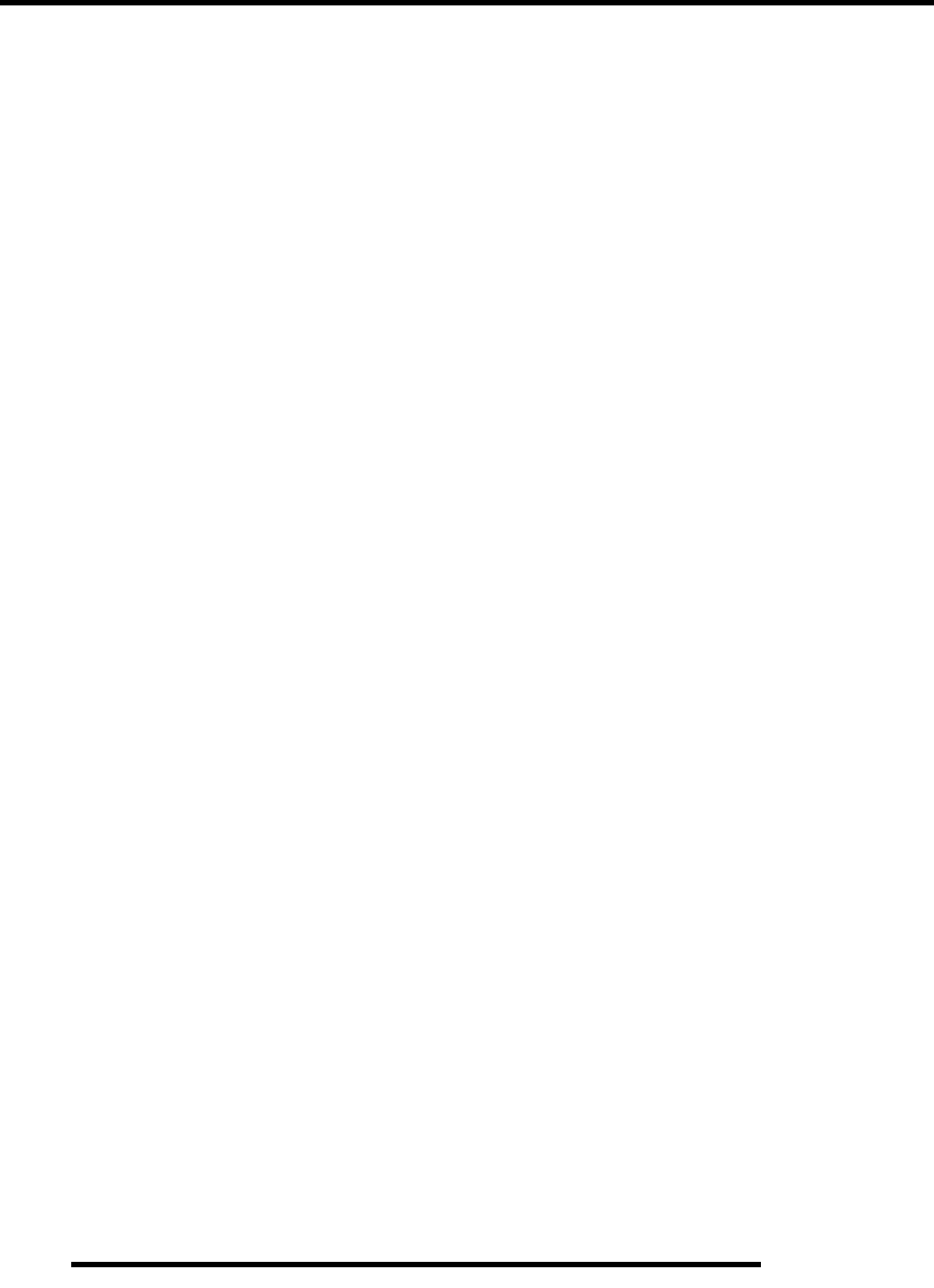
IX.4
Special Tools, EFI . . . . . . . . . . . . . . . . . . . . . . . . . . . . . . .4.2
Special Tools, Electrical . . . . . . . . . . . . . . . . . . . . . . . . .10.3
Special Tools, Engine . . . . . . . . . . . . . . . . . . . . . . . . . . .3.11
Special Tools, Final Drive . . . . . . . . . . . . . . . . . . . . . . . . .7.2
Specification Chart, Maintenance . . . . . . . . . . . . . . . . . .2.18
Specification, Balance Shaft Gear Bolt Torque . . . . . . .3.53
Specification, Cam Lobe Height . . . . . . . . . . . . . . . . . . .3.47
Specification, Cam Thrust Plate Fastener Torque . . . . . .3.51
Specification, Camshaft Gear Bolt Torque . . . . . . . . . . .3.53
Specification, Coolant Sensor Resistance . . . . . . . . . . .10.21
Specification, Cylinder Head Warp . . . . . . . . . . . . . . . . .3.27
Specification, Cylinder Taper Limit . . . . . . . . . . . . . . . .3.35
Specification, Cylinder Warp Limit . . . . . . . . . . . . . . . .3.35
Specification, Oil Pump Bolt Torque . . . . . . . . . . . . . . .3.52
Specification, Oil Pump Rotor Clearance . . . . . . . . . . . .3.44
Specification, Timing Gear Alignment . . . . . . . . . . . . . .3.40
Specification, Valve Seat Contact Width . . . . . . . . . . . .3.31
Specification, Valve Spring Free Length . . . . . . . . . . . .3.28
Specification, Valve Stem Diameter . . . . . . . . . . . . . . . .3.29
Specification, Valve Stem Guide I.D. . . . . . . . . . . . . . . .3.29
Specification, Wheel Toe-Out . . . . . . . . . . . . . . . . . . . . .2.29
Specifications, Cam Shaft . . . . . . . . . . . . . . . . . . . . . . . .3.48
Specifications, Cooling System . . . . . . . . . . . . . . . . . . . .3.12
Specifications, Crankcase Fastener Torque . . . . . . . . . . .3.49
Specifications, Engine . . . . . . . . . . . . . . . . . . . . . . . . . . . .3.2
Specifications, Engine Lubrication . . . . . . . . . . . . 3.15, 3.61
Specifications, Engine Oil Pressure . . . . . . . . . . . . . . . .3.15
Specifications, FOX 2.0 Shocks . . . . . . . . . . . . . . . . . . .5.26
Specifications, General (2010) . . . . . . . . . . . . . . . . . . . . .1.4
Specifications, Oil Baffle Bolt Torque . . . . . . . . . . . . . .3.48
Specifications, Oil Pick-Up Bolt Torque . . . . . . . . . . . .3.48
Speed Sensor . . . . . . . . . . . . . . . . . . . . . . . . . . . . . . . . . .10.7
Speedometer . . . . . . . . . . . . . . . . . . . . . . . . . . . . . . . . .10.10
Starter Armature Testing . . . . . . . . . . . . . . . . . . . . . . . .10.35
Starter Assembly, Exploded View . . . . . . . . . . . . . . . .10.38
Starter Brush Inspection / Replacement . . . . . . . . . . . .10.34
Starter Drive . . . . . . . . . . . . . . . . . . . . . . . . . . . . . . . . .10.37
Starter Drive Removal . . . . . . . . . . . . . . . . . . . . . . . . . . .3.38
Starter Motor, Removal . . . . . . . . . . . . . . . . . . . . . . . . .10.33
Starter Reassembly / Installation . . . . . . . . . . . . . . . . . .10.36
Starter Solenoid, Operation . . . . . . . . . . . . . . . . . . . . . .10.37
Starter Solenoid, Test . . . . . . . . . . . . . . . . . . . . . . . . . .10.37
Starter System Flow Chart . . . . . . . . . . . . . . . . . . . . . .10.39
Starter System, Troubleshooting . . . . . . . . . . . . . . . . . .10.32
Stator, Removal . . . . . . . . . . . . . . . . . . . . . . . . . . . . . . . .3.39
Steering Shaft, Bearing Replacement . . . . . . . . . . . . . . .5.15
Steering Shaft, Removal (Non-EPS) . . . . . . . . . . . . . . . .5.15
Steering Wheel Freeplay . . . . . . . . . . . . . . . . . . . . . . . . .2.28
Steering Wheel Removal (Non-EPS) . . . . . . . . . . . . . . .5.15
Steering, Exploded View . . . . . . . . . . . . . . . . . . . . . . . . .5.14
Steering, Inspection . . . . . . . . . . . . . . . . . . . . . . . . . . . . .2.28
Suspension, (FOX) . . . . . . . . . . . . . . . . . . . . . . . . . . . . .2.30
Suspension, Compression Adjustment (FOX) . . . . . . . .2.31
Suspension, Spring Preload Adjustment (FOX) . . . . . . .2.30
Switch, AWD/2WD/TURF . . . . . . . . . . . . . . . . . . . . . . .10.5
Switch, Blackout . . . . . . . . . . . . . . . . . . . . . . . . . . . . . . 10.5
Switch, Brake Light . . . . . . . . . . . . . . . . . . . . . . . . . . . . 10.3
Switch, Headlamp . . . . . . . . . . . . . . . . . . . . . . . . . . . . . 10.4
Switch, I.R. Lights . . . . . . . . . . . . . . . . . . . . . . . . . . . . . 10.6
Switch, Ignition . . . . . . . . . . . . . . . . . . . . . . . . . . . . . . . 10.4
Switch, Winch . . . . . . . . . . . . . . . . . . . . . . . . . . . . . . . . 10.6
T
Tail Lights . . . . . . . . . . . . . . . . . . . . . . . . . . . . . . . . . . 10.19
Tap/Drill Sizes . . . . . . . . . . . . . . . . . . . . . . . . . . . . . . . . . 1.8
Throttle Freeplay Adjustment . . . . . . . . . . . . . . . . . . . . 2.12
Throttle Pedal Inspection . . . . . . . . . . . . . . . . . . . . . . . . 2.12
Throttle Position Sensor (TPS) . . . . . . . . . . . . . . . . . . . 4.28
Tie Rod End and Steering Inspection . . . . . . . . . . . . . . 2.28
Timing Gear Mark Alignment . . . . . . . . . . . . . . . . . . . . 3.40
Tire Inspection . . . . . . . . . . . . . . . . . . . . . . . . . . . . . . . . 2.25
Tire Pressure . . . . . . . . . . . . . . . . . . . . . . . . . . . . . . . . . 2.25
T-MAP Sensor . . . . . . . . . . . . . . . . . . . . . . . . . . . .4.12, 4.32
Toe Adjustment . . . . . . . . . . . . . . . . . . . . . . . . . . . . . . . 2.29
Torque Chart . . . . . . . . . . . . . . . . . . . . . . . . . . . . . . . . . . 1.7
Torque Specifications - Engine . . . . . . . . . . . . . . . . . . . . 3.8
Torque Specifications, Body/Steering/Suspension . . . . . 5.2
Torque Specifications, Brakes . . . . . . . . . . . . . . . . . . . . . 9.2
Torque Specifications, Clutching . . . . . . . . . . . . . . . . . . . 6.2
Torque Specifications, Final Drive . . . . . . . . . . . . . . . . . 7.2
Torque Specifications, Transmission . . . . . . . . . . . . . . . . 8.2
Torque Specifications, Wheel and Hub . . . . . . . . . . . . . 2.24
Transfer Case, Disassembly . . . . . . . . . . . . . . . . . . . . . . . 8.4
Transfer Case, Reassembly . . . . . . . . . . . . . . . . . . . . . . . 8.7
Transmission Lubrication . . . . . . . . . . . . . . . . . . . . . . . 2.18
Transmission, Exploded View (2010) . . . . . . . . . . . . . . 8.19
Transmission, Removal . . . . . . . . . . . . . . . . . . . . . . . . . . 8.4
Transmission, Shift Housing Disassembly . . . . . . . . . . . 8.9
Transmission, Shift Housing Reassembly . . . . . . . . . . . 8.13
Trouble Codes . . . . . . . . . . . . . . . . . . . . . . . . . . . . . . . . 4.35
Troubleshooting, Brake Noise . . . . . . . . . . . . . . . . . . . . . 9.3
Troubleshooting, Brake System . . . . . . . . . . . . . . . . . . . 9.22
Troubleshooting, Clutching . . . . . . . . . . . . . . . . . . . . . . 6.23
Troubleshooting, Transmission . . . . . . . . . . . . . . . . . . . 8.18
V
Valve Seal/Spring Service . . . . . . . . . . . . . . . . . . . . . . . 3.27
Valve Sealing Test . . . . . . . . . . . . . . . . . . . . . . . . . . . . . 3.33
Valve Seat Reconditioning . . . . . . . . . . . . . . . . . . . . . . . 3.30
Vent Lines . . . . . . . . . . . . . . . . . . . . . . . . . . . . . . . . . . . 2.11
Version, Software . . . . . . . . . . . . . . . . . . . . . . . . . . . . . . 4.39
VIN Identification . . . . . . . . . . . . . . . . . . . . . . . . . . . . . . 1.2
Voltage Drop Test . . . . . . . . . . . . . . . . . . . . . . . . . . . . 10.33
W
Wheel Alignment . . . . . . . . . . . . . . . . . . . . . . . . . . . . . . 2.29
Wheel Hubs . . . . . . . . . . . . . . . . . . . . . . . . . . . . . . . . . . 7.48
Wheel, Installation . . . . . . . . . . . . . . . . . . . . . . . . . . . . . 2.24
Wheel, Removal . . . . . . . . . . . . . . . . . . . . . . . . . . . . . . . 2.24
